Telit Communications S p A TRIZIUM Tri-band GSM/GPRS PCS Data Terminal Module User Manual 80264ST10007a r3
Telit Communications S.p.A. Tri-band GSM/GPRS PCS Data Terminal Module 80264ST10007a r3
Users Manual

Telit TRIZIUM Product Description
80264ST10007a Rev. 4– 09/09/04
Reproduction forbidden without DAI Telecom written authorization – All Right reserved – Right of modification reserved page 1 of 202
T
Te
el
li
it
t
T
TR
RI
IZ
ZI
IU
UM
M
P
Pr
ro
od
du
uc
ct
t
D
De
es
sc
cr
ri
ip
pt
ti
io
on
n
DAI Telecom S.p.a. 2003 - 2004

Telit TRIZIUM Product Description
80264ST10007a Rev. 4– 09/09/04
Reproduction forbidden without DAI Telecom written authorization – All Right reserved – Right of modification reserved page 2 of 202
Contents
1OVERVIEW.................................................................................................................. 9
2GENERAL PRODUCT DESCRIPTION ..................................................................... 11
2.1 Dimensions.......................................................................................................................................................11
2.2 Weight..............................................................................................................................................................12
2.3 Environmental requirements.........................................................................................................................12
2.3.1 Temperature range ....................................................................................................................................12
2.3.2 Vibration Test (non functional).................................................................................................................12
2.4 Operating Frequency......................................................................................................................................13
2.5 Transmitter output power..............................................................................................................................13
2.6 Reference sensitivity .......................................................................................................................................13
2.7 Antenna............................................................................................................................................................13
2.7.1 Antenna connector ....................................................................................................................................14
2.8 Supply voltage .................................................................................................................................................14
2.9 Power consumption.........................................................................................................................................14
2.10 Embodied Battery charger.............................................................................................................................14
2.11 User Interface..................................................................................................................................................14
2.11.1 Speech Coding ..........................................................................................................................................14
2.11.2 Sim Reader................................................................................................................................................15
2.11.3 SMS ..........................................................................................................................................................15
2.11.4 Real Time Clock and Alarm .....................................................................................................................15
2.11.5 Data/fax transmission................................................................................................................................15
2.11.6 Local security management.......................................................................................................................15
2.11.7 Call control................................................................................................................................................15
2.11.8 Phonebook.................................................................................................................................................15
2.11.9 Characters management ............................................................................................................................15
2.11.10 SIM related functions............................................................................................................................15
2.11.11 Call status indication.............................................................................................................................15
2.11.12 Indication of network service availability.............................................................................................16
2.11.13 Automatic answer (Voice, Data or FAX)..............................................................................................16
2.11.14 Supplementary services (SS).................................................................................................................16
2.11.15 Acoustic signaling.................................................................................................................................16
2.11.16 DTMF tones..........................................................................................................................................16
2.11.17 Buzzer output........................................................................................................................................17
2.12 Logic level specifications ................................................................................................................................17
2.12.1 Reset signal ...............................................................................................................................................18

Telit TRIZIUM Product Description
80264ST10007a Rev. 4– 09/09/04
Reproduction forbidden without DAI Telecom written authorization – All Right reserved – Right of modification reserved page 3 of 202
2.13 RTC Bypass out...............................................................................................................................................19
2.14 Vout power output ..........................................................................................................................................19
2.15 Audio levels specifications..............................................................................................................................20
2.16 Interfaces on TRIZIUM .................................................................................................................................21
2.17 Mounting the TRIZIUM on your Board.......................................................................................................23
2.17.1 General......................................................................................................................................................23
2.17.2 Module finishing & dimensions................................................................................................................23
2.17.3 Recommended foot print for application ..................................................................................................24
2.17.4 Stencil .......................................................................................................................................................24
2.17.5 Solder reflow.............................................................................................................................................25
2.17.6 Packing system..........................................................................................................................................26
2.17.7 Moisture sensibility...................................................................................................................................28
3EVALUATION KIT..................................................................................................... 29
3.1 Evaluation Kit description .............................................................................................................................30
3.1.1 Power Supply............................................................................................................................................30
3.1.2 Serial interface ..........................................................................................................................................30
3.1.3 Audio ........................................................................................................................................................31
3.1.4 GPIO and Leds..........................................................................................................................................31
4SERVICE AND FIRMWARE UPDATE ...................................................................... 32
4.1 Step-by-Step upgrade procedure...................................................................................................................32
5AT COMMAND .......................................................................................................... 33
5.1 Definitions........................................................................................................................................................33
5.2 AT Command Syntax .....................................................................................................................................33
5.2.1 Command lines .........................................................................................................................................33
5.2.2 Information responses and result codes ....................................................................................................35
5.2.3 Command Response Timeout ...................................................................................................................35
5.2.4 Command issuing timing ..........................................................................................................................37
5.2.5 Factory Profile and parameters stored in the profile .................................................................................37
5.3 Hayes Compliant AT Commands..................................................................................................................38
5.3.1 Generic Modem Control ...........................................................................................................................38
5.3.1.1 &F - restore factory configuration ........................................................................................................38
5.3.1.2 Z - soft reset ..........................................................................................................................................38
5.3.1.3 +FCLASS - select active service class..................................................................................................39
5.3.1.4 &Y - designate a default reset profile ...................................................................................................39
5.3.1.5 &W - store current configuration..........................................................................................................39
5.3.1.6 &Z - store telephone number in the Telit TRIZIUM module internal phonebook......................................40
5.3.1.7 &N - display internal phonebook stored numbers.................................................................................41
5.3.1.8 +GMI - request manufacturer identification .........................................................................................41
5.3.1.9 +GMM - request model identification ..................................................................................................41
5.3.1.10 +GMR - request revision identification.............................................................................................41
5.3.1.11 +GCAP - request capabilities list......................................................................................................41
5.3.1.12 +GSN - request serial number...........................................................................................................42

Telit TRIZIUM Product Description
80264ST10007a Rev. 4– 09/09/04
Reproduction forbidden without DAI Telecom written authorization – All Right reserved – Right of modification reserved page 4 of 202
5.3.1.13 &V - display current configuration & profile....................................................................................43
5.3.1.14 &V0 - display current configuration & profile..................................................................................43
5.3.1.15 &V1 - display S registers values.......................................................................................................43
5.3.1.16 &V2 - display last connection statistics ............................................................................................45
5.3.1.17 \V - single line connect message.......................................................................................................45
5.3.1.18 %L - report line signal level..............................................................................................................46
5.3.1.19 %Q - report line quality.....................................................................................................................46
5.3.2 DTE - modem interface control ................................................................................................................47
5.3.2.1 E - command echo.................................................................................................................................47
5.3.2.2 Q - quiet resut codes..............................................................................................................................47
5.3.2.3 V- result code form ...............................................................................................................................48
5.3.2.4 X - extended result codes ......................................................................................................................48
5.3.2.5 I - Request identifier and software checksum .......................................................................................49
5.3.2.6 &C - data carrier detect (DCD) control.................................................................................................49
5.3.2.7 &D - data terminal ready (DTR) control...............................................................................................50
5.3.2.8 &K - flow control..................................................................................................................................50
5.3.2.9 &S - data set ready (DSR) control ........................................................................................................50
5.3.2.10 \R - ring (RI) control.........................................................................................................................52
5.3.2.11 +IPR - fixed DTE interface rate........................................................................................................52
5.3.2.12 +IFC - DTE - DTA flow control.......................................................................................................52
5.3.2.13 +ILRR - DTE - modem rate reporting ..............................................................................................54
5.3.2.14 +ICF - DTE - modem character format.............................................................................................55
5.3.3 Call Control...............................................................................................................................................56
5.3.3.1 D - dial ..................................................................................................................................................56
5.3.3.2 T - set tone dial......................................................................................................................................58
5.3.3.3 P - set pulse dial ....................................................................................................................................58
5.3.3.4 A - answer.............................................................................................................................................58
5.3.3.5 A/ - Last command automatic repetition...............................................................................................58
5.3.3.6 H - disconnect .......................................................................................................................................59
5.3.3.7 O - return to On Line Mode ..................................................................................................................60
5.3.3.8 &G - guard tone ....................................................................................................................................60
5.3.3.9 &P - pulse dial make/break ratio...........................................................................................................61
5.3.4 Modulation control....................................................................................................................................61
5.3.4.1 +MS - modulation control.....................................................................................................................61
5.3.4.2 %E - enable/disable line quality monitor and auto retrain or fallback / fallforward .............................62
5.3.5 Compression control .................................................................................................................................63
5.3.5.1 +DS - set data compression...................................................................................................................63
5.3.5.2 +DR - data compression reporting ........................................................................................................63
5.3.6 Break control.............................................................................................................................................64
5.3.6.1 \B - transmit break to remote.................................................................................................................64
5.3.6.2 \K - break handling................................................................................................................................64
5.3.7 S parameters..............................................................................................................................................65
5.3.7.1 S0 - number of rings to auto answer .....................................................................................................65
5.3.7.2 S1 - ring counter....................................................................................................................................65
5.3.7.3 S2 - escape character.............................................................................................................................66
5.3.7.4 S3 - carriage return character ................................................................................................................66
5.3.7.5 S4 - line feed character..........................................................................................................................67
5.3.7.6 S5 - backspace character .......................................................................................................................67
5.3.7.7 S7 - wait time for carrier, silence or dial tone.......................................................................................68
5.3.7.8 S10 - lost carrier to hang up delay.........................................................................................................68
5.3.7.9 S12 - escape prompt delay ....................................................................................................................69
5.3.7.10 S25 - delay to DTR off......................................................................................................................69
5.3.7.11 S30 - disconnect inactivity timer.......................................................................................................70
5.3.7.12 S38 - delay before forced hang up ....................................................................................................70
5.4 ETSI GSM 07.07 AT Commands ..................................................................................................................71
5.4.1 General......................................................................................................................................................71

Telit TRIZIUM Product Description
80264ST10007a Rev. 4– 09/09/04
Reproduction forbidden without DAI Telecom written authorization – All Right reserved – Right of modification reserved page 5 of 202
5.4.1.1 +CGMI - request manufacturer identification.......................................................................................71
5.4.1.2 +CGMM - request model identification................................................................................................71
5.4.1.3 +CGMR - request revision identification..............................................................................................71
5.4.1.4 +CGSN - request product serial number identification.........................................................................71
5.4.1.5 +CSCS - select TE character set ...........................................................................................................71
5.4.1.6 +CIMI - request international mobile subscriber identity (IMSI) .........................................................73
5.4.2 Call control................................................................................................................................................74
5.4.2.1 +CBST - select bearer service type.......................................................................................................74
5.4.2.2 +CRLP - radio link protocol .................................................................................................................75
5.4.2.3 +CR - service reporting control............................................................................................................76
5.4.2.4 +CEER - extended error report .............................................................................................................77
5.4.2.5 +CRC - cellular result codes .................................................................................................................78
5.4.3 Network service handling .........................................................................................................................79
5.4.3.1 +CNUM - subscriber number................................................................................................................79
5.4.3.2 +CREG - network registration report....................................................................................................80
5.4.3.3 +COPS - operator selection...................................................................................................................82
5.4.3.4 +CLCK - facility lock/ unlock ..............................................................................................................83
5.4.3.5 +CPWD - change facility password......................................................................................................83
5.4.3.6 +CLIP - calling line identification presentation....................................................................................85
5.4.3.7 +CLIR - calling line identification restriction.......................................................................................86
5.4.3.8 +CCFC - call forwarding number and conditions.................................................................................87
5.4.3.9 +CCWA - call waiting ..........................................................................................................................89
5.4.3.10 +CHLD - call holding services..........................................................................................................89
5.4.3.11 +CUSD - unstructured supplementary service data ..........................................................................91
5.4.3.12 +CAOC - advice of charge................................................................................................................92
5.4.3.13 +CLCC - list current calls ................................................................................................................93
5.4.3.14 +CSSN – SS Notification..................................................................................................................93
5.4.3.15 +CCUG – Closed User Group supplementary service control............................................................95
5.4.4 Mobile Equipment control ........................................................................................................................96
5.4.4.1 +CPAS - phone activity status .............................................................................................................96
5.4.4.2 +CFUN Set phone functionality (Power Saving Management)............................................................96
5.4.4.3 +CPIN - enter PIN.................................................................................................................................98
5.4.4.4 +CSQ- signal quality.............................................................................................................................99
5.4.4.5 +CPBS - select phonebook memory storage.......................................................................................100
5.4.4.6 +CPBR - read phonebook entries........................................................................................................101
5.4.4.7 +CPBF - find phonebook entries.........................................................................................................102
5.4.4.8 +CPBW - write phonebook entry........................................................................................................103
5.4.4.9 +CCLK - Clock Management.............................................................................................................104
5.4.4.10 +CALA - Alarm Management ........................................................................................................105
5.4.4.11 +CALM - alert sound mode............................................................................................................107
5.4.4.12 +CRSL - ringer sound level ............................................................................................................107
5.4.4.13 +CLVL - loudspeaker volume level................................................................................................107
5.4.4.14 +CMUT - microphone mute control ...............................................................................................108
5.4.4.15 +CACM - accumulated call meter ..................................................................................................109
5.4.4.16 +CAMM - accumulated call meter maximum.................................................................................109
5.4.4.17 +CPUC - price per unit and currency table.....................................................................................109
5.4.5 Mobile equipment errors.........................................................................................................................111
5.4.5.1 +CMEE - report mobile equipment error............................................................................................111
5.4.5.2 +CME ERROR: - ME error result code..............................................................................................112
5.4.6 Voice Control (TIA IS-101)....................................................................................................................113
5.4.6.1 +VTS: - DTMF tones transmission.....................................................................................................113
5.4.7 Commands For GPRS.............................................................................................................................114
5.4.7.1 +CGACT - PDP context activate or deactivate...................................................................................114
5.4.7.2 +CGATT - GPRS attach or detach......................................................................................................115
5.4.7.3 +CGDATA - Enter data state..............................................................................................................116
5.4.7.4 +CGDCONT - define PDP context.....................................................................................................117
5.4.7.5 +CGPADDR - show PDP address ......................................................................................................117

Telit TRIZIUM Product Description
80264ST10007a Rev. 4– 09/09/04
Reproduction forbidden without DAI Telecom written authorization – All Right reserved – Right of modification reserved page 6 of 202
5.4.7.6 +CGREG - GPRS network registration status ....................................................................................119
5.4.7.7 +CGQMIN - quality of service profile (minimum acceptable)...........................................................119
5.4.7.8 +CGQREQ - quality of service profile (requested).............................................................................121
5.4.8 Commands For Battery Charger .............................................................................................................122
5.4.8.1 +CBC - Battery Charge.......................................................................................................................122
5.5 ETSI GSM 07.05 AT Commands for SMS and CB services.....................................................................123
5.5.1 General configuration .............................................................................................................................123
5.5.1.1 +CSMS - select message service.........................................................................................................123
5.5.1.2 +CPMS - preferred message storage...................................................................................................124
5.5.1.3 +CMGF - message format...................................................................................................................125
5.5.1.4 +CSMP – Set parameters in text mode ...............................................................................................125
5.5.1.5 +CSDH – Show parameters in text mode ...........................................................................................125
5.5.1.6 +CSAS – Save setting text mode ........................................................................................................126
5.5.1.7 +CRES – Restore text mode settings ..................................................................................................126
5.5.1.8 +CSCB – Select Cell Broadcast Message types..................................................................................127
5.5.1.9 +CMS ERROR - message service failure result code.........................................................................128
5.5.2 Message configuration ............................................................................................................................129
5.5.2.1 +CSCA - service center address..........................................................................................................129
5.5.3 Message receiving and reading ...............................................................................................................130
5.5.3.1 +CNMI - new message indications to Terminal Equipment ...............................................................130
5.5.3.2 +CMGL - list messages.......................................................................................................................133
5.5.3.3 +CMGR - read message......................................................................................................................135
5.5.4 Message sending and writing..................................................................................................................137
5.5.4.1 +CMGS - send message......................................................................................................................137
5.5.4.2 +CMSS - send message from storage .................................................................................................137
5.5.4.3 +CMGW - write message to memory ................................................................................................139
5.5.4.4 +CMGD - delete message ...................................................................................................................139
5.6 Custom AT Commands ................................................................................................................................141
5.6.1 General configuration .............................................................................................................................141
5.6.1.1 #CGMI - request manufacturer identification.....................................................................................141
5.6.1.2 #CGMM - request model identification..............................................................................................141
5.6.1.3 #CGMR - request revision identification............................................................................................141
5.6.1.4 #CGSN - request product serial number identification .......................................................................141
5.6.1.5 #CIMI - request international mobile subscriber identity (IMSI) .......................................................142
5.6.1.6 #CAP - Change Audio Path ................................................................................................................142
5.6.1.7 #SRS - Select ringer sound .................................................................................................................143
5.6.1.8 #SRP –Select Ringer Path...................................................................................................................144
5.6.1.9 #STM - Signalling Tones Mode..........................................................................................................145
5.6.1.10 #PCT – display PIN Counter...........................................................................................................145
5.6.1.11 #SHDN – Software Shut Down ......................................................................................................146
5.6.1.12 #WAKE – Wake from Alarm mode................................................................................................147
5.6.1.13 #QTEMP –Query Temperature overflow........................................................................................148
5.6.1.14 #SGPO –Set General Purpose Output.............................................................................................149
5.6.1.15 #GGPI – Read General Purpose Input ............................................................................................150
5.6.1.16 #GPIO –General Purpose Input/Output pin control........................................................................151
5.6.1.17 #ADC – Read Analog/Digital Converter input ...............................................................................153
5.6.1.18 #MONI – Monitor Cells..................................................................................................................154
5.6.1.19 #QSS – Query SIM Status...............................................................................................................154
5.6.1.20 #ACAL – Set Automatic Call .........................................................................................................156
5.6.1.21 #SMOV – SMS Overflow...............................................................................................................157
5.6.1.22 #SHFEC – Set Handsfree echo canceller........................................................................................157
5.6.1.23 #HFMICG – Handsfree Microphone Gain......................................................................................158
5.6.1.24 #HSMICG – Handset Microphone Gain.........................................................................................158
5.6.1.25 #SHFSD – Set Handsfree side tone.................................................................................................158
5.6.1.26 #/ – Repeat last command ...............................................................................................................159

Telit TRIZIUM Product Description
80264ST10007a Rev. 4– 09/09/04
Reproduction forbidden without DAI Telecom written authorization – All Right reserved – Right of modification reserved page 7 of 202
5.6.1.27 #BND – Select Band (DCS 1800 or PCS 1900) ............................................................................160
5.7 FAX Class 1 Commands...............................................................................................................................161
5.7.1 General configuration .............................................................................................................................161
5.7.1.1 +FCLASS - select active service class................................................................................................161
5.7.1.2 +FMI – Report manufacturer ID.........................................................................................................162
5.7.1.3 +FMM? – Report model ID ................................................................................................................162
5.7.1.4 +FMR – Report revision ID................................................................................................................163
5.7.2 Transmission/Reception control..............................................................................................................163
5.7.2.1 +FTS – Stop Transmission and pause.................................................................................................163
5.7.2.2 +FRS – Wait for receive silence .........................................................................................................164
5.7.2.3 +FTM – Transmit data modulation.....................................................................................................164
5.7.2.4 +FRM – Receive data modulation ......................................................................................................164
5.7.2.5 +FTH – Transmit data with HDLC framing .......................................................................................165
5.7.2.6 +FRH – Receive data with HDLC framing.........................................................................................166
5.7.3 Serial port control ...................................................................................................................................166
5.7.3.1 +FLO – Select flow control specified by type ....................................................................................166
5.7.3.2 +FPR – Select serial port rate..............................................................................................................166
5.7.3.3 +FDD – Double escape character replacement control.......................................................................167
5.8 Easy GPRS Extension...................................................................................................................................168
5.8.1 Overview.................................................................................................................................................168
5.8.2 Easy GPRS definition .............................................................................................................................168
5.8.2.1 Configuring the GPRS access .............................................................................................................169
5.8.2.2 Configuring the embedded TCP/IP stack............................................................................................169
5.8.2.3 Defining the Internet peer to be contacted ..........................................................................................169
5.8.2.4 Open the connection with the internet host.........................................................................................169
5.8.2.5 Close the Socket and deactivate the context .......................................................................................169
5.8.3 Known limitations...................................................................................................................................169
5.8.4 Easy GPRS custom AT command Definition.........................................................................................170
5.8.4.1 #USERID – Authentication User ID control.......................................................................................170
5.8.4.2 #PASSW – Authentication Password control .....................................................................................171
5.8.4.3 #PKTSZ –Packet Size control.............................................................................................................172
5.8.4.4 #DSTO – Data Sending Timeout control............................................................................................173
5.8.4.5 #SKTTO – Socket inactivity timeout control......................................................................................174
5.8.4.6 #SKTSET – Socket definition control ................................................................................................175
5.8.4.7 #SKTOP – Socket Open command.....................................................................................................176
5.8.4.8 #QDNS – Query DNS.........................................................................................................................176
5.8.4.9 #SKTSAV – Socket Parameters Save Command ...............................................................................176
5.8.4.10 #SKTRST – Socket Parameters Reset Command...........................................................................178
5.9 Easy Camera Extension................................................................................................................................179
5.9.1 Camera management...............................................................................................................................179
5.9.1.1 #CAMON – Camera ON....................................................................................................................179
5.9.1.2 #CAMOFF – Camera OFF.................................................................................................................179
5.9.1.3 #TPHOTO – Camera Take Photo .......................................................................................................180
5.9.1.4 #RPHOTO – Camera Read Photo.......................................................................................................180
5.9.1.5 #OBJL – Object List ...........................................................................................................................181
5.9.1.6 #OBJR – Object Read.........................................................................................................................181
5.9.1.7 #CAMQUA – Camera Select Quality of Photo ..................................................................................182
5.9.1.8 #CMODE – Camera Select Operating MODE....................................................................................183
5.9.2 Email management..................................................................................................................................184
5.9.2.1 #ESMTP – Email SMTP server ..........................................................................................................184
5.9.2.2 #EADDR – Email sender address.......................................................................................................185
5.9.2.3 #EUSER – Email authentication USER NAME .................................................................................186
5.9.2.4 #EPASSW – Email authentication PASSWORD ...............................................................................187
5.9.2.5 #SEMAIL - Send Email......................................................................................................................188

Telit TRIZIUM Product Description
80264ST10007a Rev. 4– 09/09/04
Reproduction forbidden without DAI Telecom written authorization – All Right reserved – Right of modification reserved page 8 of 202
5.10 Easy Scan Extension .....................................................................................................................................189
5.10.1 Easy Scan custom AT commands...........................................................................................................189
5.10.1.1 *CSURV - Network Survey of the complete 900/1800/1900 Network ..........................................189
5.10.1.2 *CSURVC - Network Survey in computer friendly format............................................................191
5.10.1.3 *CSURVU - Network Survey of user defined 900/1800/1900 channels ........................................192
5.10.1.4 *CSURVUC - Network Survey in computer friendly format.........................................................193
5.11 Jammed Detect & Report Extension...........................................................................................................194
5.11.1 Overview.................................................................................................................................................194
5.11.2 Jammed Detect & Report custom AT commands...................................................................................194
5.11.2.1 #JDR - Jammed Detect & Report....................................................................................................194
6CONFORMITY ASSESSMENT ISSUES ................................................................ 196
6.1 TRIZIUM: Conformity Assessment............................................................................................................197
6.2 TRIZIUM: FCC Equipment Authorization ...............................................................................................198
7TRIZIUM TECHNICAL SUPPORT........................................................................... 199
8LIST OF ACRONYMS ............................................................................................. 200
9DOCUMENT CHANGE LOG................................................................................... 202

Telit TRIZIUM Product Description
80264ST10007a Rev. 4– 09/09/04
Reproduction forbidden without DAI Telecom written authorization – All Right reserved – Right of modification reserved page 9 of 202
1 Overview
Aim of this document is the description of features, functions and interfaces of the Telit TRIZIUM
modules.
The Telit TRIZIUM modules are small, lightweight and low power consumption devices that allow
digital communication services wherever a GSM 900, DCS 1800, PCS1900 network is present.
Based on the long experience of the Telit GM862 module family; TRIZIUM modules are the low cost
connector-less best solution for medium to high quantity project. Moreover, customer with
experience in Telit GM862 module family can take advantage of that thank to the SW high backward
compatibility.
The Telit TRIZIUM module includes features like GPRS, Voice, Circuit Switch Data transfer, Fax,
Phonebook and SMS support, ‘Easy GPRS’ embedded TCP/IP stack and ‘EASY CAMERA’,
battery charging capabilities
It is specifically designed and developed by Telit for OEM usage and dedicated to portable data,
voice and telematics applications needing the added triband and GPRS Class 10 improved speed
features and the battery charger such as:
q Fast Worldwide GPRS Telemetry and Telecontrol (SCADA applications)
q Worldwide Smart GPRS Security systems
q Worldwide Smart GPRS Vending machines
q Fast Worldwide GPRS POS terminals
q Worldwide PDAs
q Worldwide Phones and Payphones
q Worldwide Smart Automotive and Fleet Management applications
q Battery powered applications needing a battery charger
The Telit TRIZIUM modules will evolve in future in order to face the competitive
telecommunication market requirements supporting the new incoming standards:
q Bluetooth support
q GPS embedded functionality
In order to meet the competitive OEM and vertical market stringent requirements, Telit supports its
customers with a dedicated TRIZIUM Module Support Policy with:
q an Evaluation Kit to help you develop you application;
q a dedicated Website (www.TRIZIUM.com) with all updated information available;
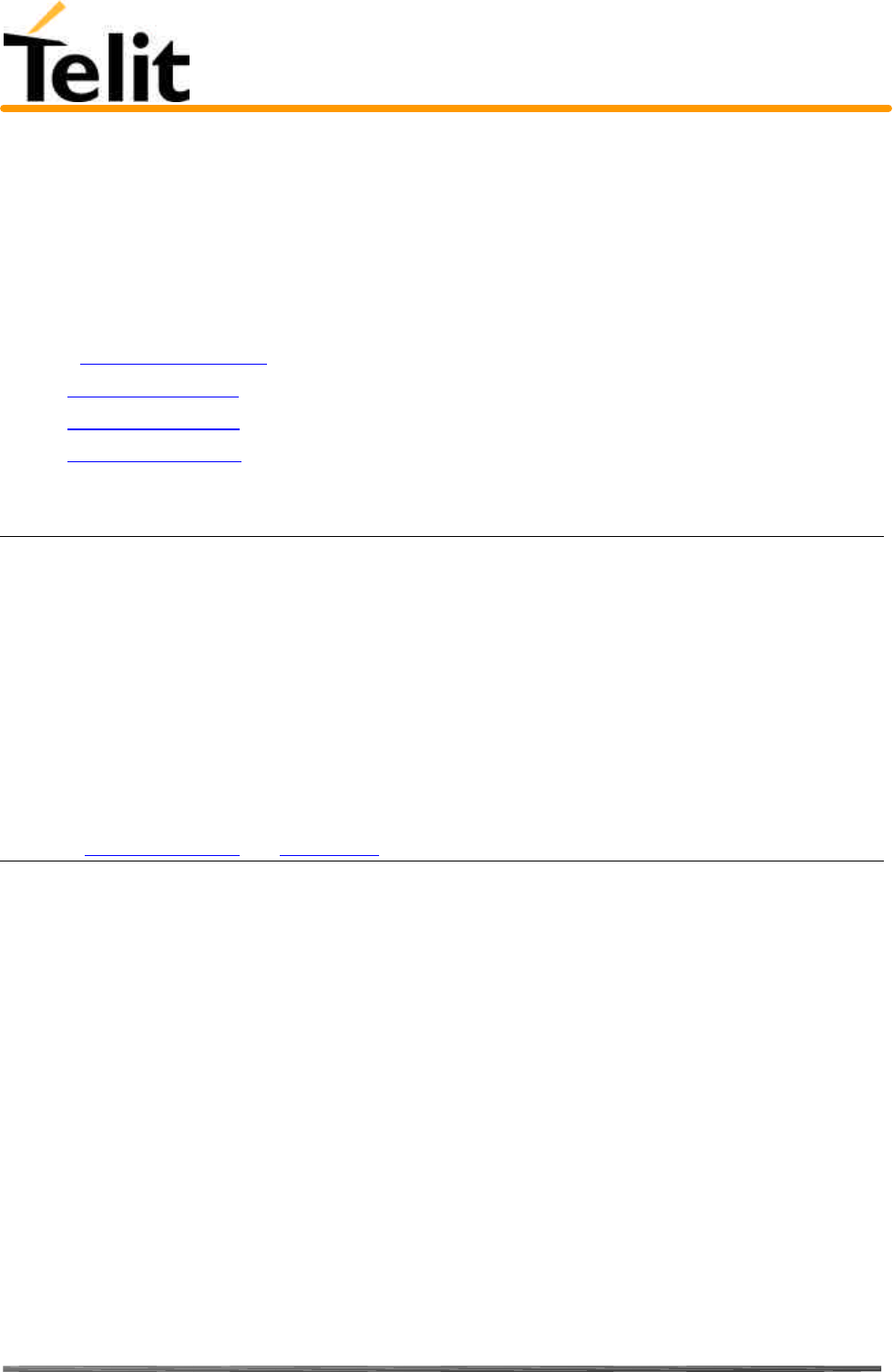
Telit TRIZIUM Product Description
80264ST10007a Rev. 4– 09/09/04
Reproduction forbidden without DAI Telecom written authorization – All Right reserved – Right of modification reserved page 10 of 202
q
q a high level specialist technical support to assist you in your development;
q free SW releases upgrade download (via the Website) every time a new functionality will be
added to the Telit modules SW.
For more updated information concerning product Roadmap and availability, technical
characteristics, commercial and other issues please check the Telit TRIZIUM modules dedicated
Website www.TRIZIUM.com or mail to:
ts-trizium@telit.net, for any Technical information or support you may need
ci-trizium@telit.net, for any Commercial, sales or marketing related info
af-trizium@telit.net , for After Sales issues
NOTE: Some of the performances of the Telit TRIZIUM modules depend on SW version
installed on the module itself. In particular on Chapter 5, dedicated to the supported AT
commands, the minimum SW version required to support each specific AT command is
reported.
The Telit TRIZIUM modules SW group is continuously working in order to add new features
and improve the overall performances. From time to time that a new SW version is released, it
will be freely distributed by the Telit TRIZIUM module dedicated Website
The Telit TRIZIUM modules are easily upgradeable by the developer using the Telit TRIZIUM
module Flash Programmer.
For more info about this topic (and not only !) please check Telit TRIZIUM modules dedicated
Website www.TRIZIUM.com. and www.telit.net
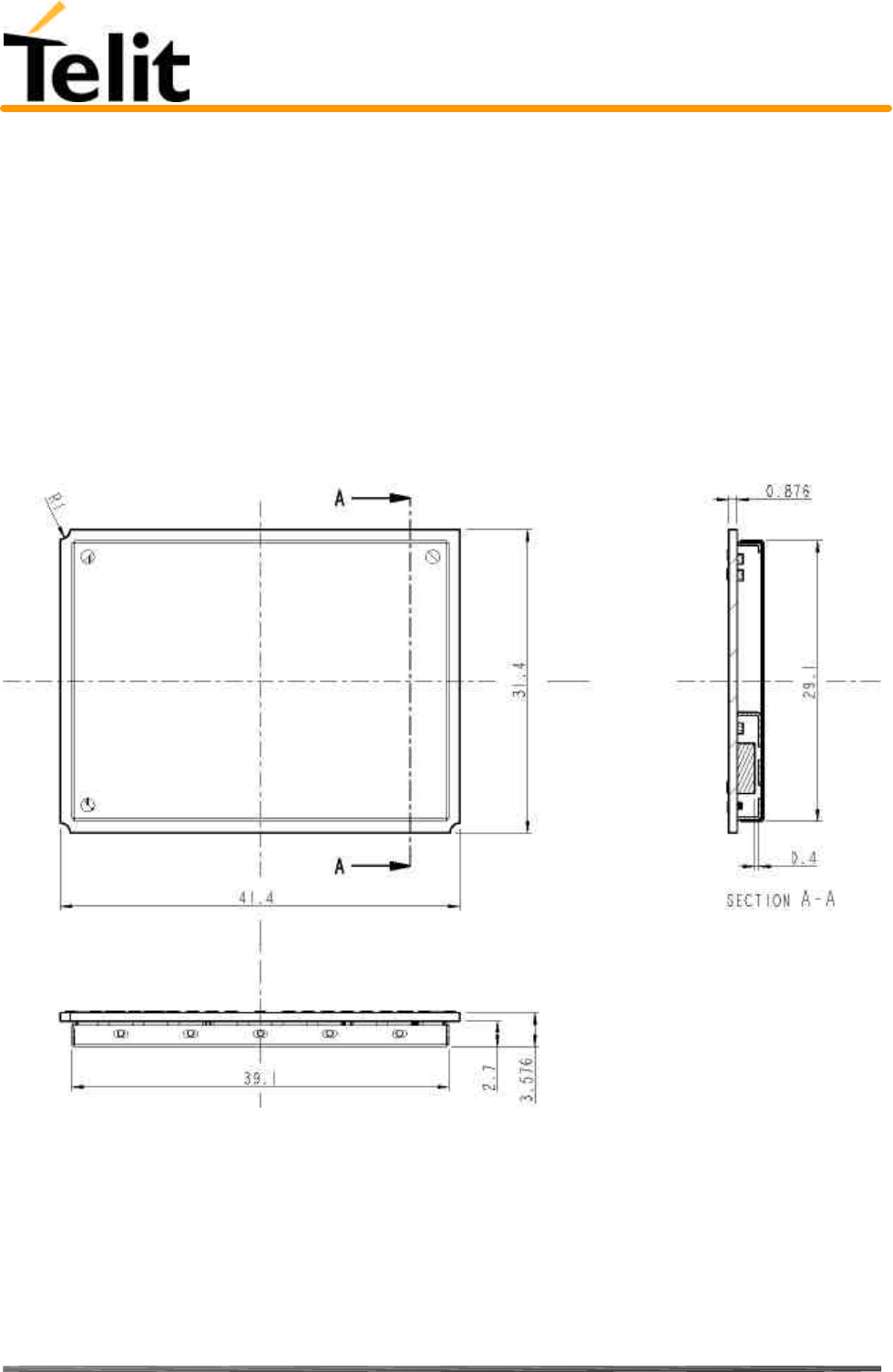
Telit TRIZIUM Product Description
80264ST10007a Rev. 4– 09/09/04
Reproduction forbidden without DAI Telecom written authorization – All Right reserved – Right of modification reserved page 11 of 202
2 General Product Description
2.1 Dimensions
The Telit TRIZIUM module overall dimension are:
• Lenght: 41,4 mm
• Width: 31,4 mm
• Thickness: 3,6 mm
The layout of Telit TRIZIUM module is shown in the following figure:
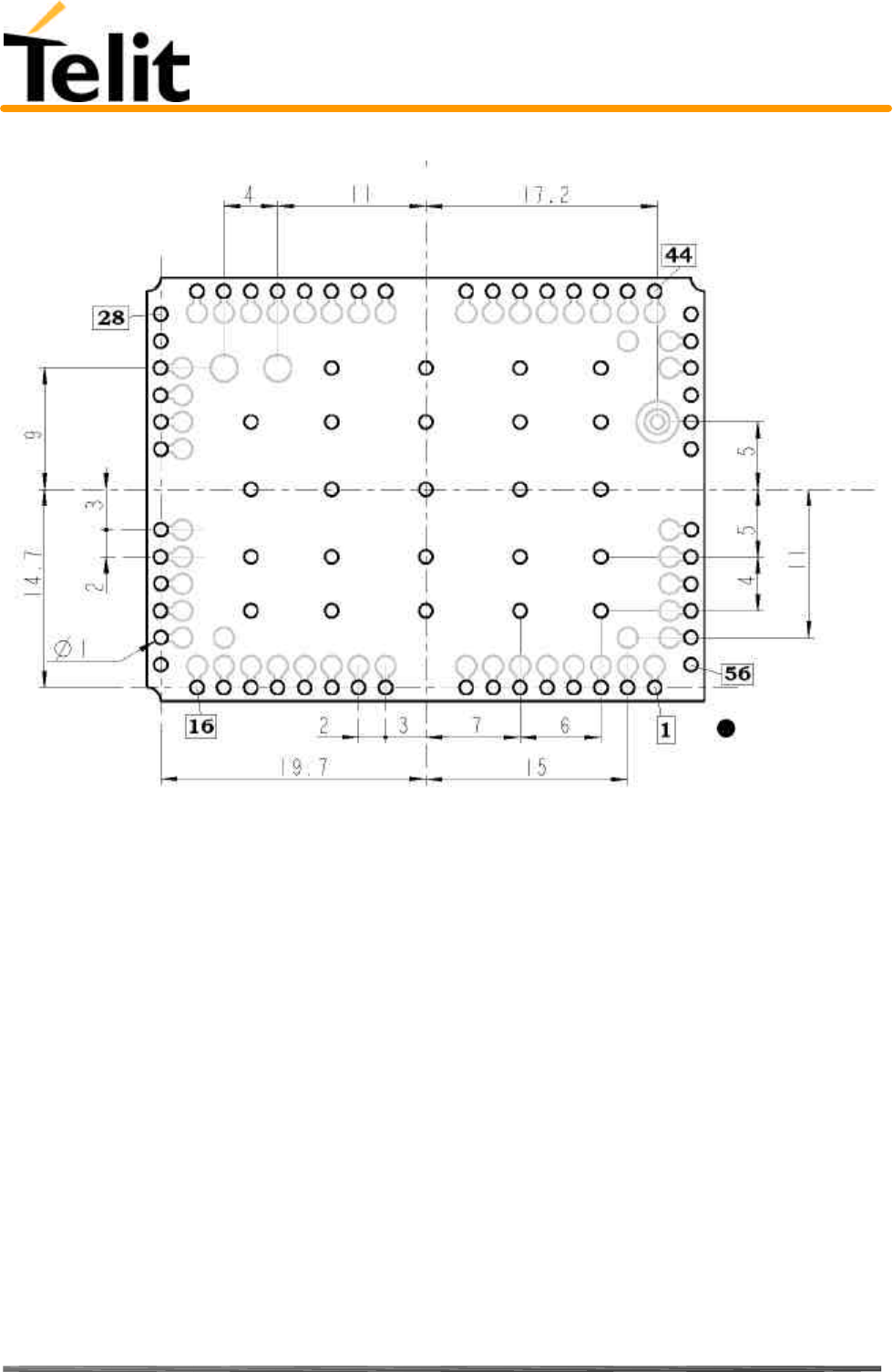
Telit TRIZIUM Product Description
80264ST10007a Rev. 4– 09/09/04
Reproduction forbidden without DAI Telecom written authorization – All Right reserved – Right of modification reserved page 12 of 202
Bottom View
2.2 Weight
The Telit TRIZIUM module weight is 9 gr.
2.3 Environmental requirements
The Telit TRIZIUM module is compliant with the applicable ETSI reference documentation GSM 05.05 Release1999
ETSI EN300910 V8.4.1
2.3.1 Temperature range
• Temperature in normal functional conditions –10°C ÷ +55°C
• Temperature in extreme functional conditions* –25°C ÷ +75°C
• Temperature in storage conditions –30°C ÷ +85°C
*these temperature can affect the sensitivity and performance of the module
2.3.2 Vibration Test (non functional)
• 10 ÷12Hz ASD = 1.92m 2 /s 3
• 12 ÷ 150Hz –3dB/oct
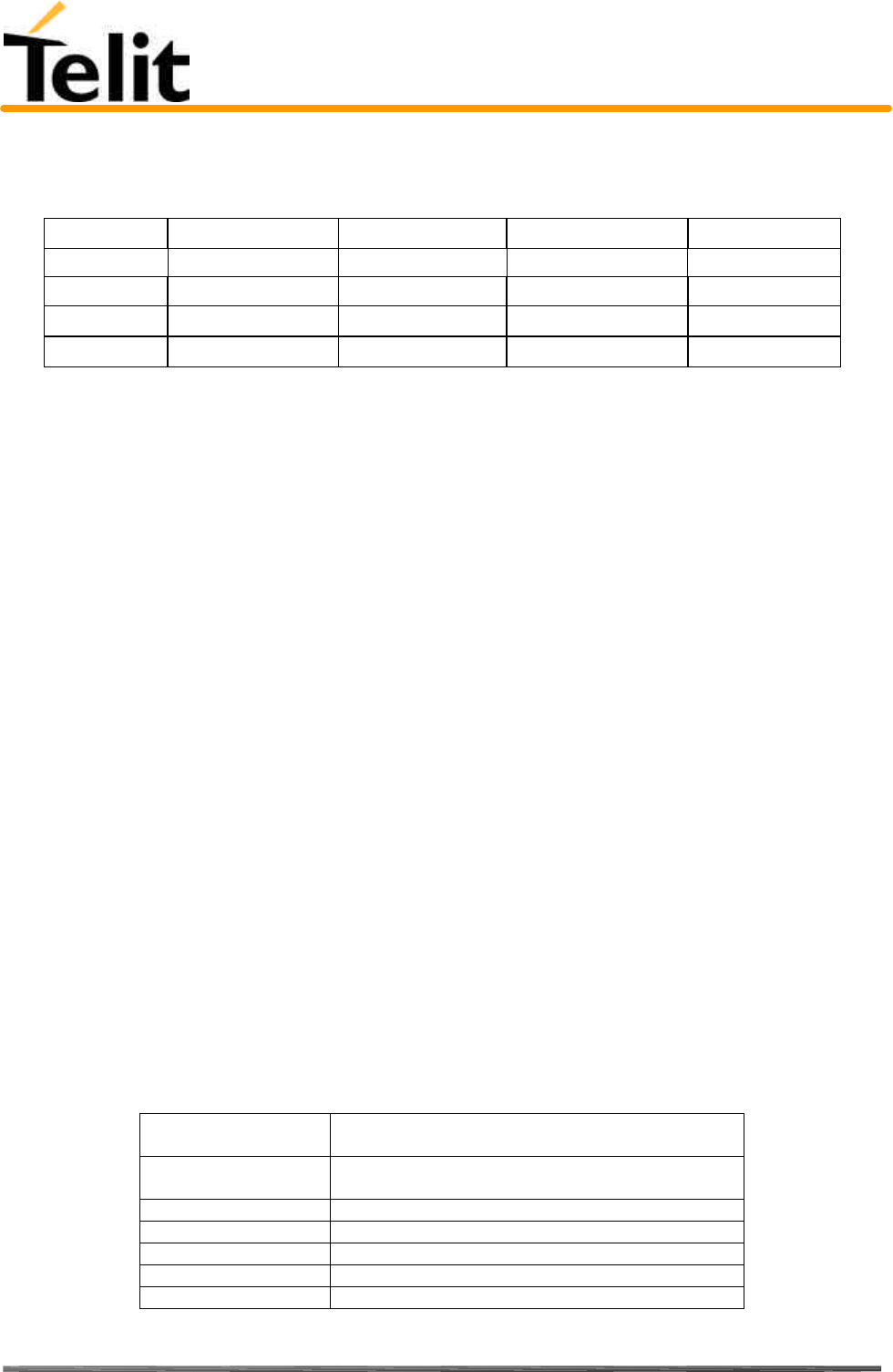
Telit TRIZIUM Product Description
80264ST10007a Rev. 4– 09/09/04
Reproduction forbidden without DAI Telecom written authorization – All Right reserved – Right of modification reserved page 13 of 202
2.4 Operating Frequency
The operating frequencies in GSM, DCS, PCS modes are conform to the GSM specifications.
Mode Freq. TX (MHz) Freq. RX (MHz) Channels (ARFC) TX - RX offset
E-GSM-900 890.0 - 914.8 935.0 - 959.8 0 – 124 45 MHz
880.2 - 889.8 925.2 - 934.8 975 - 1023
DCS-1800 1710.2 - 1784.8 1805.2 - 1879.8 512 – 885 95 MHz
PCS-1900 1850.2 - 1909.8 1930.2 - 1989.8 512 - 810 80 MHz
2.5 Transmitter output power
GSM–900
The Telit TRIZIUM transceiver module in GSM–900 operating mode are of class 4 in accordance with the specification
which determine the nominal 2W peak RF power (+33dBm) on 50 Ohm.
DCS–1800
The Telit TRIZIUM transceiver module in DCS–1800 operating mode are of class 1 in accordance with the specifications
which determine the nominal 1W peak RF power (+30dBm) on 50 Ohm.
PCS–1900
The Telit TRIZIUM transceiver module in PCS–1900 operating mode are of class 1 in accordance with the specifications
which determine the nominal 1W peak RF power (+30dBm) on 50 Ohm.
2.6 Reference sensitivity
GSM–900
The sensitivity of the Telit TRIZIUM transceiver module according to the specifications for the class 4 GSM–900
portable terminals is better than –102dBm in all the operational conditions.
DCS–1800
The sensitivity of the Telit TRIZIUM transceiver module according to the specifications for the class 1 portable terminals
GSM 1800 is better than –102dBm in normal operating conditions.
PCS–1900
The sensitivity of the Telit TRIZIUM transceiver module according to the specifications for the class 1 portable terminals
PCS 1900 is better than –102dBm in normal operating conditions.
2.7 Antenna
The antenna that the customer chooses to use, depending on his application, should fulfil the
following requirements:
Frequency range Standard Dual Band frequency range,
Standard Tri Band frequency range
Bandwith 80 MHz in GSM & 170 MHz in DCS & 140 MHz
PCS band
Gain > 0 dBi; < 3 dBi
Impedance 50 ohm
Input power > 2 W peak power
VSWR absolute max <= 10:1
VSWR recommended <= 2:1

Telit TRIZIUM Product Description
80264ST10007a Rev. 4– 09/09/04
Reproduction forbidden without DAI Telecom written authorization – All Right reserved – Right of modification reserved page 14 of 202
2.7.1 Antenna connector
N/A
2.8 Supply voltage
The external power supply must be connected to VBATT signal (see paragraph 2.16,) and must fulfil the following
requirements:
• Nominal operating voltage 3.8 V
• Operating voltage range 3.4 V - 4.2 V
Note: Operating voltage range must never be exceeded, care must be taken in order to fulfill min/max voltage
requirements.
2.9 Power consumption
The typical current consumption of the Telit TRIZIUM module are:
• Power off current (typical) < 30 µA;
• Stand–by current < 19 mArms (< 4 mArms using command AT+CFUN )
• Operating current in voice ch. 170 mArms @ typical network conditions
• Operating current in voice ch. < 270 mArms 1.9 Apeak @ worst network conditions
• Operating current in GPRS class 10 < 500 mArms @ typical network conditions
2.10 Embodied Battery charger
The battery charger is suited for 3.7V Li-Ion rechargeable battery (suggested capacity 500-1000mAH). The Charger
needs only a CURRENT LIMITED power source input and charges the battery directly through VBATT connector
pins.
• Battery charger input pin CHARGE
• Battery pins VBATT, GND
• Battery charger input voltage min 5.0 V
• Battery charger input voltage typ 5.5 V
• Battery charger input voltage max 7.0 V
• Battery charger input current max 400mA
• Battery type Li-Ion rechargeable
NOTE: If embodied battery charger is used, then a LOW ESR capacitor of at least 100µF must be mounted in parallel
to VBATT TRIZIUM pins.
NOTE: when power is supplied to the CHARGE pin, a battery must always be connected to the VBATT pins of the
TRIZIUM.
2.11 User Interface
The user interface is managed by AT commands specified on the GSM 07.07 and 07.05 specification and listed in the
chapter 5, AT Command.
2.11.1 Speech Coding
The Telit TRIZIUM modules vocoder supports the following rates:
• Half Rate.
• Full rate,
• Enhanced Full Rate

Telit TRIZIUM Product Description
80264ST10007a Rev. 4– 09/09/04
Reproduction forbidden without DAI Telecom written authorization – All Right reserved – Right of modification reserved page 15 of 202
2.11.2 Sim Reader
The Telit TRIZIUM modules support phase 2 GSM11.14 - SIM 3V volts ONLY with and external SIM connector. For 5V
SIM operation an external level translator can be added.
2.11.3 SMS
The Telit TRIZIUM module supports the following SMS types:
Mobile Terminated (MT) class 0 – 2 with signaling of new incoming SMS, SIM full, SMS read
Mobile Originated class 0 – 3 with writing, memorize in SIM and sending
Cell Broadcast compatible with CB DRX with signaling of new incoming SMS.
2.11.4 Real Time Clock and Alarm
The Telit TRIZIUM module supports the Real Time Clock and Alarm functions through AT commands, furthermore an
alarm output pin (GPIO6) can be configured to indicate the alarm with a hardware line output.
Furthermore the Voltage Output of the RTC power supply is provided so that a backup capacitor can be added to
increase the RTC autonomy.
2.11.5 Data/fax transmission
The Telit TRIZIUM module supports:
• Packed Data transfer GPRS Class B, Multislot Class 10
• Data transmission according to the GSM 07.07, 07.05
• CSD up to 14.4 Kbps
• Fax service, Class 1 Group 3
• Fax service, Class 2 Group 3 (future SW release)
2.11.6 Local security management
With lock of Subscriber Identity module (SIM), and security code request at power–up.
2.11.7 Call control
Call cost control function.
2.11.8 Phonebook
Function available to store the telephone numbers in SIM memory.
Capability depends on SIM version/memory
2.11.9 Characters management
Availability of lowercase, uppercase and IRA characters. (international reference alphabet)
In SMS PDU mode all character set are supported.
2.11.10 SIM related functions
Activation/deactivation of the numbers stored in phone book FDN, ADN and PINs. Extension at the PIN2 for the PUK2
insertion capability for lock condition.
2.11.11 Call status indication
By AT commands.
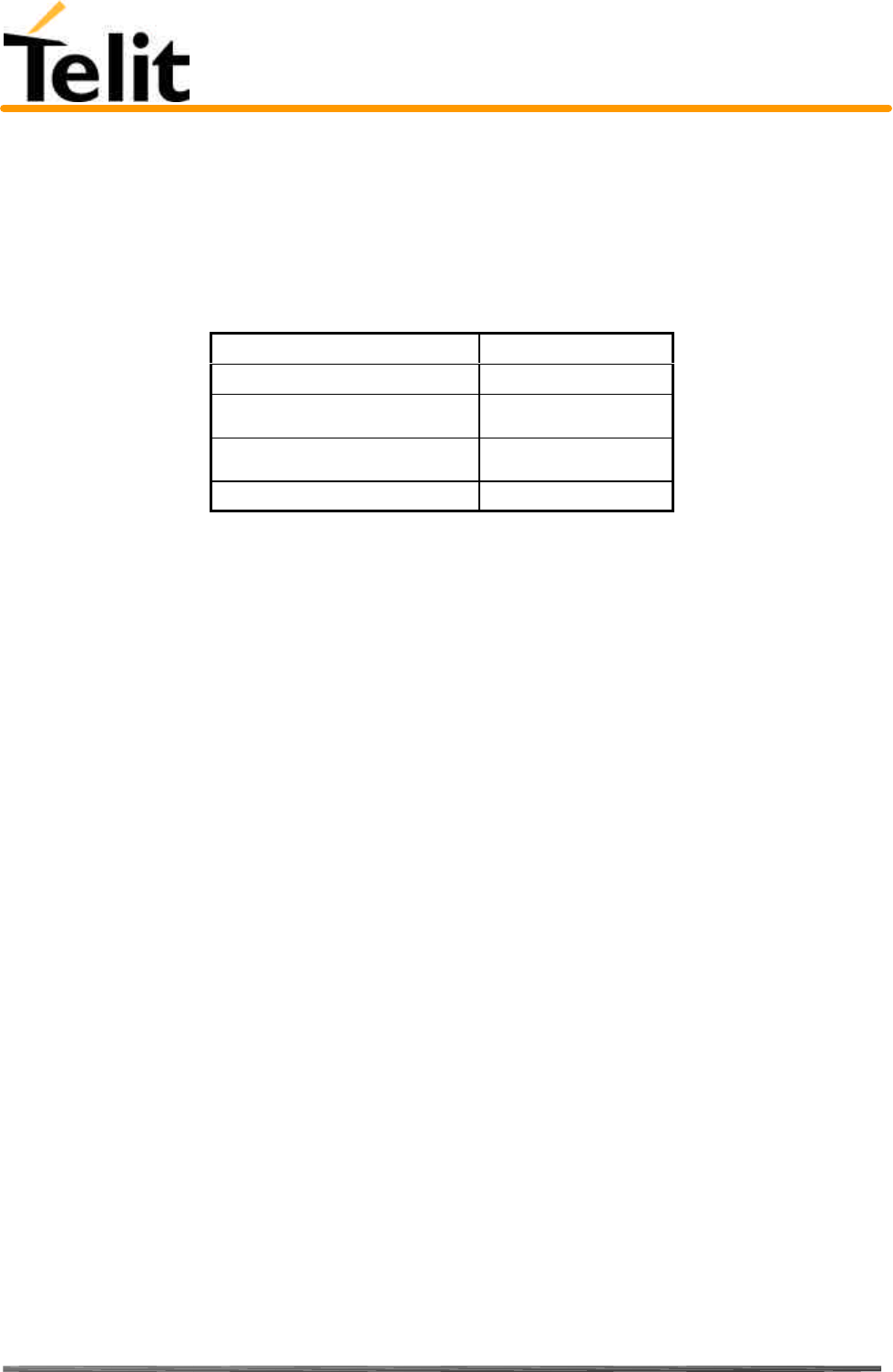
Telit TRIZIUM Product Description
80264ST10007a Rev. 4– 09/09/04
Reproduction forbidden without DAI Telecom written authorization – All Right reserved – Right of modification reserved page 16 of 202
2.11.12 Indication of network service availability
By AT commands and LED indication on dedicated output.
The STAT_LED is an Open Collector output where it is possible to directly connect a LED to show information on the
network service availability and Call status.
STAT_LED indications
LED status Device Status
permanently off device off
fast blinking
(period 1s, Ton 0,5s) Net search / Not
registered / turning off
slow blinking
(period 3s, Ton 0,3s) Registered full service
Permanently on a call is active
2.11.13 Automatic answer (Voice, Data or FAX)
After n (depends of settings) rings automatically answers with beep (see S0 param).
2.11.14 Supplementary services (SS)
• Call Barring,
• Call Forwarding,
• Calling Line Identification Presentation (CLIP),
• Calling Line Identification Restriction (CLIR),
• Call Waiting, other party call Waiting Indication,
• Call Hold, other party Hold / Retrieved Indication,
• Closed User Group supplementary service (CUG),
• Advice of Charge,
• Unstructured SS Mobile Originated (MO)
2.11.15 Acoustic signaling
The acoustic signalling of Telit TRIZIUM module on the selected acoustic device are the following:
• Call waiting;
• Ringing tone;
• SMS received tone;
• Busy tone;
• Power on/off tone;
• Off Hook dial tone;
• Congestion tone;
• Connected tone;
• Call dropped;
• No service tone;
• Alarm tone.
2.11.16 DTMF tones
DTMF tones managed by specific AT commands.
These tones are generated with AT commands only during voice calls.
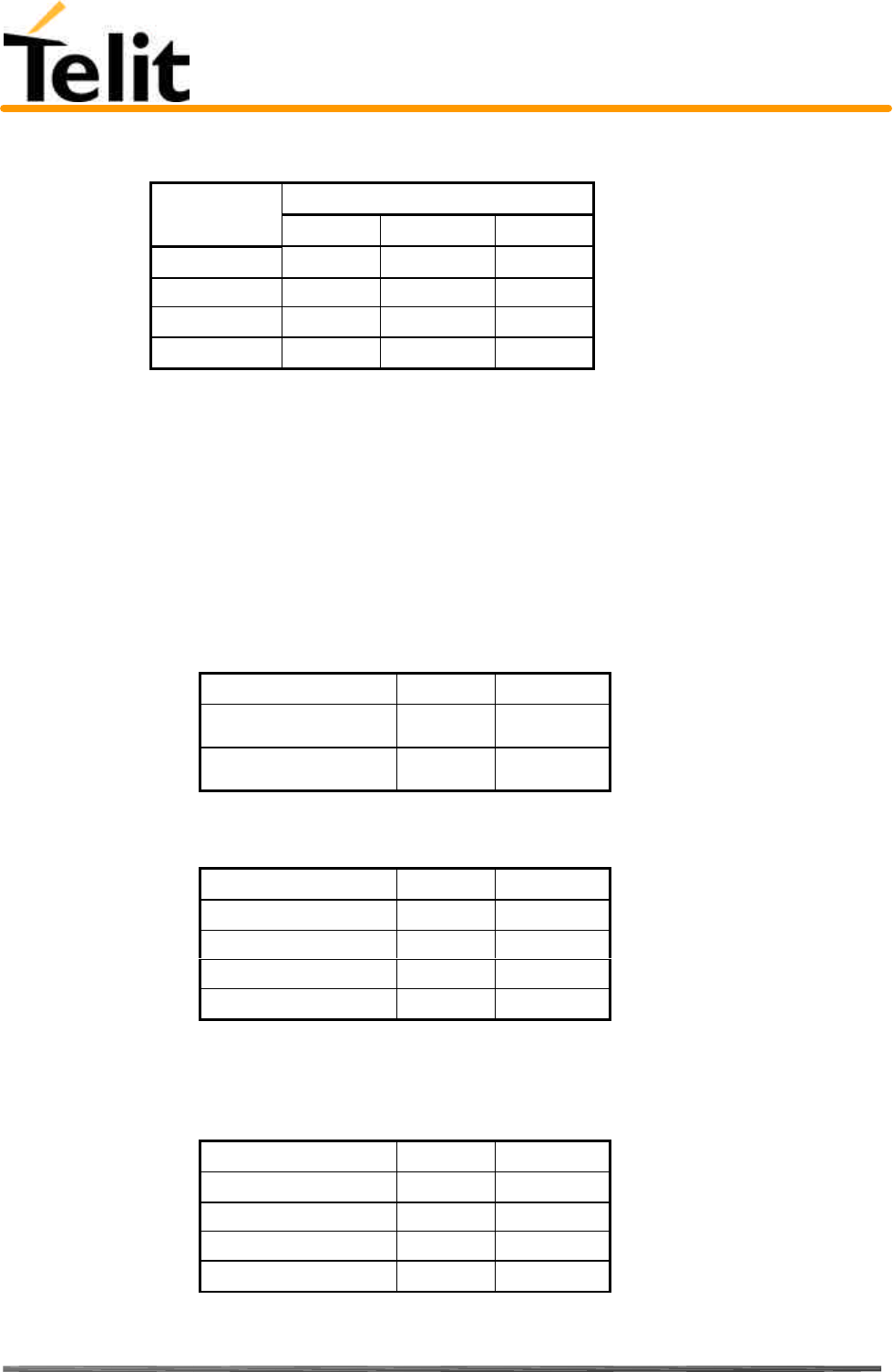
Telit TRIZIUM Product Description
80264ST10007a Rev. 4– 09/09/04
Reproduction forbidden without DAI Telecom written authorization – All Right reserved – Right of modification reserved page 17 of 202
The minimum duration of a DTMF tone is 100 ms.
Group high
Group low 1209 Hz 1336 Hz 1477 Hz
697 Hz 1 2 3
770 Hz 4 5 6
852 Hz 7 8 9
941 Hz * 0 #
2.11.17 Buzzer output
The General Purpose I/O pin GPIO7 can be configured to output the BUZZER output signal, with only an external
Mosfet/transistor and a diode a Buzzer can be directly driven.
The ringing tone and the other signaling tones can be redirected to this Buzzer output with a specific AT command.
2.12 Logic level specifications
Where not specifically stated, all the interface circuits work at 2.8V CMOS logic levels.
The following table shows the logic level specifications used in the Telit TRIZIUM module interface circuits:
Absolute Maximum Ratings -Not Functional
Parameter Min Max
Input level on any digital
pin when on -0.3V +3.75V
Input voltage on analog
pins when on -0.3V +3.0 V
Operating Range - Interface levels (2.8V CMOS)
Level Min Max
Input high level 2.1V 3.3V
Input low level 0V 0.5V
Output high level 2.2V 3.0V
Output low level 0V 0.35V
For 2,0V signals:
Operating Range - Interface levels (2.0V CMOS)
Level Min Max
Input high level 1.6V 3.3V
Input low level 0V 0.4V
Output high level 1,65V 2.2V
Output low level 0V 0.35V
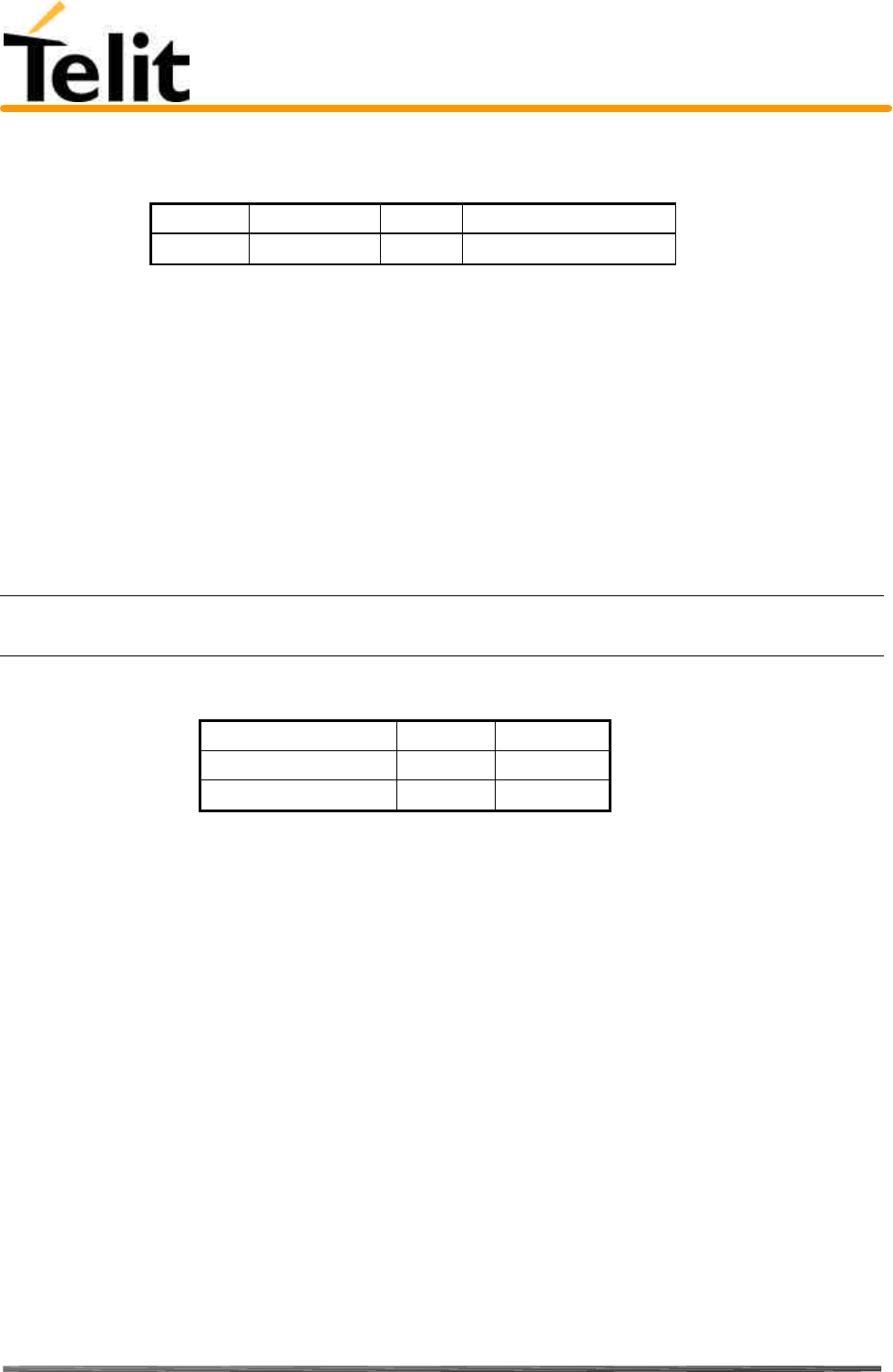
Telit TRIZIUM Product Description
80264ST10007a Rev. 4– 09/09/04
Reproduction forbidden without DAI Telecom written authorization – All Right reserved – Right of modification reserved page 18 of 202
2.12.1 Reset signal
Signal Function I/O Pin
RESET Phone reset I/O 23 (connector SO301)
RESET is used to reset the Telit TRIZIUM module. Whenever this signal is pulled low, the TRIZIUM
is reset. When the device is reset it stops any operation and after the release of the reset it shuts
down, without doing any detach operation from the network where it is registered to. This behavior
is not a proper shut down because any GSM device is requested to issue a detach request on turn
off. For this reason the Reset signal must not be used to normally shutting down the device, but
only as an emergency exit in the rare case the device remains stucked waiting for some network
response.
The RESET is internally controlled on start-up to achieve always a proper power-on reset sequence,
so there's no need to control this pin on start-up. It may only be used to reset a device already on
that is not responding to any command.
NOTE: do not use this signal to power off the Telit TRIZIUM module. Use the ON/OFF signal
(Pin 17 of SO301) to perform this function or the AT#SHDN command.
Reset Signal Operating levels:
Signal Min Max
RESET Input high 2.2V* 3.3V
RESET Input low 0V 0.2V
* this signal is internally pulled up so the pin can be left floating if not used.
If unused, this signal may be left unconnected. If used, then it must always be connected with an open collector
transistor, to permit to the internal circuitry the power on reset and undervoltage lockout functions.
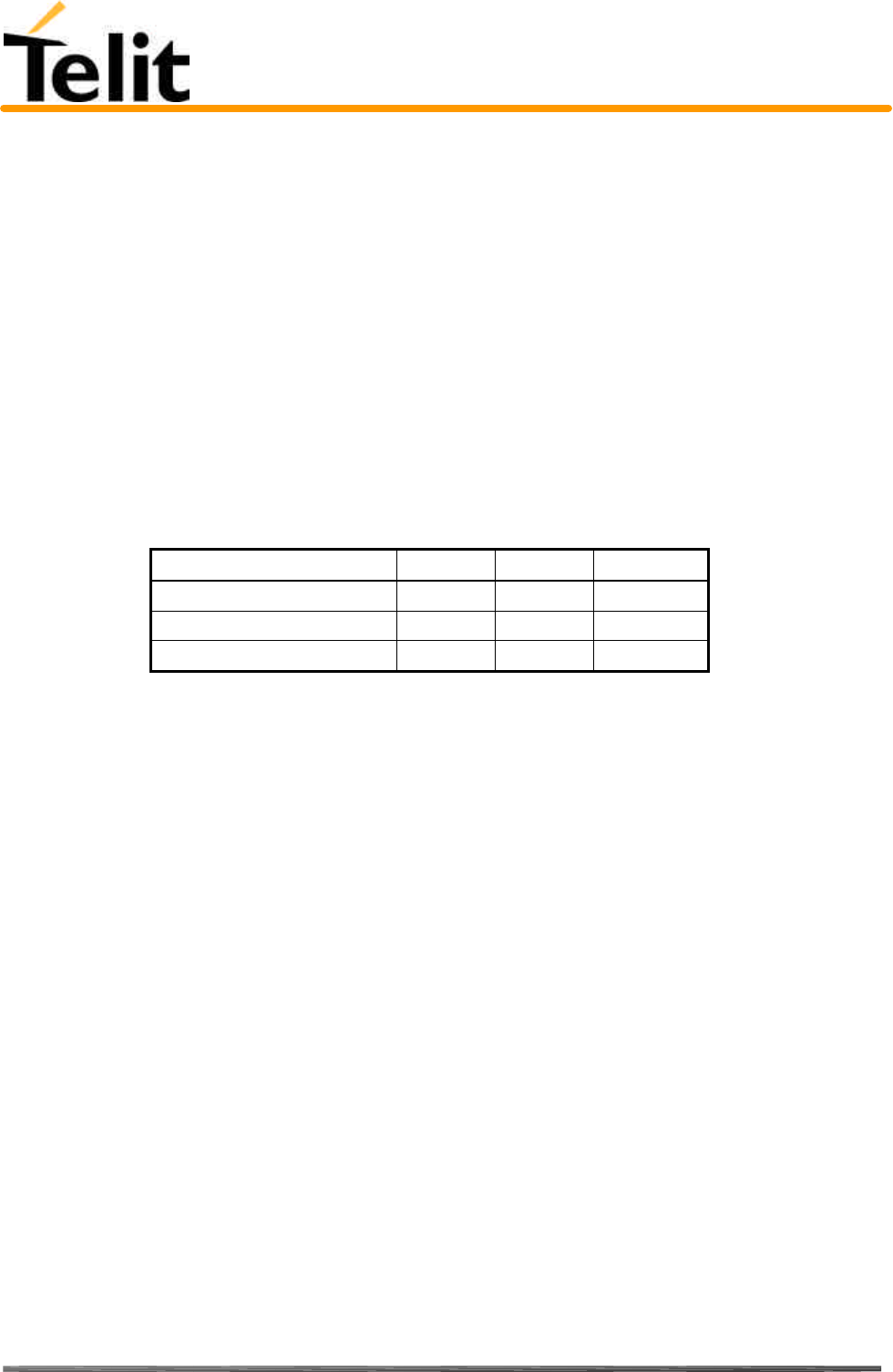
Telit TRIZIUM Product Description
80264ST10007a Rev. 4– 09/09/04
Reproduction forbidden without DAI Telecom written authorization – All Right reserved – Right of modification reserved page 19 of 202
2.13 RTC Bypass out
The PIN VRTC brings out the Real Time Clock supply which is separate from the rest of the digital part, allowing to
have only RTC going on when all the other parts of the device are off.
To this power output a backup capacitor can be added in order to increase the RTC autonomy during power off of the
battery. NO Devices must be powered from this pin.
2.14 Vout power output
A regulated power supply output is provided in order to supply small devices from module.
This output is active when the module is ON and goes off when module is shut down.
The operating range characteristics of the supply are:
Operating Range - Vout power supply
Min Typ Max
Output voltage 2.75V 2.85V 2.95V
Output current 100mA
Output bypass capacitor 2.2µF
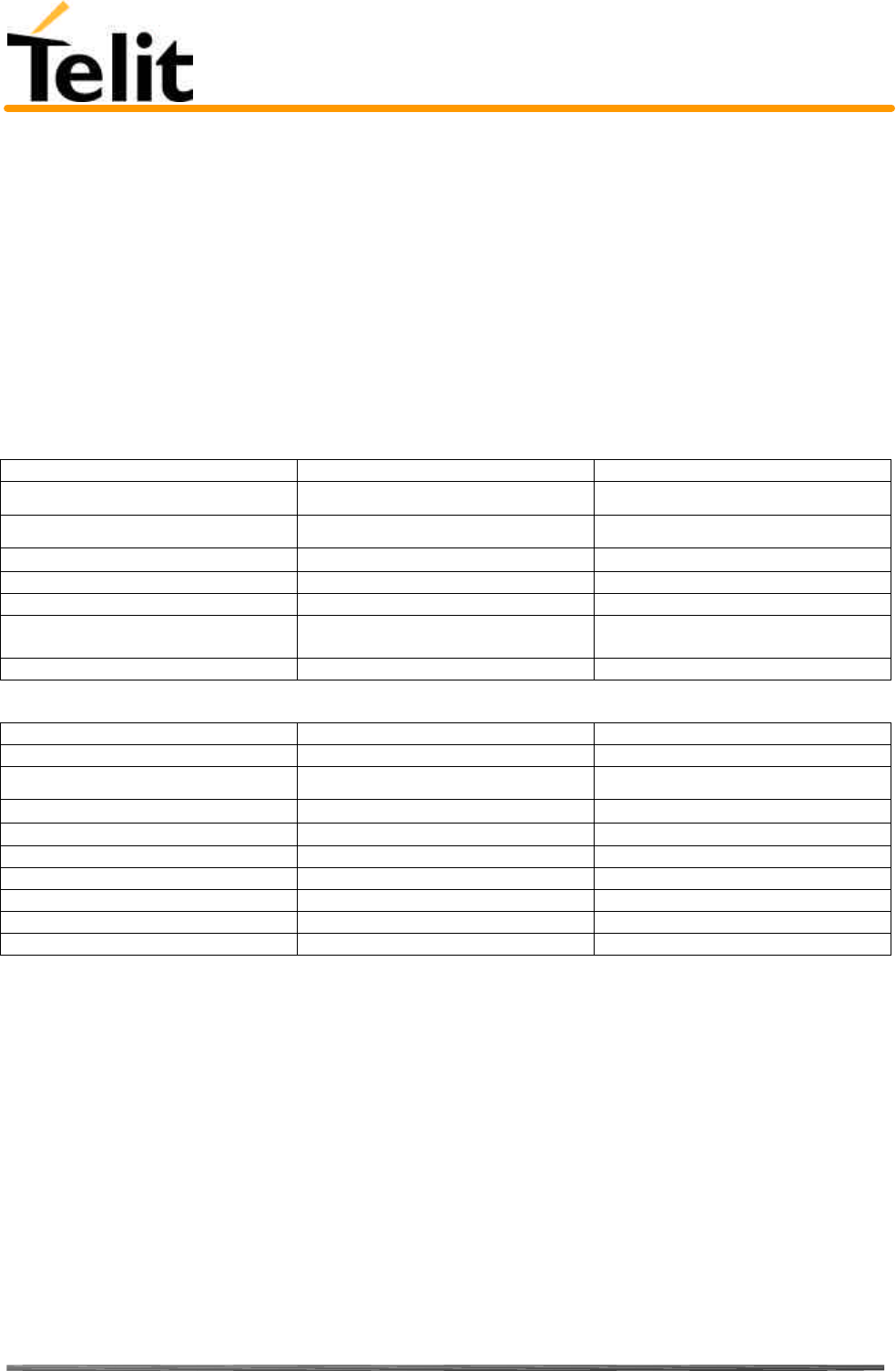
Telit TRIZIUM Product Description
80264ST10007a Rev. 4– 09/09/04
Reproduction forbidden without DAI Telecom written authorization – All Right reserved – Right of modification reserved page 20 of 202
2.15 Audio levels specifications
The audio of the Telit TRIZIUM module is organized into two main paths:
- internal path (called also MT)
- external path (called also HF)
These two paths are meant respectively for handset and headset/handsfree use.
The Telit TRIZIUM module has a built in echo canceller and a noise suppressor, tuned separately for the two audio paths;
for the internal path the echo canceller parameters are suited to cancel the echo generated by a handset, while for the
external audio path they are suited for a handsfree use.
For more information on the audio refer to the Hardware User Guide.
The following table reports all the audio level specifications.
Microphone characteristics Internal audio mic. input External audio mic. input
Line coupling AC ( 100nF cond.) AC ( 100nF cond.)
Line type Balanced Balanced
Differential input resistance 25kΩ25kΩ
Line nominal sensitivity 50mVrms 3mVrms
Max input voltage 360mVrms 22mVrms
Microphone nominal sensitivity -
Analog Gain suggested -45dBVrms/Pa / +24dB -45dBVrms/Pa / +10dB
Echo canceller type handset Car kit hands free
Speaker characteristics Internal audio ear. output External audio ear. output
Line coupling DC DC
Line type Bridged Bridged
Speaker impedance ≥ 16Ω ± 5% @ 1kHz ≥ 16Ω ± 5% @ 1kHz
Minimun load impedance 15Ω15Ω
Signal bandwidth 150-8000 Hz @ -3dB 150-8000 Hz @ -3dB
Maximum output 1700mVrms 850mVrms
Maximum power output 30mW 7.5mW
Volume level steps (SW) -2dB -2dB
Number of volume steps (SW) 10 10
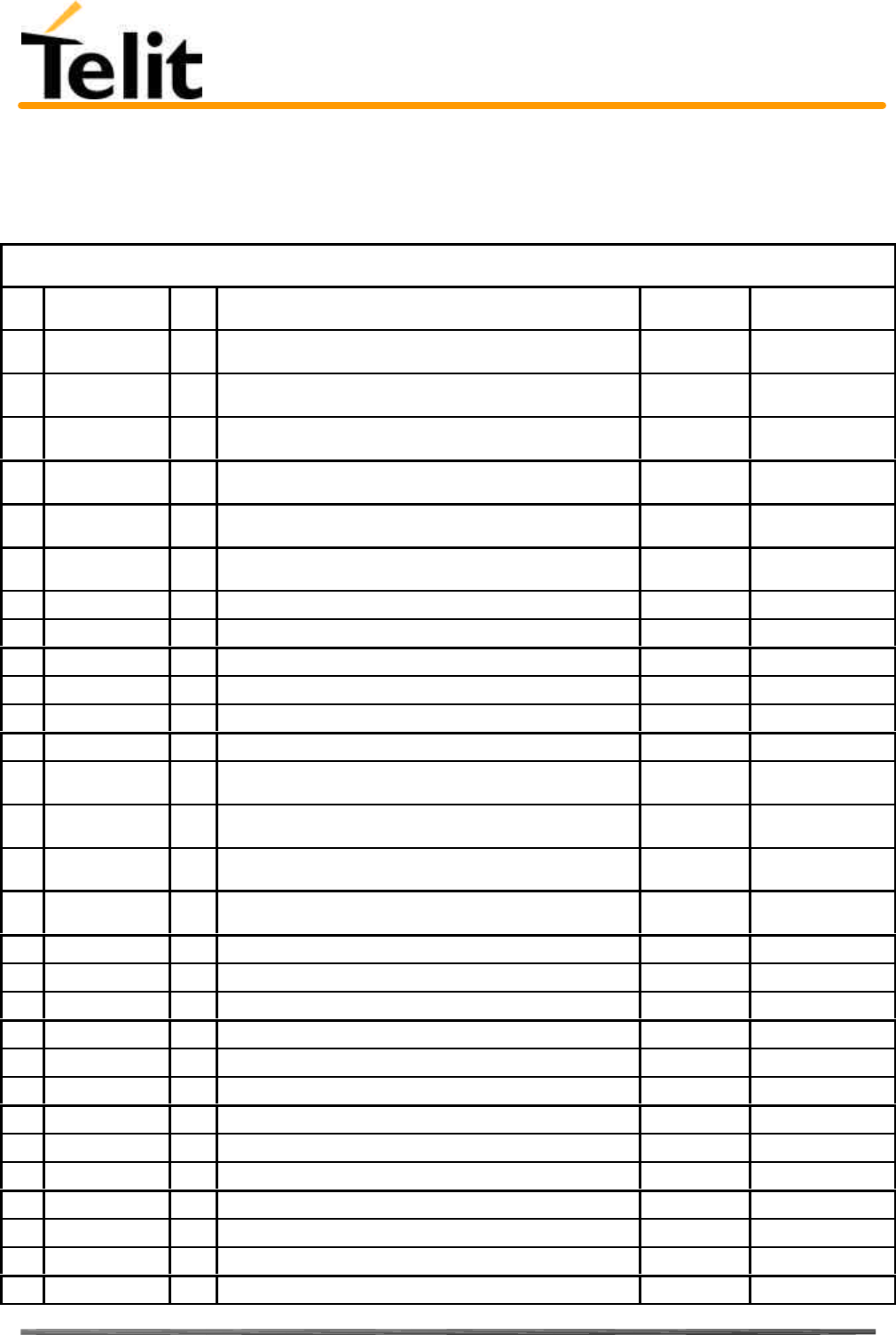
Telit TRIZIUM Product Description
80264ST10007a Rev. 4– 09/09/04
Reproduction forbidden without DAI Telecom written authorization – All Right reserved – Right of modification reserved page 21 of 202
2.16 Interfaces on TRIZIUM
TRIZIUM PIN-OUT
Pin Signal I/O Function Internal
Pull up Type
1PD5
GPIO13 I/O Port D5 / GPIO13 (4) CMOS 2.8V
2PD4
GPIO12 I/O Port D4 / GPIO12 (4) CMOS 2.8V
3PD3
GPIO11 I/O Port D3 / GPIO11 (4) CMOS 2.8V
4PD2
GPIO10 I/O Port D2 / GPIO10 (4) CMOS 2.8V
5PD1
GPIO9 I/O Port D1 / GPIO9 (4) CMOS 2.8V
6PD0
GPIO8 I/O Port D0 / GPIO8 (4) CMOS 2.8V
7MON1_CAM I/O Camera clock (4) CMOS 2.8V
8GND -Ground Power
9EAR_MT- AO Handset earphone signal output, phase - Audio
10 EAR_MT+ AO Handset earphone signal output, phase + Audio
11 EAR_HF+ AO Handsfree ear output, phase + Audio
12 EAR_HF- AO Handsfree ear output, phase - Audio
13 MIC_MT+ AI Handset microphone signal input; phase+, nominal level
50mVrms Audio
14 MIC_MT- AI Handset microphone signal input; phase-, nominal level
50mVrms Audio
15 MIC_HF+ AI Handsfree microphone input; phase +, nominal level
3mVrms Audio
16 MIC_HF- AI Handsfree microphone input; phase -, nominal level
3mVrms Audio
17 GND -Ground Power
18 SIMCLK OExternal SIM signal – Clock 3V ONLY
19 SIMRST OExternal SIM signal – Reset 3V ONLY
20 SIMIO I/O External SIM signal - Data I/O 3V ONLY
21 CCIN I/O External SIM signal - Presence (active low) 47KΩCMOS 2.8V
22 SIMVCC -External SIM signal – Power (3) 3V ONLY
23 ADC AI Analog/Digital converter input A/D
24 VBATT -Main power supply Power
25 TX_TRACE TX Data for debug monitor (1) CMOS 2.8V
26 RX_TRACE RX Data for debug monitor (1) CMOS 2.8V
27 VRTC AO VRTC Backup capacitor Power
28 GND -Ground Power
29 STAT_LED OStatus indicator led CMOS 2.8V
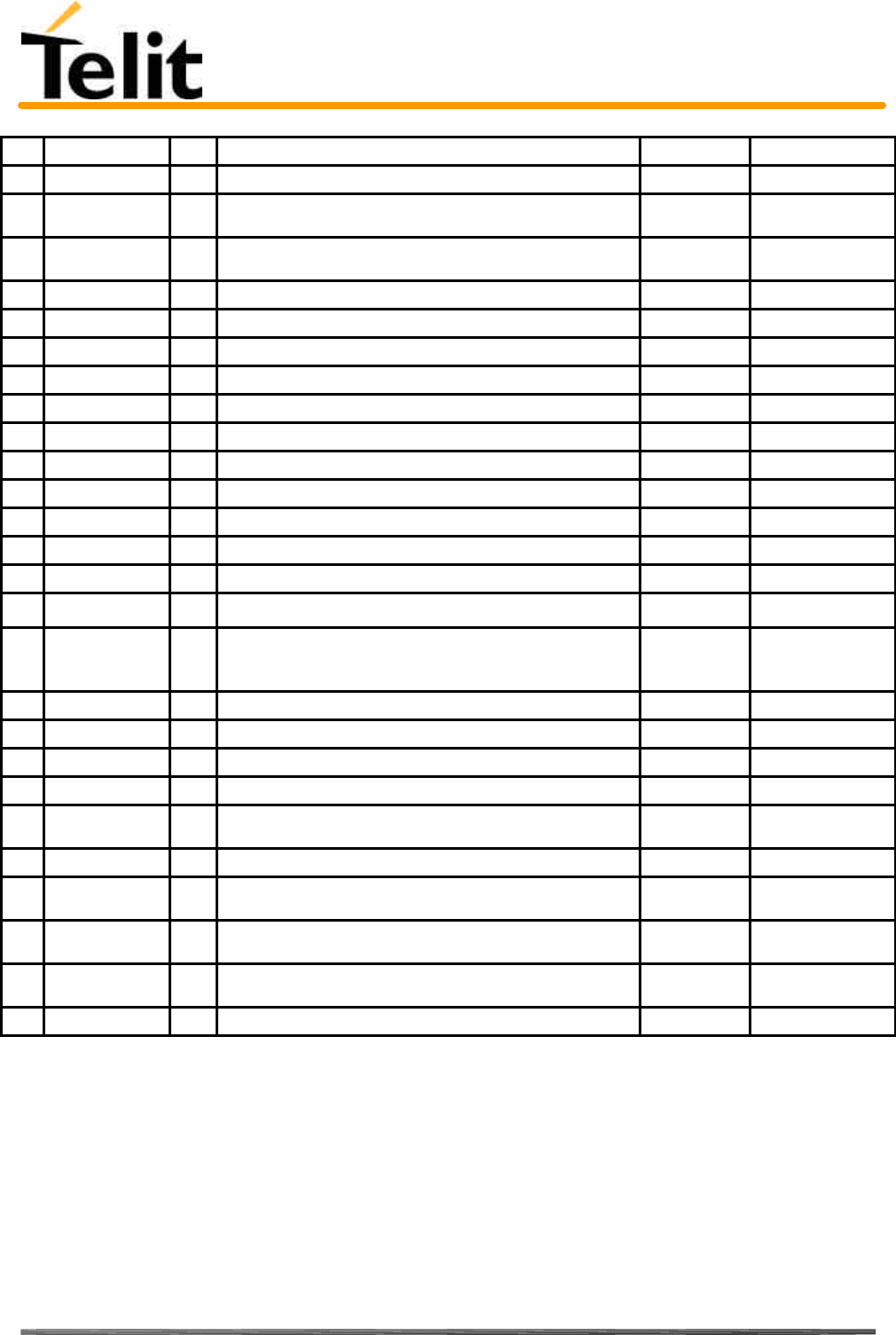
Telit TRIZIUM Product Description
80264ST10007a Rev. 4– 09/09/04
Reproduction forbidden without DAI Telecom written authorization – All Right reserved – Right of modification reserved page 22 of 202
30 AXE IHandsfree switching 100KΩCMOS 2.8V
31 VOUT -Power output for external accessories (camera) -
32 IICSDA GPIO4 I/O Camera IIC interface / GPIO4 Configurable general
purpose I/O pin (4) CMOS 2.8V
33 IICSCL GPIO2 I/O Camera IIC interface / GPIO2 Configurable general
purpose I/O pin (4) CMOS 2.8V
34 GPIO1 I/O GPIO1 Configurable general purpose I/O pin CMOS 2.8V
35 CHARGE AI Charger input Power
36 GND -Ground Power
37 C103/TXD ISerial data input (TXD) from DTE CMOS 2.8V
38 C104/RXD OSerial data output to DTE CMOS 2.8V
39 C108/DTR IInput for Data terminal ready signal (DTR) from DTE (4) CMOS 2.8V
40 C105/RTS IInput for Request to send signal (RTS) from DTE CMOS 2.8V
41 C106/CTS OOutput for Clear to send signal (CTS) to DTE CMOS 2.8V
42 C109/DCD OOutput for Data carrier detect signal (DCD) to DTE CMOS 2.8V
43 C107/DSR OOutput for Data set ready signal (DSR) to DTE CMOS 2.8V
44 C125/RING OOutput for Ring indicator signal (RI) to DTE CMOS 2.8V
45 GND -Ground Power
46 ON/OFF IInput command for switching power ON or OFF (toggle
command). The pulse to be sent to the TRIZIUM must be
equal or greater than 1 second.
47KΩPull up to VBATT
47 RESET IReset input 2KΩsee par.2.12.1
48 GND -Ground Power
49 ANTENNA OAntenna output - 50 ohm RF
50 GND -Ground Power
51 OE_CAM
GPIO7 I/O Output Enable Camera / GPIO7 (4) CMOS 2.8V
52 CAM_SYNC I/O Camera Sync (4) CMOS 2.8V
53 CAM_DRDY
GPIO5 I/O Camera DRDY / GPIO5 (4) CMOS 2.8V
54 PD7
GPIO6 I/O Port D7 / GPIO6 (4) CMOS 2.8V
55 PD6
GPIO3 I/O Port D6 / GPIO3 (4) CMOS 2.8V
56 GND -Ground Power
(1) For the exclusive use of the Technical Support Service
(2) An earphone with a 150 ohm impedance can be directly connected to EAR+ and EAR–
(3) On this pin a maximum of 47nF bypass capacitor is allowed.
(4) When activating the Easy camera these pins will not be available for other use
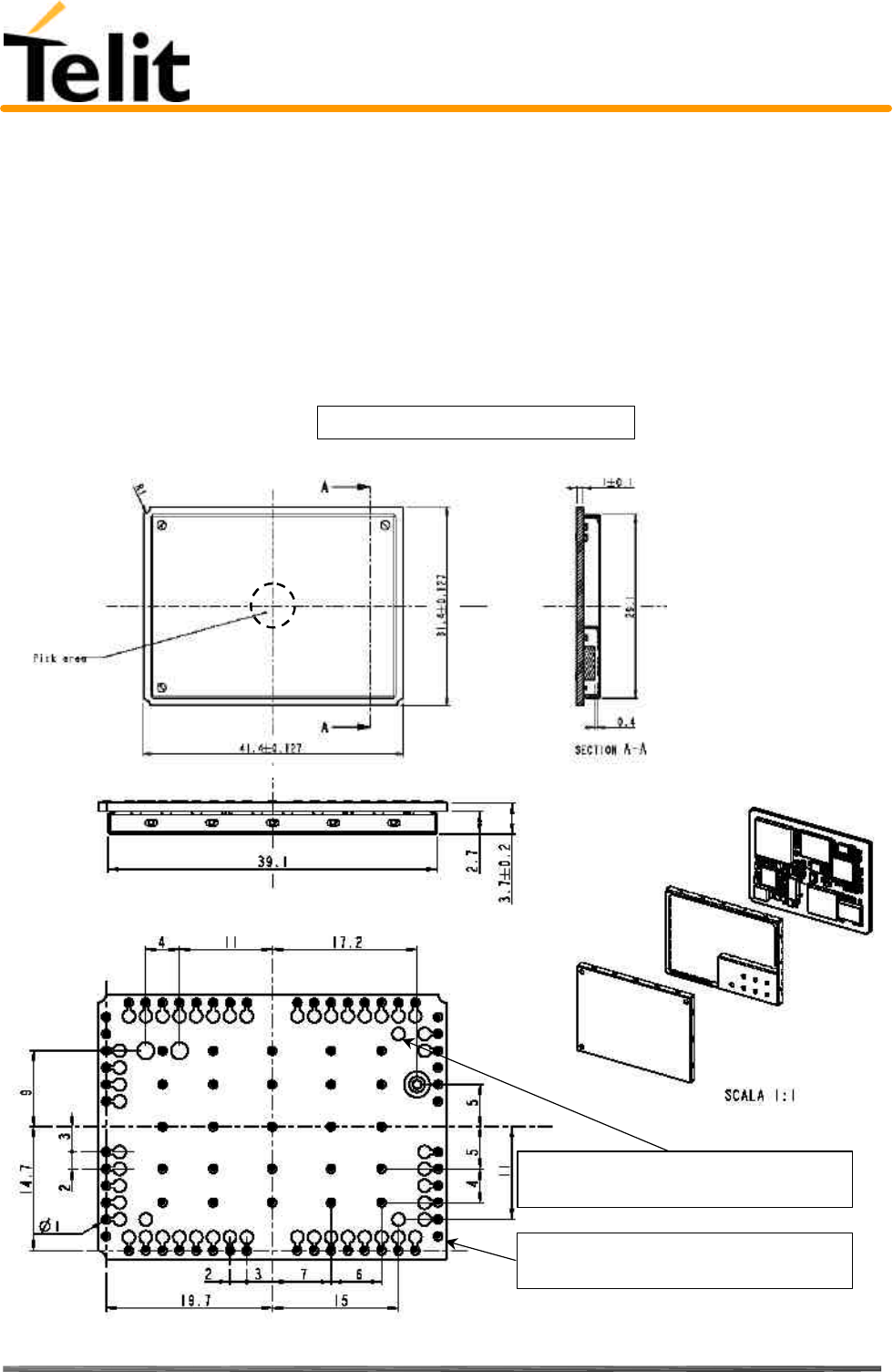
Telit TRIZIUM Product Description
80264ST10007a Rev. 4– 09/09/04
Reproduction forbidden without DAI Telecom written authorization – All Right reserved – Right of modification reserved page 23 of 202
2.17 Mounting the TRIZIUM on your Board
2.17.1 General
Trizium module has been designed in order to be compliant with a standard smt process, with the
following details.
2.17.2 Module finishing & dimensions
All quotes are in mm, general tolerance ± 0.1
Surface finishing Sn63/Pb37 for all solder pads
(in black on the drawing).
Surface finishing Ni/Au for all test pads
(in white on the drawing).
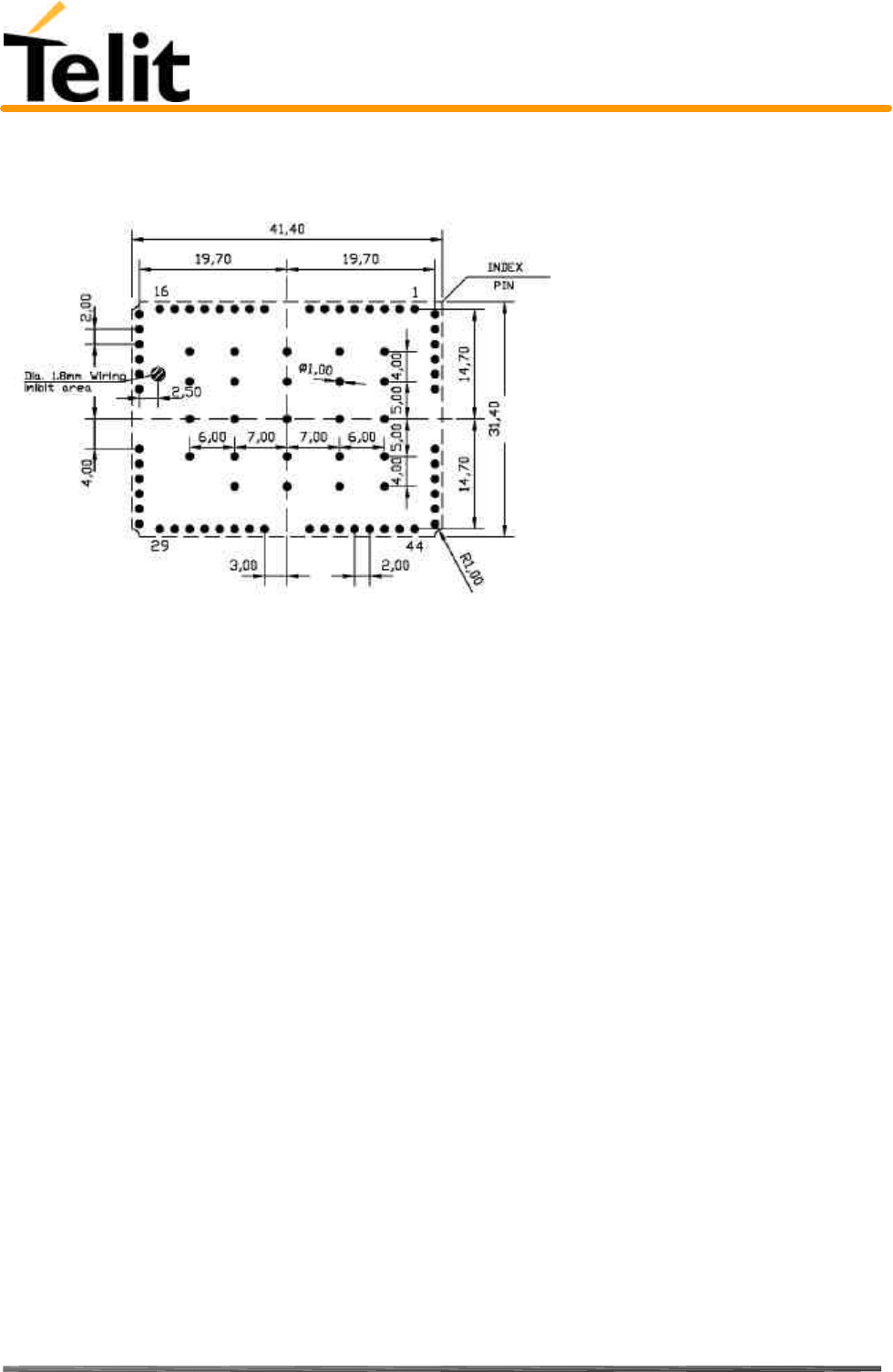
Telit TRIZIUM Product Description
80264ST10007a Rev. 4– 09/09/04
Reproduction forbidden without DAI Telecom written authorization – All Right reserved – Right of modification reserved page 24 of 202
2.17.3 Recommended foot print for application
2.17.4 Stencil
Stencil’s apertures layout can be the same of the recommended footprint (1:1), we suggest a
thickness of stencil foil = 120µm.
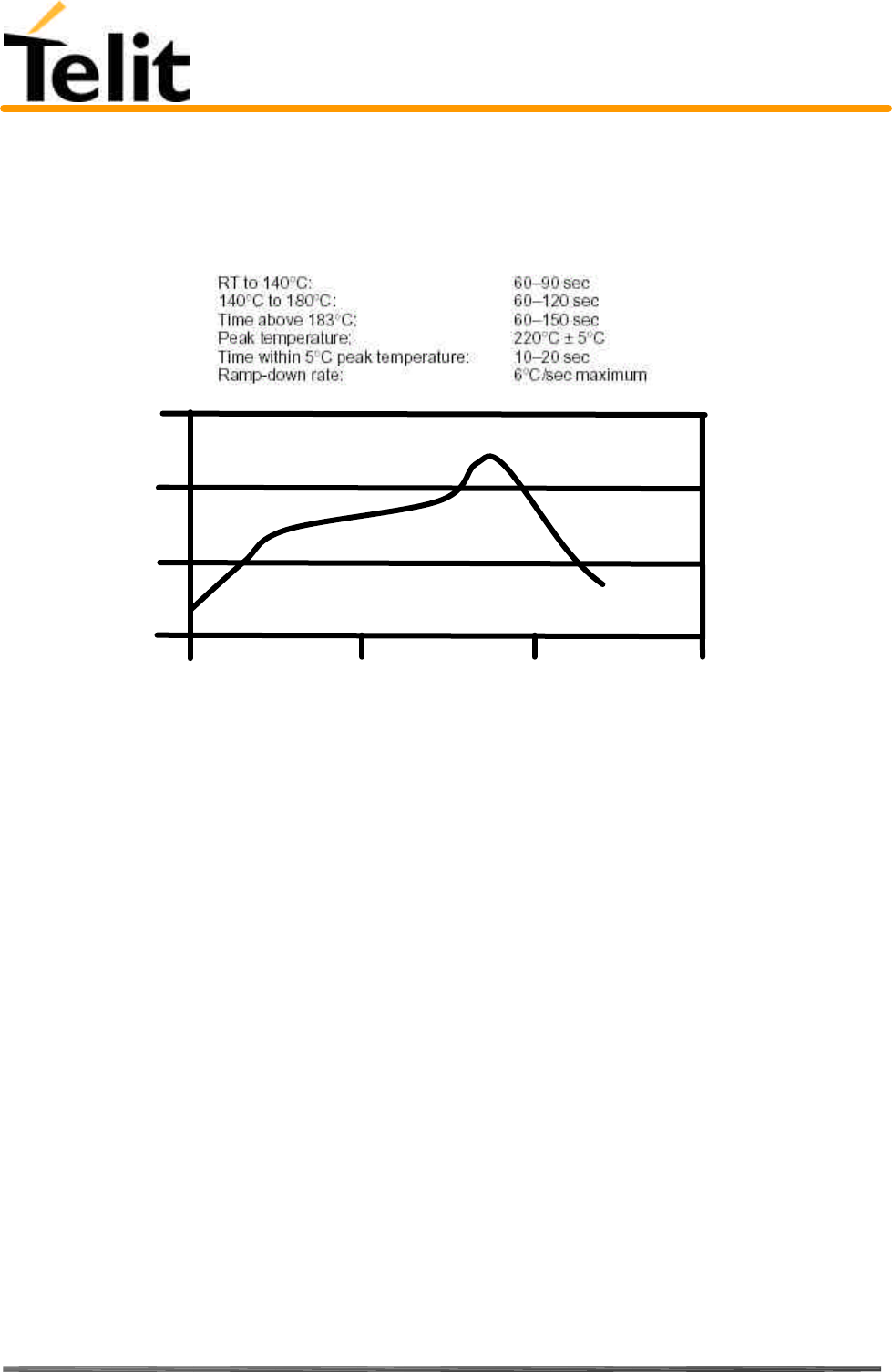
Telit TRIZIUM Product Description
80264ST10007a Rev. 4– 09/09/04
Reproduction forbidden without DAI Telecom written authorization – All Right reserved – Right of modification reserved page 25 of 202
2.17.5 Solder reflow
The following is the recommended solder reflow profile
NOTE : This is an ideal profile, and actual conditions obtained in any specific reflow oven will
vary. This profile is based on convection or RF plus forced convection heating.
NOTICE: Trizium module can accept only one reflow process
300
200
100
0
0100 200 300
Time (sec)
Temperature (ºC)
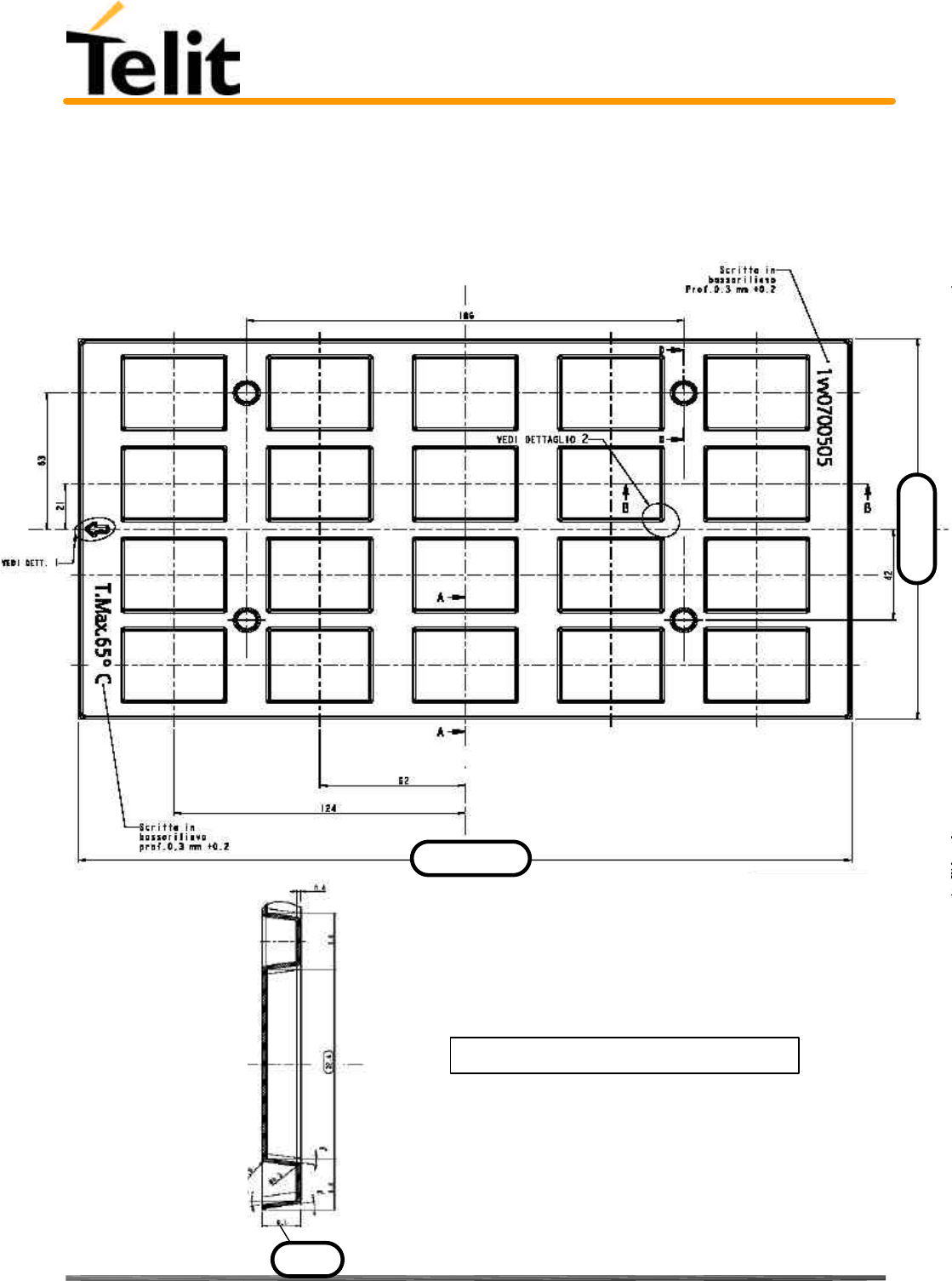
Telit TRIZIUM Product Description
80264ST10007a Rev. 4– 09/09/04
Reproduction forbidden without DAI Telecom written authorization – All Right reserved – Right of modification reserved page 26 of 202
2.17.6 Packing system
According to smt processes for pick & place mouvement requirements, Trizium modules are
packaged on trays, each tray contains 20 pieces. Tray dimensions are::
320 ± 0,3
170 ± 0,3
6.1
Section A-A
All quotes are in mm, general tolerance ± 0.1
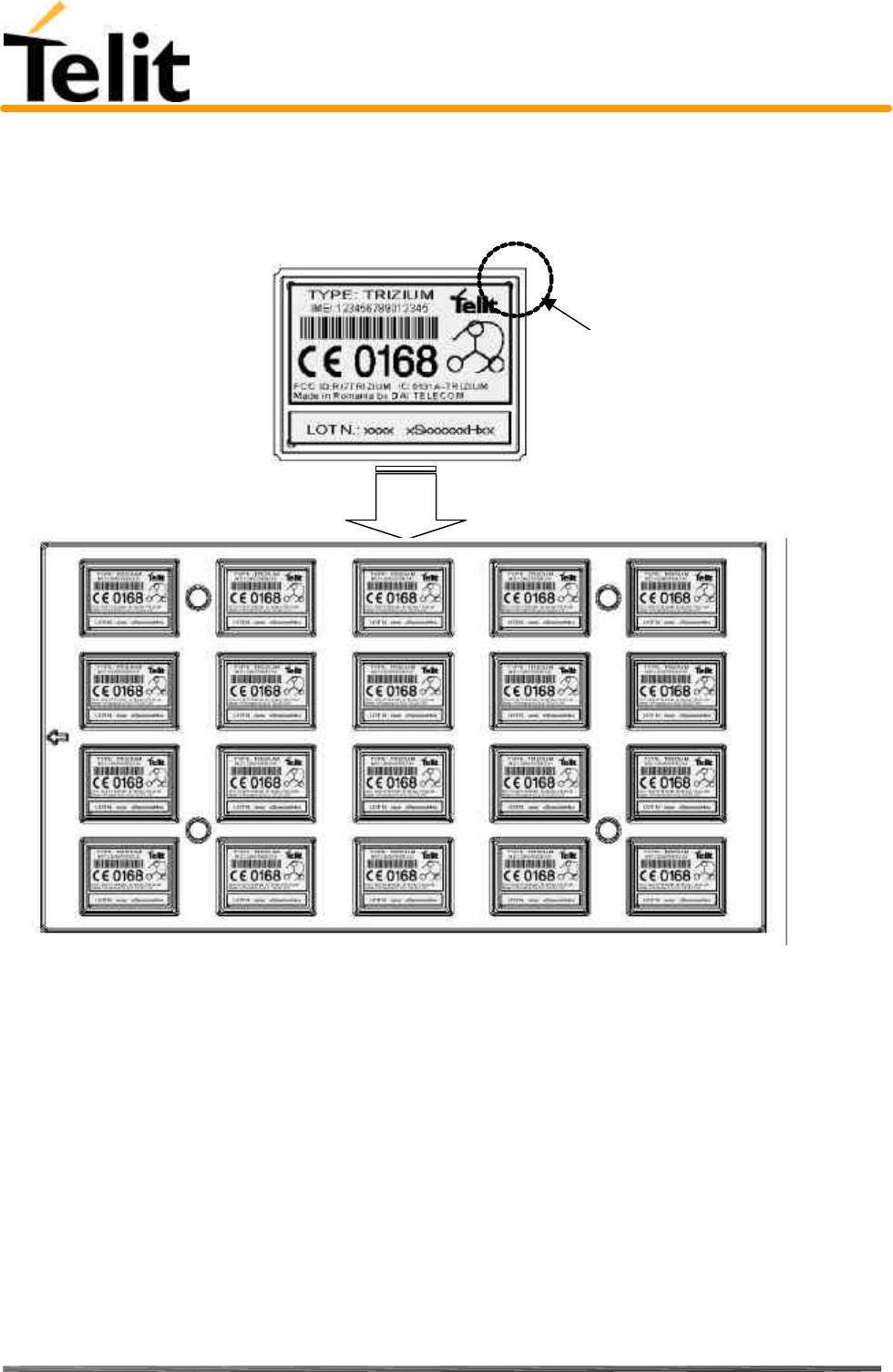
Telit TRIZIUM Product Description
80264ST10007a Rev. 4– 09/09/04
Reproduction forbidden without DAI Telecom written authorization – All Right reserved – Right of modification reserved page 27 of 202
Note that trays can withstand a maximum temperature of 65° C.
Modules orientation on tray:
Ref. No rounded corner on
module’s printed circuit
board indicates pin 1 corner

Telit TRIZIUM Product Description
80264ST10007a Rev. 4– 09/09/04
Reproduction forbidden without DAI Telecom written authorization – All Right reserved – Right of modification reserved page 28 of 202
2.17.7 Moisture sensibility
The level of moisture sensibility of Trizium module is “3”, in according with standard IPC/JEDEC J-STD-020, take
care all the relatives requirements for using this kind of components.
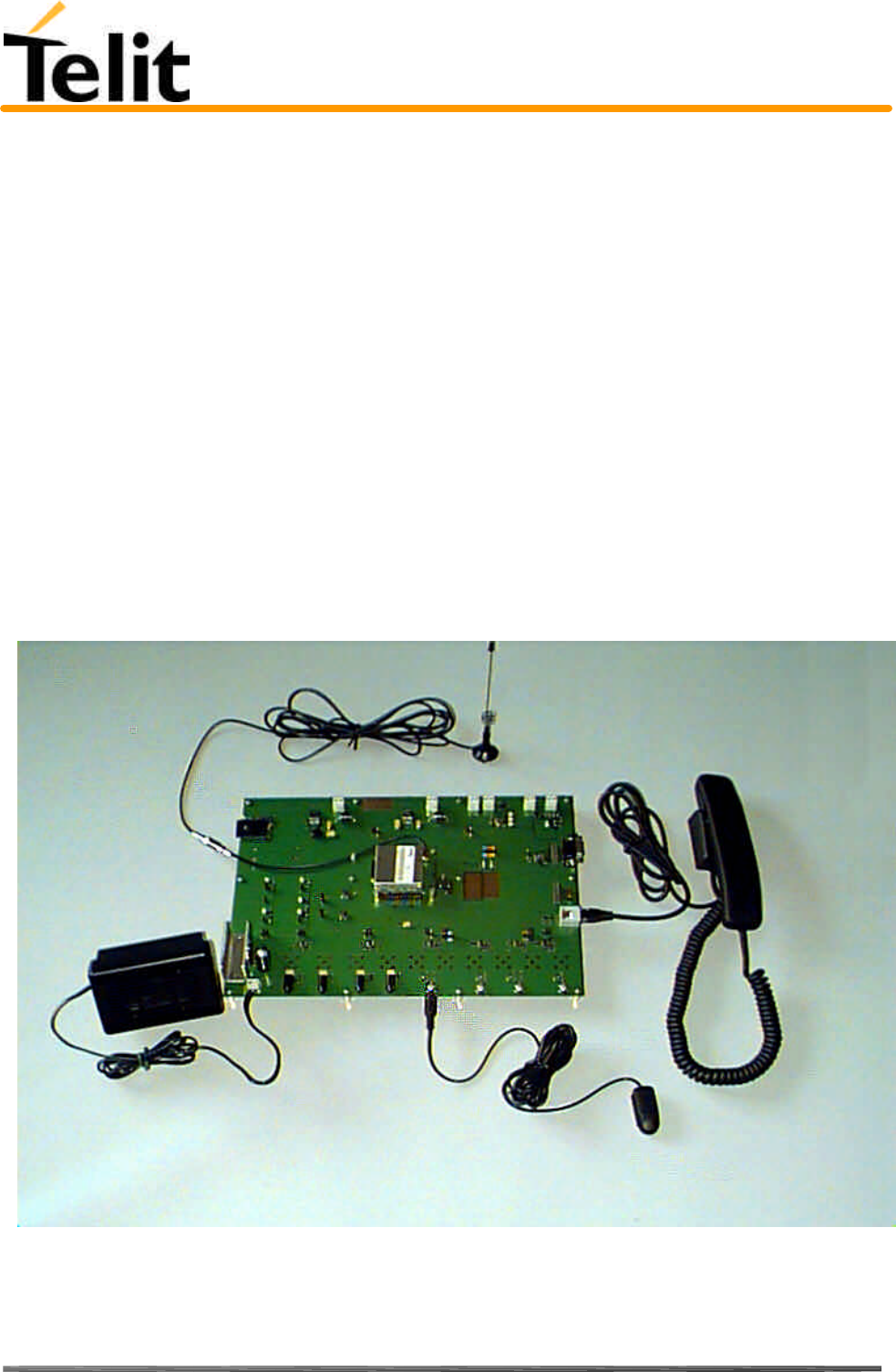
Telit TRIZIUM Product Description
80264ST10007a Rev. 4– 09/09/04
Reproduction forbidden without DAI Telecom written authorization – All Right reserved – Right of modification reserved page 29 of 202
3 Evaluation Kit
In order to assist you in the development of your Telit TRIZIUM module based application, Telit can supply an Evaluation
Kit (same as used for the GM862 family, with a dedicated adaptor) with appropriate power supply, SIM card housing,
RS 232 serial port level translator, direct UART connection, Handset, Headset and Hands-free (car kit) audio, antenna.
The EVK provides a fully functional solution for a complete data/phone application.
The standard serial RS232 9 pin connector placed on the Evaluation Kit allows the connection of the
EVK system with a PC or other DTE.
The development of the applications utilizing the Telit TRIZIUM module must present a proper design
of all the interfaces towards and from the module (e.g. power supply, audio paths, level translators),
otherwise a decrease in the performances will be introduced or, in the worst case, a wrong design
can even lead to an operating failure of the module.
In order to assist the hardware designer in his project phase, the EVK board presents a series of
different solutions, which will cover the most common design requirements on the market, and
which can be easily integrated in the OEM design as building blocks or can be taken as starting
points to develop a specific one.
TRIZIUM Evaluation Kit (adaptor not shown)
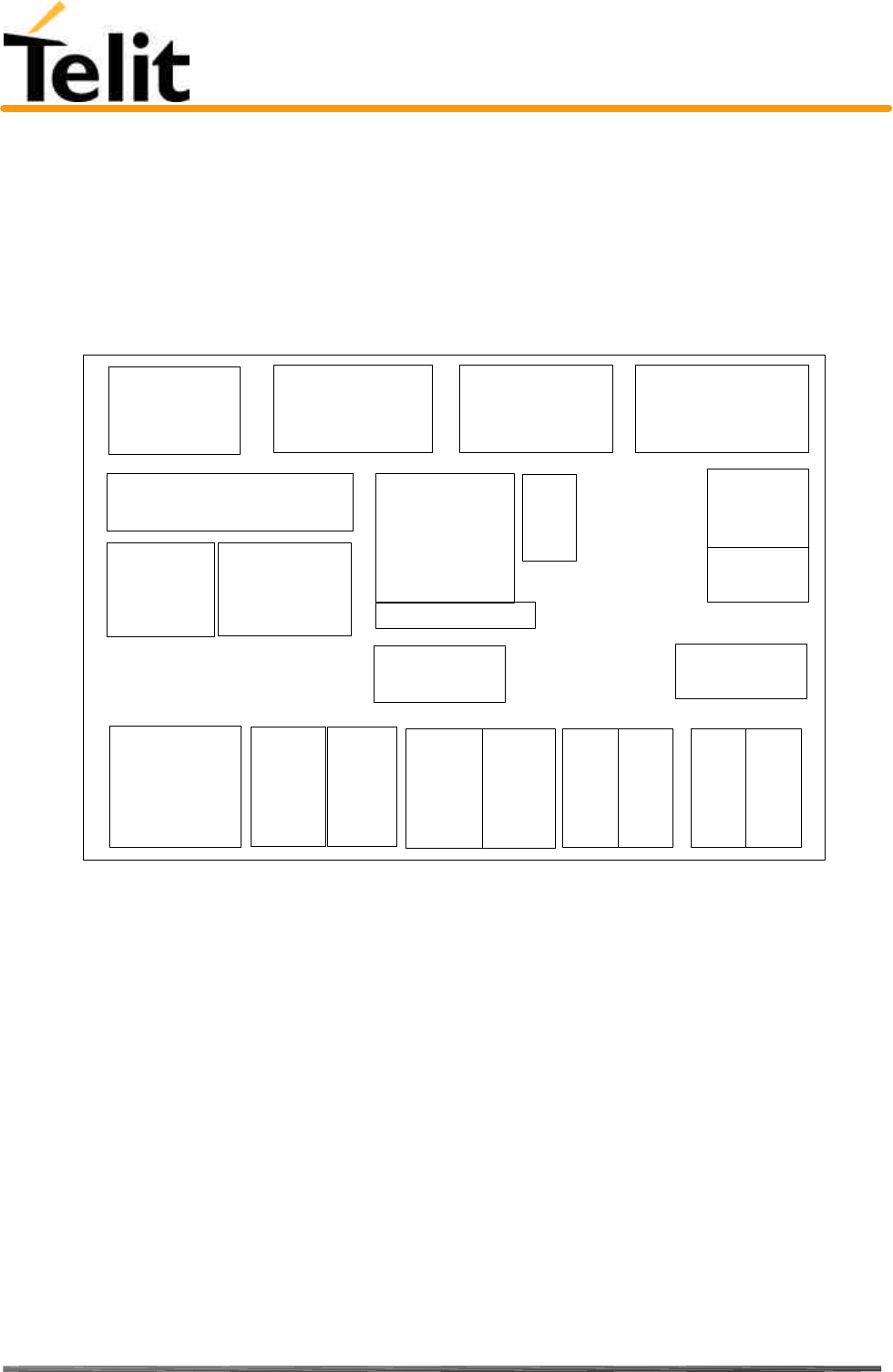
Telit TRIZIUM Product Description
80264ST10007a Rev. 4– 09/09/04
Reproduction forbidden without DAI Telecom written authorization – All Right reserved – Right of modification reserved page 30 of 202
3.1 Evaluation Kit description
For a detailed description of the Telit Evaluation Kit refer to the documentation provided with the Telit TRIZIUM
Hardware User Guide.
The Telit Evaluation Kit can be divided into different blocks depending on the function they implement.
A schematic showing the EVK board and its blocks is shown:
3.1.1 Power Supply
In the Board there are three different power sources, that embrace a wide range of applications, from the automotive
+12V input to the stand alone battery powered device.
The power sources nominal input voltages are:
• +12V input (typically automotive)
• +5V input (typically embedded systems)
• +3.8V input (Li-Ion Battery)
Each one of these power sources can supply both the Telit TRIZIUM module and the whole circuitry embodied in the
Evaluation Kit.
Only one of these power sources can be used at a time and it is selectable with two jumpers.
For the battery power supply a Li-Ion battery charger circuit is provided.
3.1.2 Serial interface
The communications between your application and the Telit TRIZIUM module must be done through a serial interface
which can be a standard CMOS UART or a RS232 port.
All levels of the RS232 port are conform to RS232 and V.24 standard and a PC serial port can be directly connected to
this connector.
+5V
POWER SUPPLY
REGULATORS
BATTERY SUPPLY
& CHARGE CONTROL
+12V
POWER SUPPLY
REGULATORS
ADAPTOR
TRIZIUM
RS232
LEVEL
TRANSLATOR
+3V UART
GPIO & LEDS
ANTENNA COAX
FREE SPACE
EXT
EAR
SINGLE
ENDED
AUDIO/BF
FILTERS
SIM HOUSING
EXT
MIC
BALAN
CED
EXT
EAR
BRIDGED
EXT
MIC
UNBAL
ANCE
D
HAND
SET
MIC
UNBAL
ANCE
D
HAND
SET
MIC
BALAN
CED
HANDSET
EAR
SINGLE
ENDED
HANDSET
EAR
BRIDGED
& RESET
BUTTONS
EVK HANDSET
CONNECTOR
HIGH POWER
EXT. EAR
ON/OFF
GPIO

Telit TRIZIUM Product Description
80264ST10007a Rev. 4– 09/09/04
Reproduction forbidden without DAI Telecom written authorization – All Right reserved – Right of modification reserved page 31 of 202
Both these interfaces are supported.
3.1.3 Audio
The Evaluation Kit board provides two software/hardware selectable audio paths, the internal and the external one. All
the handset, headset and hands free-car kit functions are supported.
Furthermore for each audio path two solution are presented: single ended and balanced.
3.1.4 GPIO and Leds
All the General Purpose Input Output ports of the Telit TRIZIUM module are supported in a dedicated connector and
several leds are added as a debug aid.

Telit TRIZIUM Product Description
80264ST10007a Rev. 4– 09/09/04
Reproduction forbidden without DAI Telecom written authorization – All Right reserved – Right of modification reserved page 32 of 202
4 Service and firmware update
The serial cable used for the communication with a PC can be also used to update the Telit TRIZIUM module firmware.
The RS232 connector DB type 9 pin 90° is used to connect the Telit Evaluation Kit. to any DTE .
All levels are conformed to RS232 and V.24 standard and a PC serial port can be directly connected to this connector.
The firmware update can be done with a specific software tool provided by Telit that runs on windows based PCs.
4.1 Step-by-Step upgrade procedure
I. Download the specific software for upgrading (Flash programmer TFI_TRIZIUM.zip).from the site
www.TRIZIUM.com, or request it at this e-mail address ts-trizium@telit.net
II. Unzip the file TFI_TRIZIUM.zip. A new folder TRIZIUM/ will be created
III. Mount the Telit TRIZIUM module in the Evaluation Kit (using the dedicated adaptor)and supply power
IV. Run the file TFI_TRIZIUM.exe.
V. Press the Start Procedure button and within 5 seconds press the ON/OFF button on the
board. Keep pressed the ON/OFF button for 5 seconds and then leave it.
First the program will erasure the content of flash memory
Then the program will write on the flash memory
Wait for the end of programming green message COK
Your Telit TRIZIUM module is now programmed with the new firmware.

Telit TRIZIUM Product Description
80264ST10007a Rev. 4– 09/09/04
Reproduction forbidden without DAI Telecom written authorization – All Right reserved – Right of modification reserved page 33 of 202
5 AT Command
The Telit TRIZIUM module can be driven via the serial interface using the standard AT commands1. The Telit TRIZIUM
module is compliant with:
1. Hayes standard AT command set, in order to maintain the compatibility with existing SW programs.
2. ETSI GSM 07.07 specific AT command and GPRS specific commands.
3. ETSI GSM 07.05 specific AT commands for SMS (Short Message Service) and CBS (Cell Broadcast Service)
4. FAX Class 1 compatible commands
Moreover the Telit TRIZIUM module supports also Telit proprietary AT commands for special purposes.
In the following the dedicated description of how to use the AT commands with the Telit TRIZIUM module.
5.1 Definitions
The following syntactical definitions apply:
<CR> Carriage return character, is the command line and result code terminator character, which value, in decimal
ASCII between 0 and 255,is specified within parameter S3.
The default value is 13.
<LF> Linefeed character, is the character recognised as line feed character. Its value, in decimal ASCII between 0
and 255, is specified within parameter S4. The default value is 10.
The line feed character is output after carriage return character if verbose result codes are used (V1 option used )
otherwise, if numeric format result codes are used (V0 option used) it will not appear in the result codes.
<...> Name enclosed in angle brackets is a syntactical element. They do not appear in the command line.
[...] Optional subparameter of a command or an optional part of TA information response is enclosed in square
brackets. Brackets themselves do not appear in the command line. When subparameter is not given in AT commands
which have a read command, new value equals to its previous value. In AT commands which do not store the values of
any of their subparameters, and so have not a read command, which are called action type commands, action should be
done on the basis of the recommended default setting of the subparameter.
5.2 AT Command Syntax
GSM commands use syntax rules of extended commands.
Every extended command has a test command (trailing =?) to test the existence of the command and to give
information about the type of its subparameters. There are two types of extended command:
- Parameter type commands which also have a read command (trailing ?) to check the current values of
subparameters.
- Action type commands do not store the values of any of their possible subparameters, and therefore do not have a
read command.
5.2.1 Command lines
The basic structure of the command lines are:
• ATCMD1<CR> where AT is the command line prefix, CMD1 is a basic command (i.e. it have not + prefix) and
CR is the command line terminator character
• ATCMD2=10<CR> where 10 is a subparameter
• AT+CMD1;+CMD2=, ,10<CR> These are two examples of extended commands (which have a + prefix). They are
delimited with semicolon. In the second command the subparameter is omitted
• +CMD1?<CR> This is a read command for checking current subparameter values
1 The AT is an ATTENTION command and is used as a prefix to other parameters in a string. The AT command
combined with other parameters can be set up in the communications package or typed in manually as a command line
instruction.

Telit TRIZIUM Product Description
80264ST10007a Rev. 4– 09/09/04
Reproduction forbidden without DAI Telecom written authorization – All Right reserved – Right of modification reserved page 34 of 202
• +CMD1=?<CR> This is a test command for checking possible subparameter values
These commands might be performed in a single command line as shown below:
ATCMD1 CMD2=10+CMD1;+CMD2=, ,10;+CMD1?;+CMD1=?<CR>
anyway it is always preferable to separate into different command lines the basic commands (i.e. without + prefix) and
the extended commands (the ones with + prefix); furthermore it is suggested to avoid placing several action commands
in the same command line, because if one of them fails, then an error message is received but it is not possible to argue
which one of them has failed the execution.
If command V1 is enabled (verbose responses codes) and all commands in a command line has been performed
successfully, result code <CR><LF>OK<CR><LF> is sent from the TA to the TE, if subparameter values of a
command are not accepted by the TA or command itself is invalid, or command cannot be performed for some reason,
result code <CR><LF>ERROR<CR><LF> is sent and no subsequent commands in the command line are processed.
If command V0 is enabled (numeric responses codes), and all commands in a command line has been performed
successfully, result code 0<CR> is sent from the TA to the TE, if sub-parameter values of a command are not accepted
by the TA or command itself is invalid, or command cannot be performed for some reason, result code 4<CR> and no
subsequent commands in the command line are processed.
In case of errors depending on ME operation, ERROR (or 4) response may be replaced by +CME ERROR: <err> or
+CMS ERROR: <err>.
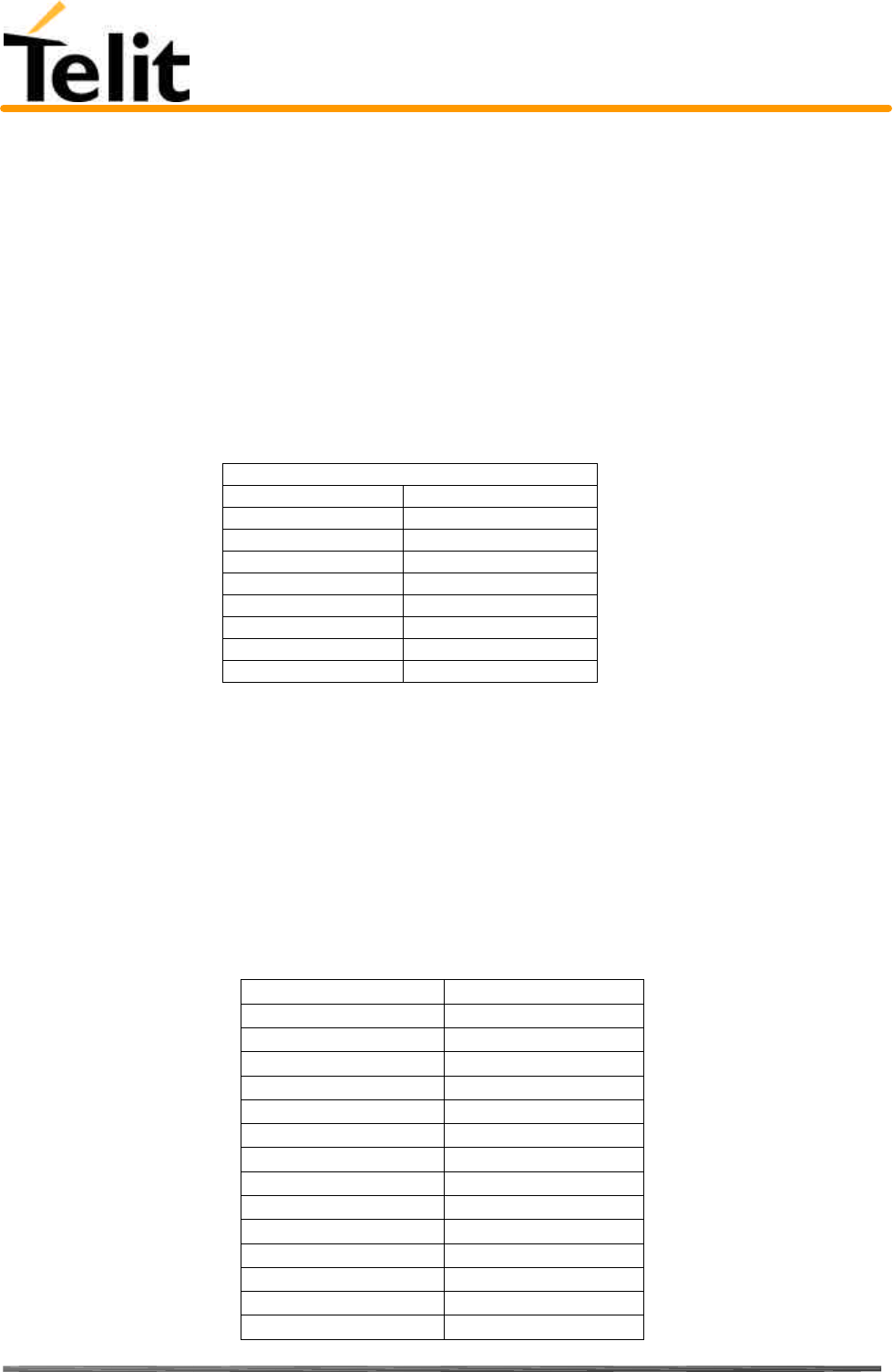
Telit TRIZIUM Product Description
80264ST10007a Rev. 4– 09/09/04
Reproduction forbidden without DAI Telecom written authorization – All Right reserved – Right of modification reserved page 35 of 202
5.2.2 Information responses and result codes
The TA response, in case of verbose response format enabled, for the previous examples command line could be as
shown below:
information response to +CMD1? <CR><LF>+CMD1:2,1,10<CR><LF>
information response to +CMD1=? <CR><LF>+CMD1(0-2),(0,1),(0-15)<CR><LF>
final result code <CR><LF>OK<CR><LF>
Moreover there are other two types of result codes:
• result codes that inform about progress of TA operation (e.g. connection establishment CONNECT)
• result codes that indicate occurrence of an event not directly associated with issuance of a command from TE (e.g.
ring indication RING).
Here the basic result codes according to ITU-T V25Ter recommendation
Result Codes
Numeric form Verbose form
0OK
1CONNECT
2RING
3NO CARRIER
4ERROR
6NO DIALTONE
7BUSY
8NO ANSWER
5.2.3 Command Response Timeout
Every command issued to the Telit TRIZIUM module returns a result response if response codes are enabled (default). The
time needed to process the given command and return the response varies from command to command and may depend
also from the network on which the command may interact. As a result every command is provided with a proper
timeout time, if this time elapses without any result from the operation, then an ERROR response can be reported as if
the operation was not successful and the operation is anyway terminated.
The timeout time is quite short for commands that imply only internal set up commands, but may be very long for
command that interact with the network (or even a set of Networks).
The default timeout is 100 ms for all the commands that have no interaction with the network or upper software layers.
In the table below are listed all the commands whose timeout differs from the default 100 ms and their effective timeout
is reported:
Command Timeout (Seconds)
+CBST 0.2
+CR 0.2
+CRC 0.2
+CRLP 0.2
+CSCS 0.2
+CEER 5
+CGMI 5
+CGMM 5
+CGMR 5
+CGSN 20
+CIMI 20
+CNUM 20
+CREG 5
+COPS 180
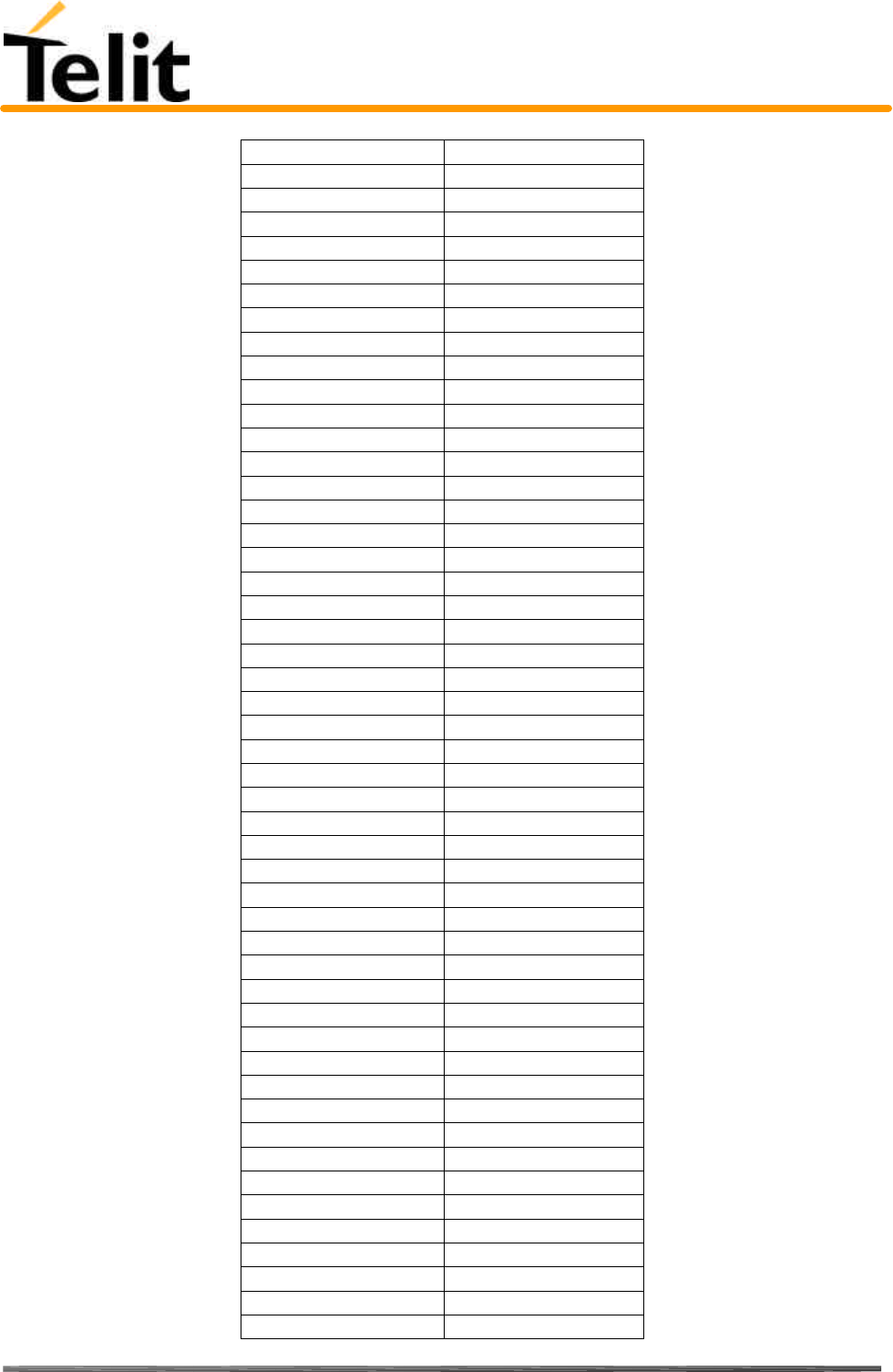
Telit TRIZIUM Product Description
80264ST10007a Rev. 4– 09/09/04
Reproduction forbidden without DAI Telecom written authorization – All Right reserved – Right of modification reserved page 36 of 202
+CLCK 180
+CPWD 180
+CLIP 180
+CLIR 180
+CCFC 180
+CCWA 20
+CHLD 20
+CUSD 180
+CAOC 20
+CSSN 20
+CLCC 20
+CPAS 5
+CPIN 20
+CSQ 5
+CPBS 5
+CPBR 20
+CPBF 20
+CPBW 20
+CALM 5
+CRSL 5
+CLVL 5
+CMUT 5
+CACM 20
+CAMM 20
+CPUC 20
+CMEE 5
+VTS 20
+GMI 5
+GMM 5
+GMR 5
+GSN 20
I3 5
I4 5
I5 5
+CSMS 5
+CPMS 5
+CMGF 5
+CSCA 20
+CSMP 5
+CSDH 5
+CSAS 5
+CRES 5
+CNMI 5
+CMGS 180 / 5 for prompt">"
+CMSS 180
+CMGW 5 / 5 for prompt">"
+CMGD 5
+CMGR 5
+CMGL 5
#CAP 10
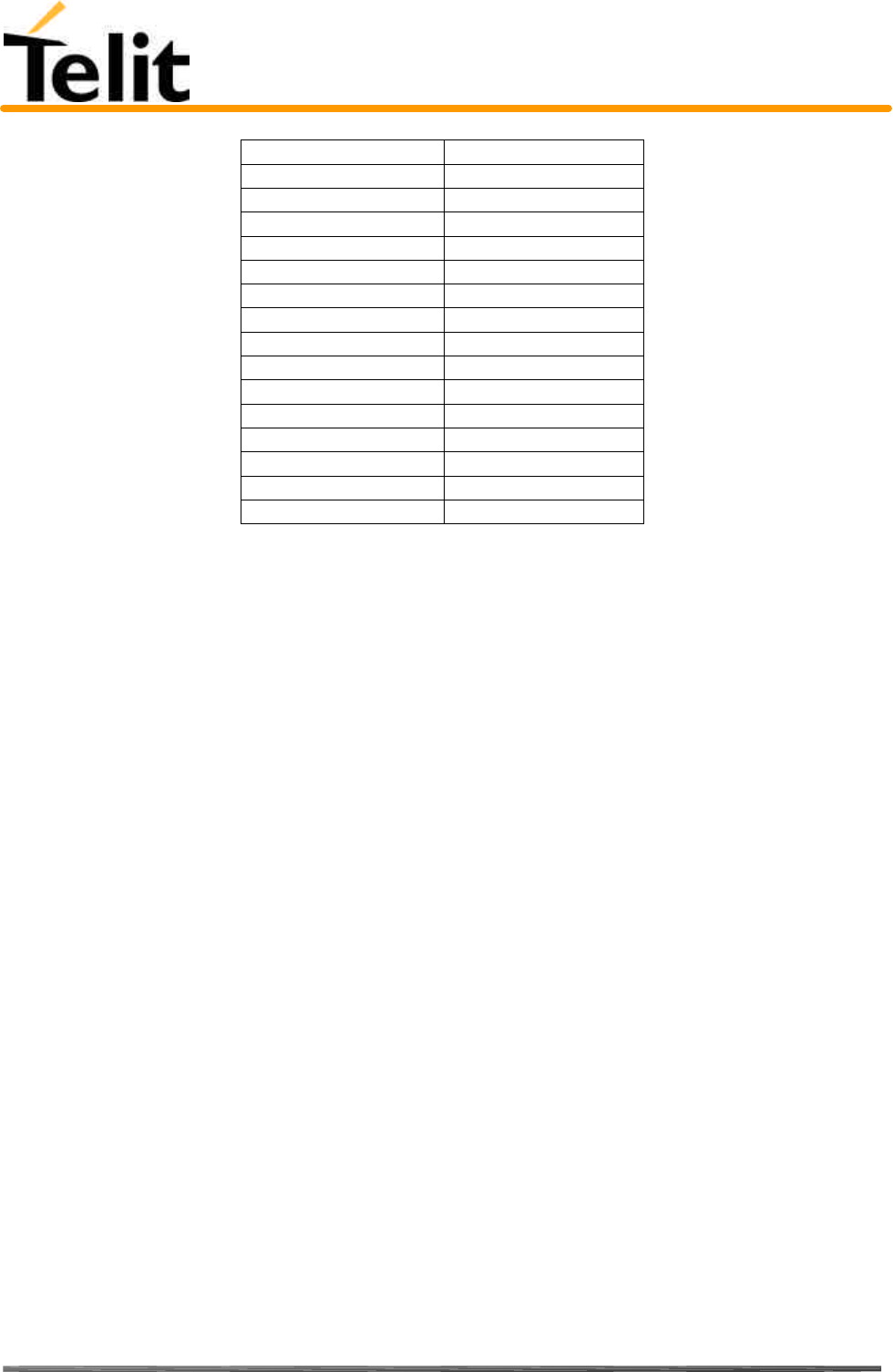
Telit TRIZIUM Product Description
80264ST10007a Rev. 4– 09/09/04
Reproduction forbidden without DAI Telecom written authorization – All Right reserved – Right of modification reserved page 37 of 202
#SRS 10
#SRP 10
#STM 10
#PCT 10
#SHDN 10
#QTEMP 10
#SGPO 10
#GGPI 10
#MONI 10
+CGACT 180
+CGATT 180
+CGDATA 20
+CGDCONT 20
+CGPADDR 20
+CGQMIN 20
+CGQREQ 20
5.2.4 Command issuing timing
The chain Command -> Response shall always be respected and a new command must not be issued before the
TRIZIUM has terminated all the sending of its response result code (whatever it may be).
This applies especially to applications that "sense" the OK text and therefore may send the next command before the
complete code <CR><LF>OK<CR><LF> is sent by the TRIZIUM.
It is advisable anyway to wait for at least 20ms between the end of the reception of the response and the issue of the
next AT command.
If the response codes are disabled and therefore the module does not report any response to the command, then at least
the 20ms pause time shall be respected.
During command mode, due to hardware limitations, under severe CPU load the serial port can loose some characters if
placed in autobauding at high speeds. Therefore if you encounter this problem fix the baud rate with AT+IPR
command.
5.2.5 Factory Profile and parameters stored in the profile
The TRIZIUM stores several command configurations in the internal non volatile memory (see command &W),
allowing to remember this status even after power off.
The parameters that are stored in the profile and their are:
GSM DATA MODE : +CBST: 0,0,1
AUTOBAUD : +IPR: 0
COMMAND ECHO : E1
RESULT MESSAGES : Q1
VERBOSE MESSAGES : V1
EXTENDED MESSAGES : X1
FLOW CONTROL OPTIONS : &K3
CTS (C106) OPTIONS : &B2
DSR (C107) OPTIONS : &S3
DTR (C108) OPTIONS : &D0
DCD (C109) OPTIONS : &C1
RI (C125) OPTIONS : \R1
C108/1 OPERATION : &D4
POWER SAVING : +CFUN: 1
DEFAULT PROFILE : &Y0
S REGISTERS: S0=0;S1=0;S2=43;S3=13;S4=10;S5=8;S7=60;S12=50;S25=5;S38=20
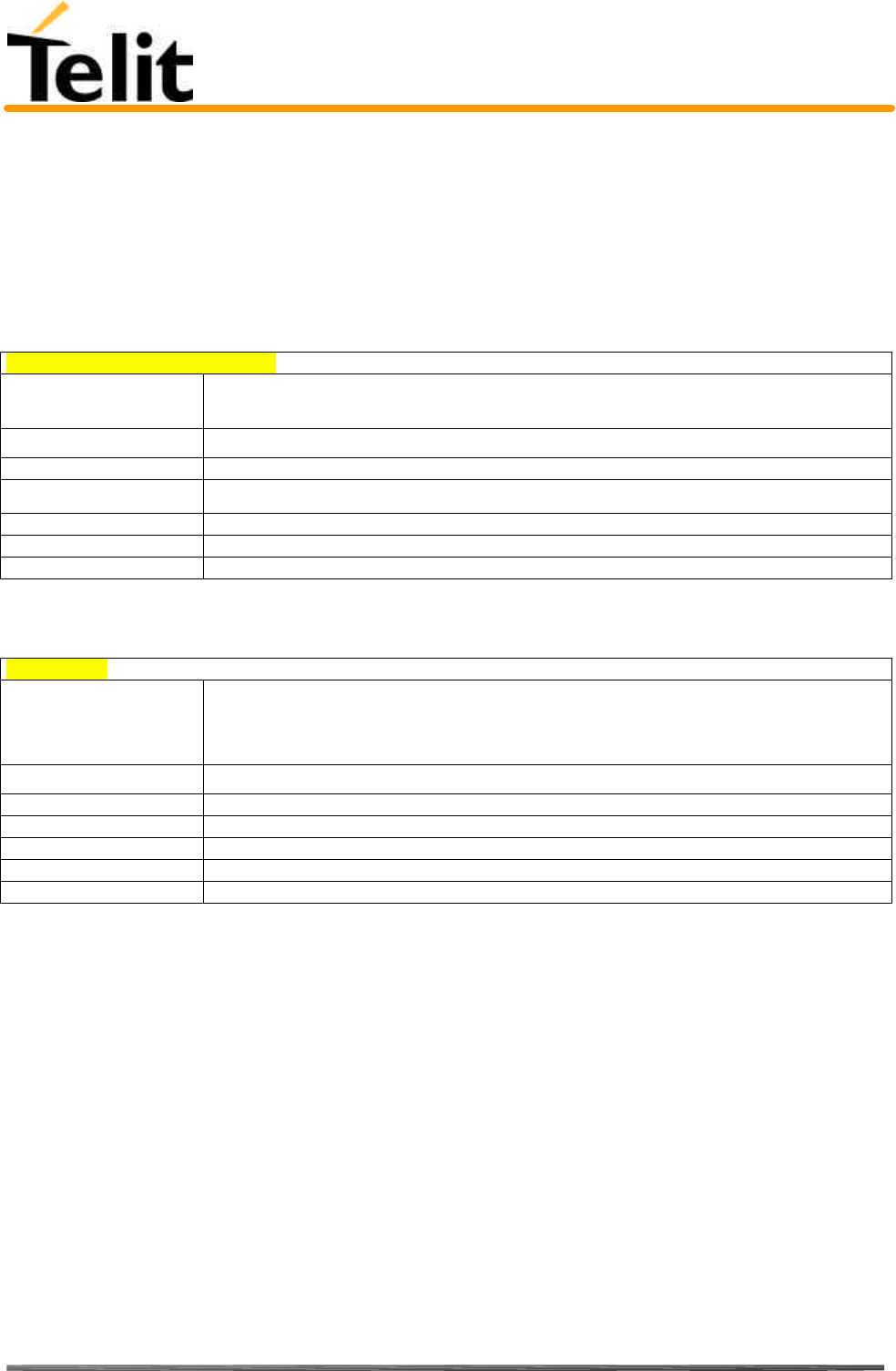
Telit TRIZIUM Product Description
80264ST10007a Rev. 4– 09/09/04
Reproduction forbidden without DAI Telecom written authorization – All Right reserved – Right of modification reserved page 38 of 202
5.3 Hayes Compliant AT Commands
5.3.1 Generic Modem Control
5.3.1.1 &F - restore factory configuration
&F – restore factory configuration
Execute command
AT&F Calls the factory configuration, resetting the default profile.
Read command
Write command
Test command
Example
Reference V25ter.
SW release Version A
5.3.1.2 Z - soft reset
Z – soft reset
Execute command
ATZ <n> Send a software reset to device, loading on the configuration the specified default profile.
Parameter: <n > = 0…1 - profile
Note: Must be the last command on the line.
Read command
Write command
Test command
Example
Reference V25ter.
SW release Version A
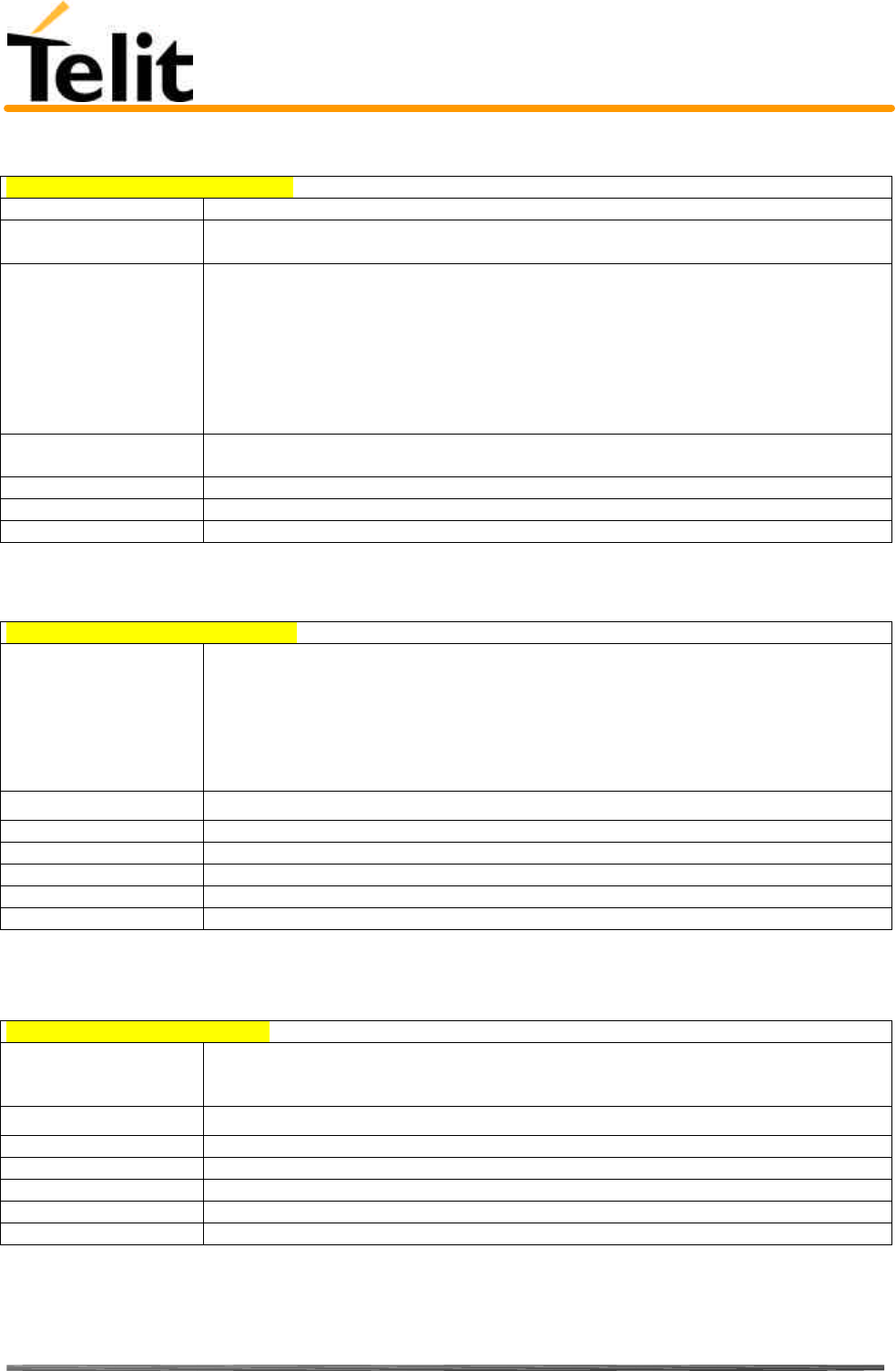
Telit TRIZIUM Product Description
80264ST10007a Rev. 4– 09/09/04
Reproduction forbidden without DAI Telecom written authorization – All Right reserved – Right of modification reserved page 39 of 202
5.3.1.3 +FCLASS - select active service class
+FCLASS - select active service class
Execute command
Read command
AT+FCLASS? Returns the current configuration value of the parameter <n>.
Write command
AT+FCLASS= <n> Set the TRIZIUM in specified connection mode (data, fax, voice), hence all the calls done
after, will be data or voice.
Parameter:
<n>: 0 = data
<n>: 1 = fax class 1
<n>: 8 = voice
Test command
AT+FCLASS=? Returns all supported values of the parameters <n>.
Example
Reference GSM 07.07
SW release Version A
5.3.1.4 &Y - designate a default reset profile
&Y – designate a default reset profile
Execute command
AT&Y <n> The TRIZIUM is able to store 2 complete configurations (see command &W). The
command &Y defines which one of the 2 profiles will be the default profile to be loaded on
startup.
Parameter: <n> = 0…1 - profile
Note: Differently from ATZ<n> command which simply loads the desired profile , with the
command AT&Y the chosen profile becomes the one which will be loaded on every startup.
Read command
Write command
Test command
Example
Reference
SW release Version A
5.3.1.5 &W - store current configuration
&W – store current configuration
Execute command
AT&W <n> Stores on profile n the complete configuration of the device.
Parameter: <n> = 0…1 - profile
Read command
Write command
Test command
Example
Reference
SW release Version A
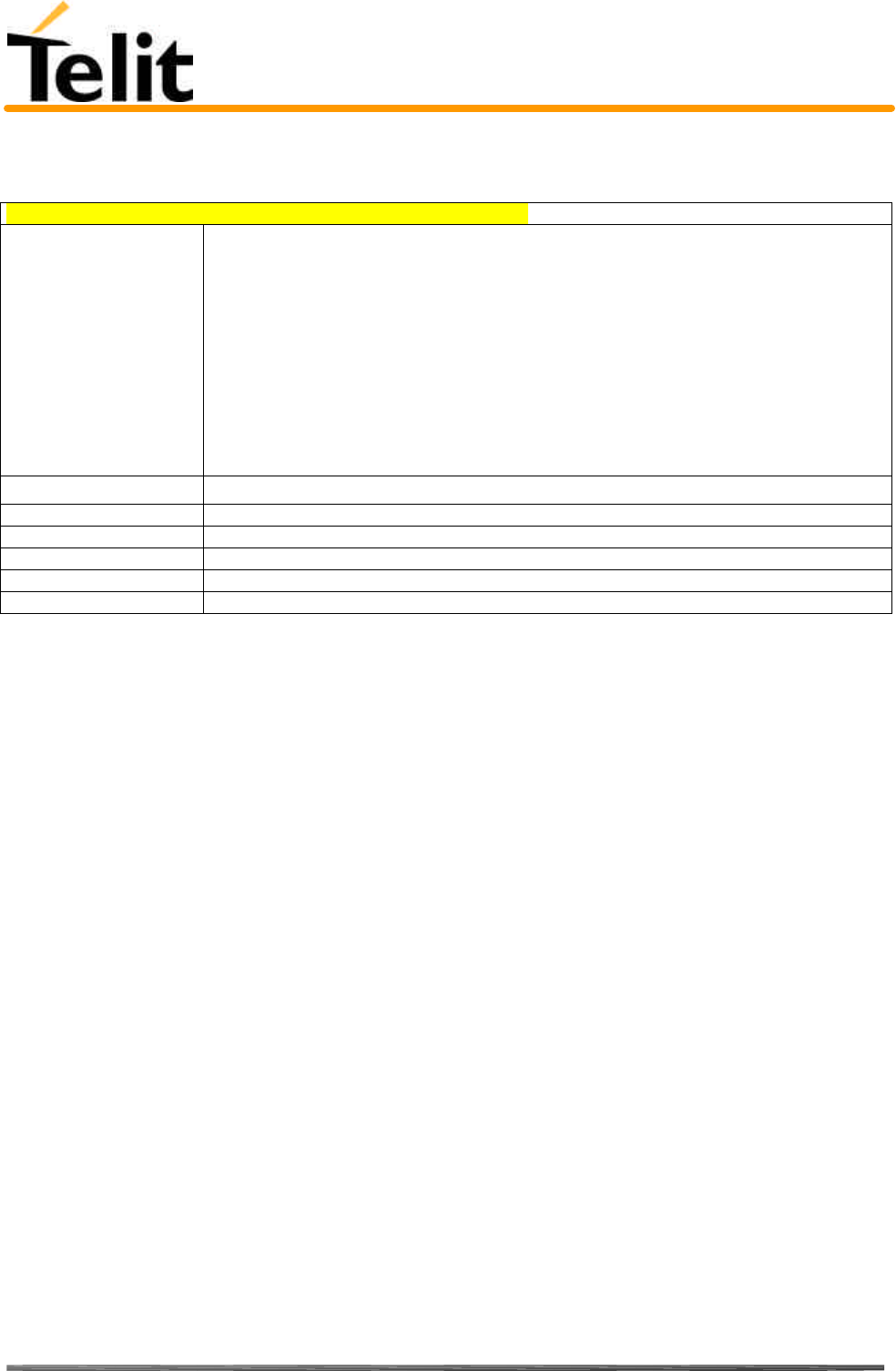
Telit TRIZIUM Product Description
80264ST10007a Rev. 4– 09/09/04
Reproduction forbidden without DAI Telecom written authorization – All Right reserved – Right of modification reserved page 40 of 202
5.3.1.6 &Z - store telephone number in the Telit TRIZIUM module internal
phonebook
&Z – store telephone number in the TRIZIUM internal phonebook
Execute command
AT&Z <n> = <nr> The TRIZIUM has a built in non volatile memory in which telephone numbers of a
maximum 24 digits can be stored. The command AT&Z <n> = <nr> stores in the record n
the telephone number nr. The records cannot be overwritten, they must be cleared before
rewriting.
Parameter:
<n>: phonebook record <nr>: telephone number
Note1: To delete the record <n> the command AT&Z<n>= must be issued.
Note2: The records in the TRIZIUM memory can be viewed with the
command AT&N, while the telephone number stored in the record n can be
dialled by giving the command ATDS=<n>.
Read command
Write command
Test command
Example
Reference
SW release Version A
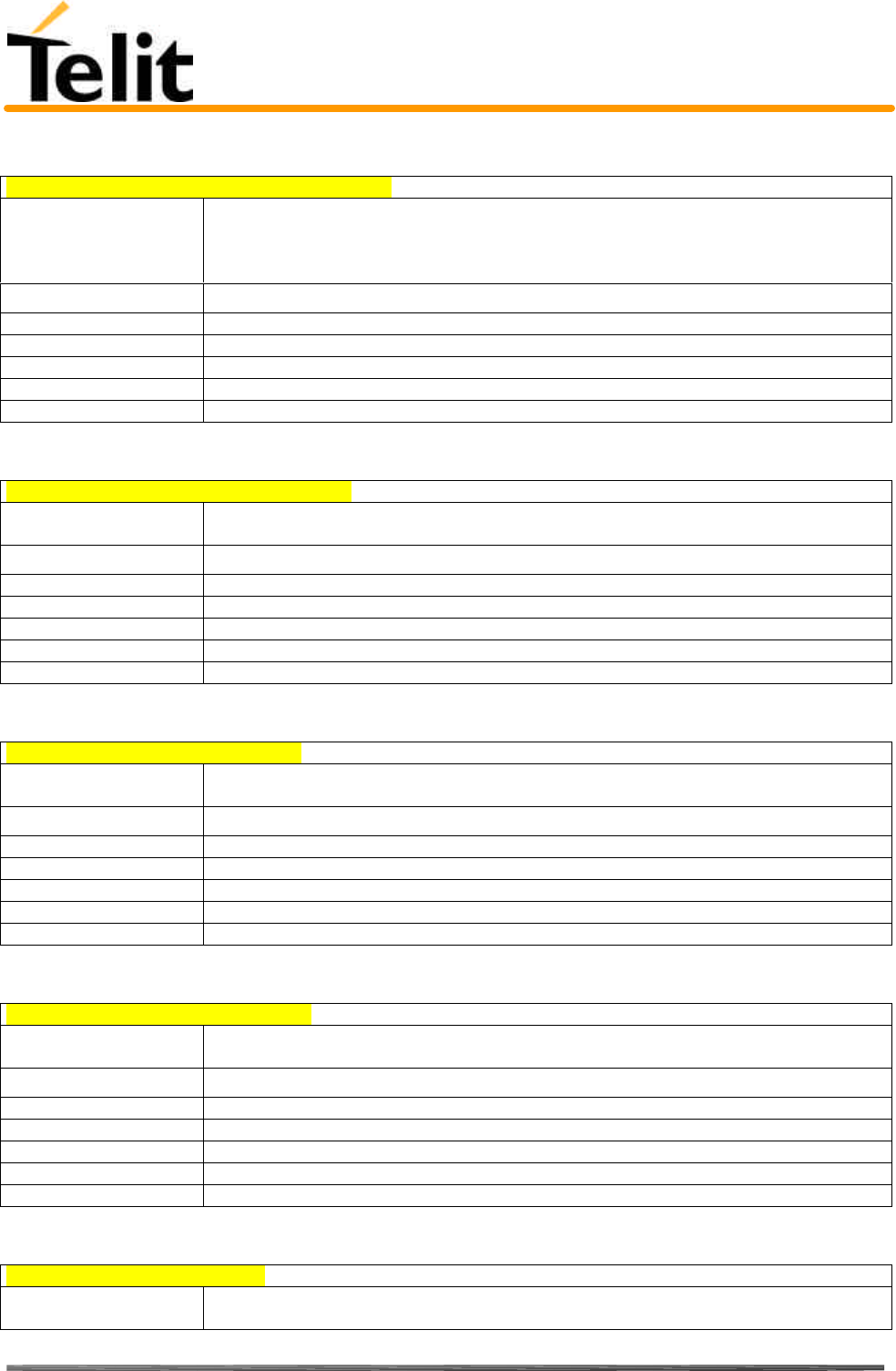
Telit TRIZIUM Product Description
80264ST10007a Rev. 4– 09/09/04
Reproduction forbidden without DAI Telecom written authorization – All Right reserved – Right of modification reserved page 41 of 202
5.3.1.7 &N - display internal phonebook stored numbers
&N – display internal phonebook stored numbers
Execute command
AT&N <n> Returns the telephone number stored in the internal memory at the record number <n>.
Parameter: <n> - phonebook record
Note: if parameter <n> is omitted then all the internal records are shown.
Read command
Write command
Test command
Example
Reference
SW release Version A
5.3.1.8 +GMI - request manufacturer identification
+GMI – request manufacturer identification
Execute command
AT+GMI Returns the manufacturer identification.
Read command
Write command
Test command
Example
Reference V.25ter
SW release Version A
5.3.1.9 +GMM - request model identification
+GMM – request model identification
Execute command
AT+GMM Returns the model identification.
Read command
Write command
Test command
Example
Reference V.25ter
SW release Version A
5.3.1.10 +GMR - request revision identification
+GMR – request revision identification
Execute command
AT+GMR Returns the software revision identification.
Read command
Write command
Test command
Example
Reference V.25ter
SW release Version A
5.3.1.11 +GCAP - request capabilities list
+GCAP – request capabilities list
Execute command
AT+GCAP Returns the equipment supported command set list.
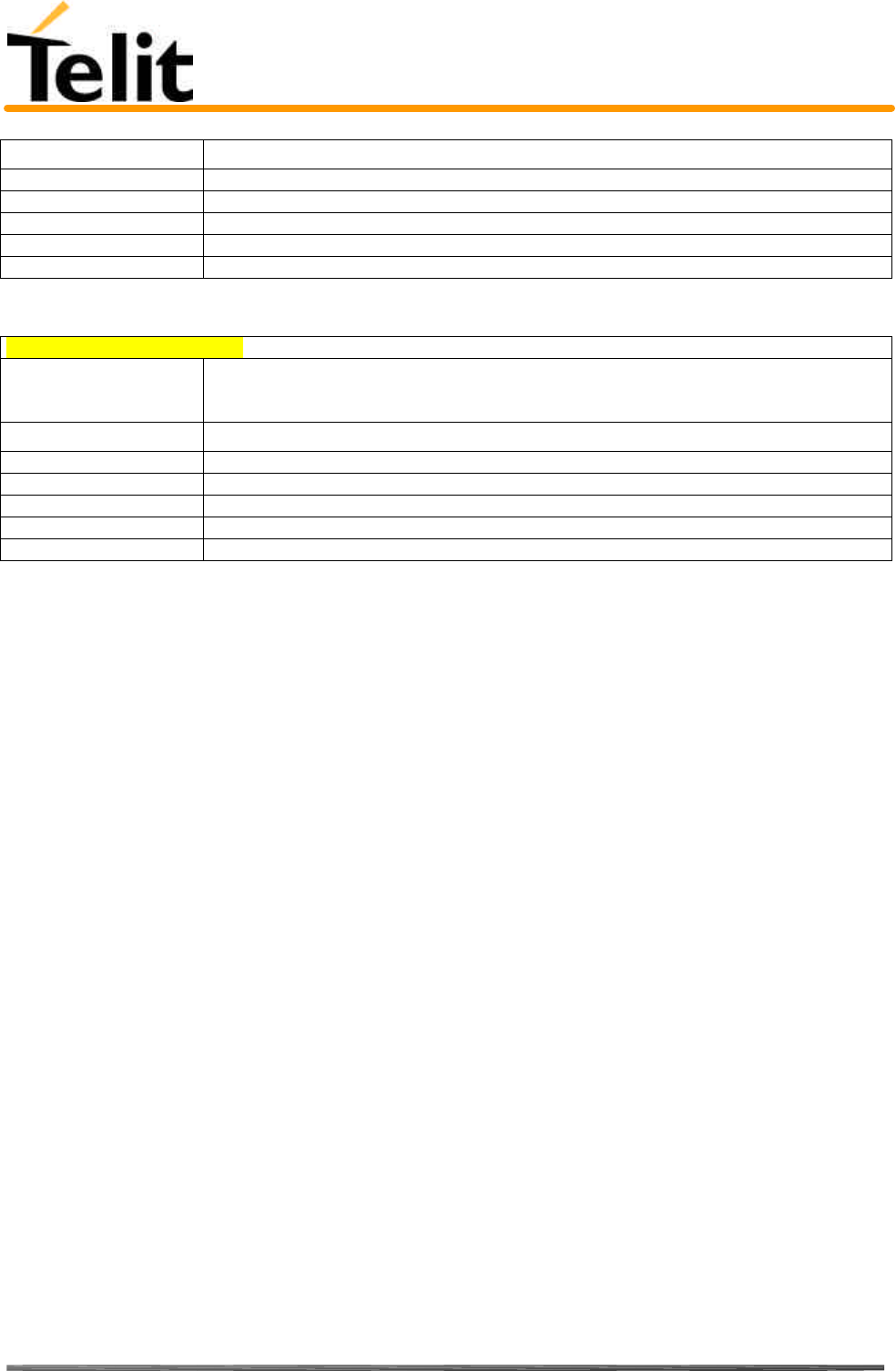
Telit TRIZIUM Product Description
80264ST10007a Rev. 4– 09/09/04
Reproduction forbidden without DAI Telecom written authorization – All Right reserved – Right of modification reserved page 42 of 202
Read command
Write command
Test command
Example
Reference V.25ter
SW release Version A
5.3.1.12 +GSN - request serial number
+GSN – request serial number
Execute command
AT+GSN Returns the device board serial number.
Note: The number returned is not the IMSI, it is only the board number
Read command
Write command
Test command
Example
Reference V.25ter
SW release Version A
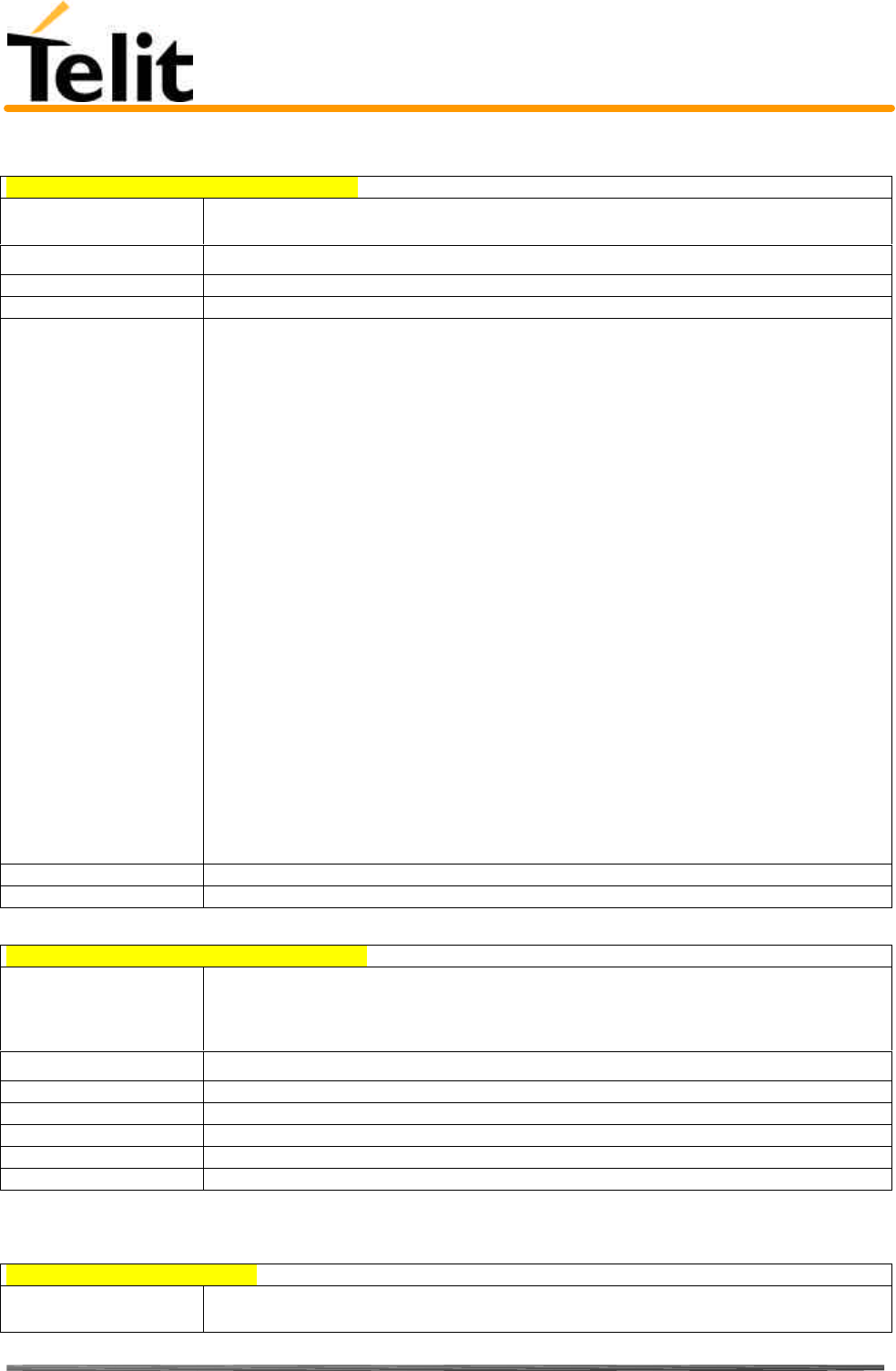
Telit TRIZIUM Product Description
80264ST10007a Rev. 4– 09/09/04
Reproduction forbidden without DAI Telecom written authorization – All Right reserved – Right of modification reserved page 43 of 202
5.3.1.13 &V - display current configuration & profile
&V – display current configuration & profile
Execute command
AT&V Returns all the configuration parameters settings.
Read command
Write command
Test command
Example AT&V
DTE SPEED : 19200
DTE FORMAT : 8N1
CELLULAR PHONE : GSM TELIT: Operative
GSM DATA MODE : \N4=Not Trasparent
AUTOBAUD : +IPR0=YES
COMMAND ECHO : E1=YES
RESULT MESSAGES : Q0=YES
VERBOSE MESSAGES : V1=YES
EXTENDED MESSAGES : X1=YES
ECM TYPE MESSAGES : \V0=NO
LINE SPEED : F8=9600
CONSTANT DTE SPEED : \J0=YES
FLOW CONTROL OPTIONS : &K3=HW bidirect.
ERROR CORRECTION MODE : \N4=RLP
CTS (C106) OPTIONS : &B2=OFF while disc.
DSR (C107) OPTIONS : &S3=PHONE ready->ON
DTR (C108) OPTIONS : &D0=ignored
DCD (C109) OPTIONS : &C1=follows carrier
RI (C125) OPTIONS : \R1=OFF dur. off-hk
C108/1 OPERATION : &D4=NO
POWER SAVING ON DTR : +CFUN:1=NO
CALL ABORT : YES
DEFAULT PROFILE : &Y0=user profile 1
OK
Reference V25ter
SW release Version A
5.3.1.14 &V0 - display current configuration & profile
&V0 – display current configuration & profile
Execute command
AT&V0 Returns all the configuration parameters settings.
Note: this command is the same as &V, it is included only for backwards
compatibility.
Read command
Write command
Test command
Example
Reference
SW release Version A
5.3.1.15 &V1 - display S registers values
&V1 – display S registers values
Execute command
AT&V1 Returns the value of the S registers in decimal and hexadecimal value in the format:
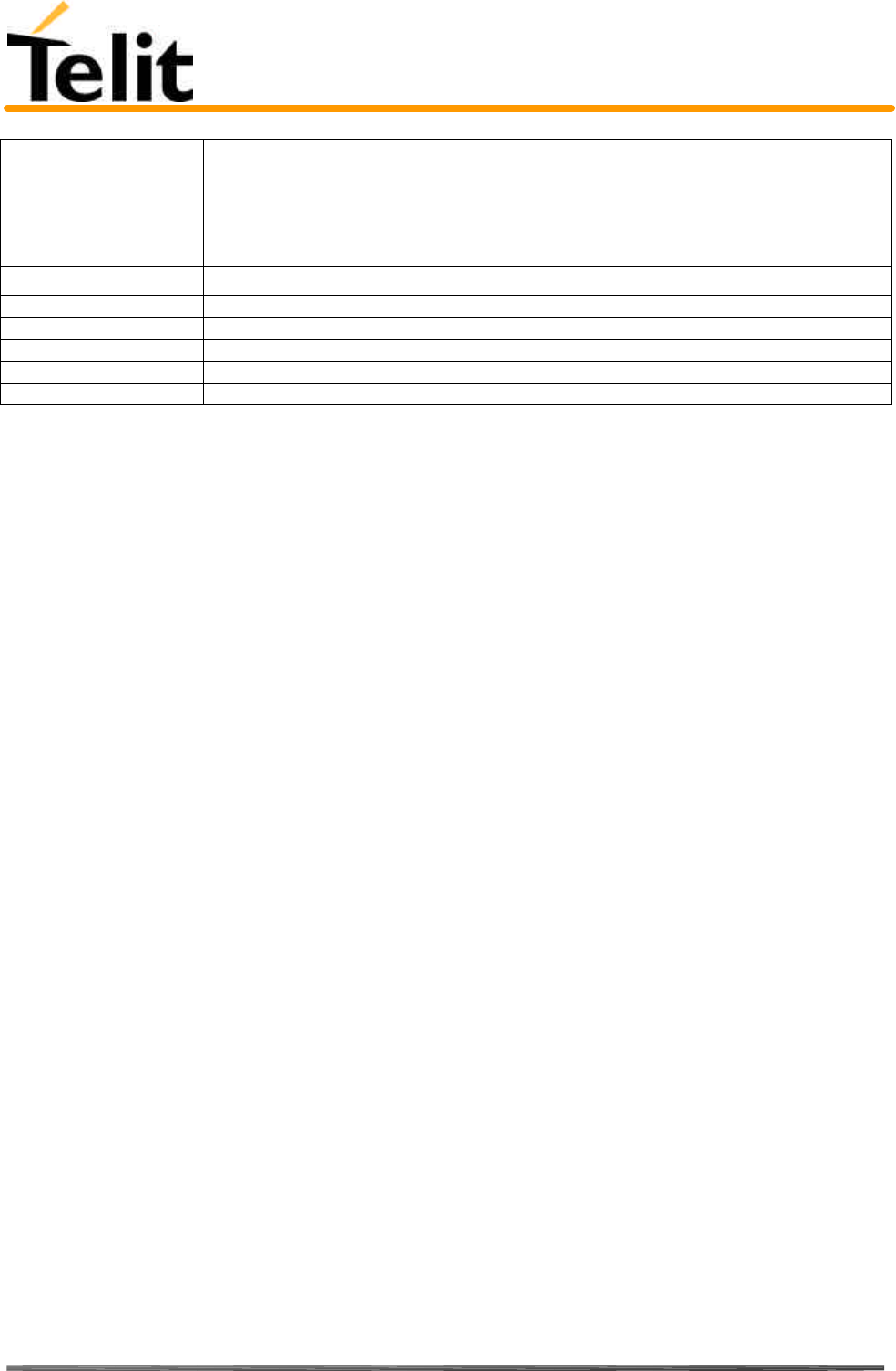
Telit TRIZIUM Product Description
80264ST10007a Rev. 4– 09/09/04
Reproduction forbidden without DAI Telecom written authorization – All Right reserved – Right of modification reserved page 44 of 202
REG DEC HEX
<reg> <dec> <hex>
where
<reg> - S register number (0 .. 52)
<dec> - current value in decimal notation
<hex> - current value in hexadecimal notation
Read command
Write command
Test command
Example
Reference
SW release Version A
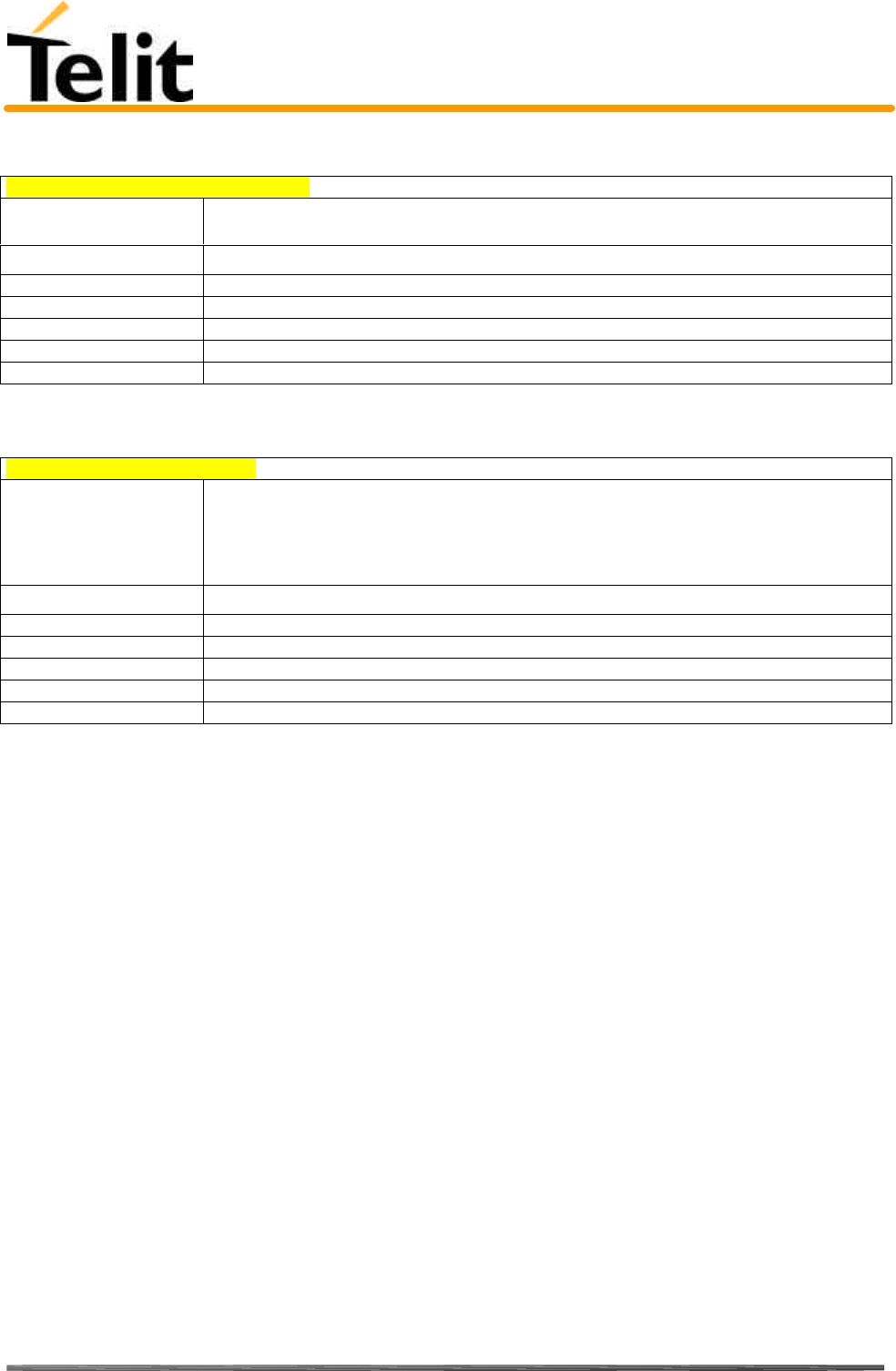
Telit TRIZIUM Product Description
80264ST10007a Rev. 4– 09/09/04
Reproduction forbidden without DAI Telecom written authorization – All Right reserved – Right of modification reserved page 45 of 202
5.3.1.16 &V2 - display last connection statistics
&V2 – display last connection statistics
Execute command
AT&V2 Returns the last connection statistics & connection failure reason.
Read command
Write command
Test command
Example
Reference
SW release Version A
5.3.1.17 \V - single line connect message
\V – Single line connect message
Execute command
AT\V <n> Set single line connect message.
Parameter:
<n> = 0 - off
<n> = 1 on
Read command
Write command
Test command
Example
Reference
SW release Version A
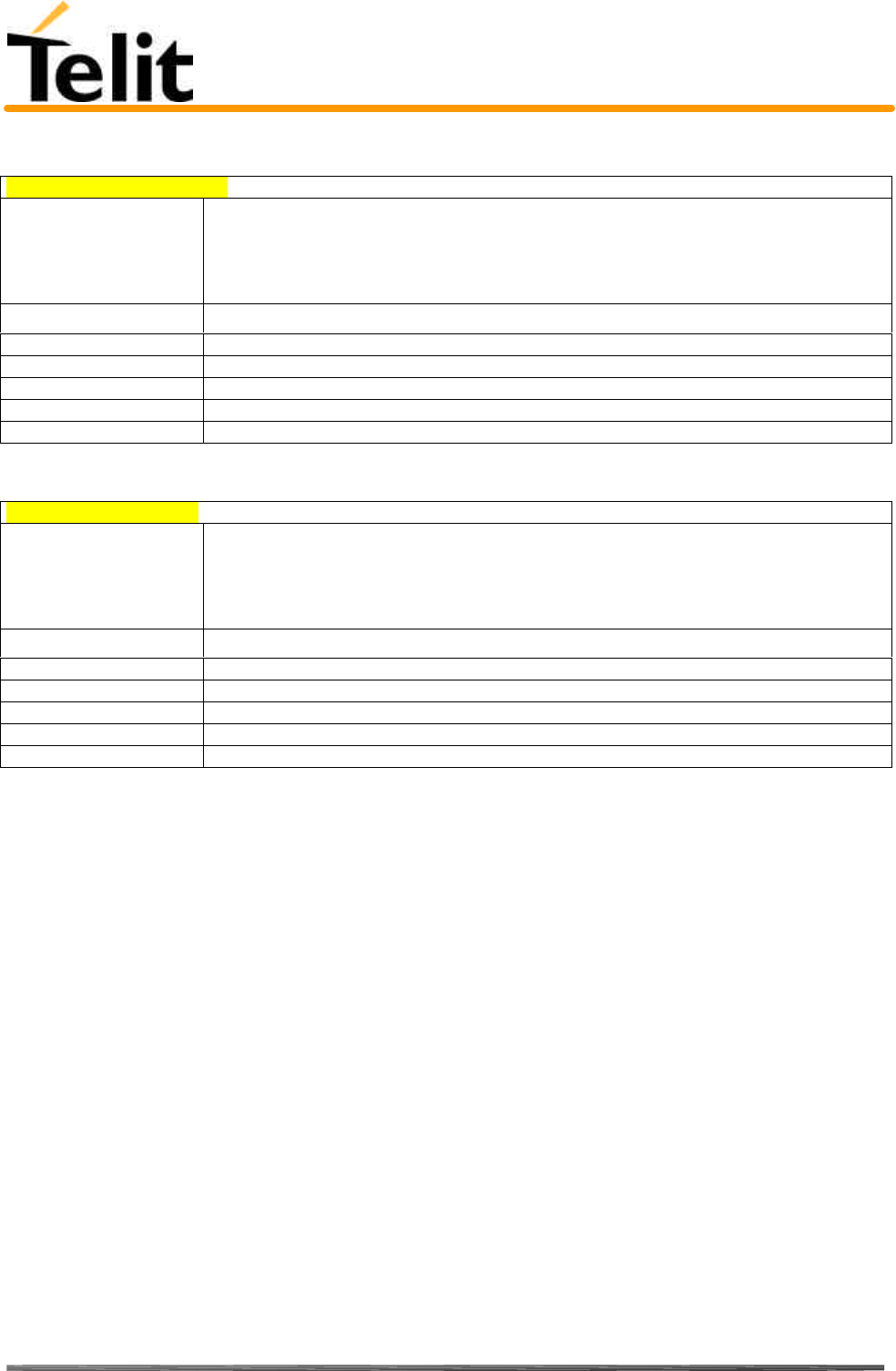
Telit TRIZIUM Product Description
80264ST10007a Rev. 4– 09/09/04
Reproduction forbidden without DAI Telecom written authorization – All Right reserved – Right of modification reserved page 46 of 202
5.3.1.18 %L - report line signal level
%L – report line signal level
Execute command
AT%L Reports the line signal level.
Note: Since on mobile phone there's no line connection, command is included only for
compatibility and returns only OK.
To check signal strength (level) use the +CSQ command.
Read command
Write command
Test command
Example
Reference
SW release Version A
5.3.1.19 %Q - report line quality
%Q – report line quality
Execute command
AT%Q Reports the line quality indicator.
Note: Since on mobile phone there's no line connection, command is included only for
compatibility and returns only OK.
To check signal quality use the +CSQ command.
Read command
Write command
Test command
Example
Reference
SW release Version A
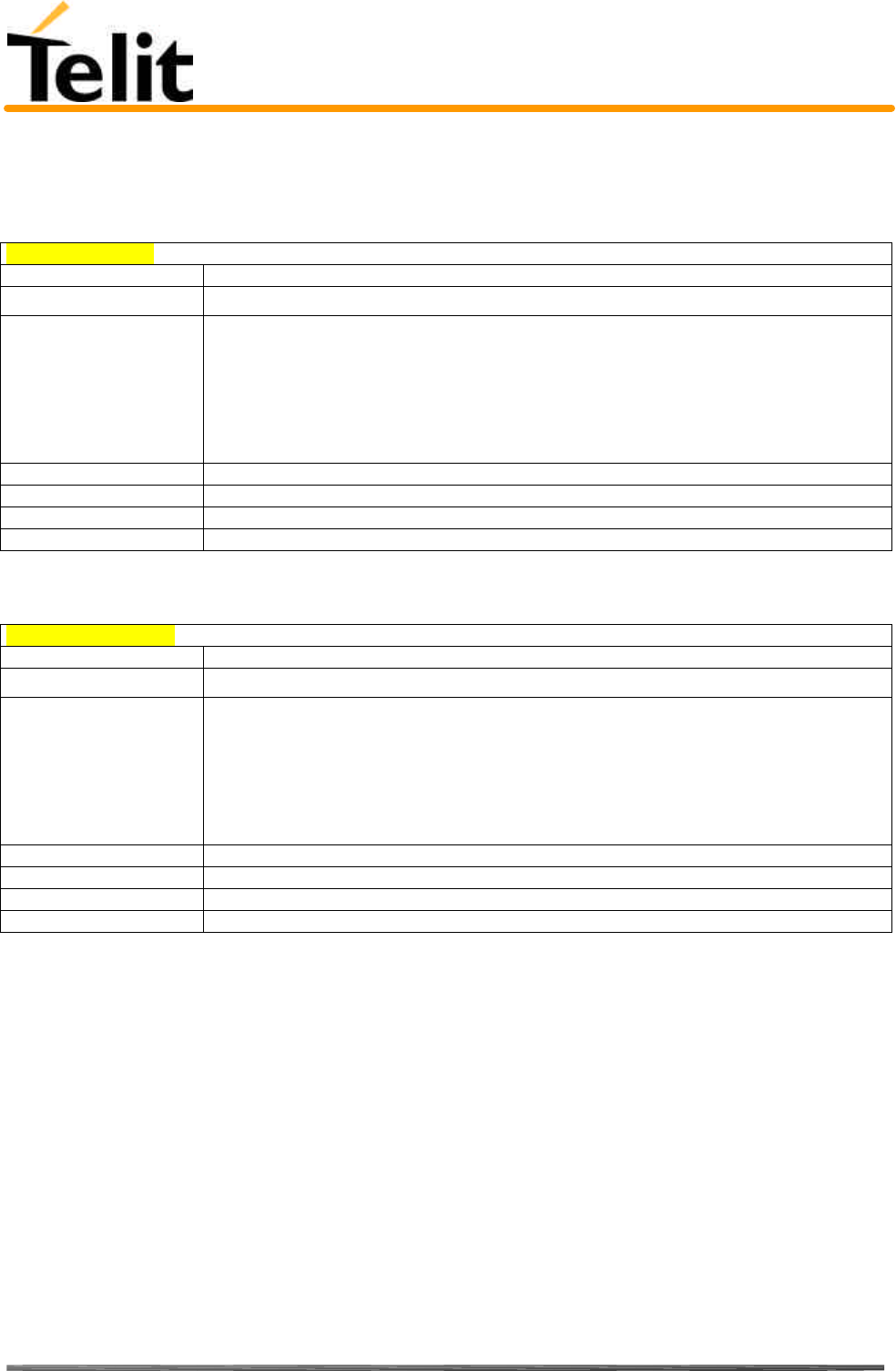
Telit TRIZIUM Product Description
80264ST10007a Rev. 4– 09/09/04
Reproduction forbidden without DAI Telecom written authorization – All Right reserved – Right of modification reserved page 47 of 202
5.3.2 DTE - modem interface control
5.3.2.1 E - command echo
E – command echo
Execute command
Read command
Write command
ATE <n> Controls the command echo response of the device, enabling or disabling the echo.
Parameter:
<n> = 0 - disables command echo, hence after this command the only characters received
by DTE are the responses to commands sent to device.
<n> = 1 - enables command echo (default) , hence command sent to the device are echoed
back to the DTE before the response is given.
Test command
Example
Reference V25ter
SW release Version A
5.3.2.2 Q - quiet resut codes
Q – quiet result codes
Execute command
Read command
Write command
ATQ <n> Enables or disables the result codes.
Parameter:
<n> = 0 - enables result codes
<n> = 1 - disables result codes
Note: After disabling result codes with ATQ1, the device does not return a response to
commands (usually OK), but command are executed anyway.
Test command
Example
Reference V25ter
SW release Version A
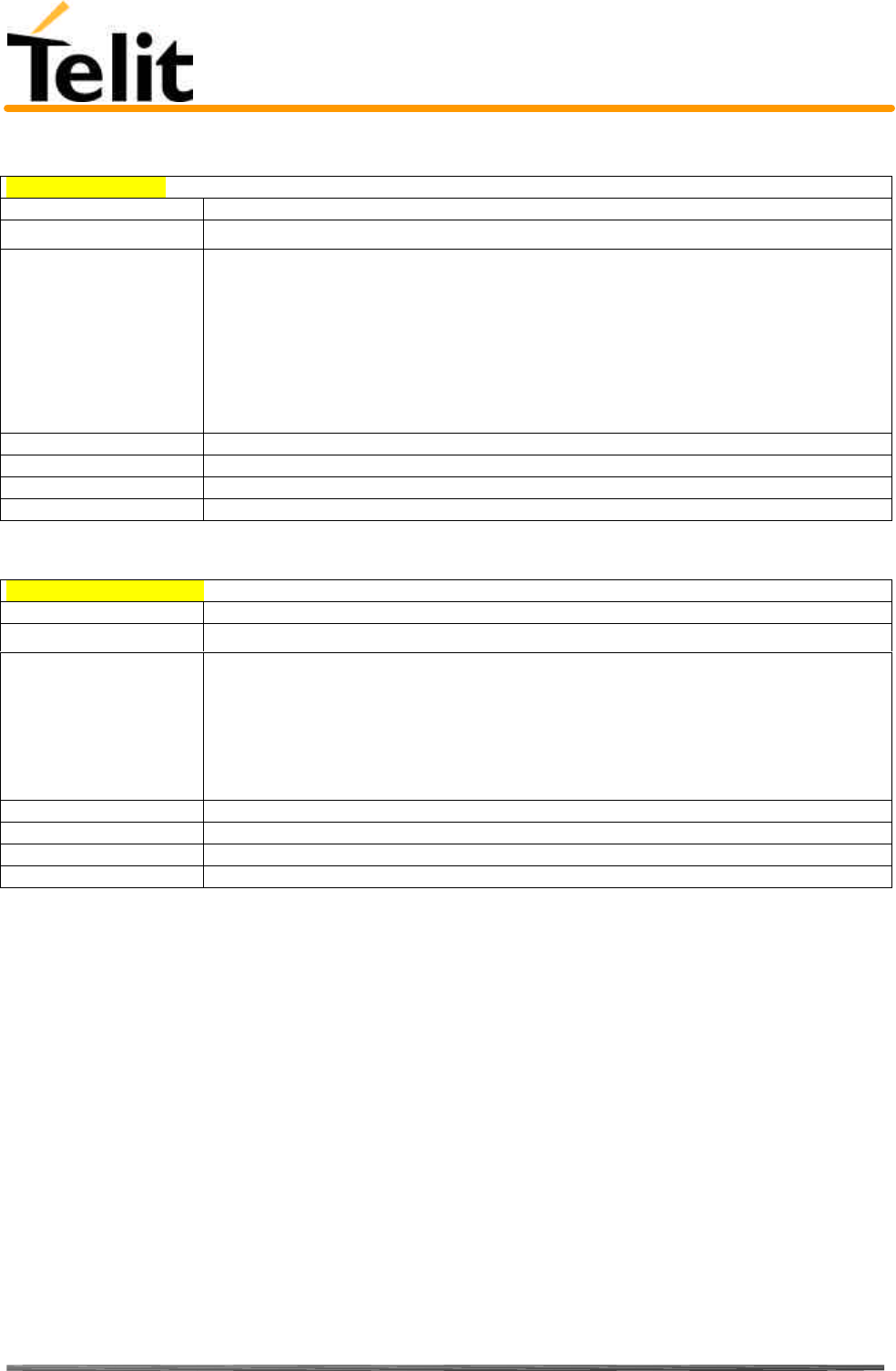
Telit TRIZIUM Product Description
80264ST10007a Rev. 4– 09/09/04
Reproduction forbidden without DAI Telecom written authorization – All Right reserved – Right of modification reserved page 48 of 202
5.3.2.3 V- result code form
V – result code form
Execute command
Read command
Write command
ATV <n> Sets the result code format.
Parameter:
<n> = 0 set the short format (terse) return codes are numbers 0-9.
<n> = 1 set the long form (verbose) return codes.
Note: Line feed is not issued before a short format result code.
Test command
Example
Reference V25ter
SW release Version A
5.3.2.4 X - extended result codes
X – extended result codes
Execute command
Read command
Write command
ATX <n> Selects the result code messages subset used by the modem to inform the DTE of the result
of the commands.
Parameter:
<n> = 0 - send only OK, CONNECT, RING, NO CARRIER, ERROR, NO ANSWER
results. Busy tones reporting is disabled.
<n> = 1,2,3,4 - reports all messages (default).
Test command
Note For complete control on CONNECT response message see also +DR command.
Reference V25ter
SW release Version A
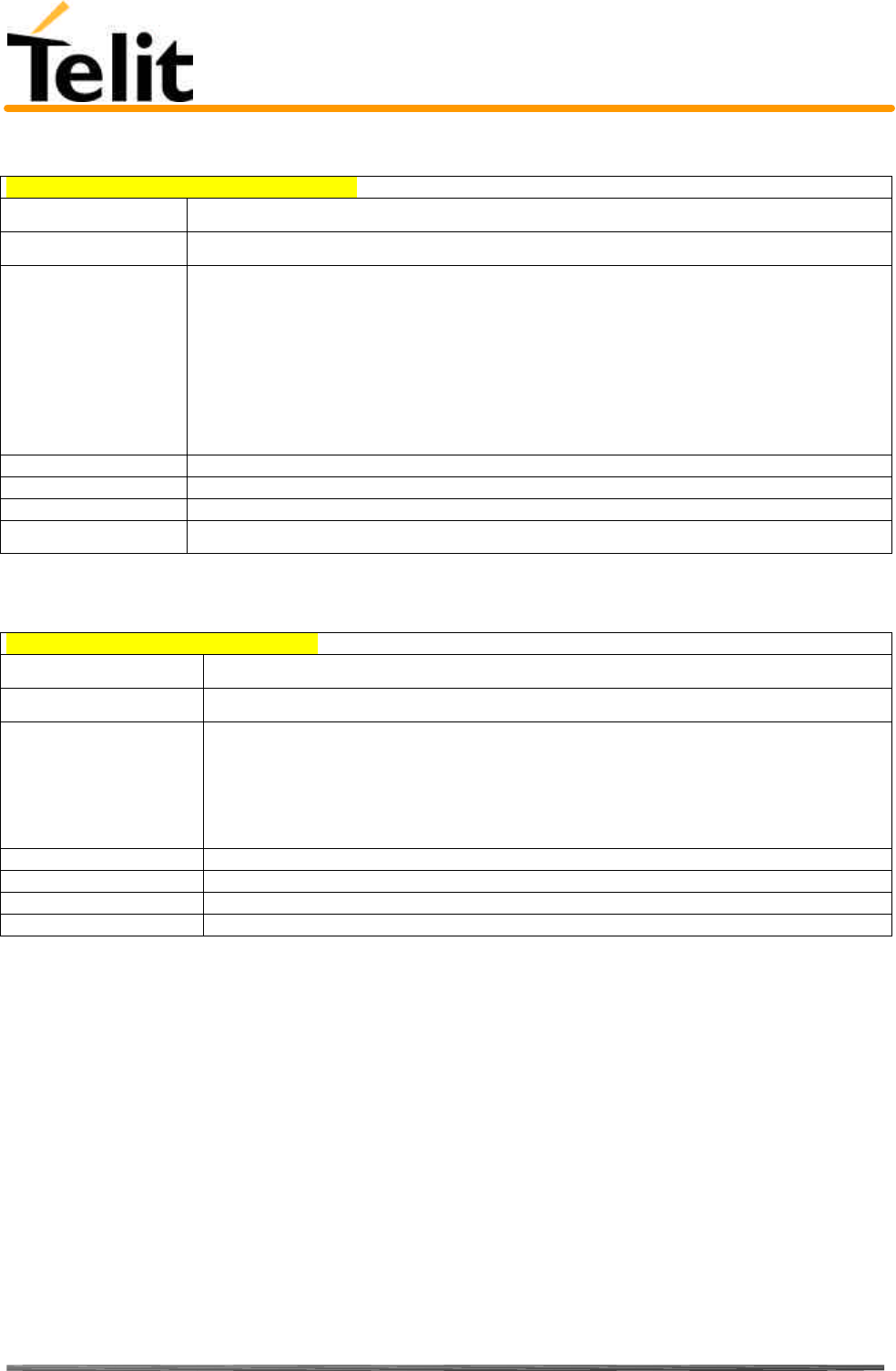
Telit TRIZIUM Product Description
80264ST10007a Rev. 4– 09/09/04
Reproduction forbidden without DAI Telecom written authorization – All Right reserved – Right of modification reserved page 49 of 202
5.3.2.5 I - Request identifier and software checksum
I – request identifier and software checksum
Execute command
Read command
Write command
ATI <n> Returns the identifier and a software checksum.
Parameter:
<n> = 0 numerical identifier.
<n> = 1 TRIZIUM checksum
<n> = 2 checksum check result
<n> = 3 manufacturer, software product code
<n> = 4 product name
<n> = 5 DOB version
Test command
Example
Reference V25ter
SW release Version A
5.3.2.6 &C - data carrier detect (DCD) control
&C – Data carrier detect (DCD) control
Execute command
Read command
Write command
AT&C <n> Controls the RS232 DCD output behaviour.
Parameter:
<n> = 0 DCD remains high always.
<n> = 1 DCD follows the Carrier detect status: if carrier is detected DCD is high,
otherwise DCD is low. (default)
Test command
Example
Reference V25ter
SW release Version A
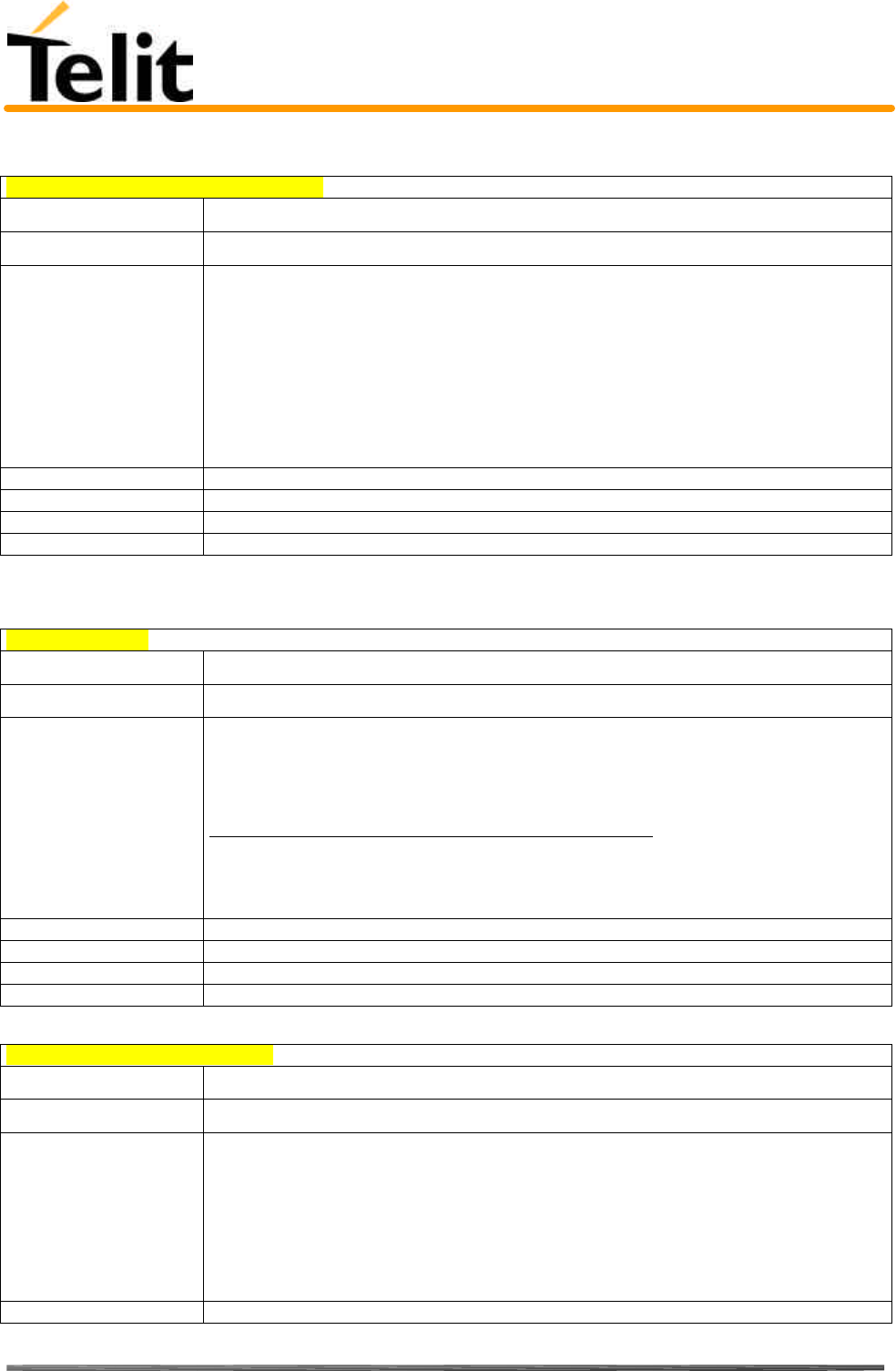
Telit TRIZIUM Product Description
80264ST10007a Rev. 4– 09/09/04
Reproduction forbidden without DAI Telecom written authorization – All Right reserved – Right of modification reserved page 50 of 202
5.3.2.7 &D - data terminal ready (DTR) control
&D – data terminal ready (DTR) control
Execute command
Read command
Write command
AT&D <n> Controls the TRIZIUM behaviour to the RS232 DTR transitions.
Parameter:
<n> = 0 DTR transitions are ignored.
<n> = 1 when the TRIZIUM is connected, the high to low transition of DTR pin sets the
device in command mode, the current connection is NOT closed.
<n> = 2 when the TRIZIUM is connected , the high to low transition of DTR pin sets the
device in command mode and the current connection is closed.
Note: if AT&D2 command is issued, the device does not answer to incoming calls if DTR is
low, even if ATA command is given.
Test command
Example
Reference V25ter
SW release Version A
5.3.2.8 &K - flow control
&K – flow control
Execute command
Read command
Write command
AT&K <n> Controls the RS232 flow control behaviour.
Parameter.
<n> = 0 - disabled
<n> = 1 - only CTS active, Hardware mono-directional
<n> = 2 - XON/XOFF software mono direction
<n> = 3 - RTS/CTS active, Hardware bi-directional (default)
<n> = 4 - XON/XOFF, Software bi-directional with filtering
<n> = 5 - XON/XOFF, Software bi-directional without filtering (Pass Through)
<n> = 6 - RTS/CTS active, Hardware bi-directional & software XON/XOFF (bi-
directional) with filtering
Test command
Example
Reference
SW release Version A
5.3.2.9 &S - data set ready (DSR) control
&S – data set ready (DSR) control
Execute command
Read command
Write command
AT&S <n> Controls the RS232 DSR pin behaviour:
n = 0 - always ON
n = 1 - follows the GSM traffic channel indication.
n = 2 - ON when connected
n = 3 - ON when device is ready to receive commands
Note: if option 1 is selected then DSR is tied up when the device receives from the network
the GSM traffic channel indication.
Test command

Telit TRIZIUM Product Description
80264ST10007a Rev. 4– 09/09/04
Reproduction forbidden without DAI Telecom written authorization – All Right reserved – Right of modification reserved page 51 of 202
Example
Reference V25ter
SW release Version A
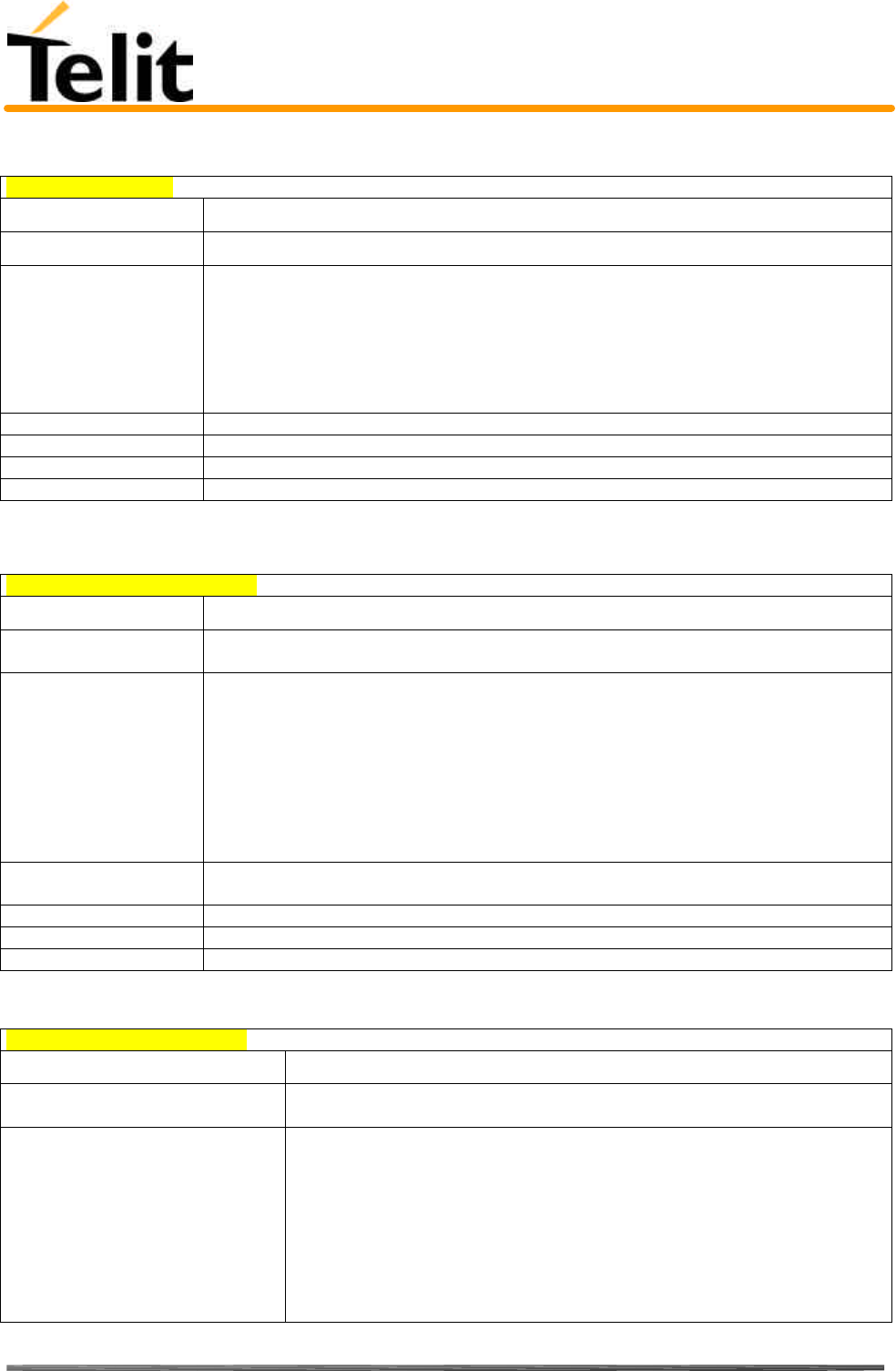
Telit TRIZIUM Product Description
80264ST10007a Rev. 4– 09/09/04
Reproduction forbidden without DAI Telecom written authorization – All Right reserved – Right of modification reserved page 52 of 202
5.3.2.10 \R - ring (RI) control
\R – ring (RI) control
Execute command
Read command
Write command
AT\R <n> controls the RING output pin behaviour.
Parameter:
<n> = 0 - RING on during ringing and further connection
<n> = 1 – RING on during ringing
<n> = 2 - RING follows the ring signal
Note: to check the ring option status use the &V command.
Test command
Example
Reference
SW release Version A
5.3.2.11 +IPR - fixed DTE interface rate
+IPR – fixed DTE interface rate
Execute command
Read command
AT+IPR? Returns the current value of +IPR parameter.
Write command
AT+IPR = <rate> Specifies the DTE speed at which the device accepts commands during command
mode operation, it may be used to fix the DTE-DCE interface speed.
Parameter:
<rate> = 0/300/1200/2400/4800/9600/19200/38400/57600/115200
If <rate> is unspecified or set to 0, then automatic speed detection is enabled and also
character format (see +ICF) is set to auto-detect.
If <rate> is specified and not 0, DTE-DCE speed is fixed at that speed, hence no
speed auto-detection (autobauding) is enabled.
Test command
AT+IPR=? Returns the supported serial port speed list.
Example
Reference V25ter
SW release Version A
5.3.2.12 +IFC - DTE - DTA flow control
+IFC – DTE-DTA flow control
Execute command
Read command
AT+IFC? Returns active flow control settings.
Write command
AT+IFC = <by_te>, <by_ta> Response
Selects the flow control behavior of the serial port in both directions: from DTE
to DTA (<by_ta> option) and from DTA to DTE (<by_te>)
Parameter:
<by_te> - flow control option for the data received by DTE,
<by_ta> - flow control option for the data sent by DTA
<by_te> = 0 - flow control None
<by_te> = 1 - XON/XOFF filtered
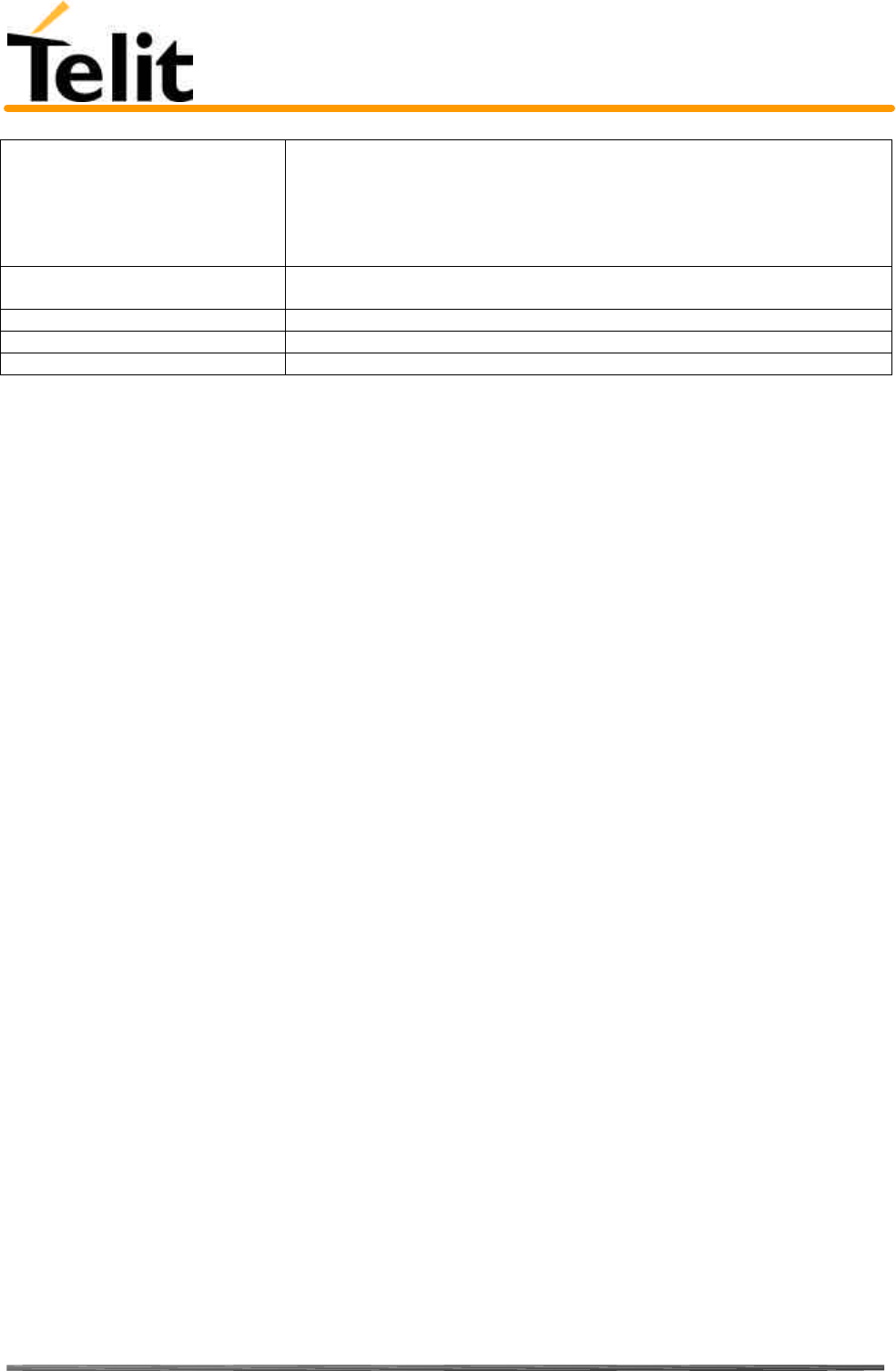
Telit TRIZIUM Product Description
80264ST10007a Rev. 4– 09/09/04
Reproduction forbidden without DAI Telecom written authorization – All Right reserved – Right of modification reserved page 53 of 202
<by_te> = 2 - C105 (RTS)
<by_te> = 3 - XON/XOFF not filtered
<by_ta> = 0 - flow control None
<by_ta> = 1 - XON/XOFF
<by_ta> = 2 - C106 (CTS)
Note: This command is equivalent to &K command.
Test command
AT+IFC=? Response
Returns all supported values of the parameters <by_te> and <by_ta>.
Example
Reference V25ter
SW release Version A
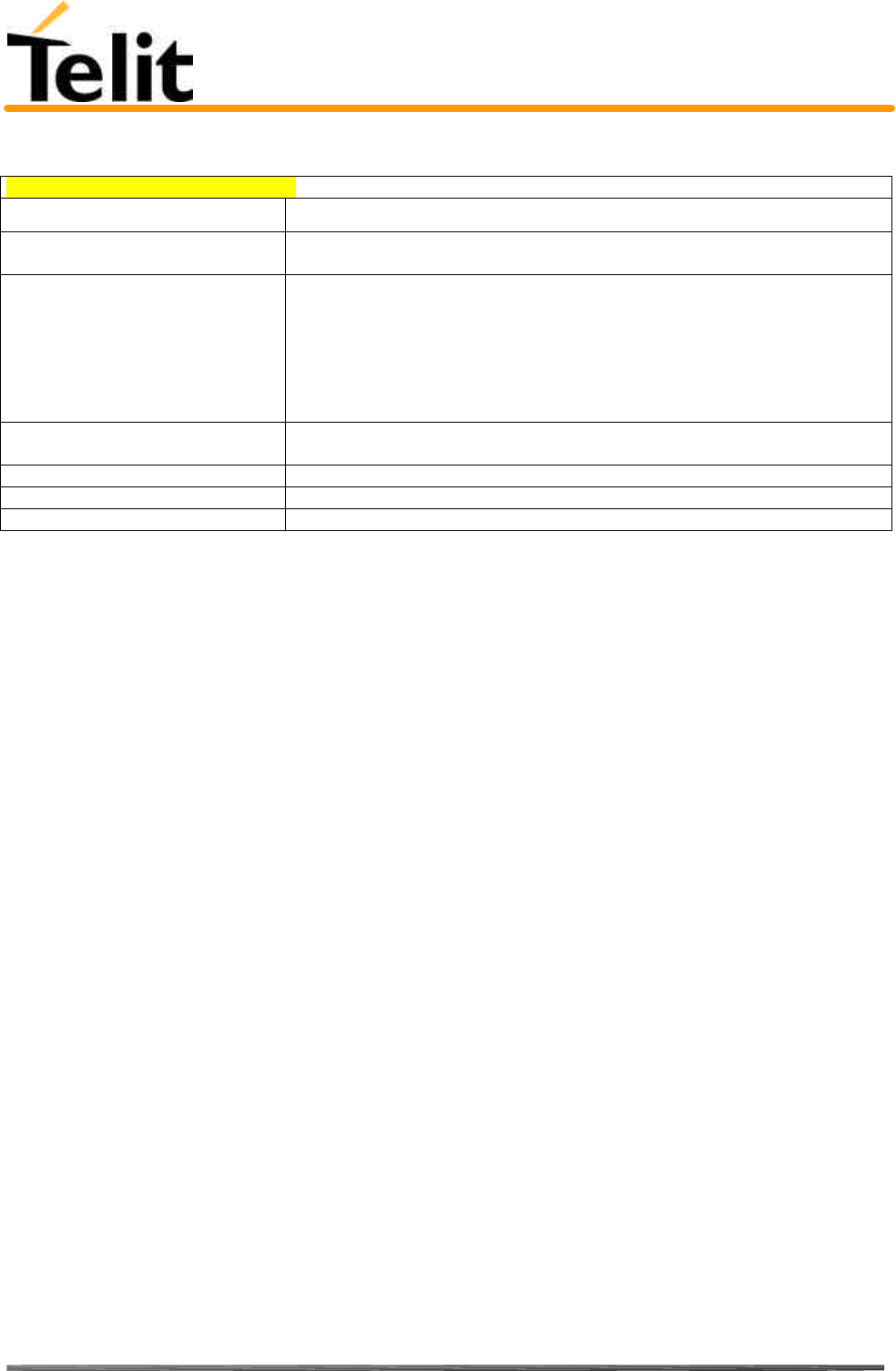
Telit TRIZIUM Product Description
80264ST10007a Rev. 4– 09/09/04
Reproduction forbidden without DAI Telecom written authorization – All Right reserved – Right of modification reserved page 54 of 202
5.3.2.13 +ILRR - DTE - modem rate reporting
+ILRR – DTE-modem rate reporting
Execute command
Read command
AT+ILRR? Returns active setting of port speed rate reporting information.
Write command
AT+ILRR = <n> Controls whether or not the +ILRR:<rate> information text is transmitted from
the TRIZIUM to the DTE.
Parameter:
<n> = 0 - local port speed rate reporting disabled
<n> = 1 - local port speed rate reporting enabled
Note: this information if enabled is sent upon connection.
Test command
AT+ILRR=? Returns all supported values of the parameter <n>
Example
Reference V25ter
SW release Version A
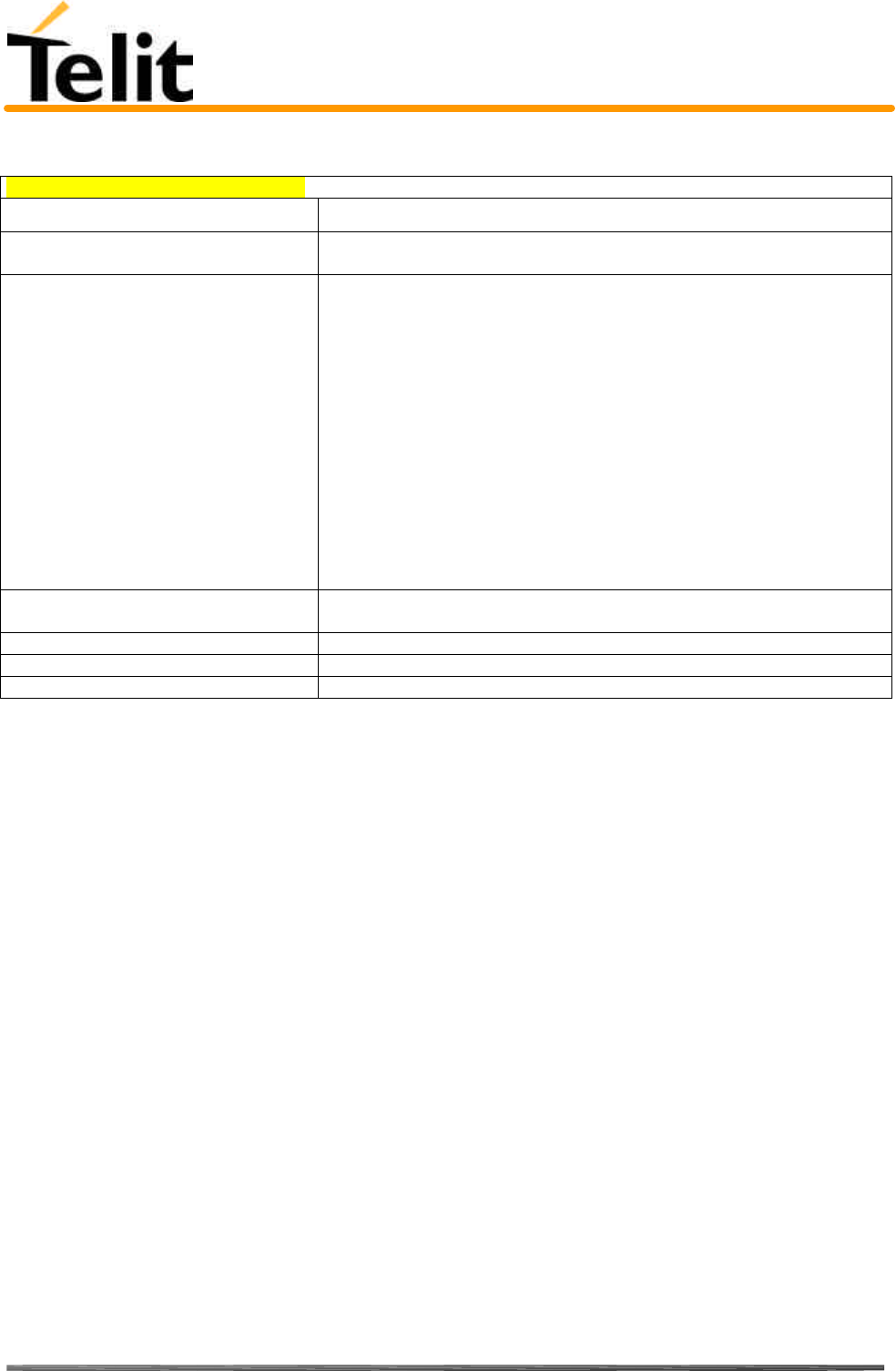
Telit TRIZIUM Product Description
80264ST10007a Rev. 4– 09/09/04
Reproduction forbidden without DAI Telecom written authorization – All Right reserved – Right of modification reserved page 55 of 202
5.3.2.14 +ICF - DTE - modem character format
+ICF – DTE-modem character format
Execute command
Read command
AT+ICF? Returns current value of the character format.
Write command
AT+ICF = <format>[,<parity>] Defines the asynchronous character format to be used when autobauding is
disabled.
Parameter:
<format> = 0..5, < parity> = 0/1
AT+ICF = 0 - auto detect
AT+ICF = 1 - 8N2
AT+ICF = 2,0 - 8O1
AT+ICF = 2,1 - 8E1
AT+ICF = 3 - 8N1
AT+ICF = 5,0 - 7O1
AT+ICF = 5,1 - 7E1
Note: the character format is defined as: number of bit per char, parity bit
and stop bit; where parity can be None, Odd and Even. E.g. 8E1 means 8 bit
per char with the even parity bit and 1 stop bit.
Test command
AT+ICF=? Returns all supported values of the parameters <format> and <parity>
Example
Reference V25ter
SW release Version A
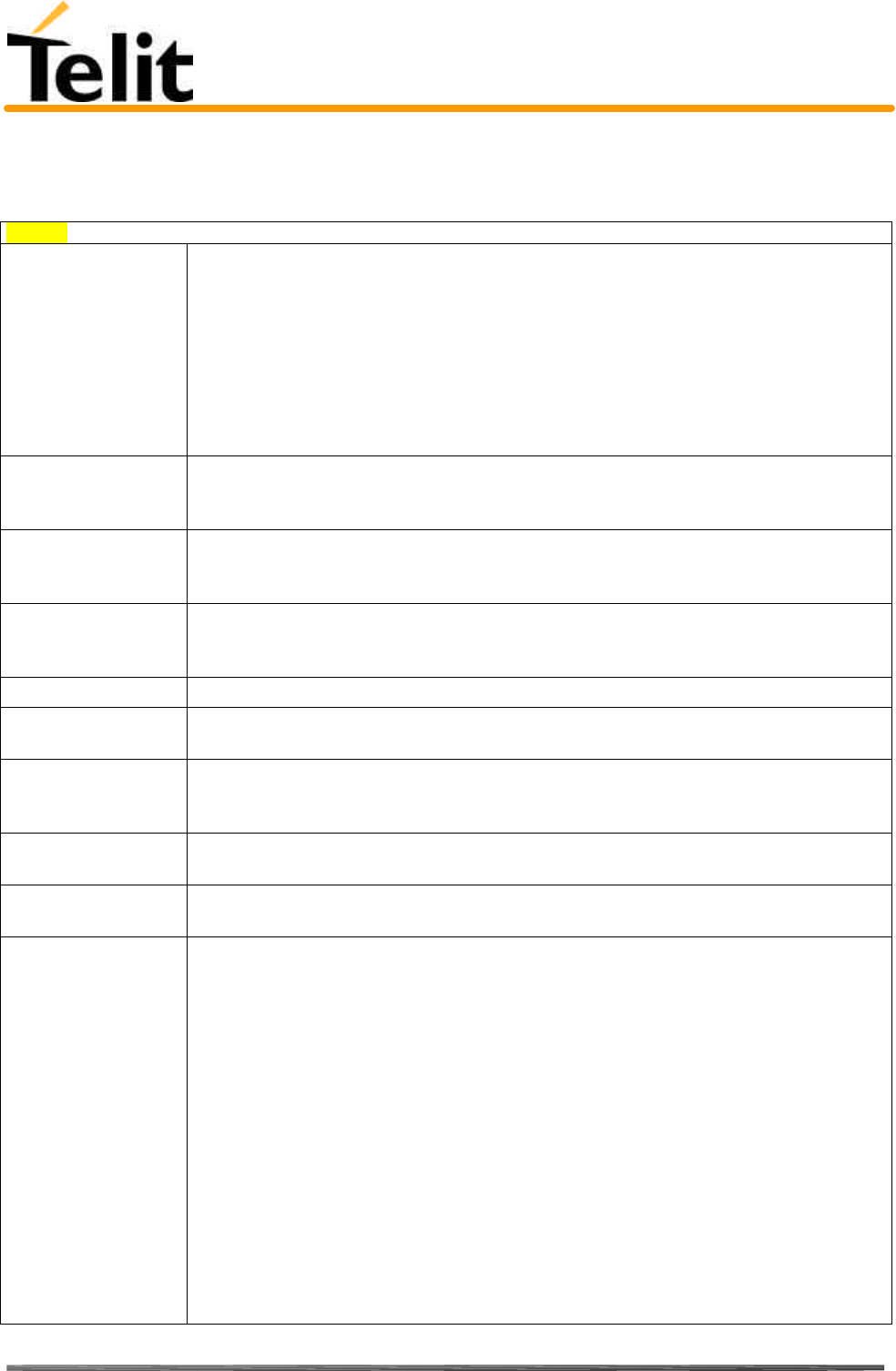
Telit TRIZIUM Product Description
80264ST10007a Rev. 4– 09/09/04
Reproduction forbidden without DAI Telecom written authorization – All Right reserved – Right of modification reserved page 56 of 202
5.3.3 Call Control
5.3.3.1 D - dial
D – dial
Execute command
ATD <number> Starts a call to the phone number given as parameter.
Parameter: <number> - phone number to be dialled
Note: The call is a data call or voice call depending on +FCLASS setting. If AT+FCLASS=8
command was issued before calling then the call will be done as a voice call, instead if
AT+FCLASS=0 command was issued the call will be a data one. The default value of
+FCLASS is 0 hence calls are by default data ones.
The numbers accepted are 0-9 and *,#,”A”, ”B”, ”C”, ”D”,”+”.
For backwards compatibility with landline modems modifiers “T”, ”P”, ”R”, ”,”, ”W”, “!”,
“@” are accepted but have no effect.
ATD <number> ; Issues a VOICE call to the number given regardless of the current value of the parameter
+FCLASS, which remains unaffected.
Parameter: <number> - phone number to be dialled.
ATD <n> [;] Issues a call (VOICE if ";" modifier is added to the end of the command) to the number
stored in the TRIZIUM internal phonebook position number <n>.
Parameter: <n> - internal phonebook position to be called
ATD> <n> [;] Issues a call (VOICE if ";" modifier is added to the end of the command) to the number
stored in the SIM phonebook in the record number <n>.
Parameter: <n> - SIM phonebook position to be called
ATDL Issues a call to the last number dialled.
ATDS=<nr> Issues a call to the internally stored number at the position <nr>. ( See
commands &N and &Z)
ATD<n> I [;] Issues a call [voice if ; is added] overwriting the CLIR setting in order to hide the CLI to the
called party for the current call only.
ATD<n> i [;] Issues a call [voice if ; is added] overwriting the CLIR setting in order to show
the CLI to the called party for the current call only.
ATD<n> G[;]
ATD<n>g[;] Issues a call [voice if ; is added] checking the CUG supplementary service for
the current call. Refer to +CCUG command.
ATD*<gprs_sc>[*<ad
dr>]
[*[<L2P>][*[<cid>]]]]
#
This command is specific of GPRS functionality and causes the MT to
perform whatever actions are necessary to establish communication between
the TE and the external PDN.
Parameters:
<GPRS_SC> - (GPRS Service Code) a digit string (value 99) which identifies
a request to use the GPRS
<addr> - string that identifies the called party in the address space applicable
to the PDP.
<L2P>: a string which indicates the layer 2 protocol to be used (see
+CGDATA command). For communications software that does not support
arbitrary characters in the dial string, the following numeric equivalents shall
be used:
1 - PPP
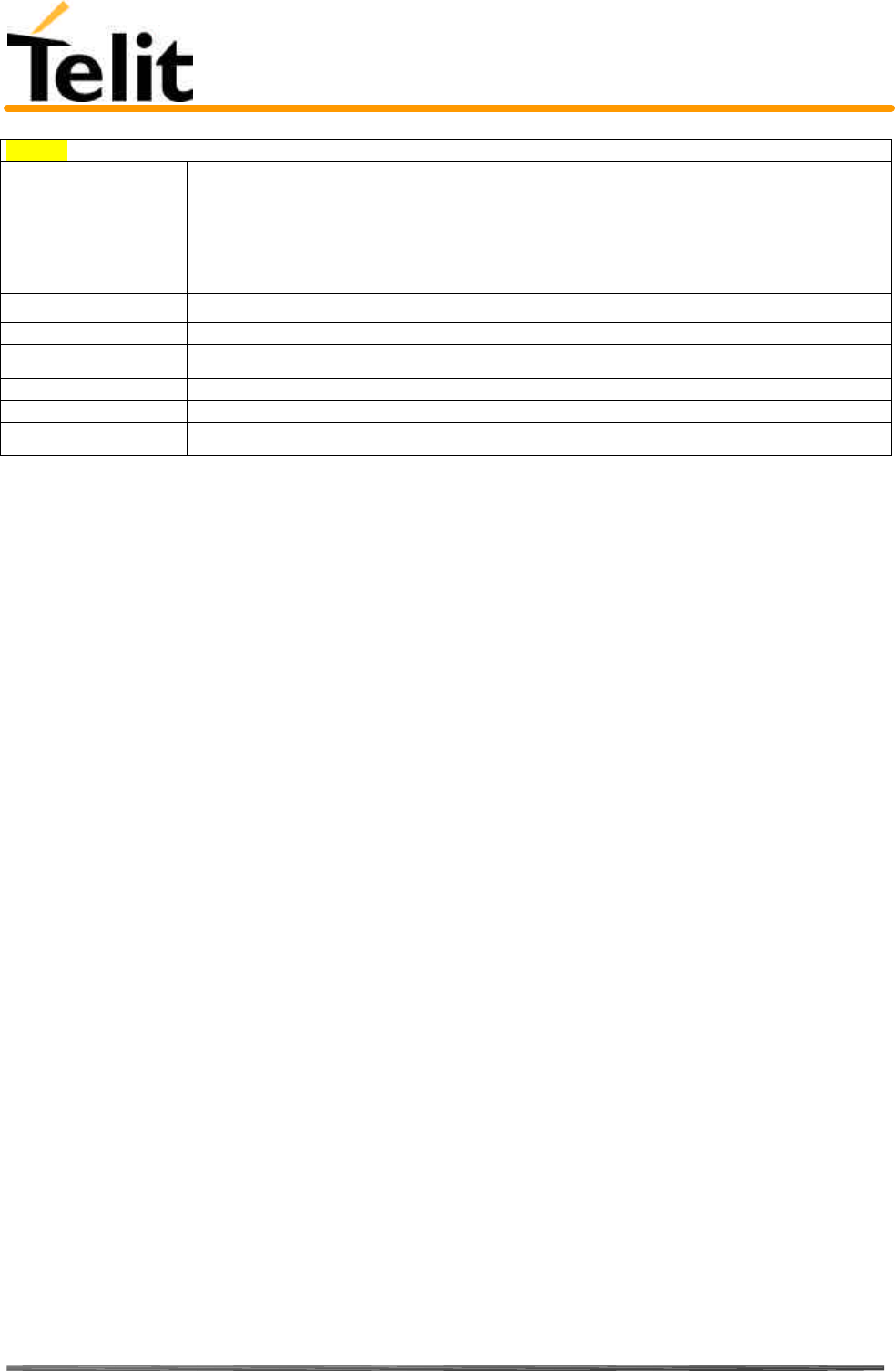
Telit TRIZIUM Product Description
80264ST10007a Rev. 4– 09/09/04
Reproduction forbidden without DAI Telecom written authorization – All Right reserved – Right of modification reserved page 57 of 202
D – dial Other values are reserved and will result in an ERROR response to the set
command.
<cid>: a digit string which specifies a particular PDP context definition (see
+CGDCONT command).
Read command
Write command
Test command
Example
Reference V25ter.
SW release Version A
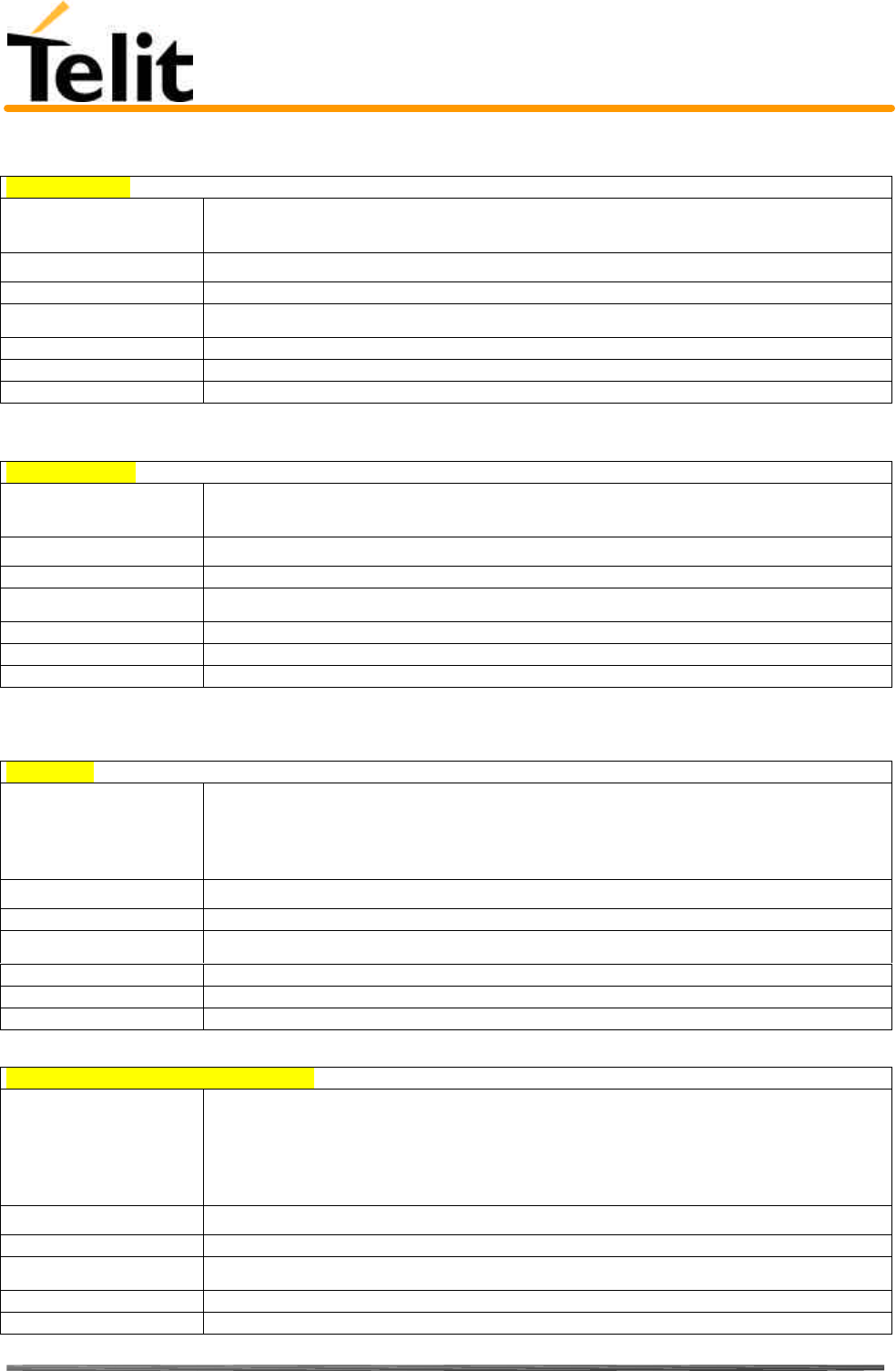
Telit TRIZIUM Product Description
80264ST10007a Rev. 4– 09/09/04
Reproduction forbidden without DAI Telecom written authorization – All Right reserved – Right of modification reserved page 58 of 202
5.3.3.2 T - set tone dial
T – set tone dial
Execute command
ATT It has no effect is included only for backward compatibility with landline modems.
Read command
Write command
Test command
Example
Reference V25ter.
SW release Version A
5.3.3.3 P - set pulse dial
P – set pulse dial
Execute command
ATP It has no effect is included only for backward compatibility with landline modems.
Read command
Write command
Test command
Example
Reference V25ter.
SW release Version A
5.3.3.4 A - answer
A – answer
Execute command
ATA It is used to answer to an incoming call if automatic answer is disabled.
Note: This command MUST be the last in the command line and must be followed
immediately by a <CR> character.
Read command
Write command
Test command
Example
Reference V25ter.
SW release Version A
5.3.3.5 A/ - Last command automatic repetition
A/ – last command automatic repetition
Execute command
A/ It is used to execute again the last received command.
This command works only at fixed IPR.
Note: This command has been substituted with AT#/ command.
Refer to #/ command reference.
Read command
Write command
Test command
Example
Reference
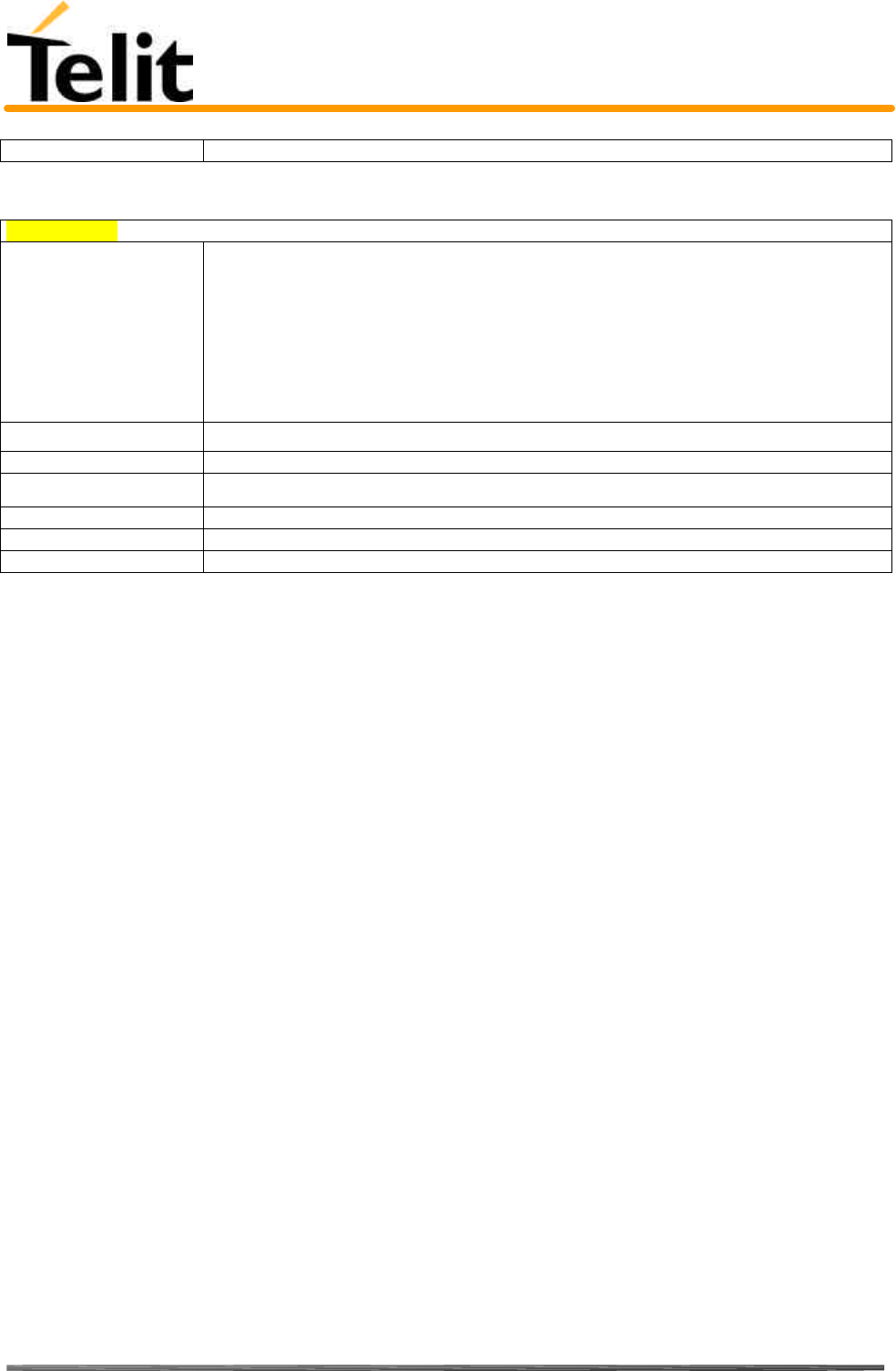
Telit TRIZIUM Product Description
80264ST10007a Rev. 4– 09/09/04
Reproduction forbidden without DAI Telecom written authorization – All Right reserved – Right of modification reserved page 59 of 202
SW release Version A
5.3.3.6 H - disconnect
H - disconnect
Execute command
ATH It is used to close the current conversation (voice, data or fax).
Note: When a data conversation is active the device is in on-line mode commands are not
sensed, instead characters are sent to the other interlocutor. To issue this command you
must be in command mode operation, hence escape sequence (see register S2) may be
required before issuing this command, otherwise if &D1 option is active, DTR pin should
be tied low to return in the command mode.
When a voice call is active, no escape sequence is needed.
Read command
Write command
Test command
Example
Reference V25ter.
SW release Version A
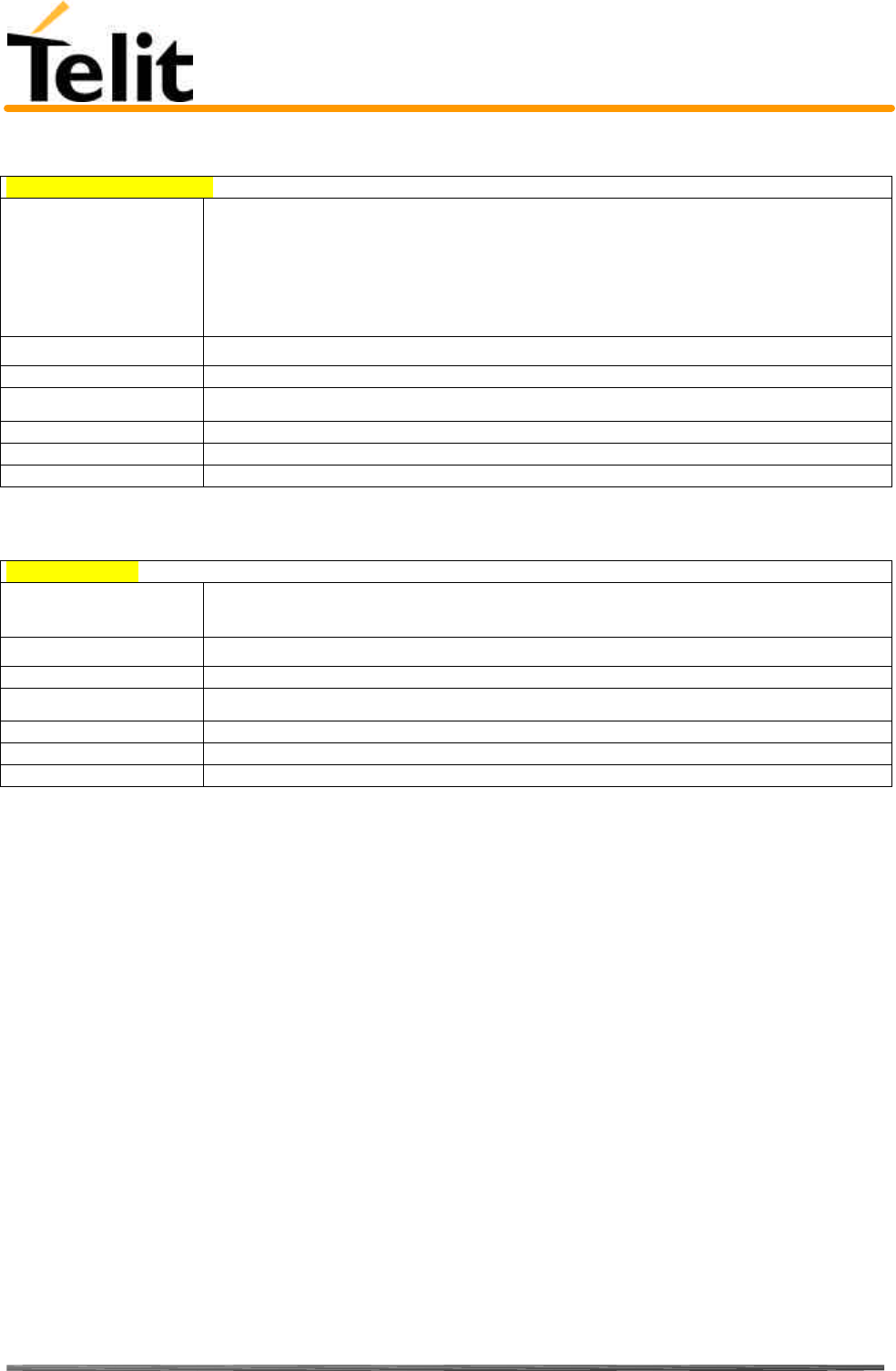
Telit TRIZIUM Product Description
80264ST10007a Rev. 4– 09/09/04
Reproduction forbidden without DAI Telecom written authorization – All Right reserved – Right of modification reserved page 60 of 202
5.3.3.7 O - return to On Line Mode
O – return to on line mode
Execute command
ATO It is used return to On-line mode from command mode. If there's no connection active
returns ERROR.
Note: After the issue of this command, if the device is in conversation, to send other
commands to the device you must return to command mode by issuing the escape sequence
or lowering DTR if &D1 option is active.
Read command
Write command
Test command
Example
Reference V25ter.
SW release Version A
5.3.3.8 &G - guard tone
&G – guard tone
Execute command
AT&G It is has no effect is included only for backward compatibility with landline modems.
Read command
Write command
Test command
Example
Reference
SW release Version A
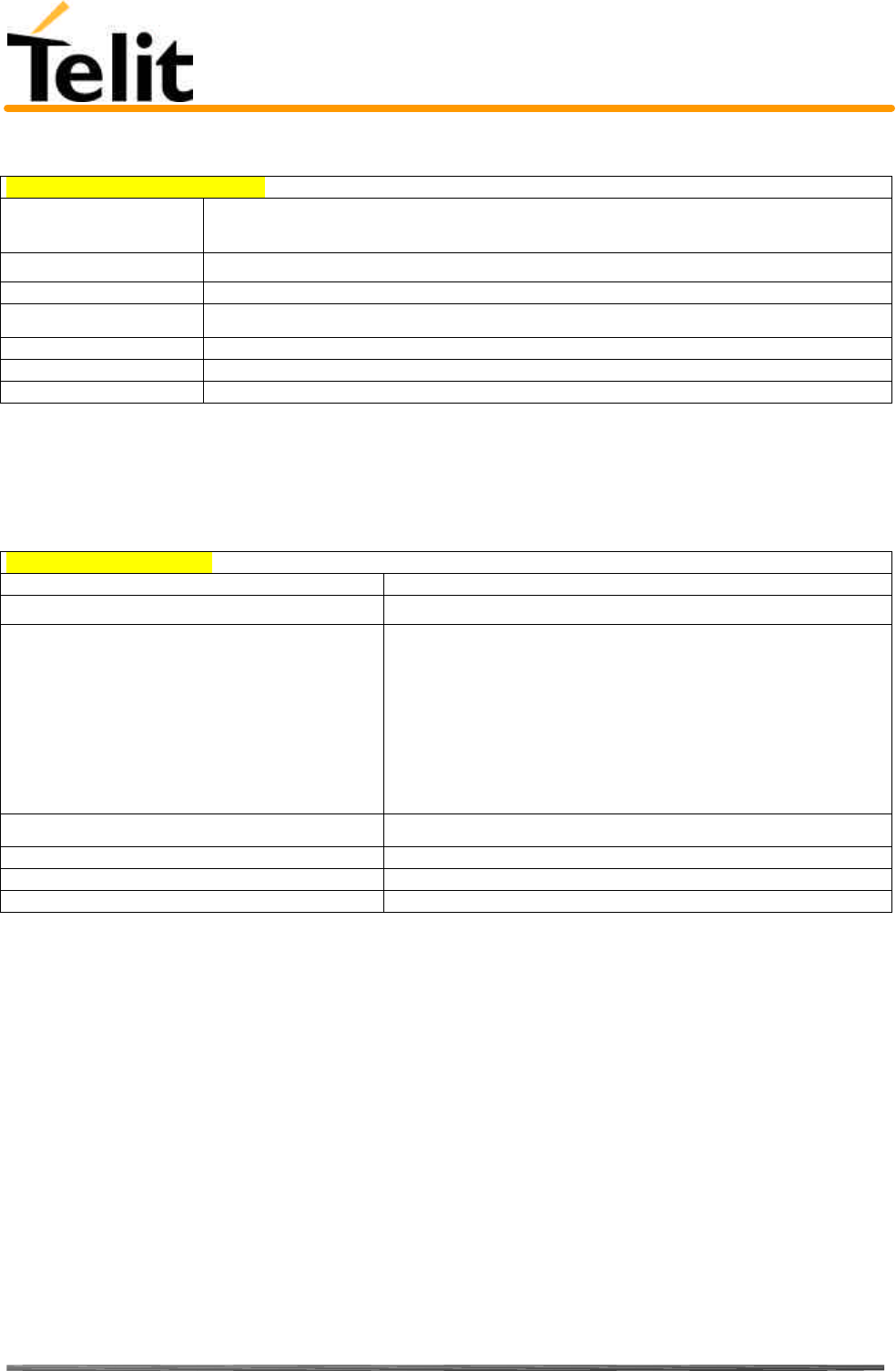
Telit TRIZIUM Product Description
80264ST10007a Rev. 4– 09/09/04
Reproduction forbidden without DAI Telecom written authorization – All Right reserved – Right of modification reserved page 61 of 202
5.3.3.9 &P - pulse dial make/break ratio
&P – pulse dial make/break ratio
Execute command
AT&P It is has no effect is included only for backward compatibility with landline modems..
Read command
Write command
Test command
Example
Reference
SW release Version A
5.3.4 Modulation control
5.3.4.1 +MS - modulation control
+MS – modulation control
Execute command
Read command
Write command
AT+MS = <modulation>, <automode>,
<min_speed>, <max_speed> This command has no effect is included only for backward
compatibility with landline modems.
Parameter:
<modulation> =V21 / V22 / V22B / V23C / V32 / V34
<automode> = 0/1
<min_speed> = 0
<max_speed> = 300-14400
Note: to change modulation requested use +CBST command.
Test command
Example
Reference
SW release Version A
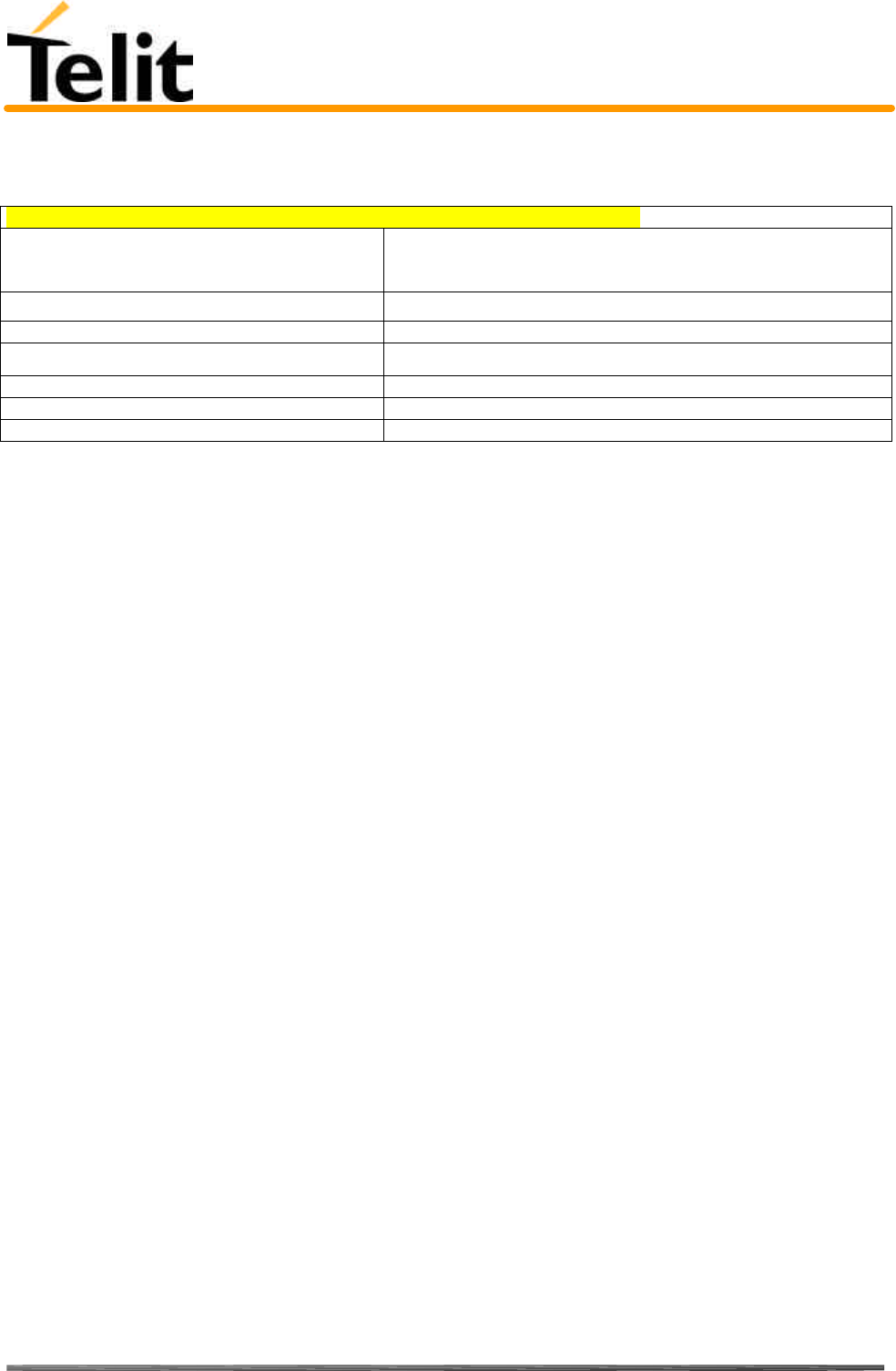
Telit TRIZIUM Product Description
80264ST10007a Rev. 4– 09/09/04
Reproduction forbidden without DAI Telecom written authorization – All Right reserved – Right of modification reserved page 62 of 202
5.3.4.2 %E - enable/disable line quality monitor and auto retrain or fallback /
fallforward
%E – enable/disable line quality monitor and auto retrain or fallback/fallforward
Execute command
AT%E It has no effect is included only for backward compatibility with
landline modems.
Read command
Write command
Test command
Example
Reference
SW release Version A
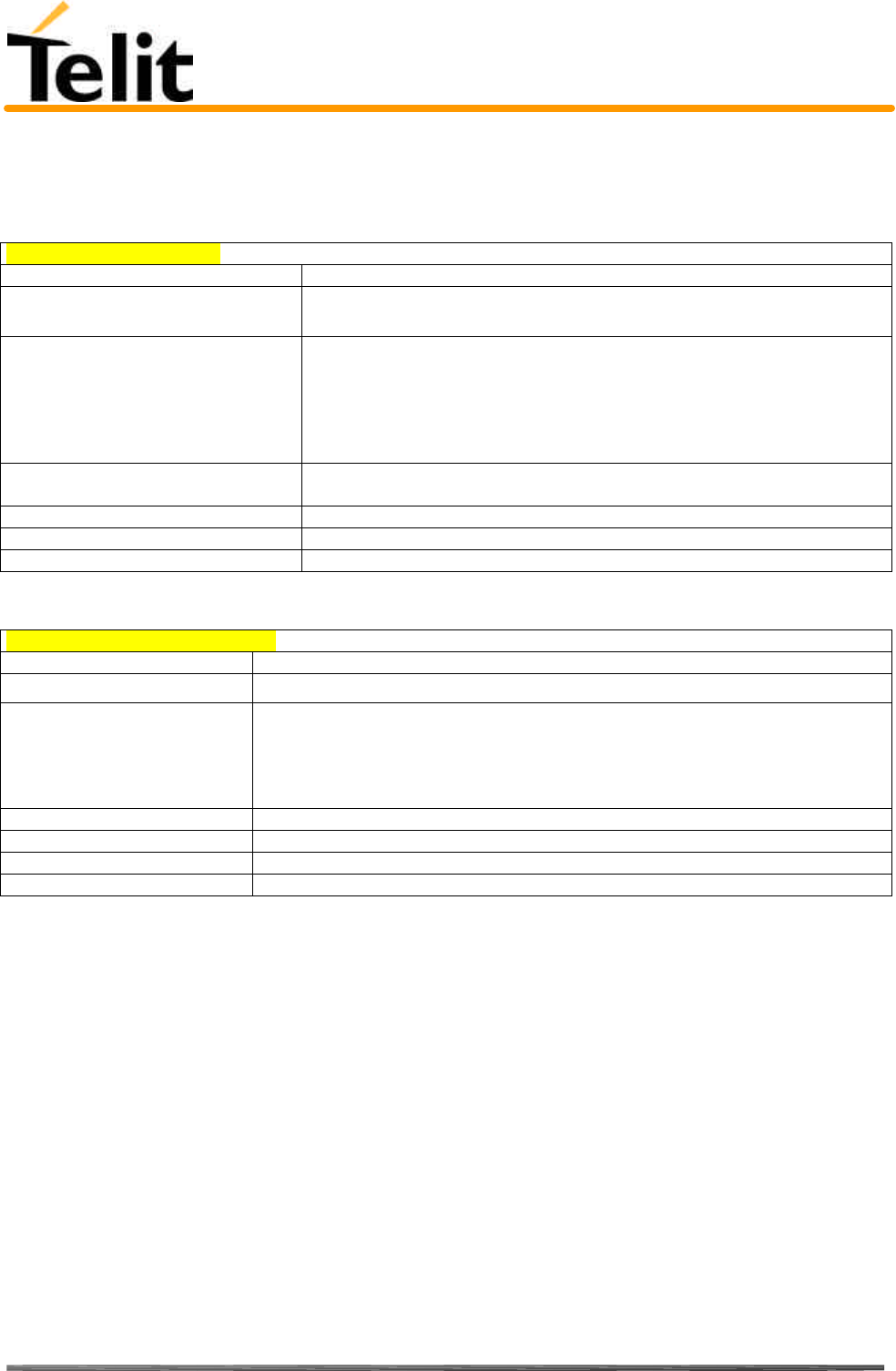
Telit TRIZIUM Product Description
80264ST10007a Rev. 4– 09/09/04
Reproduction forbidden without DAI Telecom written authorization – All Right reserved – Right of modification reserved page 63 of 202
5.3.5 Compression control
5.3.5.1 +DS - set data compression
+DS – set data compression
Execute command
Read command
AT+DS? Returns current value of the data compression parameter.
Write command
AT+DS = <n> Sets the V42 compression parameter.
Parameter:
<n> = 0 - no compression
n> = 1 - compression enabled
Note: The only value supported is 0 - no compression
Test command
AT+DS=? Returns all supported values of the parameter n
Example
Reference V25ter
SW release Version A
5.3.5.2 +DR - data compression reporting
+DR – data compression reporting
Execute command
Read command
Write command
AT+DR = <n> Controls the data compression reporting upon connection.
Parameter:
<n> = 0 no data compression reporting is displayed at the connection
<n> = 1 a data compression report message is sent by the device upon connection
Test command
Example
Reference V25ter
SW release Version A
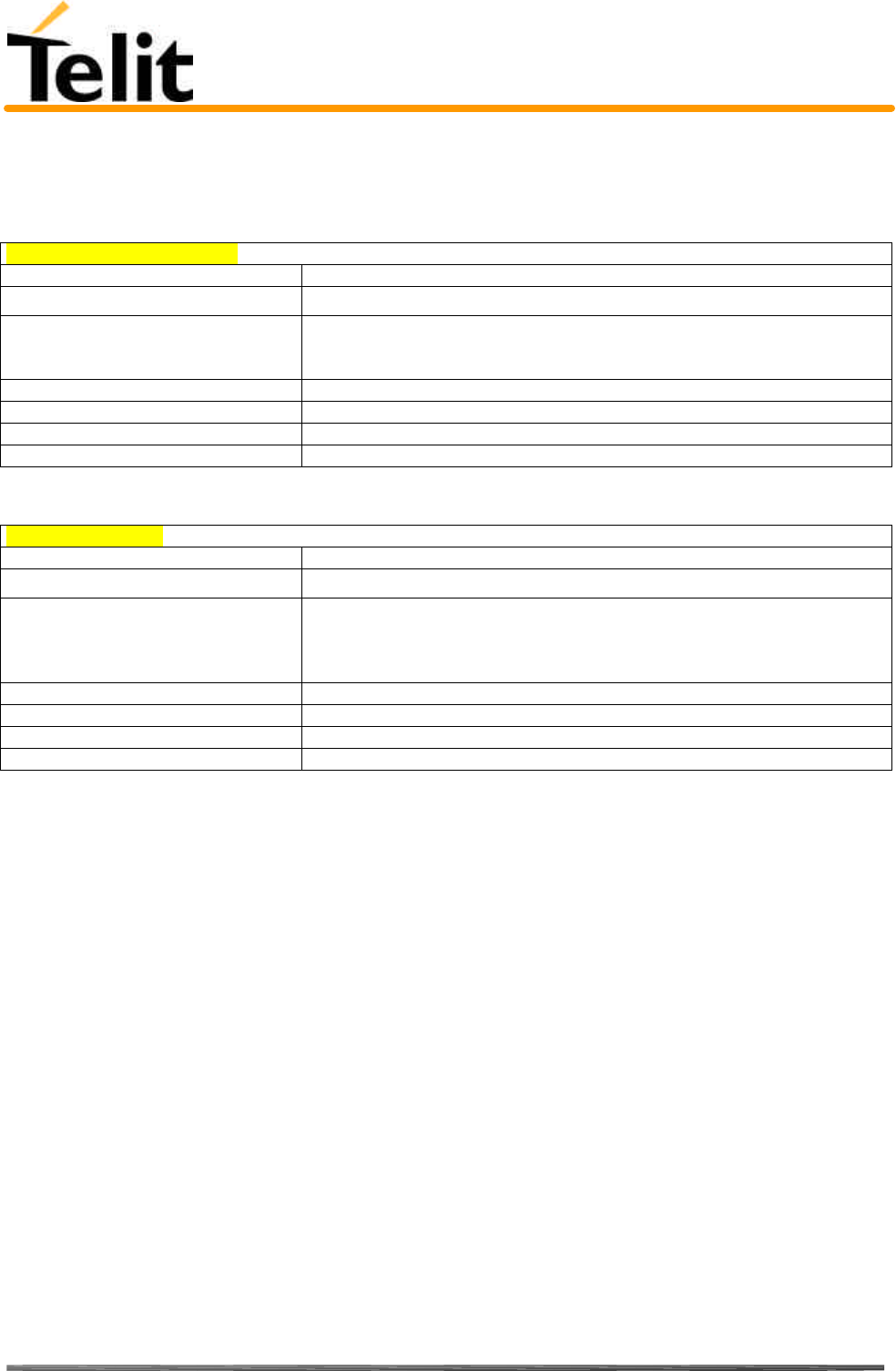
Telit TRIZIUM Product Description
80264ST10007a Rev. 4– 09/09/04
Reproduction forbidden without DAI Telecom written authorization – All Right reserved – Right of modification reserved page 64 of 202
5.3.6 Break control
5.3.6.1 \B - transmit break to remote
\B – transmit break to remote
Execute command
Read command
Write command
AT\B It has no effect is included only for backward compatibility with landline
modems
Test command
Example
Reference
SW release Version A
5.3.6.2 \K - break handling
\K – break handling
Execute command
Read command
Write command
AT\K<n> Response
It has no effect is included only for backward compatibility with landline
modems
<n> = 1.. 5
Test command
Example
Reference
SW release Version A
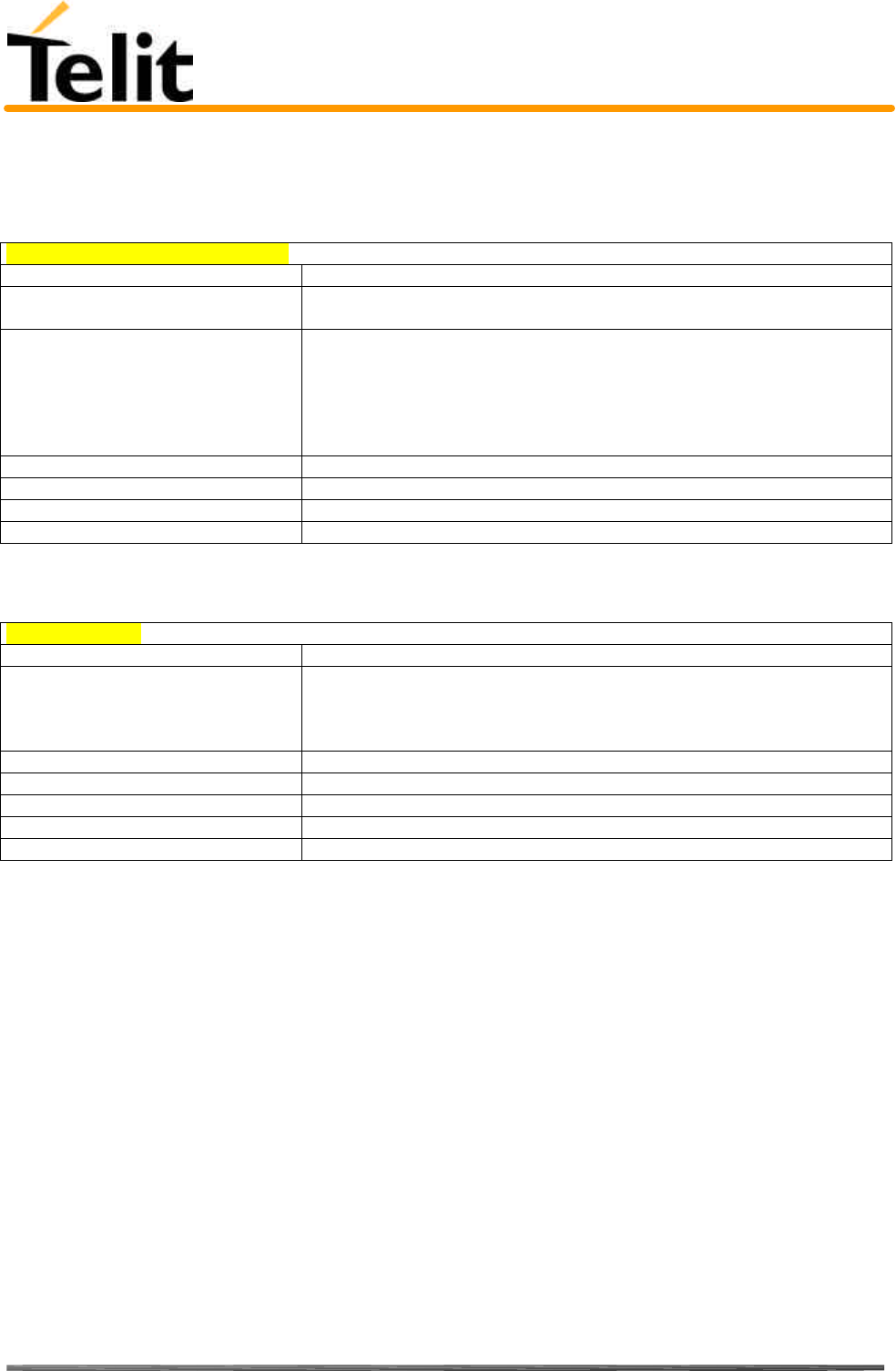
Telit TRIZIUM Product Description
80264ST10007a Rev. 4– 09/09/04
Reproduction forbidden without DAI Telecom written authorization – All Right reserved – Right of modification reserved page 65 of 202
5.3.7 S parameters
5.3.7.1 S0 - number of rings to auto answer
S0 – number of rings to auto answer
Execute command
Read command
ATS0? Returns the current value of S0 parameter.
Write command
ATS0 = <n> Sets the number of rings required before device automatically answers an
incoming call.
Parameter:
<n> = 0-255
<n> = 0 auto answer disabled
Test command
Example
Reference V25ter
SW release Version A
5.3.7.2 S1 - ring counter
S1 – ring counter
Execute command
Read command
ATS1? S1 is incremented each time the device detects the ring signal of an incoming
call. S1is cleared if no ring occur over an eight seconds interval.
This command returns the value of this parameter.
Write command
Test command
Example
Reference
SW release Version A
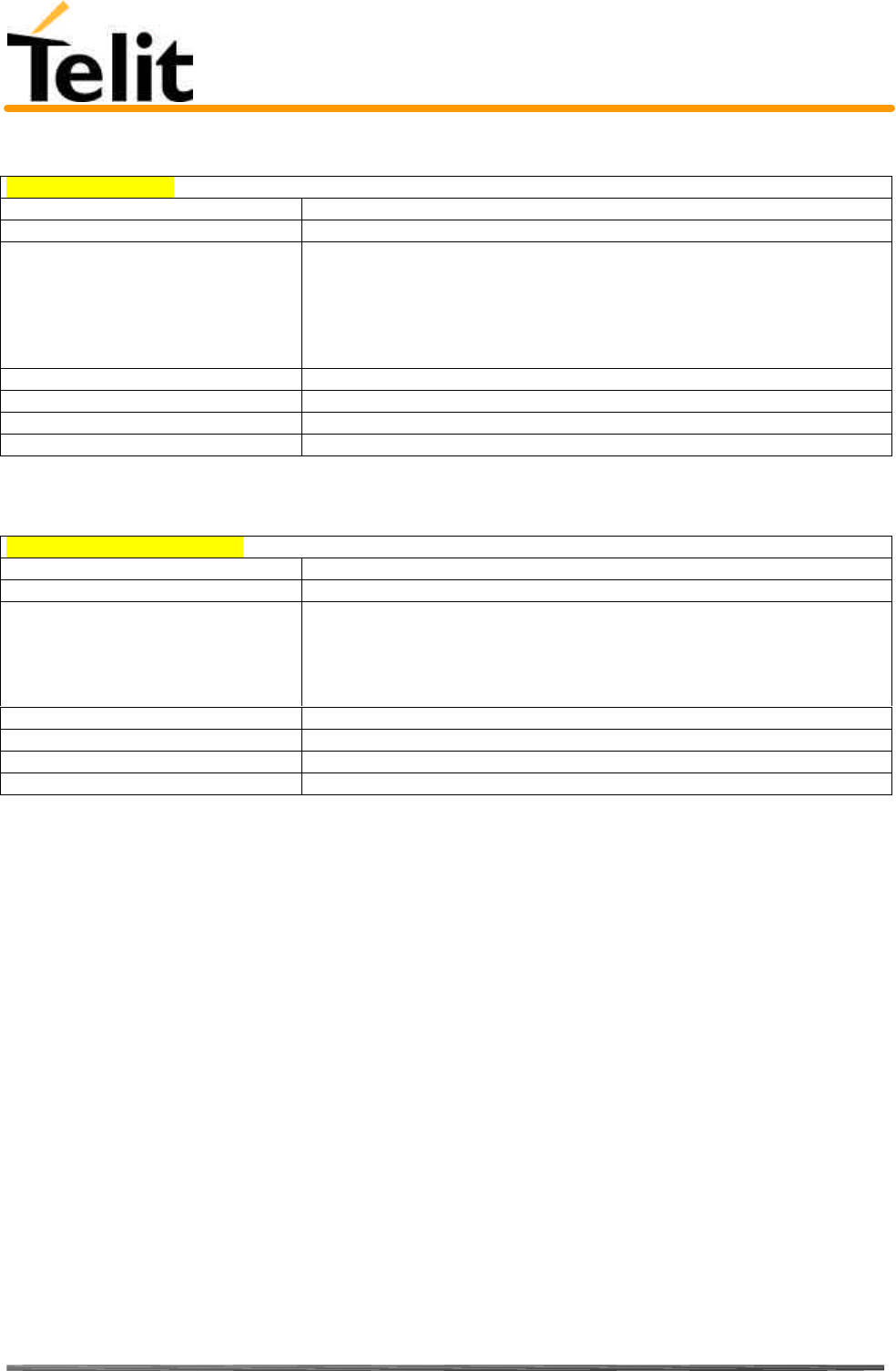
Telit TRIZIUM Product Description
80264ST10007a Rev. 4– 09/09/04
Reproduction forbidden without DAI Telecom written authorization – All Right reserved – Right of modification reserved page 66 of 202
5.3.7.3 S2 - escape character
S2 – escape character
Execute command
Read command
Write command
ATS2 = <char> S2 holds the decimal value of the ASCII character used as escape character.
This command sets this character equal to <char>.
Parameter: <char> - escape character 0-255
Note: The escape sequence consists of three escape characters preceded by n
ms of idle and followed by m ms of idle.
Test command
Example
Reference
SW release Version A
5.3.7.4 S3 - carriage return character
S3 – carriage return character
Execute command
Read command
Write command
ATS3 = <char> Sets the command line and result code terminator character in decimal
ASCII.
Parameter: <char> - carriage return character 0-127
Note: Default 13 (Carriage Return)
Test command
Example
Reference V25ter
SW release Version A
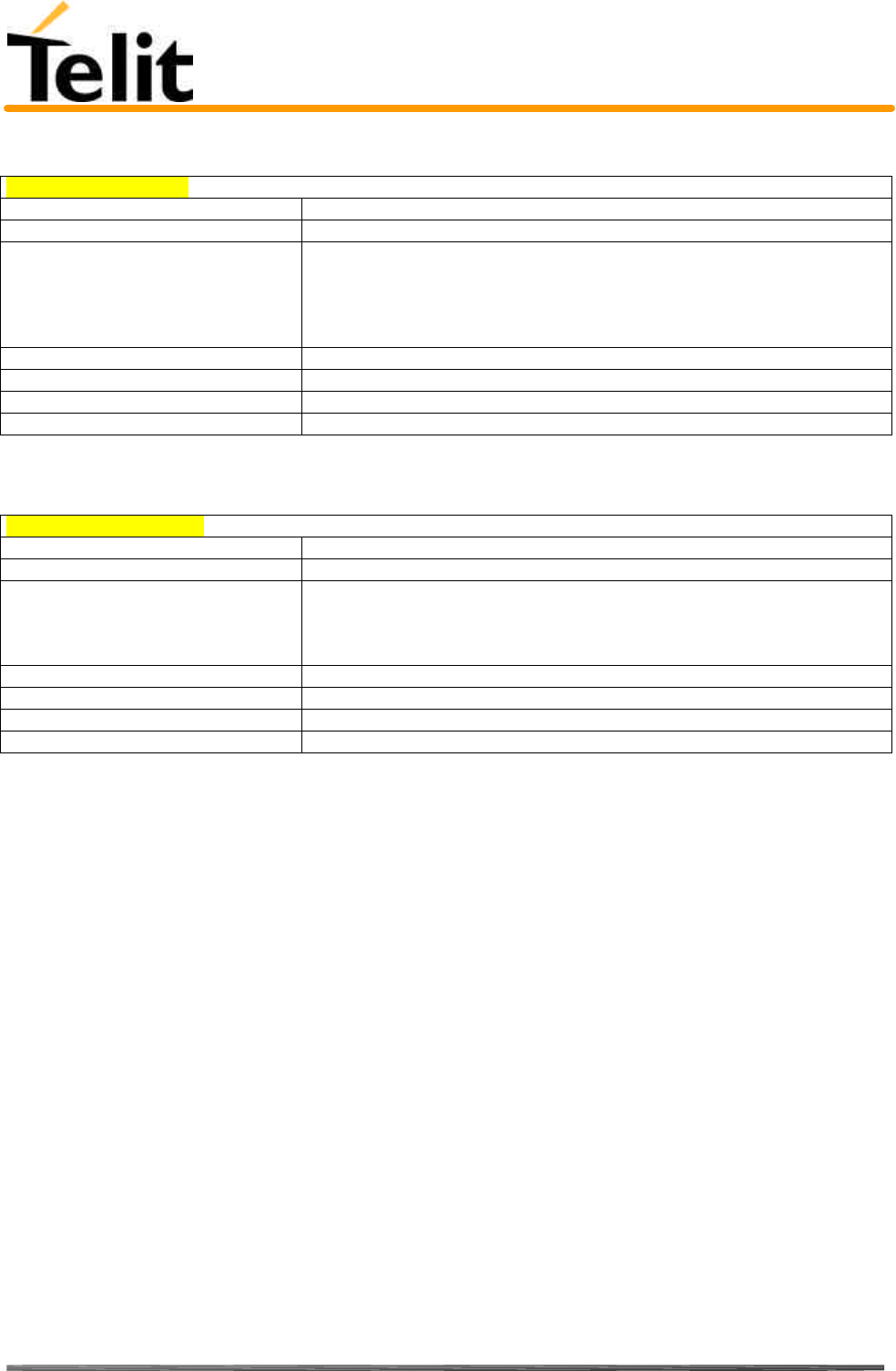
Telit TRIZIUM Product Description
80264ST10007a Rev. 4– 09/09/04
Reproduction forbidden without DAI Telecom written authorization – All Right reserved – Right of modification reserved page 67 of 202
5.3.7.5 S4 - line feed character
S4 – line feed character
Execute command
Read command
Write command
ATS4 = <char> Sets the character recognized as line feed character.
Parameter: <char> - line feed character 0-127
Note: Default 10 (Line Feed). The line feed character is output after carriage
return character if verbose result codes are used ( V1 option used ).
Test command
Example
Reference V25ter
SW release Version A
5.3.7.6 S5 - backspace character
S5 – backspace character
Execute command
Read command
Write command
ATS5 = <char> Sets the decimal ASCII character that is recognized as backspace character.
Parameter: <char> - backspace character 1-127
Note: Default 8 ( backspace )
Test command
Example
Reference V25ter
SW release Version A
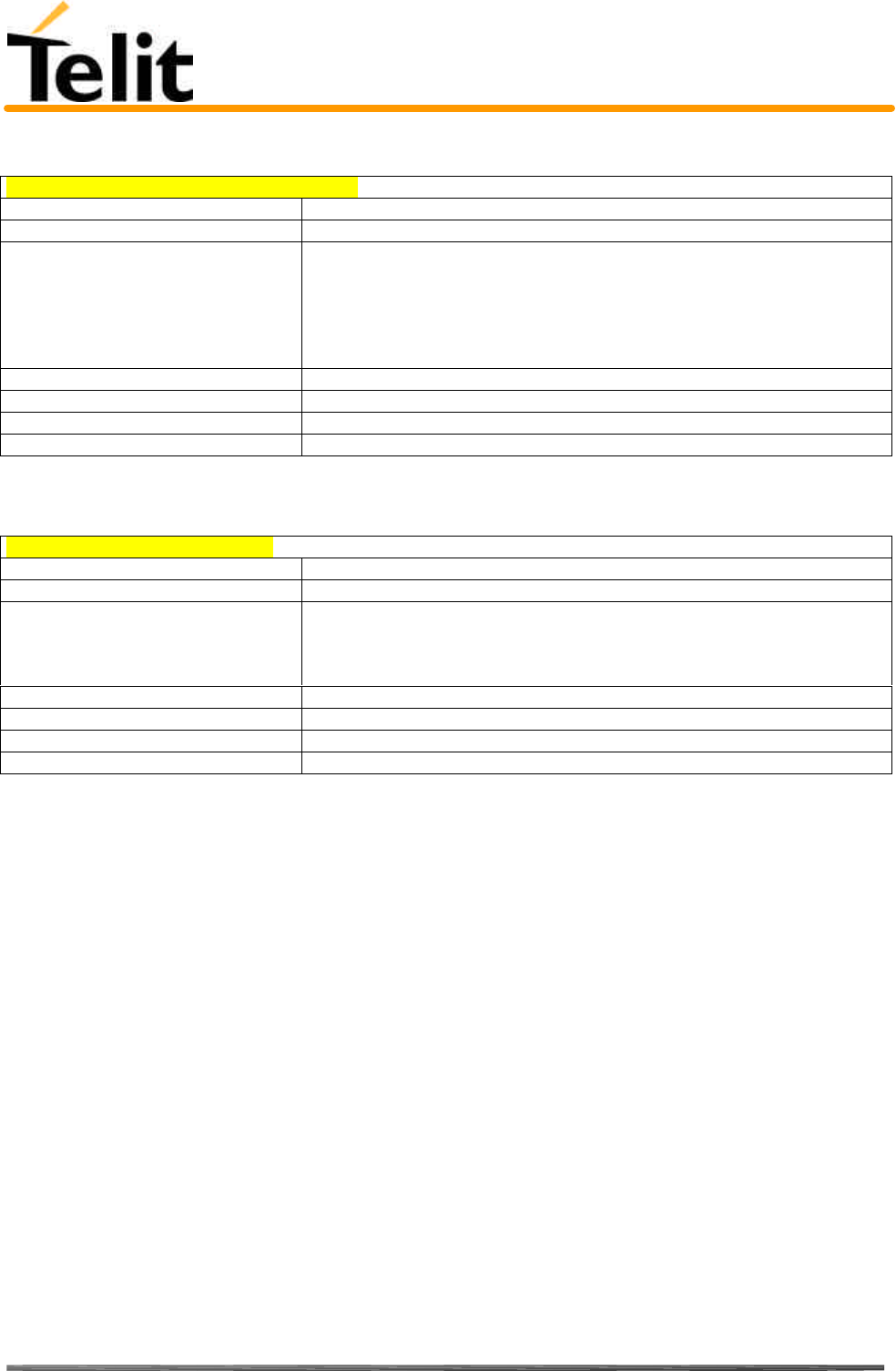
Telit TRIZIUM Product Description
80264ST10007a Rev. 4– 09/09/04
Reproduction forbidden without DAI Telecom written authorization – All Right reserved – Right of modification reserved page 68 of 202
5.3.7.7 S7 - wait time for carrier, silence or dial tone
S7 – wait time for carrier, silence or dial tone
Execute command
Read command
Write command
ATS7 = <sec> S7 sets the length of time in seconds that the device will wait for carrier before
hanging up the call. The timer is started when the device finishes dialing
(originate), or 2 seconds after going off-hook.
Parameter: <sec> - 1-255
Note: Default is 60 seconds
Test command
Example
Reference V25ter
SW release Version A
5.3.7.8 S10 - lost carrier to hang up delay
S10 – lost carrier to hang up delay
Execute command
Read command
Write command
ATS10 = <time> S10 defines the maximum time allowed to a carrier loss before disconnecting.
Parameter: <time> - tenth of seconds 1-255
Note: default is 50 (5 seconds).
Test command
Example
Reference V25ter
SW release Version A
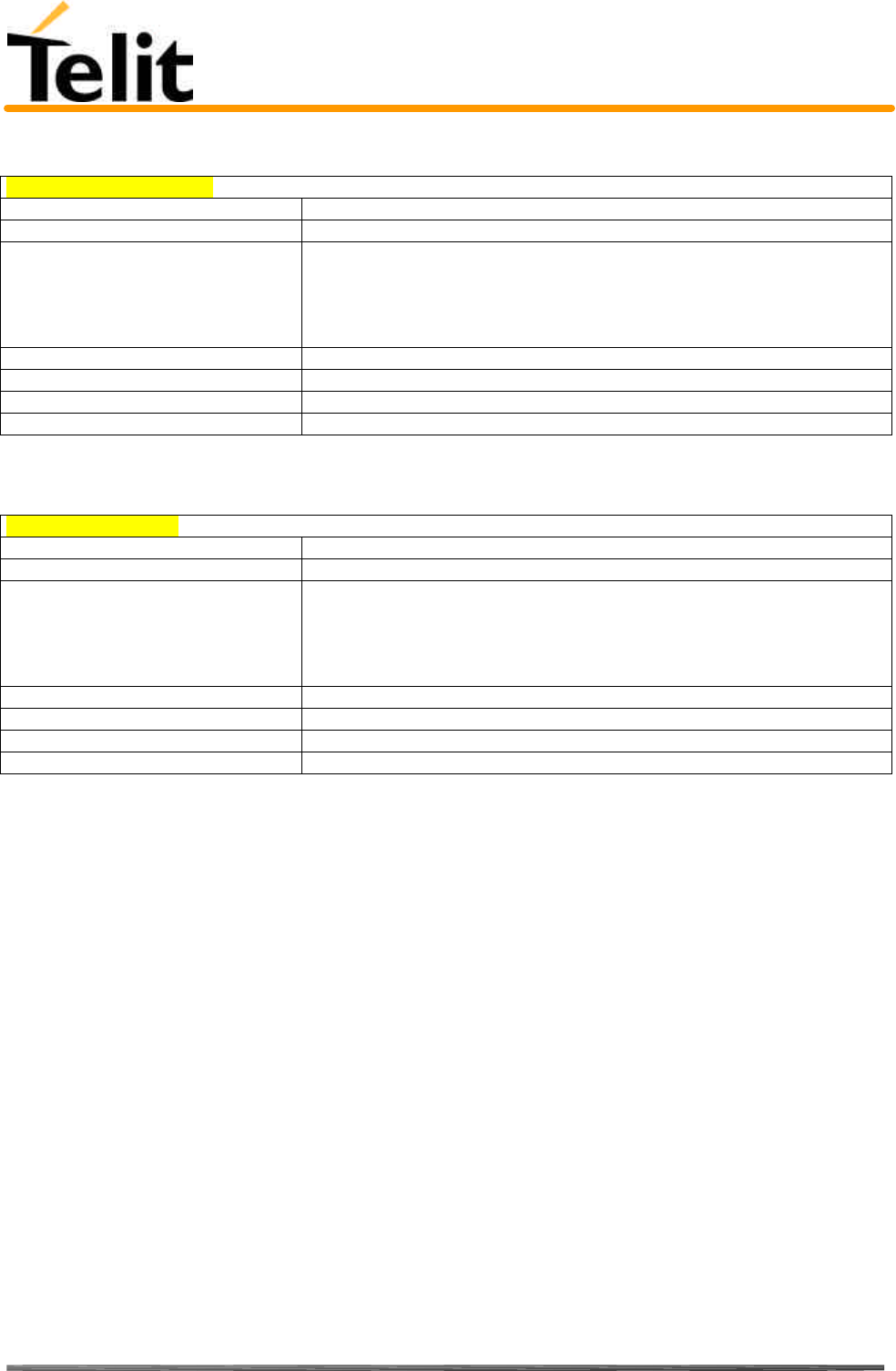
Telit TRIZIUM Product Description
80264ST10007a Rev. 4– 09/09/04
Reproduction forbidden without DAI Telecom written authorization – All Right reserved – Right of modification reserved page 69 of 202
5.3.7.9 S12 - escape prompt delay
S12 – escape prompt delay
Execute command
Read command
Write command
ATS12 = <time> Defines the guard time of silence before and after the escape sequence in order
to accept it as a valid one.
Parameter: <time> - 20-255 fiftieth of seconds
Note: default is 50 (1 second )
Test command
Example
Reference
SW release Version A
5.3.7.10 S25 - delay to DTR off
S25 –delay to DTR off
Execute command
Read command
Write command
ATS25 = <time> Defines how long the DTR must be off to consider the high to low transition
as a valid one.
Parameter: <time> - 1-255 hundredth of seconds
Note: default is 5 ( 5 hundredth of second)
Test command
Example
Reference
SW release Version A
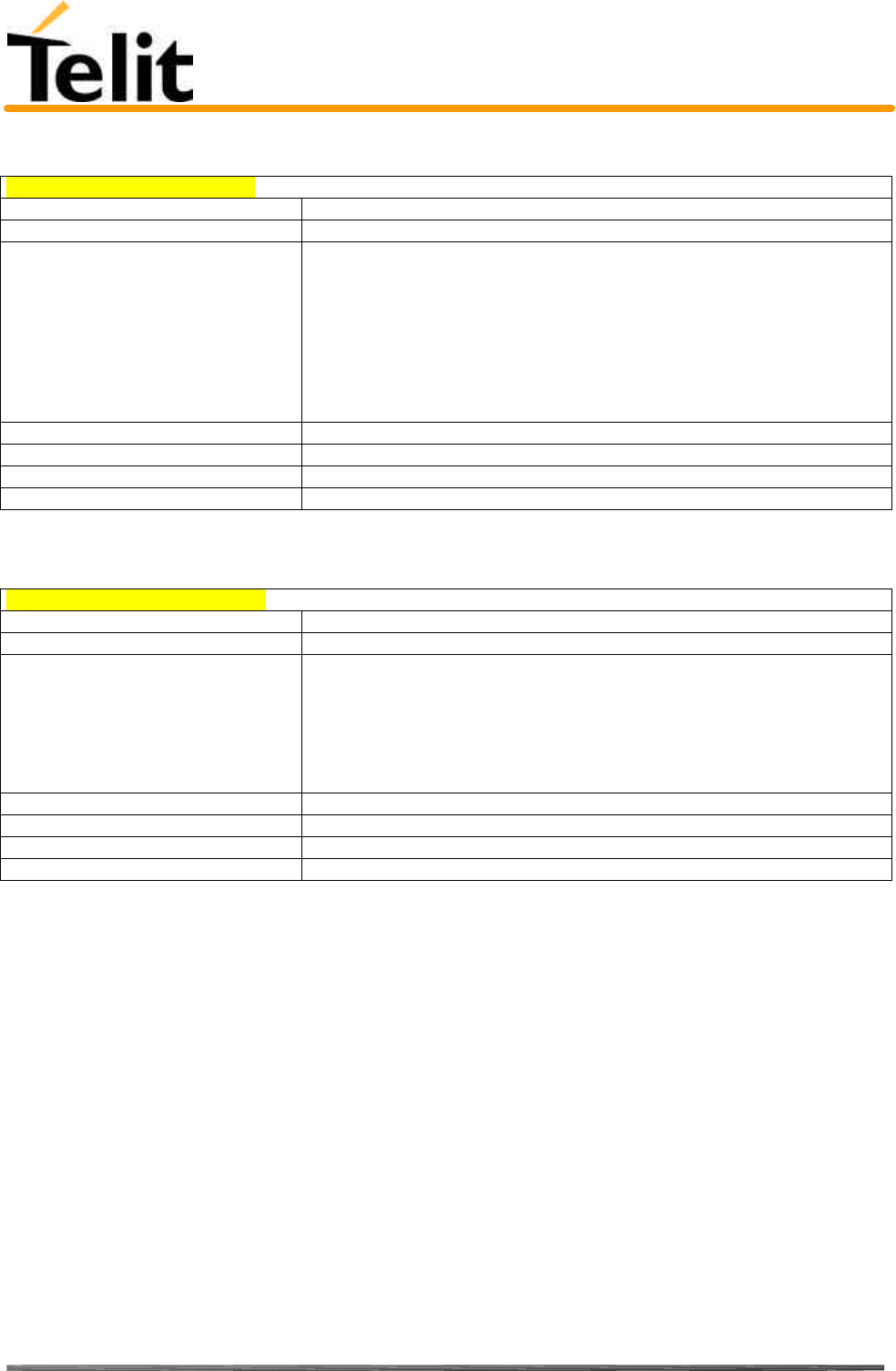
Telit TRIZIUM Product Description
80264ST10007a Rev. 4– 09/09/04
Reproduction forbidden without DAI Telecom written authorization – All Right reserved – Right of modification reserved page 70 of 202
5.3.7.11 S30 - disconnect inactivity timer
S30 –disconnect inactivity timer
Execute command
Read command
Write command
ATS30 = <min> Defines the inactivity timeout timer value in minutes. The Device disconnects
if no characters are exchanged for a time period of at least S30 minutes.
Parameter:
<min> - 0-127 minutes
<min> = 0 - means inactivity timer disabled, hence no disconnect on
inactivity feature is enabled.
Note: Default is 0
Test command
Example
Reference
SW release Version A
5.3.7.12 S38 - delay before forced hang up
S38 –delay before forced hang up
Execute command
Read command
Write command
ATS38 = <sec> Defines the time in seconds that the device waits after a hang up command for
transmit buffer to be emptied. 255 value means that disconnecting is done only
after complete buffer upload.
Parameter: <sec> - 0-255 s
Note: Default is 20 s
Test command
Example
Reference
SW release Version A
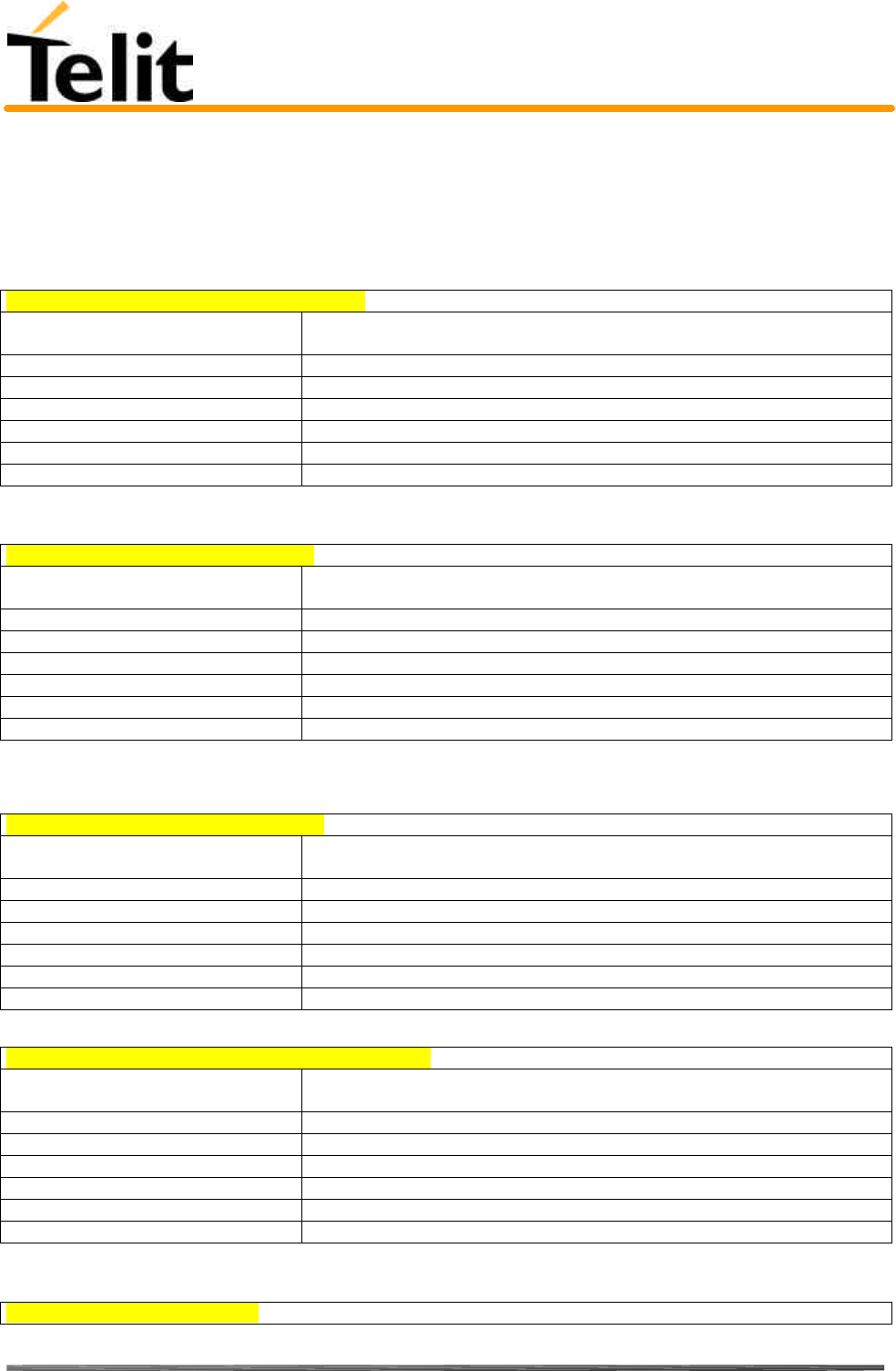
Telit TRIZIUM Product Description
80264ST10007a Rev. 4– 09/09/04
Reproduction forbidden without DAI Telecom written authorization – All Right reserved – Right of modification reserved page 71 of 202
5.4 ETSI GSM 07.07 AT Commands
5.4.1 General
5.4.1.1 +CGMI - request manufacturer identification
+CGMI – request manufacturer identification
Execute command
AT+CGMI Returns the device manufacturer identification code.
Read command
Write command
Test command
Example
Reference GSM 07.07
SW release Version A
5.4.1.2 +CGMM - request model identification
+CGMM – request model identification
Execute command
AT+CGMM Returns the device model identification code.
Read command
Write command
Test command
Example
Reference GSM 07.07
SW release Version A
5.4.1.3 +CGMR - request revision identification
+CGMR – request revision identification
Execute command
AT+CGMR Returns device software revision number.
Read command
Write command
Test command
Example
Reference GSM 07.07
SW release Version A
5.4.1.4 +CGSN - request product serial number identification
+CGSN – request product serial number identification
Execute command
AT+CGSN Returns the product serial number, identified as the IMEI of the mobile.
Read command
Write command
Test command
Example
Reference GSM 07.07
SW release Version A
5.4.1.5 +CSCS - select TE character set
+CSCS – select TE character set

Telit TRIZIUM Product Description
80264ST10007a Rev. 4– 09/09/04
Reproduction forbidden without DAI Telecom written authorization – All Right reserved – Right of modification reserved page 72 of 202
Execute command
Read command
AT+CSCS? Returns the current value of the active character set.
Write command
AT+CSCS <chset> Sets the current character set used by the device.
Parameter: <chset> = "IRA" - char set
Note: The only character set supported yet is the
ITU–T.50 ( IRA)
Test command
AT+CSCS=? Returns the supported values of the parameter chset. Yet only IRA is
supported.
Example
Reference GSM 07.07
SW release Version A
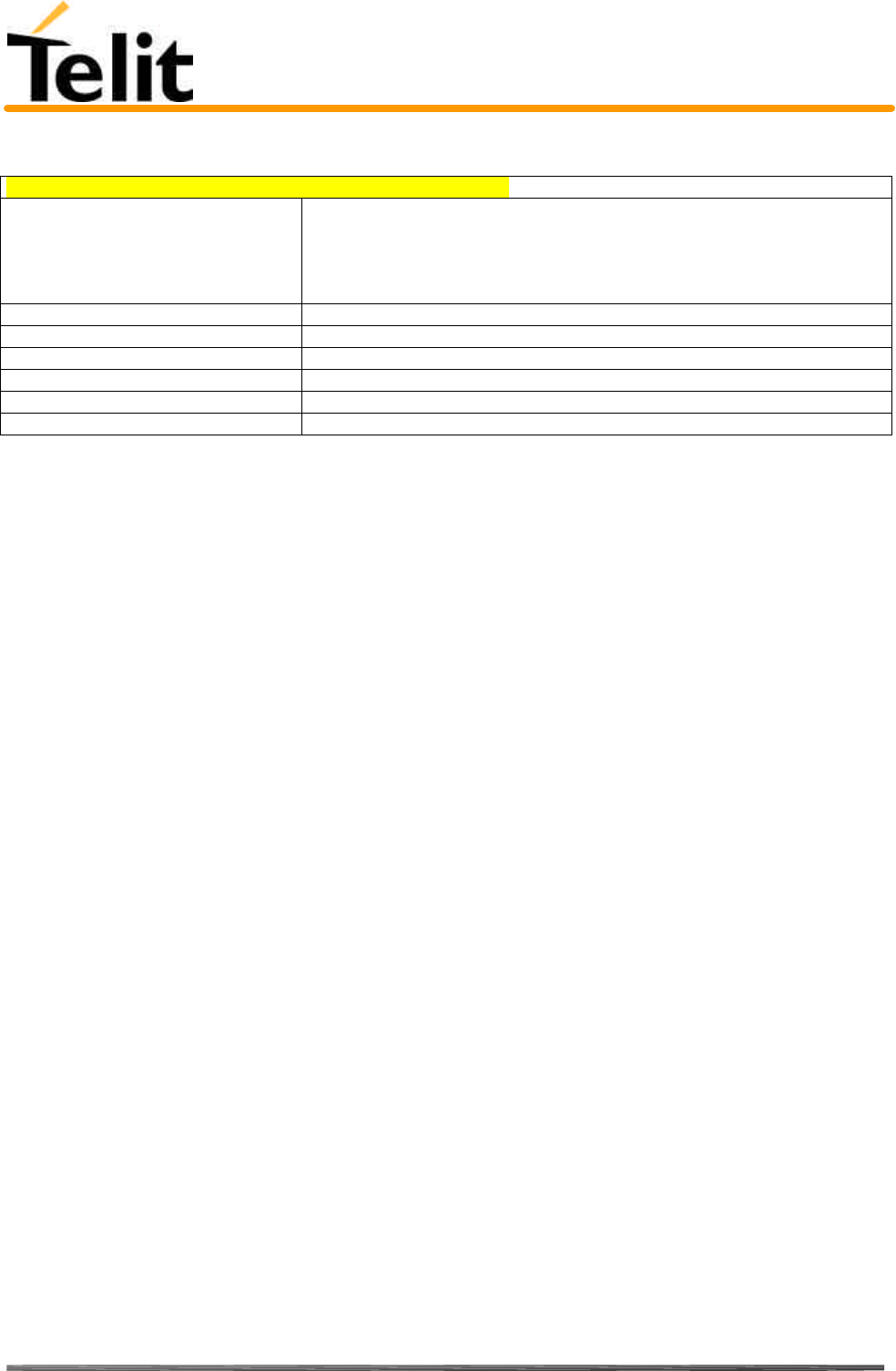
Telit TRIZIUM Product Description
80264ST10007a Rev. 4– 09/09/04
Reproduction forbidden without DAI Telecom written authorization – All Right reserved – Right of modification reserved page 73 of 202
5.4.1.6 +CIMI - request international mobile subscriber identity (IMSI)
+CIMI – request international mobile subscriber identify (IMSI)
Execute command
AT+CIMI Returns the value of the Internal Mobile Subscriber Identity stored in the
SIM.
Note: A SIM card must be present in the SIM card housing, else the command
returns ERROR.
Read command
Write command
Test command
Example
Reference GSM 07.07
SW release Version A
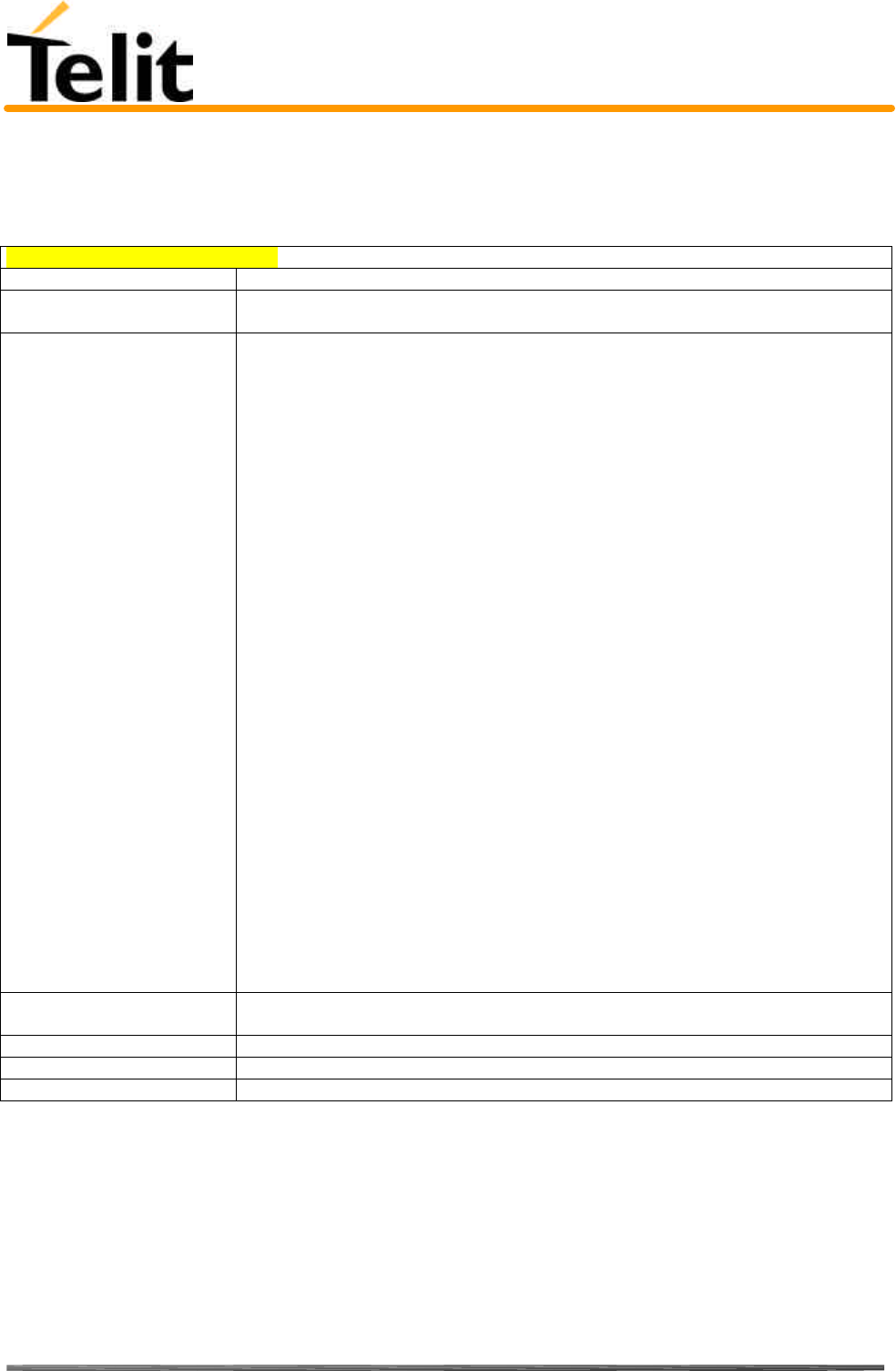
Telit TRIZIUM Product Description
80264ST10007a Rev. 4– 09/09/04
Reproduction forbidden without DAI Telecom written authorization – All Right reserved – Right of modification reserved page 74 of 202
5.4.2 Call control
5.4.2.1 +CBST - select bearer service type
+CBST – select bearer service type
Execute command
Read command
AT+CBST? Returns current value of the parameters <speed>,<name> and <ce>
Write command
AT+CBST = <speed>,
<name>, <ce> Selects the bearer service <name> with data rate <speed>, and the connection element
<ce> to be used when data calls are originated. Values may also be used during mobile
terminated data call setup, especially in case of single numbering scheme calls (refer
+CSNS).
Parameters:
The default values of the subparameters are manufacturer specific since they depend on
the purpose of the device and data services provided by it. Not all combinations of these
subparameters are supported. The supported values are:
<speed>
0 – autobauding (automatic selection of the speed)
1 - 300 bps (V.21)
2 - 1200 bps (V.22)
3 - 1200/75 bps (V.23)
4 - 2400 bps (V.22bis)
6 - 4800 bps (V.32)
7 - 9600 bps (V.32)
14 - 14400 bps (V.34)
65 - 300 bps (V.110)
66 - 1200 bps (V.110)
68 - 2400 bps (V.110 or X.31 flag stuffing)
70 - 4800 bps (V.110 or X.31 flag stuffing)
71 - 9600 bps (V.110 or X.31 flag stuffing)
75 - 14400 bps (V110 or X.31 flag stuffing)
<name>
0 - data circuit asynchronous
<ce>
0 – transparent
1 - non transparent
Default is +CBST = 7,0,1
Test command
AT+CBST=? Returns the supported range of values of the parameters.
Example
Reference GSM 07.07
SW release Version A
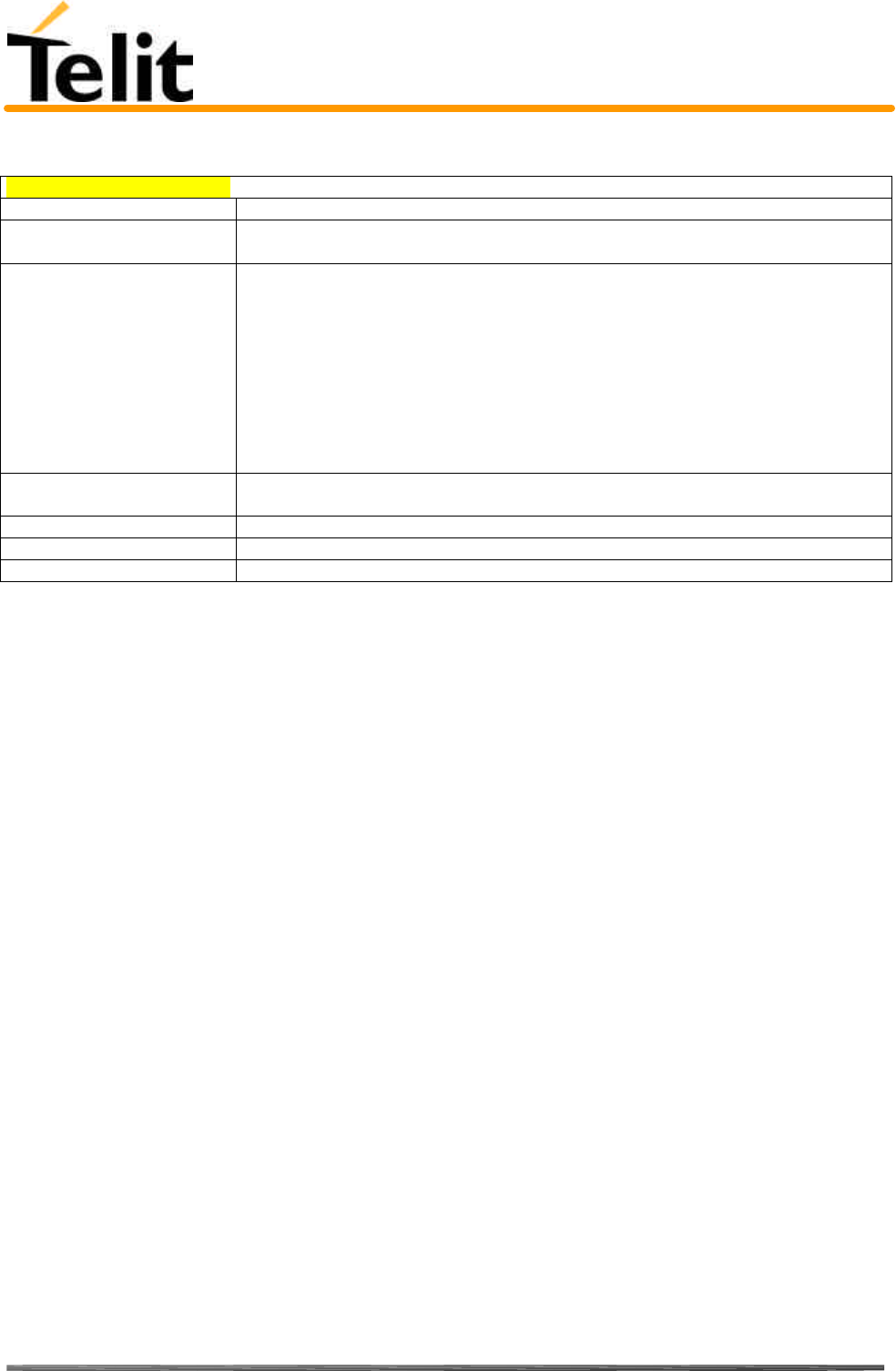
Telit TRIZIUM Product Description
80264ST10007a Rev. 4– 09/09/04
Reproduction forbidden without DAI Telecom written authorization – All Right reserved – Right of modification reserved page 75 of 202
5.4.2.2 +CRLP - radio link protocol
+CRLP – radio link protocol
Execute command
Read command
AT+CRLP? Returns the current value of the RLP protocol parameters.
Write command
AT+CRLP = <iws>, <mws>,
<T1>, <N2>, <ver> Radio link protocol (RLP) parameters used when non-transparent data calls are
originated may be altered with this command.
Parameters:
<iws> = 1...61 - IWF window Dimension
<mws> = 1...61 - MS window Dimension
<T1> = 39…255 – acknowledge timer (10 ms units).
<N2> = 1…255 – retransmission attempts
<ver> = 0 - protocol Version
The default values are: 61,61,78,6,0
Test command
AT+CRLP=? Returns supported range of values of the RLP protocol parameters.
Example
Reference GSM 07.07
SW release Version A
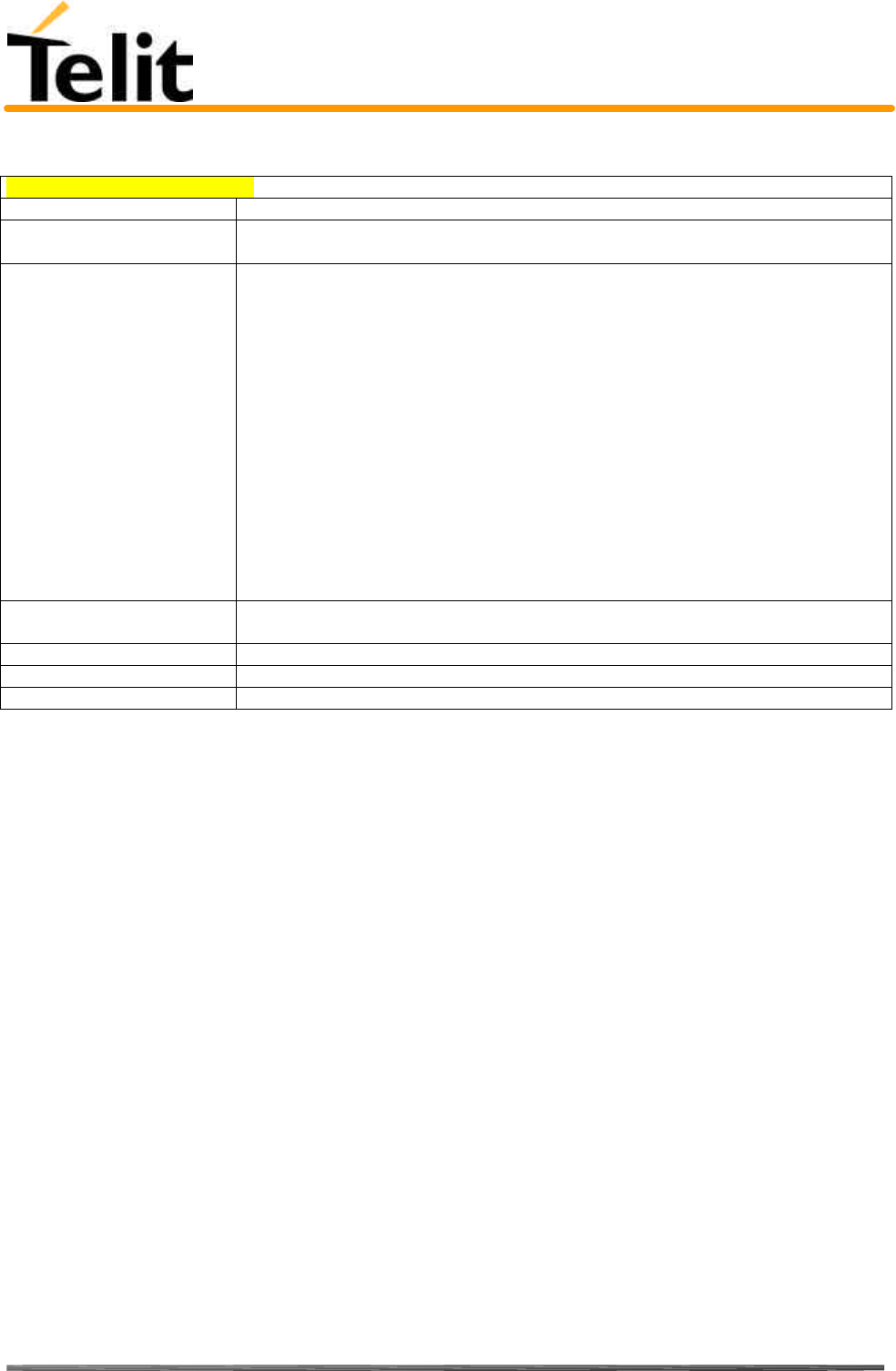
Telit TRIZIUM Product Description
80264ST10007a Rev. 4– 09/09/04
Reproduction forbidden without DAI Telecom written authorization – All Right reserved – Right of modification reserved page 76 of 202
5.4.2.3 +CR - service reporting control
+CR – service reporting control
Execute command
Read command
AT+CR? Returns current intermediate report setting
Write command
AT+CR = <mode> Controls whether or not intermediate result code +CR: <serv> is returned from the TA
to the TE. If enabled, the intermediate result code is transmitted at the point during
connect negotiation at which the TA has determined which speed and quality of service
will be used, before any error control or data compression reports are transmitted, and
before the intermediate result code CONNECT is transmitted.
Parameter: <mode>
<mode> = 0 - disables intermediate result code report
<mode> = 1 - enables intermediate result code report
This command replaces V.25ter [14] command Modulation Reporting Control +MR,
which is not appropriate for use with a GSM terminal.
The result code parameter <serv> has the meaning:
ASYNC - asynchronous transparent
SYNC - synchronous transparent
REL ASYNC - asynchronous non-transparent
REL SYNC - synchronous non-transparent.
Test command
AT+CR=? Returns the supported range of values of the parameter <mode>.
Example
Reference GSM 07.07
SW release Version A
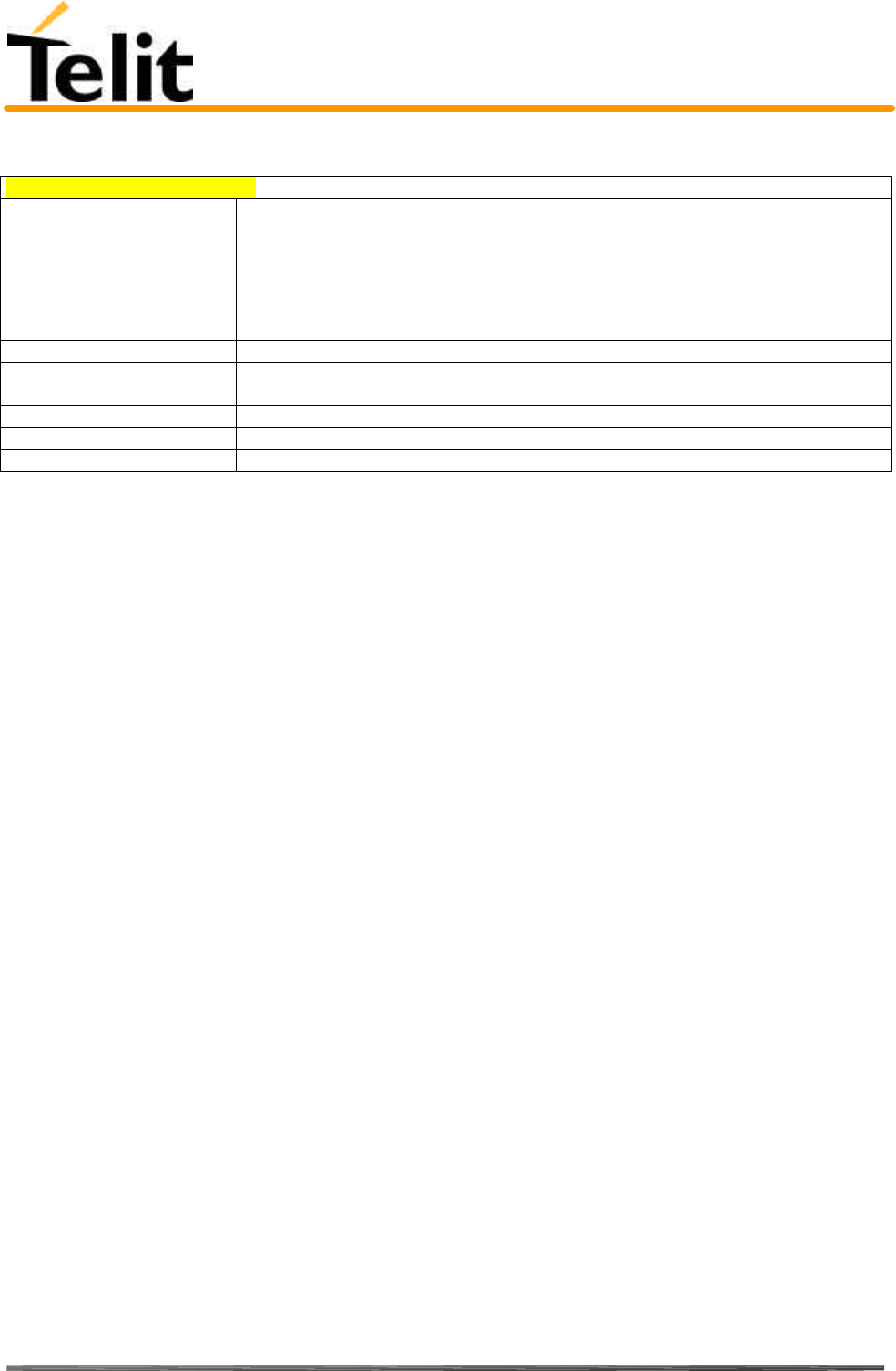
Telit TRIZIUM Product Description
80264ST10007a Rev. 4– 09/09/04
Reproduction forbidden without DAI Telecom written authorization – All Right reserved – Right of modification reserved page 77 of 202
5.4.2.4 +CEER - extended error report
+CEER – extended error report
Execute command
AT+CEER Reports a information text regarding some error condition that may occur:
- the failure in the last unsuccessful call setup (originating or answering)
- the last call release
- the last unsuccessful GPRS attach or unsuccessful PDP context activation,
- the last GPRS detach or PDP context deactivation.
Note: if none of this condition has occurred since power up then No Error condition is
reported
Read command
Write command
Test command
Example
Reference GSM 07.07
SW release Version A
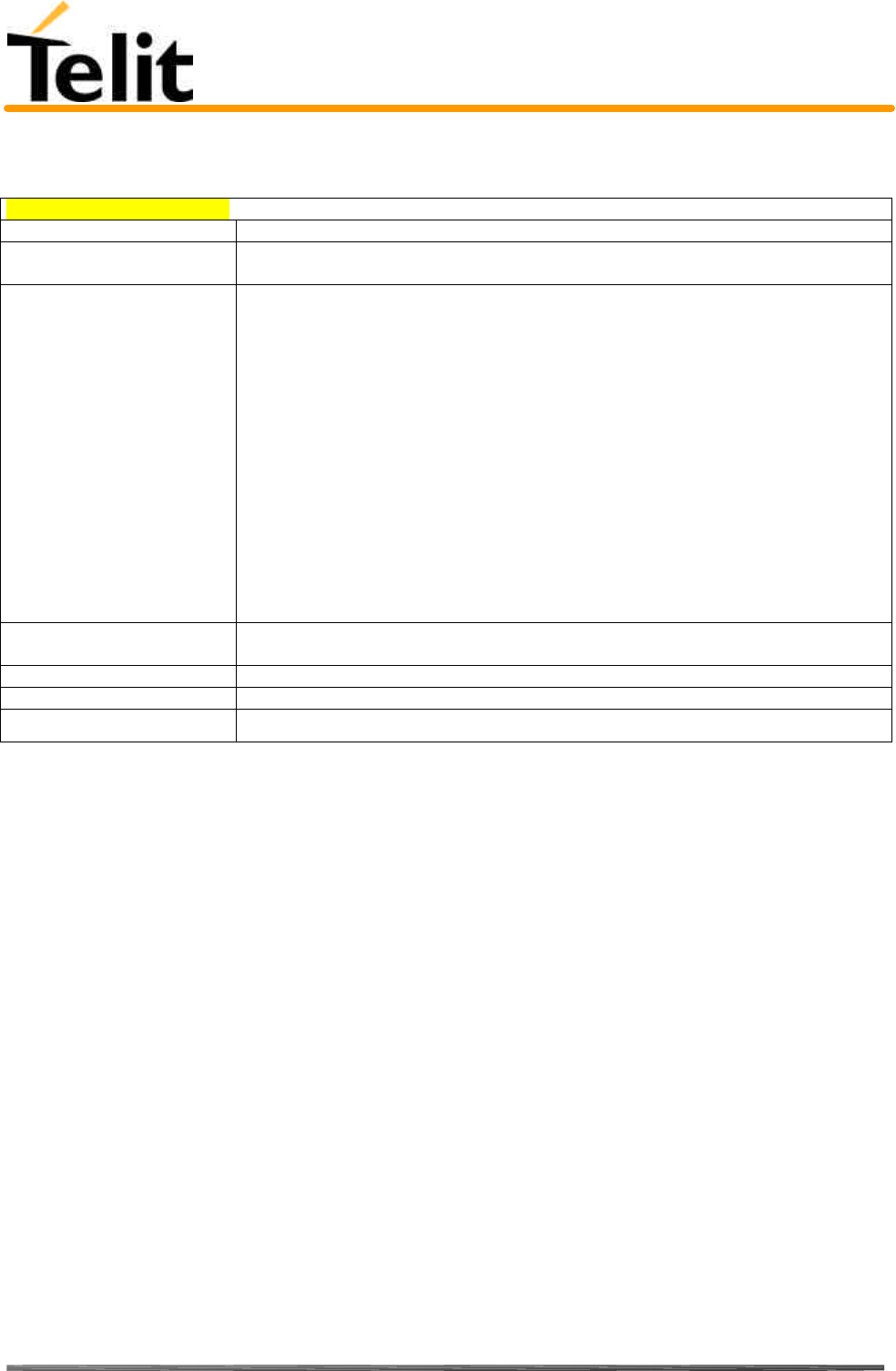
Telit TRIZIUM Product Description
80264ST10007a Rev. 4– 09/09/04
Reproduction forbidden without DAI Telecom written authorization – All Right reserved – Right of modification reserved page 78 of 202
5.4.2.5 +CRC - cellular result codes
+CRC – cellular result codes
Execute command
Read command
AT+CRC? Returns current value of the parameter <mode>.
Write command
AT+CRC = <mode> Controls whether or not the extended format of incoming call indication is used. When
enabled, an incoming call is indicated to the TE with unsolicited result code
+CRING:<type> instead of the normal RING.
Parameter:
<mode> = 0 - disables extended format reporting
<mode> = 1 - enables extended format reporting
Note: On +CRING indication <type> parameter is the call type:
<type> - call type:
ASYNC asynchronous transparent data
SYNC - synchronous transparent data
REL ASYNC - asynchronous non-transparent data
REL SYNC - synchronous non-transparent data
FAX - facsimile (TS 62)
VOICE - normal voice (TS 11)
Test command
AT+CRC=? Returns supported values of the parameter <mode>.
Example
Reference GSM 07.07
SW release Version A
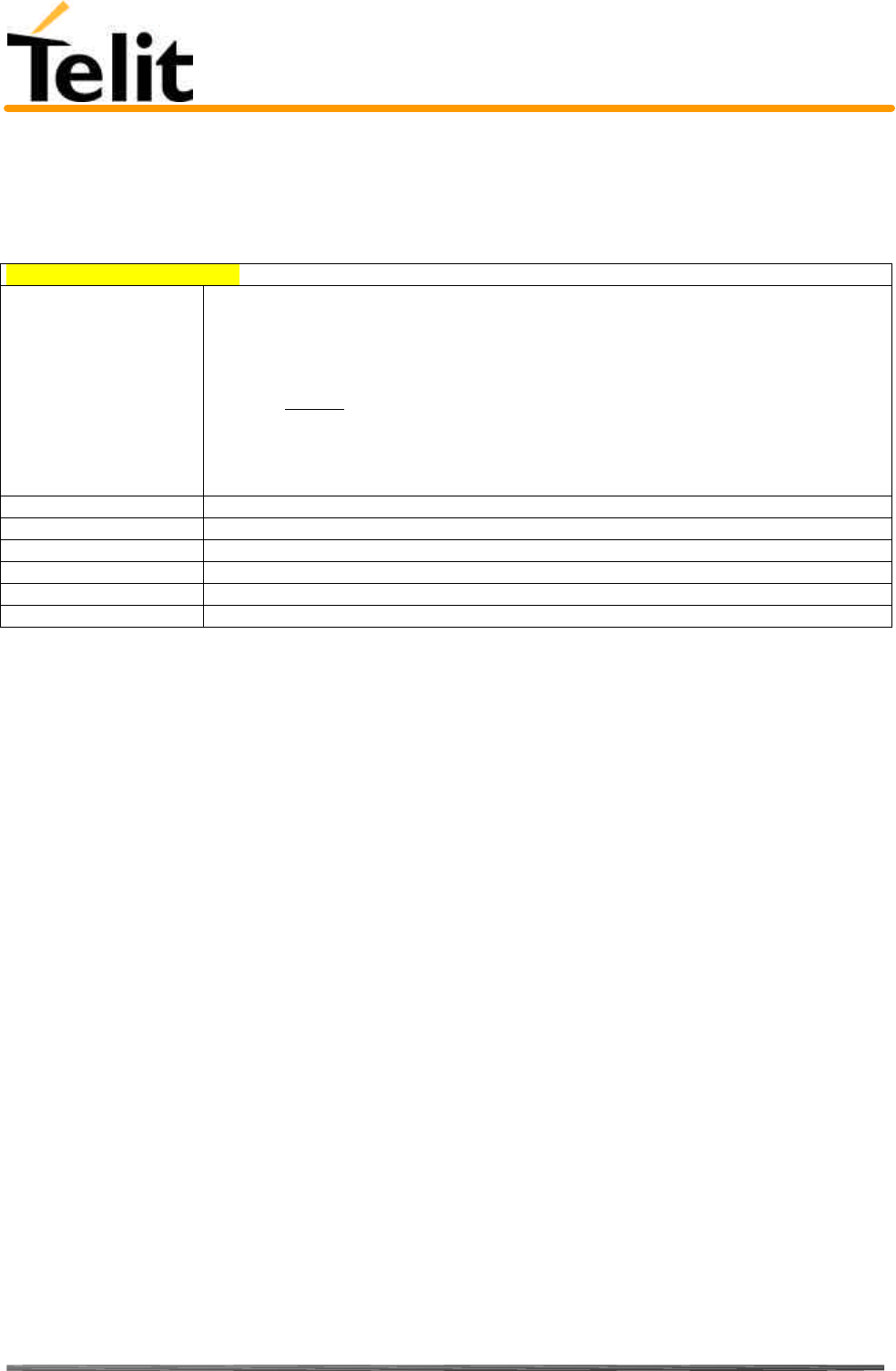
Telit TRIZIUM Product Description
80264ST10007a Rev. 4– 09/09/04
Reproduction forbidden without DAI Telecom written authorization – All Right reserved – Right of modification reserved page 79 of 202
5.4.3 Network service handling
5.4.3.1 +CNUM - subscriber number
+CNUM – subscriber number
Execute command
AT+CNUM Returns the subscriber number i.e. the phone number of the device that is stored in the SIM
card.
Note: the returned number format is:
+CNUM: [<alpha>] , <number> , <type>
<alpha> - optional alphanumeric string associated to <number>
<number> - string containing the phone number in the format <type>
<type> - type of number:
<type> = 145 - international numbering scheme (contains the character "+")
<type> = 129 - national numbering scheme
Read command
Write command
Test command
Example
Reference GSM 07.07
SW release Version A

Telit TRIZIUM Product Description
80264ST10007a Rev. 4– 09/09/04
Reproduction forbidden without DAI Telecom written authorization – All Right reserved – Right of modification reserved page 80 of 202
5.4.3.2 +CREG - network registration report
+CREG – network registration report
Execute command
Read command
Write command
AT+CREG = <mode> Enables/disables network registration reports depending on the parameter mode.
Parameter:
<mode>
0 – disable network registration unsolicited result code
1 - enable network registration unsolicited result code
2 - enable network registration unsolicited result code with network
Cell identification data
If mode=1, network registration result code reports:
+CREG: <stat>
<stat> = 0 - not registered, ME is not currently searching a new operator to register
to
<stat> = 1 – registered, home network
<stat> = 2 - not registered, but ME is currently searching a new operator to register to
<stat> = 3 - registration denied
<stat> = 4 -unknown
<stat> = 5 - registered, roaming
If mode=2, network registration result code reports:
+CREG: <stat>[,<Lac>,<Ci>]
where:
<Lac> is the Local Area Code for the currently registered on cell
<Ci> is the Cell Id for the currently registered on cell
Note: <Lac> and <Ci> are reported only if mode=2 and the mobile is registered on
some network cell.
Test command
AT+CREG? Reports the <mode> and <stat> parameter values in the format:
+CREG: <mode>,<stat>[,<Lac>,<Ci>]
Note: <Lac> and <Ci> are reported only if mode=2 and the mobile is registered on
some network cell.
Example AT
OK
at+creg?
+CREG: 0,2 (the TRIZIUM is in network searching state)
OK
at+creg?
+CREG: 0,2
OK
at+creg?
+CREG: 0,2
OK

Telit TRIZIUM Product Description
80264ST10007a Rev. 4– 09/09/04
Reproduction forbidden without DAI Telecom written authorization – All Right reserved – Right of modification reserved page 81 of 202
+CREG – network registration report
at+creg?
+CREG: 0,2
OK
at+creg?
+CREG: 0,1 (the TRIZIUM is registered )
OK
at+creg?
+CREG: 0,1
OK
Reference GSM 07.07
SW release Version A
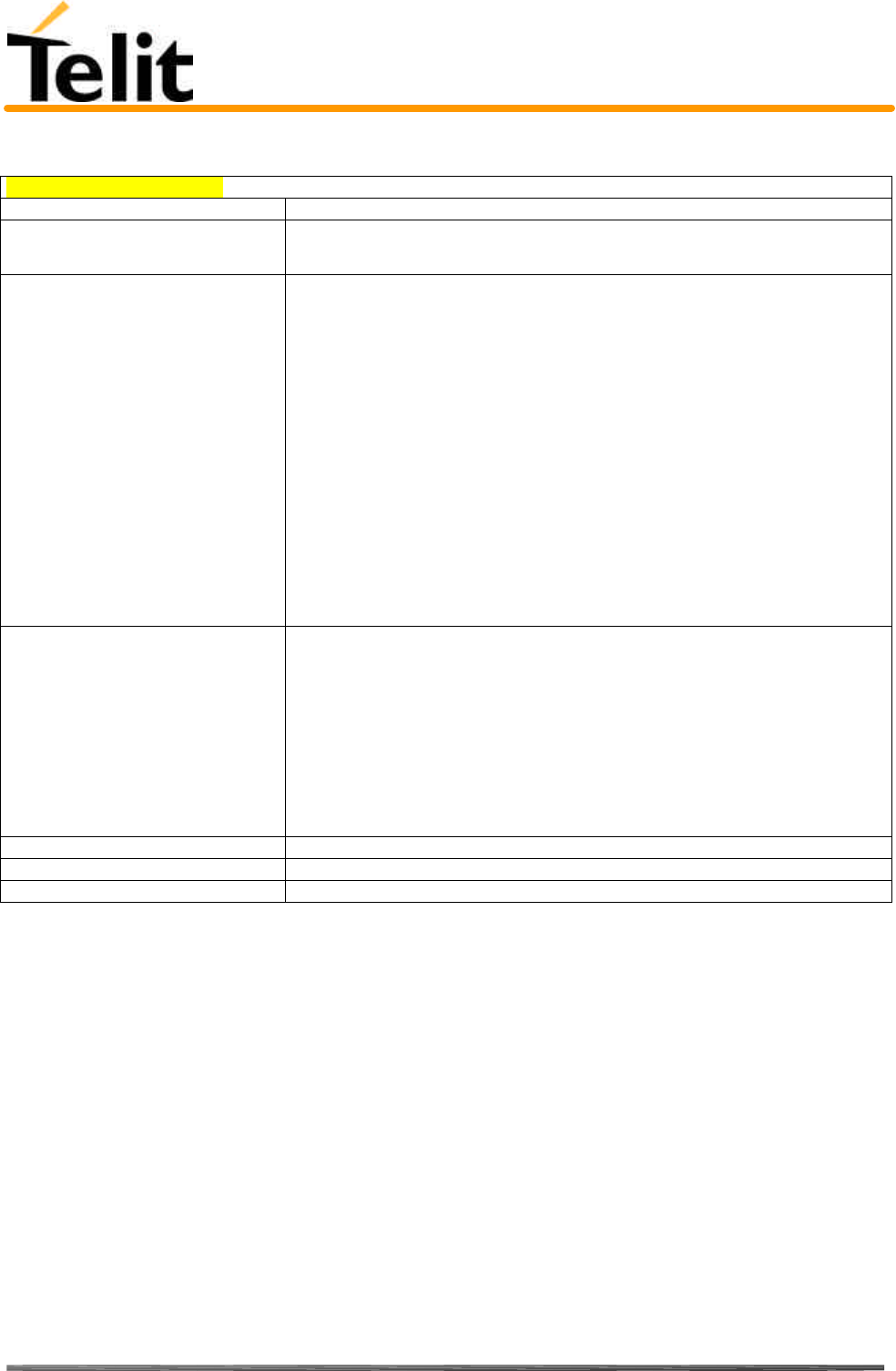
Telit TRIZIUM Product Description
80264ST10007a Rev. 4– 09/09/04
Reproduction forbidden without DAI Telecom written authorization – All Right reserved – Right of modification reserved page 82 of 202
5.4.3.3 +COPS - operator selection
+COPS – operator selection
Execute command
Read command
AT+COPS? Returns current value of <mode>,<format> and <oper>
Write command
AT+COPS =
[<mode>[,<format>[,<oper>]]] Forces an attempt to register the GSM network operator, <mode> parameter
defines whether the operator selection is done automatically or it is forced with
<oper> parameter.
Parameters:
<mode> = 0 - automatic choice (the parameter <oper> will be ignored)
<mode> = 1 - manual choice
<mode> = 3 - set only <format> parameter (the parameter <oper> will be
ignored)
<format> = 0 - alphanumeric max length 16 digits
<format> = 1 – alphanumeric short form
<format> = 2 - Numeric 5 digits [country code (3) + network code
(2)]
<oper>: network operator in the <format> parameter defined format.
Note: if manual choice selection operator is not available no other operators will
be chosen for registration.
Test command
AT+COPS=? Returns the list of network operators in the format:
+COPS: ( <stat> ,<oper (in format=0)>,””,<oper (in format=2)> )
where the new parameter stat defines the status of the operator:
<stat> = 0 – unknown
<stat> = 1 – available
<stat> = 2 – current
<stat> = 3 – forbidden
Note: since with this command a network scan is done, this command may
require some seconds before the output is given.
Example
Reference GSM 07.07
SW release Version A
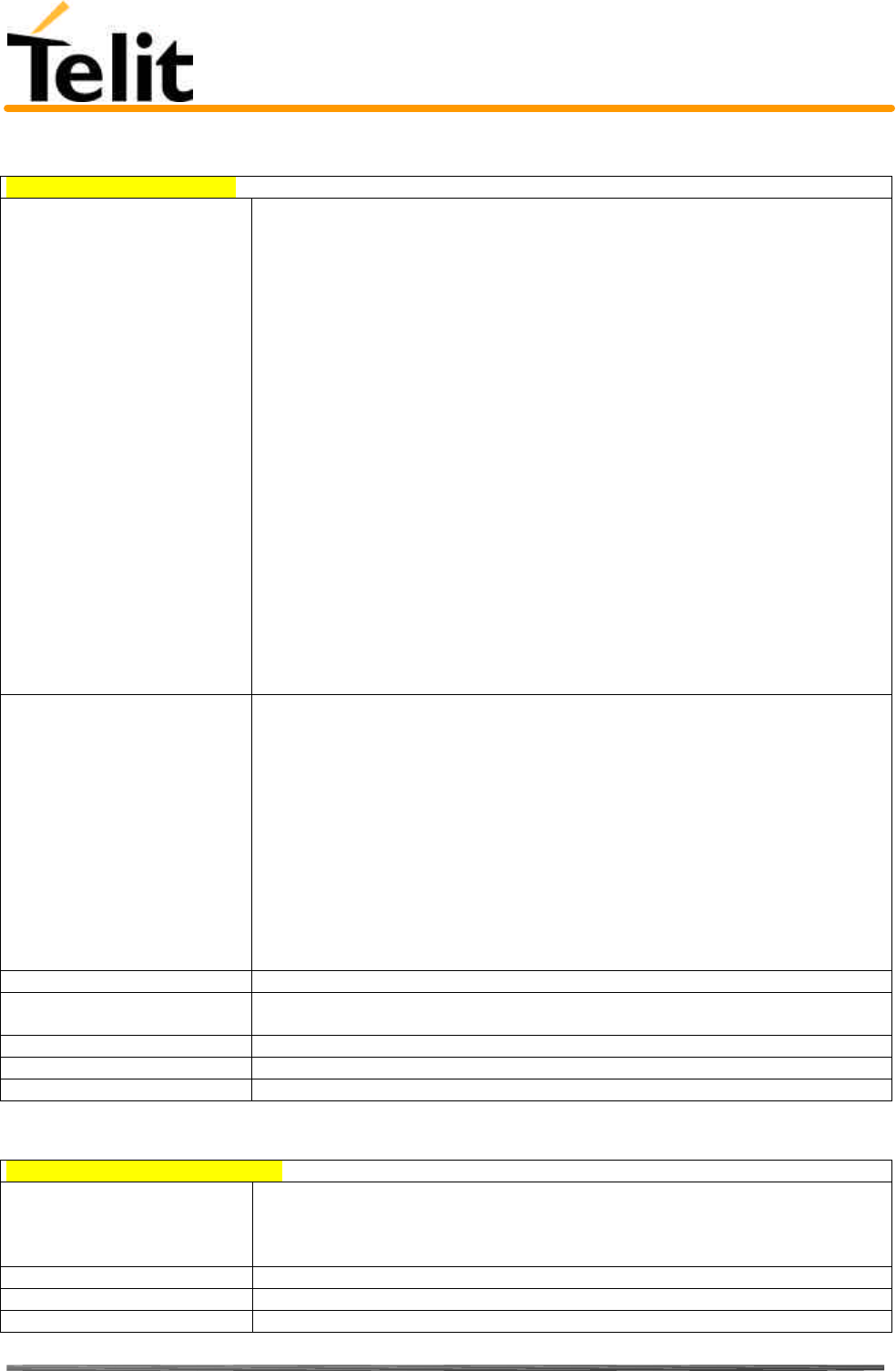
Telit TRIZIUM Product Description
80264ST10007a Rev. 4– 09/09/04
Reproduction forbidden without DAI Telecom written authorization – All Right reserved – Right of modification reserved page 83 of 202
5.4.3.4 +CLCK - facility lock/ unlock
+CLCK – facility lock/unlock
Execute command
AT+CLCK =
<fac>, <mode>[,<passwd>
[,<class>]]
It is used to lock or unlock a ME o a network facility.
Parameters: <fac>:
"SC" - SIM (PIN request) (device asks SIM password at power-up and when this lock
command issued)
"AO"- BAOC (Barr All Outgoing Calls)
"OI" - BOIC (Barr Outgoing International Calls)
"OX"- BOIC-exHC (Barr Outgoing International Calls except to Home Country)
"AI" - BAIC (Barr All Incoming Calls)
"IR" - BIC-Roam (Barr Incoming Calls when Roaming outside the home country)
"AB" - All Barring services (applicable only for <mode>=0)
"AG" - All outGoing barring services (applicable only for <mode>=0)
"AC" - All inComing barring services (applicable only for <mode>=0)
"FD" - SIM fixed dialling memory feature (if PIN2 authentication has not been done
during the current session, PIN2 is required as <passwd>)
"PN" - network Personalisation
"PU" - network subset Personalisation
<mode>: defines the operation to be done on the facility
<mode> = 0 - unlock facility
<mode> = 1 - lock facility
<mode> = 2 - query status ( see below )
<passwd>: shall be the same as password specified for the facility from the DTE user
interface or with command Change Password +CPWD
<class>: represents the class of information of the facility ( sum of bits )
<class> = 1- voice (telephony)
<class> = 2 - data (refers to all bearer services)
<class> = 4 - fax (facsimile services) ()
Read command
AT+CLCK=<fac>,2 query the status of the facility <fac>; returns
+CLCK:<status>
where <status> defines the current status of the
facility:
0 - not active ( locked )
1 - active ( unlocked )
Note: For some facility the status is requested to the network, hence if no network is
available the command returns the ERROR message.
Write command
Test command
AT+CLCK=? Reports all the facility supported by the device.
Example
Reference GSM 07.07
SW release Version A
5.4.3.5 +CPWD - change facility password
+CPWD – change facility password
Execute command
AT+CPWD = <fac>,
<oldpwd>, <newpwd> Changes the password for the facility lock function of the facility fac.
Parameter: <fac>, <oldpwd>, <newpwd>
Note: parameter <oldpwd> is the old password while <newpwd> is the new one.
Read command
Write command
Test command

Telit TRIZIUM Product Description
80264ST10007a Rev. 4– 09/09/04
Reproduction forbidden without DAI Telecom written authorization – All Right reserved – Right of modification reserved page 84 of 202
Example
Reference GSM 07.07
SW release Version A
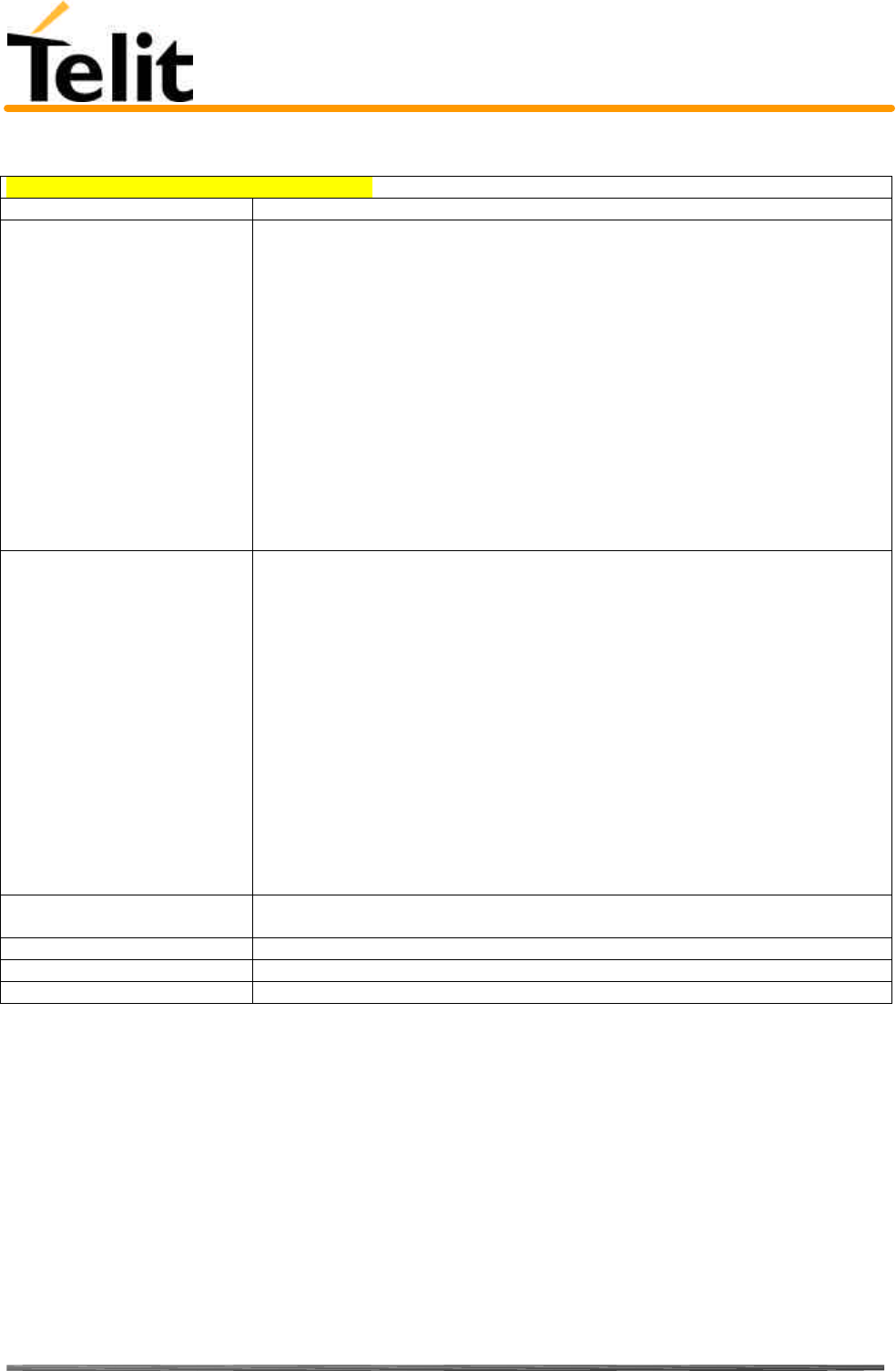
Telit TRIZIUM Product Description
80264ST10007a Rev. 4– 09/09/04
Reproduction forbidden without DAI Telecom written authorization – All Right reserved – Right of modification reserved page 85 of 202
5.4.3.6 +CLIP - calling line identification presentation
+CLIP – calling line identification presentation
Execute command
Read command
AT+CLIP? Returns the status of the supplementary service CLI in the format:
+CLIP: <n>, <m>
where:
<n> = 0 - CLI presentation disabled
<n> = 1 - CLI presentation enabled
<m>: status if the CLIP service on the GSM network
<m> = 0 - CLIP not provisioned
<m> = 1 - CLIP provisioned
<m> = 2 - unknown (e.g. no network is present )
Note: This command issues a status request to the network, hence it
may take a few seconds to give the answer due to the time needed to
exchange data with it.
Write command
AT+CLIP = <n> Enables or disables the calling line identification supplementary service presentation
depending on the value of the parameter <n>.
Parameters: <n>
<n> = 0 - disables CLI indication
<n> = 1 - enables CLI indication
If enabled the device reports after each RING the response:
+CLIP:<number>,<type>
where:
<number>: calling line number
<type> - type of number:
<type> = 145 - international numbering scheme (contains the character "+")
<type> = 129 - national numbering scheme
Note: The command changes only the report behaviour of the device, it does not
change CLI supplementary service setting on the network.
Test command
AT+CLIP=? Returns the supported values of the parameter <n>
Example
Reference GSM 07.07
SW release Version A
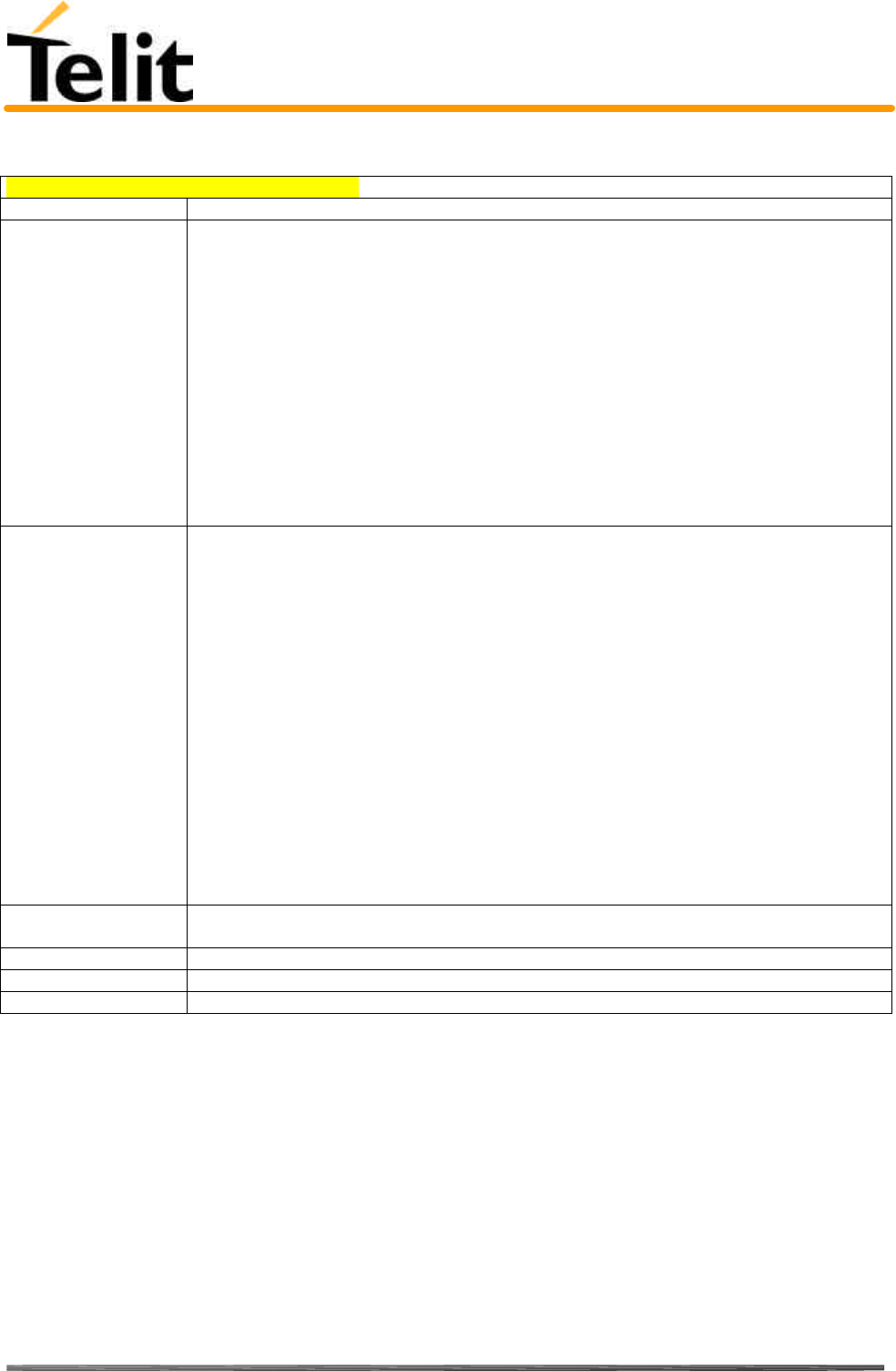
Telit TRIZIUM Product Description
80264ST10007a Rev. 4– 09/09/04
Reproduction forbidden without DAI Telecom written authorization – All Right reserved – Right of modification reserved page 86 of 202
5.4.3.7 +CLIR - calling line identification restriction
+CLIR – calling line identification restriction
Execute command
Read command
AT+CLIR? Reports the network & the device CLIR setting in the format:
+CLIR:<n>,<m>
where
<n> is the facility status on the Mobile
0 – CLIR facility according to CLIR service network status
1 – CLIR facility active (CLI not sent)
2 – CLIR facility not active (CLI sent)
<m> is the facility status on the Network
0 - CLIR service not provisioned
1 - CLIR service provisioned permanently
2 - unknown (e.g. no network present, etc.)
3 - CLI temporary mode presentation restricted
4 - CLI temporary mode presentation allowed
Write command
AT+CLIR = <n>,<m> Refers to CLIR – service that allows a calling subscriber to enable or disable the presentation
of the CLI to the called party when originating a call according to the parameters <n> and
<m> given
Parameters: <n>, <m>
<n> is the facility status on the Mobile
0 – CLIR facility according to CLIR service network status
1 – CLIR facility active (CLI not sent)
2 – CLIR facility not active (CLI sent)
<m> is the facility status on the Network
0 - CLIR service not provisioned
1 - CLIR service provisioned permanently
3 - CLI temporary mode presentation restricted
4 - CLI temporary mode presentation allowed
Note: This command set the default behaviour of the device in outgoing calls and of the
network. The two settings should not be conflicting.
Test command
AT+CLIR=? Reports the supported values of the parameter <n>.
Example
Reference GSM 07.07
SW release Version A

Telit TRIZIUM Product Description
80264ST10007a Rev. 4– 09/09/04
Reproduction forbidden without DAI Telecom written authorization – All Right reserved – Right of modification reserved page 87 of 202
5.4.3.8 +CCFC - call forwarding number and conditions
+CCFC – call forwarding number and condition
Execute command
AT+CCFC =
<reason>,
<cmd>[,<number>[,<type>[,
<class>][,,,<time>]]]
Controls the call forwarding supplementary service. Registration, erasure, activation,
deactivation, and status query are supported.
Parameters:
<reason> = 0 – unconditional
<reason> = 1 - mobile busy
<reason> = 2 - no reply
<reason> = 3 - not reachable
<reason> = 4 - all calls (not with query command)
<reason> = 5 - all conditional calls (not with query command)
<cmd> = 0 – disable
<cmd> = 1 - enable
<cmd> = 2 - query status (see below for further explanations)
<cmd> = 3 – registration
<cmd> = 4 – erasure
<number>: phone number of forwarding address in format specified by <type>
parameter
<type>: type of address byte in integer format :
145 - international numbering scheme (contains the character "+")
129 - national numbering scheme
<class>: is a sum of integers each representing a class of information which the
command refers; default 7 ( voice + data + fax )
<class> = 1 - voice (telephony)
<class> = 2 - data
<class> = 4 - fax (facsimile services, from SW release C)
<time>: is the time in seconds after which the call is diverted if "no reply" reason is
chosen. Valid only for "no reply" reason.
Read command
AT+CCFC =
<reason>,2,[number>[,
<type>[,dopo
<time>s]]]
Queries the network for forwarding service settings on a specific reason. The result is
in the form:
+CCFC:<status>,<class>[,<number>[,<type>[,dopo <time>s]]]
where:
<status> = 0 - service not active
<status> = 1 - service active (calls will be forwarded)
<time>: - 1...30 when "no reply" option for reason is enabled or queried, this gives the
time in seconds to wait before call is forwarded, default value is 20.
The other parameters are as seen before.
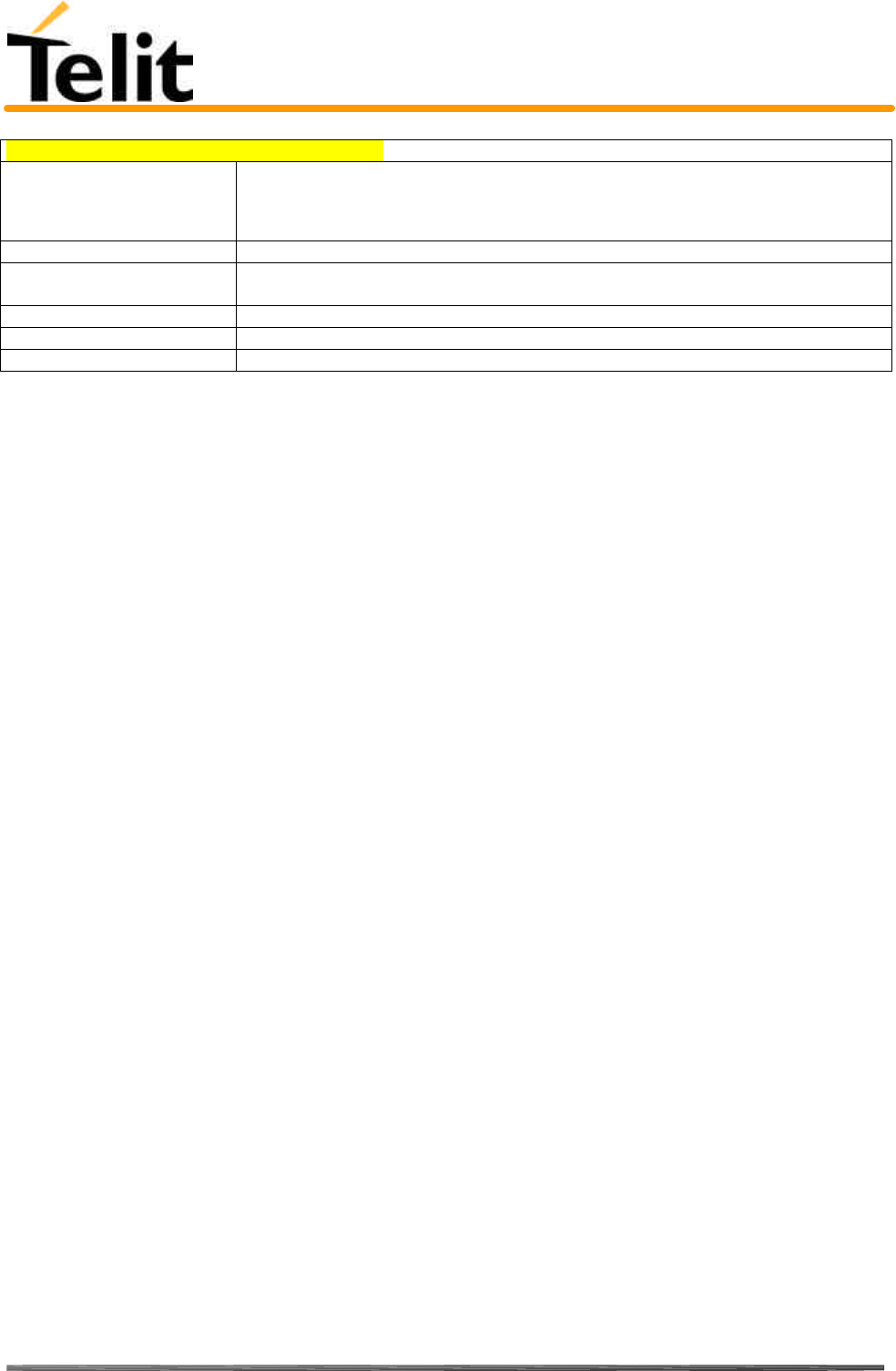
Telit TRIZIUM Product Description
80264ST10007a Rev. 4– 09/09/04
Reproduction forbidden without DAI Telecom written authorization – All Right reserved – Right of modification reserved page 88 of 202
+CCFC – call forwarding number and condition
Note: When querying the status of a network service (<cmd>=2) the
response line for 'not active' case (<status>=0) should be returned only if
service is not active for any <class>.
Write command
Test command
AT+CCFC=? Reports supported values for the parameter <reason>.
Example
Reference GSM 07.07
SW release Version A
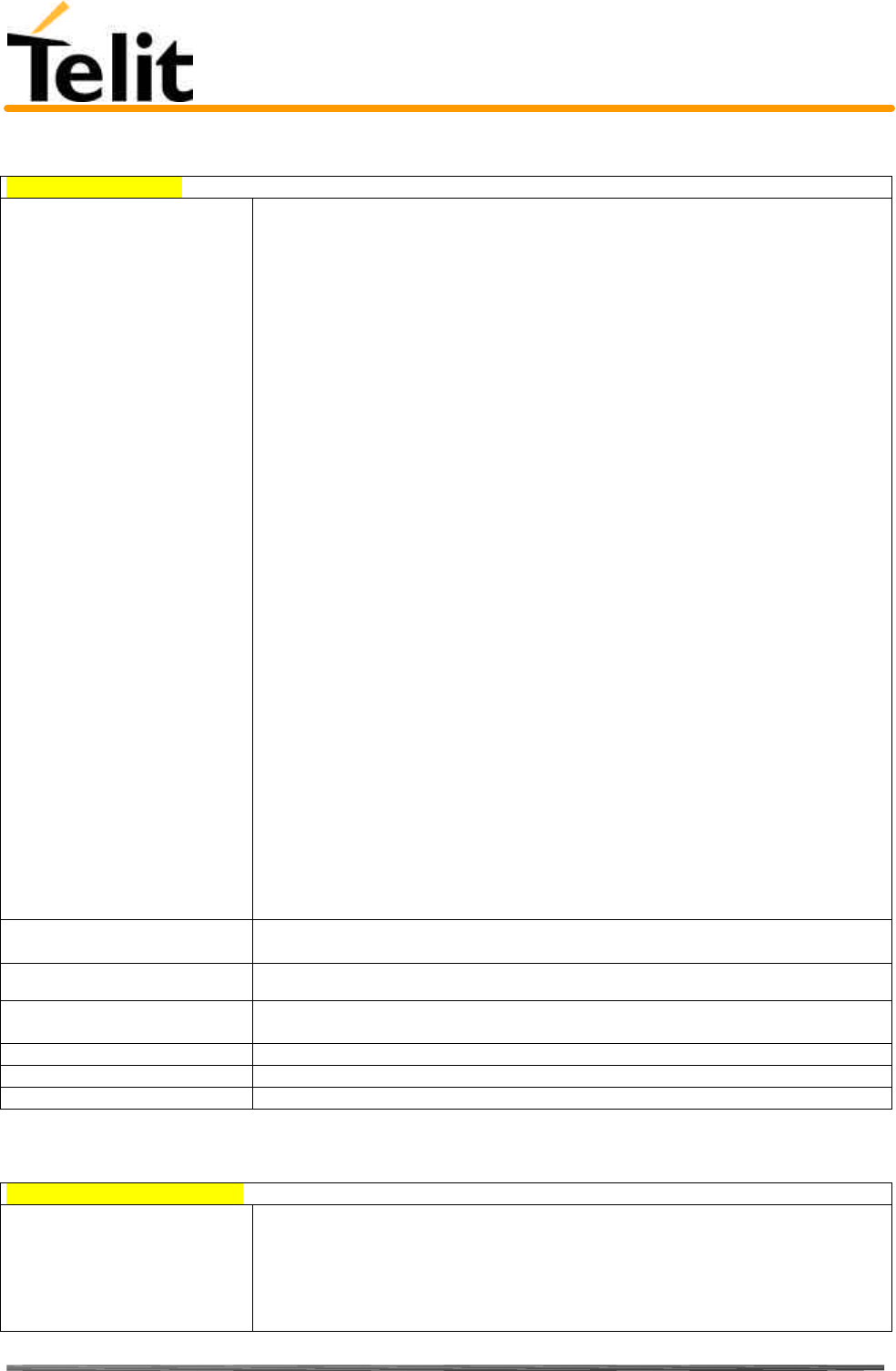
Telit TRIZIUM Product Description
80264ST10007a Rev. 4– 09/09/04
Reproduction forbidden without DAI Telecom written authorization – All Right reserved – Right of modification reserved page 89 of 202
5.4.3.9 +CCWA - call waiting
+CCWA – call waiting
Execute command
AT+CCWA =
[<n>[,<cmd>[,<class>]]] Controls the call waiting indication supplementary service. Activation, deactivation,
and status query are supported.
Parameters:
<n>: enables/disables call waiting indication reporting:
<n> = 0 – disable
<n> = 1 - enable
<cmd> enables/disables or queries the service at network level:
<cmd> = 0 - disable
<cmd> = 1 – enable
<cmd> = 2 - query status
<class>: is a sum of integers each representing a class of information which the
command refers; default 7 ( voice + data + fax )
<class> = 1 - voice (telephony)
<class> = 2 - data
<class> = 4 - fax (facsimile services)
The response to the query command is in the form:
+CCWA=<status>,<class>
Where
<status> represents the status of the service:
<status> = 0 - inactive
<status> = 1 - active
<class> is the class of calls the service status refers to.
Note: if parameter <cmd> is omitted then network is not interrogated.
Note2: In the query command the class parameter must not be issued.
Note3: The difference between call waiting report disabling (AT+CCWA = 0,1,7)
and call waiting service disabling (AT+CCWA = 0,0,7) is that in the first case the
call waiting indication is sent to the device by network but this last one does not
report it to the DTE; instead in the second case the call waiting indication is not
generated by the network. Hence the device results busy to the third party in the 2nd
case while in the 1st case a ringing indication is sent to the third party.
Note4: The command AT+CCWA=1,0 is a non sense and must not be issued.
Read command
AT+CCWA? Reports the current value of the parameter <n>.
Write command
Test command
AT+CCWA=? Reports the supported values for the parameter <n>.
Example
Reference GSM 07.07
SW release Version A
5.4.3.10 +CHLD - call holding services
+CHLD – call holding services
Execute command
AT+CHLD = <n> Controls the network call hold service. With this service it is possible to disconnect
temporarily a call and keep it suspended while it is retained by the network,
contemporary it is possible to connect another party or make a multiparty
connection.
The action of the command depends on the value of the parameter
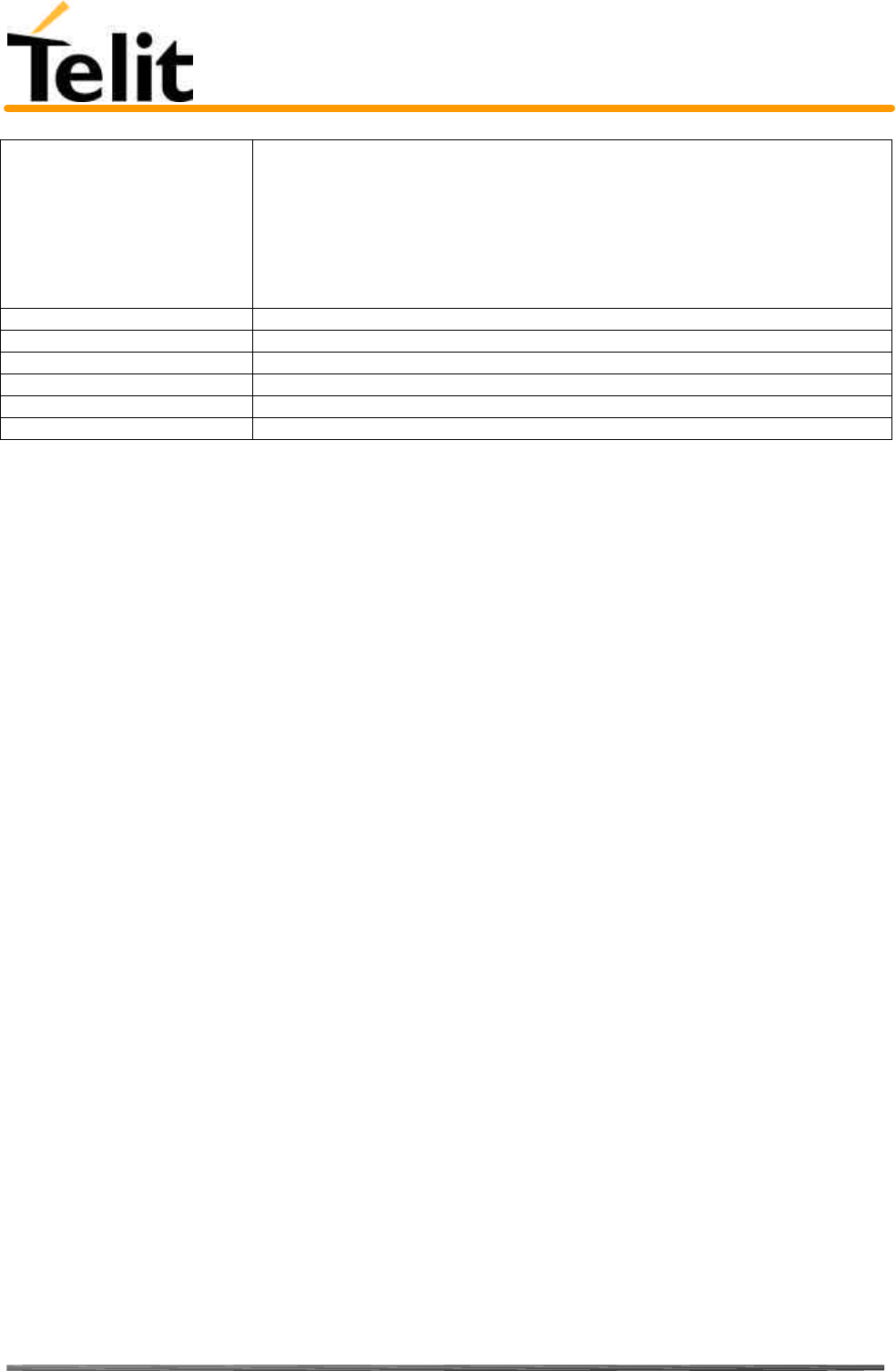
Telit TRIZIUM Product Description
80264ST10007a Rev. 4– 09/09/04
Reproduction forbidden without DAI Telecom written authorization – All Right reserved – Right of modification reserved page 90 of 202
Parameter:
<n> = 0 Releases all pending calls
<n> = 1 Releases all active calls (if present), and accepts or reconnects the pending
or waiting call
<n> = 2 Suspends (into pending status) the active call and accepts or reconnects
the waiting or pending call.
<n> = 3 NOT SUPPORTED
Note: ONLY for VOICE calls
Read command
Write command
Test command
Example
Reference GSM 07.07
SW release Version A
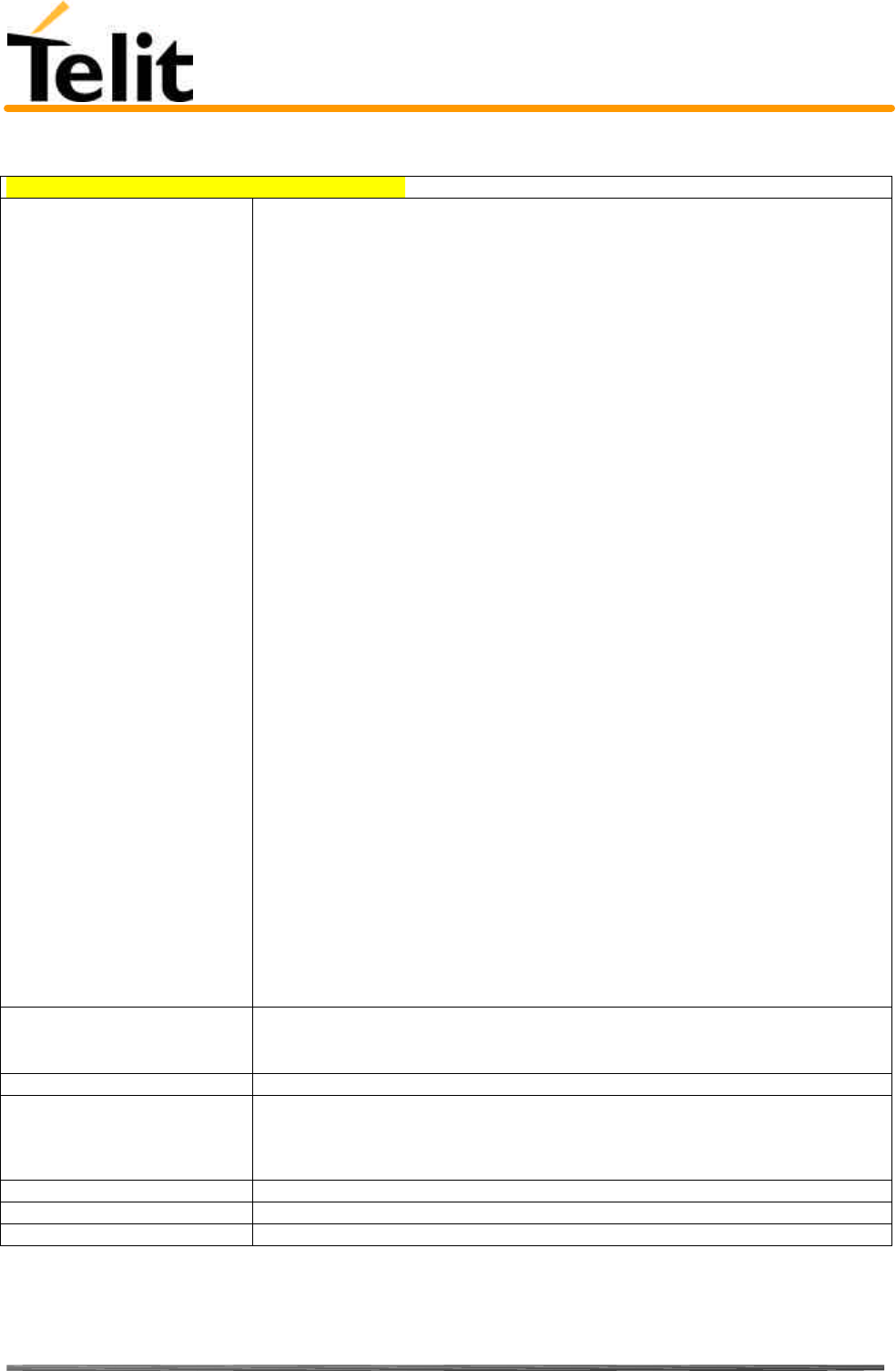
Telit TRIZIUM Product Description
80264ST10007a Rev. 4– 09/09/04
Reproduction forbidden without DAI Telecom written authorization – All Right reserved – Right of modification reserved page 91 of 202
5.4.3.11 +CUSD - unstructured supplementary service data
+CUSD – unstructured supplementary service data
Execute command
AT+CUSD = <n>,[<str>] Enables /disables the unstructured service data reporting.
Parameters:
<n>: is used to disable/enable the presentation of an unsolicited result code:
+CUSD: <m>[,<str>,<dcs>] to the TE.
<n>:
<n> = 0 - disable the result code presentation in the DTA
<n> = 1 - enable the result code presentation in the DTA
<dcs> indicates which alphabet is used (Data Coding Scheme),refer to command
Select TE Character Set +CSCS
<str> - USSD-string (when <str> parameter is not given, network is not
interrogated):
- if TE character set other than "HEX": ME/TA converts GSM alphabet into current
TE character set according to rules of GSM 07.05
- if TE character set is "HEX": ME/TA converts each 7-bit character of GSM
alphabet into two IRA character long hexadecimal number (e.g. character ? (GSM
23) is presented as 17 (IRA 49 and 55))
-if<dcs> indicates that 8-bit data coding scheme is used: ME/TA converts each 8-bit
octet into two IRA character long hexadecimal number (e.g. octet with integer value
42 is presented to TE as two characters 2A (IRA 50 and 65))
<m>:
<m> = 0 - no further user action required, hence network initiated USSD-Notify, or
no further information needed after mobile initiated operation.
<m> = 1 - further user action required, hence network initiated USSD-Request, or
further information needed after mobile initiated operation
<m> = 2 - USSD terminated by the network
<m> = 3 - other local client has responded
<m> = 4 - operation not supported
<m> = 5 - network time out
Note: only mobile initiated operations are supported.
Warning: In case of successful mobile initiated operation, DTA waits the USSD
response from the network and sends it to the DTE before the final result code. This
will block the AT command interface for the period of the operation.
Read command
AT+CUSD? Reports the current value of the parameter <n>
Write command
Test command
AT+CUSD=? Reports the supported values for the parameter <n>:
<n> = 0 - result code presentation in the TA disabled
<n> = 1 - result code presentation in the TA enabled
Example
Reference GSM 07.07
SW release Version A
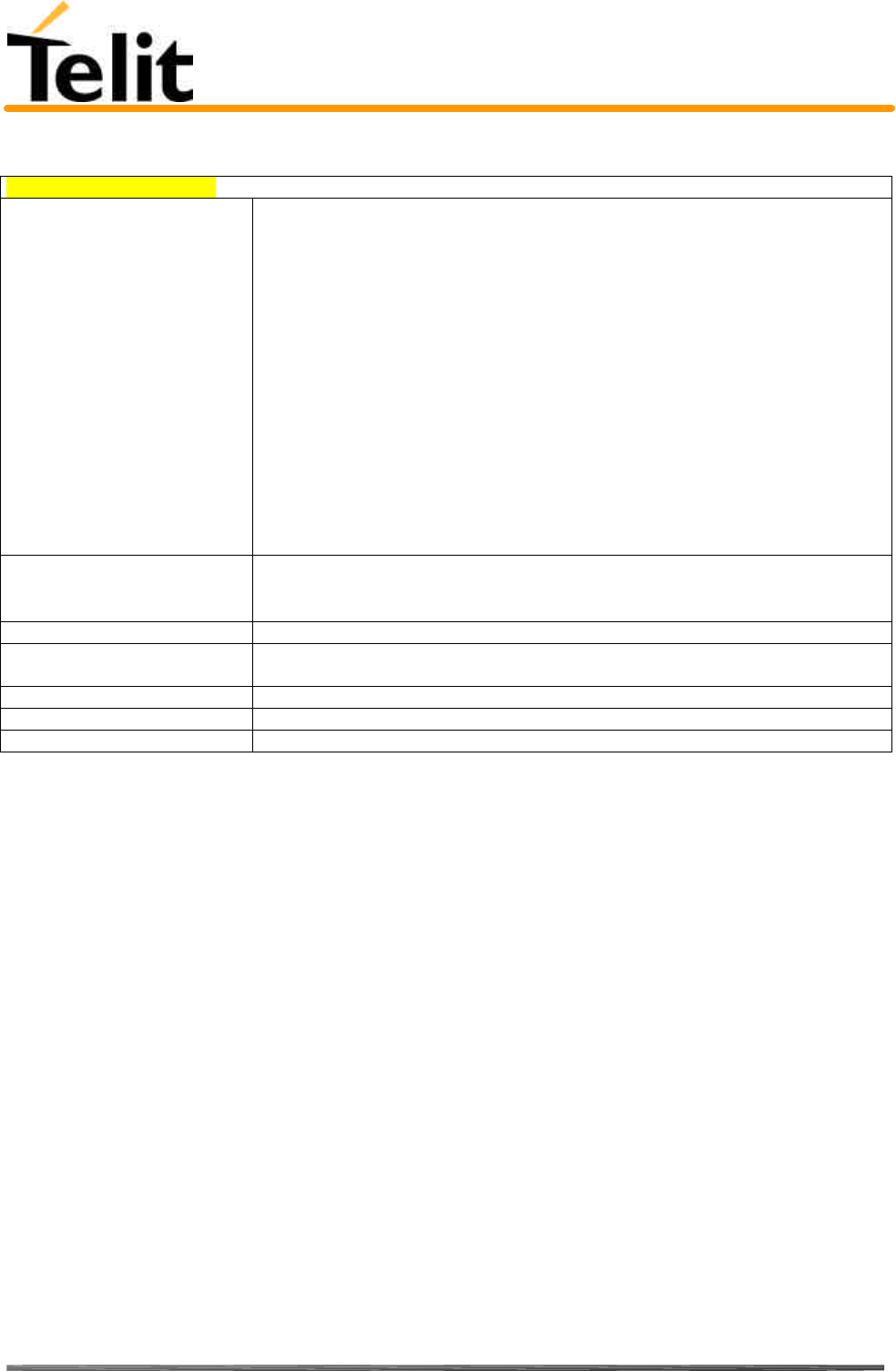
Telit TRIZIUM Product Description
80264ST10007a Rev. 4– 09/09/04
Reproduction forbidden without DAI Telecom written authorization – All Right reserved – Right of modification reserved page 92 of 202
5.4.3.12 +CAOC - advice of charge
+CAOC – advice of charge
Execute command
AT+CAOC = <mode> Controls the advise of charge service; the command also includes the possibility to
enable an unsolicited event reporting of the CCM information.
If unsolicited reporting is enabled DTE sends the result code
+CCCM: <acm>
when the CCM value changes, but not more than every 10 seconds.
<acm> - accumulated call meter value hexadecimal representation (3 byte)
Parameter:
<mode> = 0 - ACM (Accumulated Call Meter) read request
<mode> = 1 - disables unsolicited ACM reporting
<mode> = 2 - enables unsolicited ACM reporting
Note: +CAOC command uses the ACM of the device internal memory, not the
ACM stored in the SIM. The difference is that the internal memory ACM is reset at
power up, while the SIM ACM is reset only on user request. Advice of Charge
values stored in the SIM (ACM, ACMmax, PUCT) can be accessed with commands
+CACM, +CAMM and +CPUC.
Read command
AT+CAOC? Reports the value of ACM in the format: +CAOC: xxxxxx.
Write command
Test command
AT+CAOC=? Reports the supported values for <mode> parameter.
Example
Reference GSM 07.07
SW release Version A
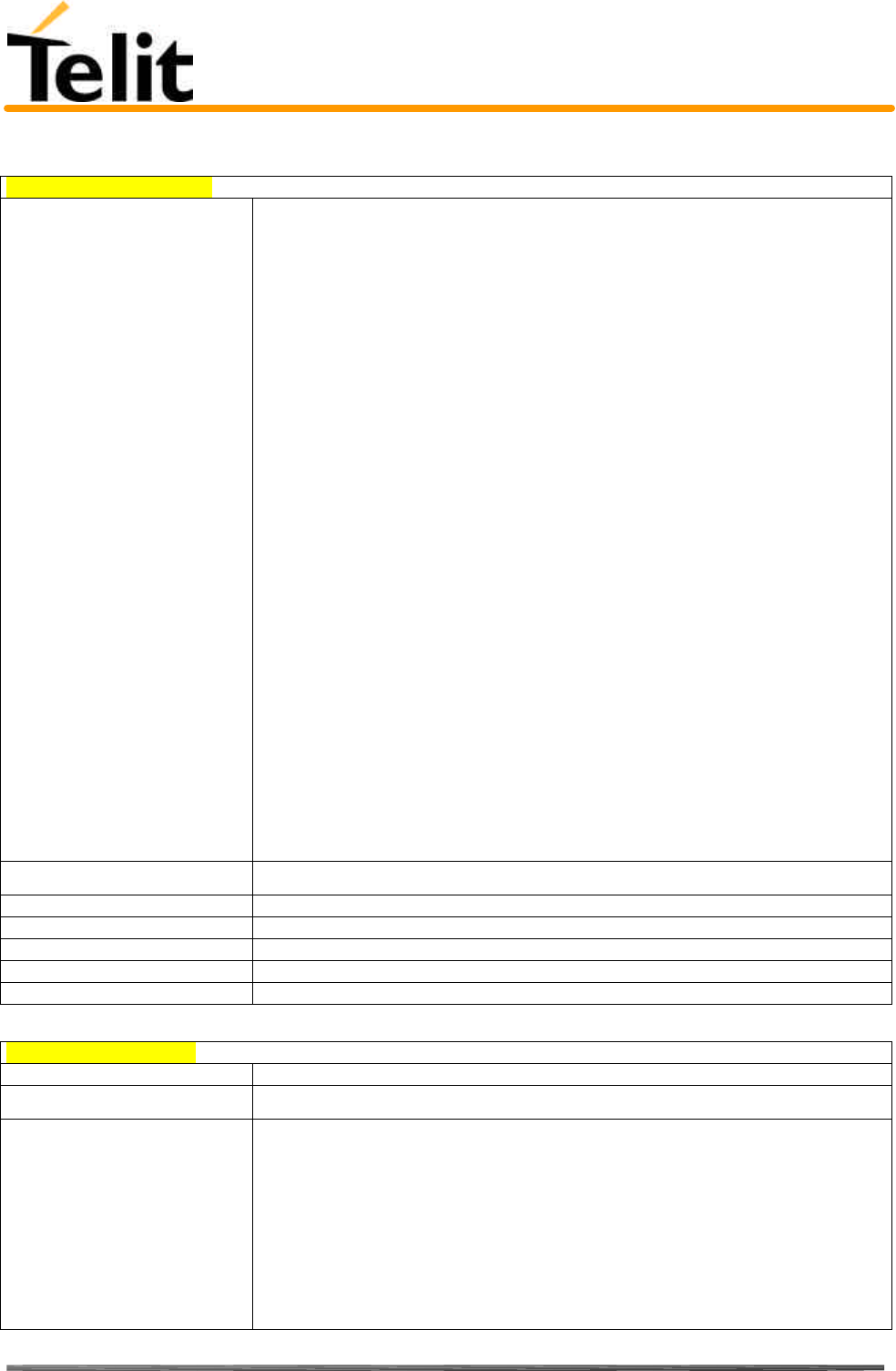
Telit TRIZIUM Product Description
80264ST10007a Rev. 4– 09/09/04
Reproduction forbidden without DAI Telecom written authorization – All Right reserved – Right of modification reserved page 93 of 202
5.4.3.13 +CLCC - list current calls
+CLCC – list current calls
Execute command
AT+CLCC Reports the list of current calls active and their characteristics by sending the report
+CLCC:<id>,<dir>,<stat>,<mode>,<mpty>[,<number>,<type>]
for each active call,
where:
<id> - call identification number
<dir> - call direction
0 - mobile originated call
1 - mobile terminated call
<stat> - state of the call
0 - active
1 - held
2 - dialing (MO call)
3 - alerting (MO call)
4 - incoming (MT call)
5 - waiting (MT call)
<mode> - call type
0 – voice
1 – data
2 – fax
9 - unknown
<mpty> - multiparty call flag
0 - call is not one of multiparty (conference) call parties
1 - NOT SUPPORTED
<number>: phone number in format specified by <type>
<type>: type of phone number byte in integer format
145 - international numbering scheme (contains the character "+")
129 - national numbering scheme
Note: If no call is active then only OK message is sent. This command is useful in
conjunction with command +CHLD to know the various call status for call holding.
Read command
Write command
Test command
Example
Reference GSM 07.07
SW release Version A
5.4.3.14 +CSSN – SS Notification
+CSSN – SS notification
Execute command
Read command
Write command
AT+CSSN = <n>, <m> Enable/disable the supplementary service related network initiated notifications,
during the origin of outgoing calls (+CSSI) and incoming calls (+CSSU)
Parameters:
<n>: sets the +CSSI result code presentation status
0 disable
1 enable
<m>: sets the +CSSU result code presentation status
0 disable
1 enable
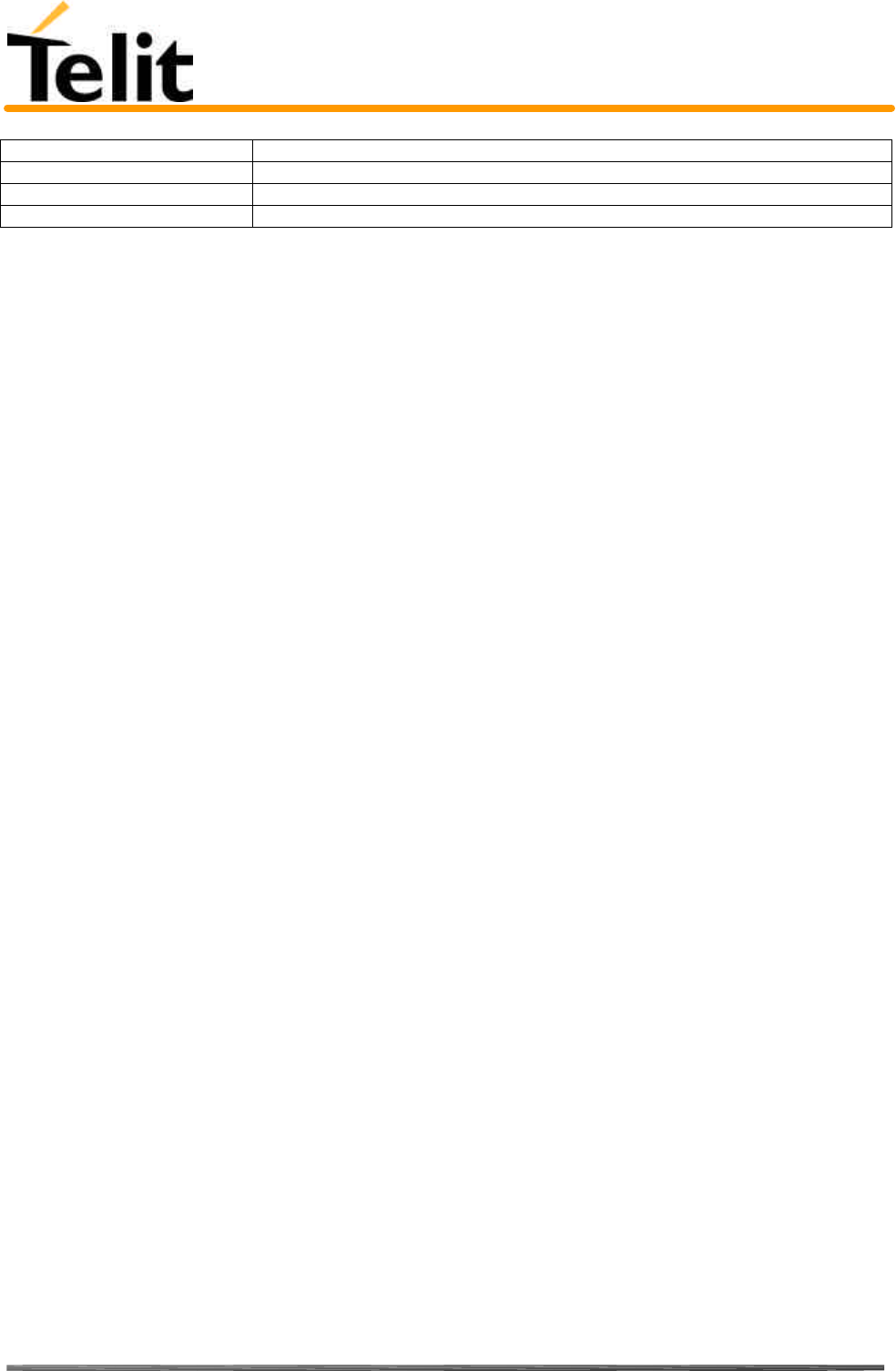
Telit TRIZIUM Product Description
80264ST10007a Rev. 4– 09/09/04
Reproduction forbidden without DAI Telecom written authorization – All Right reserved – Right of modification reserved page 94 of 202
Test command
Example
Reference GSM 07.07
SW release Version A
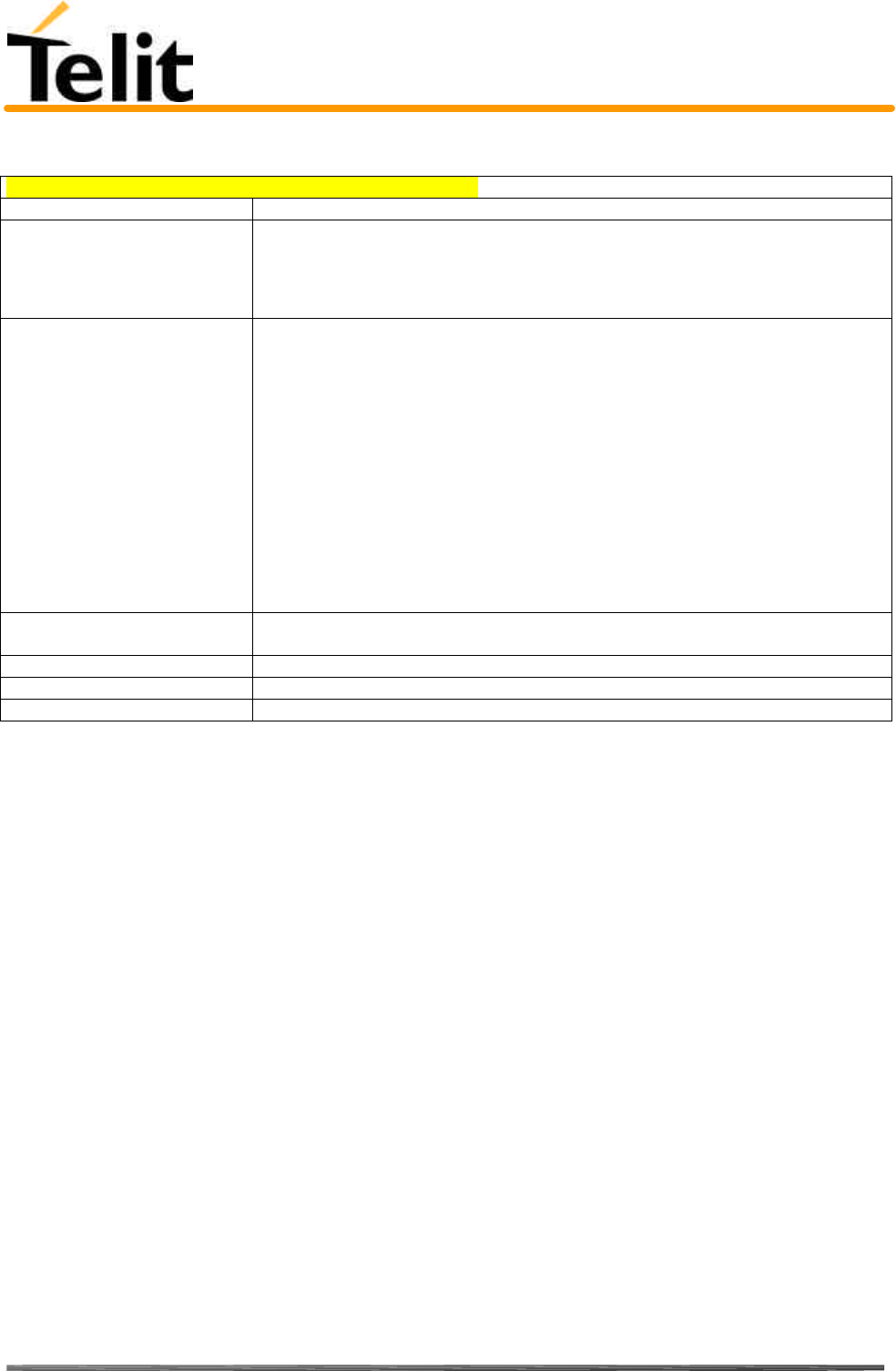
Telit TRIZIUM Product Description
80264ST10007a Rev. 4– 09/09/04
Reproduction forbidden without DAI Telecom written authorization – All Right reserved – Right of modification reserved page 95 of 202
5.4.3.15 +CCUG – Closed User Group supplementary service control
+CCUG – Closed User Group supplementary service control
Execute command
Read command
AT+CCUG? Reports the current value of the parameters in the format:
+CCUG: <n>,<index>,<info>
Write command
AT+CCUG=<n>[,
<index>[,<info>]] Enable/disable the CUG supplementary service
Parameters:
<n>
0 - disables the temporary CUG settings for all the successive calls
1 - enables the temporary CUG settings for all the successive calls
<index>
0...9 - CUG index
10 - no index (preferential CUG taken from subscriber data)
<info>
0 - no information
1 - suppress Outgoing Access (OA)
2 - suppress preferential CUG
3 - suppress OA and preferential CUG
Test command
AT+CCUG=? Reports the supported range of values for the parameters <n>,<index>, <info>
Example
Reference GSM 07.07
SW release Version A
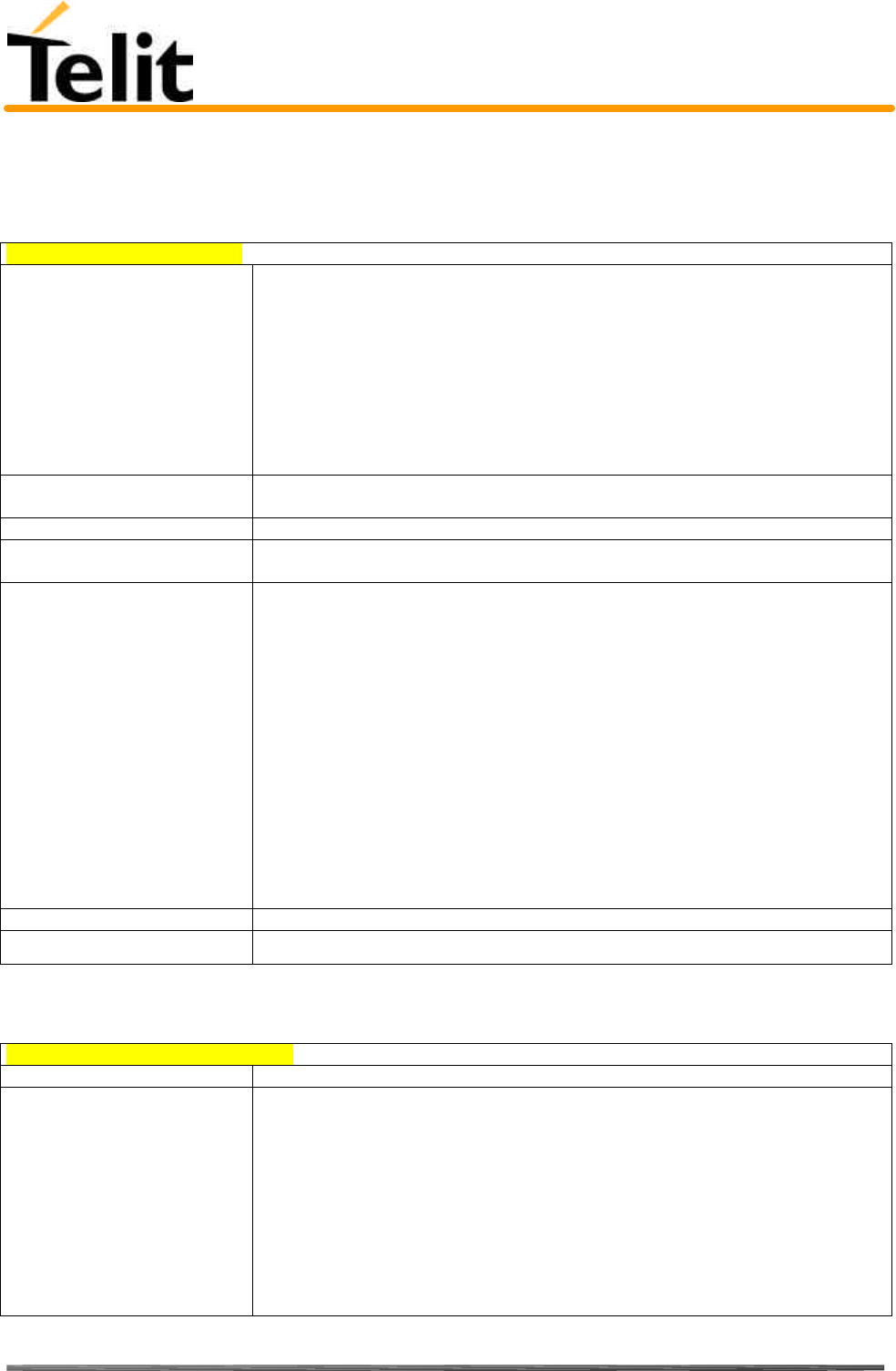
Telit TRIZIUM Product Description
80264ST10007a Rev. 4– 09/09/04
Reproduction forbidden without DAI Telecom written authorization – All Right reserved – Right of modification reserved page 96 of 202
5.4.4 Mobile Equipment control
5.4.4.1 +CPAS - phone activity status
+CPAS – phone activity status
Execute command
AT+CPAS reports the device status in the form
+CPAS: <pas>
where
<pas> - phone activity status
0 - ready (Device allows commands from TA/TE)
1 - unavailable (Device does not allow commands from TA/TE)
2 - unknown (Device is not guaranteed to respond to instructions)
3 - ringing (Device is ready for commands from TA/TE, but the ringer is active)
4 - call in progress (Device is ready for commands from TA/TE, but a call is in
progress)
Read command
AT+CPAS? same as Execute command.
Write command
Test command
AT+CPAS=? Reports the supported range of values of <pas>.
Example ATD03282131321;
OK
AT+CPAS?
+CPAS: 3 (the called phone is ringing)
OK
AT+CPAS?
+CPAS: 3
OK
AT+CPAS?
+CPAS: 4 (the called phone has answered to your call)
OK
ATH
OK
Reference GSM 07.07
SW release Version A
5.4.4.2 +CFUN Set phone functionality (Power Saving Management)
+CFUN – power saving management
Execute command
Read command
AT+CFUN? reports the power saving status in the form:
+CFUN: <fun>
where
<fun> - power saving status
1 - power saving disabled
5 - power saving enabled
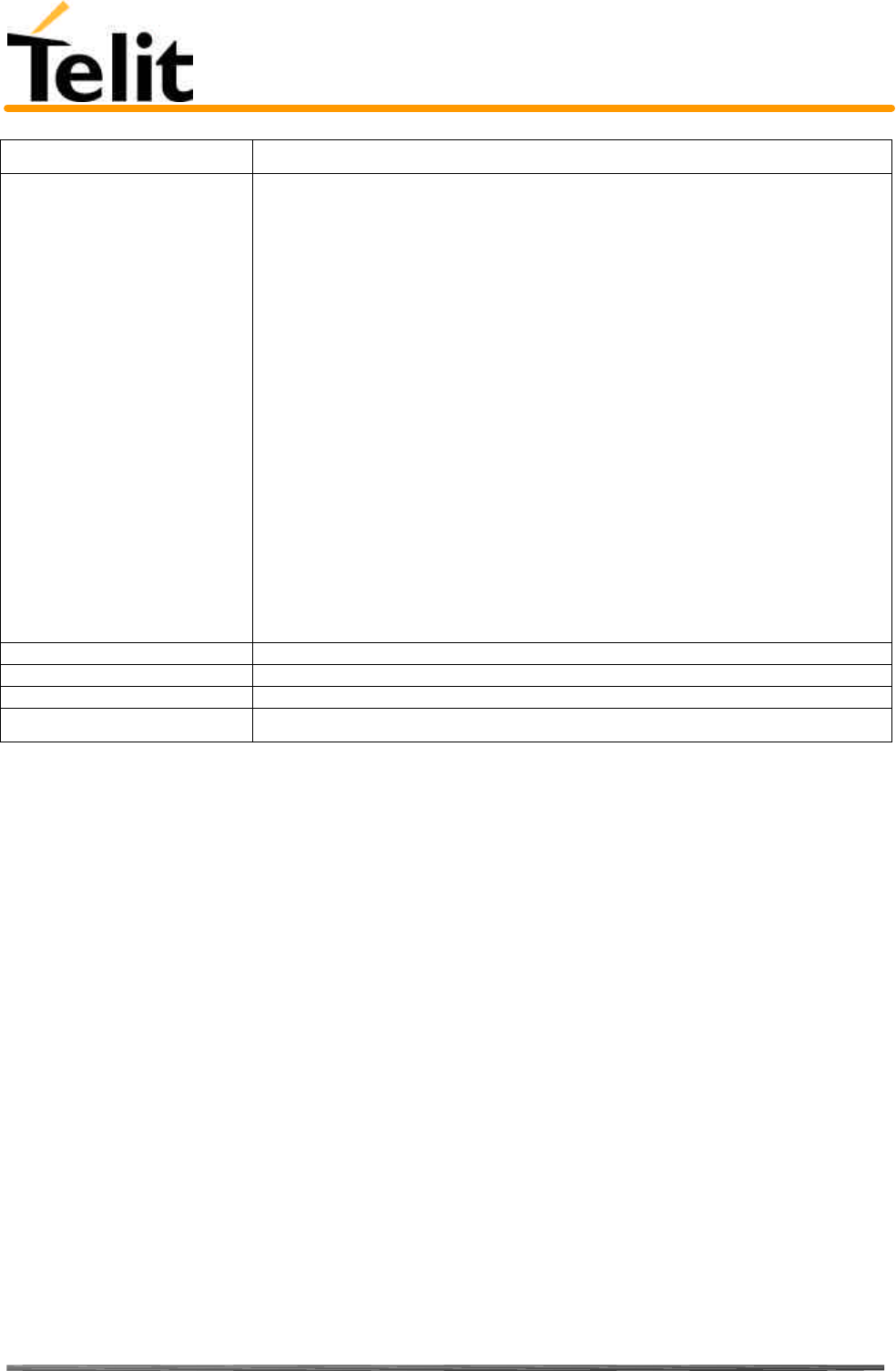
Telit TRIZIUM Product Description
80264ST10007a Rev. 4– 09/09/04
Reproduction forbidden without DAI Telecom written authorization – All Right reserved – Right of modification reserved page 97 of 202
Note: The phone functionality remains always FULL.
Write command
AT+CFUN=<fun> Enables/disables the power saving function.
If enabled it reduces the power consumption during the idle time, thus allowing a
longer standby time with a given battery capacity.
Parameters:
<fun>: is the power saving function mode
1 - Mobile full functionality with power saving disabled (default)
5 - Mobile full functionality with power saving enabled
Note: To place the telephone in power saving mode, set the <fun> parameter at value
= 5 and the line DTR (RS232) must be set to OFF. Once in power saving, the CTS
line switch to the OFF status to signal that the telephone is really in power saving
condition.
During the power saving condition, before sending any AT command on the serial
line, the DTR must be enabled and it must be waited for the CTS (RS232) line to go
in ON status.
Until the DTR line is ON, the telephone will not return back in the power saving
condition.
Note2: The power saving function does not affect the network behavior
of the TRIZIUM, even during the power save condition the module
remains registered on the network and reachable for incoming calls or
SMS. If a call incomes during the power save, then the module will
wake up and proceed normally with the unsolicited incoming call code
Test command
Example
Reference GSM 07.07
SW release Version A

Telit TRIZIUM Product Description
80264ST10007a Rev. 4– 09/09/04
Reproduction forbidden without DAI Telecom written authorization – All Right reserved – Right of modification reserved page 98 of 202
5.4.4.3 +CPIN - enter PIN
+CPIN – enter PIN
Execute command
Read command
AT+CPIN? Reports the PIN/PUK/PUK2 request status of the device in the form:
+CPIN:<code>
where <code> is the PIN/PUK/PUK2 request status code:
READY - device is not pending for any password
SIM PIN - device is waiting SIM PIN to be given
SIM PUK - device is waiting SIM PUK to be given
SIM PIN2 - device is waiting SIM PIN2 to be given; this <code> is returned
only when the last executed command resulted in PIN2 authentication failure (i.e.
+CME ERROR: 17)
SIM PUK2 - device is waiting SIM PUK2 to be given; this <code> is returned
only when the last executed command resulted in PUK2 authentication failure (i.e.
+CME ERROR: 18)
PH-NET PIN - device is waiting network personalization password to
be given
PH-NETSUB PIN - device is waiting network subset personalization
password to be given
Note: Pin pending status at startup depends on PIN facility setting, to change or query
the default power up setting use the AT+CLCK=SC,<mode>, <pin> command.
Write command AT+CPIN =
<pin>[,<newpin>] Sends to the device a password (SIM PIN, SIM PUK, PH-SIM PIN, etc.) which
may be required to further operate the device.
If the PIN required is SIM PUK or SIM PUK2, the <newpin> is required. This
second pin, <newpin>,will replace the old pin in the SIM.
The command may be used to change the SIM PIN by sending it with
both parameters <pin> and <newpin> when if PIN request is pending;
if no PIN request is pending the command will return an error code and
to change the PIN the command +CPWD must be used instead.
Parameters: <pin>, <newpin>
Note: the only commands which are accepted when device is pending SIM PIN, SIM
PUK, or PH-SIM are: +CGMI, +CGMM, +CGMR, +CGSN, D112; (emergency call),
+CPAS, +CPIN.
To check the status of the PIN request use the command AT+CPIN?
Test command
Example AT+CMEE=1
OK
AT+CPIN?
+CME ERROR: 10 (error because you have to insert the SIM)
AT+CPIN?
+CPIN: READY (this response is after you have inserted the SIM)
OK
Reference GSM 07.07
SW release Version A
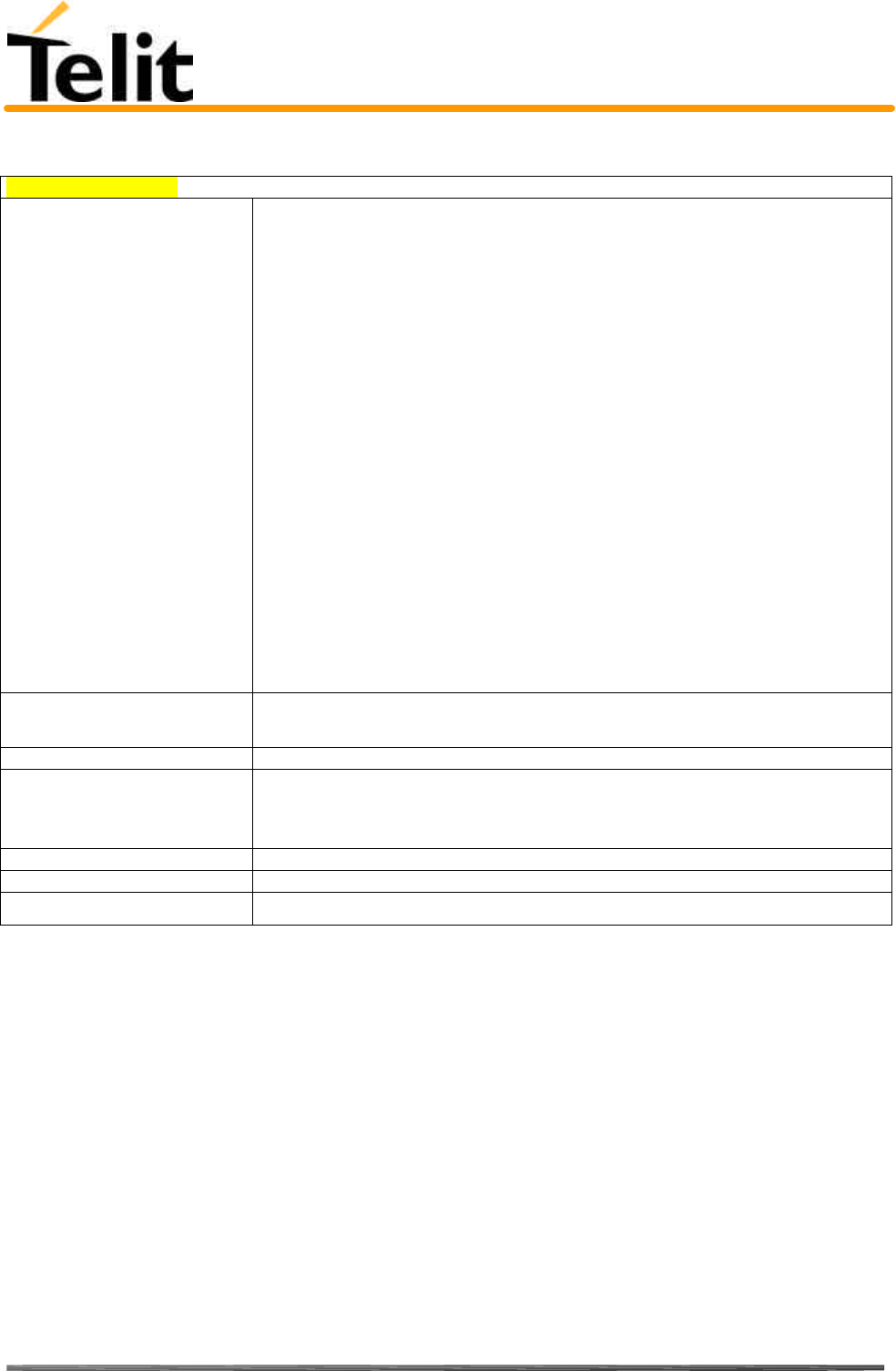
Telit TRIZIUM Product Description
80264ST10007a Rev. 4– 09/09/04
Reproduction forbidden without DAI Telecom written authorization – All Right reserved – Right of modification reserved page 99 of 202
5.4.4.4 +CSQ- signal quality
+CSQ – signal quality
Execute command
AT+CSQ Reports received signal quality indicators in the form
+CSQ:<rssi>,<ber>
where
<rssi> - received signal strength indication
0 - 113 dBm or less
1 - 111 dBm
2...30 - 109dBm ... -53 dBm / 2 dBm per step
31 - 51 dBm or greater
99 - not known or not detectable
<ber> - bit error rate %
0 - less than 0.2 %
1 - 0.2% a 0.4%
2 - 0.4% a 0.8%
3 - 0.8% a 1.6%
4 - 1.6% a 3.2%
5 - 3.2% a 6.4%
6 - 6.4% a 12.8%
7 - more than 12.8%
99 - not known or not detectable
Note: this command should be used instead of the AT%Q and AT%L commands,
since GSM relevant parameters are the radio link ones and no line is present, hence
%Q %L and have no meaning.
Read command
Write command
Test command AT+CSQ=?
Returns the supported range of values of the parameters <rssi>and
<ber>.
Example
Reference GSM 07.07
SW release Version A
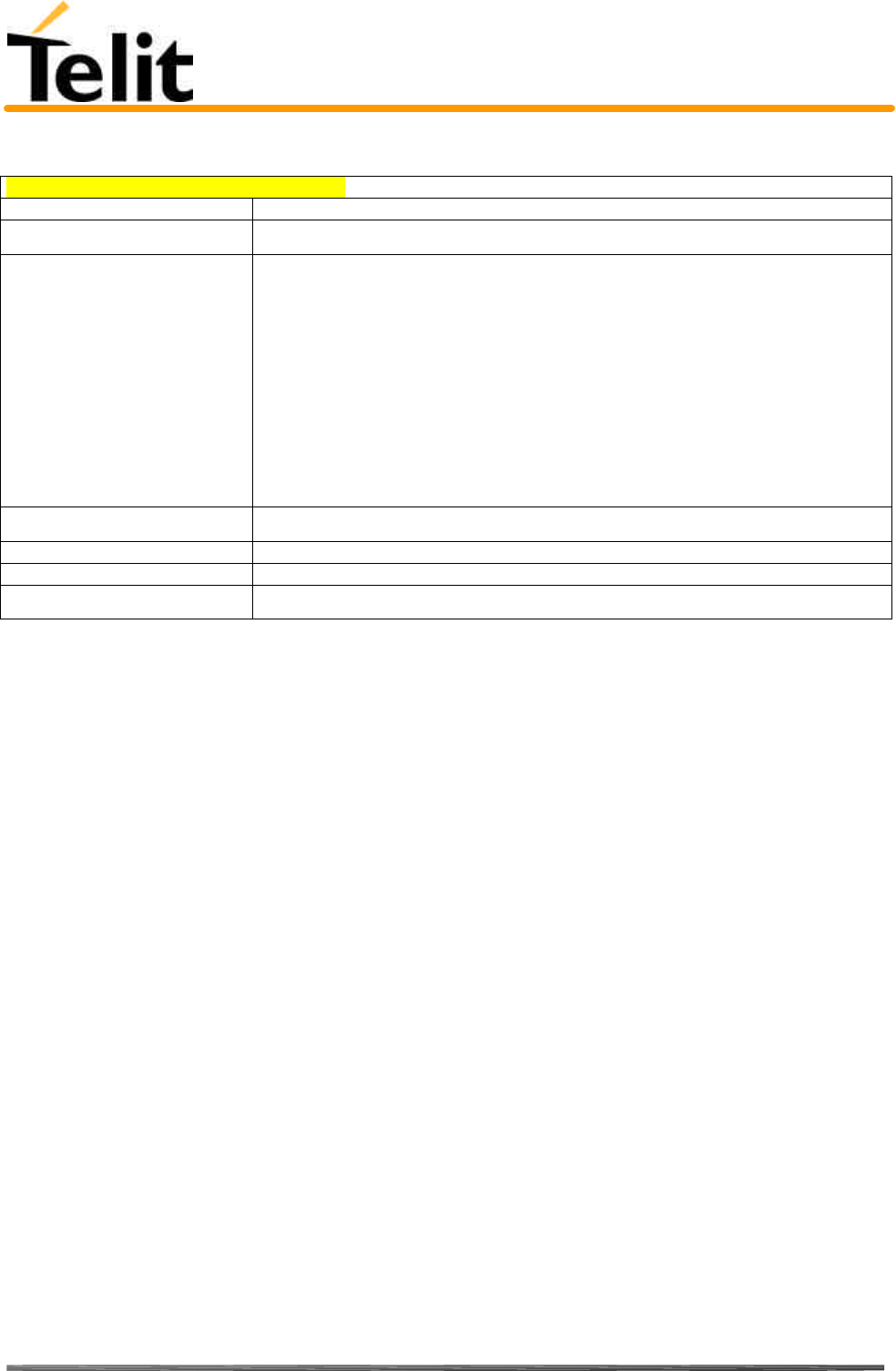
Telit TRIZIUM Product Description
80264ST10007a Rev. 4– 09/09/04
Reproduction forbidden without DAI Telecom written authorization – All Right reserved – Right of modification reserved page 100 of 202
5.4.4.5 +CPBS - select phonebook memory storage
+CPBS – select phonebook memory storage
Execute command
Read command
Write command
AT+CPBS = <storage> Selects phonebook memory storage <storage>, which will be used by other
phonebook commands.
Parameter: <storage>
"SM" - SIM phonebook
"FD" - SIM fixed dialling-phonebook (only phase 2/2+ SIM)
"LD" - SIM last-dialling-phonebook (+CPBW and +CPBF are not applicable for
this storage)
"MC" - device missed (unanswered received) calls list (+CPBW and +CPBF are
not applicable for this storage)
"RC" - ME received calls list (+CPBW and +CPBF are not applicable for this
storage)
Test command
Example
Reference GSM 07.07
SW release Version A
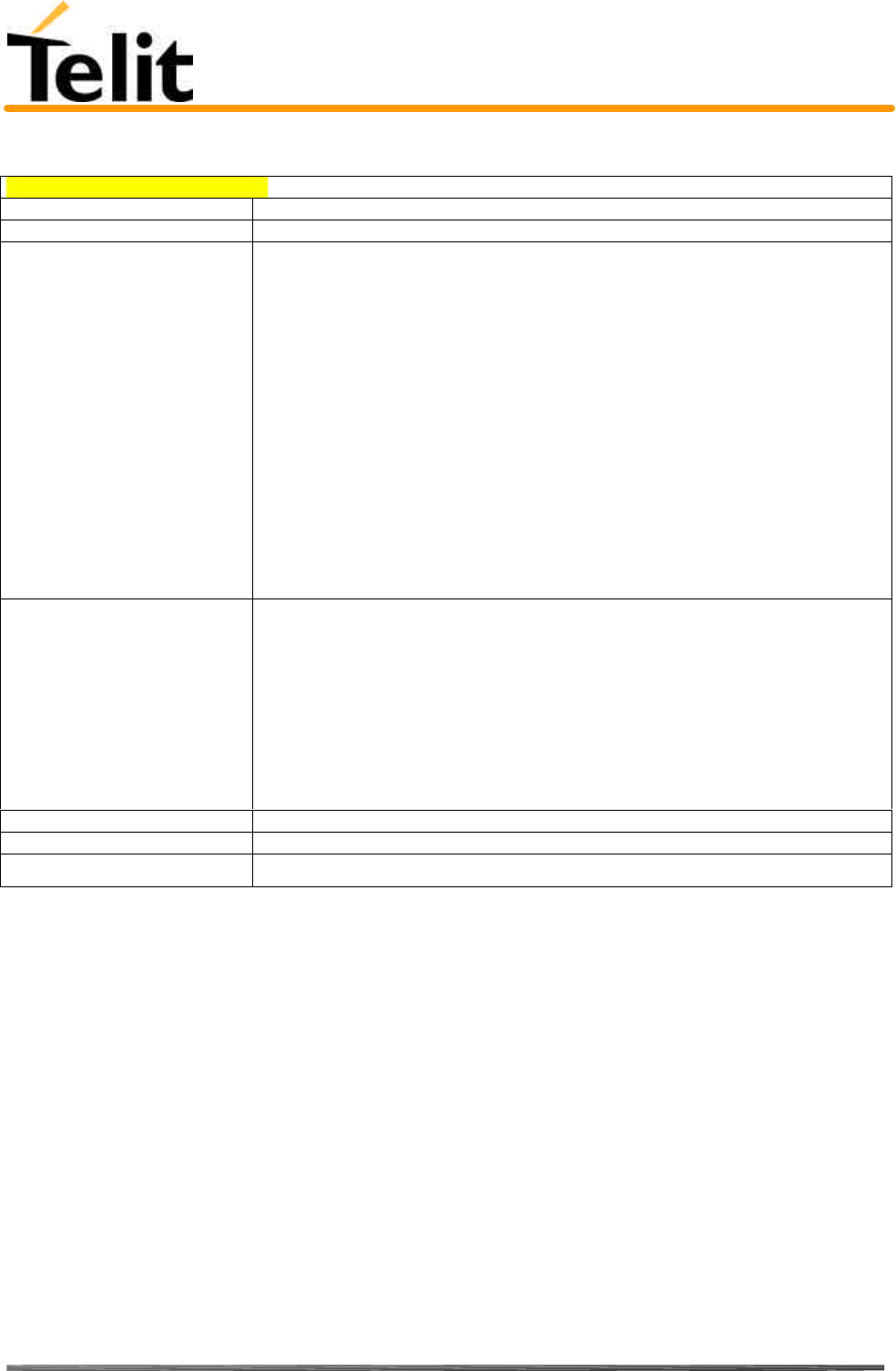
Telit TRIZIUM Product Description
80264ST10007a Rev. 4– 09/09/04
Reproduction forbidden without DAI Telecom written authorization – All Right reserved – Right of modification reserved page 101 of 202
5.4.4.6 +CPBR - read phonebook entries
+CPBR – read phonebook entries
Execute command
Read command
Write command
AT+CPBR =
<index>[,<index2>] returns phonebook entries in locations number from <index1> to <index2> from the
current phonebook memory storage selected with +CPBS. If<index2> is omitted,
only location <index1> is returned.
Parameters: <index>, <index2>
The response format is:
+CPBR: <index>,<number>,<type>,<name>
where
<index> - the current position number of the PB index (to see the range of values
use +CPBR=?)
<number> - the phone number stored in the format <type>
<type> - type of phone number byte in integer format
145 - international numbering scheme (contains the character "+")
129 - national numbering scheme
<name> - the alphanumeric text associated to the number (e.g. name of address)
Note: If all queried locations are empty (but available), no information text lines will
be returned, while if listing fails in an ME error, +CME ERROR: <err> is returned.
Test command AT+CPBR=? Returns the supported range of values of the parameters in the form
+CPBR: (<minIndex> - <maxIndex>),<nlength>,<tlength>
where
<minIndex> - the minimum index number
<maxIndex>- the maximum index number
<nlength> - maximum number field length
<tlength> - maximum name field length
Note: remember to select the PB storage with +CPBS command before issuing PB
commands.
Example
Reference GSM 07.07
SW release Version A
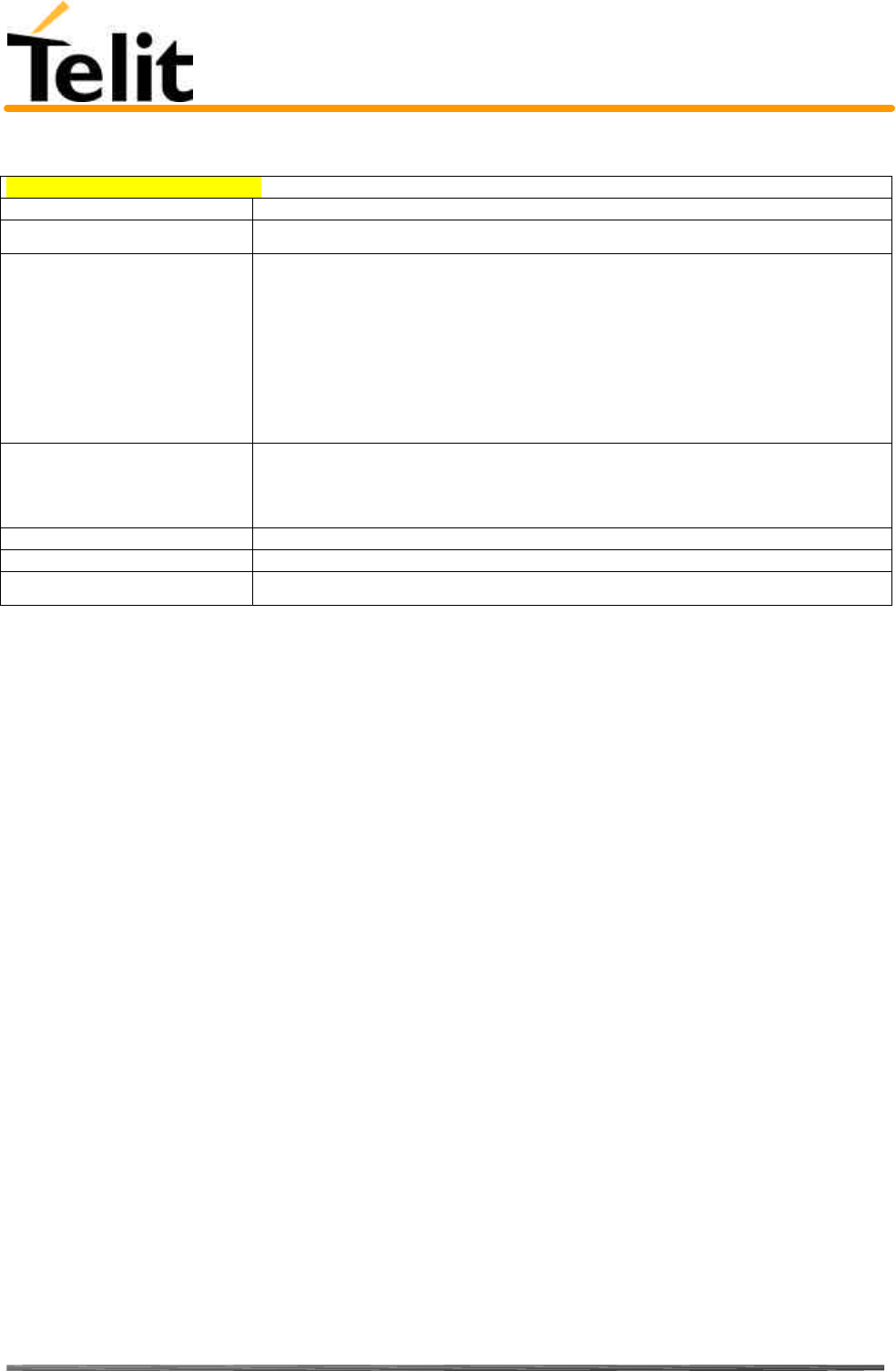
Telit TRIZIUM Product Description
80264ST10007a Rev. 4– 09/09/04
Reproduction forbidden without DAI Telecom written authorization – All Right reserved – Right of modification reserved page 102 of 202
5.4.4.7 +CPBF - find phonebook entries
+CPBF – find phonebook entries
Execute command
Read command
Write command
AT+CPBF = <text> Issues a search for the phonebook records that have the text sub-string at the start of
the name field and returns a report in the form
+CPBF: <index>,<number>,<type>,<name>
where index, number, type and name have the same meaning than in the command
+CPBR report.
If no PB records satisfy the search criteria then an ERROR message is reported.
Parameter: <text>
Note: text is NOT case sensitive and may or not be included in double brackets.
Test command AT+CPBF=? Reports the maximum lengths of fields <number> and <name> in the PB
entry in the form:
+CPBF: <max_number_length>,<max_name_length>
Example
Reference GSM 07.07
SW release Version A
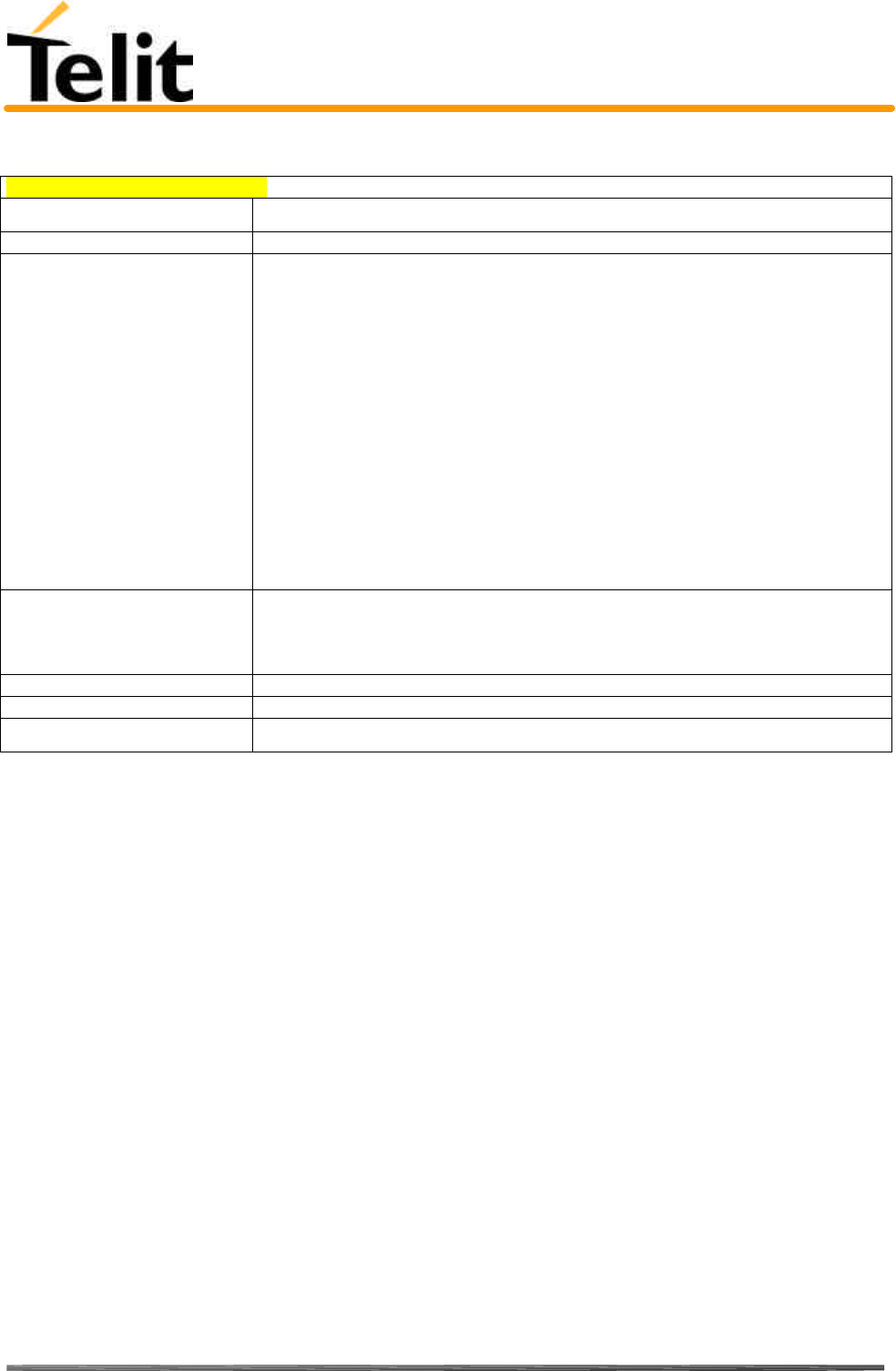
Telit TRIZIUM Product Description
80264ST10007a Rev. 4– 09/09/04
Reproduction forbidden without DAI Telecom written authorization – All Right reserved – Right of modification reserved page 103 of 202
5.4.4.8 +CPBW - write phonebook entry
+CPBW – write phonebook entry
Execute command
Read command
Write command
AT+CPBW =
[<index>][,<number>[,
<type>[,<name>]]]
Stores at the position <index> a Phonebook record defined by <number>,<type> and
<name> parameters
Parameters: <index>, <number>, <type>, <name>
<number> - the phone number in the format <type>
<type> - the type of number
145 - international numbering scheme (contains the character "+")
129 - national numbering scheme
<name> - the text associated to the number.
Note: If record number <index> already exists, it will be overwritten.
If only <index> is given, the record number <index> is deleted.
If <index> is omitted, the number <number> is stored in the first free phonebook
location.
Text in the <name> field and number in the <number> field may or may not be
included in double brackets.
Test command AT+CPBW=? Reports the maximum lengths of fields <number> and <name> in the PB entry in the
form:
+CPBW: <max_number_length>,<max_name_length>
Example
Reference GSM 07.07
SW release Version A
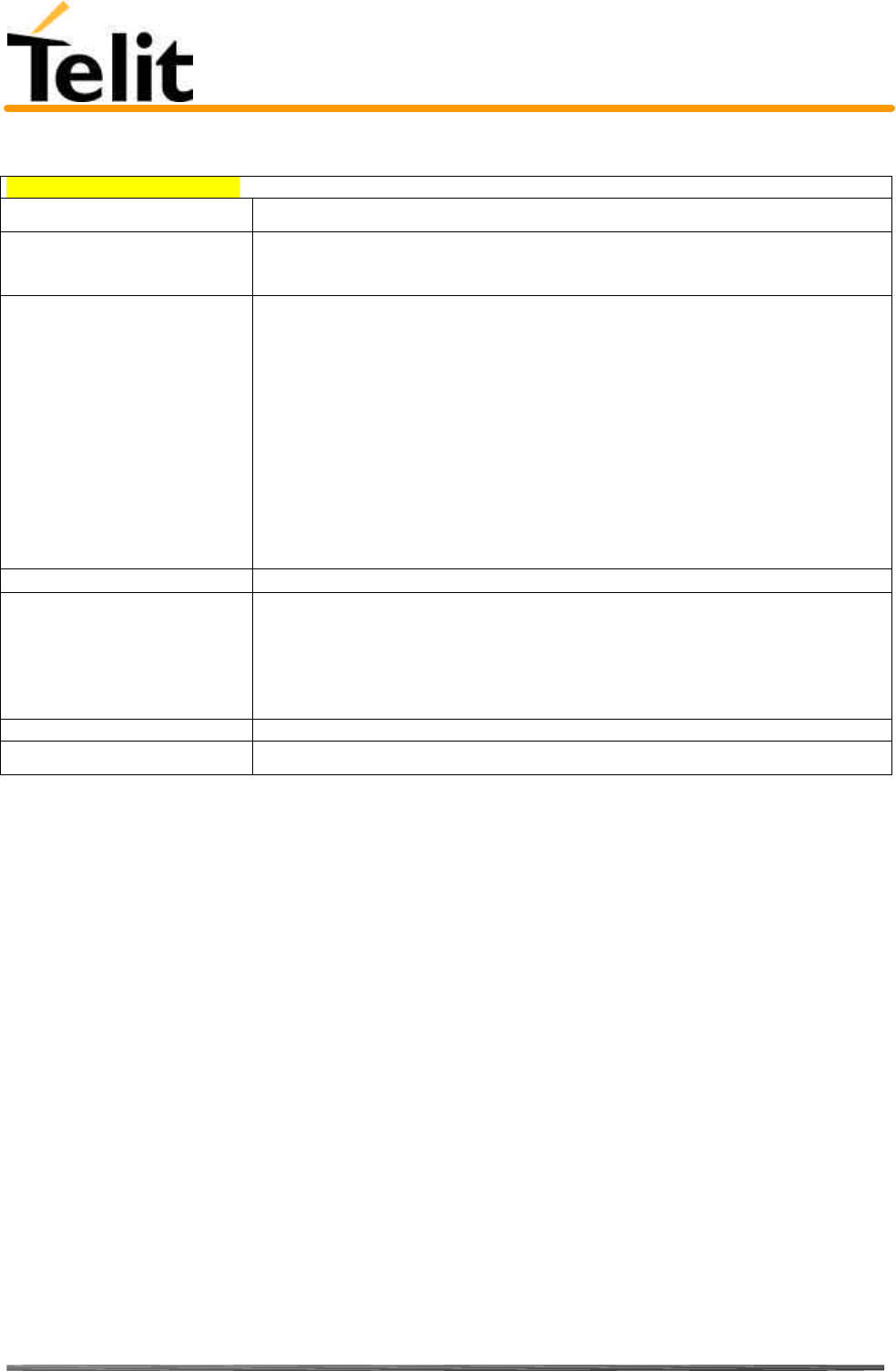
Telit TRIZIUM Product Description
80264ST10007a Rev. 4– 09/09/04
Reproduction forbidden without DAI Telecom written authorization – All Right reserved – Right of modification reserved page 104 of 202
5.4.4.9 +CCLK - Clock Management
+CCLK – Clock Management
Execute command
Read command
AT+CCLK? Reports the current time stored in the internal Real Time Clock in the format:
+CCLK: <time>
Write command
AT+CCLK = <time> Stores in the internal Real Time Clock the current time defined by the parameter
<time>
Parameter:
<time> - current time in the format : "yy/MM/dd,hh:mm:ss±zz"
where:
yy - year
MM - month (in digits)
dd - day
hh - hour
mm - minute
±zz - time zone in quarter of an hour (difference between the GMT and the local
time)
Test command
Example AT+CCLK="02/09/07,22:30:00+04"
OK
AT+CCLK?
+CCLK: 02/09/07,22:30:25+4
OK
Reference GSM 07.07
SW release Version A

Telit TRIZIUM Product Description
80264ST10007a Rev. 4– 09/09/04
Reproduction forbidden without DAI Telecom written authorization – All Right reserved – Right of modification reserved page 105 of 202
5.4.4.10 +CALA - Alarm Management
+CALA – Alarm Management
Execute command
Read command
AT+CALA? Reports the current alarm time stored in the internal Real Time Clock, if present, in
the format:
+CALA: <time>,<n>,<type>[,<text>]
Write command
AT+CALA = [<time>
[,<n>[,<type>[,<text>]]]] Stores in the internal Real Time Clock the current alarm time and settings defined by
the parameters <time>, <n>,<type>,<text>.
When the RTC time reaches the alarm time then the alarm starts, the behaviour of the
TRIZIUM depends upon the setting <type> and if the device was already ON at the
moment when the alarm time had come.
Parameter:
<time> - current alarm time in the format : "yy/MM/dd,hh:mm:ss±zz"
as defined for +CCLK command.
<type> - alarm behaviour type
0 - reserved for other equipment use.
1 - the TRIZIUM simply wakes up fully operative as if the ON/OFF pin had been
pressed. If the device is already ON at the alarm time, then it does nothing.
2 - the TRIZIUM wakes up in "alarm mode" if at the alarm time it was off,
otherwise it remains fully operative. In both cases the TRIZIUM issues an
unsolicited code every 3s:
+ALARM: <text>
Where <text> is the other +CALA parameter previously set.
The device keeps on sending the unsolicited code every 3s until a #WAKE or
#SHDN command is received or a 90s timeout occurs. If the device is in
"alarm mode" and it does not receive the #WAKE command within 90s then it
shuts down. (default)
3 - the TRIZIUM wakes up in "alarm mode" if at the alarm time it was off,
otherwise it remains fully operative. In both cases the TRIZIUM starts playing
the alarm tone on the selected path for the ringer (see command #SRP)
The device keeps on playing the alarm tone until a #WAKE or #SHDN
command is received or a 90s timeout occurs. If the device is in "alarm mode"
and it does not receive the #WAKE command within 90s then it shuts down.
4 - the TRIZIUM wakes up in "alarm mode" if at the alarm time it was off,
otherwise it remains fully operative. In both cases the TRIZIUM brings the pin
GPIO6 high, provided its <direction> has been set to alarm output, and keeps it
in this state until a #WAKE or #SHDN command is received or a 90s timeout
occurs. If the device is in "alarm mode" and it does not receive the #WAKE
command within 90s then it shuts down.
5 - the TRIZIUM will make both the actions as for type=2 and type=3.
6 - the TRIZIUM will make both the actions as for type=2 and type=4.
7 - the TRIZIUM will make both the actions as for type=3 and type=4.
<n> = 0 - index of the alarm
The only value supported for <n> is 0.
<text> - unsolicited alarm code text string
In the case that <type> is equal to 2 or 5 or 6, then the unsolicited text parameter
<text> can be set by this parameter.
Note: The "alarm mode" is indicated by hardware pin CTS to the ON status and DSR
to the OFF status, while the "power saving" status is indicated by a CTS - OFF and
DSR - OFF status. The normal operating status is indicated by DSR - ON.
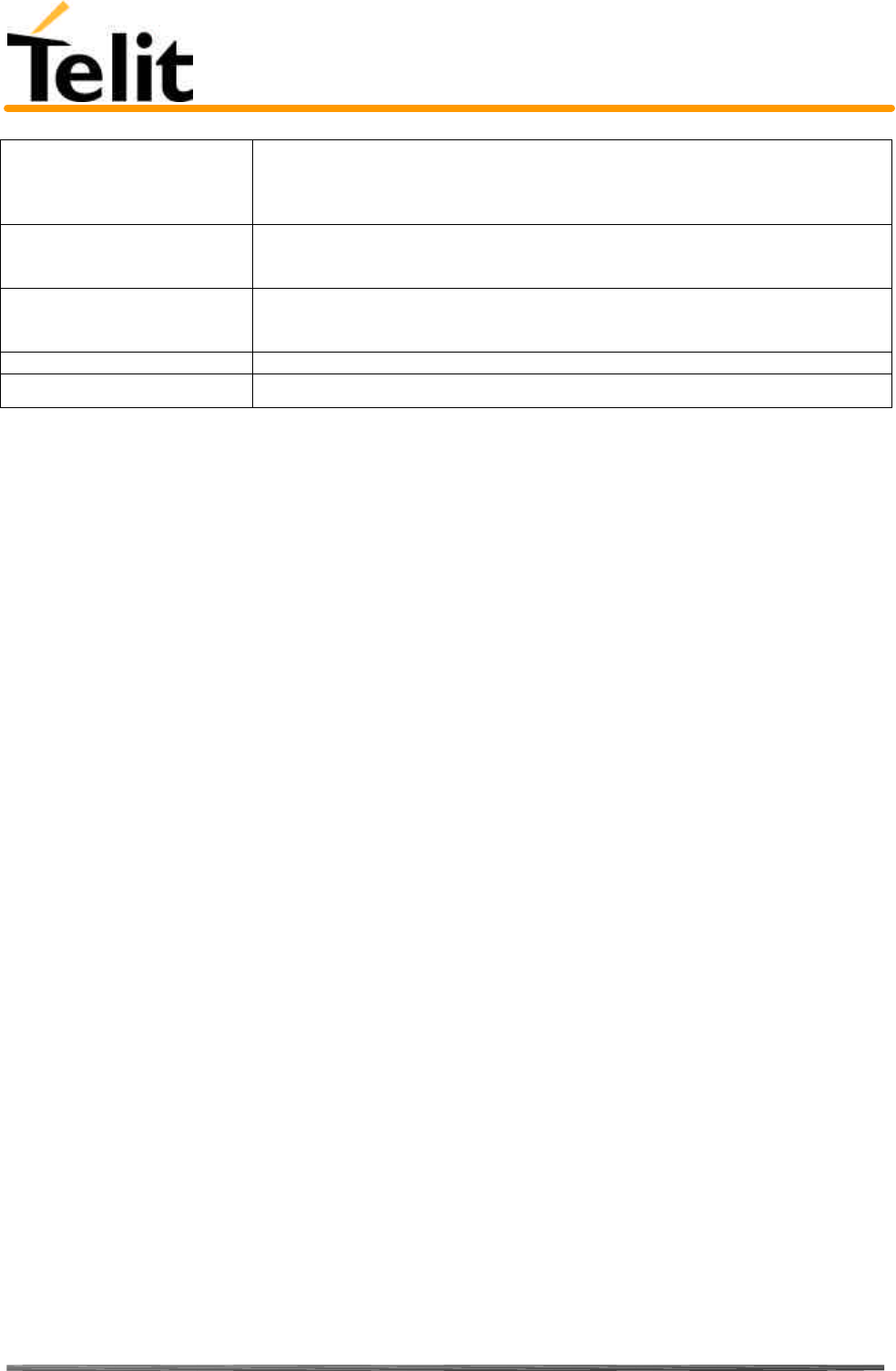
Telit TRIZIUM Product Description
80264ST10007a Rev. 4– 09/09/04
Reproduction forbidden without DAI Telecom written authorization – All Right reserved – Right of modification reserved page 106 of 202
During the "alarm mode" the device will not make any network scan and will not
register to any network and therefore is not able to dial or receive any call or SMS,
the only commands that can be issued to the TRIZIUM in this state are the #WAKE
and #SHDN, every other command must not be issued during this state.
Test command AT+CALA=? Reports the supported range of values for the parameters <time>,<n>, <type> and
<text> maximum length
Example AT+CALA="02/09/07,23:30:00+04"
OK
Reference GSM 07.07
SW release Version A
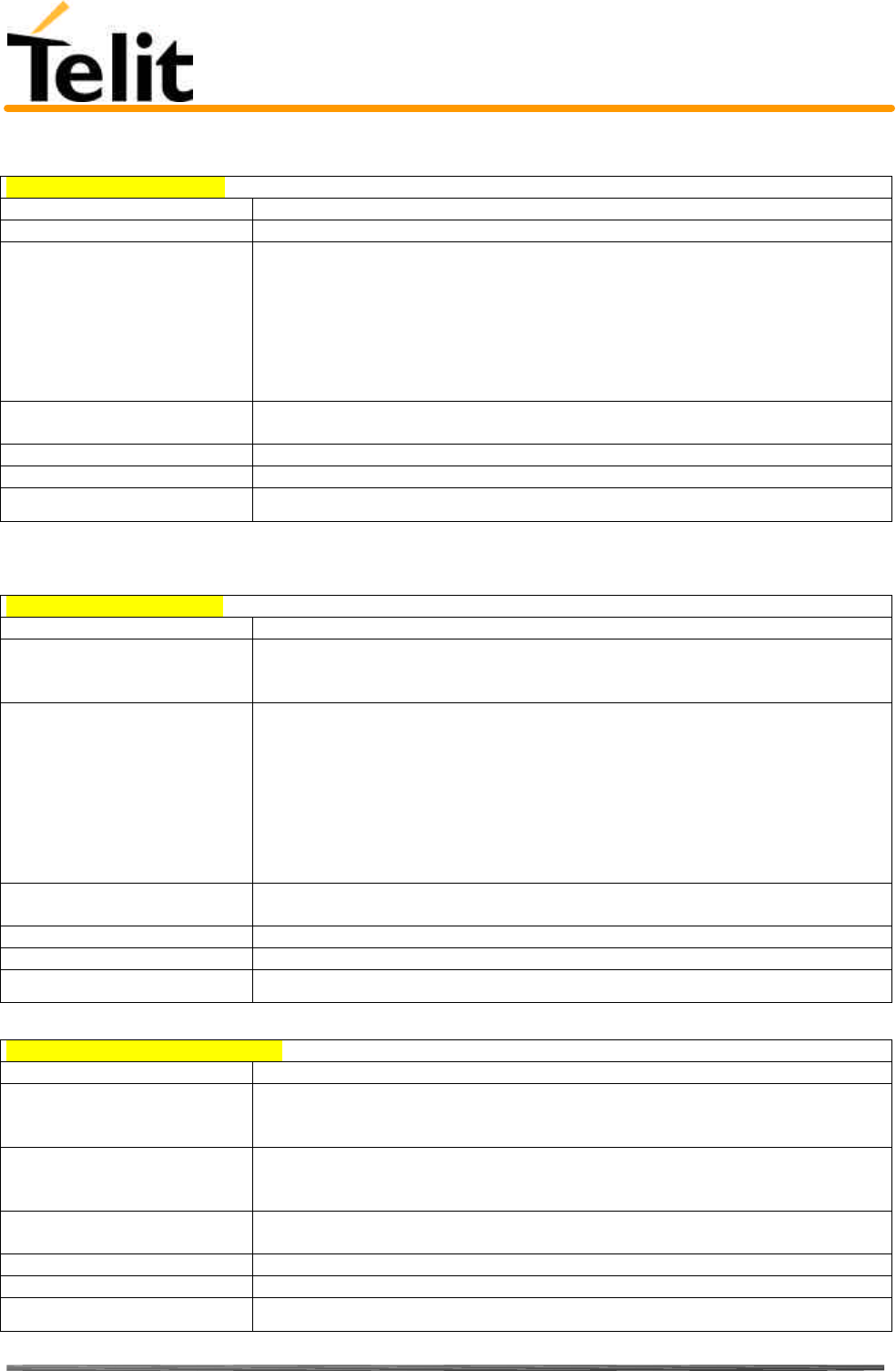
Telit TRIZIUM Product Description
80264ST10007a Rev. 4– 09/09/04
Reproduction forbidden without DAI Telecom written authorization – All Right reserved – Right of modification reserved page 107 of 202
5.4.4.11 +CALM - alert sound mode
+CALM – alert sound mode
Execute command
Read command
Write command AT+CALM =
<mode> It is used to select the general alert sound mode of the device.
Parameter:
<mode> = 0 - normal mode
<mode> = 1 - silent mode (no sound will be generated by the device) Note: if silent
mode (1) is selected then incoming calls will not produce alerting sounds but only the
message RING or +CRING.
Test command
AT+CALM=? Returns the supported values for the parameter <mode>.
Example
Reference GSM 07.07
SW release Version A
5.4.4.12 +CRSL - ringer sound level
+CRSL – ringer sound level
Execute command
Read command
AT+CRSL? Reports the current <level> setting of the call ringer in the format:
+CRSL: <level>
Write command
AT+CRSL = <level> It used to select the incoming call ringer sound level of the device.
Parameter: <level> - ringer sound level
<level> = 0 - Off
<level> = 1 - low
<level> = 2 - middle
<level> = 3 - high
<level> = 4 – progressive
Test command
AT+CRSL=? Reports <level> supported values range in the format:
+CRSL: (0-4)
Example
Reference GSM 07.07
SW release Version A
5.4.4.13 +CLVL - loudspeaker volume level
+CLVL – loudspeaker volume level
Execute command
Read command
AT+CLVL? Reports the current <level> setting of the loudspeaker volume in the format:
+CLVL: <level>
Write command
AT+CLVL = <level> It used to select the volume of the internal loudspeaker audio output of the device.
Parameter: <level> - loudspeaker volume varies between 0 (min) and 10 (max).
Test command
AT+CLVL=? Reports <level> supported values range in the format:
+CLVL: (0-10)
Example
Reference GSM 07.07
SW release Version A
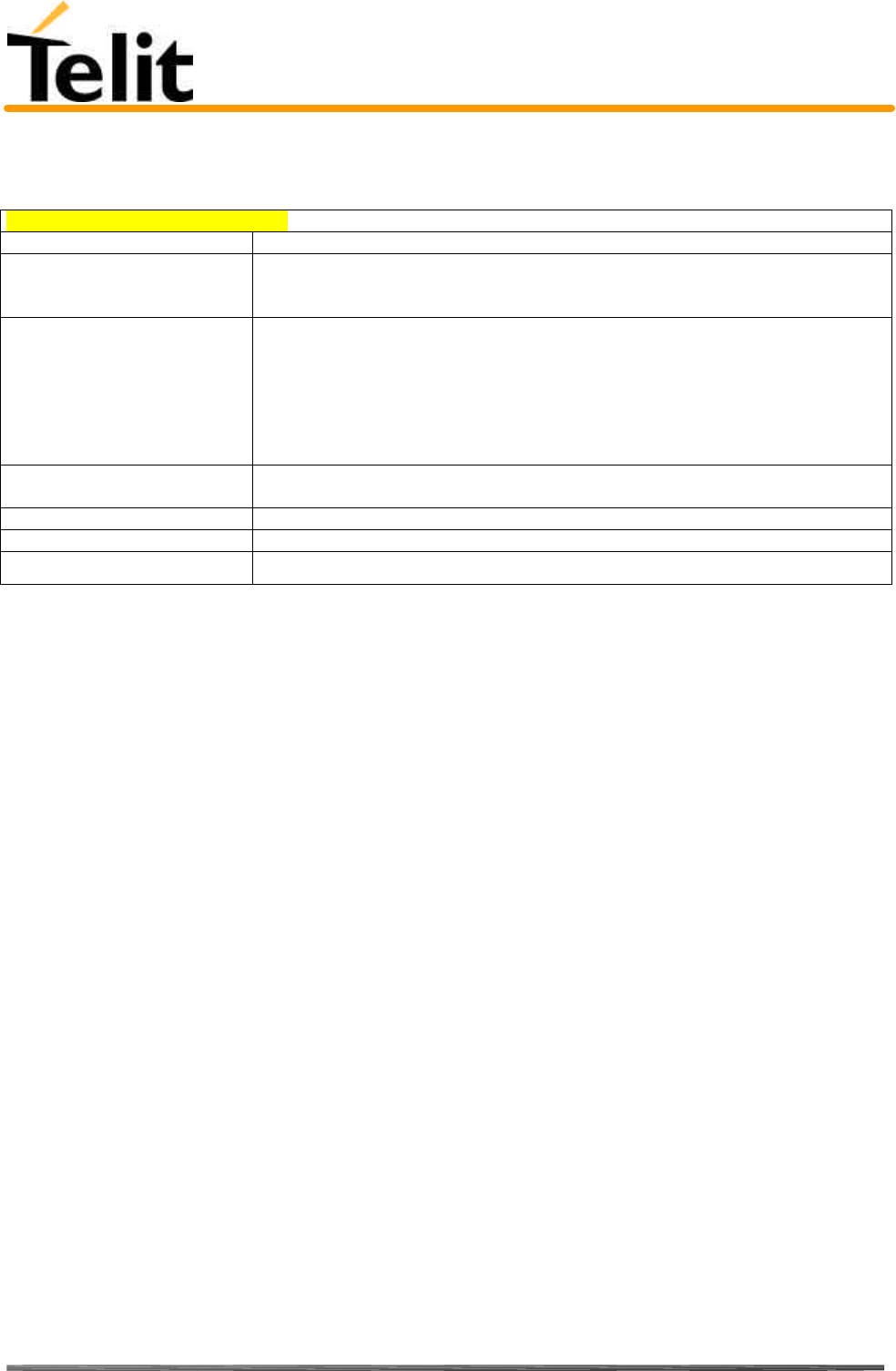
Telit TRIZIUM Product Description
80264ST10007a Rev. 4– 09/09/04
Reproduction forbidden without DAI Telecom written authorization – All Right reserved – Right of modification reserved page 108 of 202
5.4.4.14 +CMUT - microphone mute control
+CMUT – microphone mute control
Execute command
Read command
AT+CMUT? Reports the selected microphone (internal/external) mute status in the format:
+CMUT: <n>
Write command
AT+CMUT = <n> Enables/disables the muting of the microphone audio line depending on n parameter
value
Parameter:
<n > = 0 - microphone active
<n > = 1 - microphone muted
Note: this command mutes/activates both microphone audio paths, internal mic and
external mic.
Test command
AT+CMUT=? Reports the supported values for <n> parameter.
Example
Reference GSM 07.07
SW release Version A
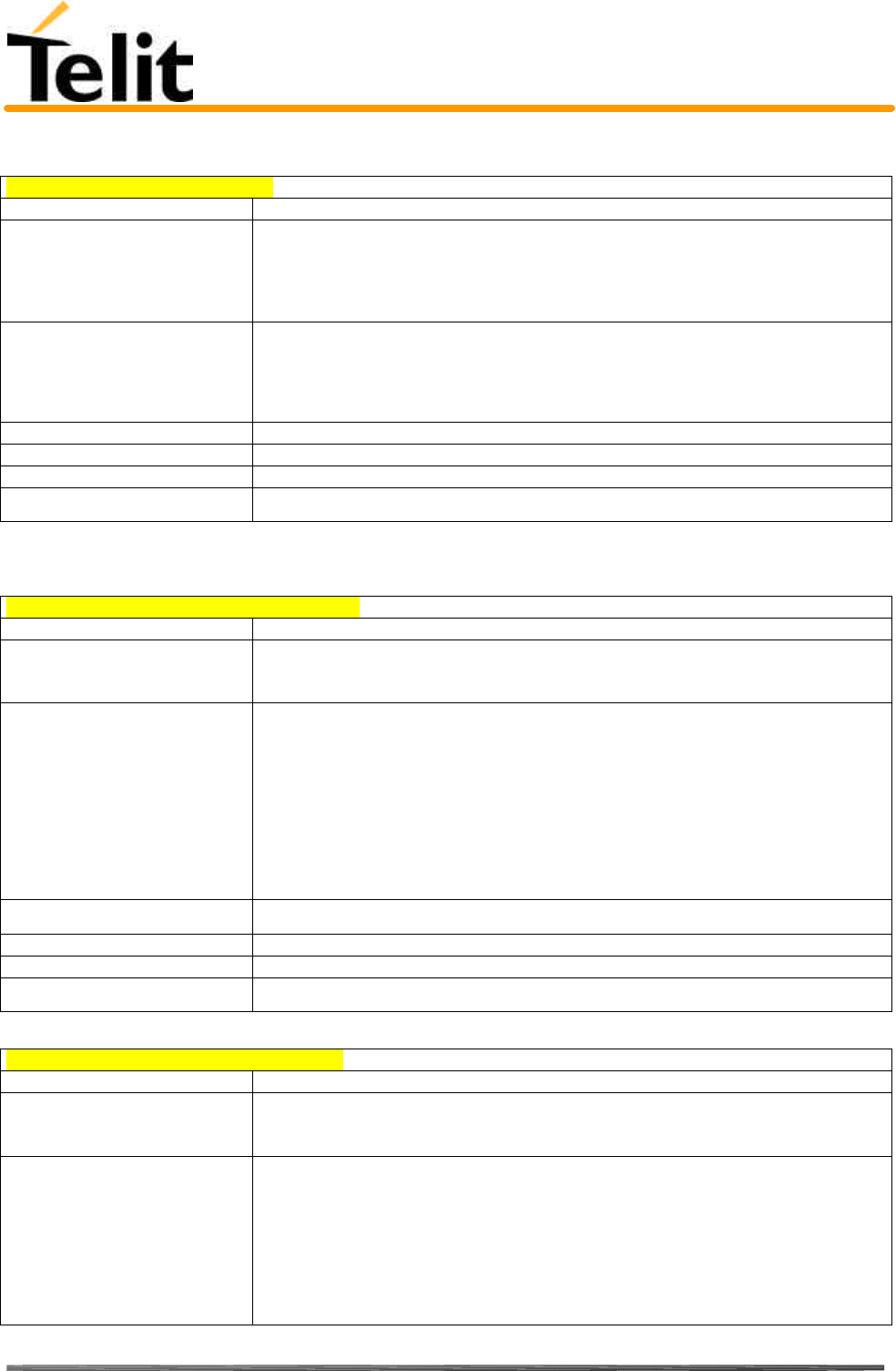
Telit TRIZIUM Product Description
80264ST10007a Rev. 4– 09/09/04
Reproduction forbidden without DAI Telecom written authorization – All Right reserved – Right of modification reserved page 109 of 202
5.4.4.15 +CACM - accumulated call meter
+CACM – accumulated call meter
Execute command
Read command
AT+CACM? Reports the current value of the SIM ACM in the format
+CACM: <n>
Note: the value <n> is in units whose price and currency is defined with command
+CPUC
Write command
AT+CACM = <pwd> Resets the SIM Accumulated Call Meter (ACM). Internal memory CCM remains
unchanged.
Parameter: <pwd> - PIN2 password
Note: to access this command PIN2 password is required
Test command
Example
Reference GSM 07.07
SW release Version A
5.4.4.16 +CAMM - accumulated call meter maximum
+CAMM – accumulated call meter maximum
Execute command
Read command
AT+CAMM? Reports the maximum value of ACM stored in SIM in the format:
+CAMM : <acmmax>
Write command
AT+CAMM = <acmmax>,
<pwd> Sets the Advice of Charge related Accumulated Call Meter ACM maximum value
in SIM (see also +CACM command). This value represents the maximum number
of home units allowed to be consumed by the subscriber. When ACM reaches
<acmmax> value further calls are prohibited. SIM PIN2 is required to set the value.
Parameter:
<acmmax>- maximum number of units allowed to be consumed
<pwd>- PIN2 password
Note: The <acmmax> = 0 value disables the feature.
Test command
Example
Reference GSM 07.07
SW release Version A
5.4.4.17 +CPUC - price per unit and currency table
+CPUC – price per unit and currency table
Execute command
Read command
AT+CPUC? Reports the current values of <currency> and <ppu> parameters in the format:
+CACM : <currency>,<ppu>
Write command
AT+CPUC = <currency>,
<ppu>,<pwd> Sets the values of Advice of Charge related price per unit and currency
table in SIM. The price per Unit currency table information can be used to
convert the home units (as used in commands +CAOC, +CACM and
+CAMM) into currency units.
Parameters:
<currency> - three-character currency code string (e.g. LIT, USD, DEM etc..)
<ppu> - price per unit string (dot is used as decimal separator) e.g. 1989.27
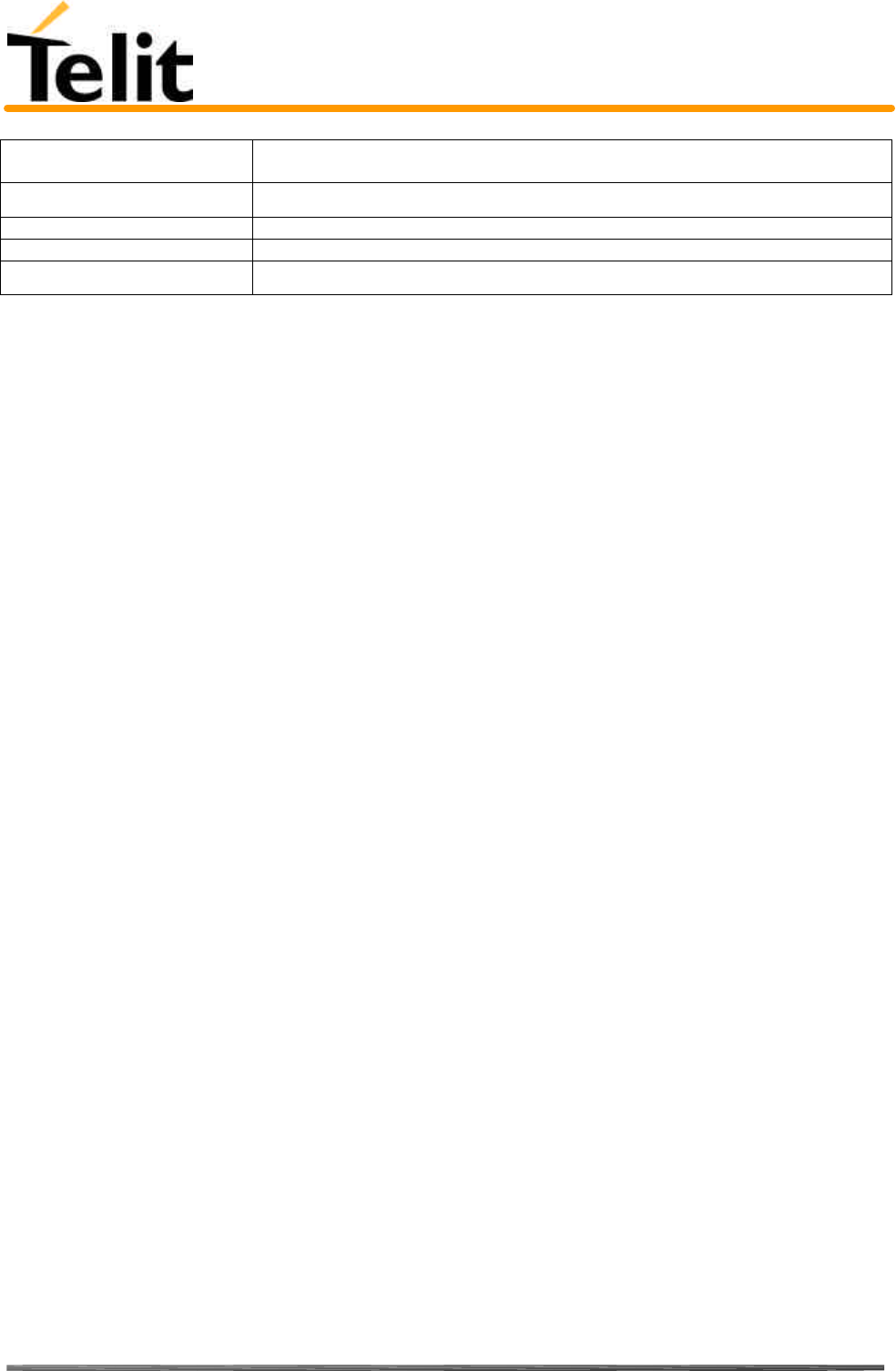
Telit TRIZIUM Product Description
80264ST10007a Rev. 4– 09/09/04
Reproduction forbidden without DAI Telecom written authorization – All Right reserved – Right of modification reserved page 110 of 202
<pwd> - SIM PIN2
Note: SIM PIN2 is required to set the values.
Test command
Example
Reference GSM 07.07
SW release Version A
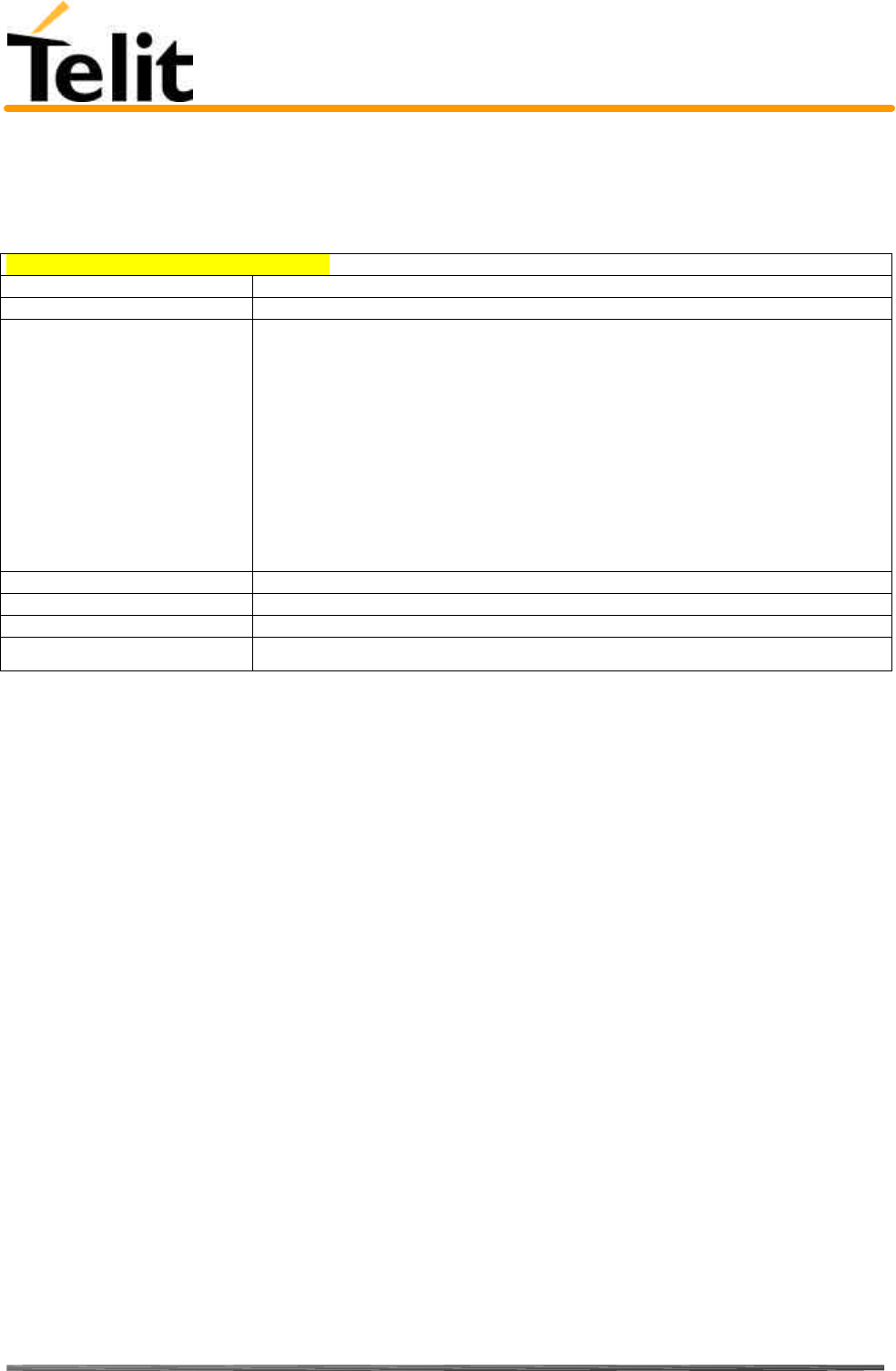
Telit TRIZIUM Product Description
80264ST10007a Rev. 4– 09/09/04
Reproduction forbidden without DAI Telecom written authorization – All Right reserved – Right of modification reserved page 111 of 202
5.4.5 Mobile equipment errors
5.4.5.1 +CMEE - report mobile equipment error
+CMEE – report mobile equipment error
Execute command
Read command
Write command
AT+CMEE = <n> Enables/disables the report of result code.
+CME ERROR: <err>
as an indication of an error relating to the +Cxxx commands issued. When enabled,
device related errors cause the +CME ERROR: <err> final result code instead of the
default ERROR final result code. ERROR is anyway returned normally when the
error message is related to syntax, invalid parameters, or DTE functionality.
Parameter:
<n> - enable flag
<n> = 0 - disable +CME ERROR:<err> reports, use only ERROR report.
<n> = 1 - enable +CME ERROR:<err> reports, with <err> in numeric format
<n> = 2 - disable +CME ERROR: <err> reports, with <err> in verbose format
Test command
Example
Reference GSM 07.07
SW release Version A

Telit TRIZIUM Product Description
80264ST10007a Rev. 4– 09/09/04
Reproduction forbidden without DAI Telecom written authorization – All Right reserved – Right of modification reserved page 112 of 202
5.4.5.2 +CME ERROR: - ME error result code
This is NOT a command, it is the error response to +Cxxx GSM 07.07 commands.
Syntax: AT+CME ERROR:<err>
Parameter: <err> - error code can be either numeric or verbose.
<err> values:
Numeric Format Verbose Format
0 phone failure
1 no connection to phone
2 phone-adaptor link reserved
3 operation not allowed
4 operation not supported
5 PH-SIM PIN required
6 NOT SUPPORTED
7 NOT SUPPORTED
10 SIM not inserted
11 SIM PIN required
12 SIM PUK required
13 SIM failure
14 SIM busy
15 SIM wrong
16 incorrect password
17 SIM PIN2 required
18 SIM PUK2 required
20 memory full
21 invalid index
22 not found
23 memory failure
24 text string too long
25 invalid characters in text string
26 dial string too long
27 invalid characters in dial string
30 no network service
31 network timeout
32 network not allowed - emergency calls only
40 network personalization PIN required
41 network personalization PUK required
42 network subset personalization PIN required
43 network subset personalization PUK required
44 service provider personalization PIN required
45 service provider personalization PUK required
46 corporate personalization PIN required
47 corporate personalization PUK required
100 unknown
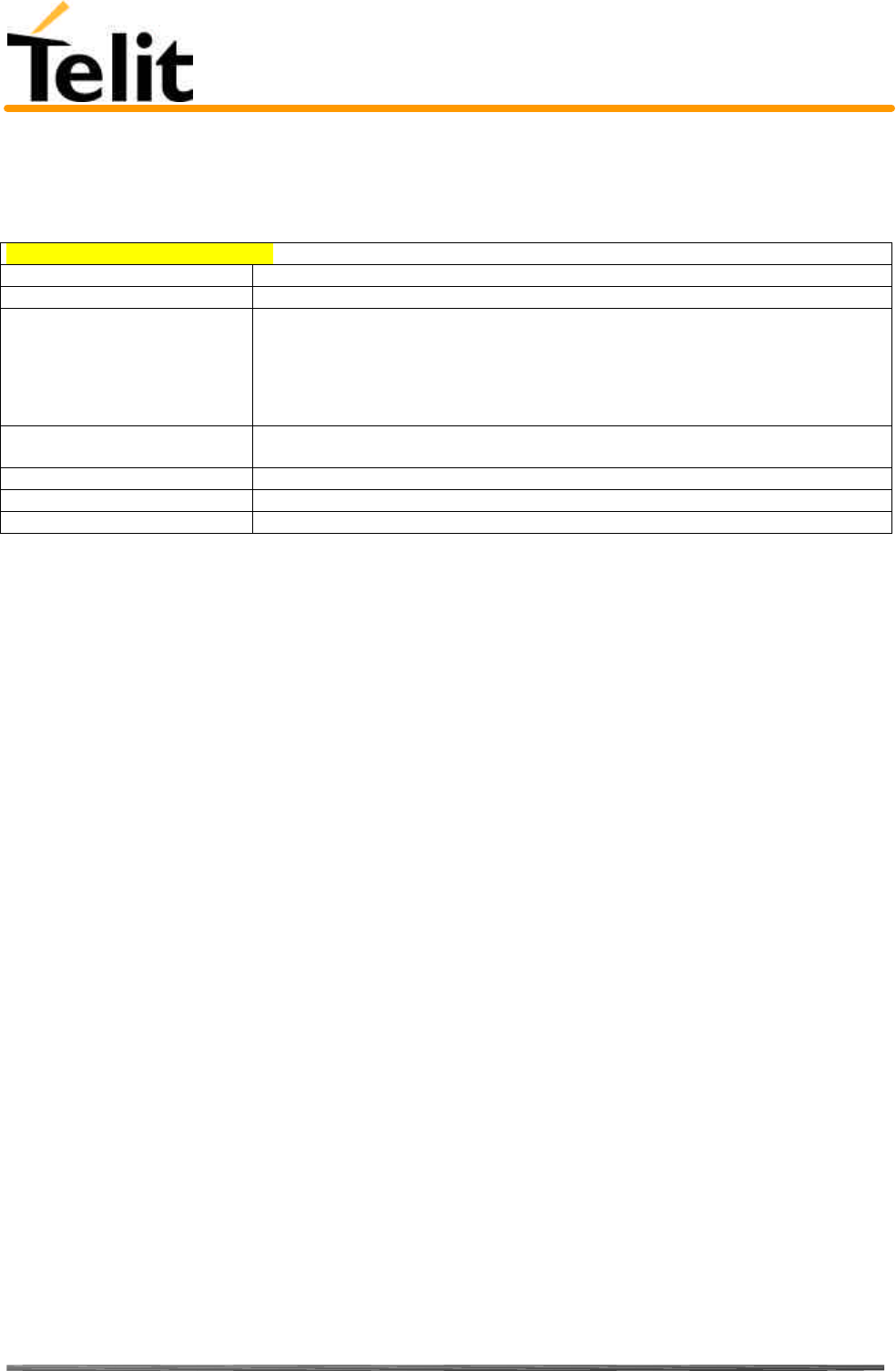
Telit TRIZIUM Product Description
80264ST10007a Rev. 4– 09/09/04
Reproduction forbidden without DAI Telecom written authorization – All Right reserved – Right of modification reserved page 113 of 202
5.4.6 Voice Control (TIA IS-101)
5.4.6.1 +VTS: - DTMF tones transmission
+VTS – DTMF tones transmission
Execute command
Read command
Write command
AT+VTS = <DTMF> Allows the transmission of DTMF tones
Parameter:
<DTMF> - a single ASCII character in the set 0-9, #,*,A-D
Note: this commands operates in voice mode only
Test command AT+VTS=? Returns +VTS(),(),()
Example
Reference GSM 07.07 / TIA IS-101
SW release Version A
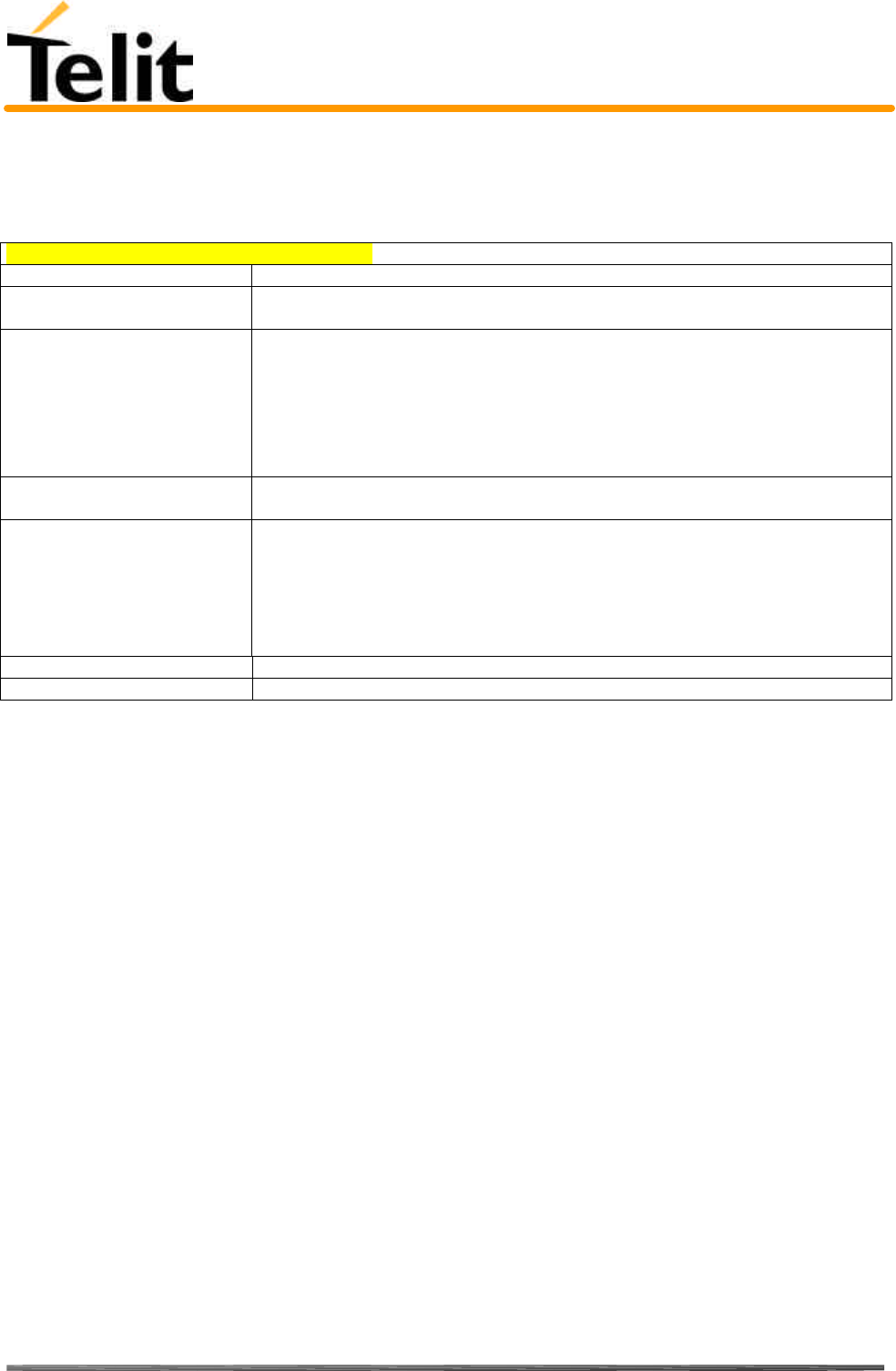
Telit TRIZIUM Product Description
80264ST10007a Rev. 4– 09/09/04
Reproduction forbidden without DAI Telecom written authorization – All Right reserved – Right of modification reserved page 114 of 202
5.4.7 Commands For GPRS
5.4.7.1 +CGACT - PDP context activate or deactivate
+ CGACT – PDP context activate or deactivate
Execute command
Read command
AT+CGACT? Returns the current activation states for all the defined PDP contexts.
Write command
AT+CGACT = <state>[,
<cid>[, <cid>[,…]]]]
The command is used to activate or deactivate the specified PDP context (s)
Parameters:
<state> - indicates the state of PDP context activation
0 - deactivated
1 - activated
<cid> - a numeric parameter which specifies a particular PDP context definition
(see +CGDCONT command)
Test command
AT+CGACT=? Reports information on the supported PDP context activation states parameters in the
format: +CGACT: (0,1)
Example AT+CGACT?
+CGACT: 1,1
OK
AT+CGACT=1,1
OK
Reference GSM 07.07
SW release Version A
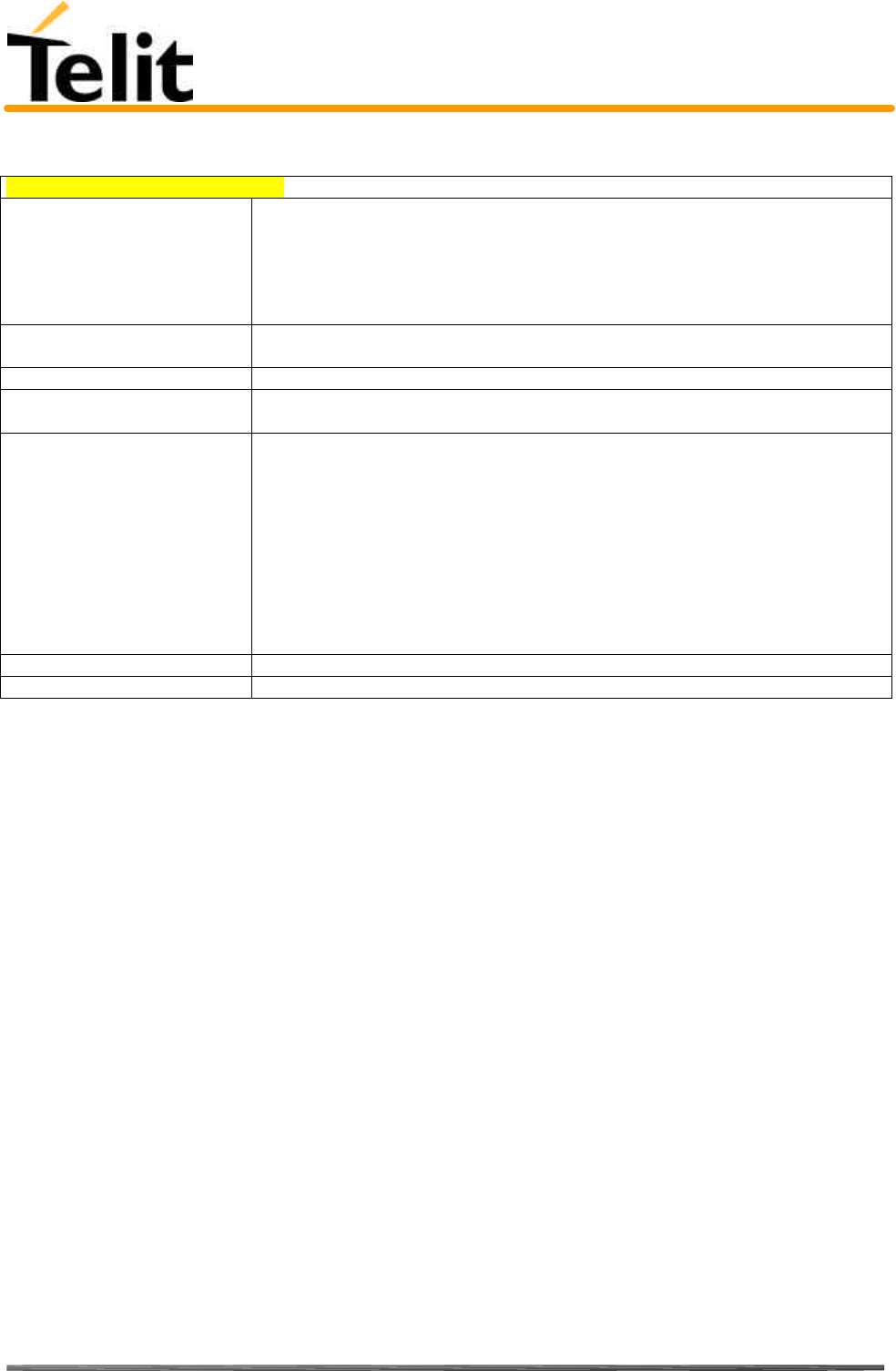
Telit TRIZIUM Product Description
80264ST10007a Rev. 4– 09/09/04
Reproduction forbidden without DAI Telecom written authorization – All Right reserved – Right of modification reserved page 115 of 202
5.4.7.2 +CGATT - GPRS attach or detach
+ CGATT – GPRS attach or detach
Execute command
AT+CGATT = <state> The command is used to attach the terminal to, or detach the terminal from, the GPRS
service depending on the parameter <state>.
Parameter:
<state> - indicates the state of GPRS attachment
0 - detached
1 - attached
Read command
AT+CGATT? Returns the current GPRS service state.
Write command
Test command
AT+CGATT=? Requests information on the supported GPRS service states.
Example AT+CGATT?
+CGATT: 0
OK
AT+CGATT=?
+CGATT: (0,1)
OK
AT+CGATT=1
OK
Reference GSM 07.07
SW release Version A
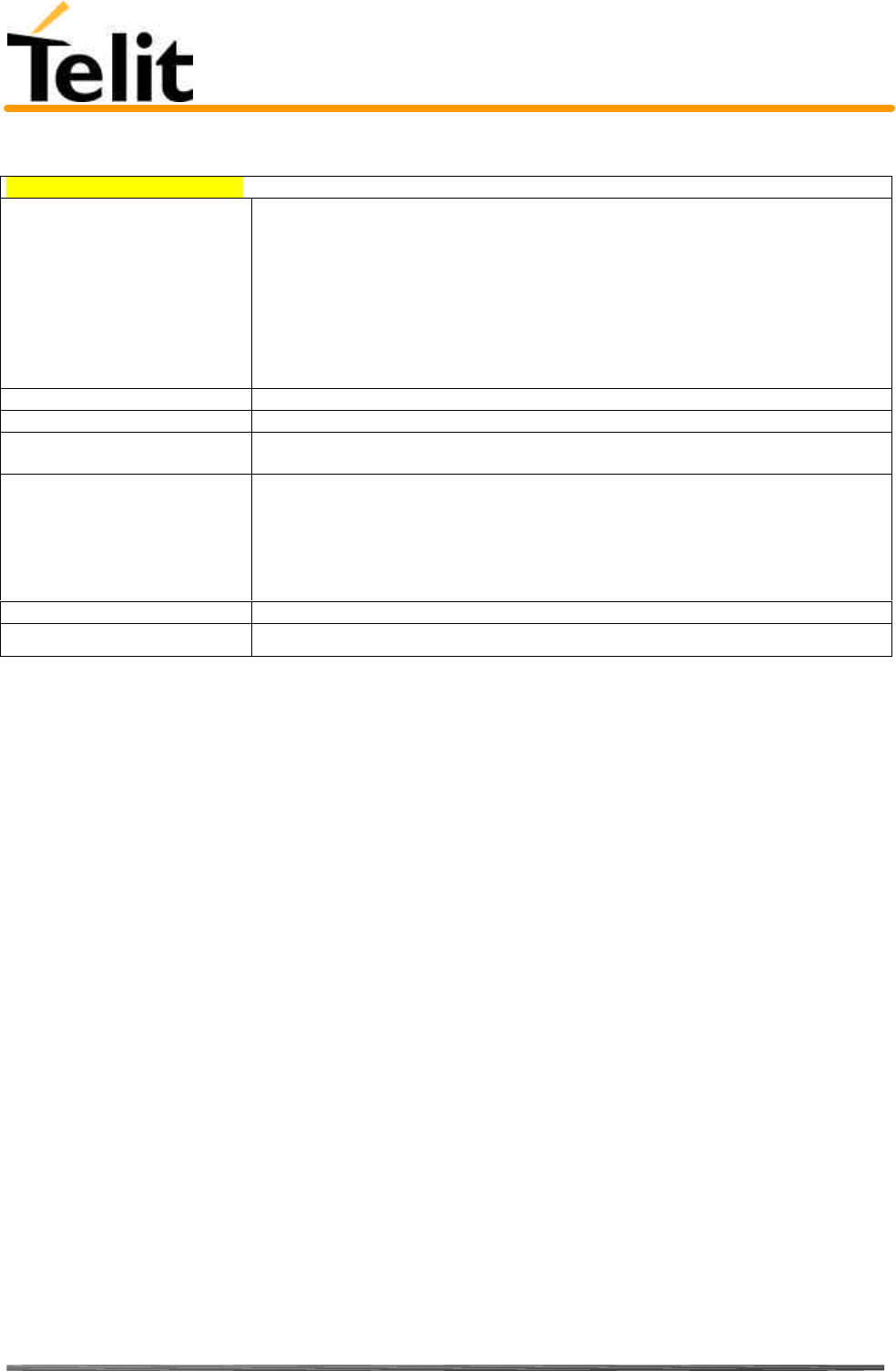
Telit TRIZIUM Product Description
80264ST10007a Rev. 4– 09/09/04
Reproduction forbidden without DAI Telecom written authorization – All Right reserved – Right of modification reserved page 116 of 202
5.4.7.3 +CGDATA - Enter data state
+ CGDATA – Enter data state
Execute command
AT+CGDATA = [<L2P>
,[<cid> [,<cid> [,…]]]]
The command causes to perform whatever actions are necessary to establish
communication with the network using one or more GPRS PDP types.
Parameters:
<L2P> - string parameter that indicates the layer 2 protocol to be used
"PPP" - PPP Point-to-point protocol
If the value is omitted, the layer 2 protocol is unspecified
<cid> - numeric parameter which specifies a particular PDP context definition (see
+CGDCONT command).
Read command
Write command
Test command
AT+CGDATA=? Requests information on the supported layer 2 protocols.
Reports the supported <L2P> parameters values
Example AT+CGDATA=?
+CGDATA: (”PPP”)
OK
AT+CGDATA=”PPP”,1
OK
Reference GSM 07.07
SW release Version A
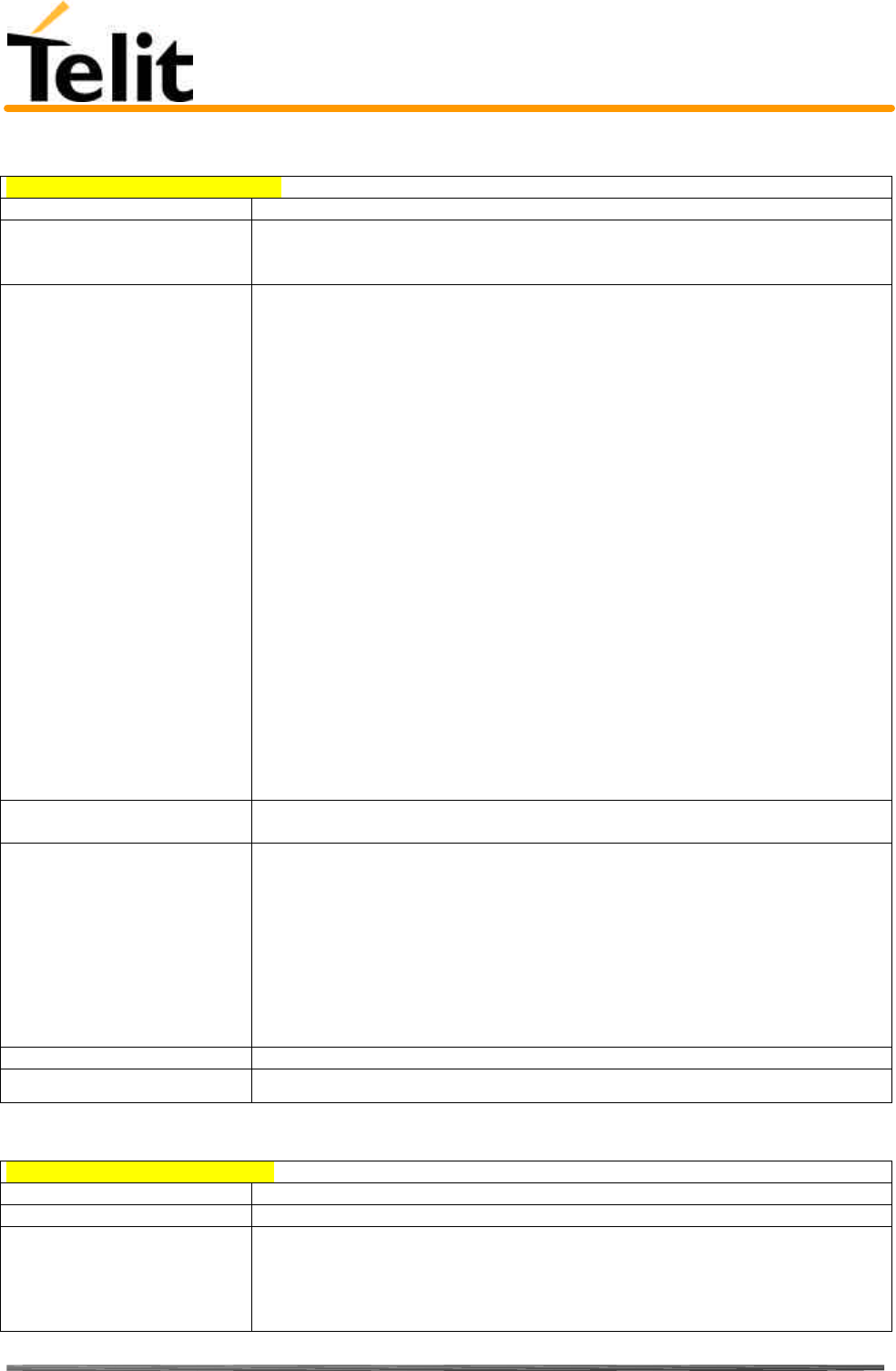
Telit TRIZIUM Product Description
80264ST10007a Rev. 4– 09/09/04
Reproduction forbidden without DAI Telecom written authorization – All Right reserved – Right of modification reserved page 117 of 202
5.4.7.4 +CGDCONT - define PDP context
+ CGDCONT – define PDP context
Execute command
Read command
AT+CGDCONT? Returns the current settings for each defined context in the format:
+CGDCONT : <cid>,<PDP_type>,<APN>,<PDP_addr>,
<d_comp>,<h_comp>,<pd1> [,…[,pdN]]]]]]]]]
Write command
AT+CGDCONT = [<cid>
[,<PDP_type>
[,<APN>[,<PDP_addr>,
<d_comp>
[,<h_comp>[,<pd1>
[,…[,pdN]]]]]]]]]
The command specifies PDP context parameter values for a PDP context identified
by the (local) context identification parameter, <cid>
Parameters:
<cid> (PDP Context Identifier) : a numeric parameter which specifies a particular
PDP context definition. The range of permitted values (minimum value = 1) is
returned by the test form of the command.
<PDP_type> (Packet Data Protocol type) : a string parameter which specifies the
type of packet data protocol
"IP" - Internet Protocol
"PPP" - Point to Point Protocol
<APN> (Access Point Name) : a string parameter which is a logical name that is used
to select the GGSN or the external packet data network.
If the value is null or omitted, then the subscription value will be requested.
<PDP_address>: a string parameter that identifies the terminal in the address
space applicable to the PDP. The allocated address may be read using the
+CGPADDR command.
<d_comp>: a numeric parameter that controls PDP data compression
0 - off (default if value is omitted)
1 - on
<h_comp>: a numeric parameter that controls PDP header compression
0 - off (default if value is omitted)
1 - on
<pd1>, … <pdN>: zero to N string parameters whose meanings are specific to the
<PDP_type>
Test command
AT+CGDCONT=? Returns values supported as a compound value
Example AT+CGDCONT?
+CGDCONT: 1, ”IP”, ”uni.tim.it”, ”10.10.10.10”,0,0
OK
AT+CGDCONT=?
+CGDCONT: (1-3),”IP”,,,(0-1),(0-1)
OK
AT+CGDCONT=1, ”IP”, ”uni.tim.it”, ”10.10.10.10”,0,0
OK
Reference GSM 07.07
SW release Version A
5.4.7.5 +CGPADDR - show PDP address
+ CGPADDR – show PDP address
Execute command
Read command
Write command
AT+CGPADDR = [<cid>
[,<cid> [,…]]]
Returns a list of PDP addresses for the specified context identifiers in the format:
+CGPADDR: <cid>,<PDP_addr>
[<CR><LF>+CGPADDR: <cid>,<PDP_addr>]
Parameters:
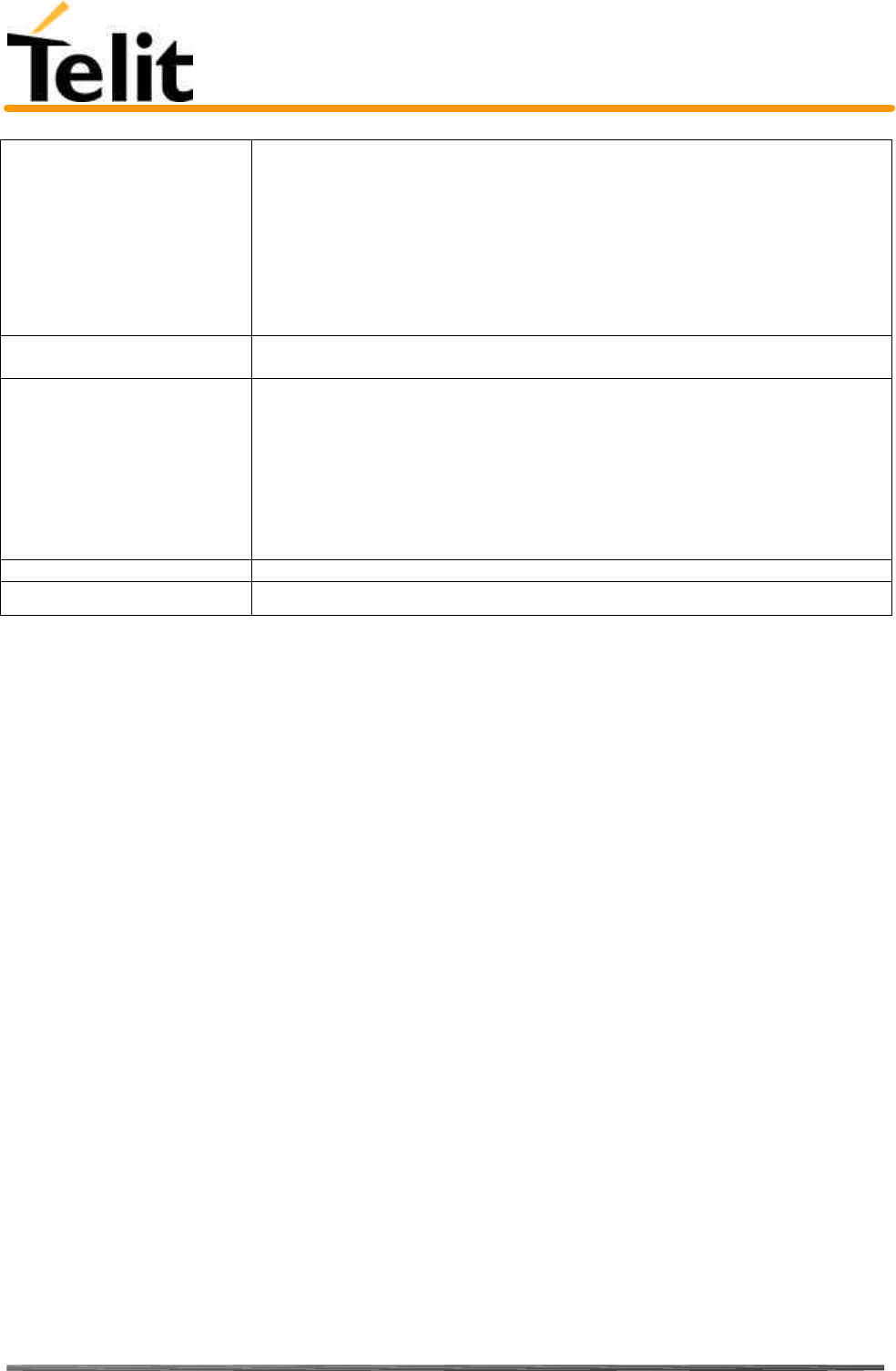
Telit TRIZIUM Product Description
80264ST10007a Rev. 4– 09/09/04
Reproduction forbidden without DAI Telecom written authorization – All Right reserved – Right of modification reserved page 118 of 202
<cid> - a numeric parameter which specifies a particular PDP context definition
(see +CGDCONT command). If no <cid> is specified, the addresses for all defined
contexts are returned.
<PDP_address> - a string that identifies the terminal in the address space
applicable to the PDP. The address may be static or dynamic. For a static address, it
will be the one set by the +CGDCONT command when the context was defined. For
a dynamic address it will be the one assigned during the last PDP context activation
that used the context definition referred to by <cid>,<PDP_addr> is omitted if
none is available
Test command
AT+CGPADDR=? Returns a list of defined <cid>s.
Example AT+CGPADDR=1,2
+CGPADDR = 1,”10.10.15.15”
+CGPADDR = 2,”10.10.20.10”
OK
AT+CGPADDR=?
+CGPADDR: (1-3)
OK
Reference GSM 07.07
SW release Version A
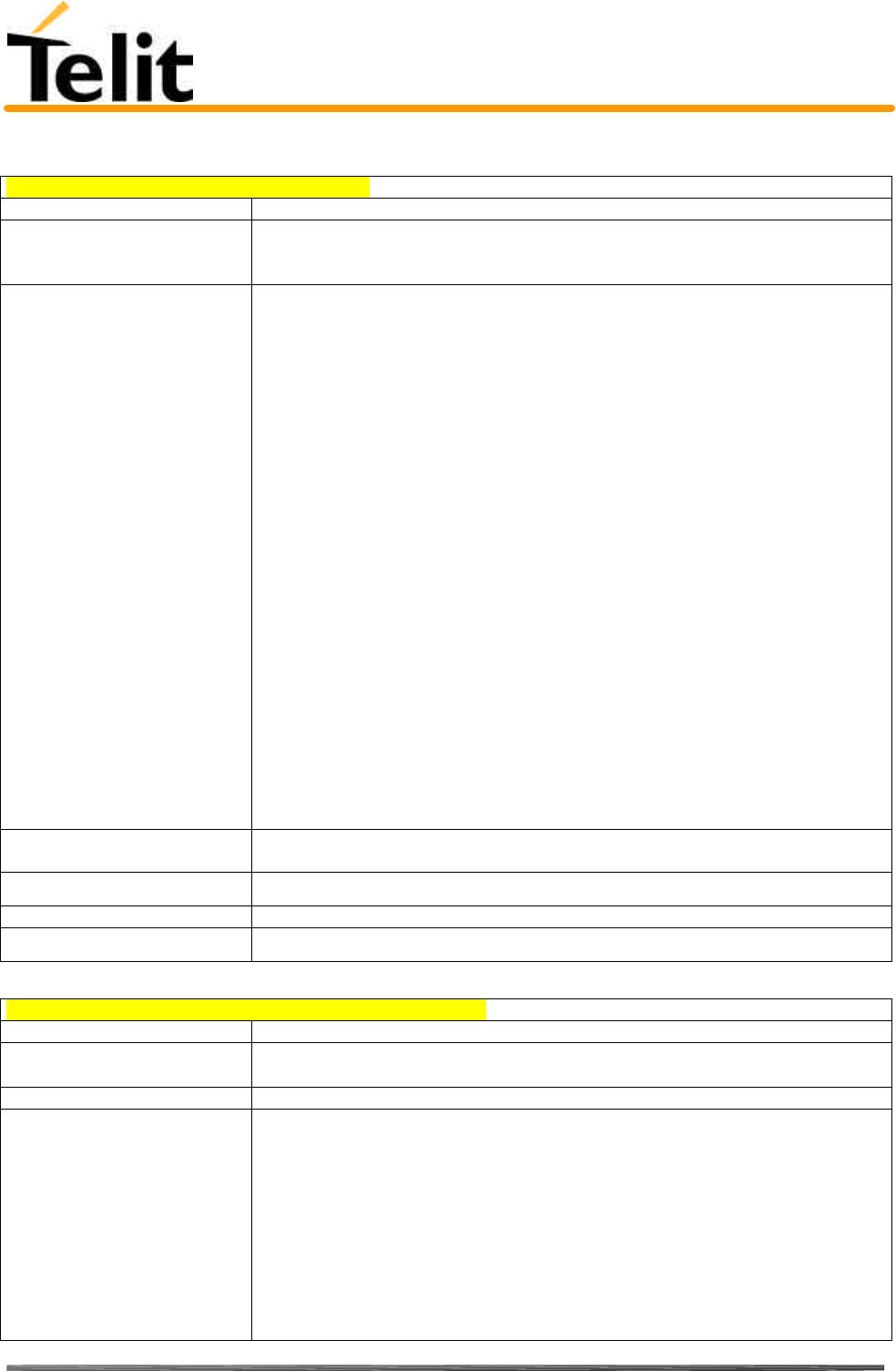
Telit TRIZIUM Product Description
80264ST10007a Rev. 4– 09/09/04
Reproduction forbidden without DAI Telecom written authorization – All Right reserved – Right of modification reserved page 119 of 202
5.4.7.6 +CGREG - GPRS network registration status
+ CGREG – GPRS network registration status
Execute command
Read command
AT+CGREG? Returns the status of result code presentation mode <n> and the integer <stat> which
shows whether the network has currently indicated the registration of the terminal in
the format: +CGREG:<n>,<stat>.
Write command
AT+CGREG = <n> The command controls the presentation of an unsolicited result code +CGREG:
<stat>
when <n>=1 and there is a change in the terminal GPRS network registration status,
or an unsolicited code
+CGREG: <stat>[,<lac>,<ci>]
when <n>=2 and there is a change of the network cell.
Parameter:
<n> - result code presentation mode
0 - disable network registration unsolicited result code
1 - enable network registration unsolicited result code
+CGREG: <stat>
2 - enable network registration and location information unsolicited
result code +CGREG:<stat>[,<lac>,<ci>]
where:
<lac> - location area code in hexadecimal format
(e.g. "00C3" equals 195 in decimal)
<ci> - cell ID in hexadecimal format
<stat> - registration status
0 - not registered, terminal is not currently searching a new operator
to register to
1 - registered, home network
2 - not registered, but terminal is currently searching a new operator
to register to
3 - registration denied
4 - unknown
5 - registered, roaming
Test command
AT+CGREG=? Returns supported values for parameter <n>
Example
Reference GSM 07.07
SW release Future Software Release
5.4.7.7 +CGQMIN - quality of service profile (minimum acceptable)
+ CGQMIN – quality of service profile (minimum acceptable)
Execute command
Read command
AT+CGQMIN? Returns the current settings for each defined context in the format:
+CGQMIN: <cid>,<precedence>,<delay>,<reliability>,<peak>,<mean>
Example
Write command
AT+CGQMIN = [<cid>
[,<precedence > [,<delay>
[,<reliability> [,<peak>
[,<mean>]]]]]]
This command allows to specify a minimum acceptable profile which is checked by
the terminal against the negotiated profile returned in the Activate PDP Context
Accept message
Parameters:
<cid> - PDP context identification (see +CGDCONT command).
The following parameters are defined according to GSM 03.60:
<precedence> - precedence class
<delay> - delay class
<reliability> - reliability class
<peak> - peak throughput class
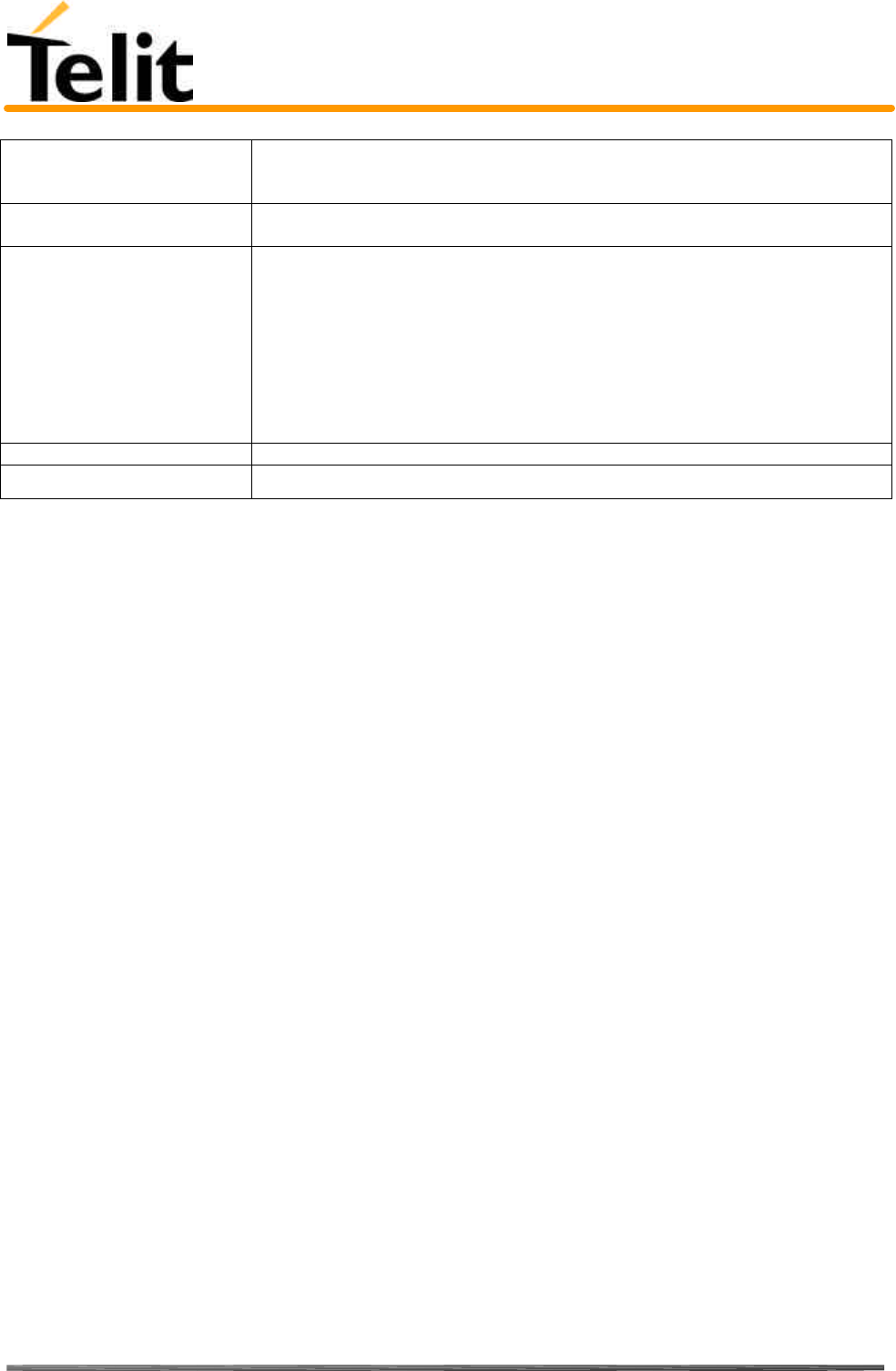
Telit TRIZIUM Product Description
80264ST10007a Rev. 4– 09/09/04
Reproduction forbidden without DAI Telecom written authorization – All Right reserved – Right of modification reserved page 120 of 202
<mean> - mean throughput class
If a value is omitted for a particular class then this class is not checked.
Test command
AT+CGQMIN=? Returns values supported as a compound value.
Example AT+CGQMIN=1,0,0,3,0,0
OK
AT+CGQMIN?
+CGQMIN: 1,0,0,5,0,0
OK
AT+CGQMIN=?
+CGQMIN: (0-3),(0-3),(0-5),(0-9),(0-19,31)
OK
Reference GSM 07.07
SW release Version A
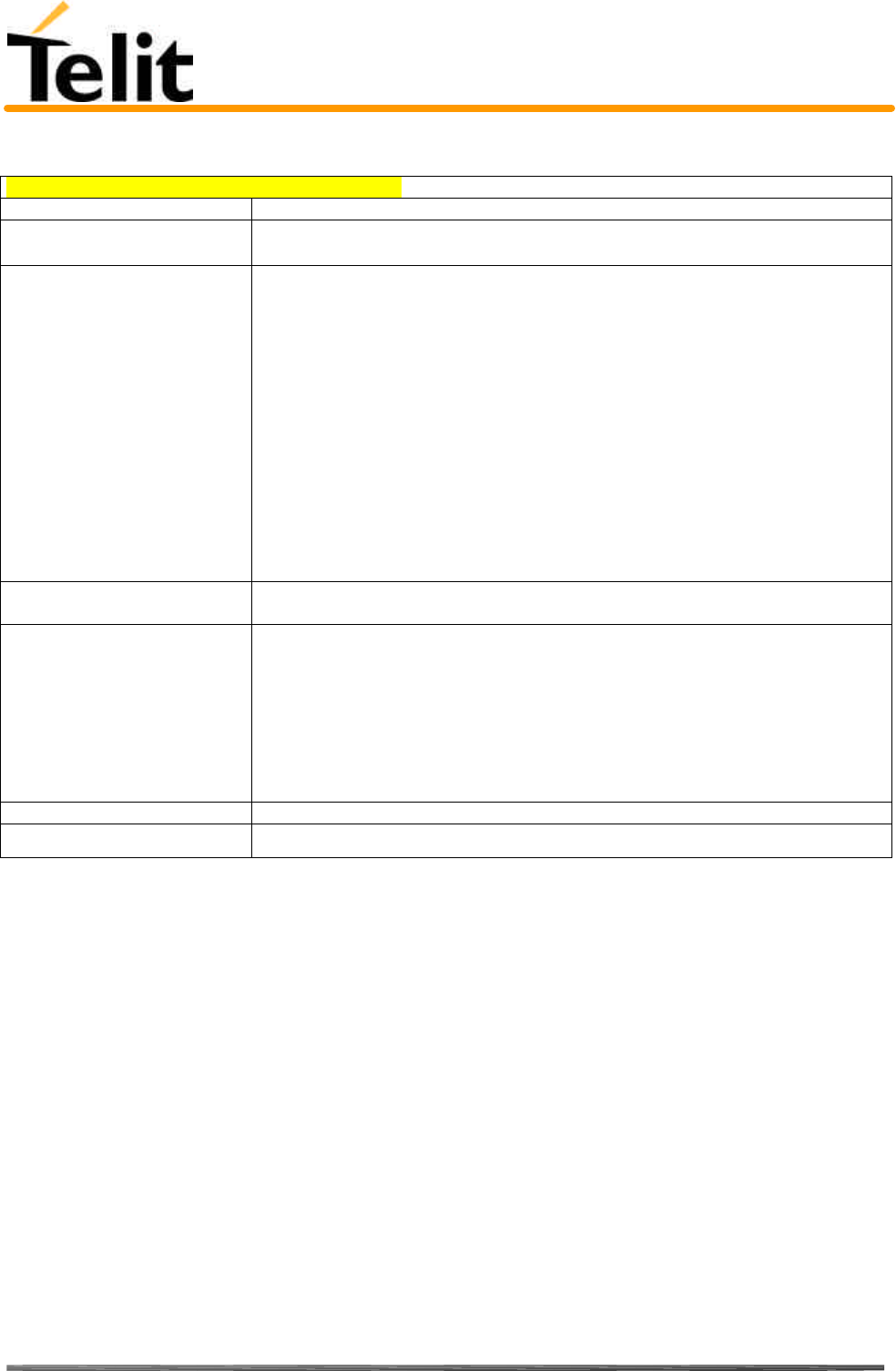
Telit TRIZIUM Product Description
80264ST10007a Rev. 4– 09/09/04
Reproduction forbidden without DAI Telecom written authorization – All Right reserved – Right of modification reserved page 121 of 202
5.4.7.8 +CGQREQ - quality of service profile (requested)
+ CGQREQ – quality of service profile (requested)
Execute command
Read command
AT+CGQREQ? Returns the current settings for each defined context in the format:
+CGQREQ: <cid>,<precedence>,<delay>,<reliability>,<peak>,<mean>
Write command
AT+CGQREQ = [<cid>
[,<precedence > [,<delay>
[,<reliability> [,<peak>
[,<mean>]]]]]]
The command allows to specify a Quality of Service Profile that is used when the
terminal sends an Activate PDP Context Request message to the network. It specifies
a profile for the context identified by the (local) context identification parameter,
<cid>.
Parameters:
<cid> - PDP context identification (see +CGDCONT command).
The following parameters are defined according to GSM 03.60:
<precedence> - precedence class
<delay> - delay class
<reliability> - reliability class
<peak> - peak throughput class
<mean> - mean throughput class
If a value is omitted for a particular class then this class is not checked.
Test command
AT+CGQREQ=? Returns parameter values supported as a compound value.
Example AT+CGQREQ?
+CGQREQ: 1,0,0,3,0,0
OK
AT+CGQREQ=1,0,0,3,0,0
OK
AT+CGQREQ=?
+CGQREQ: (0-3),(0-3),(0-5),(0-9),(0-19,31)
OK
Reference GSM 07.07
SW release Version A
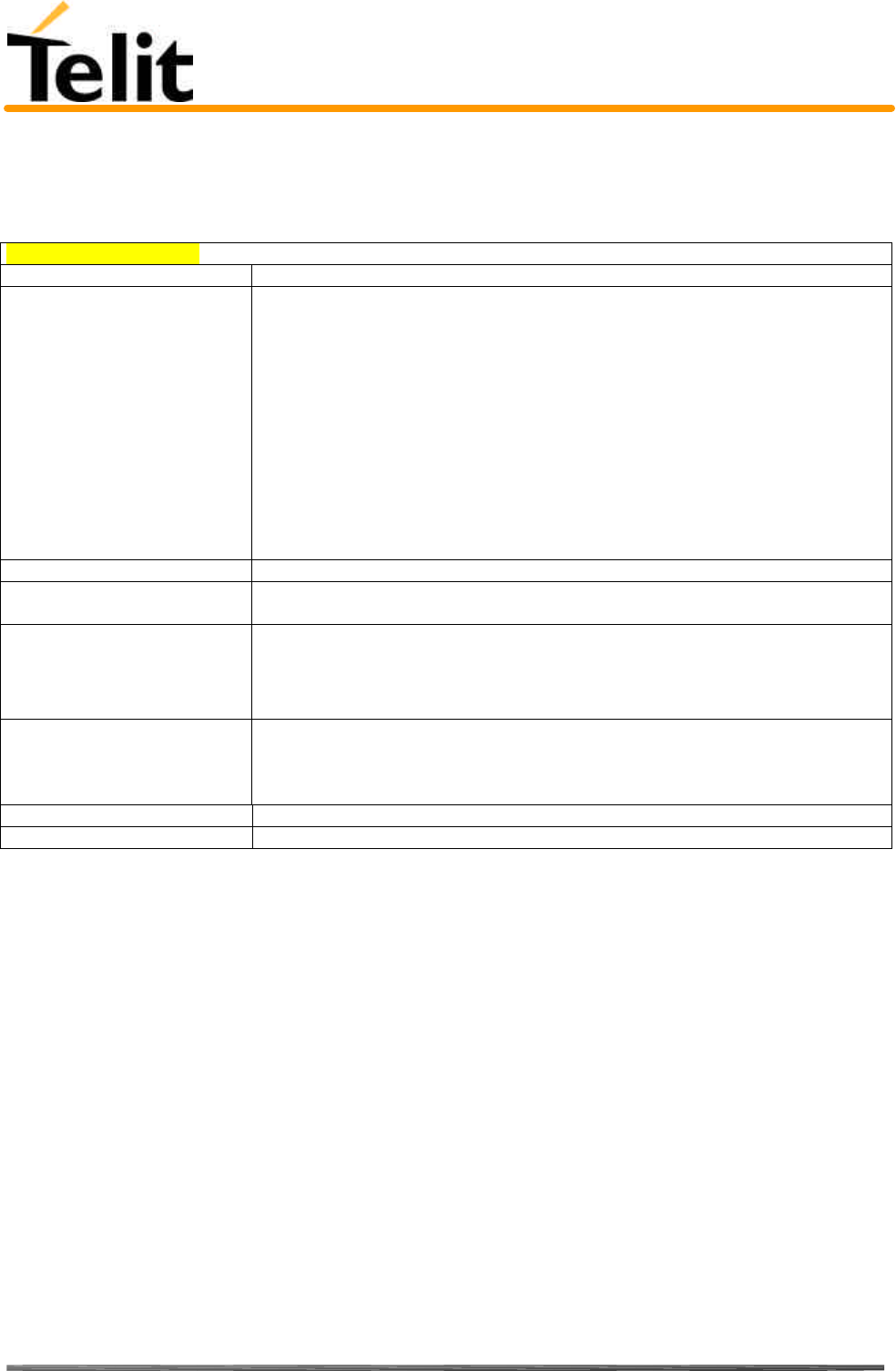
Telit TRIZIUM Product Description
80264ST10007a Rev. 4– 09/09/04
Reproduction forbidden without DAI Telecom written authorization – All Right reserved – Right of modification reserved page 122 of 202
5.4.8 Commands For Battery Charger
5.4.8.1 +CBC - Battery Charge
+ CBC – Battery Charge
Execute command
Read command
AT+CBC Returns the current Battery Charge status in the format:
+CBC: <bcs>,<bcl>
Parameter:
<bcs> - battery status
0 - Me is powered by the battery
<bcl> - battery charge level
0 - battery is exausted, or ME does not have a battery connected
25 - battery charge remained is estimated to be 25%
50 - battery charge remained is estimated to be 50%
75 - battery charge remained is estimated to be 75%
100 - battery is fully charged.
Write command
Test command
AT+CGACT=? Reports information on the supported PDP context activation states parameters in the
format: +CGACT: (0,1)
Example AT+CBC
+CBC: 0,75
OK
NOTE The ME does not make differences between being powered by a
battery or by a power supply on the VBATT pins, so it is not possible
to distinguish between these two cases.
Reference GSM 07.07
SW release Version A
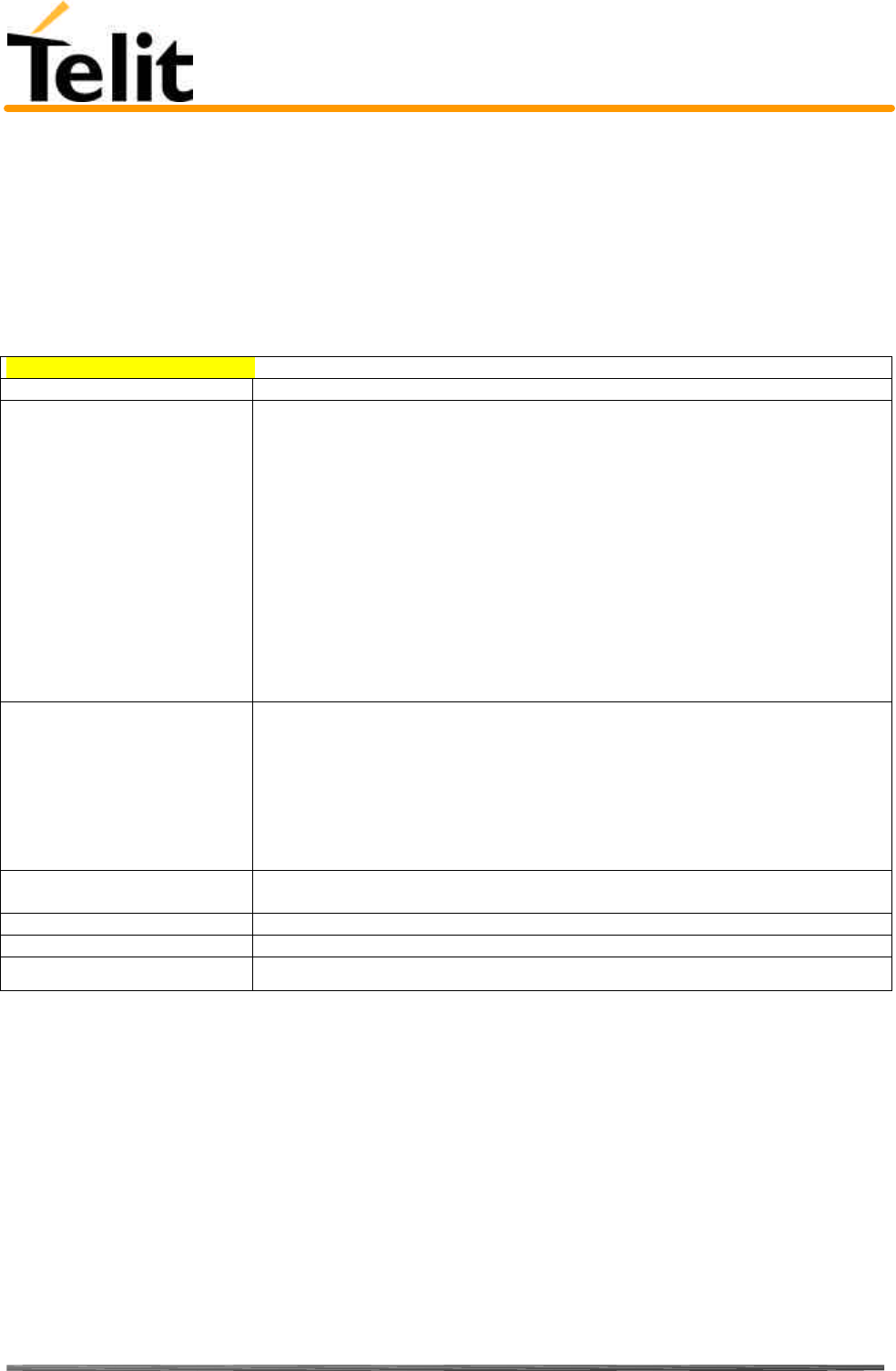
Telit TRIZIUM Product Description
80264ST10007a Rev. 4– 09/09/04
Reproduction forbidden without DAI Telecom written authorization – All Right reserved – Right of modification reserved page 123 of 202
5.5 ETSI GSM 07.05 AT Commands for SMS and
CB services
5.5.1 General configuration
5.5.1.1 +CSMS - select message service
+CSMS – select message service
Execute command
Read command
AT+CSMS? Reports the value of the current parameters in the format:
+CSMS: <service>,<mt>,<mo>,<cb>
where:
<service> - message syntax
0 - SMS syntax as defined in GSM-03.40 and GSM-03.41. AT commands are
compatible with GSM 07.05 Phase 2.
1 - SMS syntax as defined in GSM-03.40 and GSM-03.41. AT commands are
compatible with GSM 07.05 Phase 2+
<mt> - Mobile Terminated Messages
<mo> - Mobile Originated Messages
<cb> - Cell Broadcast Messages
0 - not supported
1 - supported
Write command
AT+CSMS = <service> Selects the SMS & CB services command syntax.
Parameter:
<service> = 0 - SMS syntax as defined in GSM-03.40 and GSM-03.41. AT
commands are compatible with GSM 07.05 Phase 2.
<service> = 1 - SMS syntax as defined in GSM-03.40 and GSM-03.41. AT
commands are compatible with GSM 07.05 Phase 2+
Test command
AT+CSMS=? Reports the supported value of the parameter <service> = 0.
Example
Reference GSM 07.05
SW release Version A
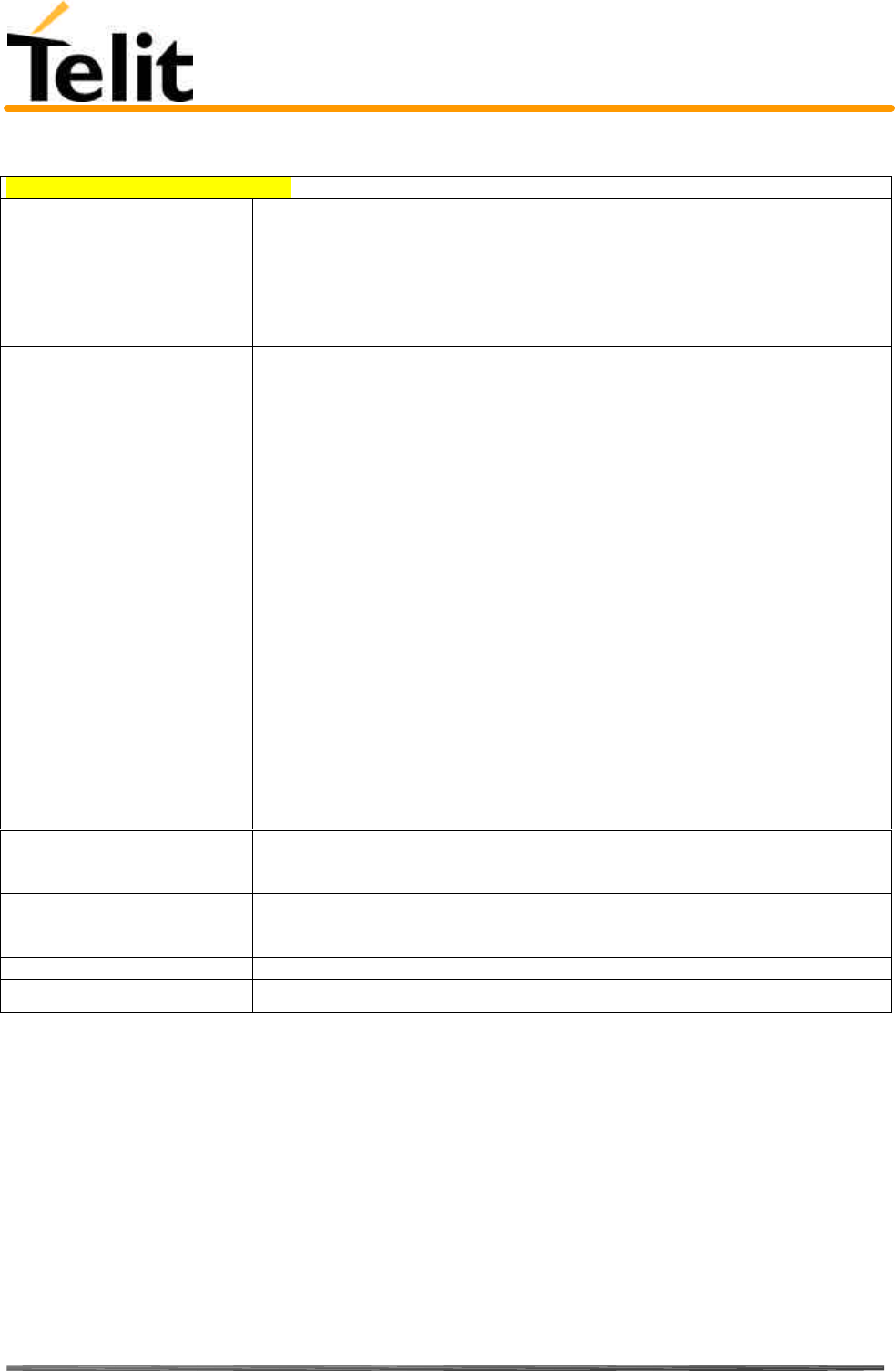
Telit TRIZIUM Product Description
80264ST10007a Rev. 4– 09/09/04
Reproduction forbidden without DAI Telecom written authorization – All Right reserved – Right of modification reserved page 124 of 202
5.5.1.2 +CPMS - preferred message storage
+CPMS – preferred message storage
Execute command
Read command
AT+CPMS? Reports the message storage status in the format:
+CPMS:<memr>,<usedr>,<totalr>,<memw>,<usedw>,<totalw>,<mems>,<useds>,
<totals>
where <memr> , <memw> and <mems> are the selected storage memories for
reading, writing and storing respectively.
Write command
AT+CPMS =
<memr>,<memw>,<mems> Selects memory storages <memr>, <memw> and <mems> to be used for reading,
writing, sending and storing received SMS.
Parameter:
<memr> - memory storage for read and delete SMS commands
"SM" - SIM SMS memory storage
"ME" - Mobile Equipment internal storage (read only, no delete)
<memw> - memory storage for write and send SMS commands
"SM" - SIM SMS memory storage
<mems> - memory storage for received SMS storing
"SM" - SIM SMS memory storage
The command returns the memory storage status in the format:
+CPMS:<usedr>,<totalr>,<usedw>,<totalw>,<useds>,<totals>
<usedr> - number of SMS stored into <memr>
<totalr> - max number of SMS that <memr> can contain
<usedw> - number of SMS stored into <memw>
<totalw> max number of SMS that <memw> can contain
<useds> - number of SMS stored into <mems>
<totals> max number of SMS that <mems> can contain
Note: The only memory storage for writing and sending supported is the SIM internal
memory "SM", so <memw> = <mems> = "SM".
Note: the received class 0 SMS are stored in the "ME" memory regardless the
<mems> setting and they are automatically deleted at power off.
Test command
AT+CPMS=? Reports the supported values of the SMS storage memories in the format: +CPMS:
("ME","SM"), ("SM")
Example AT+CPMS?
+CPMS: "SM",5,10,"SM",5,10,"SM",5,10
OK (you have 5 SMS SIM positions occupied of 10)
Reference GSM 07.05
SW release Version A
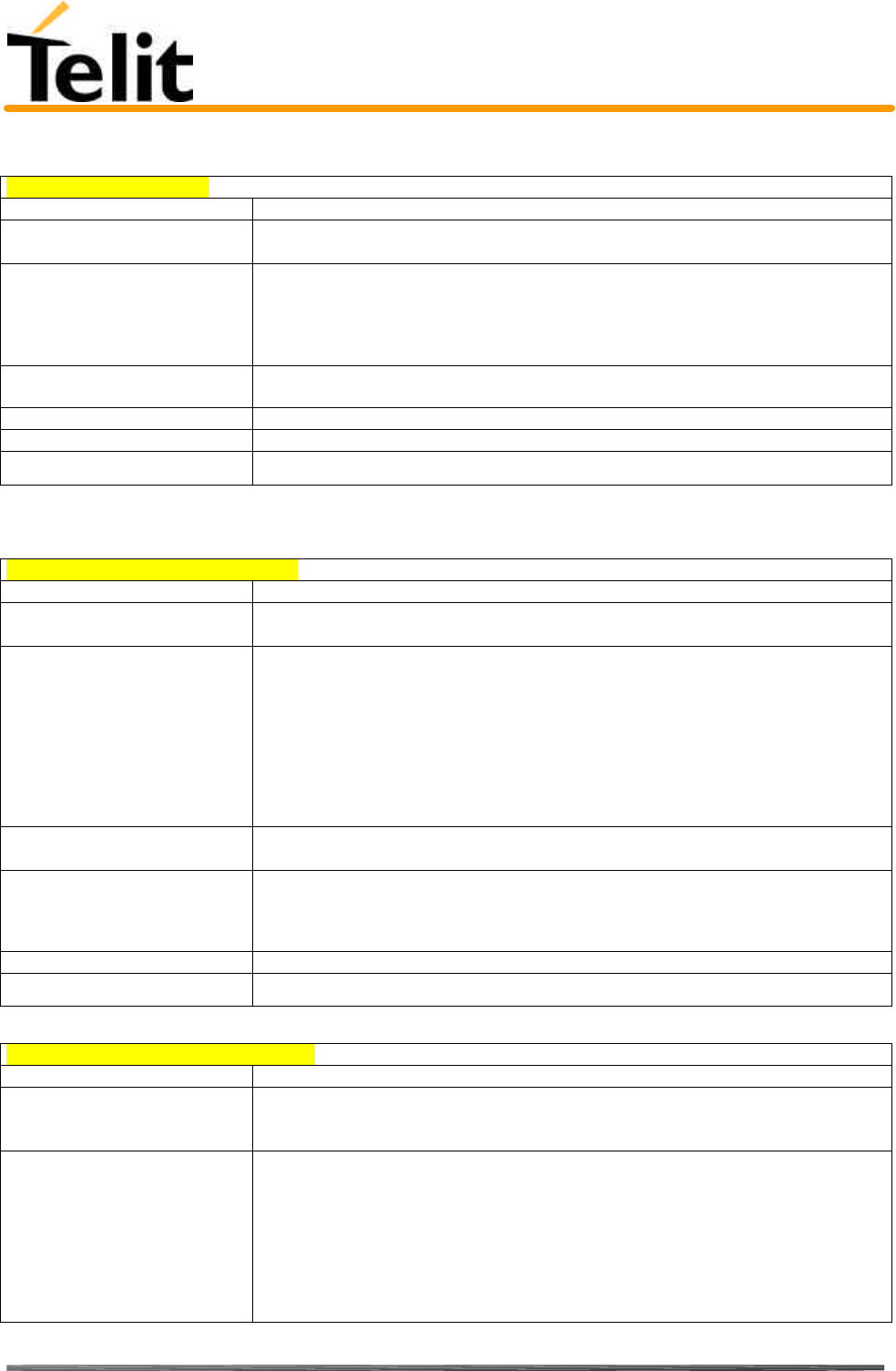
Telit TRIZIUM Product Description
80264ST10007a Rev. 4– 09/09/04
Reproduction forbidden without DAI Telecom written authorization – All Right reserved – Right of modification reserved page 125 of 202
5.5.1.3 +CMGF - message format
+CMGF –message format
Execute command
Read command
AT+CMGF? Reports the current value of the parameter <mode> = 0.
Write command
AT+CMGF = <mode> Selects the SMS format to be used in reading and writing messages.
Parameter:
<mode> = 0 - PDU as defined in GSM 3.40 and GSM 3.41
<mode> = 1 - text
Test command
AT+CMGF=? Reports the supported value of <mode> parameter.
Example
Reference GSM 07.05
SW release Version A
5.5.1.4 +CSMP – Set parameters in text mode
+CSMP –set parameters in text mode
Execute command
Read command
AT+CSMP? Reports the current setting in the format:
+CSMP: < fo>,<vp>,<pid>,<dcs>
Write command
AT+CSMP =
<fo>,<vp>,<pid>,
<dcs>
Set the additional parameters for storing and sending SMS when the text mode is
used (+CMGF=1)
Parameter:
<fo>: message format, like defined for the first octet of message according to GSM
3.40
<vp>: Message validity period - numerical if in relative format or string if in absolute
format according to GMS 3.40
<pid>: Protocol Identifier – defined by GSM 3.40 – in numerical format
<dcs>: Data coding Scheme - defined by GSM 3.40 – in numerical format
Test command
AT+CSMP=? Reports the supported range of values for <fo>,<vp>,<pid>,<dcs>
parameters.
Example Set the parameters for an outgoing message with 24 hours of validity period and
default properties:
AT+CSMP=17,167,0,0
OK
Reference GSM 07.05
SW release Version A
5.5.1.5 +CSDH – Show parameters in text mode
+CSDH –show parameters in text mode
Execute command
Read command
AT+CSDH? Report the current setting in the format:
+CSDH: <show>
Write command
AT+CSDH= <show> Show the additional parameters of received or stored SMS when the text mode is
used (+CMFG=1).
Parameter:
<show> = 0 - no additional parameters are shown
<show> = 1 - parameters set by the +CSCA and + CSMP commands
are shown and the length, sender/addressee address of SMS when
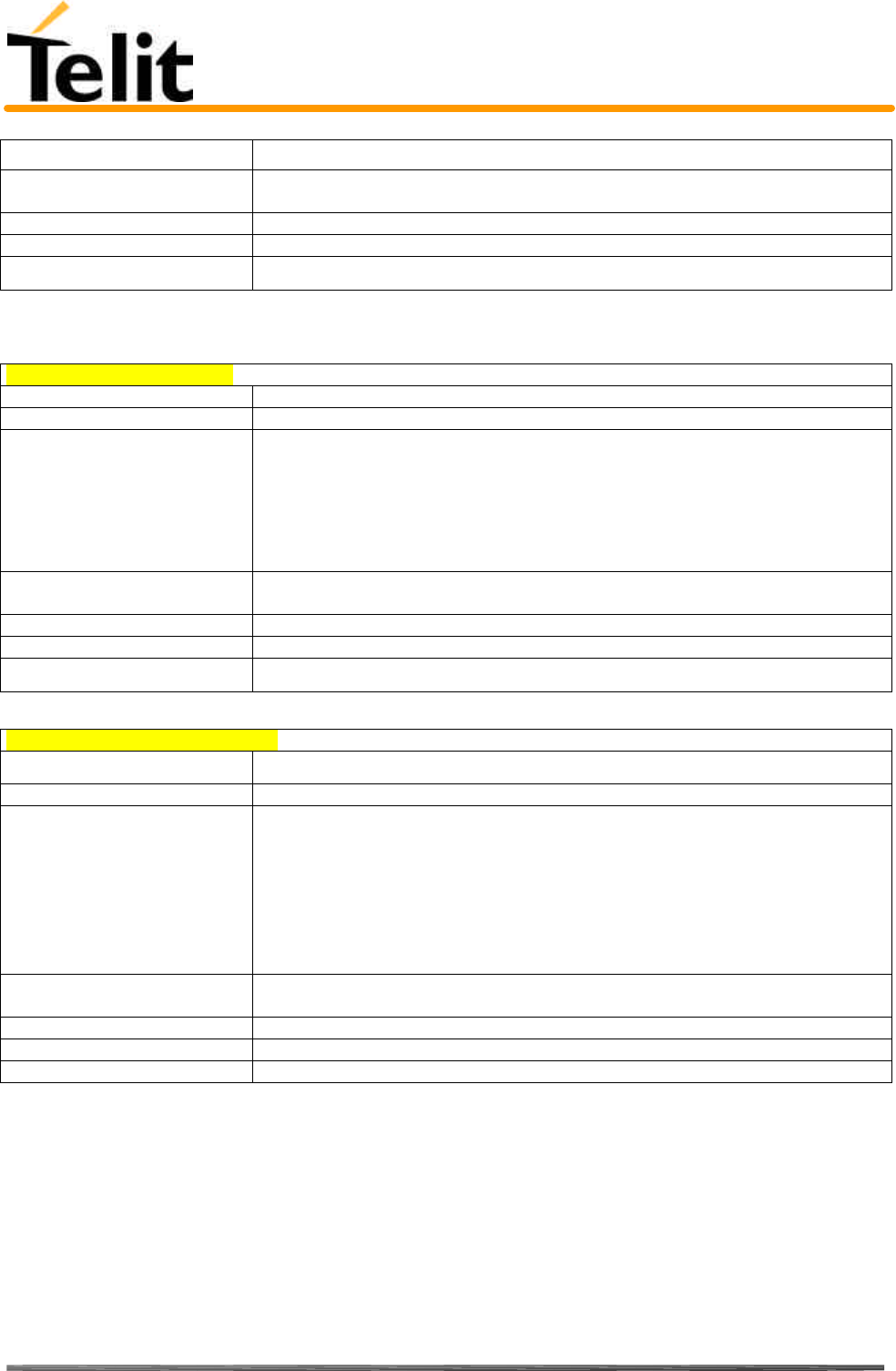
Telit TRIZIUM Product Description
80264ST10007a Rev. 4– 09/09/04
Reproduction forbidden without DAI Telecom written authorization – All Right reserved – Right of modification reserved page 126 of 202
+CMT, +CMGL, +CMGR commands are utilised
Test command
AT+CSDH=? Reports the supported range of values for the parameter <show>
Example
Reference GSM 07.05
SW release Version A
5.5.1.6 +CSAS – Save setting text mode
+CSAS –set saving text mode
Execute command
Read command
Write command
AT+CSAS=<profile>
Save setting which have been made by the +CSCA and +CSMP commands in local
volatile memory (or in the SIM if it has a dedicated storage for this purpose).
Parameter:
<profile>: 0…3 - number of profile in which to save the setting.
The number 0 corresponds to the non volatile memory, the others correspond to the
SIM storage (if available).
Test command
AT+CSAS=? Return the possible range of values for the parameter <profile>.
Example
Reference GSM 07.05
SW release Version A
5.5.1.7 +CRES – Restore text mode settings
+CRES –restore text mode settings
Execute command
Read command
Write command
AT+CRES = <profile> Restore any setting saved by +CSAS command for +CSCA and +CSMP commands
in local non volatile memory (or in the SIM if it has a dedicated store for this
purpose).
Parameter:
<profile>: 0…3 – number of profile from which to recall the setting. The number 0
corresponds to the non volatile memory, the others correspond to the SIM storage (if
available).
Test command
AT+CRES=? Return the possible range of values for the parameter <profile>.
Example
Reference GSM 07.05
SW release Version A
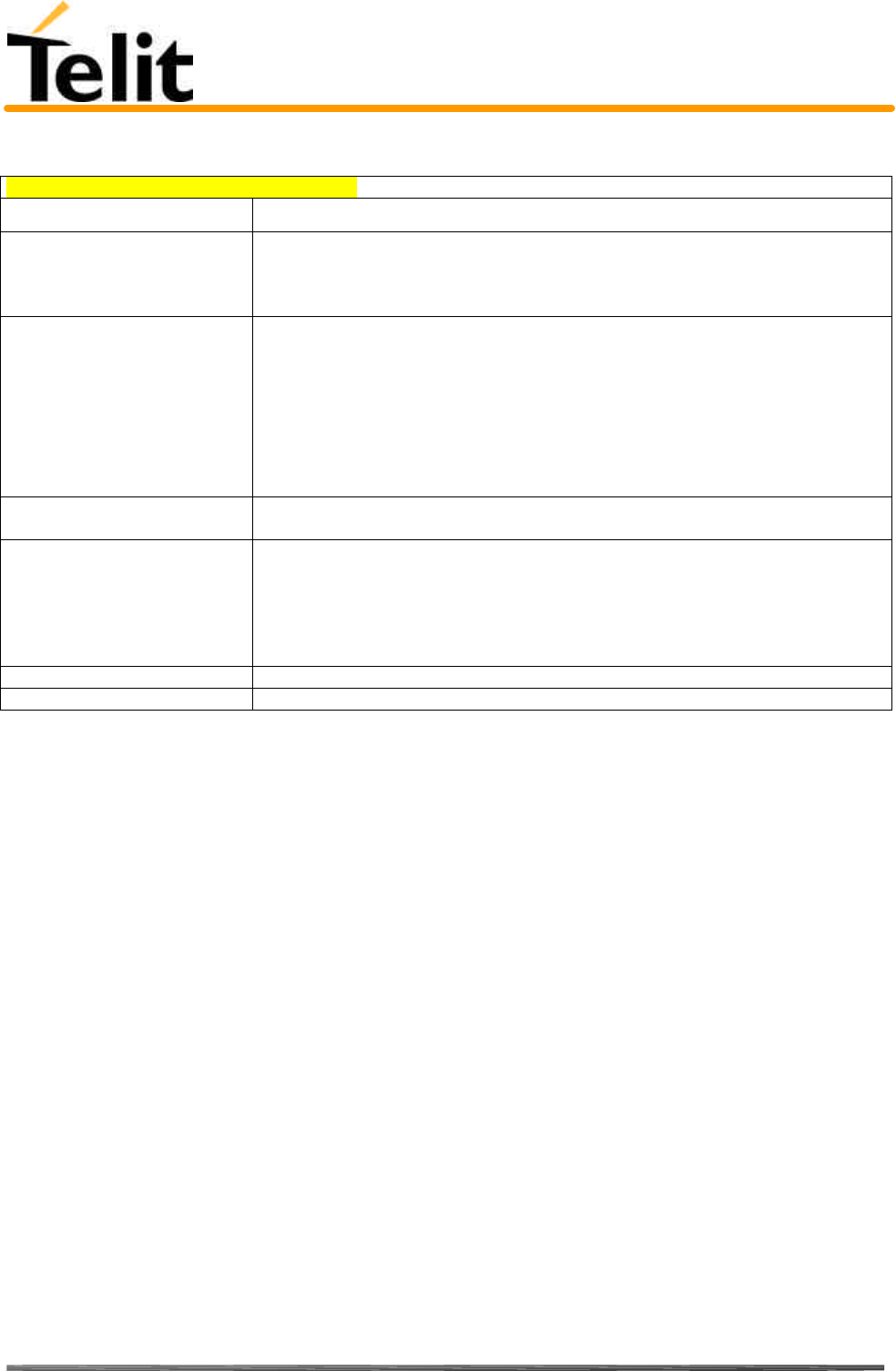
Telit TRIZIUM Product Description
80264ST10007a Rev. 4– 09/09/04
Reproduction forbidden without DAI Telecom written authorization – All Right reserved – Right of modification reserved page 127 of 202
5.5.1.8 +CSCB – Select Cell Broadcast Message types
+CSCB –select Cell Broadcast Message types
Execute command
Read command
AT+CSCB? Reports the current value of the parameters <mode>,<misd> and <dcss> in the
format:
+CSCB: <mode>,<mids>,<dcss>
Write command
AT+CSCB=
<mode>[,<mids>[,<dcss>]] Selects the Cell Broadcast message types to be received by the device.
Parameter:
<mode>
0 - the message types defined by <mids> and <dcss> are accepted
1 - the message types defined by <mids> and <dcss> are rejected
<mids> : all the possible combinations of the CBM identifiers
<dcss> : all the possible combinations of CBM data coding schemes.
Test command
AT+CSCB=? Return the possible range of values for the parameter <mode>.
Example AT+CSCB?
+CSCB: 1,"","" (all CBMs are accepted, none is rejected)
OK
AT+CSCB=0,"0,1,300-315,450","0-3"
OK
Reference GSM 07.05
SW release Version A

Telit TRIZIUM Product Description
80264ST10007a Rev. 4– 09/09/04
Reproduction forbidden without DAI Telecom written authorization – All Right reserved – Right of modification reserved page 128 of 202
5.5.1.9 +CMS ERROR - message service failure result code
This is NOT a command, it is the error response to +Cxxx GSM 07.05 commands
Syntax: AT+CMS ERROR:<err>
Parameter: <err> - error code can be either numeric or verbose.
<err> values:
Numeric Format Verbose Format
0...127 GSM 04.11 Annex E-2 values
128...255 GSM 03.40 sub clause 9.2.3.22 values
300 ME failure
301 SMS service of ME reserved
302 operation not allowed
303 operation not supported
304 invalid PDU mode parameter
305 invalid text mode parameter
310 SIM not inserted
311 SIM PIN required
312 PH-SIM PIN required
313 SIM failure
314 SIM busy
315 SIM wrong
316 SIM PUK required
317 SIM PIN2 required
318 SIM PUK2 required
320 memory failure
321 invalid memory index
322 memory full
330 SMSC address unknown
331 no network service
332 network timeout
340 no +CNMA acknowledgement expected
500 unknown error
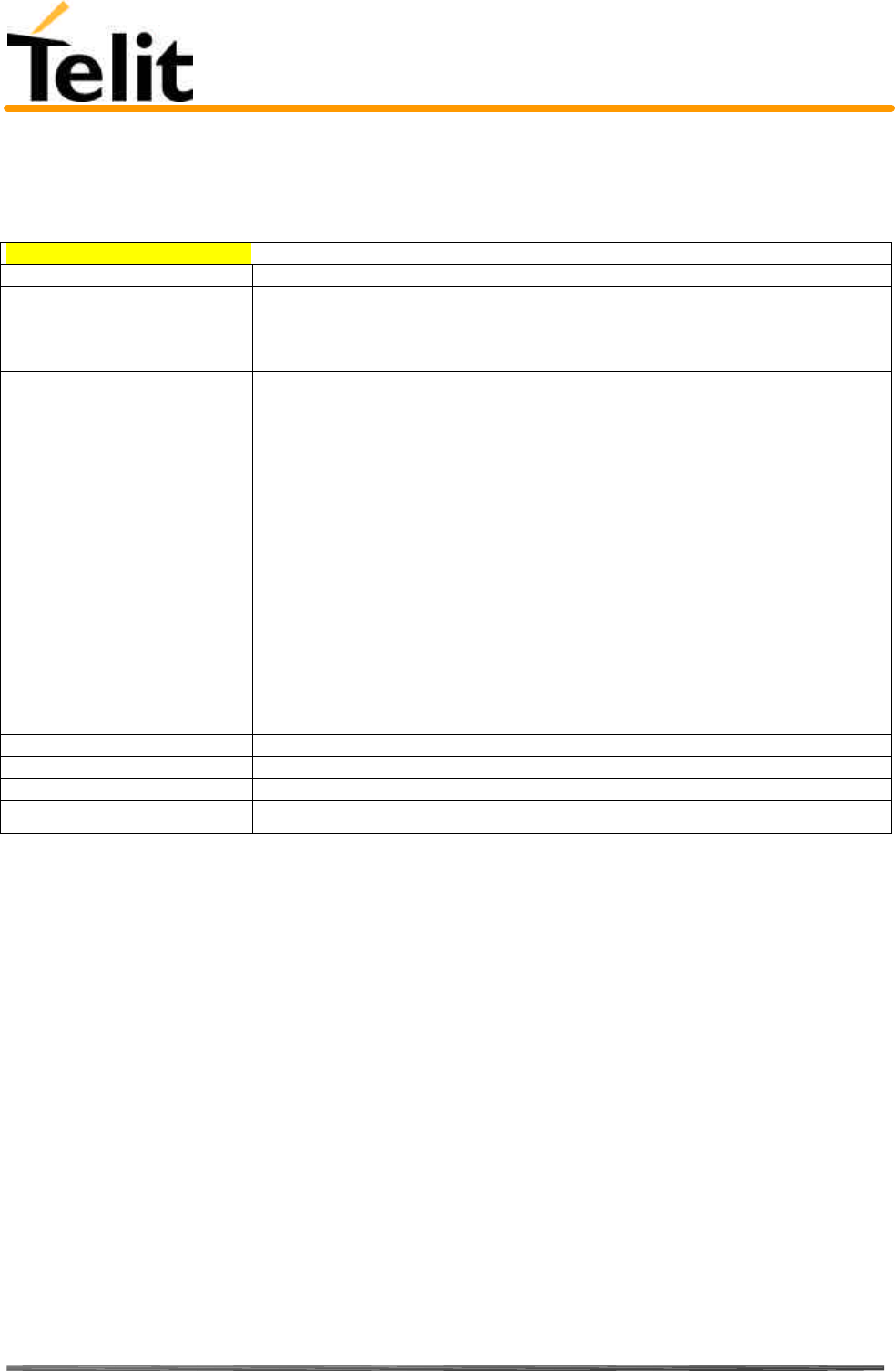
Telit TRIZIUM Product Description
80264ST10007a Rev. 4– 09/09/04
Reproduction forbidden without DAI Telecom written authorization – All Right reserved – Right of modification reserved page 129 of 202
5.5.2 Message configuration
5.5.2.1 +CSCA - service center address
+CSCA –service center address
Execute command
Read command AT+CSCA? Reports the current value of the default SCA in the format:
+CSCA: <number>,<type>
Note: if SCA is not present the device reports an error message.
Write command
AT+CSCA=<number>,
<type> Sets the Service center Address to be used for mobile originated SMS
transmissions.
Parameter:
<number> - SC phone number in the format defined by <type>
<type> - the type of number
<type> = 145 - international numbering scheme (contains the character "+")
<type> = 129 - national numbering scheme
Note: to use the SMS service, is mandatory to set a Service Center Address at which
service requests will be directed. SCA depends on the operator, hence contact your
operator to set the right SCA. When this address is input, it is stored on the SIM if
possible, else will be stored on the device internal memory so, once set, the input of
this parameter is not anymore needed.
In PDU mode, this setting is used, but only when the length of the SMSC address
coded into the <pdu> parameter equals zero; else SCA defined in the PDU will be
used instead.
Test command
Example
Reference GSM 07.05
SW release Version A

Telit TRIZIUM Product Description
80264ST10007a Rev. 4– 09/09/04
Reproduction forbidden without DAI Telecom written authorization – All Right reserved – Right of modification reserved page 130 of 202
5.5.3 Message receiving and reading
5.5.3.1 +CNMI - new message indications to Terminal Equipment
+CNMI – new message indications to terminal equipment
Read command AT+CNMI? Returns the current parameter settings for +CNMI command in the form:
AT+CNMI:<mode>,<mt>,<bm>,<ds>,<bfr>
Write command
AT+CNMI=<mode>[,<mt>[,<b
m>[,<ds>[,<bfr>]]]] Selects the behavior of the device on how the receiving of new messages from the
network is indicated to the DTE.
Parameter:
<mode>- unsolicited result codes buffering option
0 - Buffer unsolicited result codes in the TA. If TA result code buffer is full,
indications can be buffered in some other place or the oldest indications may be
discarded and replaced with the new received indications.
1 - Discard indication and reject new received message unsolicited result codes
when TA-TE link is reserved, otherwise forward them to the TE.
2 - Buffer unsolicited result codes in the TA in case the DTE is busy and flush
them to the TE after reservation. Otherwise forward them directly to the TE.
<mt> result code indication reporting for SMS-DELIVER
0 - No SMS-DELIVER indications are reported to the TE.
1 - If SMS-DELIVER is stored into ME/TA, indication of the memory location
is reported to the TE using unsolicited result code:
+CMTI: <memr>,<index>
where:
<memr> - memory storage where the new message is stored ("SM" or "ME")
<index> - location on the memory where SMS is stored
2 - SMS-DELIVERs (except class 2 messages and messages in the message
waiting indication group) are reported to the TE using unsolicited result code:
+CMT: [<alpha>],<length><CR><LF><pdu>(PDU mode)
where:
<alpha> - alphanumeric representation of originator/destination
number corresponding to the entry found in MT phonebook.
<length> - PDU length
<pdu> - PDU message
or
+CMT:<oa>,[<alpha>],<scts>[,<tooa>,<fo>,<pid>,<dsc>,
<sca>,<tosca>,<length>]<CR><LF><data> (text mode enabled; about
parameters in italic, refer command +CSDH)
where:
<oa> - originator address number
<alpha> - alphanumeric representation of <oa> or <da>
<scts> - arrival time of the message to the SC
<tooa>, <tosca> - type of number <oa> or <sca>
145 - number in international format (contains the "+")
129 - number in national format
<fo> - first octet of GSM 03.40
<pid> - Protocol Identifier
<dsc> - Data Coding Scheme
<sca> - Service Centre number
<length> - text length
<data>- text mode

Telit TRIZIUM Product Description
80264ST10007a Rev. 4– 09/09/04
Reproduction forbidden without DAI Telecom written authorization – All Right reserved – Right of modification reserved page 131 of 202
+CNMI – new message indications to terminal equipment
Class 2 messages and messages in the message waiting indication group
(stored message) result in indication as defined in <mt> = 1.
3 - Class 3 SMS-DELIVERs are reported directly to TE using unsolicited
result codes defined in <mt> = 2. Messages of other data coding schemes result in
indication as defined in <mt> = 1.
<bm> - broadcast reporting option
0 - Cell Broadcast Messages are not sent to the DTE
2 - New Cell Broadcast Messages are sent to the DTE with the unsolicited result
code:
+CBM: <length><CR><LF><PDU> ( in PDU mode)
or
+CBM:<sn>,<mid>,<dcs>,<pag>,<pags><CR><LF><text> (in text mode)
where:
<length> - PDU length
<PDU> - message PDU
<sn> - message serial number
<mid> - message ID
<dcs> - Data Coding Scheme
<pag> - page number
<pags> - total number of pages of the message
<text> - message text
<ds> - SMS-STATUS-REPORTs reporting option
0 - status report receiving is not reported to the DTE
1 - the status report is sent to the DTE with the unsolicited result code:
+CDS: <length><CR><LF><PDU> (PDU mode)
or
+CDS: <fo>,<mr>,,,<scts>,<dt>,<st> (text mode)
2 - if a status report is stored, then unsolicited result code is sent:
+CDSI: <memr>,<index>
where
<memr> - memory storage where the new message is stored ("SM")
<index> - location on the memory where SMS is stored
<length> - PDU length
<PDU> - message PDU
<fo> - first octet of the message PDU
<mr> - message reference number
<scts> - arrival time of the message to the SC
<dt> - sending time of the message
<st> - message status as coded in the PDU
<bfr> - buffered result codes handling method
0 - TA buffer of unsolicited result codes defined within this command is
flushed to the TE when <mode> 1…3 is entered (OK response shall be given
before flushing the codes)
1 - TA buffer of unsolicited result codes defined within this command is
cleared when <mode> 1…3 is entered.
Note: DTR signal is ignored, hence the indication is sent even if the DTE is
inactive ( DTR signal is Low). In this case the unsolicited result code may be lost
so if TRIZIUM remains active while DTE is not, at DTE startup is suggested to
check whether new messages have reached the device meanwhile with command
AT+CMGL=0 that lists the new messages received.
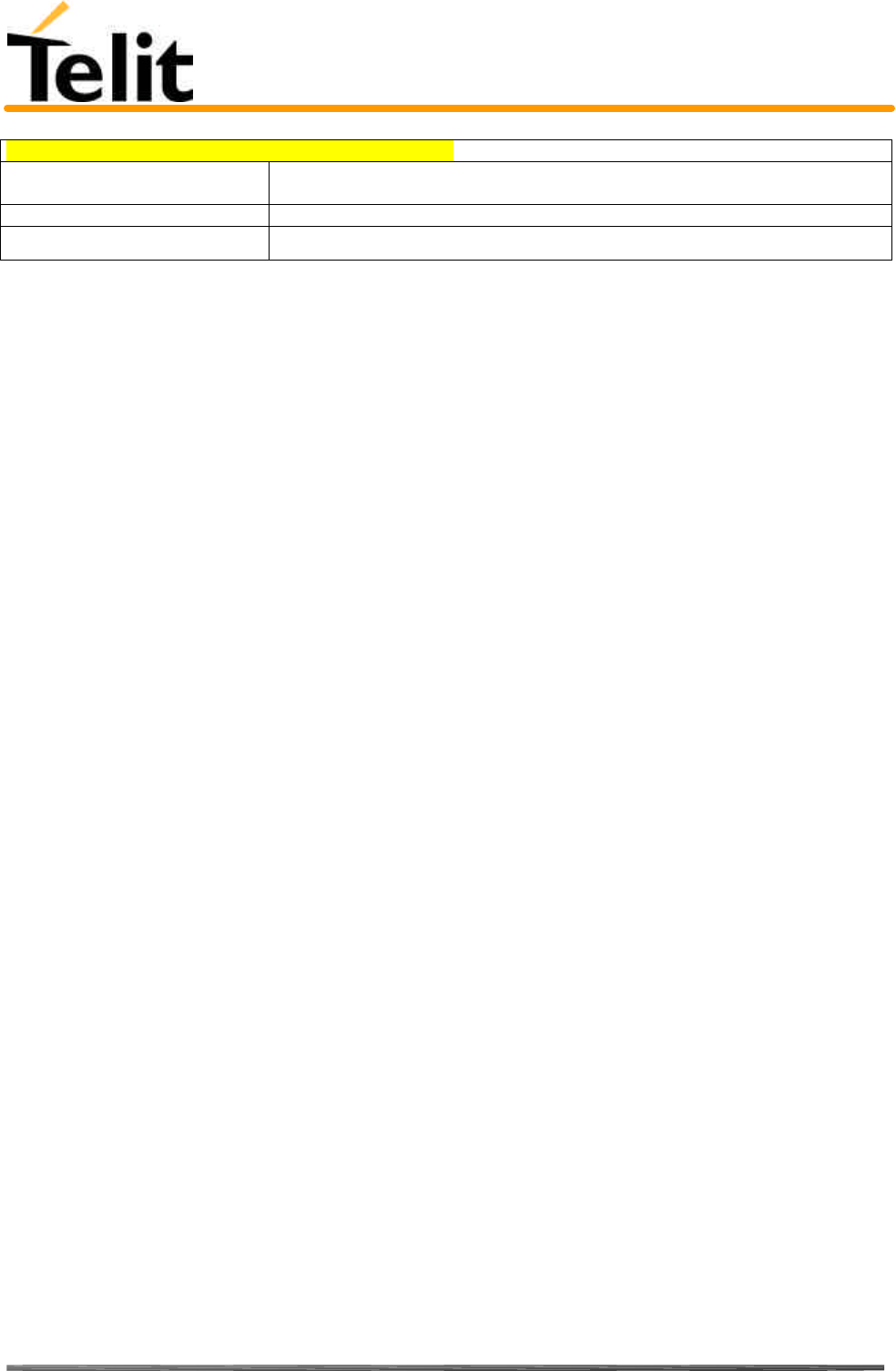
Telit TRIZIUM Product Description
80264ST10007a Rev. 4– 09/09/04
Reproduction forbidden without DAI Telecom written authorization – All Right reserved – Right of modification reserved page 132 of 202
+CNMI – new message indications to terminal equipment
Test command
AT+CNMI=? Reports the supported range of values for the +CNMI command parameters.
Reference GSM 07.05
SW release Version A

Telit TRIZIUM Product Description
80264ST10007a Rev. 4– 09/09/04
Reproduction forbidden without DAI Telecom written authorization – All Right reserved – Right of modification reserved page 133 of 202
5.5.3.2 +CMGL - list messages
+CMGL – list messages
Execute command
Read command
Write command
AT+CMGL = <stat> Reports the list of all the messages stored into <memr> (see command +CPMS )
memory storage having the status equal to <stat> parameter.
Parameter (PDU Mode):
<stat>
0 - new message
1 - read message
2 - stored message not yet sent
3 - store message already sent
4 - all messages (applies only to +CMGL command)
A report is sent for each message that has to be listed in the format:
+CMGL: <index>,<stat>,<length><CR><LF><pdu>
where
<index> - message position in the memory storage list.
<stat> - status of the message
<length> - length of the PDU in bytes
<pdu> - message in PDU format according to GSM 3.40
Note: OK message is sent only at the end of the listing.
Parameter (Text Mode):
<stat>
"REC UNREAD" - new message
"REC READ" - read message
"STO UNSENT" - stored message not yet sent
"STO SENT" - store message already sent
"ALL" - all messages (applies only to +CMGL command)
A report is sent for each message that has to be listed in the format:
+CMGL: <index>,<stat>,<oa/da>[,,,<tooa/toda>,<length>]<CR><LF><text>
where
<index> - message position in the storage
<stat> - message status
<oa/da> - originator/destination number
< tooa/toda > - type of number <oa/da>
145 - number in international format (contains the "+")
129 - number in national format
<length> - text length
<text> - message text
For each message delivery confirm a result code is reported in the format:
+CMGL: <index>,<stat>,<fo>,<mr>,,,<scts>,<dt>,<st>
Where
<index> - message position in the storage
<stat> - message status
<fo> - first octet of the message PDU
<mr> - message reference number
<scts> - arrival time of the message to the SC
<dt> - sending time of the message
<st> - message status as coded in the PDU
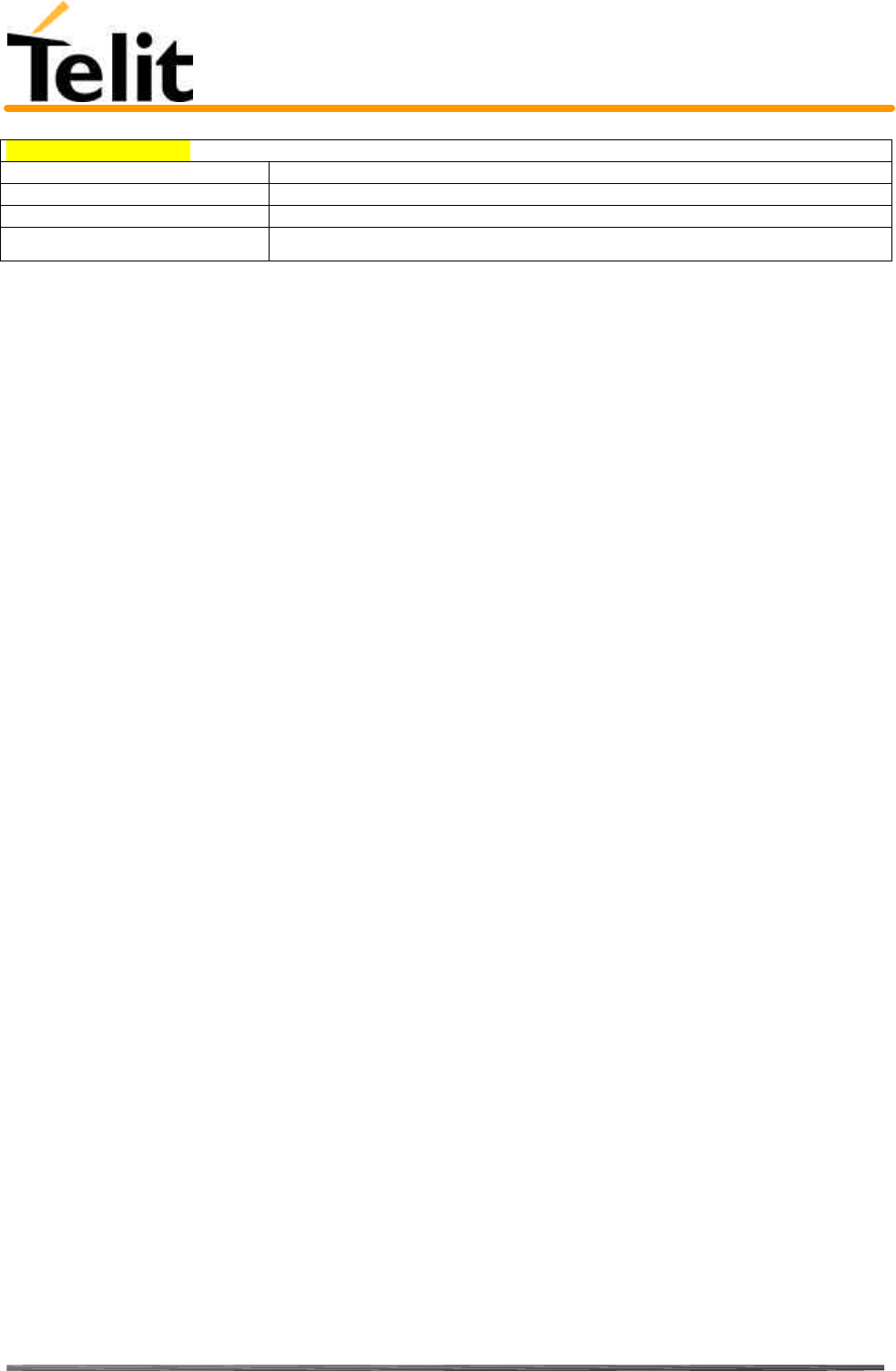
Telit TRIZIUM Product Description
80264ST10007a Rev. 4– 09/09/04
Reproduction forbidden without DAI Telecom written authorization – All Right reserved – Right of modification reserved page 134 of 202
+CMGL – list messages
Test command
Example
Reference GSM 07.05
SW release Version A

Telit TRIZIUM Product Description
80264ST10007a Rev. 4– 09/09/04
Reproduction forbidden without DAI Telecom written authorization – All Right reserved – Right of modification reserved page 135 of 202
5.5.3.3 +CMGR - read message
+CMGR – read message
Execute command AT+CMGR =
<index> Reports the message with location value <index> from preferred message storage
<memr> (see +CPMS) in the format:
(PDU Mode)
+CMGR: <stat>,<length><CR><LF><pdu>
where
<stat> - status of the message
0 - new message
1 - read message
2 - stored message not yet sent
3 - store message already sent
<length> - length of the PDU in bytes.
<pdu> - message in PDU format according to GSM 3.40.
(Text Mode)
For the sent messages:
+CMGR: <stat>,<oa>,,<scts> [,<tooa>,<fo>,<pid>,<dcs>,<sca>,
<tosca>,<length>]<CR><LF><text>
For the received messages:
+CMGR: <stat>,<da>[,,<toda>,<fo>,<pid>,<dcs>,,
<sca>,<tosca>,<length>]<CR><LF><testo>
For the message delivery confirm:
+CMGR: <stat>,<fo>,<mr>,,,<scts>,<dt>,<st>
Where:
<stat> - status of the message
"REC UNREAD" - new received message unread
"REC READ" - received message read
"STO UNSENT" - message stored not yet sent
"STO SENT" - message stored already sent
<fo> - first octet of the message PDU
<mr> - message reference number
<scts> - arrival time of the message to the SC
<dt> - sending time of the message
<st> - message status as coded in the PDU
<pid> - Protocol Identifier
<dcs> - Data Coding Scheme
<oa> - Originator address number
<da> - Destination address number
<sca> - Service Centre number
< tooa>,<toda >,<tosca> - type of number <oa>,<da>,<sca>
145 - number in international format (contains the "+")
129 - number in national format
<length> - text length
<text> - message text
The status of the message and entire message data unit <pdu> is returned. If status
of the message is 'received unread', status in the storage changes to 'received
read'.
Parameter: <index>
Note: if record number <index> on message storage memory is empty, then an
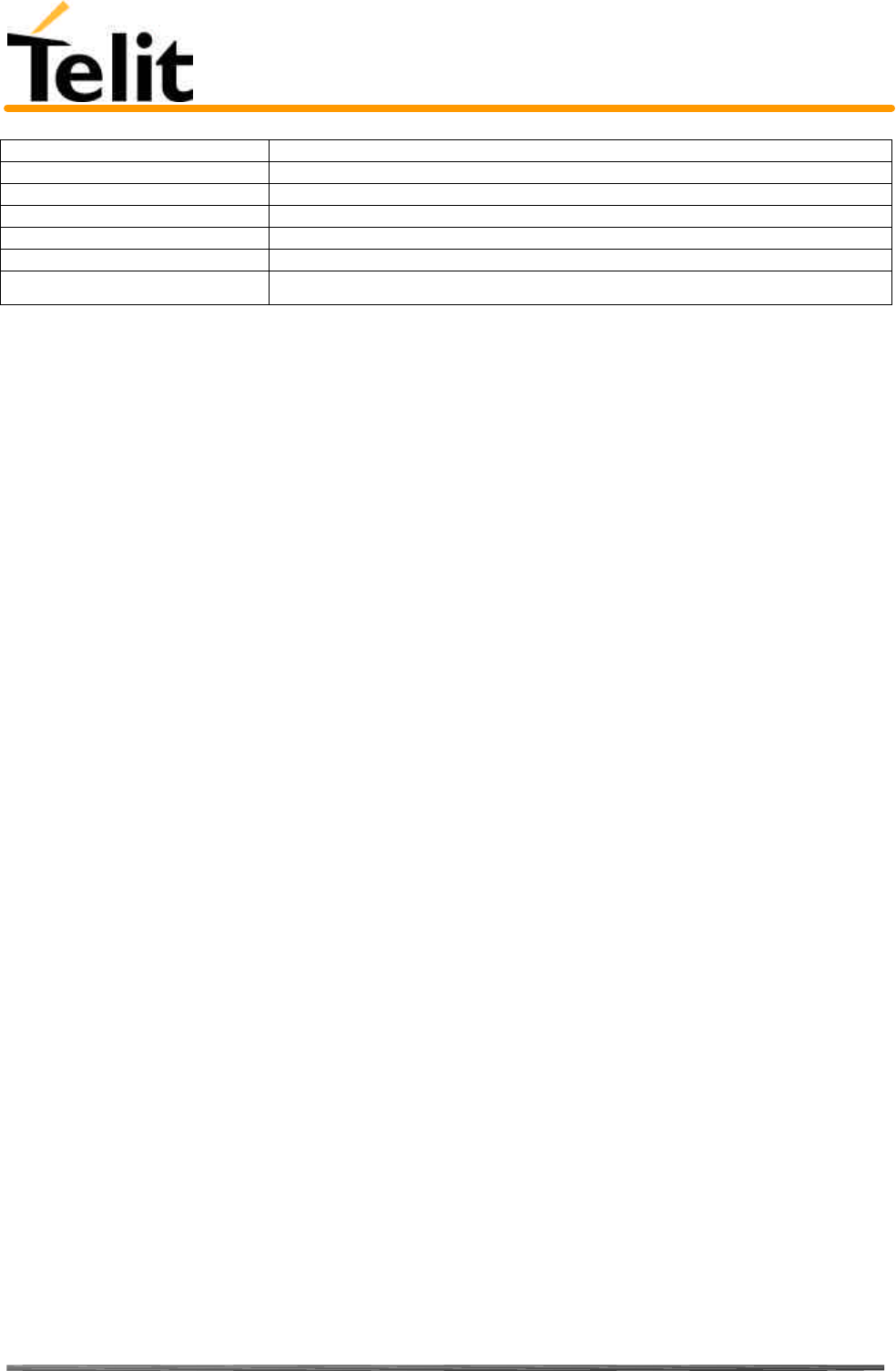
Telit TRIZIUM Product Description
80264ST10007a Rev. 4– 09/09/04
Reproduction forbidden without DAI Telecom written authorization – All Right reserved – Right of modification reserved page 136 of 202
error message will be returned.
Read command
Write command
Test command
Example
Reference GSM 07.05
SW release Version A
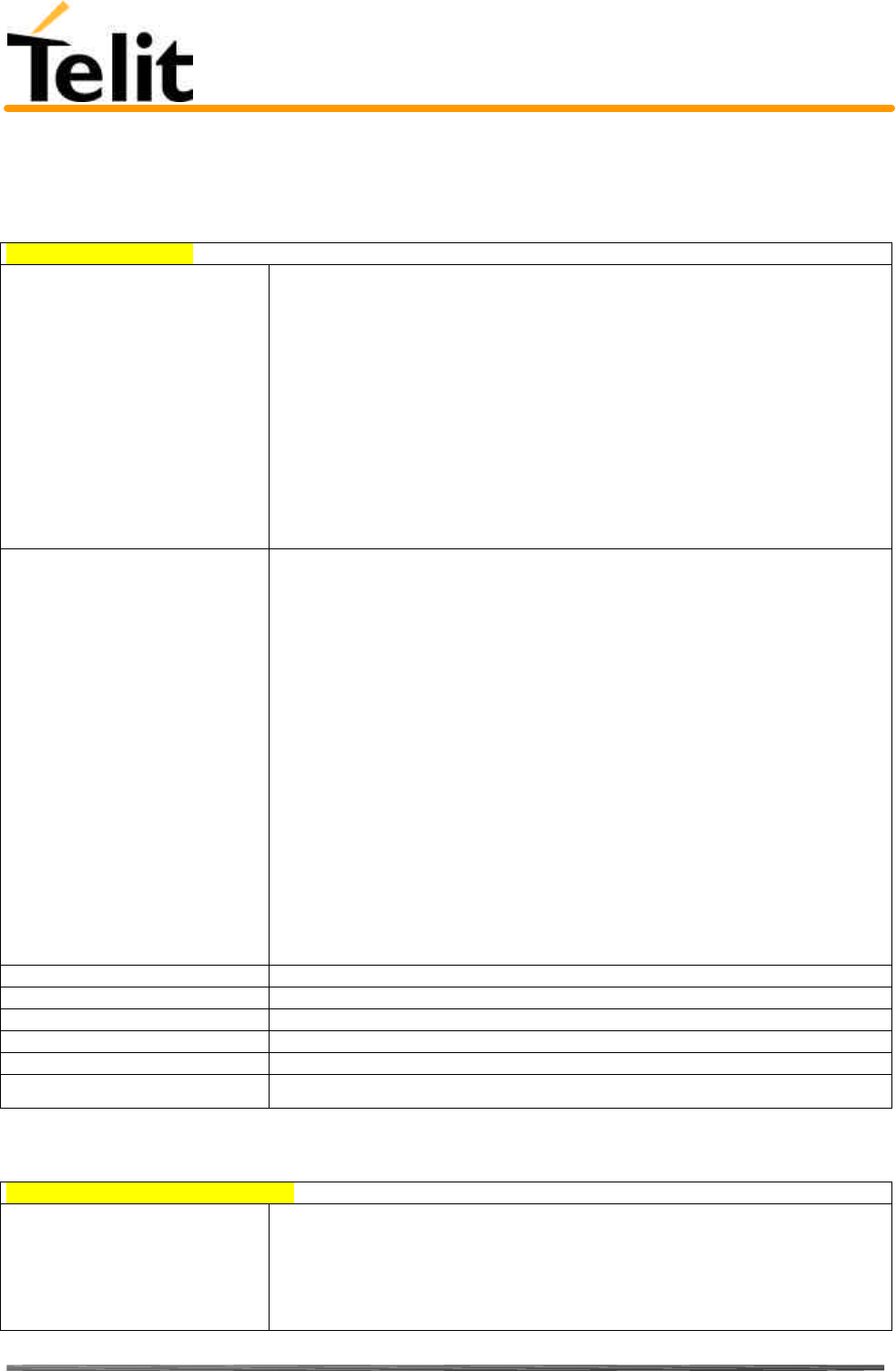
Telit TRIZIUM Product Description
80264ST10007a Rev. 4– 09/09/04
Reproduction forbidden without DAI Telecom written authorization – All Right reserved – Right of modification reserved page 137 of 202
5.5.4 Message sending and writing
5.5.4.1 +CMGS - send message
+CMGS – send message
Execute command
(PDU Mode)
AT+CMGS = <length> (PDU Mode)
Sends to the network a SMS message input as a PDU.
Parameter:
<length> = 8…176 - represents the length of the PDU to be sent in bytes.
The device responds to the command with the prompt '>' and awaits for the
number of bytes of PDU specified.
To complete the operation send Ctrl-Z char (0x1A hexadecimal) , to exit without
sending the message send ESC char (0x1B hexadecimal ).
If message is successfully sent to the network, then the result is sent in the format:
+CMGS: <mr>
where <mr> is the message reference number.
If message sending fails for some reason, an error code is reported.
(Text Mode)
AT+CMGS=<da>
(Text Mode)
Sends to the network a SMS message input as a text message.
Parameter:
<da> = destination address number
The device responds to the command with the prompt '>' and awaits for message
text (max 160 characters).
To complete the operation send Ctrl-Z char (0x1A hexadecimal) , to exit without
sending the message send ESC char (0x1B hexadecimal).
If message is successfully sent to the network, then the result is sent in the format:
+CMGS: <mr>
where <mr> is the message reference number.
If message sending fails for some reason, an error code is reported.
Note: Care must be taken to ensure that during the command execution, which
might take several seconds, no other SIM interacting commands are issued.
To avoid malfunctions is suggested to wait for the +CMGS:<mr> or
+CMS ERROR:<err> response before issuing further
commands.
Read command
Write command
Test command
Example
Reference GSM 07.05
SW release Version A
5.5.4.2 +CMSS - send message from storage
+CMSS – send message from storage
Execute command
AT+CMSS = <index> Sends to the network, the message which is already stored in the <memw>
storage (see +CPMS) at the location <index>.
Parameter: <index>
If message is successfully sent to the network, Sends to the network, then the
result is sent in the format:
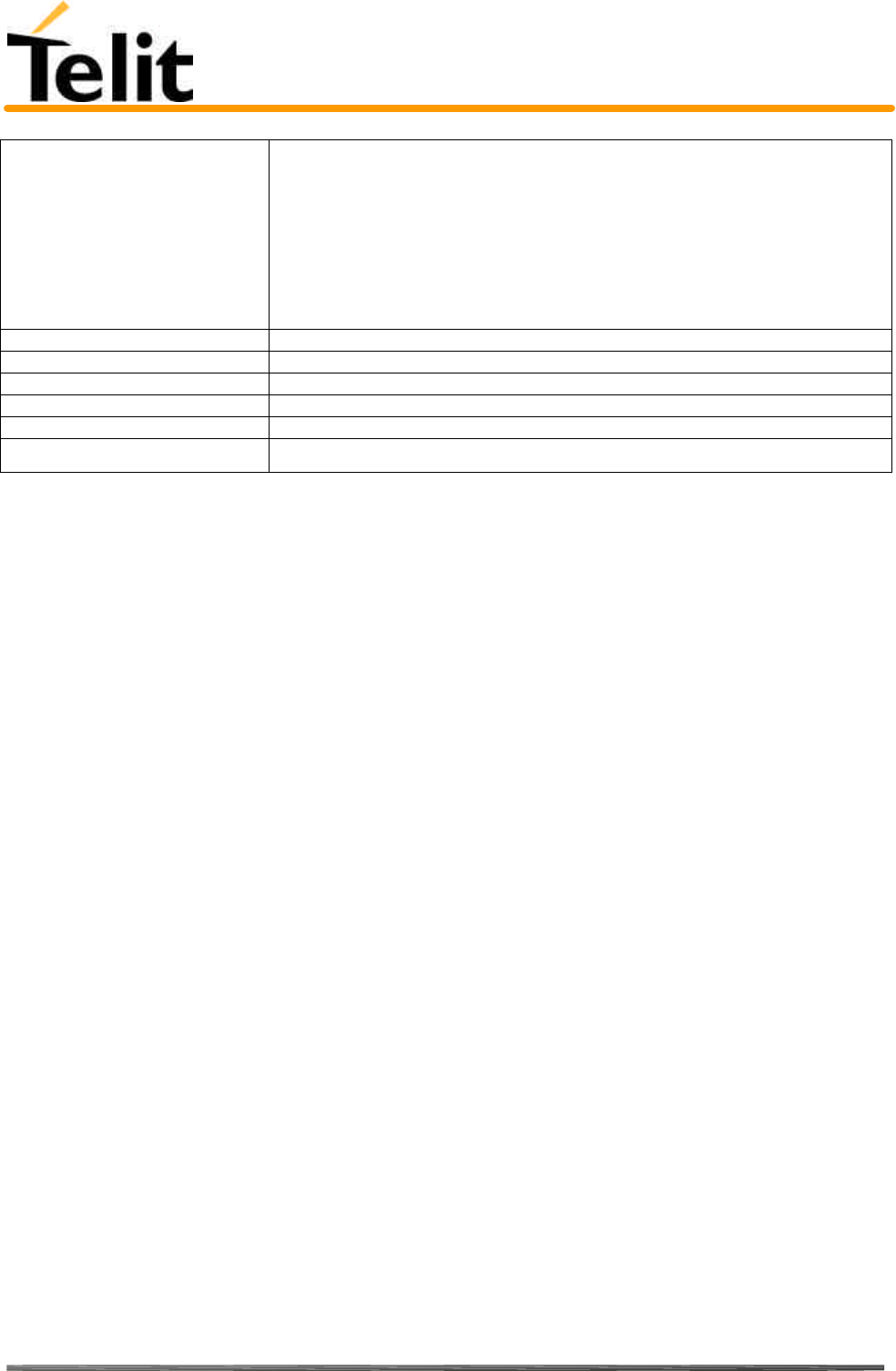
Telit TRIZIUM Product Description
80264ST10007a Rev. 4– 09/09/04
Reproduction forbidden without DAI Telecom written authorization – All Right reserved – Right of modification reserved page 138 of 202
+CMSS: <mr>
where <mr> is the message reference number.
If message sending fails for some reason, an error code is reported:
+CMS ERROR:<err>
Note: to store a message in the <memw> storage see command +CMGW.
Care must be taken to ensure that during the command execution, which might
take several seconds, no other SIM interacting commands are issued.
To avoid malfunctions is suggested to wait for the +CMGS:<mr> or +CMS
ERROR:<err> response before issuing further commands.
Read command
Write command
Test command
Example
Reference GSM 07.05
SW release Version A
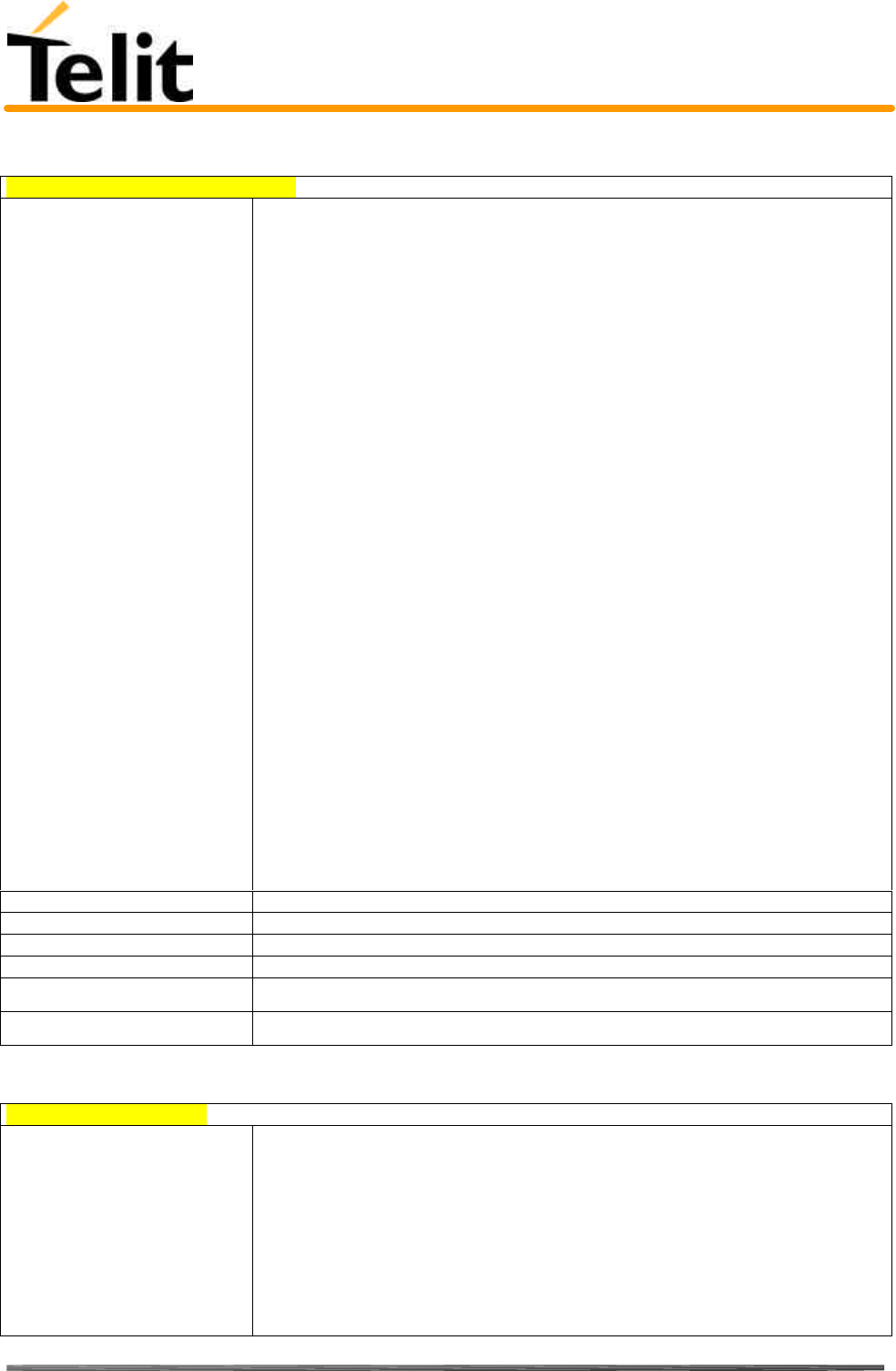
Telit TRIZIUM Product Description
80264ST10007a Rev. 4– 09/09/04
Reproduction forbidden without DAI Telecom written authorization – All Right reserved – Right of modification reserved page 139 of 202
5.5.4.3 +CMGW - write message to memory
+CMGW – write message to memory
Execute command
(PDU Mode)
AT+CMGW = <length>
(Text Mode)
AT+CMGW = [<da>]
(PDU Mode)
Writes in the <memw> memory storage a new SMS message input as a PDU.
Parameter:
<length> - represents the length of the PDU to be written in bytes.
The device responds to the command with the prompt '>' and awaits for the number
of bytes of PDU specified.
To complete the operation send Ctrl-Z char (0x1A hexadecimal) , to exit without
writing the message send ESC char (0x1B hexadecimal).
If message is successfully written in the memory, then the result is sent in the
format:
+CMGW: <index>
where <index> is the message location index in the memory <memw>("SM").
If message storing fails for some reason, an error code is reported
(Text Mode)
Writes in the <memw> memory storage a new SMS message input as Text.
Parameter:
<da> - destination address number
The device responds to the command with the prompt '>' and awaits for the message
text ( max 160 characters).
To complete the operation send Ctrl-Z char (0x1A hexadecimal) , to exit without
writing the message send ESC char (0x1B hexadecimal).
If message is successfully written in the memory, then the result is sent in the
format:
+CMGW: <index>
where <index> is the message location index in the memory <memw>("SM").
If message storing fails for some reason, an error code is reported
Note: Care must be taken to ensure that during the command execution, no other
SIM interacting commands are issued.
To avoid malfunctions is suggested to wait for the +CMGS:<mr> or +CMS
ERROR:<err> response before issuing further commands.
Read command
Write command
Test command
Example
Reference GSM 07.05
SW release Version A
5.5.4.4 +CMGD - delete message
+CMGD – delete message
Execute command
AT+CMGD =
<index>[,<delflag>] Deletes from memory the message/messages
Note: if the location to be deleted is empty, an error message is reported.
Parameter:
<index> - message position index in the selected storage <memr>
<delflag> - delete mode selection flag
0 (or not present) - delete message at position <index>
1 - delete all received read messages
2 - delete all received read and all sent messages
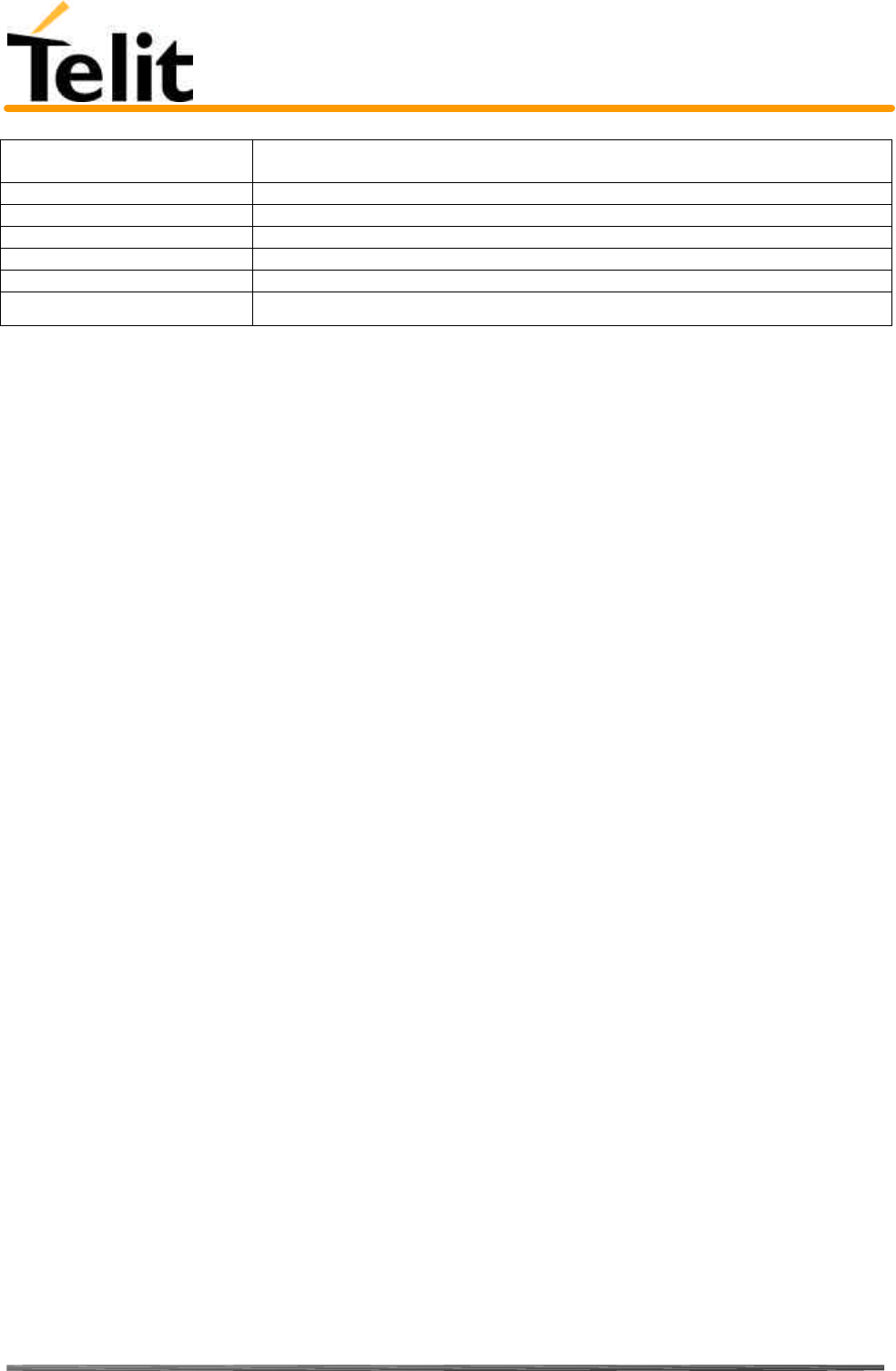
Telit TRIZIUM Product Description
80264ST10007a Rev. 4– 09/09/04
Reproduction forbidden without DAI Telecom written authorization – All Right reserved – Right of modification reserved page 140 of 202
3 - delete all received read and all written sent/unsent messages
4 - delete all messages.
Read command
Write command
Test command
Example
Reference GSM 07.05
SW release Version A
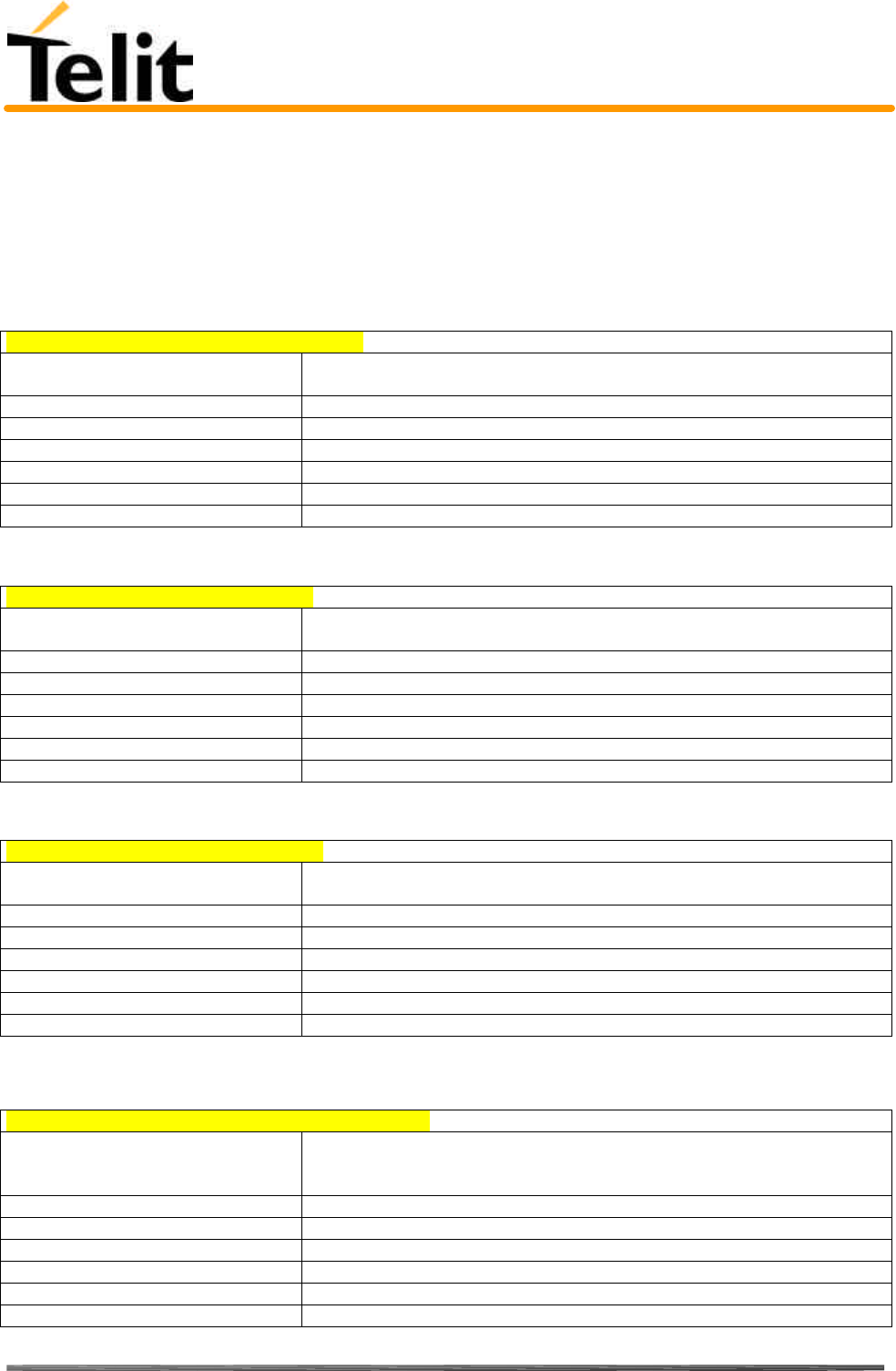
Telit TRIZIUM Product Description
80264ST10007a Rev. 4– 09/09/04
Reproduction forbidden without DAI Telecom written authorization – All Right reserved – Right of modification reserved page 141 of 202
5.6 Custom AT Commands
5.6.1 General configuration
5.6.1.1 #CGMI - request manufacturer identification
#CGMI – request manufacturer identification
Execute command
AT#CGMI Returns the device manufacturer identification code with command echo.
Read command
Write command
Test command
Example
Reference Telit TRIZIUM AT Command Specification
SW release Version A
5.6.1.2 #CGMM - request model identification
#CGMM – request model identification
Execute command
AT#CGMM Returns the device model identification code with command echo.
Read command
Write command
Test command
Example
Reference Telit TRIZIUM AT Command Specification
SW release Version A
5.6.1.3 #CGMR - request revision identification
#CGMR – request revision identification
Execute command
AT#CGMR Returns device software revision number with command echo.
Read command
Write command
Test command
Example
Reference Telit TRIZIUM AT Command Specification
SW release Version A
5.6.1.4 #CGSN - request product serial number identification
#CGSN – request product serial number identification
Execute command
AT#CGSN Returns the product serial number, identified as the IMEI of the mobile, with
command echo.
Read command
Write command
Test command
Example
Reference Telit TRIZIUM AT Command Specification
SW release Version A
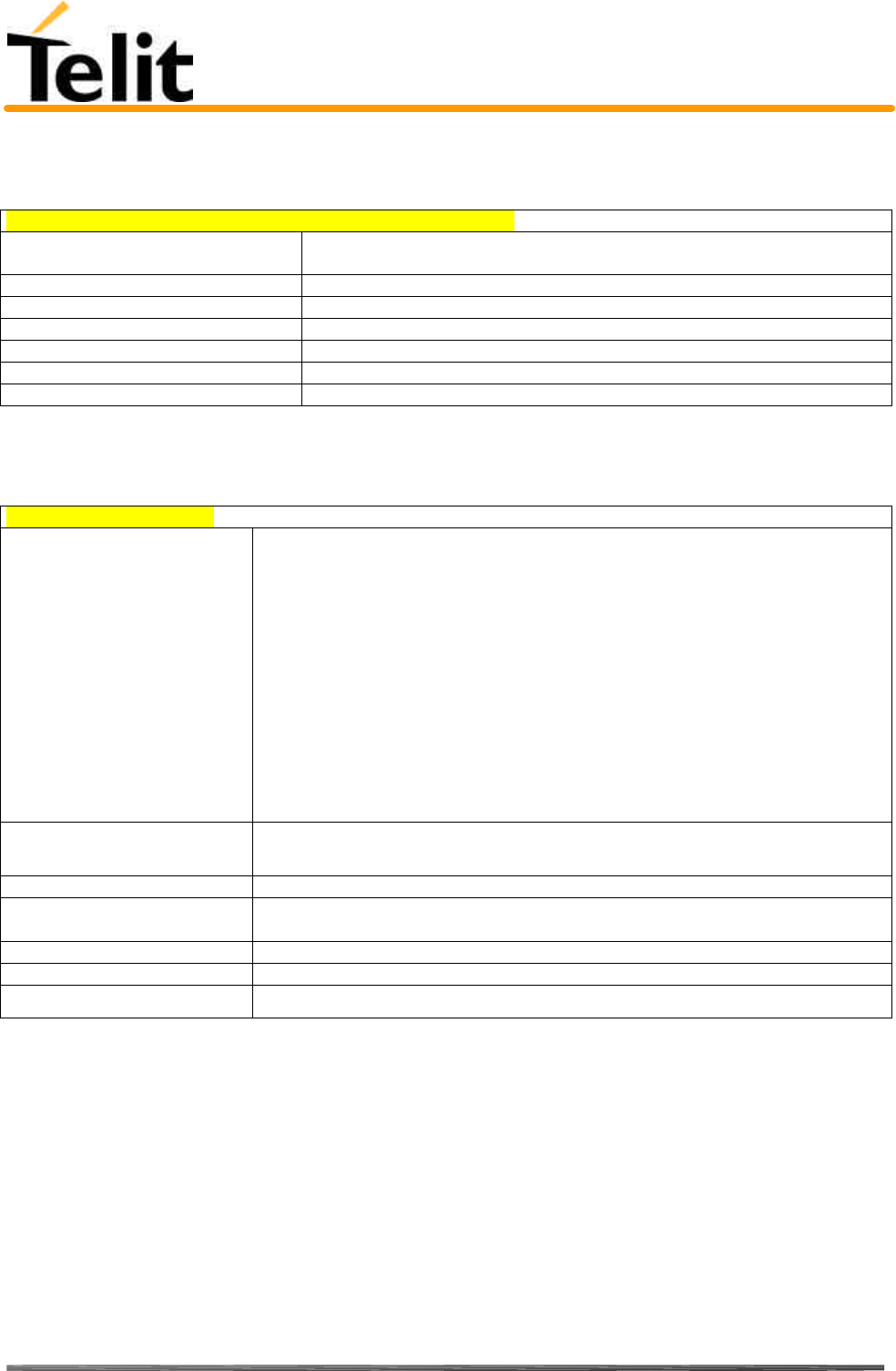
Telit TRIZIUM Product Description
80264ST10007a Rev. 4– 09/09/04
Reproduction forbidden without DAI Telecom written authorization – All Right reserved – Right of modification reserved page 142 of 202
5.6.1.5 #CIMI - request international mobile subscriber identity (IMSI)
#CGSN – request international mobile subscriber identity (IMSI)
Execute command
AT#CIMI Returns the international mobile subscriber identity, identified as the IMSI
number, with command echo.
Read command
Write command
Test command
Example
Reference Telit TRIZIUM AT Command Specification
SW release Version A
5.6.1.6 #CAP - Change Audio Path
#CAP – change audio path
Execute command
AT#CAP = <n> Switches the active audio path depending on parameter <n>
Parameter:
<n> audio path
0 - audio path follows the Axe input (default at start up):
Axe = low - handsfree enabled
Axe = high - internal path enabled
1 - enables handsfree external mic/ear audio path
2 - enables internal mic/ear audio path
Note: The audio path are mutually exclusive, enabling one disables the other.
When changing the audio path, the volume level is set at the previously stored value
for that audio path. (see AT+CLVL).
Read command AT#CAP?
Reports the active audio path in the format: #CAP: <n>.
Write command
Test command
AT#CAP=? Reports the supported values for the parameter <n>.
Example
Reference Telit TRIZIUM AT Command Specification
SW release Version A
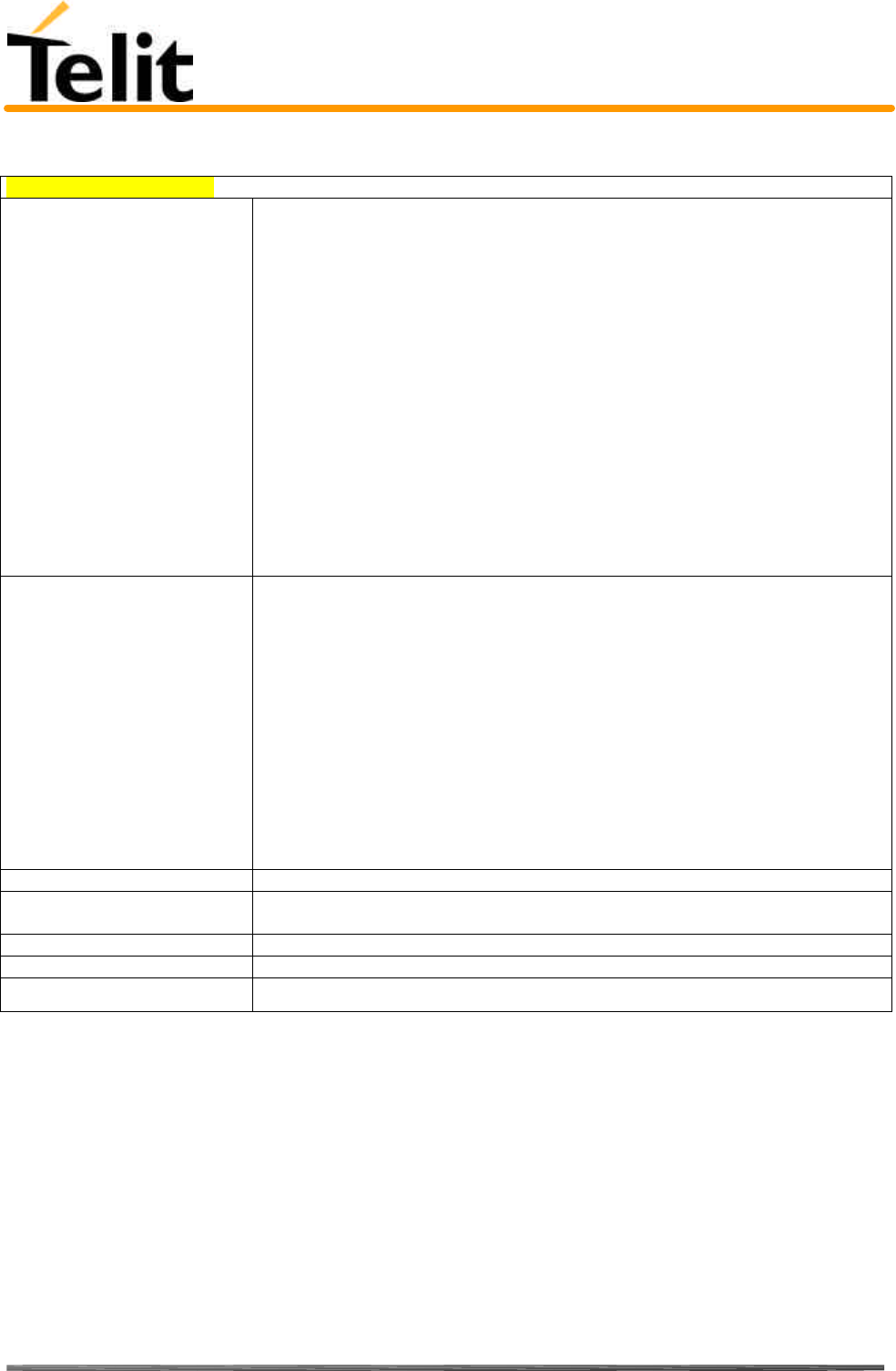
Telit TRIZIUM Product Description
80264ST10007a Rev. 4– 09/09/04
Reproduction forbidden without DAI Telecom written authorization – All Right reserved – Right of modification reserved page 143 of 202
5.6.1.7 #SRS - Select ringer sound
#SRS – select ringer sound
Execute command AT#SRS =
<n>[,<timeout>] Set the ringer sound. The parameters are:
<n> - ringing tone
0 - current ringing tone
1 .. 12 - ringing tone number
<timeout> ringing tone playing timeout in seconds.
0 - no ringing tone playing, only tone setting
1 .. 60 - <n> tone playing for <timeout> seconds and successive tone setting.
Note: When the command is issued with <timeout> >0, the <n> ringing tone is
played for <timeout> seconds and then stored as current tone.
If command is issued with <timeout> = 0, the playing of the ringing is stopped (if
present) and <n> ringing tone is set as default.
If command is issued with <n> = 0 and <timeout> >0 then the default ringing tone is
played.
If both <n> and <timeout> are 0 then currently playing tone is set as default and
ringing is stopped.
Read command AT#SRS?
Reports current selected ringing and its status in the form:
#SRS: <n>,<status>
where:
<n> ringing tone number
1 .. 12
<status> ringing status
0 - selected but not playing
1 - currently playing
Write command
Test command
AT#SRS=? Reports the supported values for the parameters <n> and <timeout>
Example
Reference Telit TRIZIUM AT Command Specification
SW release Version A
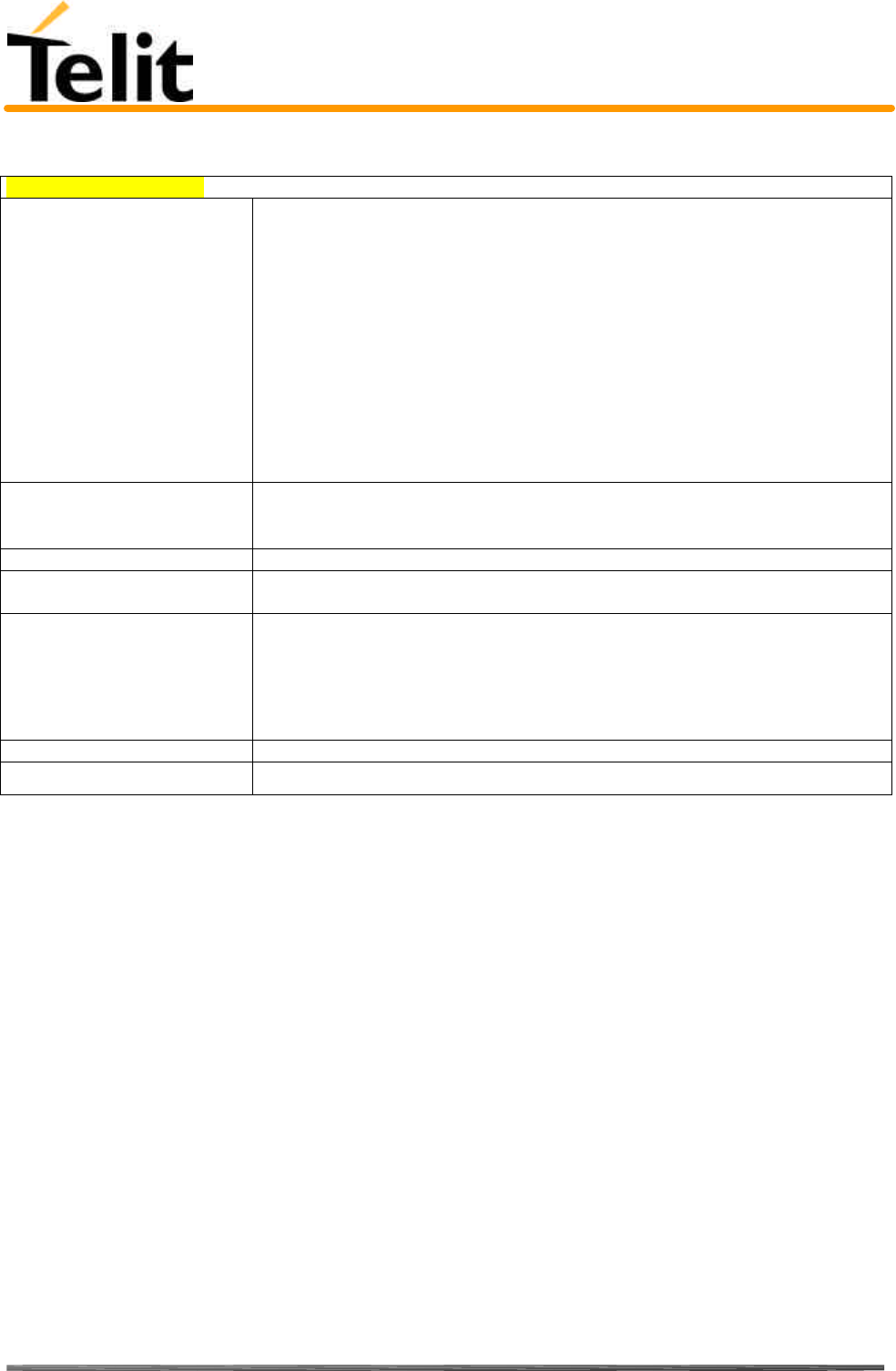
Telit TRIZIUM Product Description
80264ST10007a Rev. 4– 09/09/04
Reproduction forbidden without DAI Telecom written authorization – All Right reserved – Right of modification reserved page 144 of 202
5.6.1.8 #SRP –Select Ringer Path
#SRP – select ringer path
Execute command
AT#SRP=<n> Selects the audio path towards whom sending ringer sounds and all signaling tones.
Parameter:
<n> - Ringer path number
0 - sound output towards current selected audio path (see command
#CAP)
1 - sound output towards handsfree
2 - sound output towards headset
3 - sound output towards Buzzer Output pin GPIO7
Note: In order to use the Buzzer Output an external circuitry must be added to drive
it properly from the GPIO7 pin, furthermore the GPIO7 pin direction must be set to
Buzzer output (Alternate function) see command #GPIO.
Read command AT#SRP?
Reports the current ringer path setting in the format: #SRP:<n>.
Write command
Test command
AT#SRP=? Reports the supported values for the parameter <n>.
Example AT#SRP=?
#SRP=(0-3)
OK
AT#SRP=3
OK
Reference Telit TRIZIUM AT Command Specification
SW release Version A
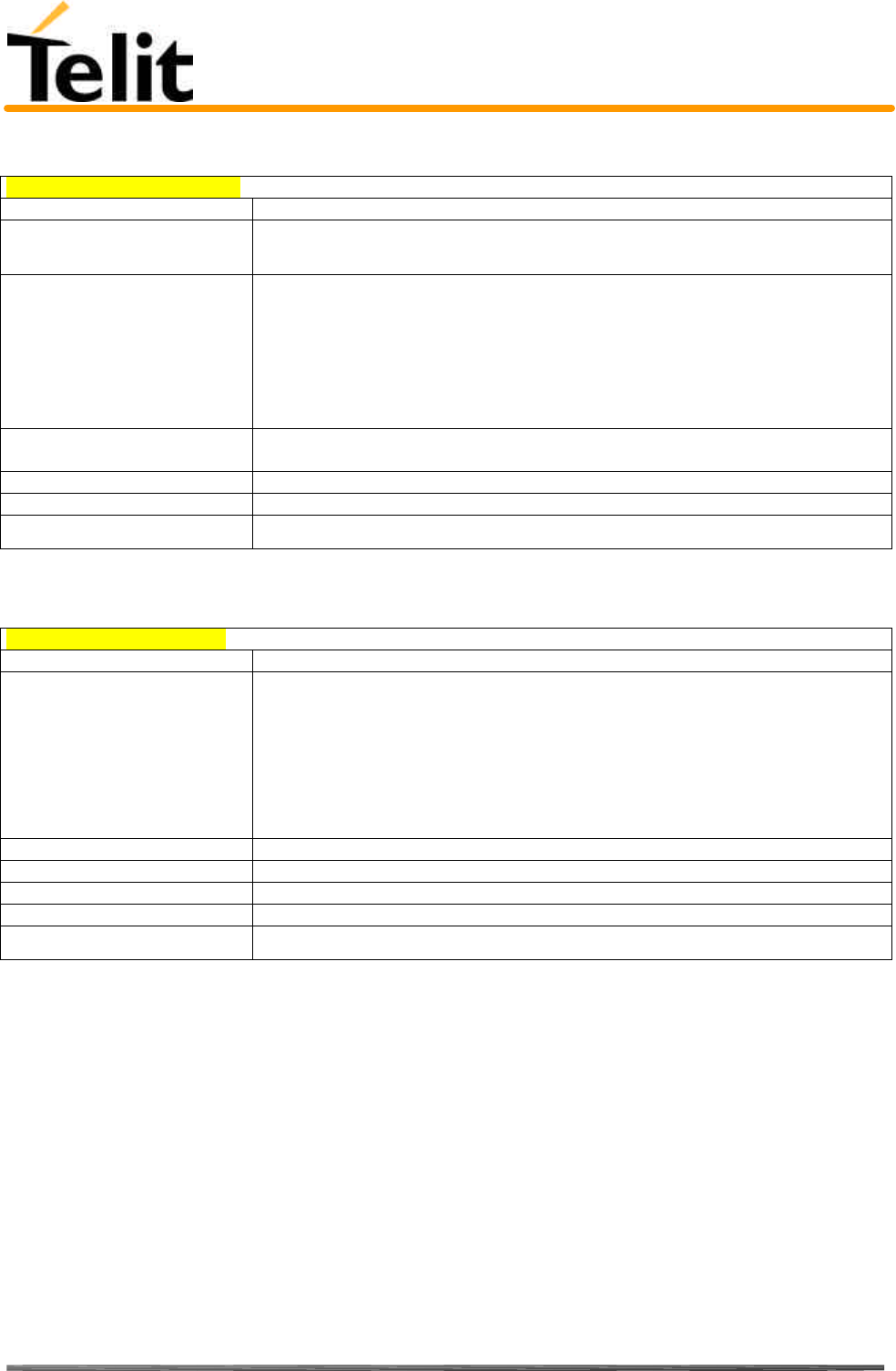
Telit TRIZIUM Product Description
80264ST10007a Rev. 4– 09/09/04
Reproduction forbidden without DAI Telecom written authorization – All Right reserved – Right of modification reserved page 145 of 202
5.6.1.9 #STM - Signalling Tones Mode
#STM – signalling tones mode
Execute command
Read command AT#STM?
Reports the current signaling tones status in the format:#STM: <mode>
Write command
AT#STM = <mode> Enables/disables the signaling tones output on the audio path selected with #SRP
command
Parameter :
<mode> - signaling tones status
<mode> = 0 - signaling tones disabled
<mode> = 1 - signaling tones enabled
Test command
AT#STM=? Reports supported range of values for <mode> parameter.
Example
Reference Telit TRIZIUM AT Command Specification
SW release Version A
5.6.1.10 #PCT – display PIN Counter
#PCT – display PIN counter
Execute command
Read command AT#PCT? Reports the PIN/PUK or PIN2/PUK2 input remaining attempts, depending on
+CPIN requested password in the format:
#PCT:<n>
Note: If +CPIN requires the PIN then max 3 attempts are allowed,
after that the PUK code is requested; if even PUK is input wrong for
other three time then #PCT:0 and SIM remains blocked.
Write command
Test command
Example
Reference Telit TRIZIUM AT-GPRS Command Specification
SW release Version A
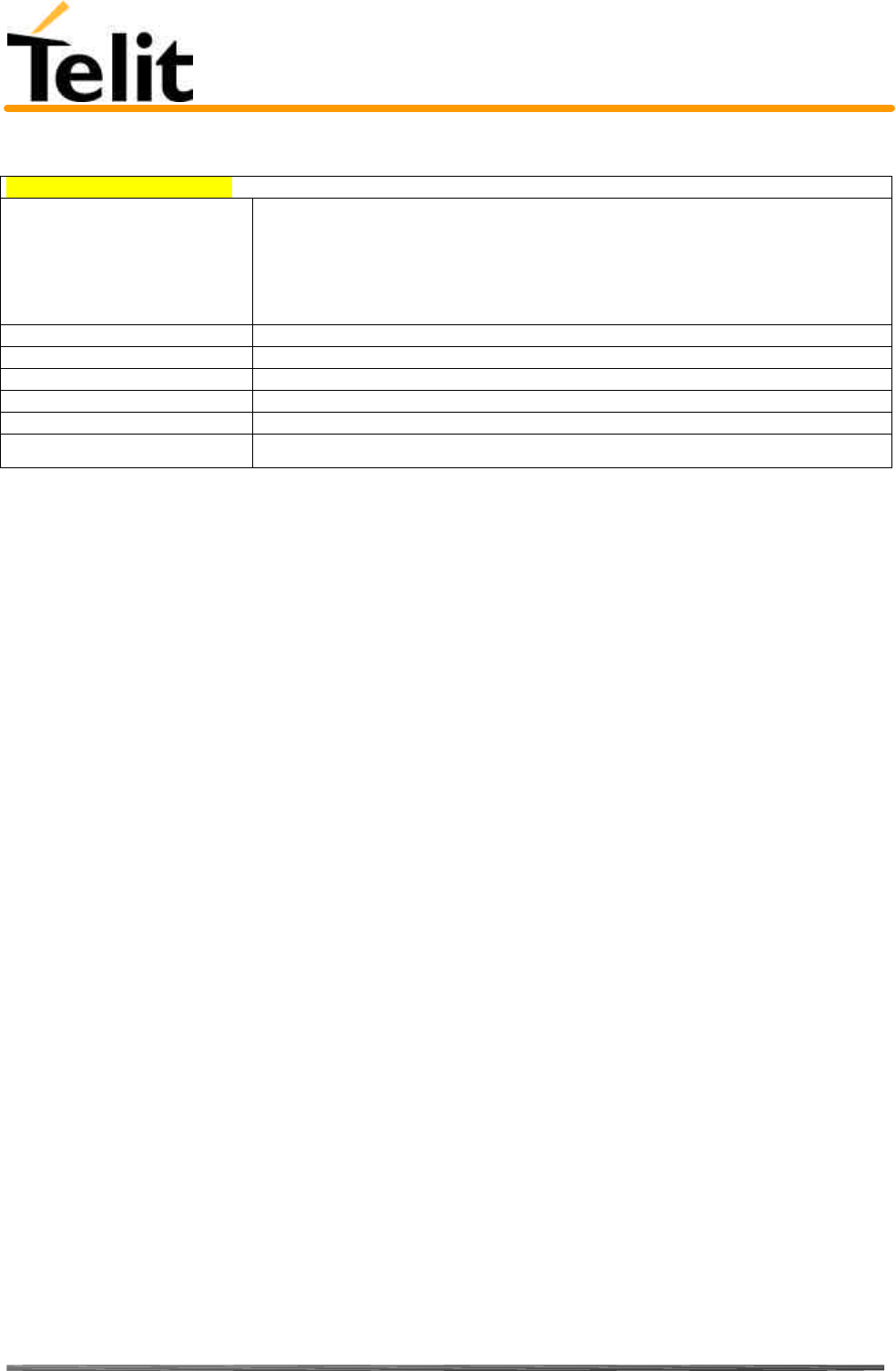
Telit TRIZIUM Product Description
80264ST10007a Rev. 4– 09/09/04
Reproduction forbidden without DAI Telecom written authorization – All Right reserved – Right of modification reserved page 146 of 202
5.6.1.11 #SHDN – Software Shut Down
#SHDN – software shutdown
Execute command AT#SHDN After the issuing of this command device detaches from the network and shuts
down. Before definitive shut down an OK response is returned.
Note: after the issuing of this command any previous activity is terminated and the
device will not respond to any further command. To turn it on again Hardware pin
ON/OFF must be tied low.
Read command
Write command
Test command
Example
Reference Telit TRIZIUM AT-GPRS Command Specification
SW release Version A
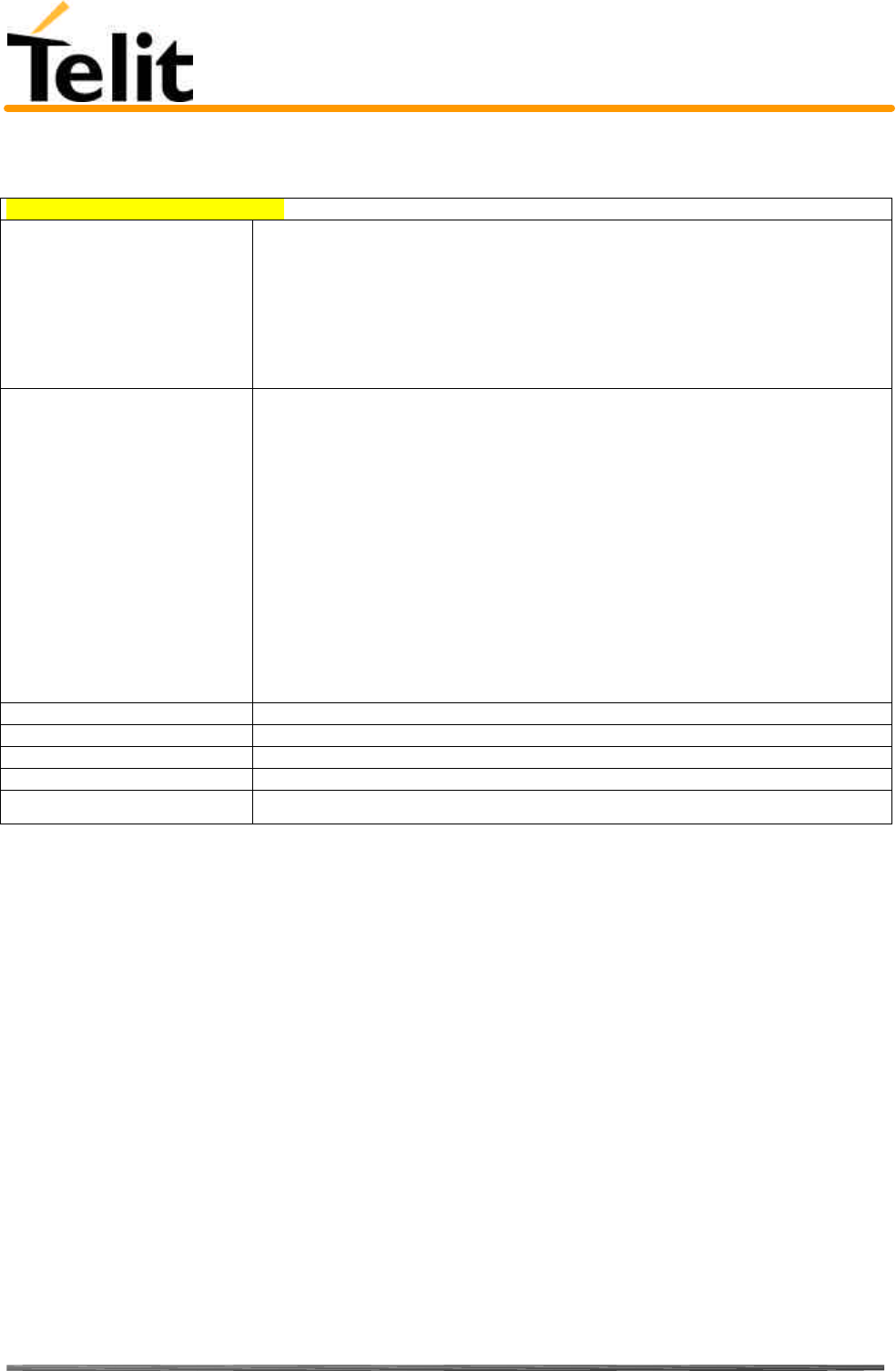
Telit TRIZIUM Product Description
80264ST10007a Rev. 4– 09/09/04
Reproduction forbidden without DAI Telecom written authorization – All Right reserved – Right of modification reserved page 147 of 202
5.6.1.12 #WAKE – Wake from Alarm mode
#WAKE – Wake from Alarm Mode
Execute command
AT#WAKE=0 After the issuing of this command device exits the "Alarm mode" and enters the
normal operating mode. After entering in normal operating mode an OK response is
returned.
With the execution of is command all Alarm activity (for example alarm tone
playing ) is immediately terminated.
If the command is issued during the normal operating mode then the only action is
to stop Alarm activity, if present, and return OK response.
Read command
AT#WAKE? This command returns the operating mode status of the device in the format:
#WAKE: <status>
where:
<status> - operating mode
0 - normal operating mode
1 - alarm mode
Note: The "alarm mode" is indicated by hardware pin CTS to the ON status and
DSR to the OFF status, while the "power saving" status is indicated by a CTS -
OFF and DSR - OFF status. The normal operating status is indicated by DSR - ON.
During the "alarm mode" the device will not make any network scan and will not
register to any network and therefore is not able to dial or receive any call or SMS,
the only commands that can be issued to the TRIZIUM in this state are the #WAKE
and #SHDN, every other command must not be issued during this state.
Write command
Test command
Example
Reference Telit TRIZIUM AT Command Specification
SW release Version A
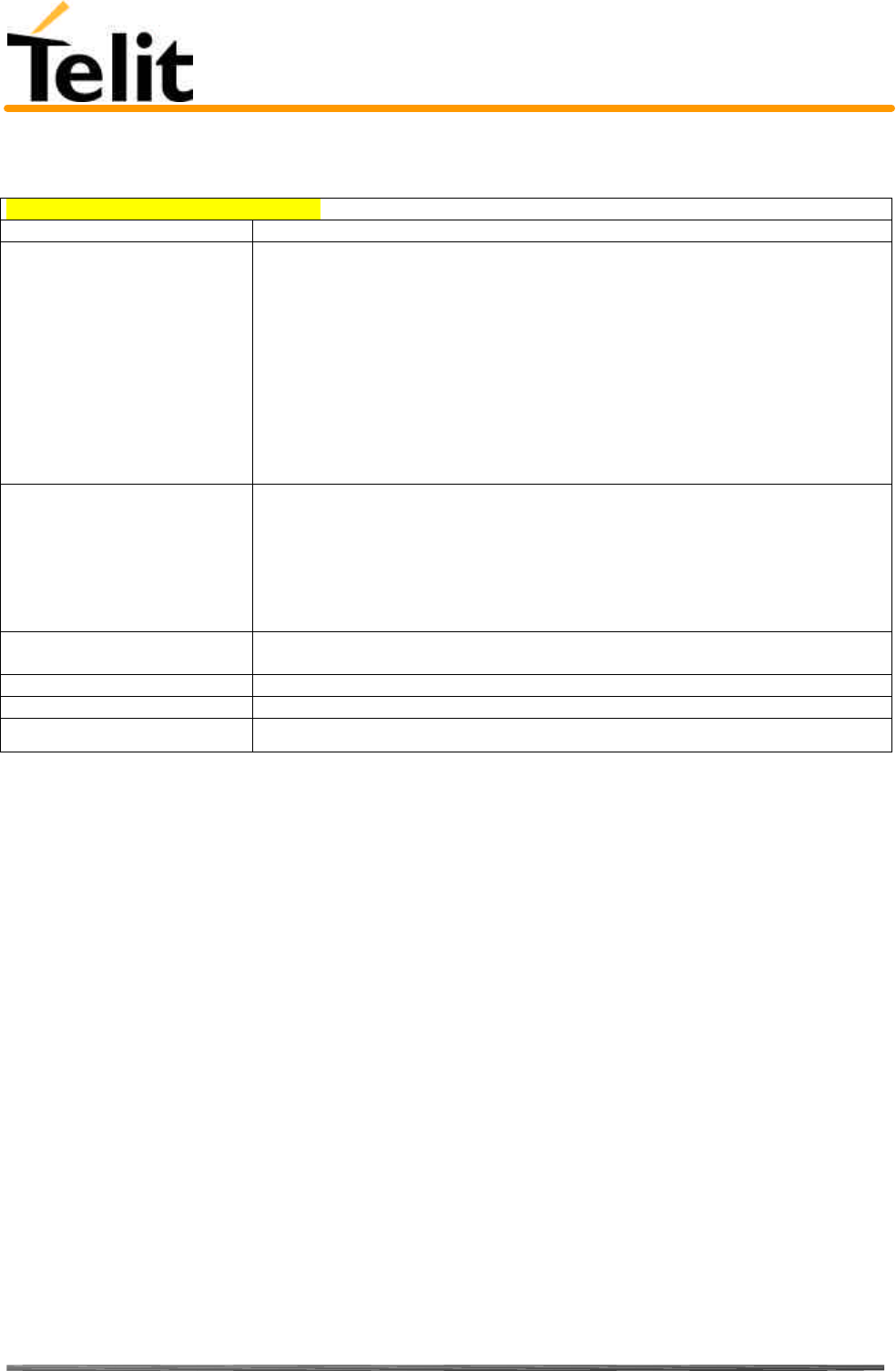
Telit TRIZIUM Product Description
80264ST10007a Rev. 4– 09/09/04
Reproduction forbidden without DAI Telecom written authorization – All Right reserved – Right of modification reserved page 148 of 202
5.6.1.13 #QTEMP –Query Temperature overflow
#QTEMP – query temperature overflow
Execute command
Read command
AT#QTEMP? Queries the internal temperature sensor of the device for over temperature. The result
is reported in the format:
#QTEMP:<temp>
where
<temp> - over temperature indicator
<temp> = 0 - device temperature is in the working range
<temp> = 1- device temperature is out of the working range, may be too high or too
low.
Note: The device should not be operated out of its working temperature range; if
temperature is out of range proper functioning of the device is not ensured.
Write command
AT#QTEMP = <mode> Sets the type of indication.
Parameter:
<mode> - type of indication
0 - result reported only when querying with #QTEMP?
1 - reserved for future use
2 – reserved for future use
Test command
#QTEMP=? Reports supported range of values for <mode> parameter.
Example
Reference Telit TRIZIUM AT Command Specification
SW release Version A
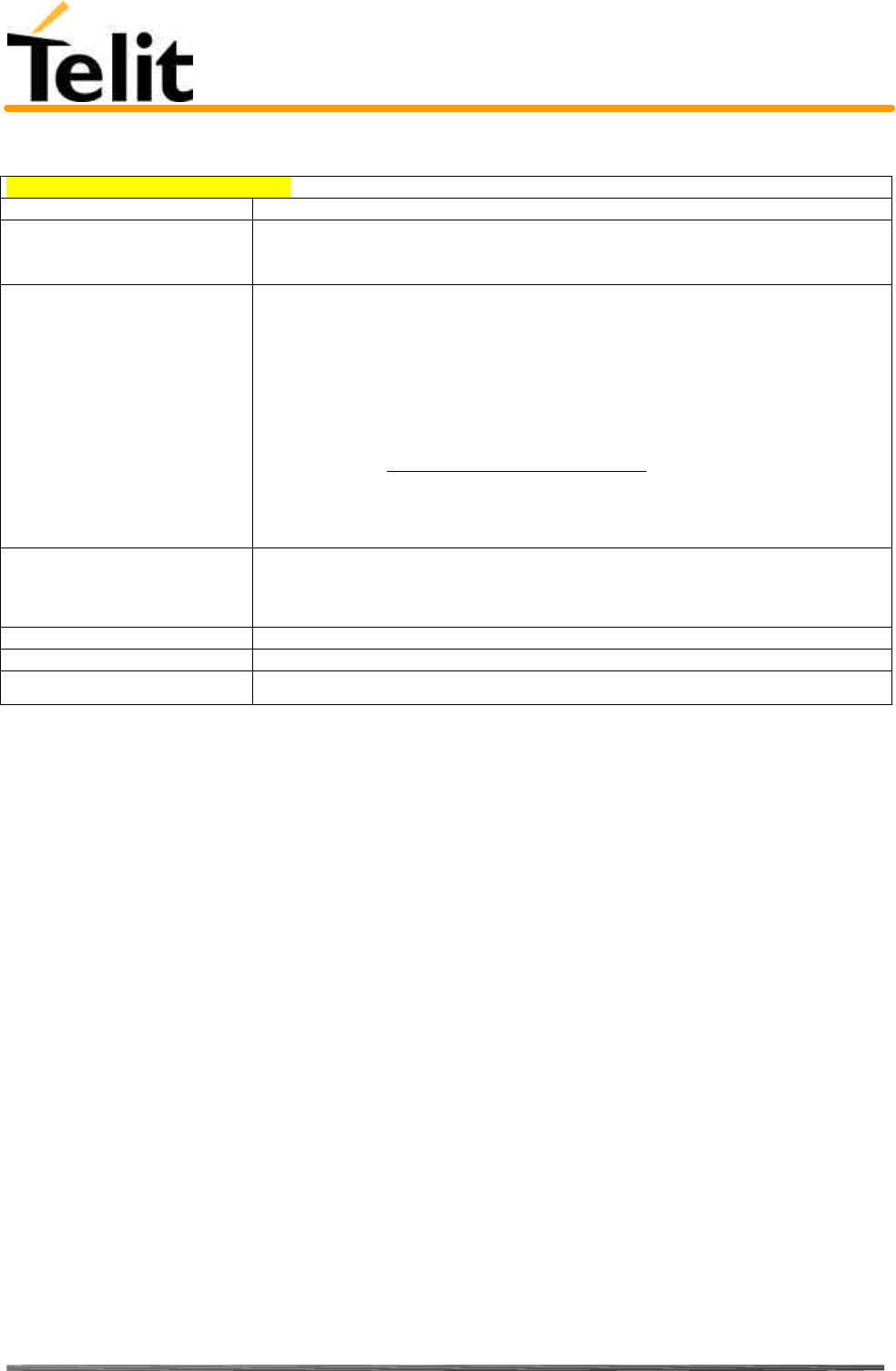
Telit TRIZIUM Product Description
80264ST10007a Rev. 4– 09/09/04
Reproduction forbidden without DAI Telecom written authorization – All Right reserved – Right of modification reserved page 149 of 202
5.6.1.14 #SGPO –Set General Purpose Output
#SGPO – set general purpose output
Execute command
Read command
AT#SGPO? Reports the #SGPO command setting, hence the opposite status of the open collector
pin in the format: #SGPO: <stat>.
Write command
AT#SGPO = <stat> Sets the value of the general purpose output pin GPIO2 according to <stat>
parameter
Parameter:
<stat>
0 - output pin cleared to 0 (LOW)
1 - output pin set to 1 (HIGH)
Note: The GPIO2 is an OPEN COLLECTOR output, the command sets the transistor
base level, hence the open collector output is negated:
AT#SGPO= 0 sets the open collector output HIGH
AT#SGPO= 1 sets the open collector output LOW
A pull up resistor is required on pin GPIO2.
Test command
AT#SGPO=? Reports the supported range of values of the command parameter
<stat>.
Example
Reference Telit TRIZIUM AT Command Specification
SW release Version A
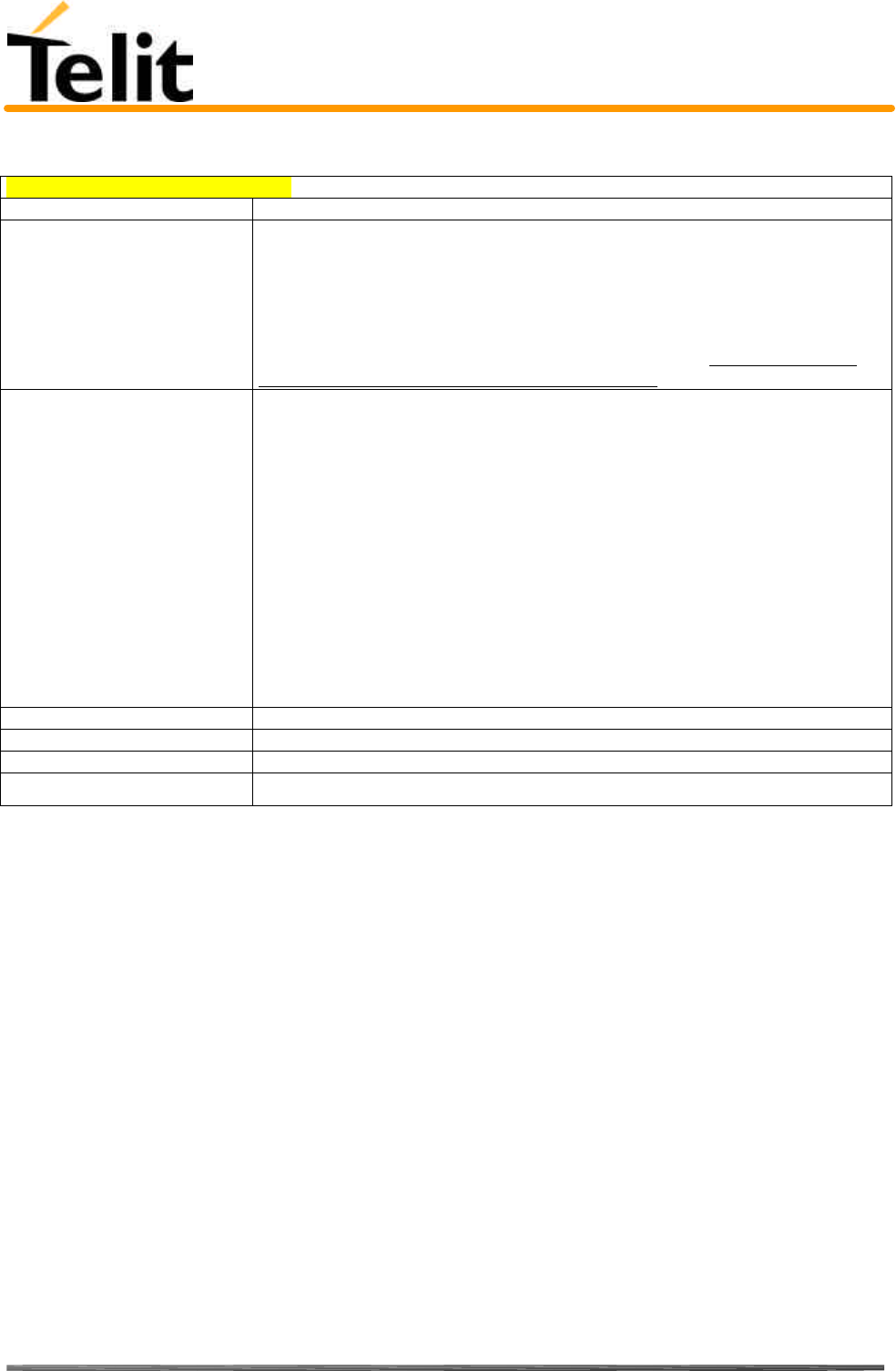
Telit TRIZIUM Product Description
80264ST10007a Rev. 4– 09/09/04
Reproduction forbidden without DAI Telecom written authorization – All Right reserved – Right of modification reserved page 150 of 202
5.6.1.15 #GGPI – Read General Purpose Input
#GGPI – read general purpose input
Execute command
Read command
AT#GGPI? Reports the read value for the input pin GPIO1in the format:
#GGPI: <dir>,<stat>
where
<dir> direction setting (see #GGPI=<dir> )
<stat> - logic value read from pin GPIO1
Note: Since the reading is done after the insulating transistor, the reported value is
the opposite of the logic status of the GPIO1 input pin.
Write command
AT#GGPI = <dir> Set the General purpose input pin behavior depending on parameter
<dir>.
Parameter: <dir> - auxiliary input GPIO1 setting
<dir> = 0 - the read command reports the logic input level read from
GPIO1 pin.
<dir> = 1…255 - reserved for future use
Note: The device has an insulated input pin ( the input goes the base of an internal
decoupling transistor) which can be used as a logic general purpose input. This
command sets the read behaviour for this pin, since only direct read report is
supported, the issue of this command is not needed.
In future uses the behavior of the read input may be more complex.
Test command
Example
Reference Telit TRIZIUM AT Command Specification
SW release Version A

Telit TRIZIUM Product Description
80264ST10007a Rev. 4– 09/09/04
Reproduction forbidden without DAI Telecom written authorization – All Right reserved – Right of modification reserved page 151 of 202
5.6.1.16 #GPIO –General Purpose Input/Output pin control
#GPIO –General Purpose Input/Output pin control
Execute command
Read command
AT#GPIO=<pin>,2 Reports the read value for the pin GPIO<pin> in the format:
#GPIO: <dir>,<stat>
where
<dir> - current direction setting for the GPIO<pin>
<stat> - logic value read from pin GPIO<pin> in the case the pin
<dir> is set to input;
- logic value present in output of the pin GPIO<pin> in the case
the pin <dir> is currently set to output;
- no meaning value for the pin GPIO<pin> in the case
the pin <dir> is set to alternate function;
Note for GPIO1: Since the reading is done after the insulating transistor, the reported
value is the opposite of the logic status of the GPIO1 input pin.
Write command
AT#GPIO =<pin>,
<mode>,<dir> Sets the value of the general purpose output pin GPIO<pin> according to <dir> and
<mode> parameter.
Not all configuration for the three parameters are valid.
Parameter:
<pin> - GPIO pin number
supported range is from 1 to 7, but GPIO1 is input only and GPIO2
is output only.
<dir> - GPIO pin direction
0 - pin direction in INPUT
1 - pin direction is OUTPUT
2 - pin direction is ALTERNATE FUNCTION *see Note
<mode> - its meaning depends on <dir> setting:
0 - no meaning if <dir> = 0 - INPUT
- output pin cleared to 0 (LOW) if <dir> = 1 - OUTPUT
- no meaning if <dir> = 2 - ALTERNATE FUNCTION
1 - no meaning if <dir> = 0 - INPUT
- output pin set to 1 (HIGH) if <dir> = 1 - OUTPUT
- no meaning if <dir> = 2 - ALTERNATE FUNCTION
2 - Reports the read value from the input pin (see Read command) if <dir> = 0 -
INPUT
- Reports the read value from the input pin (see Read command) if <dir> = 1 -
OUTPUT
- Reports a no meaning value (see Read command) if <dir> = 2 - ALTERNATE
FUNCTION
Note: "ALTERNATE FUNCTION" value is valid only for pins
GPIO6 - alternate function is "Alarm Output" (see command +CALA)
GPIO7 - alternate function is "Buzzer Output" (see command #SRP)
While using the pins in the alternate function, the GPIO read/write access to that pin
is not accessible and shall be avoided.
Note: The GPIO2 is an OPEN COLLECTOR output, the command sets the transistor
base level, hence the open collector output is negated
Test command
AT#GPIO=?
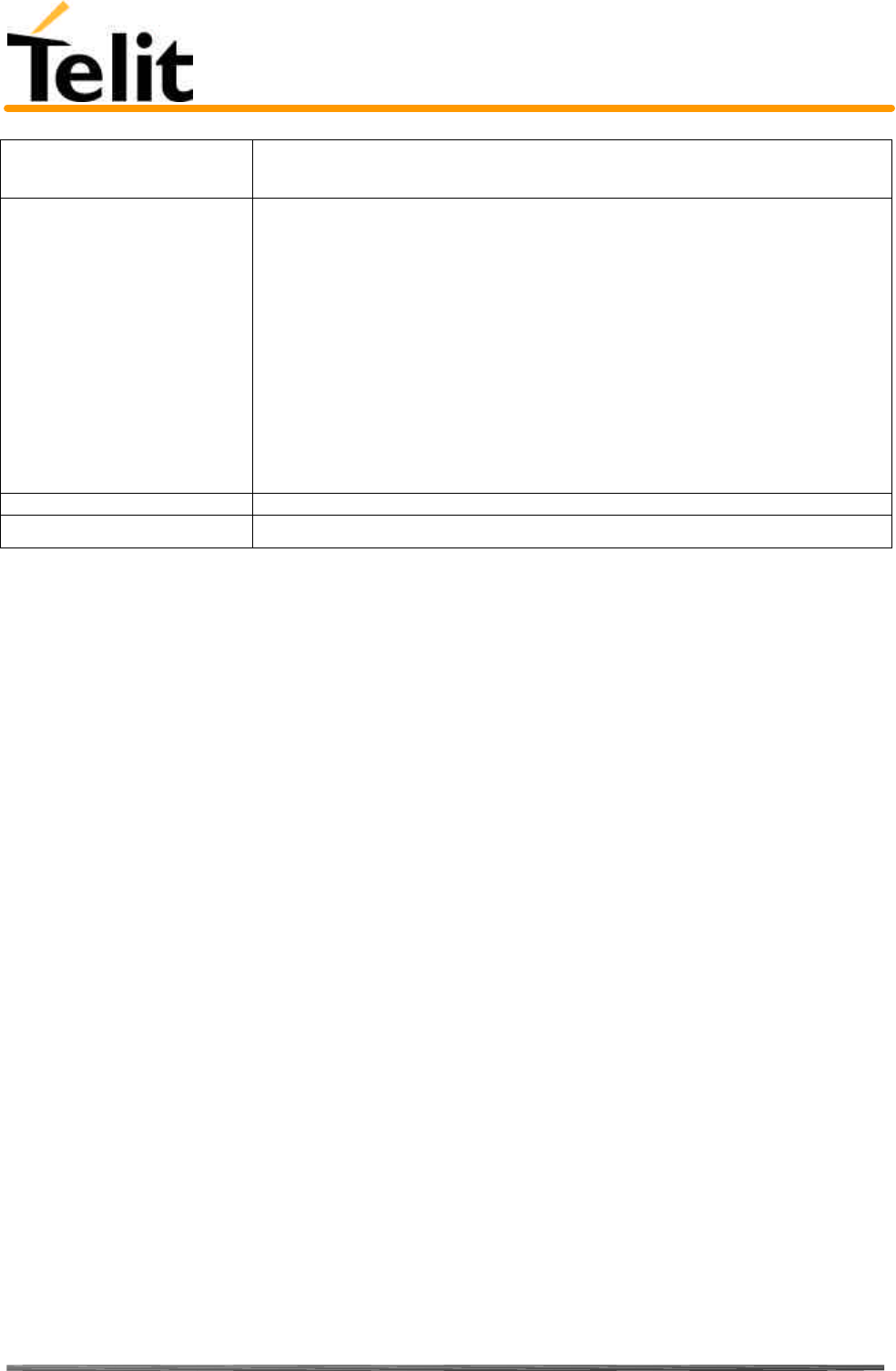
Telit TRIZIUM Product Description
80264ST10007a Rev. 4– 09/09/04
Reproduction forbidden without DAI Telecom written authorization – All Right reserved – Right of modification reserved page 152 of 202
Reports the supported range of values of the command parameters
<pin>,<mode>,<dir>.
Example AT#GPIO=3,0,1
OK
AT#GPIO=3,2
#GPIO: 1,0
OK
AT#GPIO=4,1,1
OK
AT#GPIO=5,0,0
OK
AT#GPIO=6,2
#GPIO: 0,1
OK
AT#GPIO=7,0,0
OK
Reference Telit TRIZIUM AT Command Specification
SW release Version A
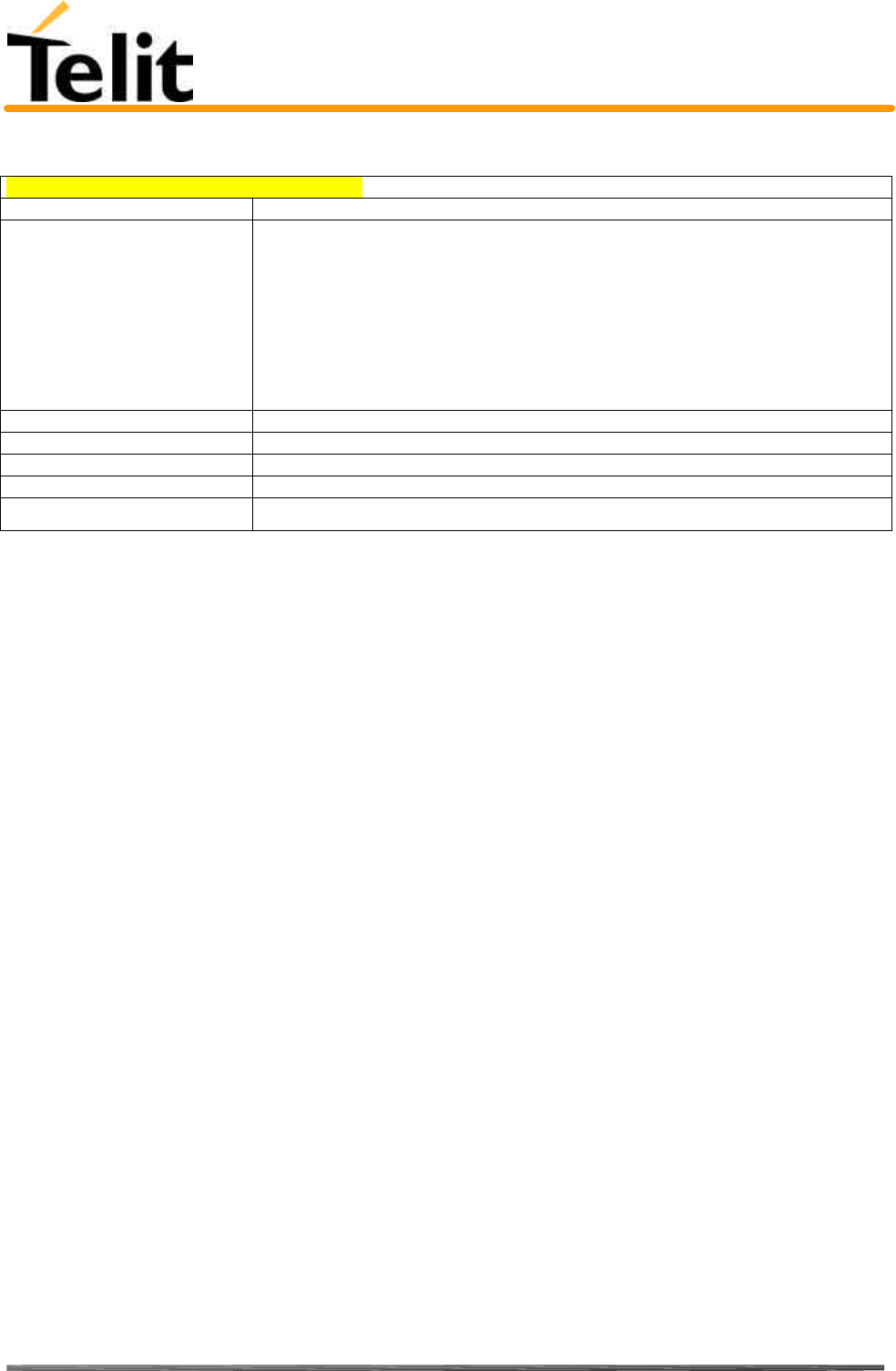
Telit TRIZIUM Product Description
80264ST10007a Rev. 4– 09/09/04
Reproduction forbidden without DAI Telecom written authorization – All Right reserved – Right of modification reserved page 153 of 202
5.6.1.17 #ADC – Read Analog/Digital Converter input
#ADC – Read Analog/Digital Converter input
Execute command
Read command
AT#ADC? Reports the read value on the input pin ADC after Analog to Digital conversion in
the format:
#ADC: <value>
where
<value> - the Digital number representing the analog value of the voltage on the
ADC_IN pin.
Note: The command returns the last valid measure.
Write command
Test command
Example
Reference Telit TRIZIUM AT Command Specification
SW release Version B
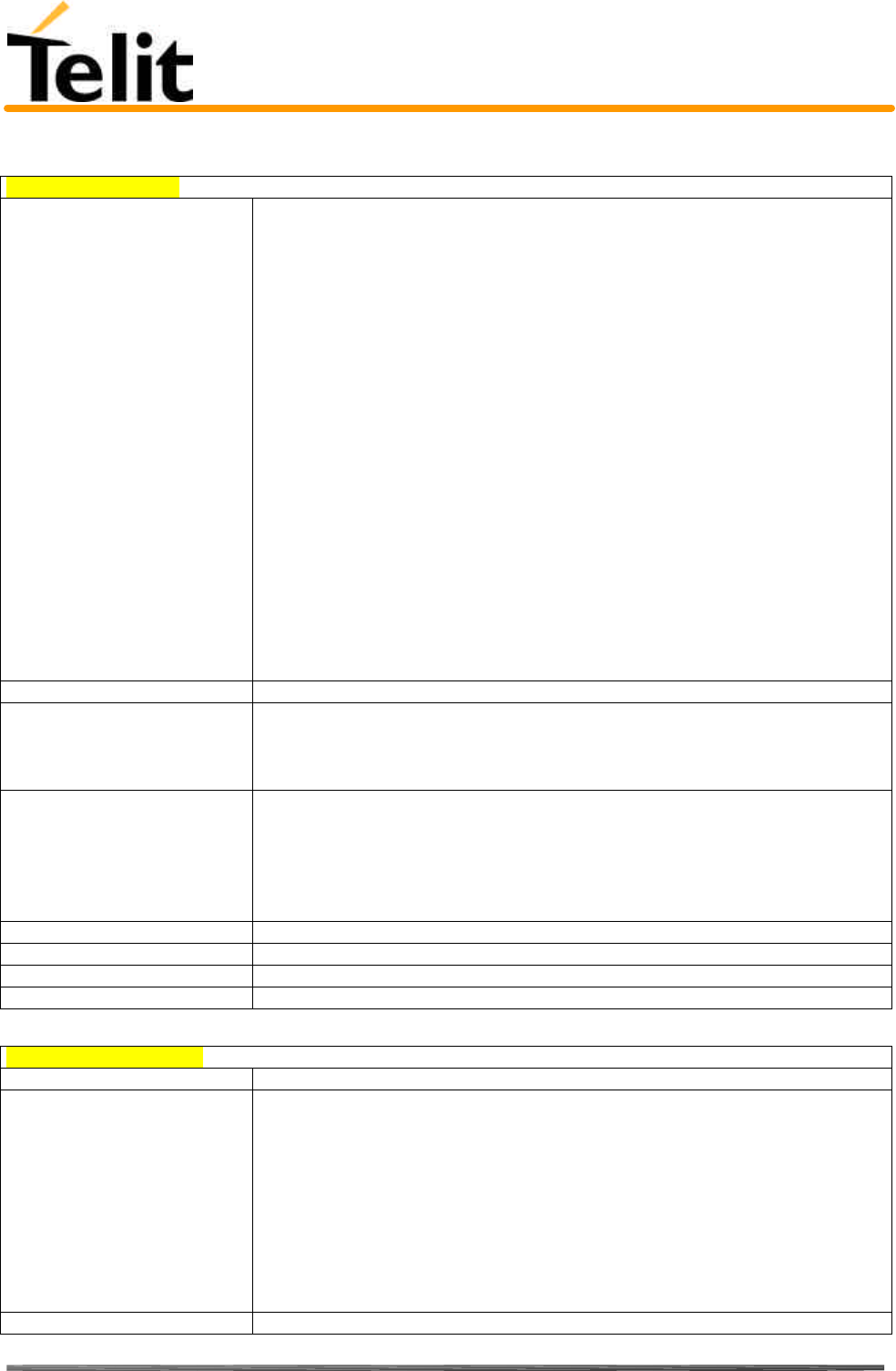
Telit TRIZIUM Product Description
80264ST10007a Rev. 4– 09/09/04
Reproduction forbidden without DAI Telecom written authorization – All Right reserved – Right of modification reserved page 154 of 202
5.6.1.18 #MONI – Monitor Cells
#MONI – monitor cell
Execute command
AT#MONI Reports the available data for cell and dedicated channel (if exists) in the format:
#MONI: <netname> BSIC:<bsic> RxQual:<qual> LAC:<lac> Id:<id>
ARFCN:<arfcn> PWR:<dBm> dBm
or in the case the network name is not known:
#MONI: Cc:<cc> Nc:<nc> BSIC:<bsic> RxQual:<qual> LAC:<lac> Id:<id>
ARFCN:<arfcn> PWR:<dBm> dBm
or in the case in which the data of the adjacent cell are under observation
(number>0):
#MONI: Adj Cell<n> [LAC:<lac> Id:<id>] ARFCN:<arfcn> PWR:<dBm> dBm
where:
netname = name of network operator
cc = country code
nc = network operator code
n = progressive number of adjacent cell
bsic = base station identification code
qual = quality of reception (0-7)
lac = localization area code
id = cell identifier
arfcn = assigned radio channel
dBm = received signal strength in dBm
Read command
Write command
AT#MONI =<number> Set the neighbor cell to extract data of the cell number <number>
Parameter: <number>
Test command AT#MONI=? Reports the available neighbour cells and current cell preset in the format: #MONI:
<CellNo, CellSet>
where:
<CellNo> - neighbour cells number
<CellSet> - cell preset = 0, …, n where 0 is the serving cell
Example
Note The refresh time of the measures is preset to 3 sec
Reference Telit TRIZIUM AT Command Specification
SW release Version A
5.6.1.19 #QSS – Query SIM Status
#QSS – query SIM status
Execute command
Read command
AT#QSS? Reports the query SIM status in the format:
#QSS: <mode>,<status>
where
<mode>: type of enabled notification
<mode> = 0 - query only
<mode> = 1 - send unsolicited indication (#USS) every change of state
<status>: current SIM status
<status> = 0 - SIM NOT INSERTED
<status> =1 - SIM INSERTED
Write command
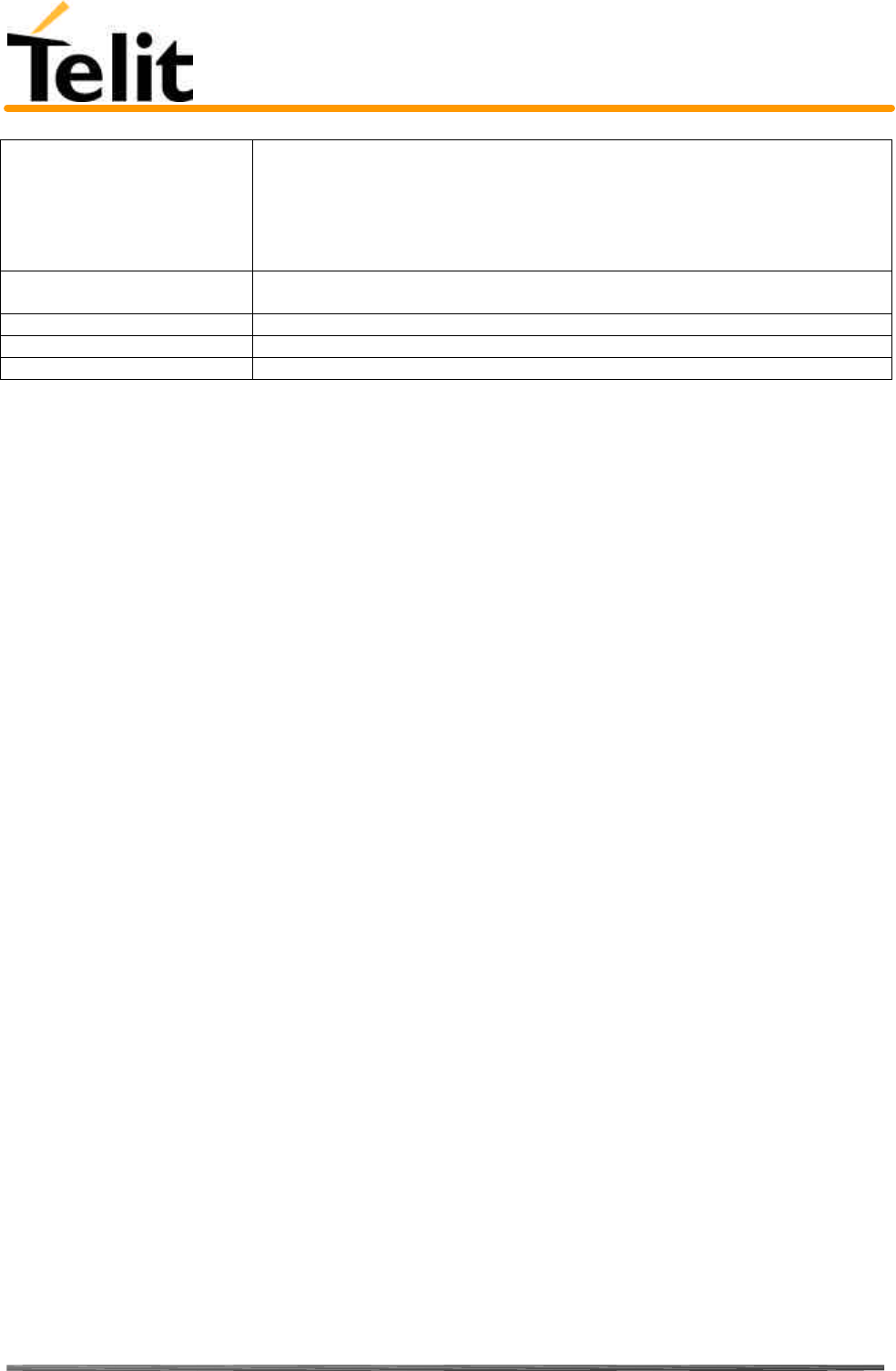
Telit TRIZIUM Product Description
80264ST10007a Rev. 4– 09/09/04
Reproduction forbidden without DAI Telecom written authorization – All Right reserved – Right of modification reserved page 155 of 202
AT#QSS = <mode> Set the type of notification.
If enabled (mode = 1) at any status change is send:
#USS: <status>
Parameter: <mode>
Test command
AT#QSS=? Returns the supported range of values of the parameter <mode>.
Example
Reference Telit TRIZIUM AT Command Specification
SW release Version A
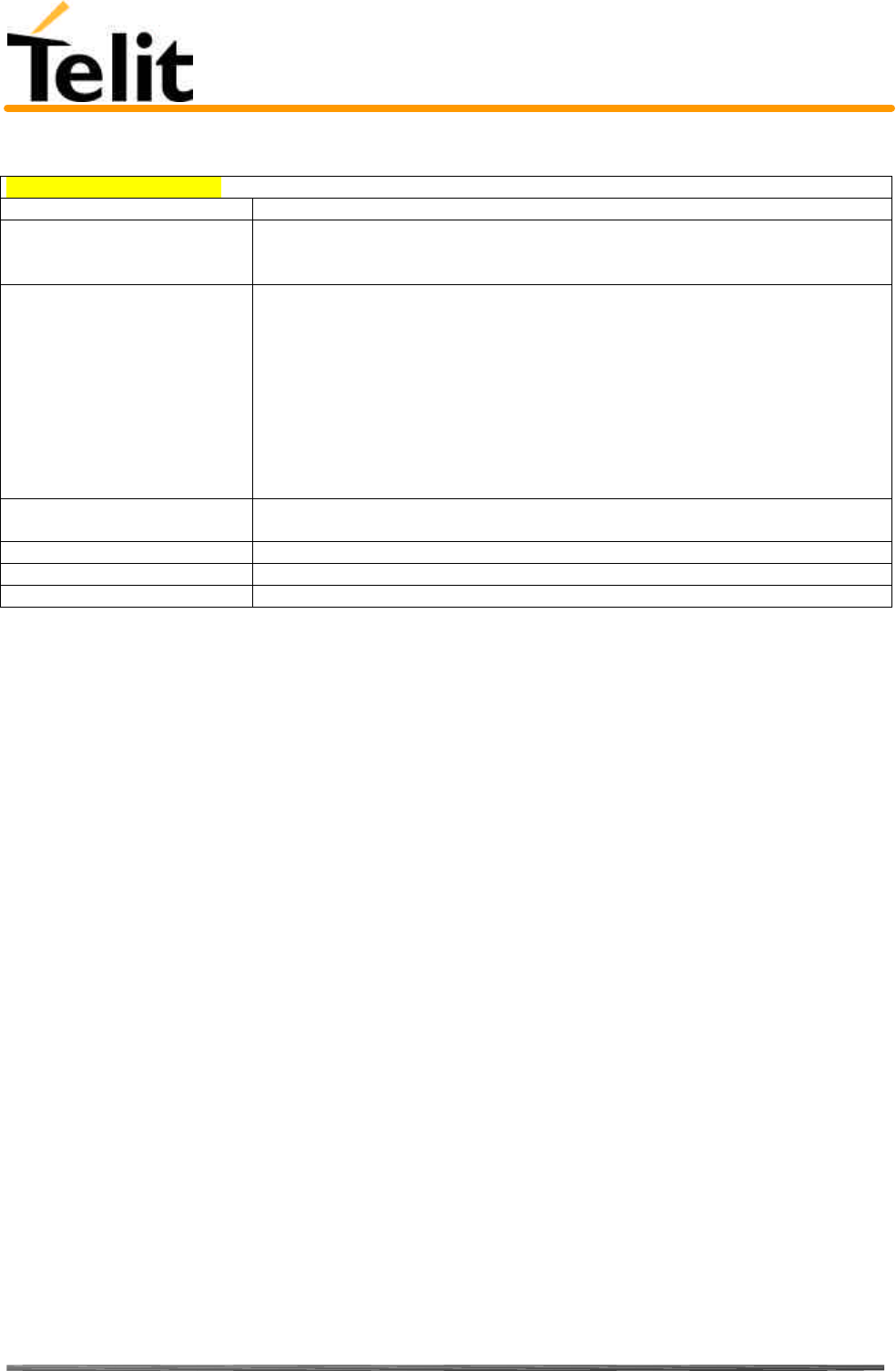
Telit TRIZIUM Product Description
80264ST10007a Rev. 4– 09/09/04
Reproduction forbidden without DAI Telecom written authorization – All Right reserved – Right of modification reserved page 156 of 202
5.6.1.20 #ACAL – Set Automatic Call
#ACAL – set automatic call
Execute command
Read command AT#ACAL? Returns the current status in the format:
#ACAL: <mode>
Write command
AT#ACAL = <mode> Enable the automatic call.
Parameter:
<mode> = 0 – disable
<mode> = 1 – enable
If enabled, the transition OFF/ON of DTR causes an automatic data call to the
number stored in position number 1 of the phone book.
The &D command must be set to 2.
Test command
AT#ACAL=? Returns the supported range of values of the parameter <mode>.
Example
Reference Telit TRIZIUM AT Command Specification
SW release Future SW Version
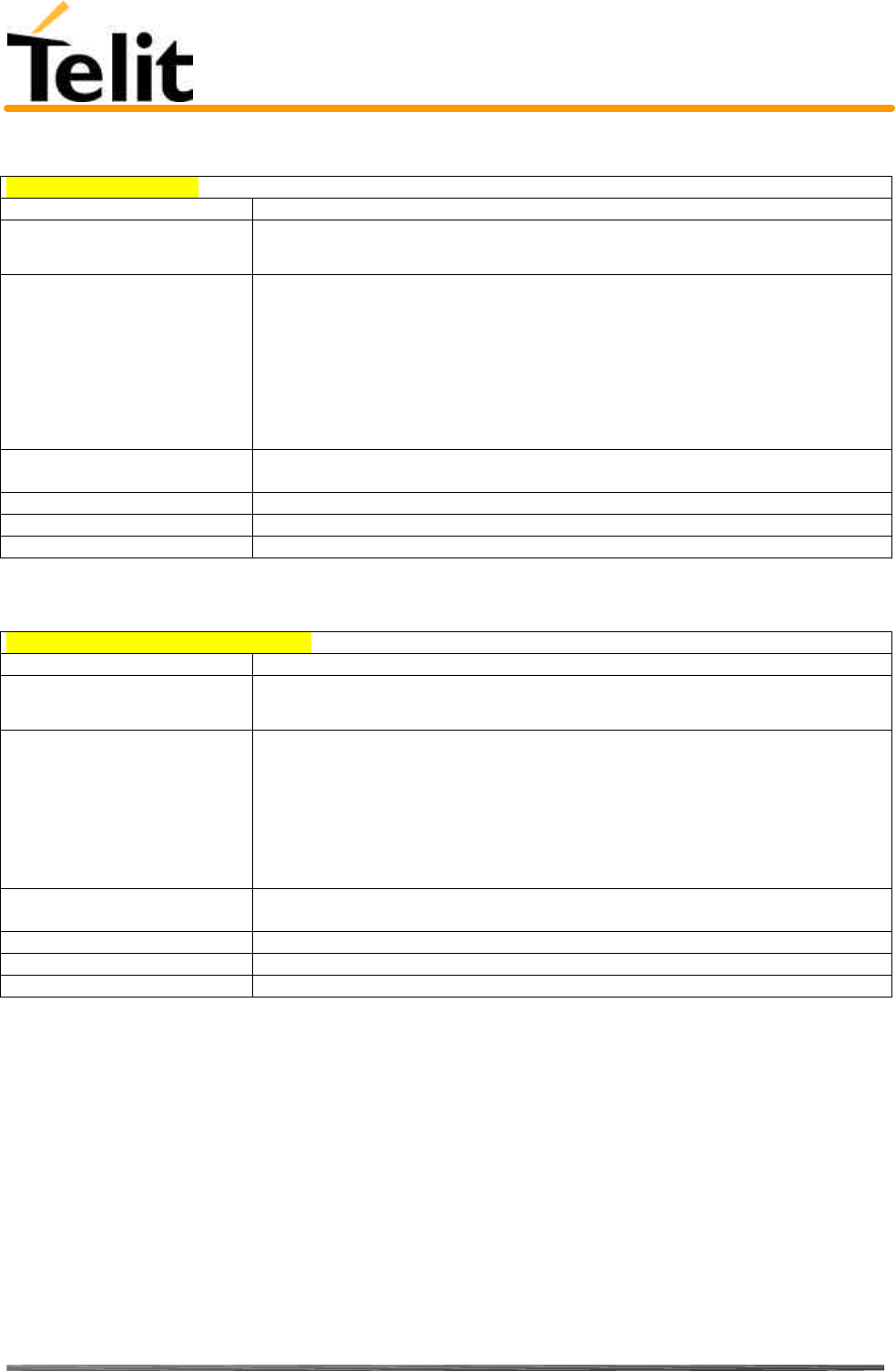
Telit TRIZIUM Product Description
80264ST10007a Rev. 4– 09/09/04
Reproduction forbidden without DAI Telecom written authorization – All Right reserved – Right of modification reserved page 157 of 202
5.6.1.21 #SMOV – SMS Overflow
#SMOV – SMS overflow
Execute command
Read command
AT#SMOV? Return the current status in the format: #SMOV: <mode>.
Write command
AT#SMOV= <mode> Enable the signalling of SMS overflow
Parameter:
<mode> = 0 - disable
<mode> = 1 - enable
If enable, when the maximum storage capacity has came, the
#USMO:<memo> network initiated notification is send.
Test command
AT#SMOV=? Returns the supported range of values of the parameter <mode>.
Example
Reference Telit TRIZIUM AT Command Specification
SW release Version A
5.6.1.22 #SHFEC – Set Handsfree echo canceller
#SHFEC – set handsfree echo canceller
Execute command
Read command
AT#SHFEC? Return the current status in the format: #SHFEC: <mode>.
Write command
AT#SHFEC= <mode> Set echo canceller on audio handsfree output.
Parameter <mode>:
0 - disable echo canceller for headset mode (default)
1 - enable, setting for handsfree mode
2…255 reserved
Note: This setting returns to default after power off.
Test command
AT#SHFEC=? Returns the supported range of values of the parameter <mode>.
Example
Reference Telit TRIZIUM AT Command Specification
SW release Version A
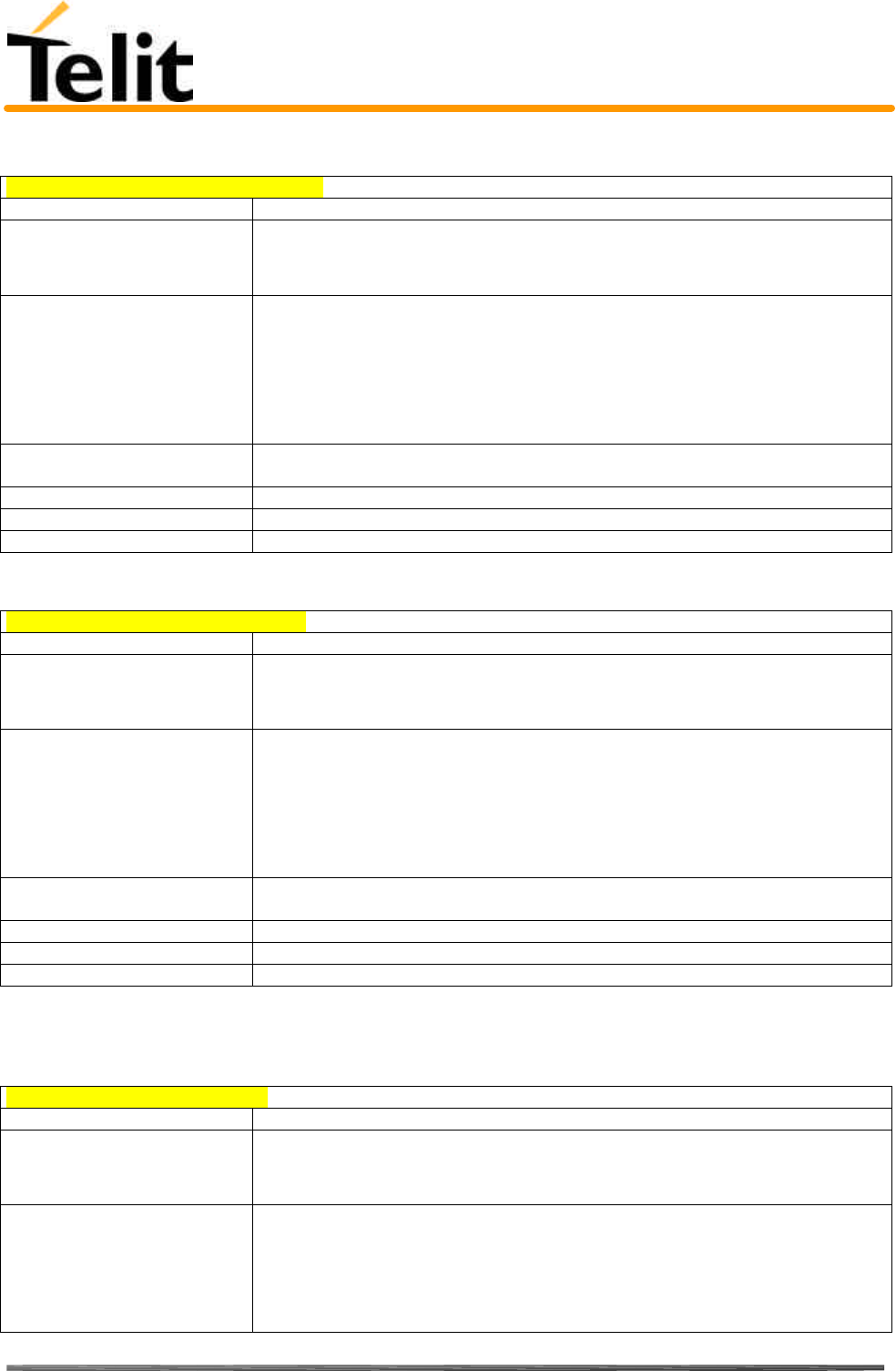
Telit TRIZIUM Product Description
80264ST10007a Rev. 4– 09/09/04
Reproduction forbidden without DAI Telecom written authorization – All Right reserved – Right of modification reserved page 158 of 202
5.6.1.23 #HFMICG – Handsfree Microphone Gain
#HFMICG – handsfree microphone gain
Execute command
Read command
AT#HFMICG? Return the current status of handsfree input gain in the format:
#HFMICG: <level>
Write command
AT#HFMICG = <level> Set the microphone input gain
Parameter:
<level>: handsfree microphone input gain
0 - 7 handsfree microphone gain (+6dB/step)
8…255 reserved
Test command
AT#HFMICG=? Returns the supported range of values of the parameter <level>.
Example
Reference Telit TRIZIUM AT Command Specification
SW release Version A
5.6.1.24 #HSMICG – Handset Microphone Gain
#HSMICG – handset microphone gain
Execute command
Read command
AT#HSMICG? Return the current status of handset input gain in the format:
#HSMICG: <level>
Write command
AT#HSMICG = <level> Set the microphone input gain
Parameter:
<level>: handset microphone input gain
0 - 7 handset microphone gain (+6dB/step)
8…255 reserved
Test command
AT#HSMICG=? Returns the supported range of values of the parameter <level>.
Example
Reference Telit TRIZIUM AT Command Specification
SW release Version A
5.6.1.25 #SHFSD – Set Handsfree side tone
#SHFSD – set handsfree side tone
Execute command
Read command
AT#SHFSD? Return the current status in the format:
#SHFSD: <mode>
Write command
AT#SHFSD = <mode> Set the sidetone on handsfree audio output.
Parameter
<mode>:
0 - disabled - headset mode (default)
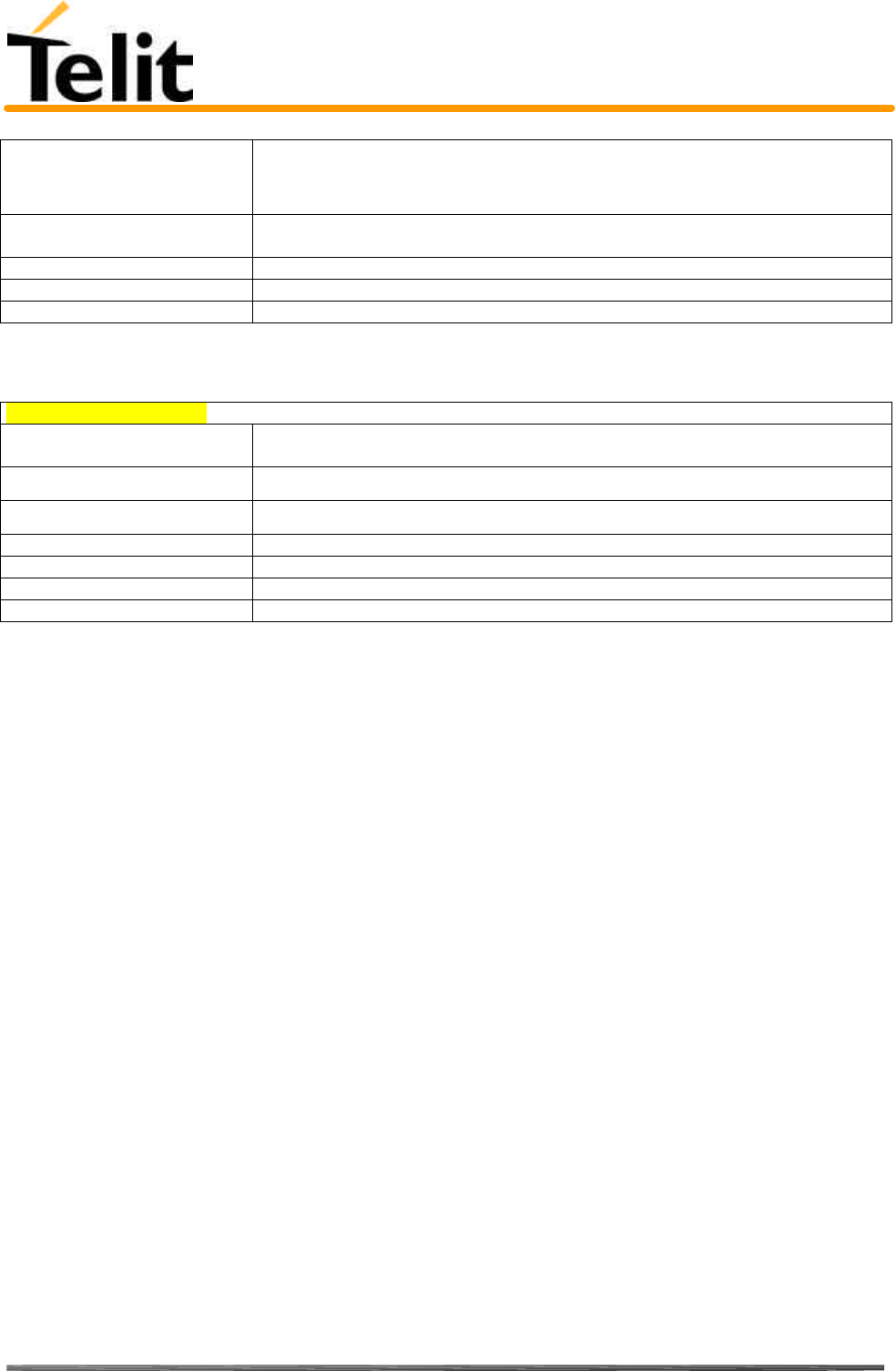
Telit TRIZIUM Product Description
80264ST10007a Rev. 4– 09/09/04
Reproduction forbidden without DAI Telecom written authorization – All Right reserved – Right of modification reserved page 159 of 202
1 - enabled - handsfree mode
2…255 reserved
Note: This setting returns to default after power off.
Test command
AT#SHFSD=? Returns the supported range of values of the parameter <mode>.
Example
Reference Telit TRIZIUM AT Command Specification
SW release Version A
5.6.1.26 #/ – Repeat last command
#/ – Repeat last command
Execute command
AT#/ It is used to execute again the last received command.
Note: This command replaces the A/ command
Read command
Write command
Test command
Example
Reference Telit TRIZIUM AT Command Specification
SW release Version A
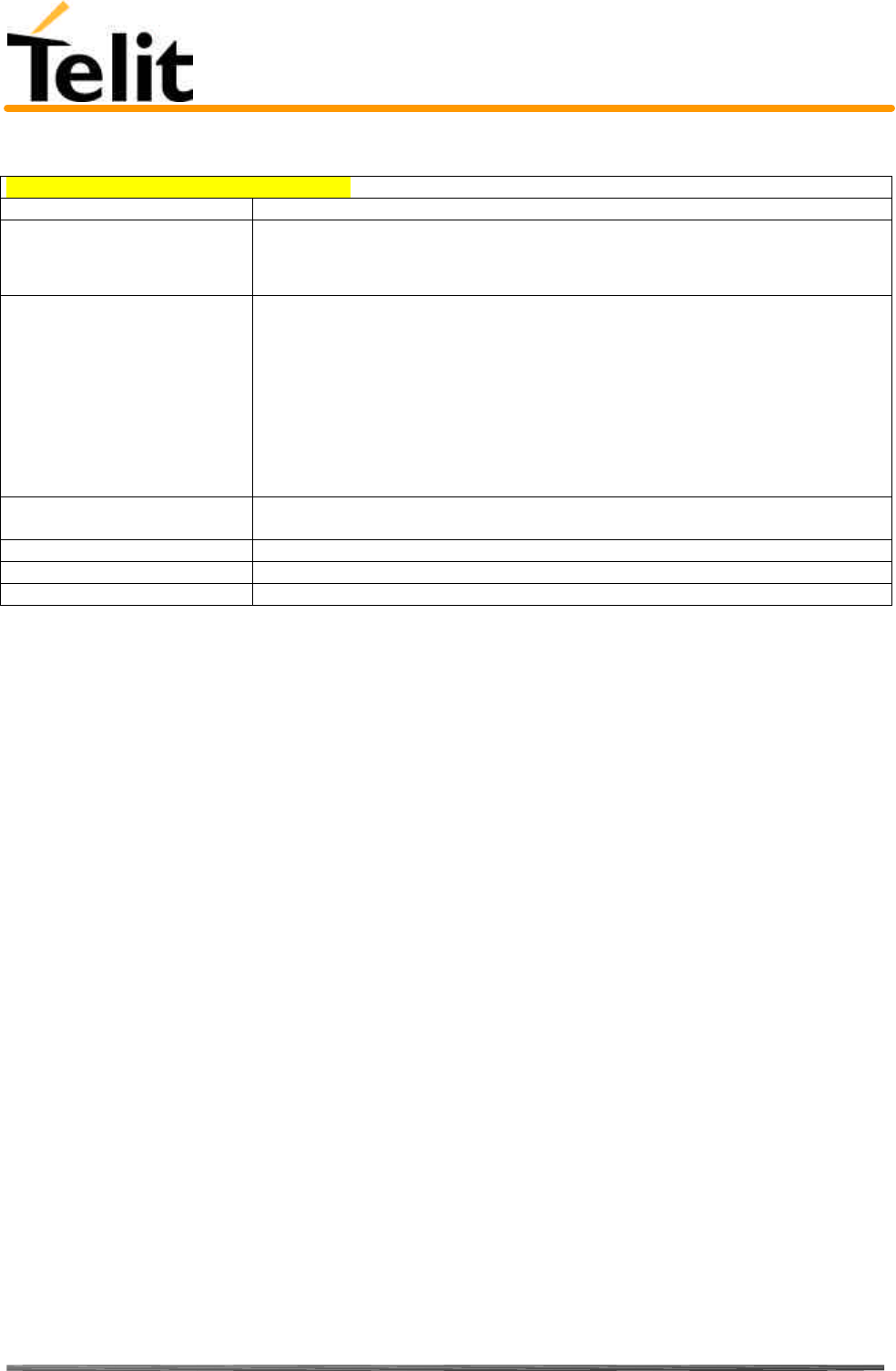
Telit TRIZIUM Product Description
80264ST10007a Rev. 4– 09/09/04
Reproduction forbidden without DAI Telecom written authorization – All Right reserved – Right of modification reserved page 160 of 202
5.6.1.27 #BND – Select Band (DCS 1800 or PCS 1900)
#BND – Select Band (DCS1800 or PCS1900)
Execute command
Read command
AT#BND? Return the current band selected in the format:
#BND: <band>
Write command
AT#BND = <band> Set the band parameter to the Band value.
Parameter
<band>:
0 - DCS 1800MHz
1 - PCS 1900MHz
Note: This setting is maintained even after power off.
Test command
AT#BND=? Returns the supported range of values of the parameter <band>.
Example
Reference Telit TRIZIUM AT Command Specification
SW release Version A
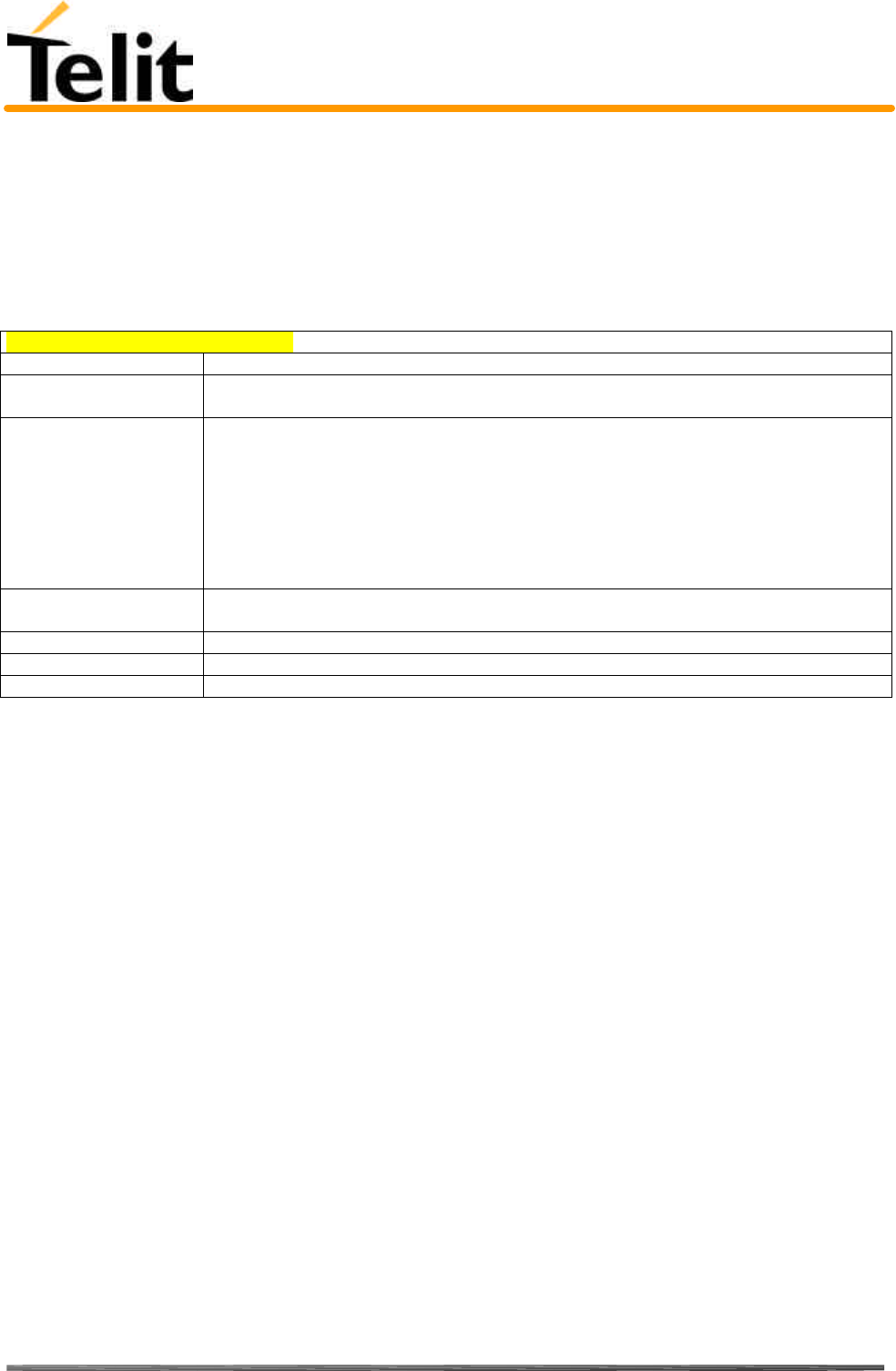
Telit TRIZIUM Product Description
80264ST10007a Rev. 4– 09/09/04
Reproduction forbidden without DAI Telecom written authorization – All Right reserved – Right of modification reserved page 161 of 202
5.7 FAX Class 1 Commands
5.7.1 General configuration
5.7.1.1 +FCLASS - select active service class
+FCLASS - select active service class
Execute command
Read command
AT+FCLASS? Returns the current configuration value of the parameter <n>.
Write command
AT+FCLASS= <n> Set the TRIZIUM in specified connection mode (data, fax, voice), hence all the calls done
after, will be data or voice.
Parameter:
<n>: 0 = data
<n>: 1 = fax class 1
<n>: 8 = voice
Test command
AT+FCLASS=? Returns all supported values of the parameters <n>.
Example
Reference ITU T.31 and TIA/EIA-578-A specifications / GSM 07.07
SW release Version A
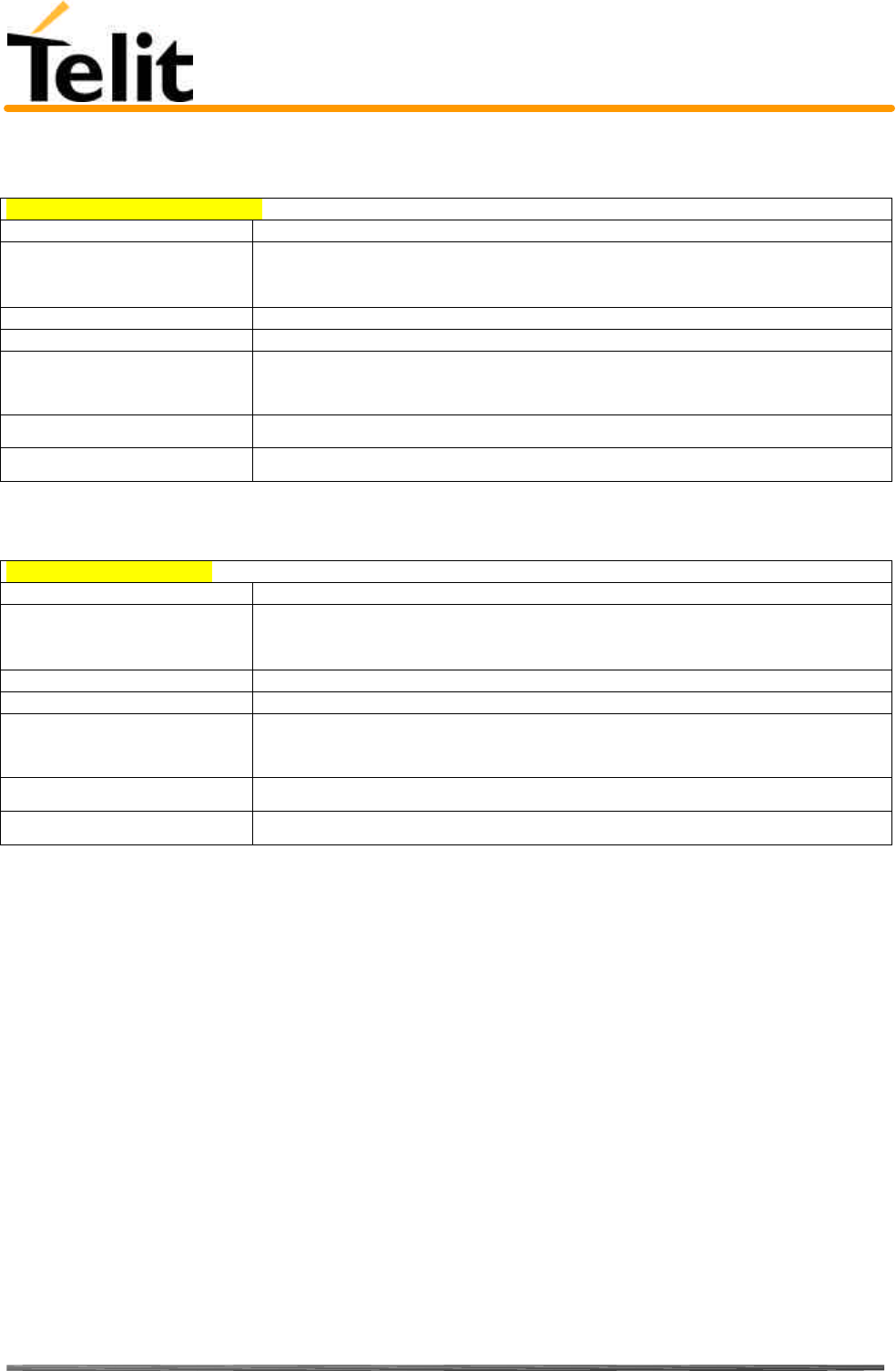
Telit TRIZIUM Product Description
80264ST10007a Rev. 4– 09/09/04
Reproduction forbidden without DAI Telecom written authorization – All Right reserved – Right of modification reserved page 162 of 202
5.7.1.2 +FMI – Report manufacturer ID
+FMI – Report manufacturer ID
Execute command
Read command
AT+FMI? Reports the manufacturer ID
Write command
Test command
Example AT+FMI?
Telit Mobile Terminals
OK
Reference ITU T.31 and TIA/EIA-578-A specifications
SW release Version A
5.7.1.3 +FMM? – Report model ID
+FMM – Report model ID
Execute command
Read command
AT+FMM? Reports the model ID
Write command
Test command
Example AT+FMM?
TRIZIUM - GSM900/1800 voice/data/fax module
OK
Reference ITU T.31 and TIA/EIA-578-A specifications
SW release Version A
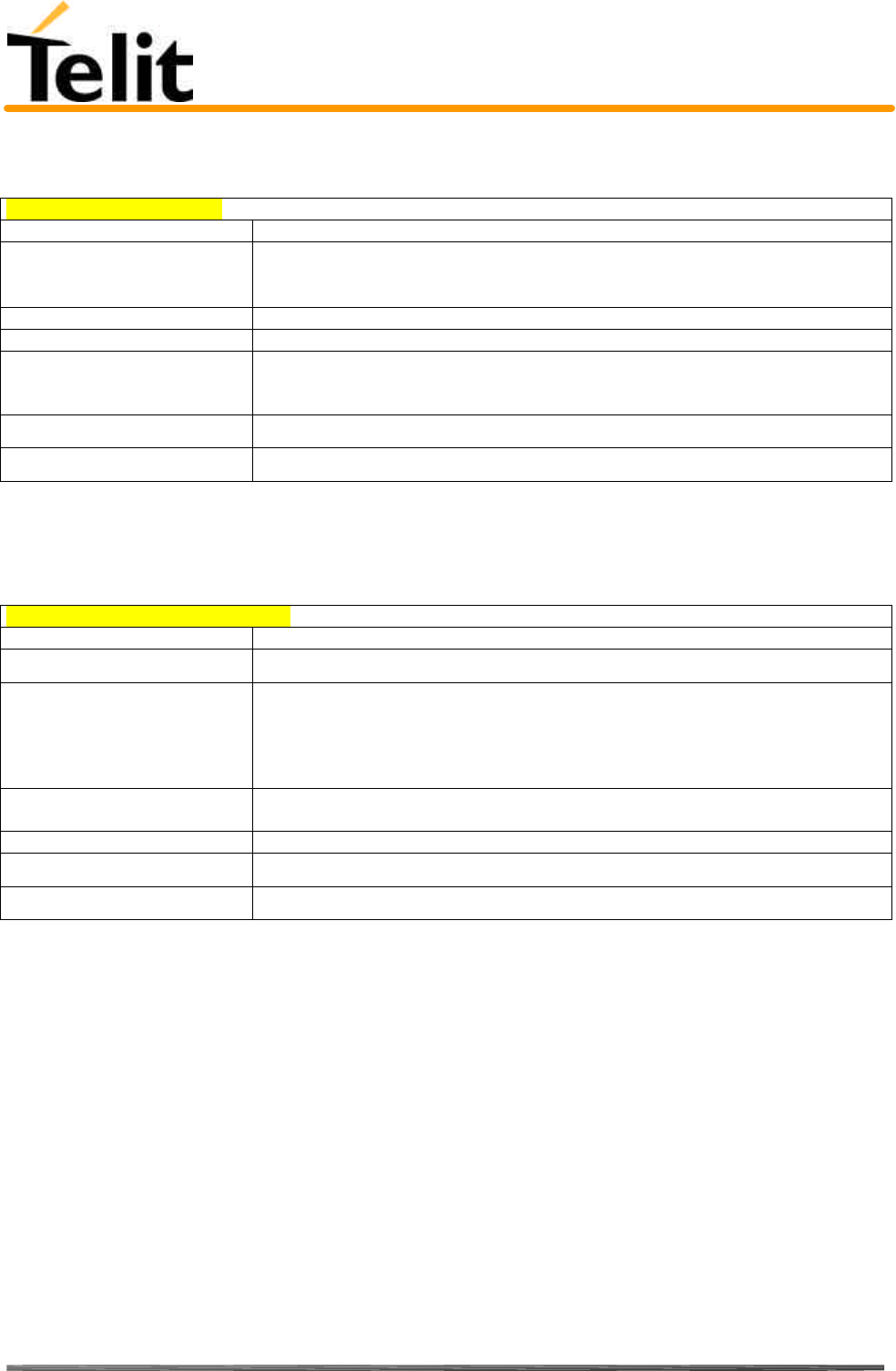
Telit TRIZIUM Product Description
80264ST10007a Rev. 4– 09/09/04
Reproduction forbidden without DAI Telecom written authorization – All Right reserved – Right of modification reserved page 163 of 202
5.7.1.4 +FMR – Report revision ID
+FMR – Report revision ID
Execute command
Read command
AT+FMR? Reports the software revision ID
Write command
Test command
Example AT+FMR?
1.01.000 CS988
OK
Reference ITU T.31 and TIA/EIA-578-A specifications
SW release Version A
5.7.2 Transmission/Reception control
5.7.2.1 +FTS – Stop Transmission and pause
+FTS – Stop transmission and pause
Execute command
Read command
Write command
AT+FTS=<time> This command causes the modem to terminate a transmission and wait for <time> 10
ms intervals before responding with the OK result code.
Parameter <time>
0-255 : length of time in 10ms intervals of the pause
Test command
AT+FTS=? Returns all supported values of the parameters <time>.
Example
Reference ITU T.31 and TIA/EIA-578-A specifications
SW release Version A
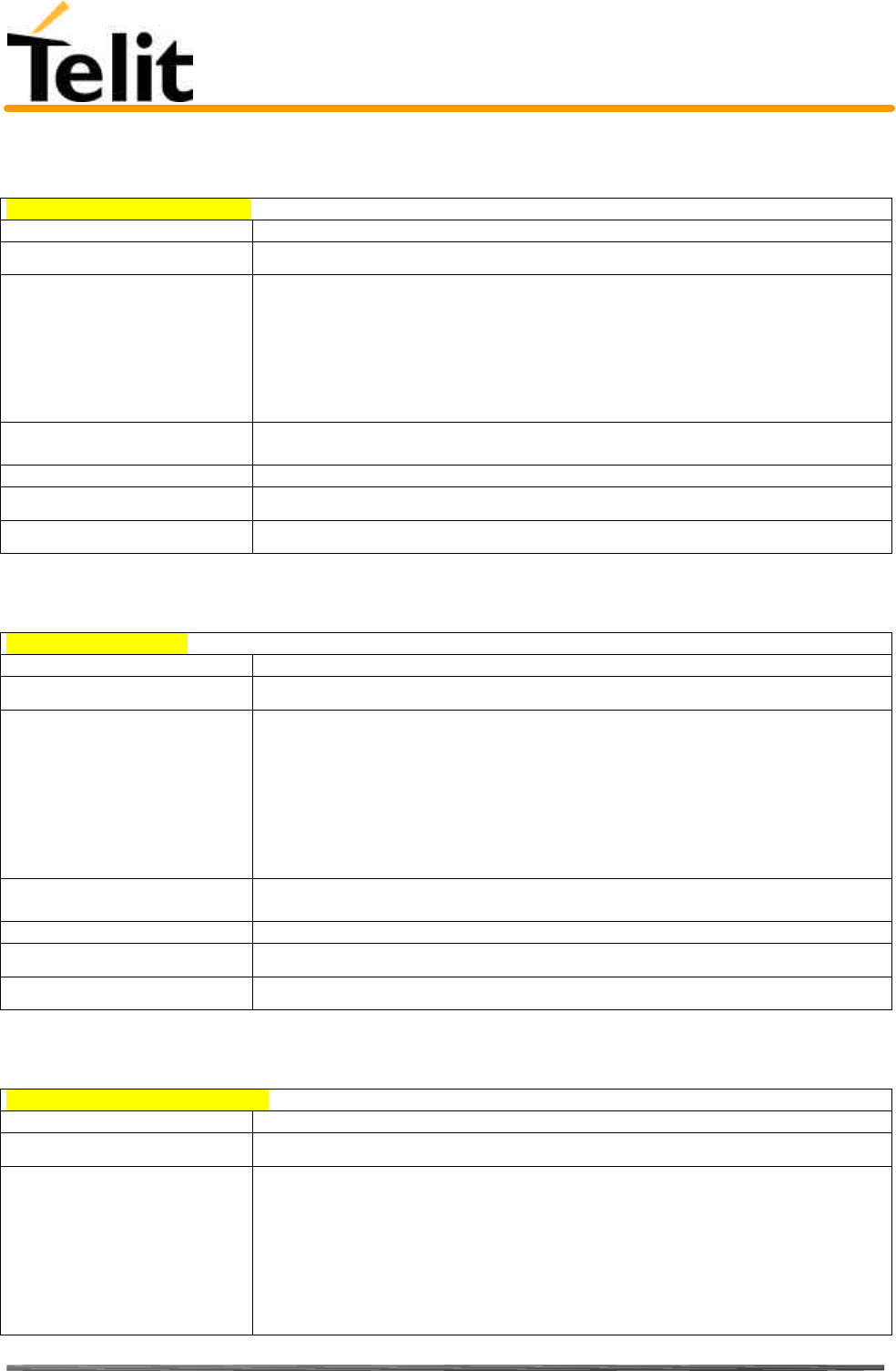
Telit TRIZIUM Product Description
80264ST10007a Rev. 4– 09/09/04
Reproduction forbidden without DAI Telecom written authorization – All Right reserved – Right of modification reserved page 164 of 202
5.7.2.2 +FRS – Wait for receive silence
+FRS – Wait for receive silence
Execute command
Read command
Write command
AT+FRS=<time> this command causes the modem to listen and report an OK result code when silence
has been detected for the specified period of time.
This command when the required silence period is detected or when the DTE sends
another character other than XON or XOFF.
Parameter <time>
0-255 : length of time in 10ms intervals of the pause
Test command
AT+FTS=? Returns all supported values of the parameters <time>.
Example
Reference ITU T.31 and TIA/EIA-578-A specifications
SW release Version A
5.7.2.3 +FTM – Transmit data modulation
+FTM – Transmit data
Execute command
Read command
Write command
AT+FTM=<mod> this command causes the module to transmit facsimile data using the modulation
defined by the parameter <mod>.
parameter <mod> : carrier modulation
24 - V27ter/2400 bps
48 - V27ter/4800 bps
72 - V29/7200 bps
96 - V29/9600 bps
Test command
AT+FTM=? Returns all supported values of the parameters <mod>.
Example
Reference ITU T.31 and TIA/EIA-578-A specifications
SW release Version A
5.7.2.4 +FRM – Receive data modulation
+FRM – Receive data modulation
Execute command
Read command
Write command
AT+FRM=<mod> this command causes the module to receive facsimile data using the modulation
defined by the parameter <mod>.
parameter <mod> : carrier modulation
24 - V27ter/2400 bps
48 - V27ter/4800 bps
72 - V29/7200 bps
96 - V29/9600 bps
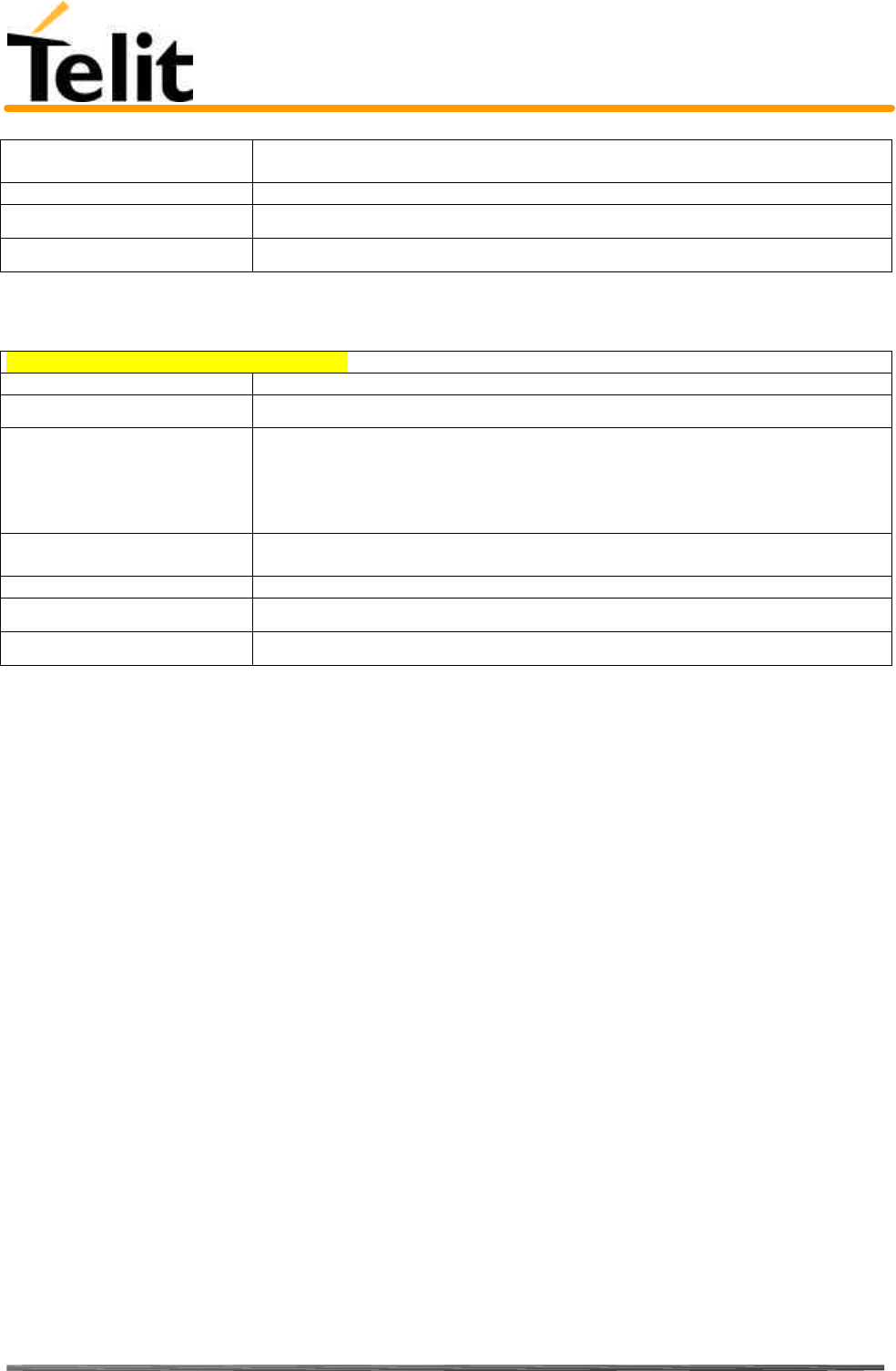
Telit TRIZIUM Product Description
80264ST10007a Rev. 4– 09/09/04
Reproduction forbidden without DAI Telecom written authorization – All Right reserved – Right of modification reserved page 165 of 202
Test command
AT+FRM=? Returns all supported values of the parameters <mod>.
Example
Reference ITU T.31 and TIA/EIA-578-A specifications
SW release Version A
5.7.2.5 +FTH – Transmit data with HDLC framing
+FTH – Transmit data with HDLC framing
Execute command
Read command
Write command
AT+FTH=<mod> this command causes the module to transmit facsimile data using HDLC protocol and
the modulation defined by the parameter <mod>.
parameter <mod> : carrier modulation
3 - V21/300 bps
Test command
AT+FTH=? Returns all supported values of the parameters <mod>.
Example
Reference ITU T.31 and TIA/EIA-578-A specifications
SW release Version A
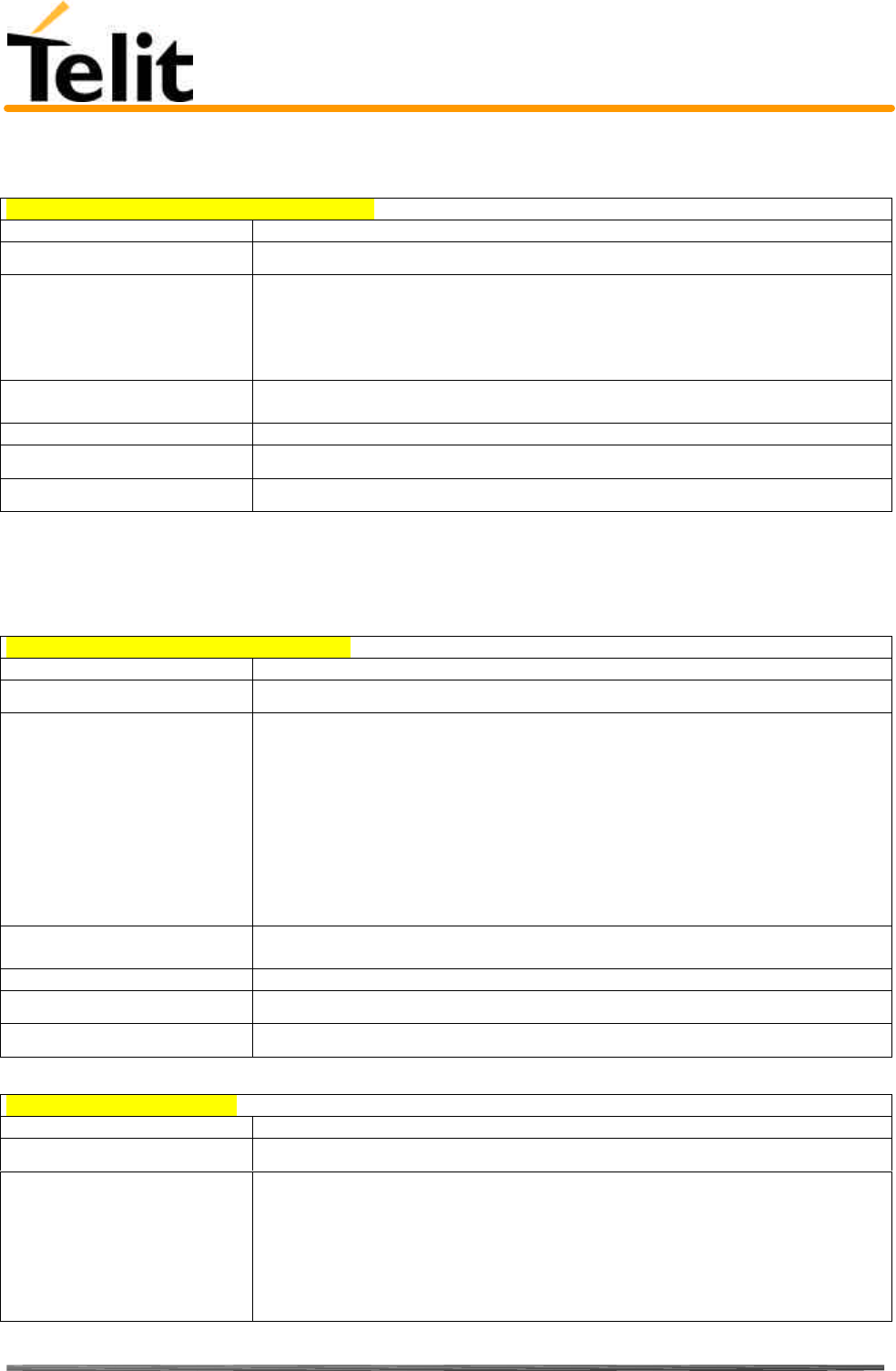
Telit TRIZIUM Product Description
80264ST10007a Rev. 4– 09/09/04
Reproduction forbidden without DAI Telecom written authorization – All Right reserved – Right of modification reserved page 166 of 202
5.7.2.6 +FRH – Receive data with HDLC framing
+FRH – Receive data data with HDLC framing
Execute command
Read command
Write command
AT+FRH=<mod> this command causes the module to receive facsimile data using HDLC protocol and
the modulation defined by the parameter <mod>.
parameter <mod> : carrier modulation
3 - V21/300 bps
Test command
AT+FRH=? Returns all supported values of the parameters <mod>.
Example
Reference ITU T.31 and TIA/EIA-578-A specifications
SW release Version A
5.7.3 Serial port control
5.7.3.1 +FLO – Select flow control specified by type
+FLO – Select flow control specified by type
Execute command
Read command
Write command
AT+FLO=<type> Selects the flow control behavior of the serial port in both directions: from DTE to
DTA and from DTA to DTE
Parameter:
<type> - flow control option for the data on the serial port
0 - flow control None
1 - flow control Software (XON-XOFF)
2 - flow control Hardware (CTS-RTS)
Note: This command is a shortcut of the +IFC command.
Test command
AT+FLO=? Returns all supported values of the parameters <type>.
Example
Reference ITU T.31 and TIA/EIA-578-A specifications
SW release Version A
5.7.3.2 +FPR – Select serial port rate
+FPR – Select serial port rate
Execute command
Read command
Write command
AT+FPR=<rate> Selects the the serial port speed in both directions: from DTE to DTA and from DTA
to DTE. When autobauding is selected, then the speed is detected automatically.
Parameter:
<rate> - serial port speed selection
0 - autobauding
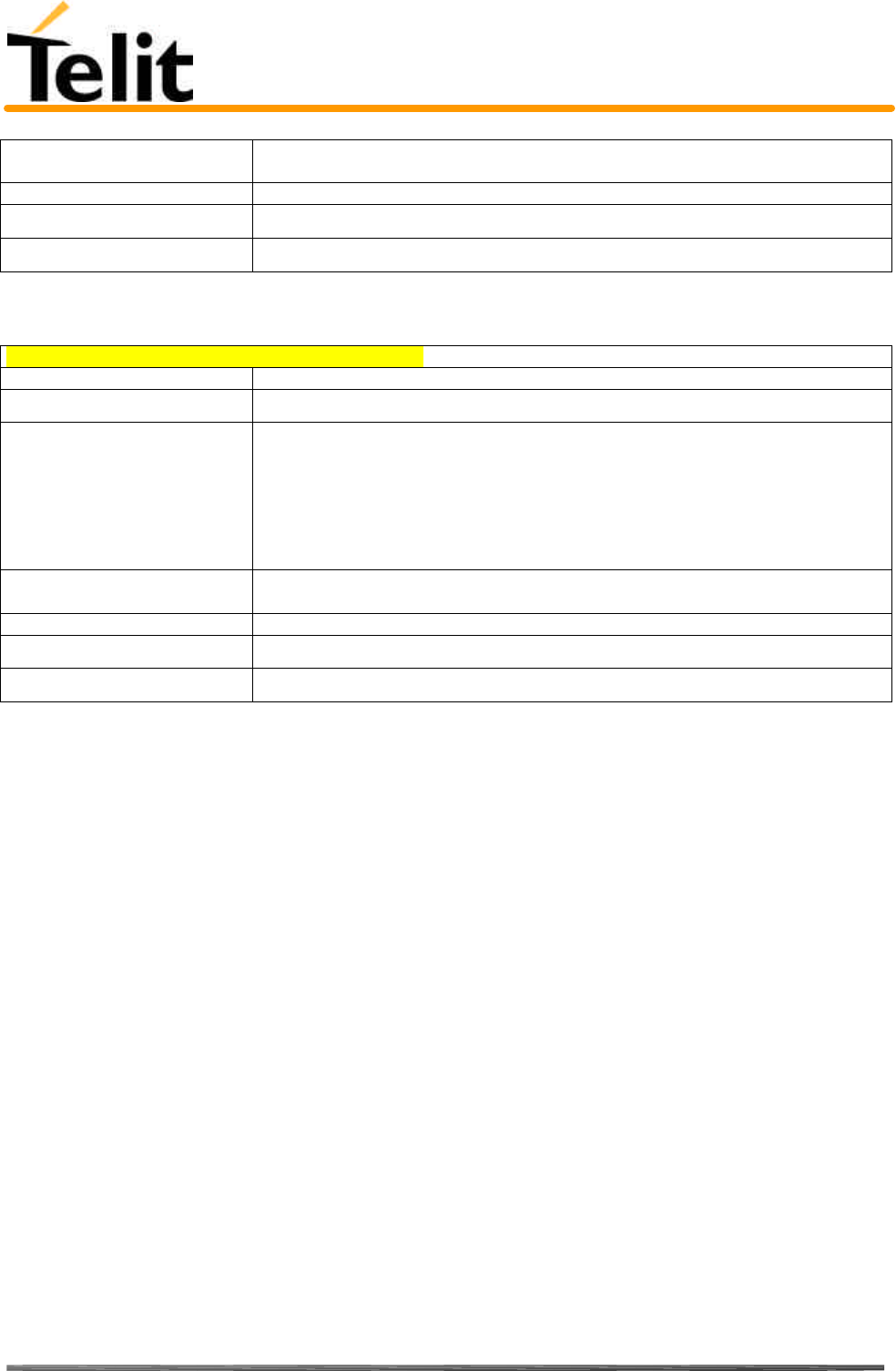
Telit TRIZIUM Product Description
80264ST10007a Rev. 4– 09/09/04
Reproduction forbidden without DAI Telecom written authorization – All Right reserved – Right of modification reserved page 167 of 202
Test command
AT+FPR=? Returns all supported values of the parameters <rate>.
Example
Reference ITU T.31 and TIA/EIA-578-A specifications
SW release Version A
5.7.3.3 +FDD – Double escape character replacement control
+FDD – Double escape character replacement control
Execute command
Read command
Write command
AT+FDD=<mode> This command sets the double escape character replacement behavior of the module
depending on the parameter <mode>.
Parameter
<mode>= 0
DCE decode of <DLE><SUB>: <DLE><DLE> or discard
DCE encode of <1/0><1/0>: <DLE><DLE><DLE><DLE>
Test command
AT+FDD=? Returns all supported values of the parameters <mode>.
Example
Reference ITU T.31 and TIA/EIA-578-A specifications
SW release Version A
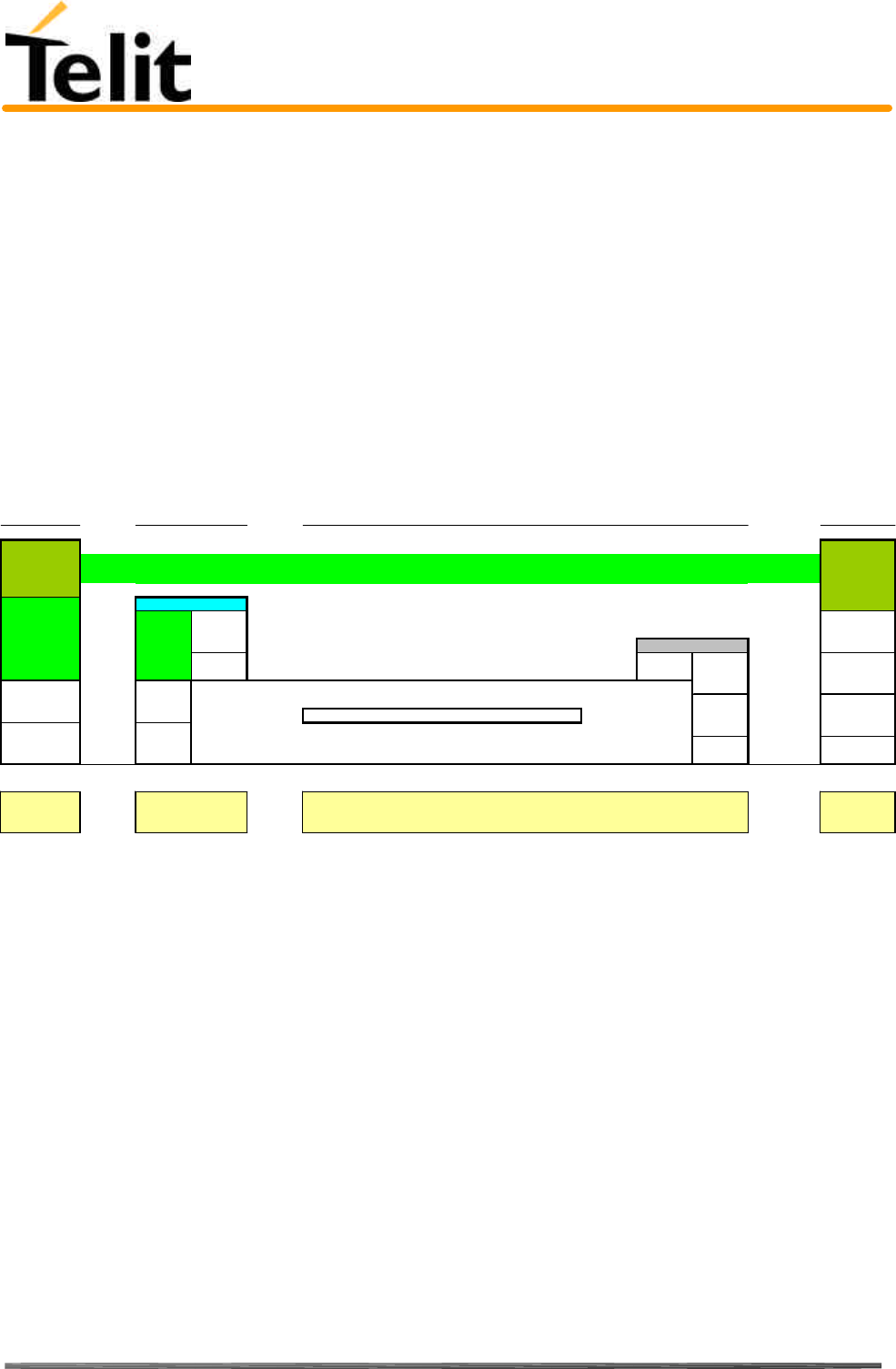
Telit TRIZIUM Product Description
80264ST10007a Rev. 4– 09/09/04
Reproduction forbidden without DAI Telecom written authorization – All Right reserved – Right of modification reserved page 168 of 202
5.8 Easy GPRS Extension
5.8.1 Overview
The Easy GPRS feature applies only to the Telit TRIZIUM and allows a Telit TRIZIUM user to
contact a device in internet and establish with it a raw data flow over the GPRS and Internet
networks.
This feature can be seen as a way to obtain a "virtual" serial connection between the Application
Software on the Internet machine involved and the controller of the Telit TRIZIUM module,
regardless of all the software stacks underlying.
An example of the protocol stack involved in the devices is reported:
This particular implementation allows to the devices interfacing to the Telit TRIZIUM module the
use of the GPRS and Internet packet service without the need to have an internal TCP/IP stack since
this function is embedded inside the module.
5.8.2 Easy GPRS definition
The Easy GPRS feature provides a way to replace the need of an Internet TCP/IP stack at the terminal equipment side.
The steps that will be required to obtain a virtual serial connection (that is actually a socket) to the Internet peer are:
a) configuring the GPRS Access
b) configuring the embedded TCP/IP stack behaviour
c) defining the Internet Peer to be contacted
d) request the GPRS and socket connections to be opened (host is connected)
e) exchange raw data
f) close the socket and GPRS context
All these steps are achieved through AT commands.
As for common modem interface, two logical status are involved: command mode and data traffic mode.
- In Command Mode (CM), some AT commands are provided to configure the Data Module Internet stack and to
start up the data traffic.
Remote
Controller
Device
Device
(Internet)
Local Remote
Application Application
TCP/UDP
EASY EASY TCP/UDP
GPRS
GPRS
IP
IP
IP
IP
Serial
Data
Line on
Driver Board
L2
L2
V.24
V.24
L1 L1
Terminal
Equipment
Remote
Device
(Internet)
network interworking
Mobile Terminal GPRS Network and Internet
Telit
TRIZIUM networks
<<<---------------------------------- Virtual Serial link ---------------------------------->>>

Telit TRIZIUM Product Description
80264ST10007a Rev. 4– 09/09/04
Reproduction forbidden without DAI Telecom written authorization – All Right reserved – Right of modification reserved page 169 of 202
- In data traffic mode (Socket Mode, SKTM), the client can send/receive a raw data stream which will be
encapsulated in the previously configured TCP / IP packets which will be sent to the other side of the network and
viceversa. Control plane of ongoing socket connection is deployed internally to the module.
5.8.2.1 Configuring the GPRS access
The GPRS access configuration is done by setting:
- the GPRS context number 1 parameters (see +CGDCONT command)
- the Authentication parameters: User Name and Password (see commands #USERID, #PASSW)
5.8.2.2 Configuring the embedded TCP/IP stack
The TCP/IP stack behaviour must be configured by setting:
- the packetizer default packet size (see command #PKTSZ)
- the data sending timeout (see command #DSTO)
- the socket inactivity timeout (see command #SKTTO)
5.8.2.3 Defining the Internet peer to be contacted
As last setting definition, the host to be contacted and on which port/protocol must be set :
- the socket definition (see command #SKTSET)
This command permits also to specify the host name instead of its IP address, if a host name is given to the set
command, then the module stores it as a host nick name. It is care of the module user to guarantee that the host nick
name provided corresponds to an existing internet peer.
If an host nick name has been given then, while opening the connection in response to the AT#SKTOP command, the
module will autonomously activate a GPRS connection and query its DNS to obtain the IP address relative to the host
nick name provided. This process of context activation and DNS query may require a bit more time and requires that the
GPRS network coverage is good enough to permit data transfers.
5.8.2.4 Open the connection with the internet host
With the AT#SKTOP all the process required to connect with the internet host starts:
- TRIZIUM activates the first context
- TRIZIUM proceeds to the authentication with the parameters specified on par. 5.8.2.1
- Eventually does the DNS query to resolve the IP address of the host name internet peer
- TRIZIUM establishes a TCP/UDP (depending on the parameter request) connection with the given internet host
- Once the connection is up the module reports the code: CONNECT
From this moment the data incoming in the serial port is packet and sent to the Internet host, while the data received
from the host is serialised and flushed to the Terminal Equipment.
5.8.2.5 Close the Socket and deactivate the context
The connection can be closed because of:
- remote host TCP connection close
- socket inactivity timeout
- Terminal Equipment by issuing the escape sequence "+++"
- Network deactivation
Note: if in the raw data to be sent there's an escape sequence, then the TE must work it out and sent it in a different
fashion to guarantee that the connection is not closed.
The pause time is defined in the parameter S12.
On the reception of an escape sequence the TRIZIUM closes the connection, deactivates the GPRS context returning to
command mode and issuing the NO CARRIER code.
5.8.3 Known limitations
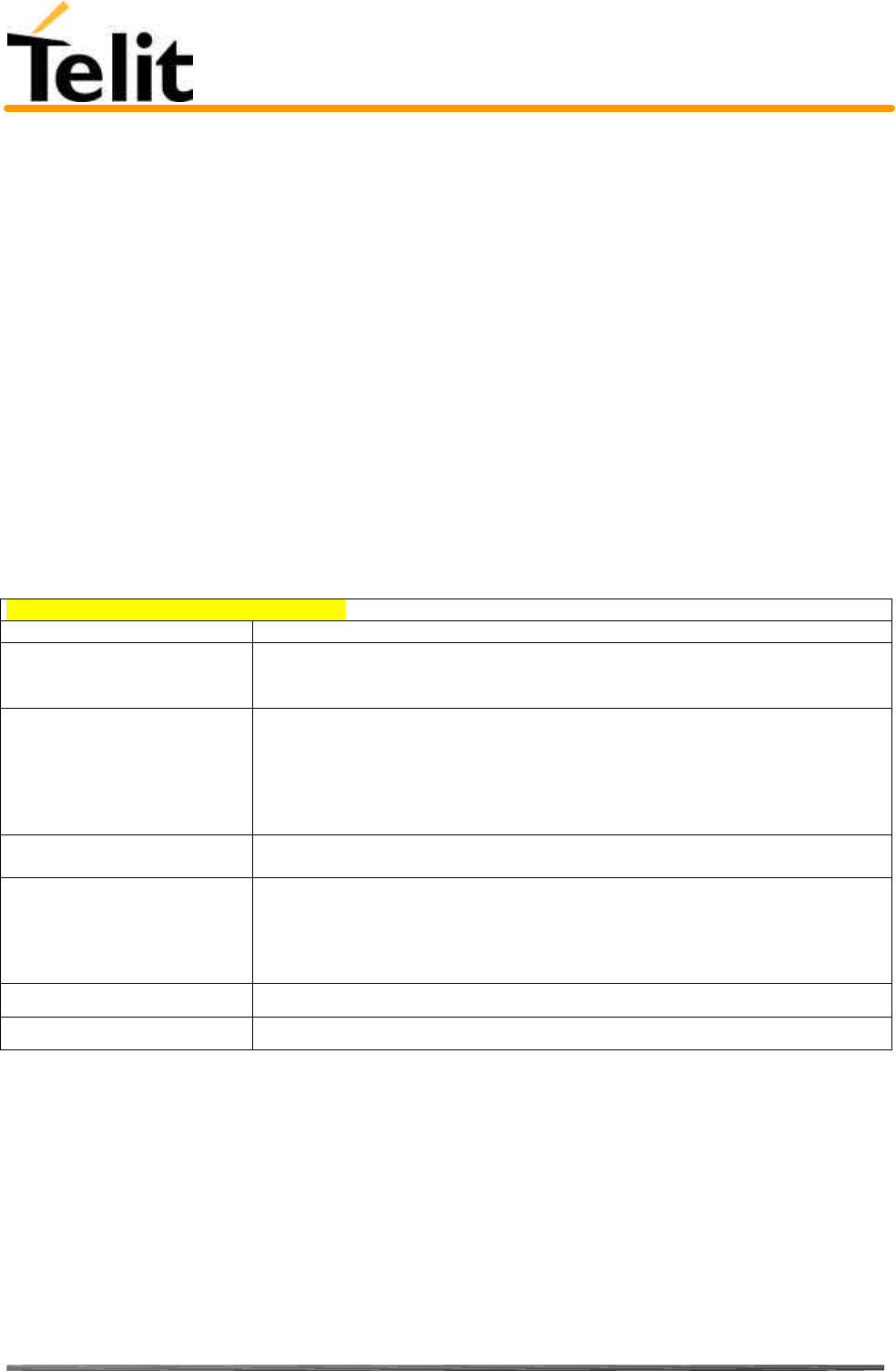
Telit TRIZIUM Product Description
80264ST10007a Rev. 4– 09/09/04
Reproduction forbidden without DAI Telecom written authorization – All Right reserved – Right of modification reserved page 170 of 202
The implementation of the EASY GPRS feature has the following known limitations:
- Only one socket can be opened at a time, no multiple socket connections can be made;
- Only the first GPRS context is associated with this feature;
- The closing of a socket implies always the deactivation of the GPRS context associated;
- It is taken for granted that external processor will be able to handle at least a limited v.24 implementation: RTS,
CTS and, highly recommended, DCD lines; this because software flow control is not applicable to the feature;
- Only Mobile initiated connections can be made, it is not possible to receive incoming TCP connection requests;
- Due to the particularity of this feature, the flow control of both the directions uplink and downlink is interlocked
5.8.4 Easy GPRS custom AT command Definition
5.8.4.1 #USERID – Authentication User ID control
#USERID – Authentication User ID control
Execute command
Read command
AT#USERID? Reports the current value of the parameter <user>.
Write command
AT#USERID="<user>" This command sets the user identification string to be used during the authentication
step to be the string <user>.
Parameter:
<user> - authentication User ID
- any string value up to max length reported in the Test command.
Test command
AT#USERID=? Returns the maximum allowed length of the string parameter <user>.
Example AT#USERID = "myName"
OK
AT#USERID?
#USERID: "myName"
OK
Reference Telit specifications
SW release Version A
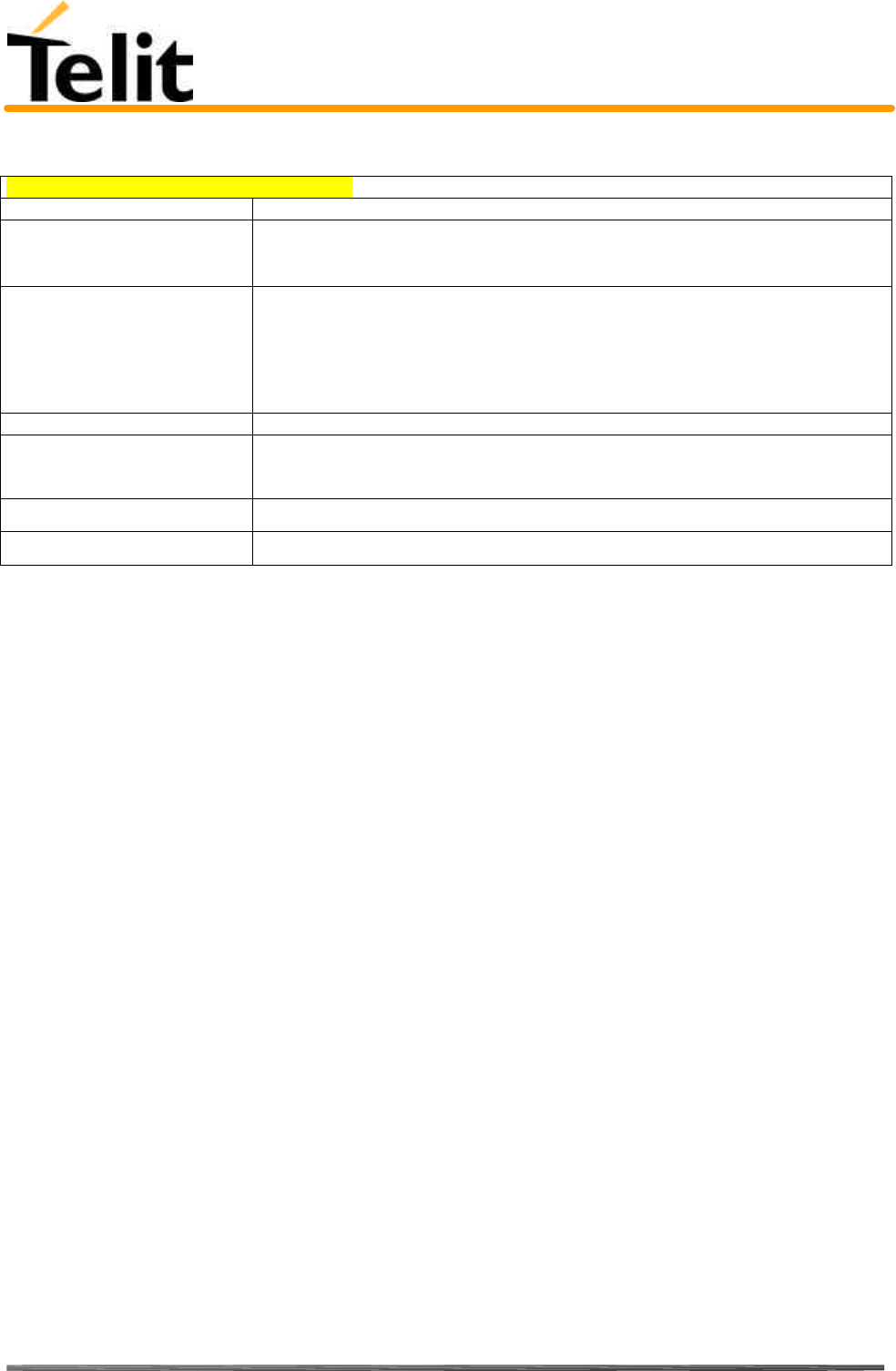
Telit TRIZIUM Product Description
80264ST10007a Rev. 4– 09/09/04
Reproduction forbidden without DAI Telecom written authorization – All Right reserved – Right of modification reserved page 171 of 202
5.8.4.2 #PASSW – Authentication Password control
#PASSW – Authentication Password control
Execute command
Read command
AT#PASSW=? Reports the maximum password length.
Write command
AT#PASSW="<pwd>" This command sets the user password string to be used during the authentication step
to be the string <pwd>.
Parameter:
<pwd> - authentication password
- any string value up to max length reported in the Test command.
Test command No test command allowed, for password security
Example AT#PASSW = "myPassword"
OK
Reference Telit specifications
SW release Version A
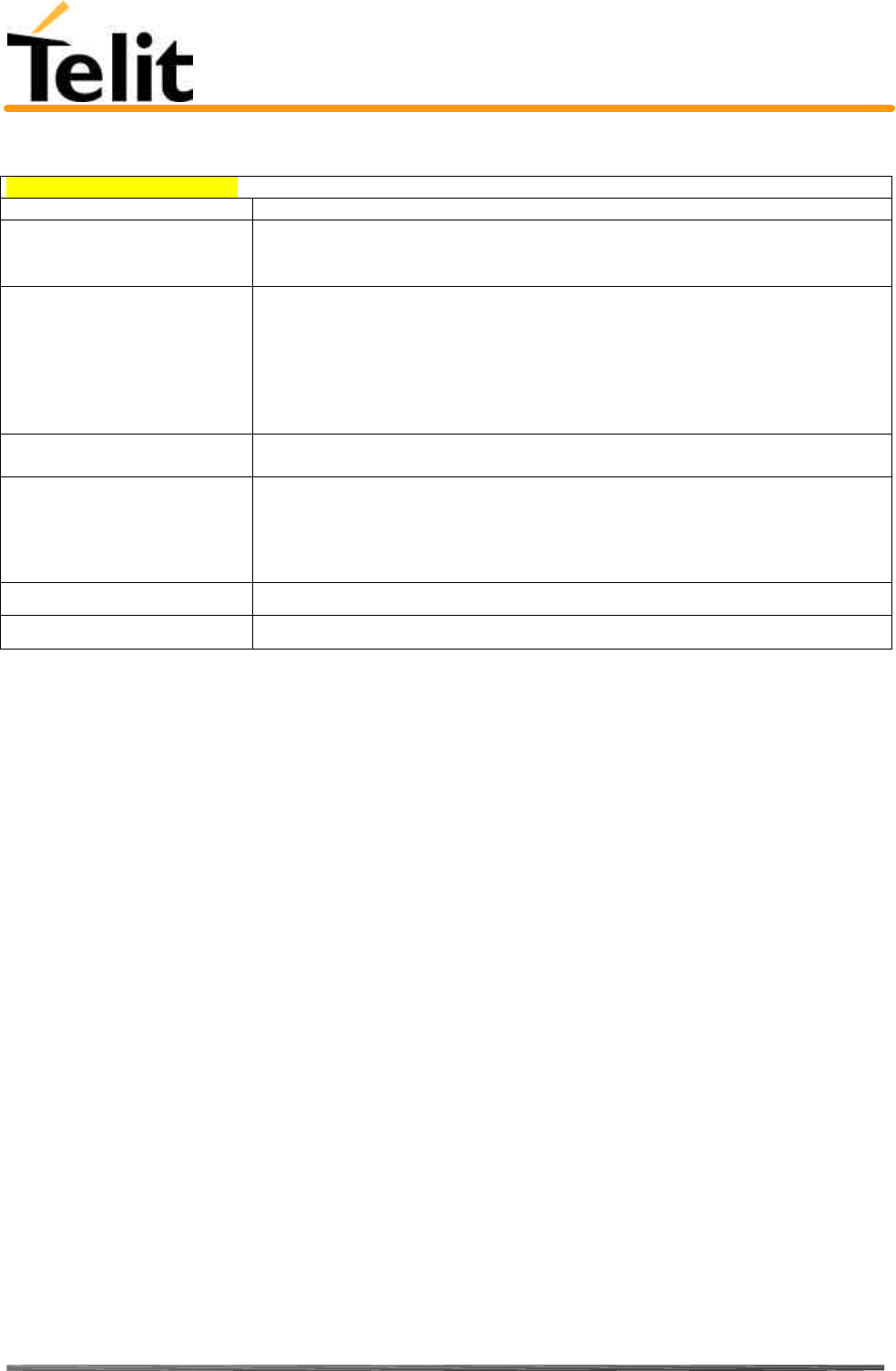
Telit TRIZIUM Product Description
80264ST10007a Rev. 4– 09/09/04
Reproduction forbidden without DAI Telecom written authorization – All Right reserved – Right of modification reserved page 172 of 202
5.8.4.3 #PKTSZ –Packet Size control
#PKTSZ –Packet Size control
Execute command
Read command
AT#PKTSZ? Reports the current value of the parameter <size>.
Write command
AT#PKTSZ=<size> This command sets the default packet size to be used by the TCP/UDP/IP stack for
data sending.
Parameter:
<size> - packet size in bytes
0 - automatically chosen by the device
1…512 - packet size in bytes
Test command
AT#PKTSZ=? Returns the allowed values for the parameter <size>.
Example AT#PKTSZ = 100
OK
AT#PKTSZ?
#PKTSZ: 100
OK
Reference Telit specifications
SW release Version A
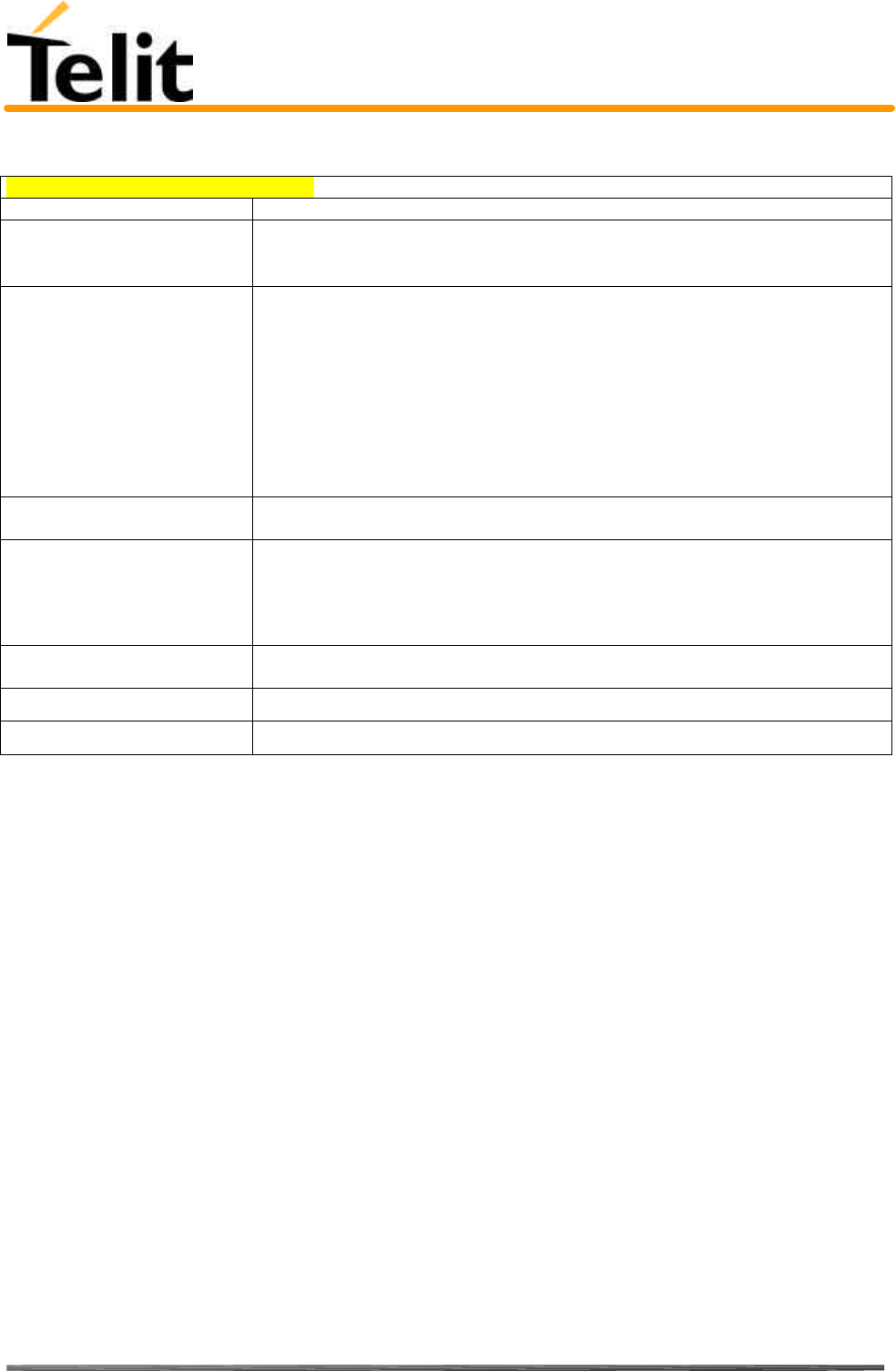
Telit TRIZIUM Product Description
80264ST10007a Rev. 4– 09/09/04
Reproduction forbidden without DAI Telecom written authorization – All Right reserved – Right of modification reserved page 173 of 202
5.8.4.4 #DSTO – Data Sending Timeout control
#DSTO –Data Sending Timeout control
Execute command
Read command
AT#DSTO? Reports the current value of the parameter <time>.
Write command
AT#DSTO=<time> This timeout applies when the data to be sent is less that one full packet size and
whose sending would have been delayed for a undefined time until new data to be
sent is received and the full packet size is reached.
This command sets the maximum time that the module awaits before sending anyway
a packet whose size is less than the default one.
Parameter:
<time> - packet sending timeout in 100ms units
0 - no timeout, wait forever for packets to be completed before send.
1…255 hundreds of ms
Test command
AT#DSTO=? Returns the allowed values for the parameter <time>.
Example AT#DSTO = 10 ( 1 sec. Timeout )
OK
AT#DSTO?
#DSTO: 10
OK
NOTE In order to avoid possible low performances issues, it is suggested to set the <time>
parameter to a value greater than 5
Reference Telit specifications
SW release Version A
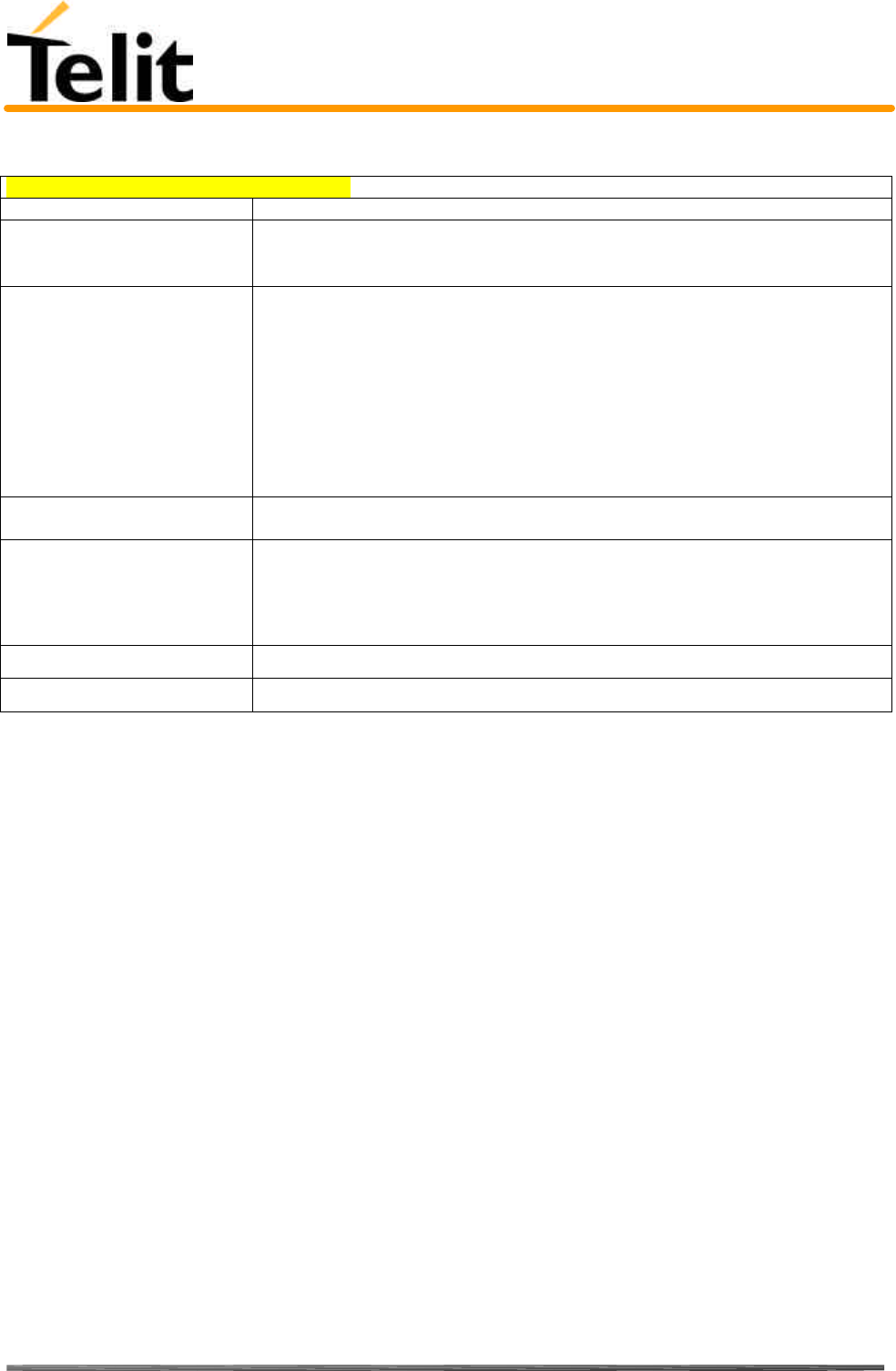
Telit TRIZIUM Product Description
80264ST10007a Rev. 4– 09/09/04
Reproduction forbidden without DAI Telecom written authorization – All Right reserved – Right of modification reserved page 174 of 202
5.8.4.5 #SKTTO – Socket inactivity timeout control
#SKTTO – Socket inactivity timeout control
Execute command
Read command
AT#SKTTO? Reports the current value of the parameter <time>.
Write command
AT#SKTTO=<time> This timeout applies when the no data is exchanged in the socket for a long time and
therefore the socket connection is automatically closed and the GPRS context
deactivated.
This command sets the maximum time that the module awaits without data exchange
on the socket before closing the socket and deactivating the GPRS context.
Parameter:
<time> - socket inactivity timeout in seconds units
0 - no timeout.
1…65535 s
Test command
AT#SKTTO=? Returns the allowed values for the parameter <time>.
Example AT#SKTTO = 30 ( 30 sec. Timeout )
OK
AT#SKTTO?
#SKTTO: 30
OK
Reference Telit specifications
SW release Version A
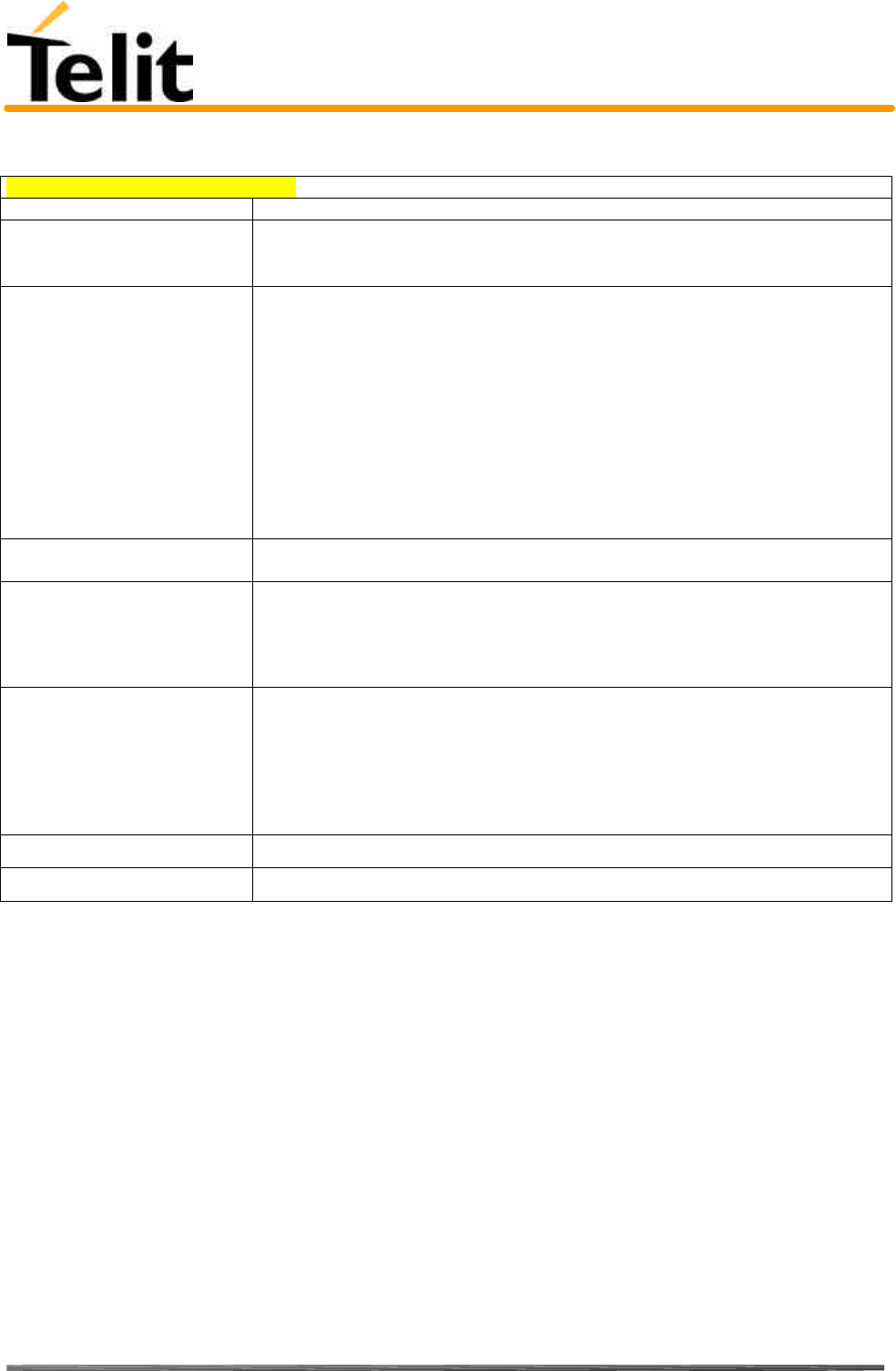
Telit TRIZIUM Product Description
80264ST10007a Rev. 4– 09/09/04
Reproduction forbidden without DAI Telecom written authorization – All Right reserved – Right of modification reserved page 175 of 202
5.8.4.6 #SKTSET – Socket definition control
#SKTSET – Socket definition control
Execute command
Read command
AT#SKTSET? Reports the current value of the parameters
<socket type>,<remote port>, <remote address>.
Write command
AT#SKTSET=<socket type>,
<remote port>, "<remote
address>"
This command sets the socket parameters values.
Parameter:
<socket type> - socket protocol type
0 - TCP
1 - UDP
<remote port> - remote host port to be opened
0…65535 - port number
<remote address> - address of the remote host
this parameter can be either:
- any valid IP address in the format: xxx.xxx.xxx.xxx
- any host name to be solved with a DNS query in the format: <host name>
Test command
AT#SKTSET=? Returns the allowed values for the parameters.
Example AT#SKTSET = 0,1024,"123.124.020.007"
OK
Or
AT#SKTSET=0,1024,"www.telit.net"
OK
NOTE The resolution of the host name is done when opening the socket, therefore if an
invalid host name is given to the #SKTSET command, then no error message will be
issued to the #SKTSET command.
The DNS Query to be successful requests that:
- the GPRS context 1 is correctly set with AT+CGDCONT
- the authentication parameters are set (#USERID, #PASSW)
- the GPRS coverage is enough to permit a connection
Reference Telit specifications
SW release Version A
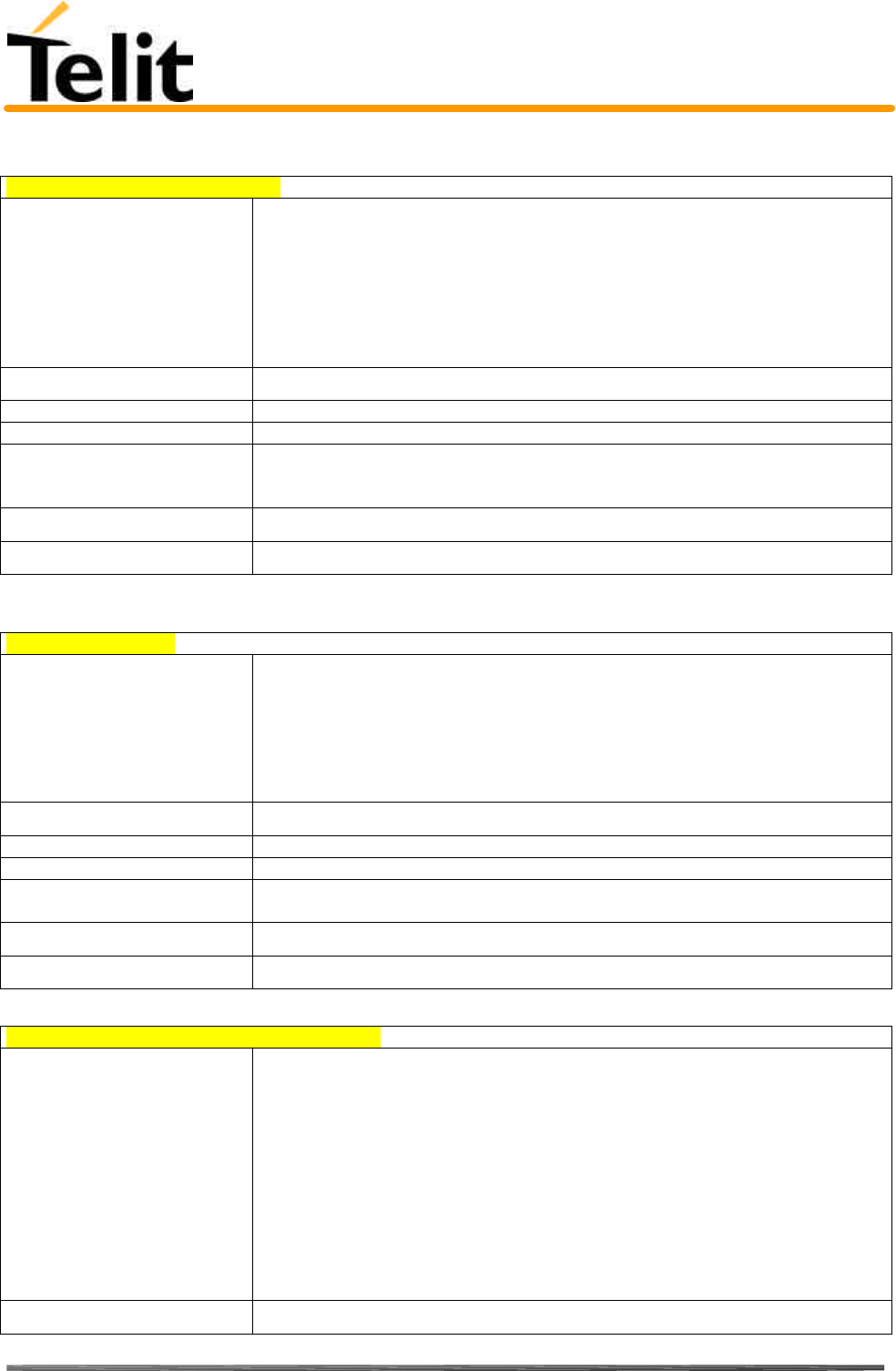
Telit TRIZIUM Product Description
80264ST10007a Rev. 4– 09/09/04
Reproduction forbidden without DAI Telecom written authorization – All Right reserved – Right of modification reserved page 176 of 202
5.8.4.7 #SKTOP – Socket Open command
#SKTOP – Socket Open Command
Execute command
AT#SKTOP Activates the context number 1, proceeds with the authentication with the user ID and
password previously set with #USERID #PASSW commands, and opens a socket
connection with the host specified in the #SKTSET command. Eventually before
opening the socket connection it issues automatically a DNS query to solve the IP
address of the host name.
If the connection succeeds a CONNECT indication is sent, otherwise a NO
CARRIER indication is sent.
Read command
Write command
Test command
Example AT#SKTOP
… GPRS context activation, authentication and socket open…
CONNECT
Reference Telit specifications
SW release Version A
5.8.4.8 #QDNS – Query DNS
#QDNS – Query DNS
Execute command
AT#QDNS="<host name>" This command activates a context, authenticates and proceeds to execute a DNS
query to solve the host name into an IP address.
If the DNS query is successful then the IP address will be reported in the result code:
#QDNS:"<host name>",< IP address>
the <IP address> is in the format: xxx.xxx.xxx.xxx
else
#QDNS:"<host name>", NOT SOLVED
Read command
Write command
Test command
NOTE This command requires that the first context parameters, the authentication par. are
correctly set and that the GPRS network is present.
Reference Telit specifications
SW release Version A
5.8.4.9 #SKTSAV – Socket Parameters Save Command
#SKTSAV – Socket Parameters Save Command
Execute command
AT#SKTSAV Saves the actual Parameters of the Socket in the NVM of the device.
The values stored are:
- User Name
- Password
- Packet Size
- Socket inactivity timeout
- Data sending timeout
- Socket type (UDP/TCP)
- Remote port
- Remote address
Read command
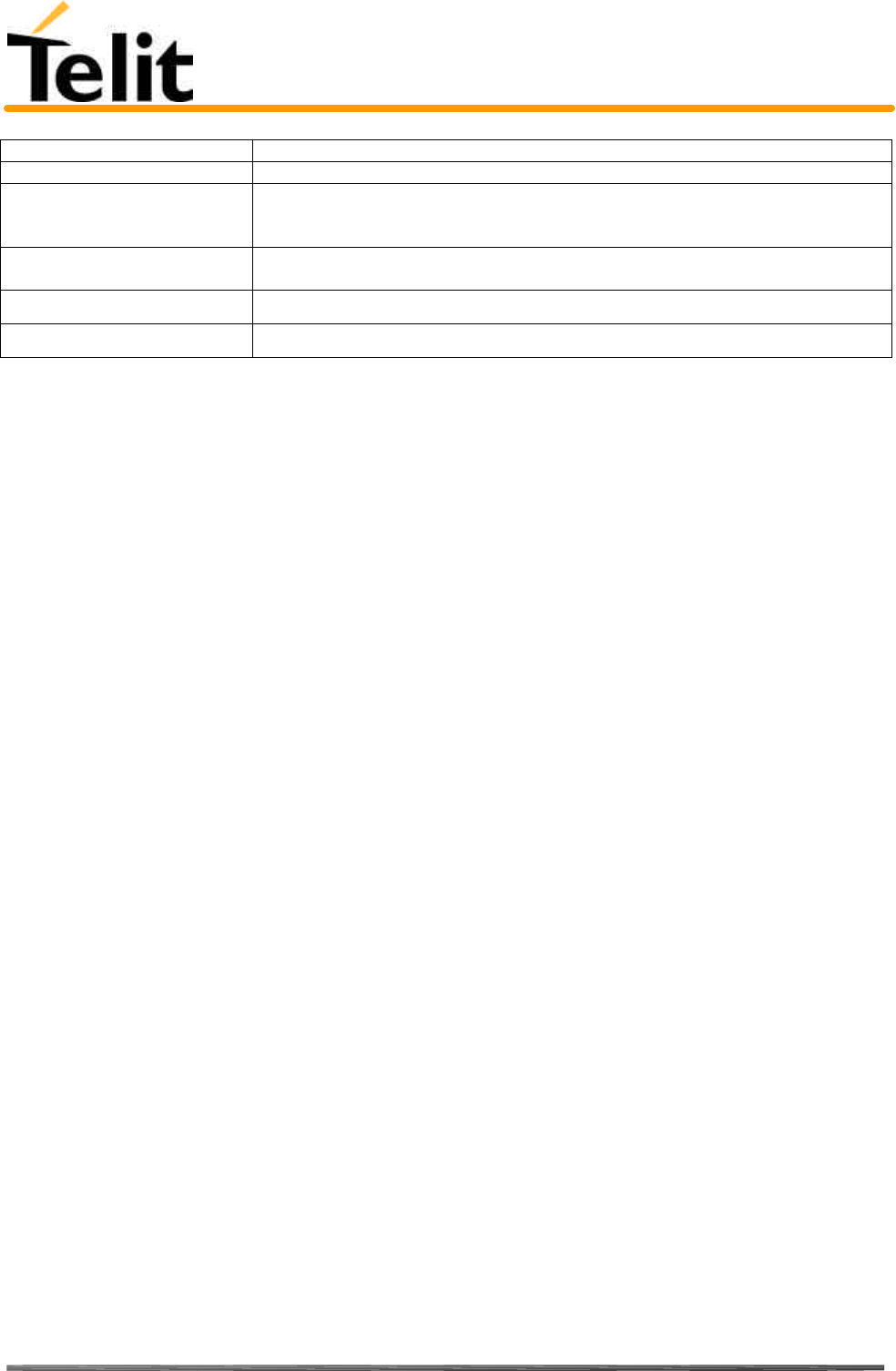
Telit TRIZIUM Product Description
80264ST10007a Rev. 4– 09/09/04
Reproduction forbidden without DAI Telecom written authorization – All Right reserved – Right of modification reserved page 177 of 202
Write command
Test command
Example AT#SKTSAV
OK
…socket parameters have been saved in NVM
Note If some parameters have not been previously specified then a default value will be
taken.
Reference Telit specifications
SW release Version A
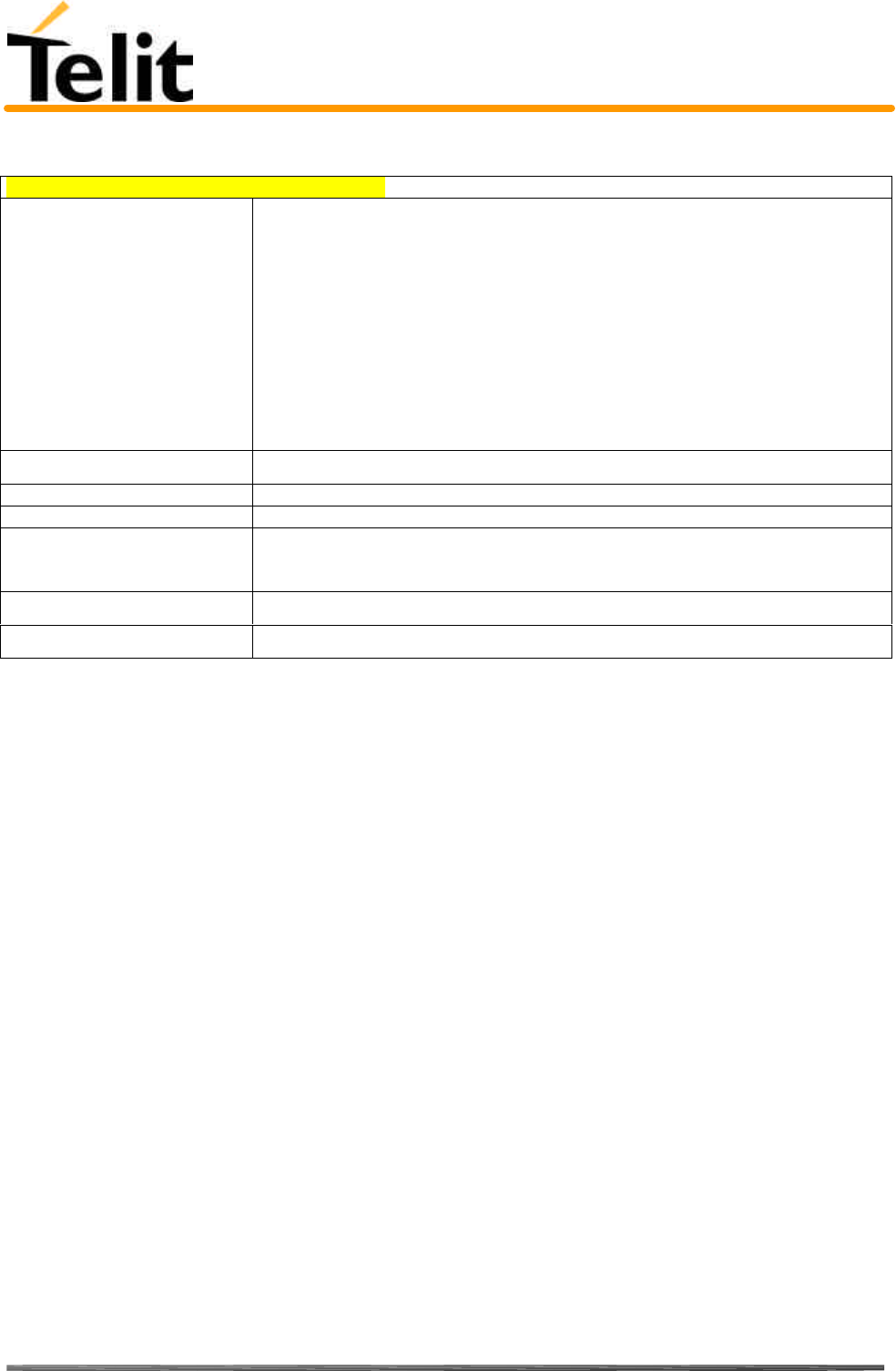
Telit TRIZIUM Product Description
80264ST10007a Rev. 4– 09/09/04
Reproduction forbidden without DAI Telecom written authorization – All Right reserved – Right of modification reserved page 178 of 202
5.8.4.10 #SKTRST – Socket Parameters Reset Command
#SKTRST – Socket Parameters Reset Command
Execute command
AT#SKTRST Resets the actual Parameters of the Socket in the NVM of the device to the default
ones.
The values reset are:
- User Name (none)
- Password (none)
- Packet Size
- Socket inactivity timeout
- Data sending timeout
- Socket type (UDP/TCP)
- Remote port (none)
- Remote address (none)
Read command
Write command
Test command
Example AT#SKTRST
OK
…socket parameters have been reset
Reference Telit specifications
SW release Version A
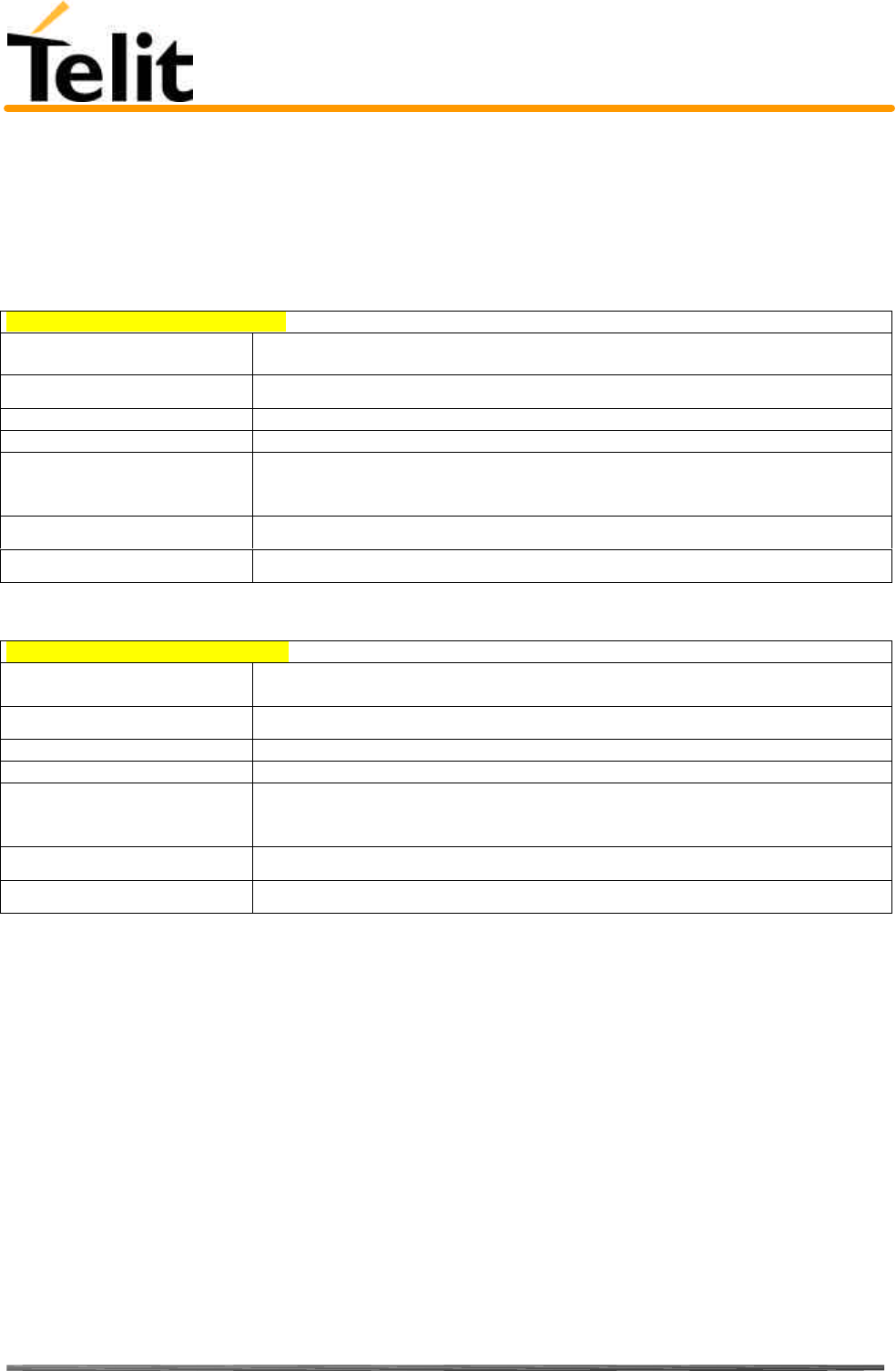
Telit TRIZIUM Product Description
80264ST10007a Rev. 4– 09/09/04
Reproduction forbidden without DAI Telecom written authorization – All Right reserved – Right of modification reserved page 179 of 202
5.9 Easy Camera Extension
5.9.1 Camera management
5.9.1.1 #CAMON – Camera ON
#CAMON – Camera ON Command
Execute command
AT#CAMON Turns ON the Camera.
Read command
Write command
Test command
Example AT#CAMON
OK
… camera is now powered up.
Reference Telit specifications
SW release Version A
5.9.1.2 #CAMOFF – Camera OFF
#CAMOFF – Camera off Command
Execute command
AT#CAMOFF Turns OFF the Camera.
Read command
Write command
Test command
Example AT#CAMOFF
OK
… camera is now powered down.
Reference Telit specifications
SW release Version A
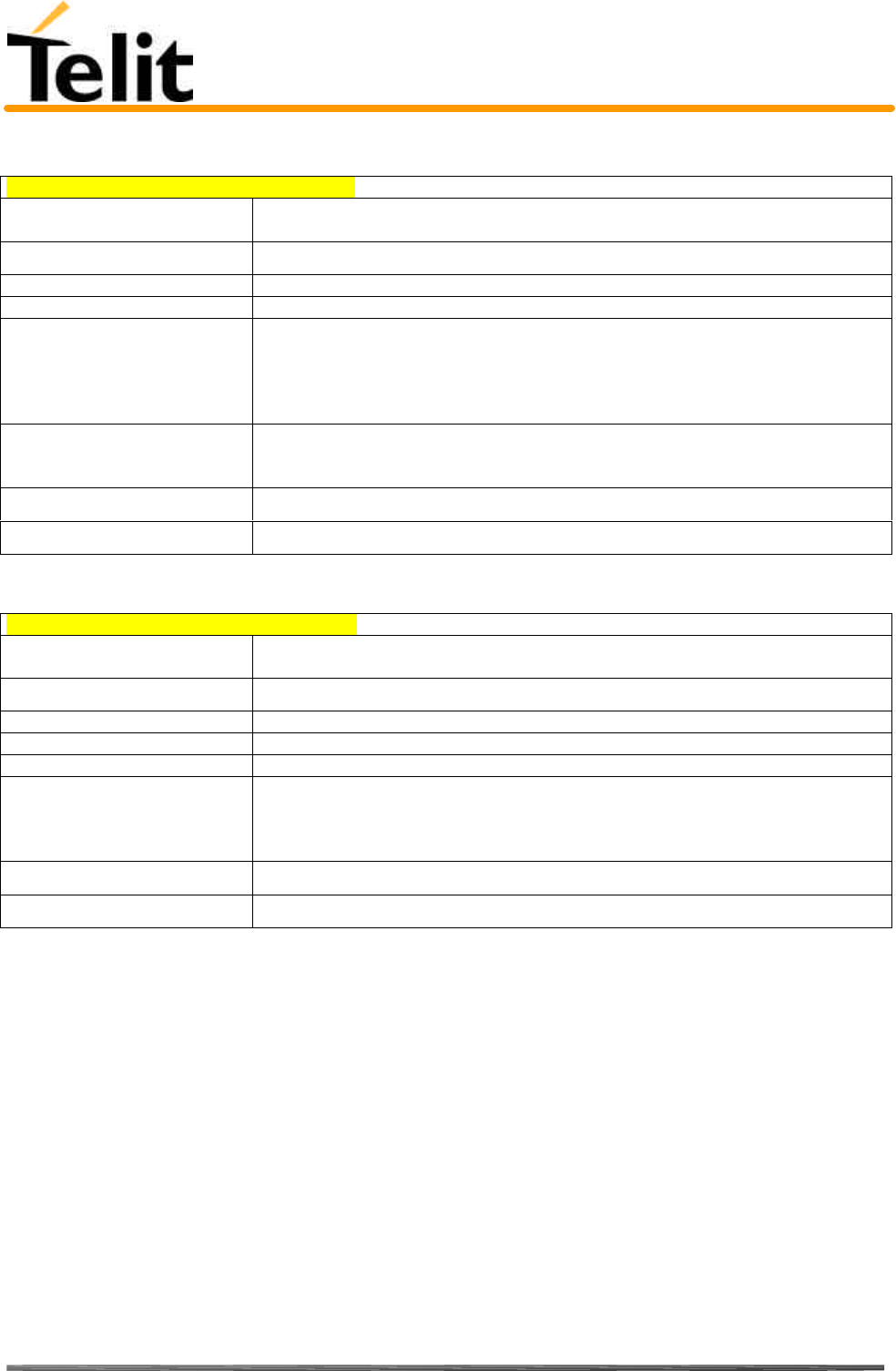
Telit TRIZIUM Product Description
80264ST10007a Rev. 4– 09/09/04
Reproduction forbidden without DAI Telecom written authorization – All Right reserved – Right of modification reserved page 180 of 202
5.9.1.3 #TPHOTO – Camera Take Photo
#TPHOTO – Camera Take Photo Command
Execute command
AT#TPHOTO Commands the CAMERA to take the photo and stores it in the TRIZIUM memory.
Read command
Write command
Test command
NOTE The photo is kept in the TRIZIUM RAM memory, therefore after a power off it is
lost.
There's only 1 position for the photo, every photo will overwrite the previous.
The photo is taken during IDLE time, if the mobile is busy on network operations,
(e.g. during a call) the photo cannot be taken.
Example AT#TPHOTO
OK
… the camera has taken the photo and it is now stored on the TRIZIUM memory.
Reference Telit specifications
SW release Version A
5.9.1.4 #RPHOTO – Camera Read Photo
#RPHOTO – Camera Read Photo Command
Execute command
AT#RPHOTO After this command the TRIZIUM starts to flush the photo in its memory to the serial
line, ending it with the Ok code..
Read command
Write command
Test command
NOTE The photo is flushed as hexadecimal characters in the format selected.
Example AT#RPHOTO
xxxxxxxxxxxx (binary digits of the JPEG image)
<cr><lf>OK<cr><lf>
… the photo has been flushed to the serial line.
Reference Telit specifications
SW release Version A
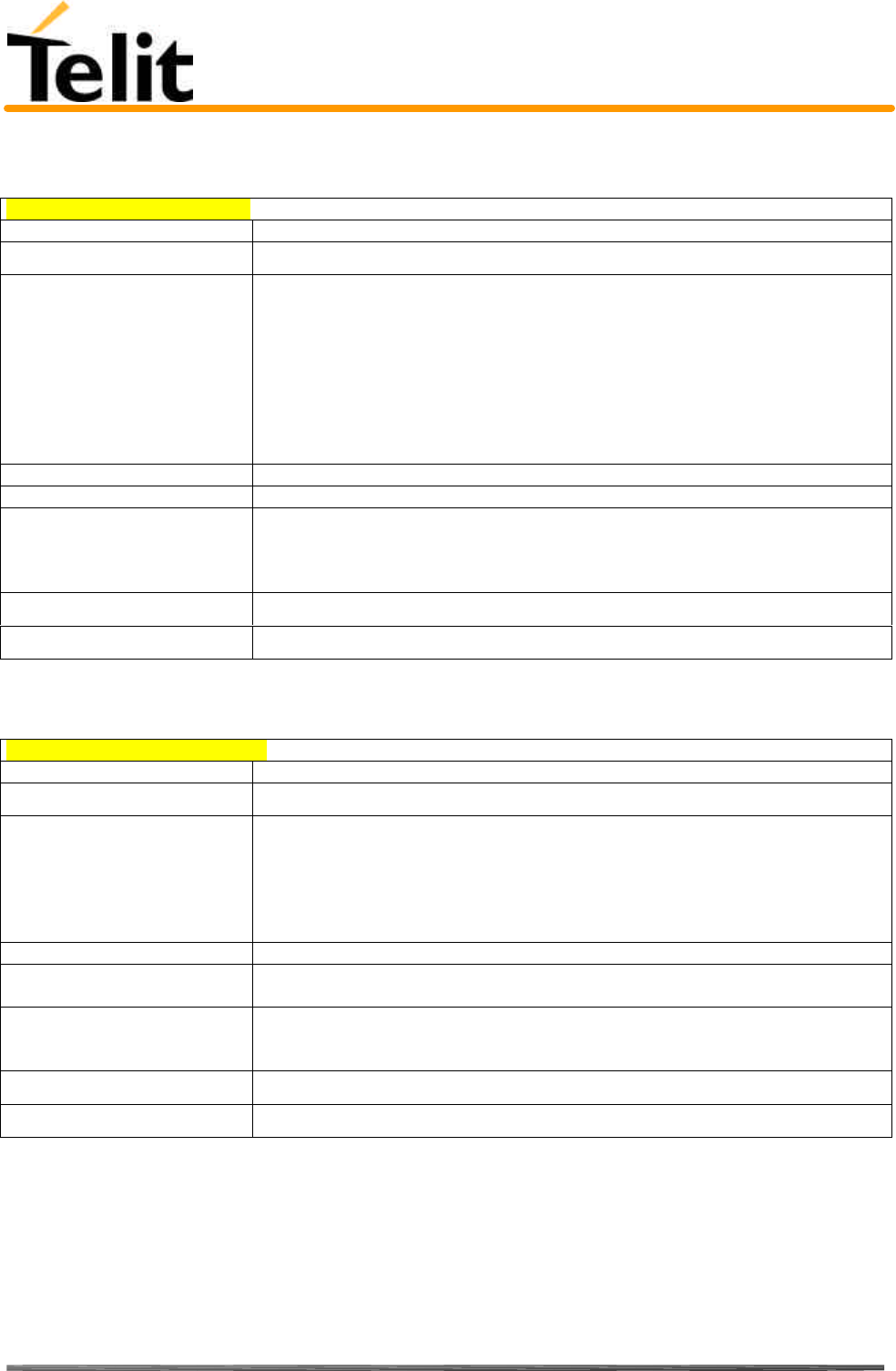
Telit TRIZIUM Product Description
80264ST10007a Rev. 4– 09/09/04
Reproduction forbidden without DAI Telecom written authorization – All Right reserved – Right of modification reserved page 181 of 202
5.9.1.5 #OBJL – Object List
#OBJL– Object List Command
Execute command
Read command
Write command
AT#OBJL="<obj>" Reports the list of the objects stored in the TRIZIUM memory.
Parameter:
<obj> - a string parameter which specify the object listed.
"IMG" - Image object (it is the only string supported).
Returns the list of the stored objects:
#OBJL: Snapshot,<size>
where
Snapshot - is the name of the object. It can't be changed.
<size> is the size of the object reported in bytes.
Test command
NOTE
Example AT#OBJL="IMG"
#OBJL: Snapshot,47224
OK
Reference Telit specifications
SW release Version A
5.9.1.6 #OBJR – Object Read
#OBJR – Object Read Command
Execute command
Read command
Write command
AT#OBJR="<obj>","Snapsh
ot"
After this command the TRIZIUM starts to flush the photo in its memory to the serial
line without ending it with OK.
Parameter:
<obj> - a string parameter which specify the object listed.
"IMG" - Image object (it is the only string supported).
"Snapshot" - is the name of the object.
Test command
NOTE The photo is flushed as hexadecimal characters in the format selected. The baudrate
is fixed at 115200, using hardware flow control.
Example AT#OBJR="IMG","Snapshot"
xxxxxxxxxxxx (binary digits of the JPEG image)
… the photo has been flushed to the serial line.
Reference Telit specifications
SW release Version A
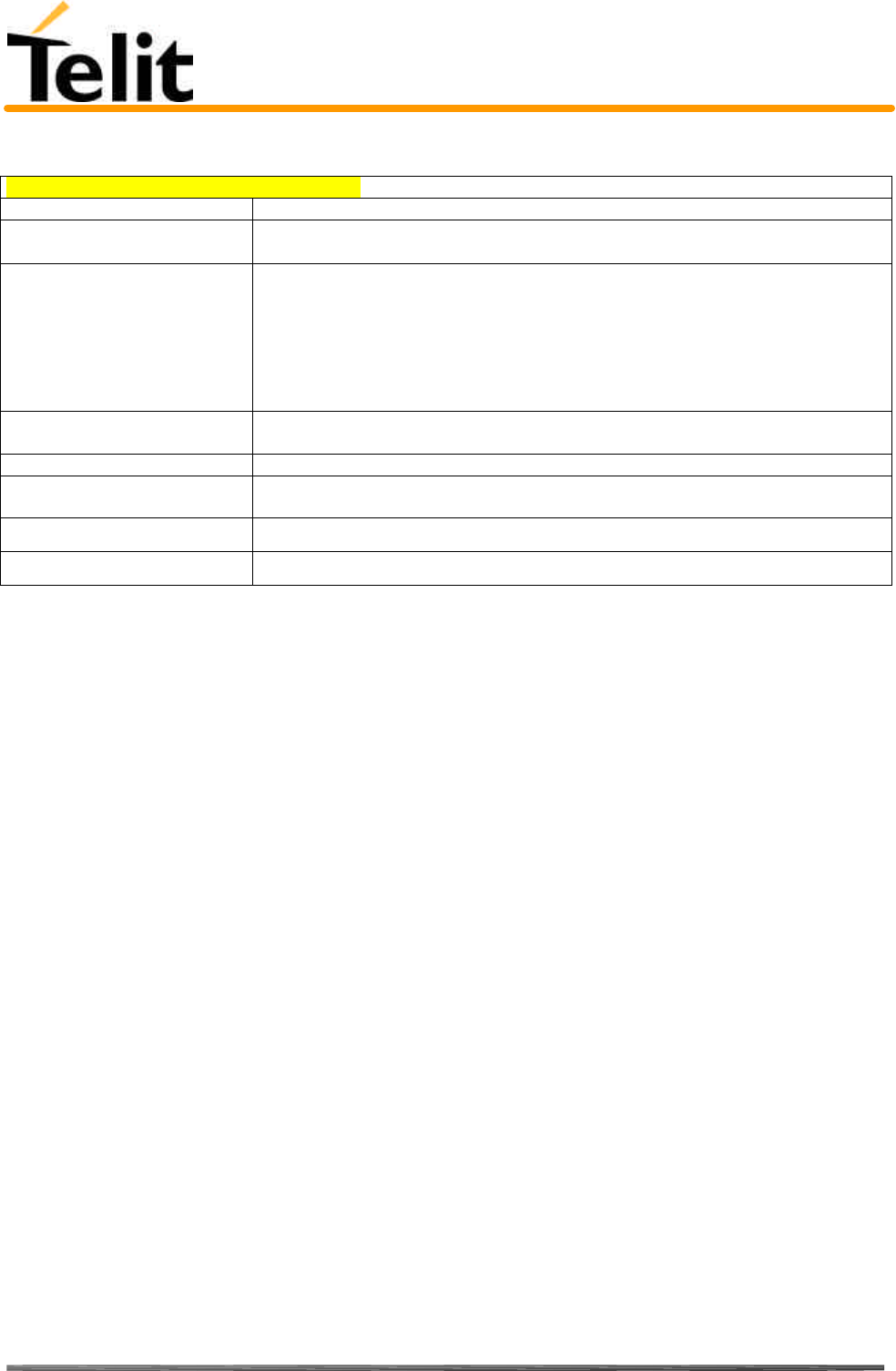
Telit TRIZIUM Product Description
80264ST10007a Rev. 4– 09/09/04
Reproduction forbidden without DAI Telecom written authorization – All Right reserved – Right of modification reserved page 182 of 202
5.9.1.7 #CAMQUA – Camera Select Quality of Photo
#CAMQUA - Camera Select Quality of Photo
Execute command
Read command
AT#CAMQUA? Reports the current value of the parameter <qual>
Write command
AT#CAMQUA=<qual> This command sets the quality of the photo stored on the memory of the TRIZIUM
Parameter:
<qual> - photo quality
0 - low (Jpeg compression high - low quality of picture)
1 - medium (Jpeg compression medium - med. quality of picture)
2 - high ( Jpeg compression low - high quality of picture) - default
Test command
AT#CAMQUA=? Returns the allowed values for the parameters.
NOTE Increasing the photo quality increases its size.
Example AT#CAMQUA=2
OK
Reference Telit specifications
SW release Version A
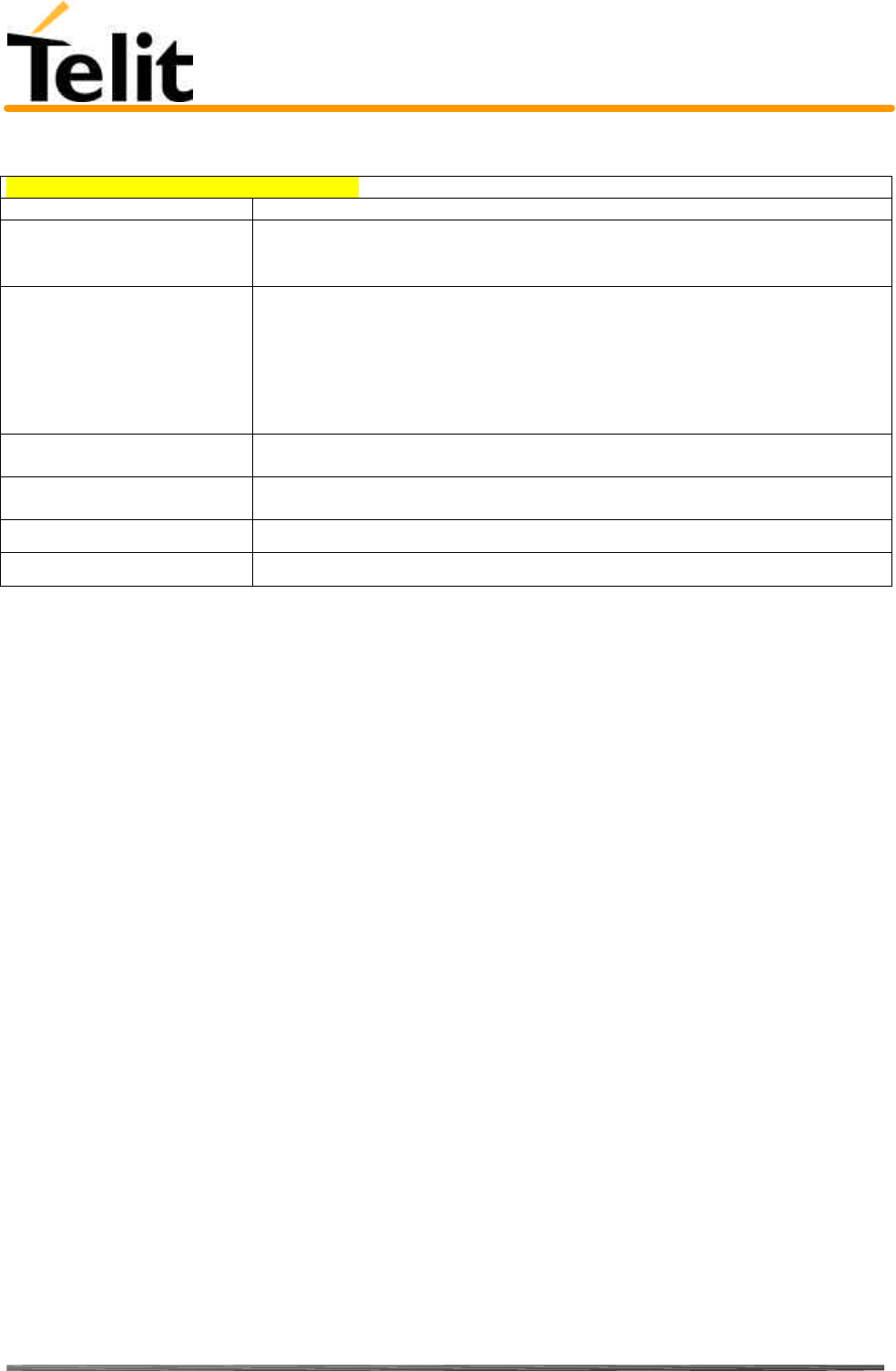
Telit TRIZIUM Product Description
80264ST10007a Rev. 4– 09/09/04
Reproduction forbidden without DAI Telecom written authorization – All Right reserved – Right of modification reserved page 183 of 202
5.9.1.8 #CMODE – Camera Select Operating MODE
#CMODE - Camera Select Operating MODE
Execute command
Read command
AT#CMODE? Reports the current value of the parameter
<mode>
Write command
AT#CMODE=<mode> This command sets the operating mode of the TRIZIUM camera
Parameter:
<mode> - camera operating mode
0 - daylight (short exposure) - default
1 - nightlight (long exposure)
Test command
AT#CMODE=? Returns the allowed values for the parameters.
Example AT#CMODE=0
OK
Reference Telit specifications
SW release Version A
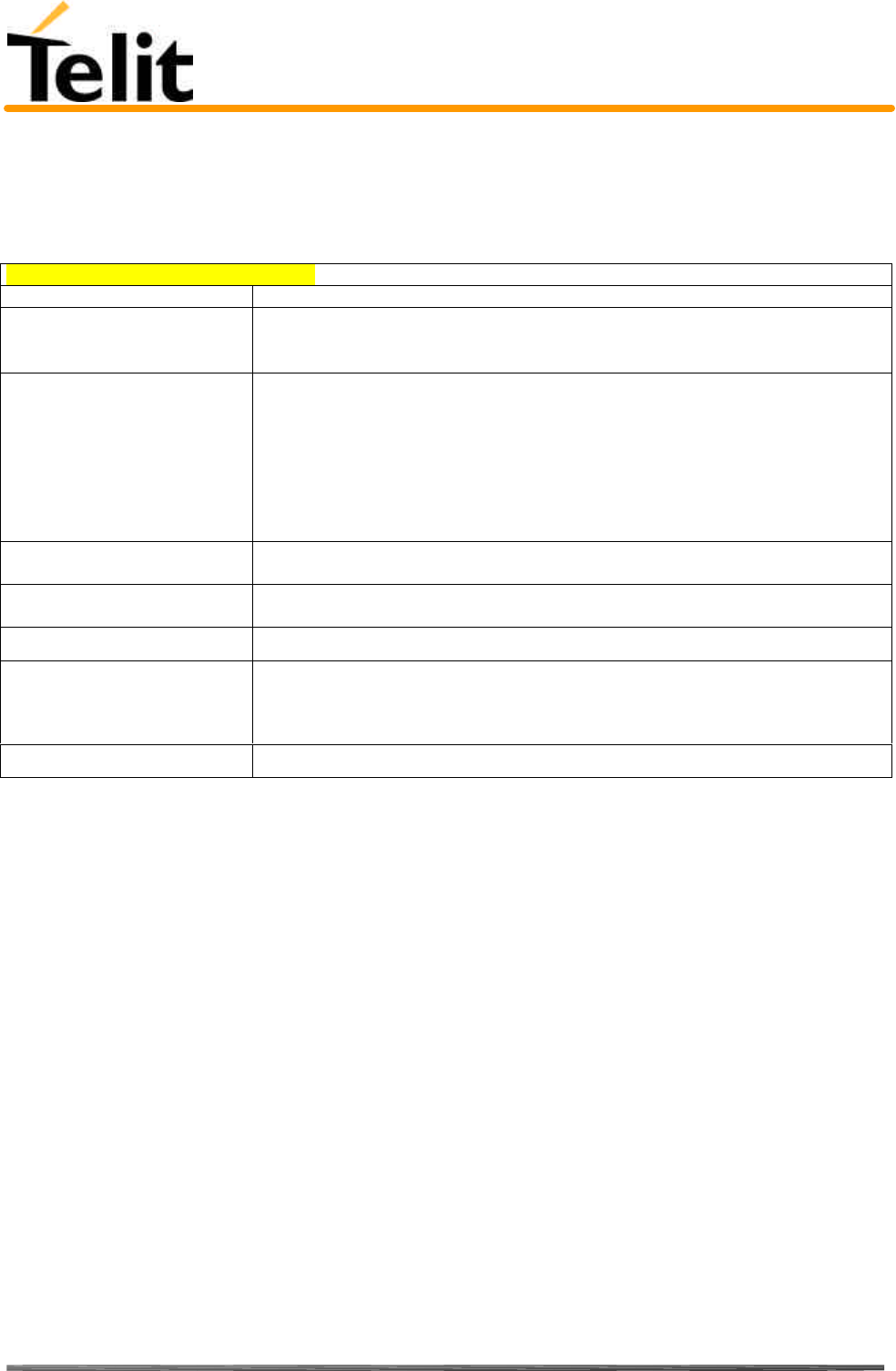
Telit TRIZIUM Product Description
80264ST10007a Rev. 4– 09/09/04
Reproduction forbidden without DAI Telecom written authorization – All Right reserved – Right of modification reserved page 184 of 202
5.9.2 Email management
5.9.2.1 #ESMTP – Email SMTP server
6.10.2.1 #ESMTP – Email SMTP server
Execute command
Read command
AT#ESMTP? Reports the current value of the parameter
<smtp>
Write command
AT#ESMTP="<smtp>" This command sets the SMTP server used for EMAIL sending.
SMTP server can be specified as IP address or as nick name.
Parameter:
<smtp> - SMTP server address
this parameter can be either:
- any valid IP address in the format: xxx.xxx.xxx.xxx
- any host name to be solved with a DNS query in the format: <host name>
Test command
AT#ESMTP=? Returns the max character length for the parameter.
Example AT#ESMTP="smtp.mydomain.com"
OK
Reference Telit specifications
Note The SMTP server used shall be inside the APN space (the smtp server
provided by the network operator) or it must allow the Relay,
otherwise it will refuse to send the email.
SW release Version A
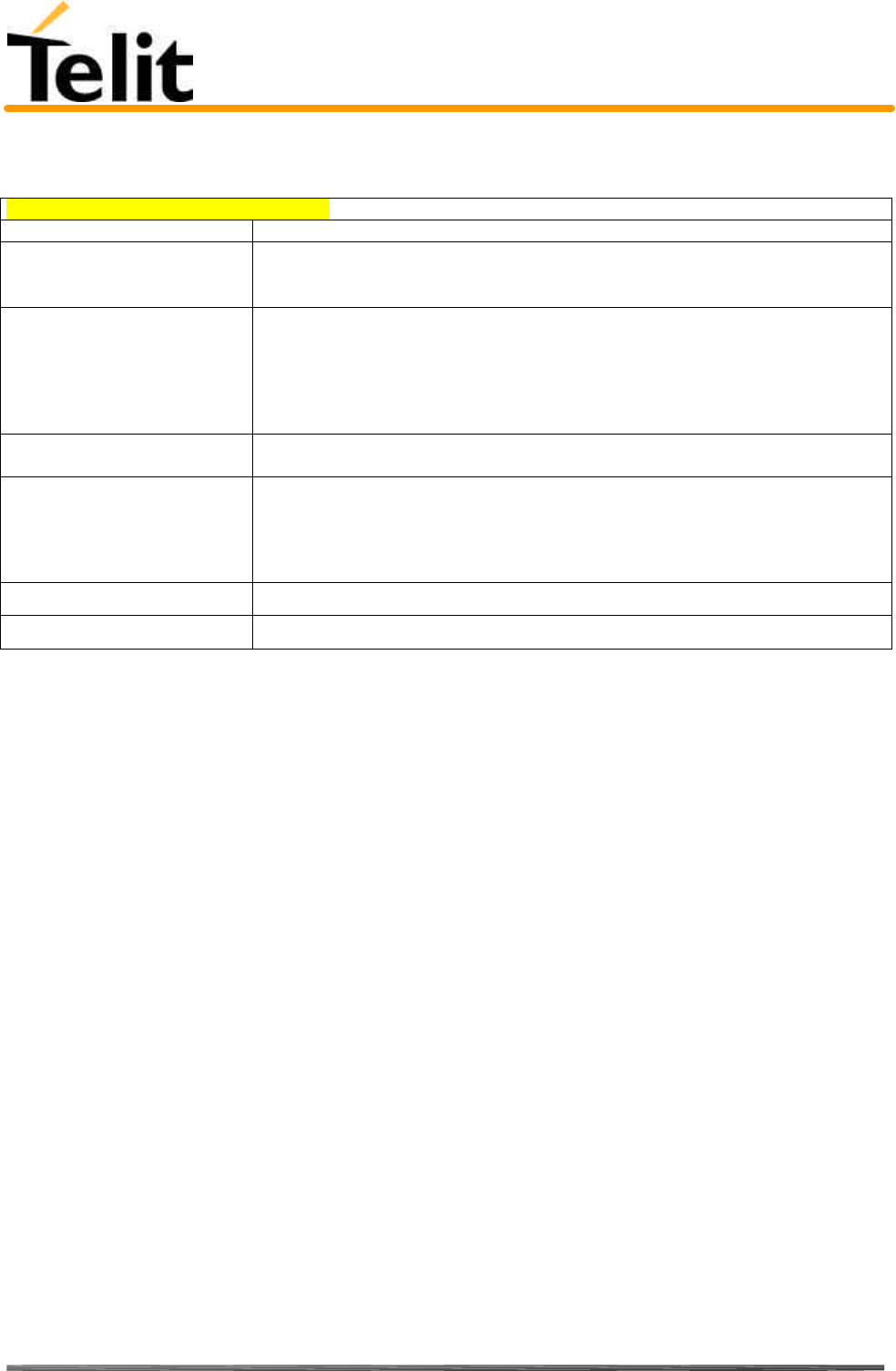
Telit TRIZIUM Product Description
80264ST10007a Rev. 4– 09/09/04
Reproduction forbidden without DAI Telecom written authorization – All Right reserved – Right of modification reserved page 185 of 202
5.9.2.2 #EADDR – Email sender address
6.10.2.2 #EADDR – Email sender address
Execute command
Read command
AT#EADDR? Reports the current value of the parameter
<e-add>
Write command
AT#EADDR="<e-add>" This command sets the sender address string to be used for sending the Email.
Parameter:
<e-add> - sender address
- any string value up to max length reported in the Test command.
By default ""
Test command
AT#EADDR=? Returns the maximum allowed length of the string parameter <e-add>.
Example AT#EADDR = "me@email.box.com"
OK
AT#EADDR?
#EADDR: " me@email.box.com "
OK
Reference Telit specifications
SW release Version A
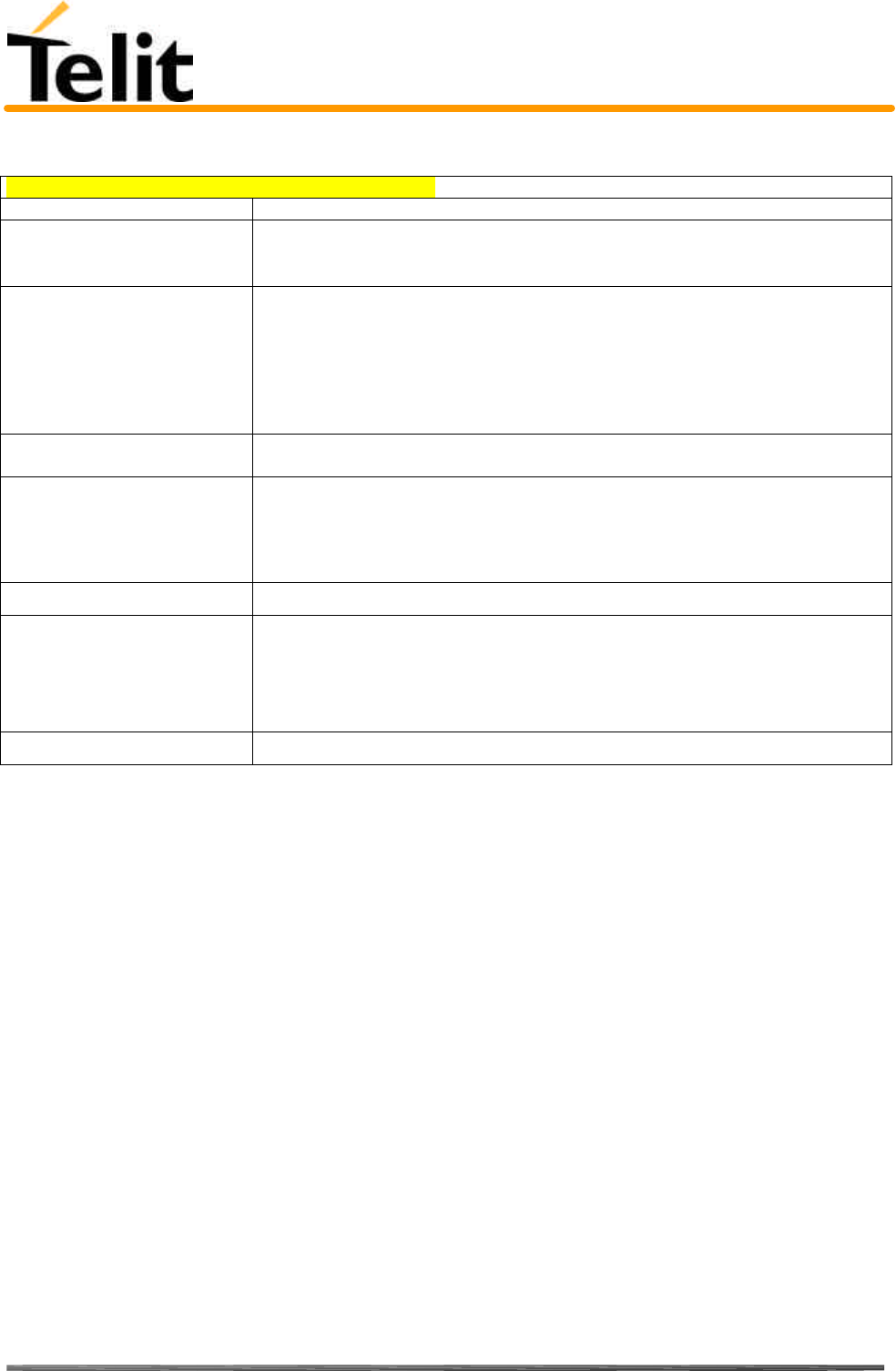
Telit TRIZIUM Product Description
80264ST10007a Rev. 4– 09/09/04
Reproduction forbidden without DAI Telecom written authorization – All Right reserved – Right of modification reserved page 186 of 202
5.9.2.3 #EUSER – Email authentication USER NAME
6.10.2.2 #EUSER – Email authentication USER NAME
Execute command
Read command
AT#EUSER? Reports the current value of the parameter
<e-user>
Write command
AT#EUSER="<e-user>" This command sets the user identification string to be used during the authentication
step of the SMTP to be the string <e-user>.
Parameter:
<e-user> - authentication User ID for email
- any string value up to max length reported in the Test command.
By default ""
Test command
AT#EUSER=? Returns the maximum allowed length of the string parameter <e-user>.
Example AT#USERID = "myE-Name"
OK
AT#USERID?
#USERID: "myE-Name"
OK
Reference Telit specifications
Note If no authentication is required then the e-user parameter shall be
empty "".
Note that it is a different user field than the one used for GPRS
authentication (see AT#USERID).
SW release Version A
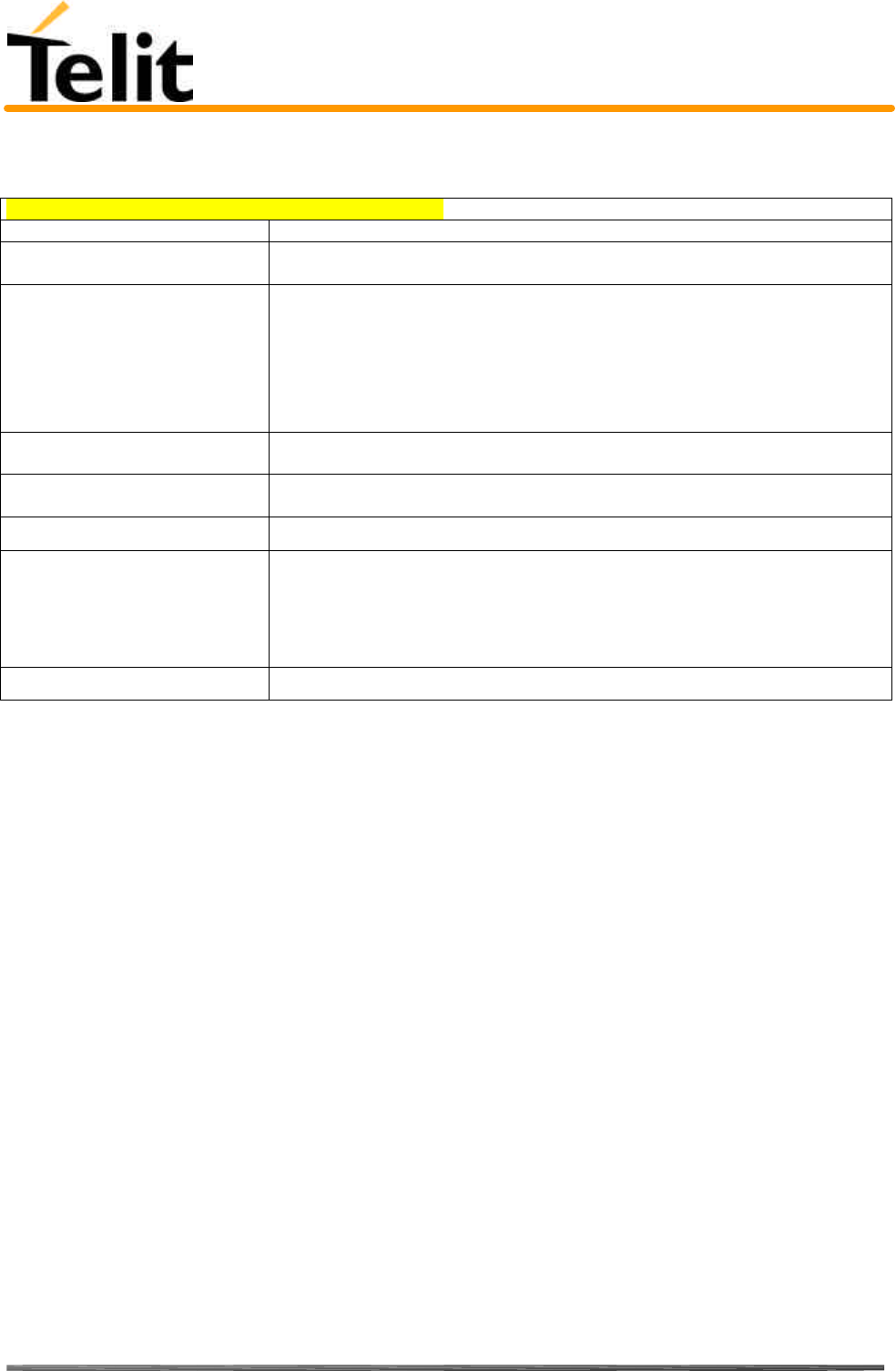
Telit TRIZIUM Product Description
80264ST10007a Rev. 4– 09/09/04
Reproduction forbidden without DAI Telecom written authorization – All Right reserved – Right of modification reserved page 187 of 202
5.9.2.4 #EPASSW – Email authentication PASSWORD
6.10.2.2 #EPASSW – Email authentication PASSWORD
Execute command
Read command
Write command
AT#EPASSW="<e-pwd>" This command sets the user identification string to be used during the
authentication step of the SMTP to be the string <user>.
Parameter:
<e-pwd> - authentication Password for Email
- any string value up to max length reported in the Test command.
By default ""
Test command
AT#EPASSW=? Returns the maximum allowed length of the string parameter <e-pwd>.
Example AT#USERID = "myPassword"
OK
Reference Telit specifications
Note If no authentication is required then the e-pwd parameter shall be
empty "".
Note that it is a different pwd field than the one used for GPRS
authentication (see AT#PASSW).
SW release Version A
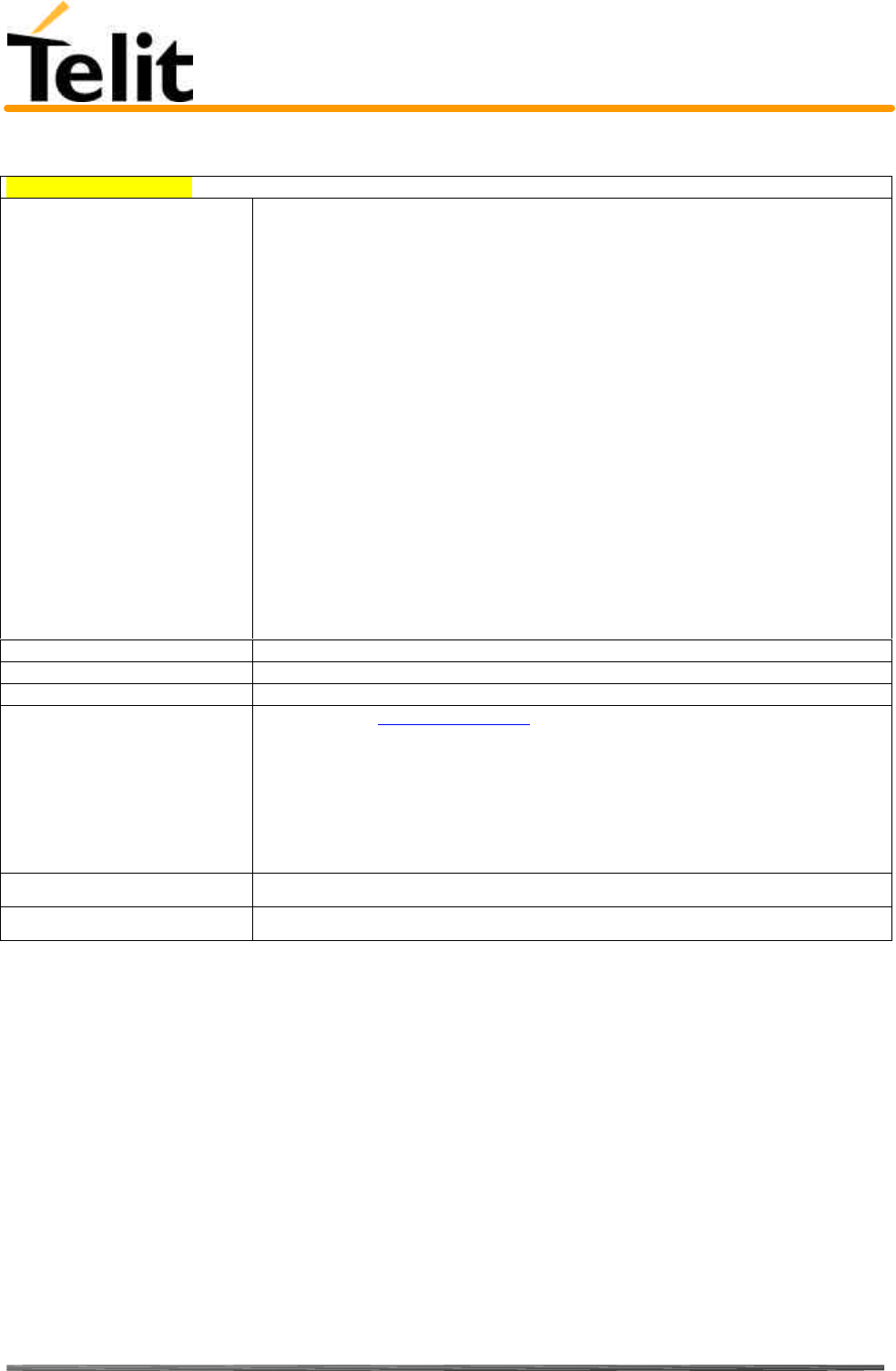
Telit TRIZIUM Product Description
80264ST10007a Rev. 4– 09/09/04
Reproduction forbidden without DAI Telecom written authorization – All Right reserved – Right of modification reserved page 188 of 202
5.9.2.5 #SEMAIL - Send Email
#SEMAIL - Send Email
Execute command
AT#SEMAIL =
"<da>","<subj>",<att>"
Sends an Email message .
Parameter:
<da> - destination address
<subj> - subject of the message
<att> - attach image flag
0 - don't attach any image
1 - attach the snapshot taken (must be already been taken…)
The device responds to the command with the prompt '>' and awaits for the message
body text.
To complete the operation send Ctrl-Z char (0x1A hexadecimal) , to exit without
writing the message send ESC char (0x1B hexadecimal).
If email message is successfully sent, then the response is OK.
If message sending fails for some reason, an error code is reported
Note: Care must be taken to ensure that during the command execution, no other
commands are issued.
To avoid malfunctions is suggested to wait for the OK or ERROR/ +CMS
ERROR:<err> response before issuing further commands.
Note: sending a mail with an image attachment can take quite a long time since it
can be over 50Kb to send and can take over 1 minute.
Read command
Write command
Test command
Example AT#SEMAIL="me@myaddress.com","subject of the mail",1
Ø message body… this is the text of the mail message…
CTRL-Z
..wait..
OK
Message has been sent.
Reference Telit specifications
SW release Version A

Telit TRIZIUM Product Description
80264ST10007a Rev. 4– 09/09/04
Reproduction forbidden without DAI Telecom written authorization – All Right reserved – Right of modification reserved page 189 of 202
5.10 Easy Scan Extension
5.10.1 Easy Scan custom AT commands
5.10.1.1 *CSURV - Network Survey of the complete 900/1800/1900 Network
*CSURV – network survey of the complete GSM900/1800/1900 Network
Execute command
AT*CSURV
AT#CSURV
(both syntax are possible)
The command allows to perform a quick survey through both GSM900 and
DCS1800 or PCS1900 Bands (full band scan). After this the following information
for every received BCCH is available.
For BCCH-Carrier:
arfcn: <value> bsic: <value> rxLev: <value> ber: <value> mcc: <value> mnc:
<value> lac: <value> cellId: <value> cellStatus: <value> numArfcn: <value> arfcn:
<value1>…<value64> numChannels: <value> array: <value1>…<value32>
For non BCCH-Carrier:
arfcn: <value> level: <value>
where:
arfcn = C0 carrier assigned radio channel (BCCH - Broadcast Control Channel)
bsic = base station identification code
rxLev = received level (in dBm)
ber = bit error rate (in %)
mcc = mobile country code
mnc = mobile network code
lac = localization area code
cellId = cell identifier
cellStatus = cell Status
Cell Allocation
NumArfcn = number of valid channels
arfcn = arfcn-list
BCCH Allocation
NumChannels = number of valid channels
array = arfcn-list
The parameter CELLSTATUS indicates the following statuses:
- CELL_SUITABLE indicates the C0 is a suitable cell.
- CELL_LOW_PRIORITY indicates the cell is low priority based on
the system information received.
- CELL_FORBIDDEN indicates the cell is forbidden.
- CELL_BARRED indicates the cell is barred based on the system
information received.
- CELL_LOW_LEVEL indicates the cell RXLEV is low.
- CELL_OTHER indicates none of the above e.g. exclusion timer
running, no BCCH available…etc.
For every non BCCH the following information is available:
arfcn = RF channel
rxLev = received level (in dBm)
Read command
Write command
AT*CSURV=<s>,<e> The command allows to perform a quick survey through a defined part of the
GSM900/DCS1800/PCS1900 Bands. It scans the channel from <s> to <e>. The
result format is similar to the full band scan.
Parameters: <s> = starting channel
<e> = ending channel

Telit TRIZIUM Product Description
80264ST10007a Rev. 4– 09/09/04
Reproduction forbidden without DAI Telecom written authorization – All Right reserved – Right of modification reserved page 190 of 202
Test command
Example AT*CSURV
Network survey started…
arfcn: 48 bsic: 24 rxLev: -52 ber: 0.00 mcc: 610 mnc: 1 lac: 33281 cellId: 3648
cellStatus: CELL_SUITABLE numArfcn: 2 arfcn: 30 48 numChannels: 5 array: 14
19 22 48 82
arfcn: 14 level: 8
Network survey ended
OK
Note The command is executed within max. 2 minute.
Reference Telit Specifications.
SW release Version A
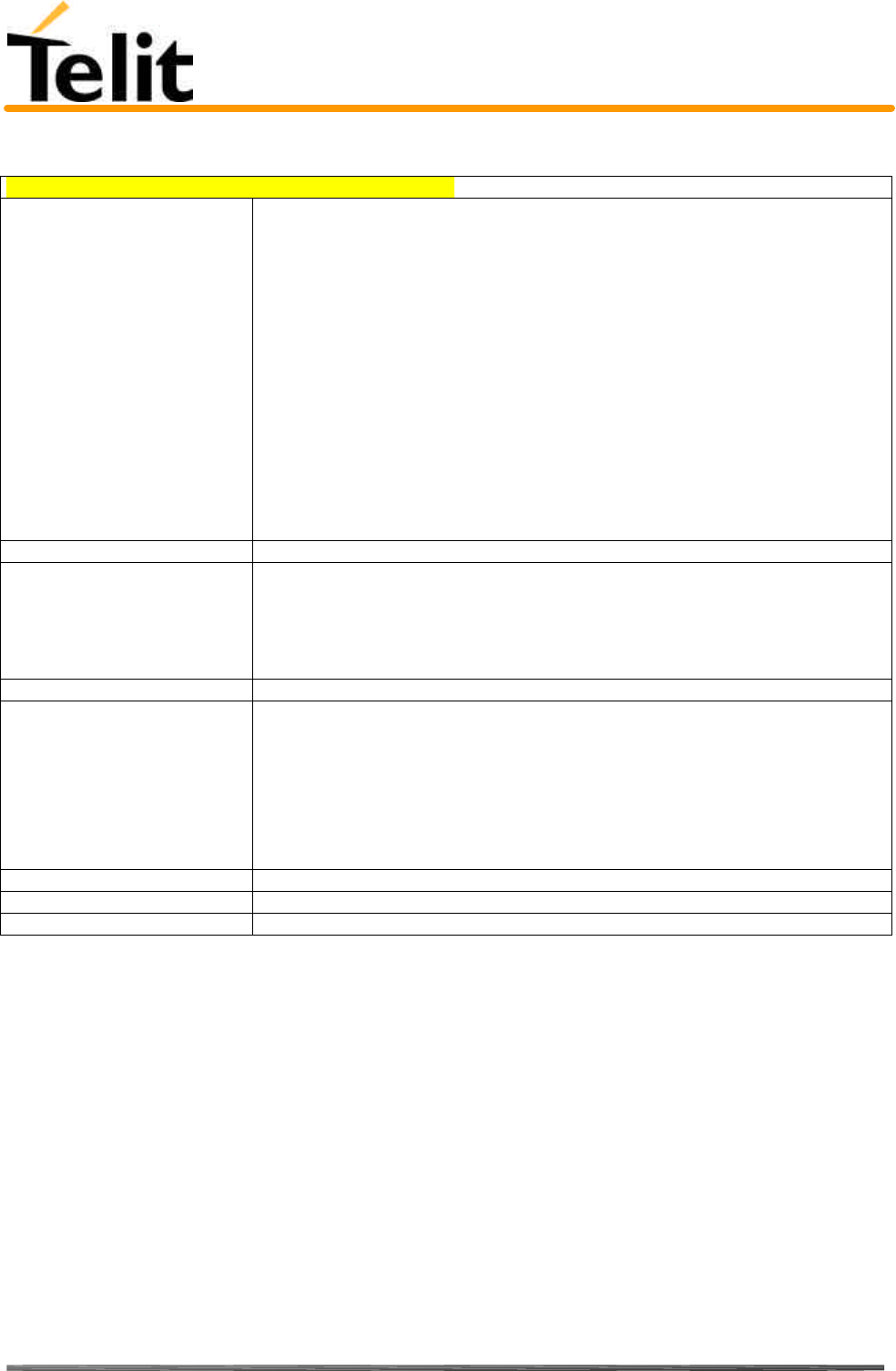
Telit TRIZIUM Product Description
80264ST10007a Rev. 4– 09/09/04
Reproduction forbidden without DAI Telecom written authorization – All Right reserved – Right of modification reserved page 191 of 202
5.10.1.2 *CSURVC - Network Survey in computer friendly format
*CSURVC – network survey in computer friendly format
Execute command
AT*CSURVC The command allows to perform a quick survey through both GSM900 and
DCS1800 or PCS1900 Bands (full band scan). The format is computer friendly.
For BCCH-Carrier:
<arfcn>,<bsic>,<rxLev>,<ber>,<mcc>,<mnc>,<lac>,<cellId>,<
cellStatus>,<numArfcn>,<arfcn1>…<arfcn64>,<numChannels>,<
array1>…<array32>
For non BCCH-Carrier:
<arfcn>,<level>
The numeric format of the parameter CELLSTATUS is the following:
0 - CELL_SUITABLE
1 - CELL_LOW_PRIORITY
2 - CELL_FORBIDDEN
3 - CELL_BARRED
4 - CELL_LOW_LEVEL
5 - CELL_OTHER
Read command
Write command
AT*CSURVC =<s>,<e> The command allows to perform a quick survey through a defined part of the
GSM900/DCS1800/PCS1900 Bands. It scans the channels from <s> to <e>. The
result format is similar to the full band scan.
Parameters: <s> = starting channel
<e> = ending channel
Test command
Example AT*CSURVC
Network survey started…
48,24,-52,0.00,610,1,33281,3648,0,2,30 48,5,14 19 22 48 82
14,8
Network survey ended
OK
Note The command is executed within max. 2 minute.
Reference Telit Specifications.
SW release Version A
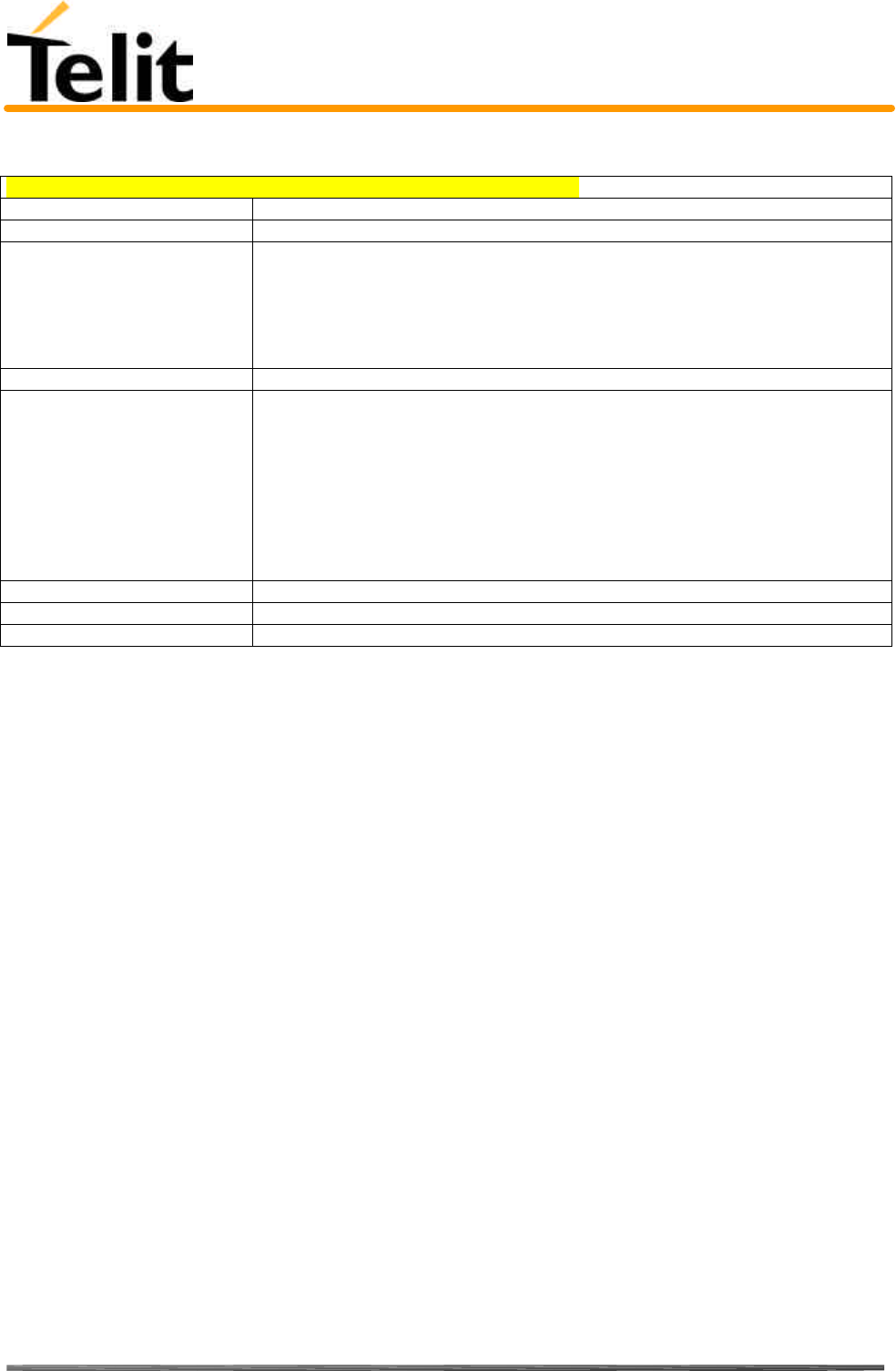
Telit TRIZIUM Product Description
80264ST10007a Rev. 4– 09/09/04
Reproduction forbidden without DAI Telecom written authorization – All Right reserved – Right of modification reserved page 192 of 202
5.10.1.3 *CSURVU - Network Survey of user defined 900/1800/1900 channels
*CSURVU – network survey of user defined GSM900/1800/1900 channels
Execute command
Read command
Write command
AT*CSURVU
=<ch1>,<ch2>,…,<chN>
The command allows to perform a quick survey of user defined
GSM900/DCS1800/PCS1900 channels. It scans the given channels. The result
format is the same like the full band scan (AT*CSURV).
Parameter: <chN> = channel number
The max. number of scanned channels is 498 (124 for GSM, 374 for DCS or PCS).
The <chN> must be in a increasing order.
Test command
Example AT*CSURVU=59,110
Network survey started…
arfcn: 59 bsic: 16 rxLev: -76 ber: 0.00 mcc: 546 mnc: 1 lac: 54717 cellId: 21093
cellStatus: CELL_SUITABLE numArfcn 2 arfcn: 36 59
arfcn: 110 rxLev: -107
Network survey ended
OK
Note The command is executed within max. 2 minute.
Reference Telit Specifications.
SW release Version A
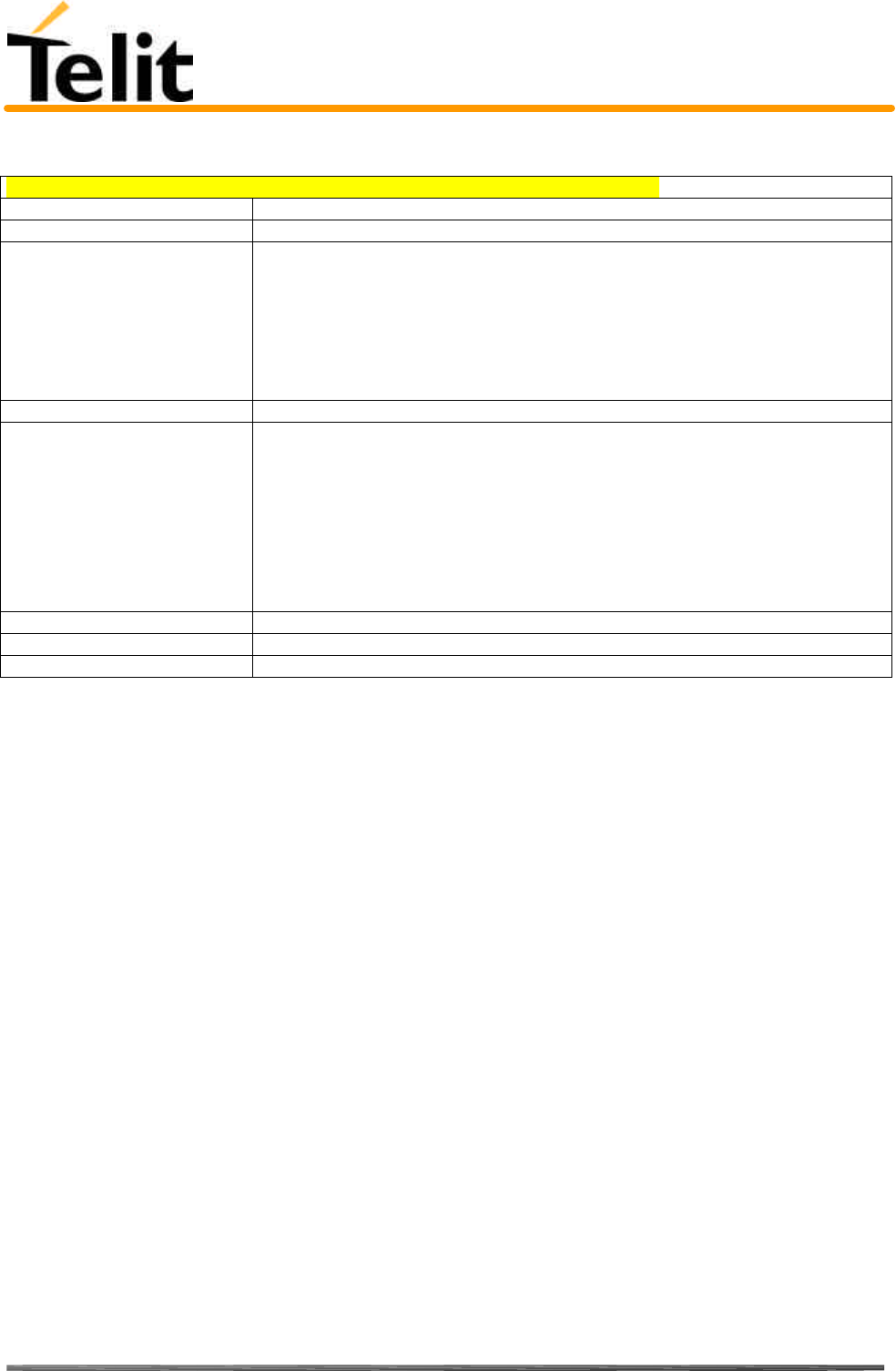
Telit TRIZIUM Product Description
80264ST10007a Rev. 4– 09/09/04
Reproduction forbidden without DAI Telecom written authorization – All Right reserved – Right of modification reserved page 193 of 202
5.10.1.4 *CSURVUC - Network Survey in computer friendly format
*CSURVUC – network survey of user defined channels in computer friendly format
Execute command
Read command
Write command
AT*CSURVUC
=<ch1>,<ch2>,…,<chN>
The command allows to perform a quick survey of user defined
GSM900/DCS1800/PCS1900 channels. It scans the given channels.
The format is computer friendly.
Parameter: <chN> = channel number
The max. number of scanned channels is 498 (124 for GSM, 374 for DCS or PCS).
The <chN> must be in a increasing order.
Test command
Example AT*CSURVUC = 59,110
Network survey started…
59,16,-76,0.00,546,1,54717,21093,0,2,36 59
110,-107
Network survey ended
OK
Note The command is executed within max. 2 minute.
Reference Telit Specifications.
SW release Version A
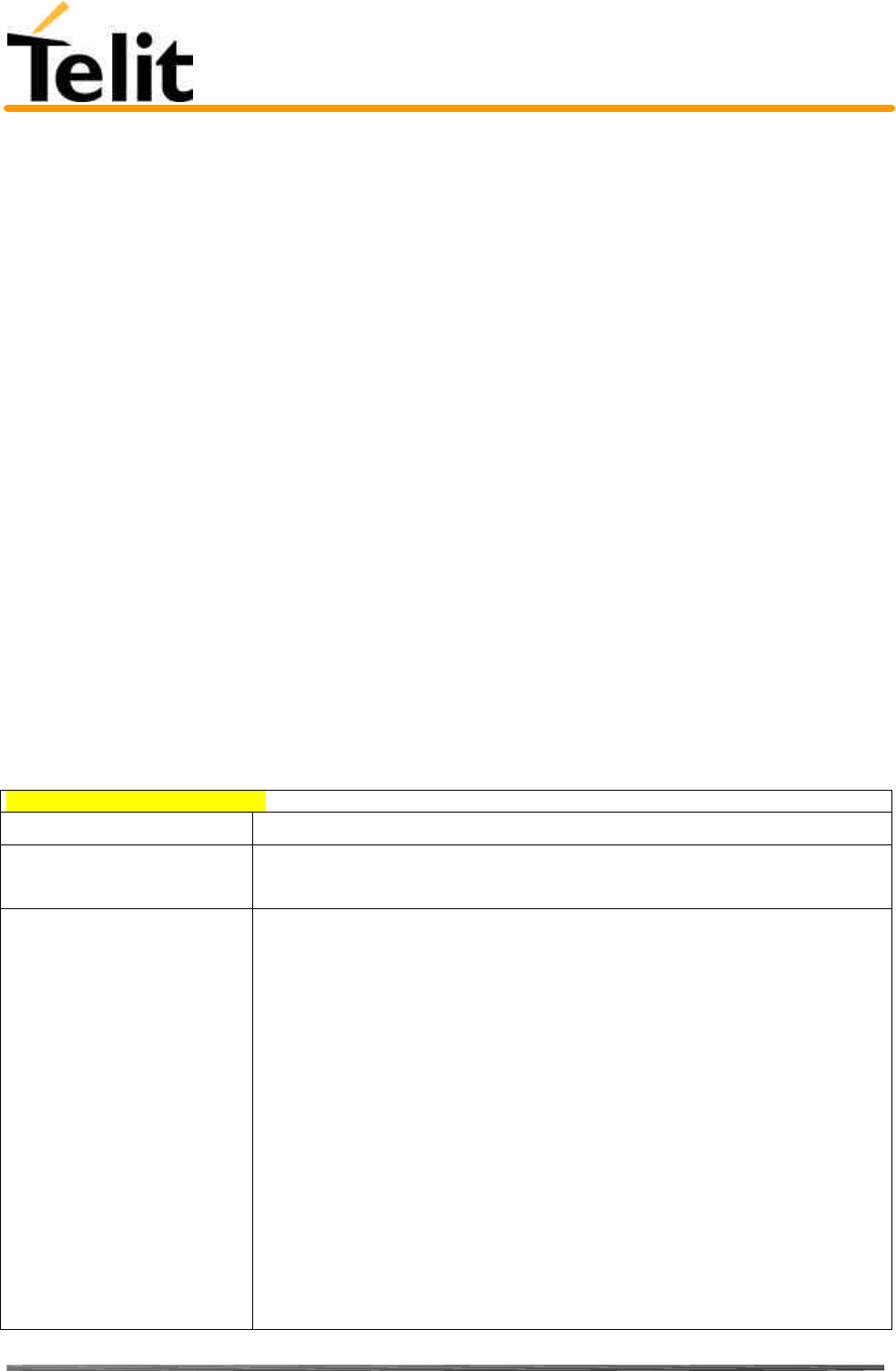
Telit TRIZIUM Product Description
80264ST10007a Rev. 4– 09/09/04
Reproduction forbidden without DAI Telecom written authorization – All Right reserved – Right of modification reserved page 194 of 202
5.11 Jammed Detect & Report Extension
5.11.1 Overview
The Jammed Detect & Report feature allows a Telit TRIZIUM to detect the presence of a
disturbing device such as a Communication Jammer and give indication to the user and/or send a
report of that to the network.
This feature can be very important in alarm, security and safety applications that rely on the module
for the communications. In these applications, the presence of a Jammer device can compromise the
whole system reliability and functionality and therefore shall be recognized and reported either to
the local system for countermeasure actions or to the network providing remote actions.
An example scenario could be an intrusion detection system that uses the Telit TRIZIUM for
sending the alarm indication for example with an SMS to the system owner, and a thief incomes
using a Jammer to prevent any communication between the GSM module and the network.
In such a case, the Telit TRIZIUM detects the Jammer presence even before the break in and can
trigger an alarm siren, other communication devices (PSTN modem) or directly report this
condition to the network that can provide further security services for example sending SMS to the
owner or police.
5.11.2 Jammed Detect & Report custom AT commands
5.11.2.1 #JDR - Jammed Detect & Report
#JDR - Jammed Detect & Report
Execute command
Read command
AT#JDR? Reports the current settings of the command, in the format:
#JDR: <mode>,<MNPL>,<DCMN>
Write command
AT#JDR = <mode>
[,<MNPL>,<DCMN>]
This command allows to control the Jammed Detect & Report feature.
The TRIZIUM can Detect if a communication Jammer is active in its range and give
indication to the user of this condition either on the serial line with an unsolicited
code or on a dedicated GPIO by rising it.
The TRIZIUM can also report to the network the Jammed status condition, even if
normal communications are inhibited by the Jammer, by using a unique message.
Parameter:
<mode> - behavior mode of the Jammed Detect & Report
0 - Jammed Detect & Report DISABLED (Default)
1 - the Jammed Detect is active and the Jammed condition is reported on pin
GPIO1/JDR
GPIO1/JDR LOW - Normal Operating Condition
GPIO1/JDR HIGH - Jammed Condition.
2 - the Jammed Detect is active and the Jammed condition is reported with a single
unsolicited code on serial line whose format is:
#JDR: JAMMED - Jammed condition detected
#JDR: OPERATIVE - Normal Operating condition restored.
Note: the #JDR: OPERATIVE code will show only after a jammed condition

Telit TRIZIUM Product Description
80264ST10007a Rev. 4– 09/09/04
Reproduction forbidden without DAI Telecom written authorization – All Right reserved – Right of modification reserved page 195 of 202
has occurred.
3 - the TRIZIUM will make both the actions as for mode=1 and mode=2.
4 - the Jammed Detect is active and the Jammed condition is reported with an
unsolicited code every 3s on serial line, whose format is:
#JDR: JAMMED - Jammed condition detected
#JDR: OPERATIVE - Normal Operating condition restored.
Note: the #JDR: OPERATIVE code will show only once and after a jammed
condition has occurred.
5 - the TRIZIUM will make both the actions as for mode=1 and mode=4.
10 -The TRIZIUM will Report the Jammed status to the network on Jammed
Detection.
11 - the TRIZIUM will make both the actions as for mode=10 and mode=1.
12 - the TRIZIUM will make both the actions as for mode=10 and mode=2.
13 - the TRIZIUM will make both the actions as for mode=10 and mode=3.
14 - the TRIZIUM will make both the actions as for mode=10 and mode=4.
15 - the TRIZIUM will make both the actions as for mode=10 and mode=5.
<MNPL> - Maximum Noise power Level
0 -127
<DCMN> - Disturbed Channel minimum number
0 - 254
Note: The values 10 - 15 of mode parameter will be available on future sw release.
Test command AT#JDR=? Reports the supported range of values for the parameters <mode>,<MNPL>,
<DCMN>
Example AT#JDR=2
OK
… jammer enters in the range…
#JDR: JAMMED
… jammer exits the range…
#JDR: OPERATIVE
Reference Telit Specifications.
SW release Version B

Telit TRIZIUM Product Description
80264ST10007a Rev. 4– 09/09/04
Reproduction forbidden without DAI Telecom written authorization – All Right reserved – Right of modification reserved page 196 of 202
6 Conformity Assessment Issues
The Telit TRIZIUM module is assessed to be conform to the R&TTE Directive as stand-alone product, so If the
module is installed in conformance with Dai Telecom installation instructions require no further evaluation under
Article 3.2 of the R&TTE Directive and do not require further involvement of a R&TTE Directive Notified Body for the final
product.
In all other cases, or if the manufacturer of the final product is in doubt then the equipment integrating the radio module
must be assessed against Article 3.2 of the R&TTE Directive.
In all cases assessment of the final product must be made against the Essential requirements of the R&TTE Directive
Articles 3.1(a) and (b), safety and EMC respectively, and any relevant Article 3.3 requirements.
The Telit TRIZIUM module is conform with the following European Union Directives:
¨ R&TTE Directive 1999/5/EC (Radio Equipment & Telecommunications Terminal Equipments)
¨ Low Voltage Directive 73/23/EEC and product safety
¨ Directive 89/336/EEC for conformity for EMC
In order to satisfy the essential requisite of the R&TTE 99/5/EC directive, the TRIZIUM module is
compliant with the following standards:
• GSM (Radio Spectrum). Standard: EN 301 511 and 3GPP 51.010-1
• EMC (Electromagnetic Compatibility). Standards: EN 301 489-1 and EN 301 489-7
• LVD (Low Voltage Directive) Standards: EN 60 950
Furthermore the Telit TRIZIUM module is FCC Approved as module to be installed in other devices. This
device is to be used only for fixed and mobile applications. If the final product after integration is intended
for portable use, a new application and FCC ID is required.
The Telit TRIZIUM module is conform with the following US Directives:
¨ Use of RF Spectrum. Standards: FCC 47 Part 24 (GSM 1900)
¨ EMC (Electromagnetic Compatibility). Standards: FCC47 Part 15
To meet the FCC's RF exposure rules and regulations:
- The antenna(s) used for this transmitter must be installed to provide a separation distance of at least 20
cm from all the persons and must not be co-located or operating in conjunction with any other antenna
or transmitter.
- The antenna(s) used for this module must not exceed 3 dBi for mobile and fixed or mobile operating
configurations.
- Users and installers must be provided with antenna installation instructions and transmitter operating
conditions for satisfying RF exposure compliance.
Manufacturers of mobile, fixed or portable devices incorporating this module are advised to clarify any
regulatory questions and to have their complete product tested and approved for FCC compliance.
Interference statement:
This device complies with Part 15 of the FCC Rules. Operation is subject to the following two conditions:
(1) this device may not cause harmful interference, and
(2) this device must accept any interference received,
including interference that may cause undesired operation.
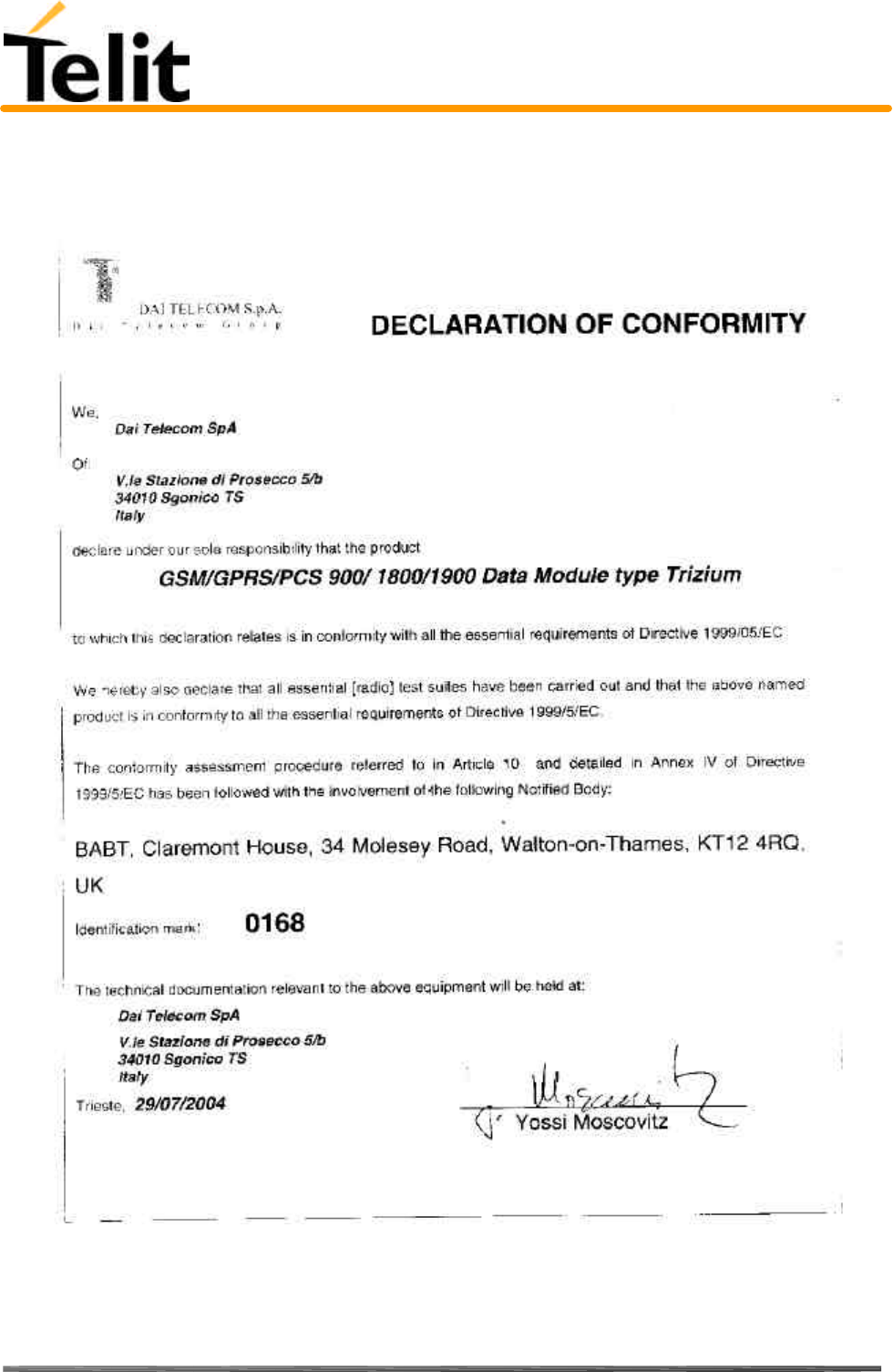
Telit TRIZIUM Product Description
80264ST10007a Rev. 4– 09/09/04
Reproduction forbidden without DAI Telecom written authorization – All Right reserved – Right of modification reserved page 197 of 202
6.1 TRIZIUM: Conformity Assessment

Telit TRIZIUM Product Description
80264ST10007a Rev. 4– 09/09/04
Reproduction forbidden without DAI Telecom written authorization – All Right reserved – Right of modification reserved page 198 of 202
6.2 TRIZIUM: FCC Equipment Authorization
Under approval

Telit TRIZIUM Product Description
80264ST10007a Rev. 4– 09/09/04
Reproduction forbidden without DAI Telecom written authorization – All Right reserved – Right of modification reserved page 199 of 202
7 TRIZIUM Technical Support
Telit technical support to Telit TRIZIUM modules customer is included into the dedicated Website (www.TRIZIUM.com)
and official Website (www.telit.net) which contains also all available technical documentation download, application
examples, Telit engineering support accessible via selective E-Mail (ts-trizium@telital.com) service with 24 hr replies
assured.
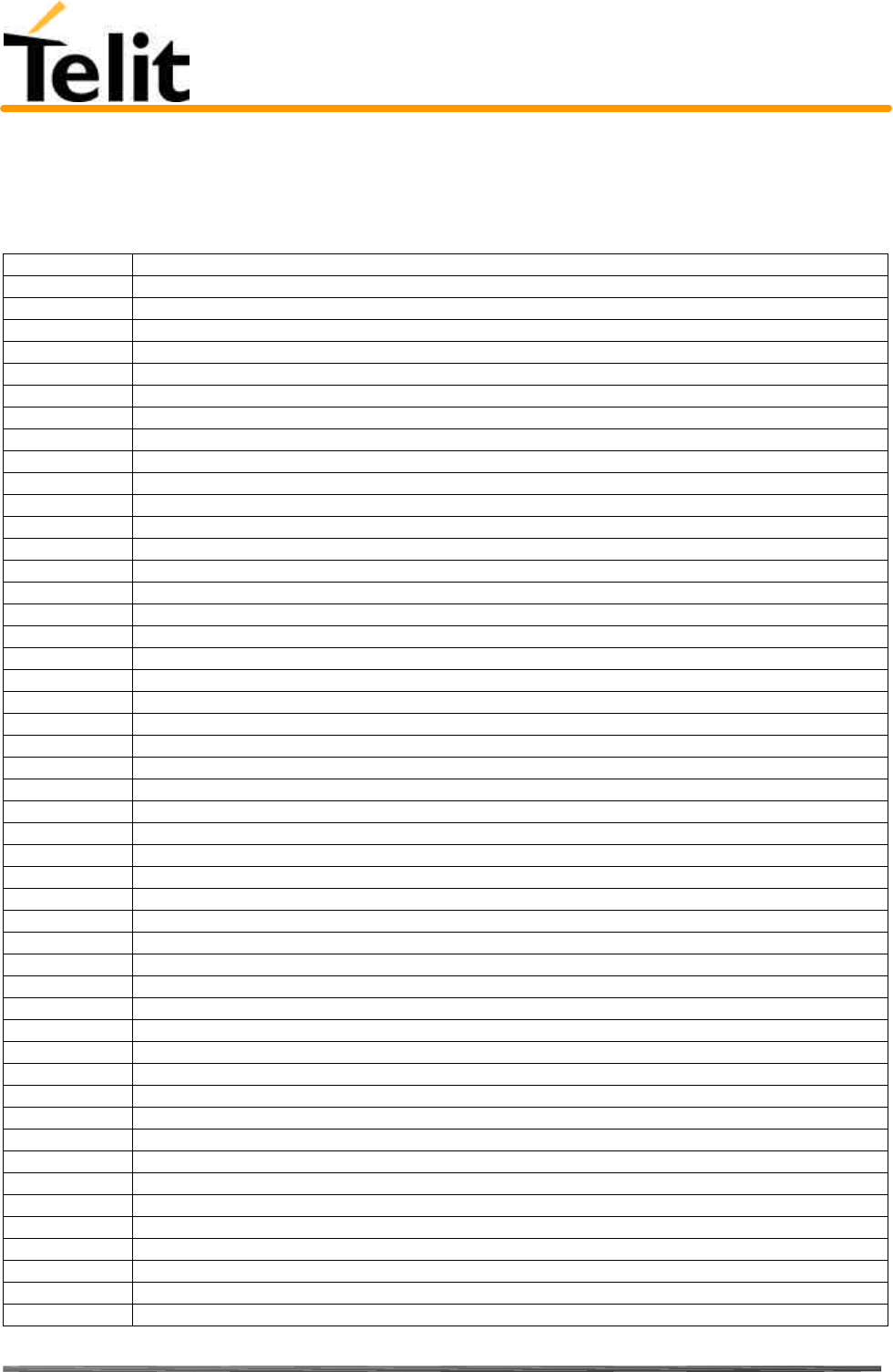
Telit TRIZIUM Product Description
80264ST10007a Rev. 4– 09/09/04
Reproduction forbidden without DAI Telecom written authorization – All Right reserved – Right of modification reserved page 200 of 202
8 List of acronyms
ACM Accumulated Call Meter
ASCII American Standard Code for Information Interchange
AT Attention commands
CB Cell Broadcast
CBS Cell Broadcasting Service
CCM Call Control Meter
CLIP Calling Line Identification Presentation
CLIR Calling Line Identification Restriction
CMOS Complementary Metal-Oxide Semiconductor
CR Carriage Return
CSD Circuit Switched Data
CTS Clear To Send
DAI Digital Audio Interface
DCD Data Carrier Detected
DCE Data Communications Equipment
DRX Data Receive
DSR Data Set Ready
DTA Data Terminal Adaptor
DTE Data Terminal Equipment
DTMF Dual Tone Multi Frequency
DTR Data Terminal Ready
EMC Electromagnetic Compatibility
ETSI European Telecommunications Equipment Institute
FTA Full Type Approval (ETSI)
GPRS General Radio Packet Service
GSM Global System for Mobile communication
HF Hands Free
IMEI International Mobile Equipment Identity
IMSI International Mobile Subscriber Identity
IRA Internationale Reference Alphabet
ITU International Telecommunications Union
IWF Inter-Working Function
LCD Liquid Crystal Display
LED Light Emitting Diode
LF Linefeed
ME Mobile Equipment
MMI Man Machine Interface
MO Mobile Originated
MS Mobile Station
MT Mobile Terminated
OEM Other Equipment Manufacturer
PB Phone Book
PDU Protocol Data Unit
PH Packet Handler
PIN Personal Identity Number
PLMN Public Land Mobile Network
PUCT Price per Unit Currency Table
PUK PIN Unblocking Code
RACH Random Access Channel
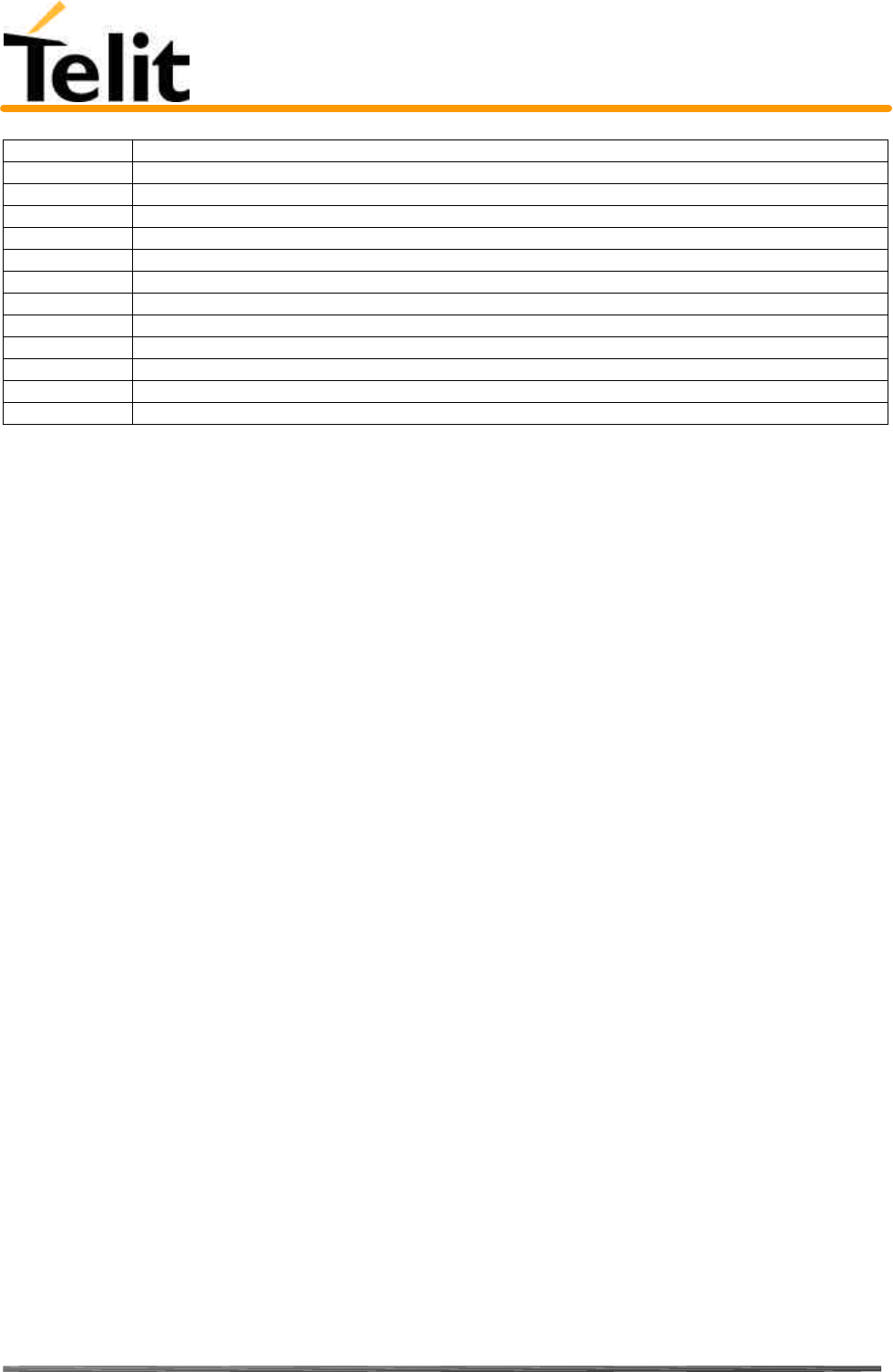
Telit TRIZIUM Product Description
80264ST10007a Rev. 4– 09/09/04
Reproduction forbidden without DAI Telecom written authorization – All Right reserved – Right of modification reserved page 201 of 202
RLP Radio Link Protocol
RMS Root Mean Square
RTS Ready To Send
RI Ring Indicator
SCA Service Center Address
SIM Subscriber Identity Module
SMD Surface Mounted Device
SMS Short Message Service
SMSC Short Message Service Center
SS Supplementary Service
TIA Telecommunications Industry Association
UDUB User Determined User Busy
USSD Unstructured Supplementary Service Data
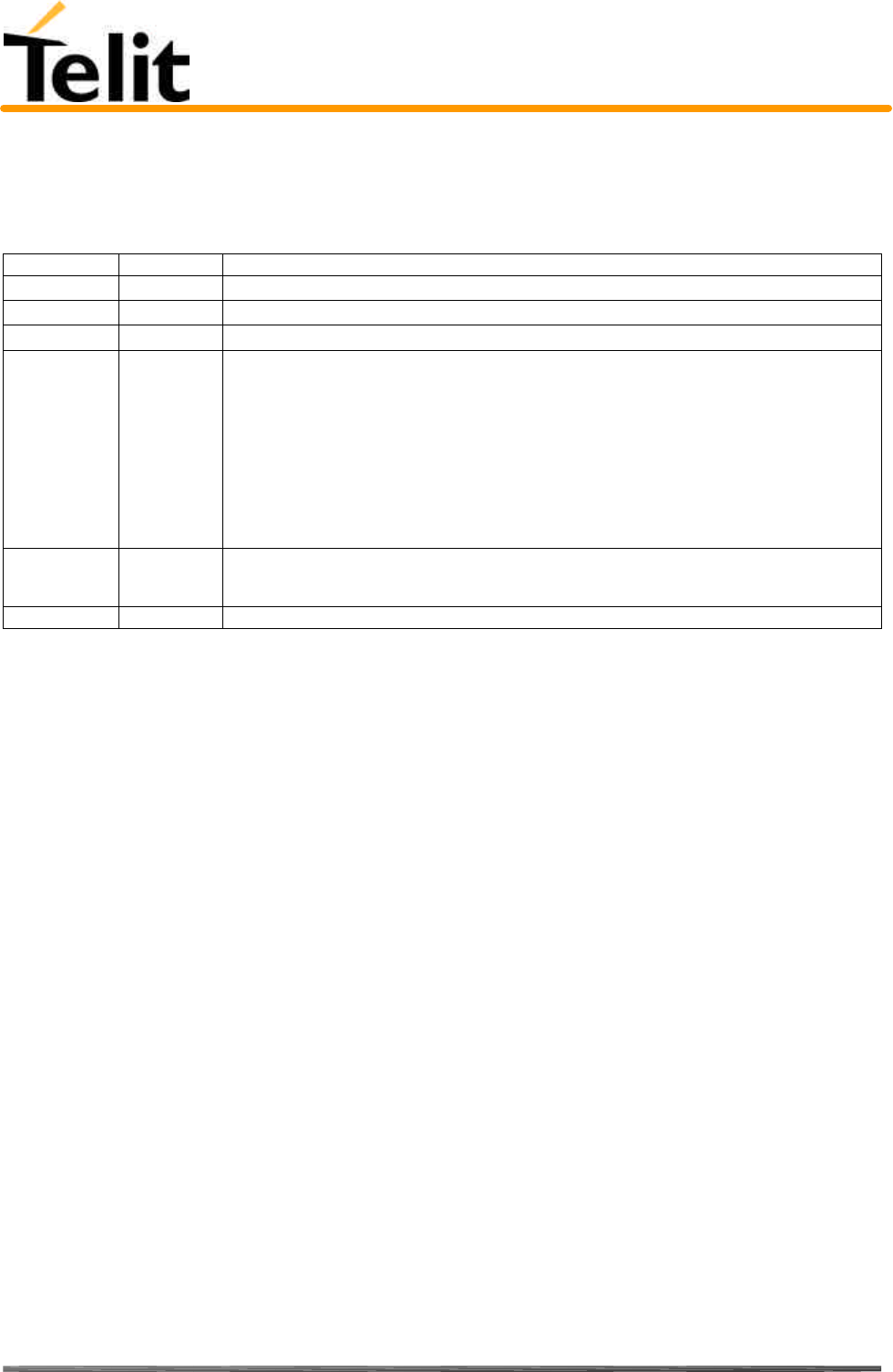
Telit TRIZIUM Product Description
80264ST10007a Rev. 4– 09/09/04
Reproduction forbidden without DAI Telecom written authorization – All Right reserved – Right of modification reserved page 202 of 202
9 Document Change Log
Revision Date Changes
DRAFT 01/10/03 Draft for comments
DRAFT #2 17/12/03 Final mechanical and Electrical design inserted
ISSUE#1 12/02/04 Release First ISSUE#1
ISSUE#2 31/05/04 Added Easy Scan Features
Added Easy Script Features
Par. 2.8 Note added.
Par. 5.5.3.1 +CNMI - new message indication to Terminal Equipment updated.
Par. 2.1 Dimensions - mechanical design updated
Par. 2.16 Interfaces of TRIZIUM - reference pin 1 moved. (no pinout change).
Par.5.6.1 #CGMM, #CGMI, #CGMR, #CGSN, #CIMI commands added.
Par. 5.6.1.17 #ADC – Read Analog/Digital Converter input command added.
Par. 5.9.1.5 #OBJL - Object list added.
Par. 5.9.1.6 #OBJR - Object read added.
ISSUE#3 02/09/04 Par. 2.17 Mounting the TRIZIUM on your Board updated.
Par. 2.9 Power Consumption updated.
Par. 6 Conformity Assessment issues updated.
ISSUE#4 09/09/04 Par.2.1.7.6 Packing system Page 27 updated picture with new IMEI label (removed FCC logo).